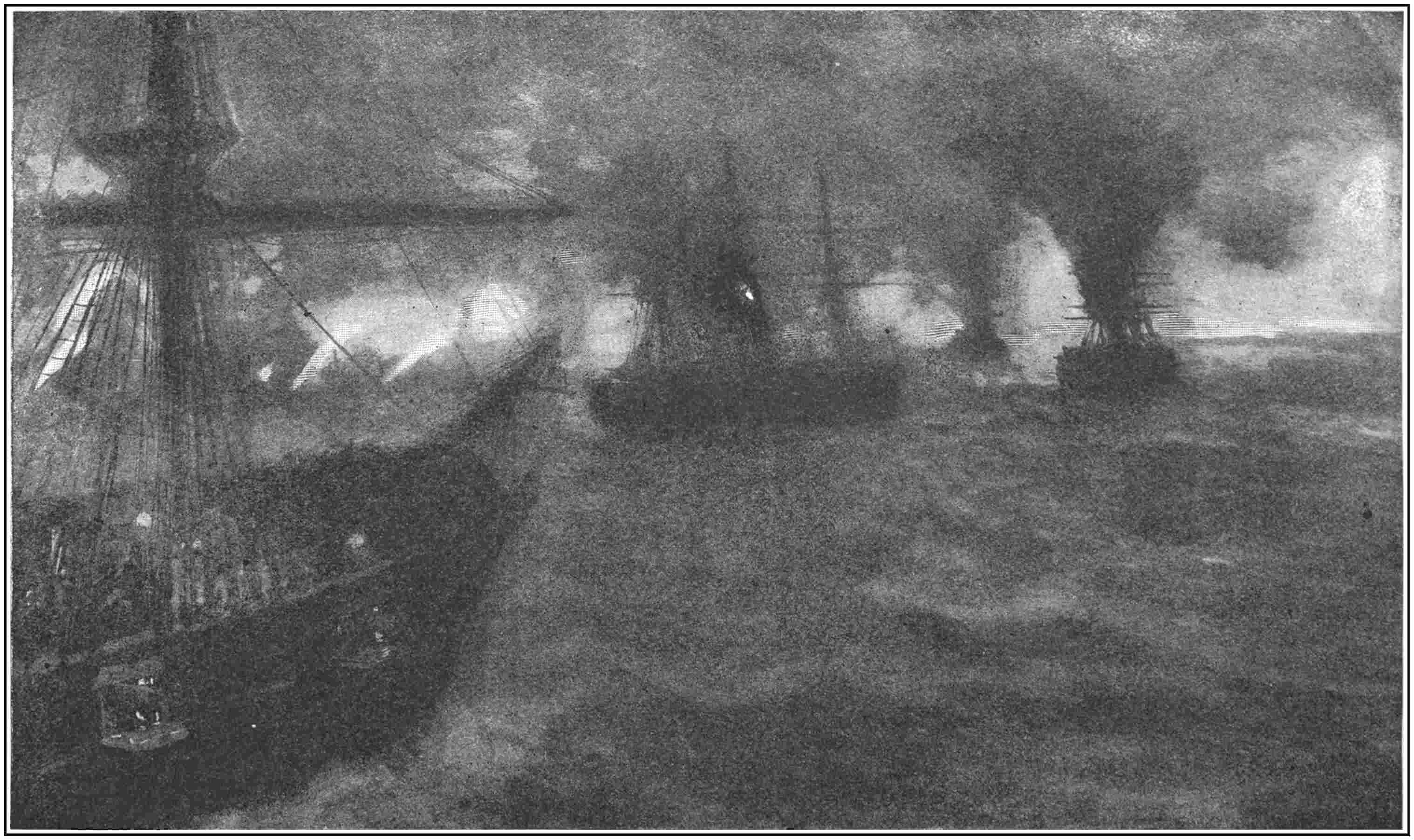
FARRAGUT’S FLEET PASSING FORTS JACKSON AND ST. PHILIP.
From a painting by Carlton T. Chapman.
Title: The history of our Navy from its origin to the present day, 1775-1897, vol. 4 (of 4)
Author: John Randolph Spears
Release date: October 5, 2023 [eBook #71797]
Language: English
Original publication: United States: Charles Scribner's Sons, 1897
Credits: Peter Becker, Charlie Howard, and the Online Distributed Proofreading Team at https://www.pgdp.net (This file was produced from images generously made available by The Internet Archive)
Transcriber’s Note
Larger versions of most illustrations may be seen by right-clicking them and selecting an option to view them separately, or by double-tapping and/or stretching them.
New original cover art included with this eBook is granted to the public domain.
Additional notes will be found near the end of this ebook.

FARRAGUT’S FLEET PASSING FORTS JACKSON AND ST. PHILIP.
From a painting by Carlton T. Chapman.
THE
HISTORY OF OUR NAVY
FROM ITS ORIGIN TO THE PRESENT DAY
1775–1897
BY
JOHN R. SPEARS
AUTHOR OF “THE PORT OF MISSING SHIPS,”
“THE GOLD DIGGINGS
OF CAPE HORN,” ETC.
WITH MORE THAN FOUR HUNDRED ILLUSTRATIONS
MAPS AND DIAGRAMS
IN FOUR VOLUMES
VOLUME IV.
NEW YORK
CHARLES SCRIBNER’S SONS
1897
COPYRIGHT, 1897, by
CHARLES SCRIBNER’S SONS
MANHATTAN PRESS
474 W. BROADWAY
NEW YORK
ix
TO ALL WHO WOULD SEEK PEACE
AND PURSUE IT
| PAGE | |
| Chapter I. The State of the Navy in 1859 | 1 |
| A Brief Story of the Development of the Warship that was Propelled by both Sails and Steam—The Remarkable Floating Battery of 1814—Barron’s Idea of a Ram—The Stevens Floating Battery—Ericsson’s Screw Propeller—Stockton and the First Screw Warship—Experiments with Great Guns—Discoveries of Bomford and Rodman—Practical Work by Dahlgren—A Comparison of Yankee Frigates with a Class of British Ships “Avowedly Built to Cope” with them—The Condition of the Personnel. | |
| Chapter II. Blockading the Southern Ports | 28 |
| Lincoln’s Proclamation—It was Something of a Task to Close 185 Inlets and Patrol 11,953 Miles of Sea-beaches, especially with the Force of Ships in Hand—One Merchant’s Notion of the Efficiency of Thirty Sailing Vessels—Gathering and Building Blockaders—Incentives and Favoring Circumstances for Blockade-runners—When Perjury Failed and Uncle Sam was Able to Strike without Waiting for Act of Congress—When Blockade-runners Came to New York and Yankee Smokeless Coal was in Demand. | |
| Chapter III. Loss of the Norfolk Navy Yard | 66 |
| Effective Work Done by Southern Naval Officers who Continued to Wear the National Uniform that they might the more Readily Betray the National Government—The Secretary of the Navy was Deceived and the Commandant at Norfolk Demoralized—William Mahone’s Tricks Added to the Demoralization at the Yard, and it was Abandoned at Last in a Shameful Panic—Property that was Worth Millions of Dollars, and Guns that Took Thousands of Lives, Fell into the Confederates’ Hands—The First Naval Battle of the War—Three Little Wooden Vessels with Seven Small Guns Sent against a Well-built Fort Mounting Thirteen Guns—The Hazardous Work of Patrolling the Potomac.x | |
| Chapter IV. A Story of Confederate Privateers | 84 |
| They Did Plenty of Damage for a Time, but their Career was Brief—Capture of the First of the Class, and Trial of her Crew on a Charge of Piracy—Reasons why they could not be Held as Criminals—Luck of the Jefferson Davis—A Negro who Recaptured a Confederate Prize to Escape the Terrors of Slavery—A Skipper who Thought a Government Frigate was a Merchantman—The “Nest” behind Cape Hatteras. | |
| Chapter V. The Fort of Hatteras Inlet Taken | 99 |
| An Expedition Planned by the Navy Department that Resulted in the First Federal Victory of the Civil War—An Awkward Landing Followed by Ineffectual Fire from Ships under Way—One Fort Taken and Abandoned—Anchored beyond Range of the Fort and Compelled Surrender by Means of the Big Pivot Guns—A Wearisome Race from Chicamicomico to Hatteras Lighthouse Won by the Federals—Capture of Roanoke Island—Origin of the American Medal of Honor. | |
| Chapter VI. Along Shore in the Gulf of Mexico | 112 |
| The Shameful Story of Pensacola and Fort Pickens—When Lieutenant Russell Burned the Judah—A British Consul’s Actions when Confederate Forts were Attacked at Galveston—Extraordinary Panic at the Head of the Passes in the Mississippi when Four Great Warships, Carrying Forty-five of the Best Guns Afloat, Fled from a Disabled Tugboat that was Really Unarmed—Once more in Galveston—Lieutenant Jouett’s Fierce Fight when he Destroyed the Royal Yacht. | |
| Chapter VII. Story of the Trent Affair | 140 |
| Capt. Charles Wilkes, of the American Navy, Took Four Confederate Diplomatic Agents from a British Ship Bound on a Regular Voyage between Neutral Parts, and without any Judicial Proceeding Cast them into a Military Prison—A Case that Created Great Excitement Throughout the Civilized World—A Swift Demand, with a Threat of War Added, Made by the British—Comparing this Case with another of Like Nature—The United States once Went to Warxi to Establish the Principle which Captain Wilkes Ignored—The British Officially Acknowledge that the Americans were Justified in Declaring War in 1812. | |
| Chapter VIII. The Capture of Port Royal | 161 |
| A Fleet of Seventeen Ships, Carrying 155 Guns, Sent to Take a Harbor that would Make a Convenient Naval Station for the Atlantic Blockaders—There were Two “Exceedingly Well-built Earthworks” “Rather Heavily Armed” Defending the Channel, but one Part of the Squadron Attacked them in Front, another Enfiladed them, and in Less than Five Hours the Confederates Fled for Life—A Heavy Gale Weathered with Small Loss—Interesting Incidents of the Battle. | |
| Chapter IX. The Monitor and the Merrimac | 184 |
| Superior Activity of the Confederates in Preparing for Ironclad Warfare Afloat—Story of the Building and Arming of the Merrimac—She was a Formidable Ship in Spite of Defects in Detail, but her Design was not the Best Conceivable—Origin and Description of the Ship that Revolutionized the Navies of the World—A Wondrous Trial Trip—For One Day the Merrimac was Irresistibly Triumphant—Two Fine Ships of the Old Style Destroyed while she Herself Suffered but Little—The Magnificent Fight of the Cumberland—A Difference in Opinions. | |
| Chapter X. First Battle between Ironclads | 214 |
| A Comparison between the Monitor and the Merrimac by the English Standard of 1812—It Astonished the Spectators to See the Tiny Monitor’s Temerity—After Half a Day’s Firing it was Plain that the Guns could not Penetrate the Armor—Attempts to Ram that Failed—The Merrimac A-leak—Captain Worden of the Monitor Disabled when the Merrimac’s Fire was Concentrated on the Pilot-house—Where the Monitor’s Gunners Failed—Fair Statement of the Result of the Battle—Worden’s Faithful Crew—The Merrimac Defied the Monitor in May, but when Norfolk was Evacuated she had to be Abandoned and was Burned at Craney Island—Loss of the Monitor. | |
| Chapter XI. With the Mississippi Gunboats | 239 |
| Creating a Fleet for the Opening of the Water Route across the Confederacy—Ironclads that were not Shot-proof, but Fairly Efficient nevertheless—Guns that Burst and Boilers that were Searched byxii Shot from the Enemy—When Grant Retreated and was Covered by a Gunboat—First View of Torpedoes—Capture of Fort Henry—A Disastrous Attack on Fort Donelson—When Walke Braved the Batteries at Island No. 10—The Confederate Defence Squadron at Fort Pillow—The First Battle of Steam Rams—Frightful Effects of Bursted Boilers—In the White River—Farragut Appears. | |
| Chapter XII. Farragut at New Orleans | 311 |
| It was Hard Work Getting the Squadron into the Mississippi—Preparing the Ships to Run by the Forts Guarding the River—Mortar Schooners Hidden by Tree Branches—The Forts were Well Planned, but Poorly Armed—A Barrier Chain that was no Barrier at the Last—The Heterogeneous Confederate Squadron—The Fire-rafts—Work of the Coast Survey—Bravery of Caldwell—Foreigners who Interfered—Work of the Mortar Fleet—When the Squadron Drove past the Forts—Scattering the Confederate Squadron—Nevertheless, at least Three Good Captains were Found among them—Sinking the Varuna—Fate of the Ram Manassas—Surrender of the Forts—End of the Ironclad Louisiana—The Work of the Mississippi Squadron. | |
| Chapter XIII. Farragut at Mobile | 377 |
| The Forts and the Confederate Squadron the Union Forces were Compelled to Face—The Confederate Ironclad just Missed being a most Formidable Ship—Tedious Wait for Monitors—When the Southwest Wind Favored—There was a Fierce Blast from the Forts at First, but the Torpedo was Worse than Many Guns—Fate of the Tecumseh and Captain Craven—The Last Words of the Man for whom “there was no Afterward”—Torpedoes that Failed beneath the Flagship—Captain Stevens on the Deck of his Monitor—When Neilds Unfurled the Old Flag in the midst of the Storm—How Farragut was Lashed to the Mast—Jouett would not be Intimidated by a Leadsman—Mobbing the Tennessee. | |
| Chapter XIV. Tales of the Confederate Cruisers | 407 |
| The most Instructive Chapter in the History of the United States—Work Accomplished by an Energetic Seaman in a Ship his Brother Officers Condemned—Brilliant Work of the Florida under John Newland Maffitt—Bad Marksmanship and a Worse Lookout off Mobile—A Case of Violated Neutrality—Semmes and the Alabama—Thexiii Battle with the Kearsarge—What Kind of a Man is it that Fights his Ship till she Sinks under him?—American Commerce Destroyed—The British without a Rival on the Sea, at Last, and at Very Small Cost. | |
| Chapter XV. The Albemarle and Cushing | 452 |
| A Formidable Warship was Built under Remarkable Conditions to Enable the Confederates to Regain Control of the Inland Waters of North Carolina—Very Successful at First, but she was Laid up to Await the Building of another One, and then came Cushing with his Little Torpedo Boat, and the Confederate Hopes were Destroyed with their Ship. | |
| Chapter XVI. The Navy at Charleston | 465 |
| It was a Well-guarded Harbor, and the Channel was Long and Crooked—The “Stone Fleet” and the Attitude of Foreign Powers—Brief Career of Two Confederate Ironclads—The Blockade was not Raised—A Confederate Cruiser Burned—Utter Failure of the Ironclad Attacks on the Forts—Capture of the Confederate Warship Atlanta—“Boarders Away” at Fort Sumter—Magnificent Bravery of the Men who Manned the Confederate Torpedo Boats. | |
| Chapter XVII. Capture of Fort Fisher | 503 |
| It was One of the Best Works in the South, though not well Located—Butler’s Powder-boat Scheme, and what he Expected to Accomplish by it—Throwing 15,000 Shells at the Fort Disabled Eight Great Guns out of a Total of Thirty-eight—Butler Thought the Fort still too Strong and would not Try—He did not even Make Intrenchments According to Orders—Gen. A. H. Terry, with 6,000 Soldiers and 2,000 from the Ships, Easily Took the Fort Three Weeks Later—The Navy’s Last Fight in the Civil War. | |
| Chapter XVIII. Story of the New Navy | 523 |
| The Folly of Allowing other Nations to Experiment for us—In Spite of what we Learned from their Mistakes, we were Unable, when we First Began for ourselves, to Build even a First-class Cruiser—The Result of Ten Years of Earnest Work—Battle-ships whose Power is Conceded by Foreign Writers—Cruisers that Awakened the Pride of the Nation—Three “Newfangled Notions”—A Yankee Admiral at Rio Janeiro and a Yankee Lieutenant on the Coast of Mexico—The One Important Fact about the New Navy. | |
xiv
xv
| PAGE | |
| Farragut’s Fleet Passing Forts Jackson and St. Philip. (From a painting by Carlton T. Chapman), Frontispiece | |
| A Thirty-two-pound Carronade from the Constitution. | 1 |
| The Minnesota as a Receiving Ship. (From a photograph by Rau), | 3 |
| A Loop-pattern Gun of 1836—a Type which Runs back over 100 Years, | 4 |
| A Thirty-two-pounder from the Captured Macedonian—now at the Brooklyn Navy Yard. (From a photograph), | 5 |
| A Thirty-two-pounder from the Captured Macedonian. | 7 |
| Old Cast-iron Thirty-two-pounder (Believed to be Spanish), | 8 |
| John Ericsson, | 10 |
| The Great Western—One of the First Steamships to Cross the Atlantic Ocean. (After an old painting), | 13 |
| Twelve-inch Wrought-iron Gun—the Mate to the “Peacemaker,” which Burst on the Princeton. (From a photograph of the original at the Brooklyn Navy Yard), | 14 |
| U. S. Ironclad Steamship Roanoke. (From an old lithograph), | 15 |
| U. S. Frigate Pensacola off Alexandria. (From a photograph taken in 1865), | 16 |
| A Twelve-pound Bronze Howitzer—the First One Made in the United States. (From a photograph of the original at the Brooklyn Navy Yard), | 18 |
| A Dahlgren Gun, | 19 |
| Two Blakely Guns at the Brooklyn Navy Yard, | 22 |
| The Blockaded Coast. (From “The Navy in the Civil War”), | 29 |
| Map Showing Position of United States Ships of War in Commission March 4, 1861, | 33xvi |
| Gideon Welles. (From a photograph), | 34 |
| Gustavus V. Fox. (From an engraving), | 36 |
| Garrett J. Pendergrast, | 39 |
| A Four-pound Cast-iron Gun Captured from a Blockade-runner, | 49 |
| An Eighteen-pound Rifle Captured from a Blockade-runner, | 52 |
| A Six-pound Gun Captured from a Blockade-runner, | 53 |
| A Nassau View—Along the Shore East of the Town. (From a photograph by Rau), | 54 |
| Nassau Schooners. (From a photograph by Rau), | 55 |
| The Blockade-runner Teaser. (From a photograph made in 1864), | 60 |
| Washington, D. C., and its Vicinity, | 67 |
| Hiram Paulding. (From an engraving by Hall), | 71 |
| A View of the Norfolk Navy Yard. (From a photograph by Cook), | 73 |
| The Old New Hampshire at the Norfolk Navy Yard. (From a photograph by Cook), | 77 |
| Burning of the Vessels at the Norfolk Navy Yard, | 79 |
| The Confederate States Privateer Savannah, Letter of Marque No. 1, Captured off Charleston by the U. S. Brig Perry, Lieutenant Parrott, | 88 |
| Destruction of the Privateer Petrel by the St. Lawrence. (From an engraving by Hinshelwood of the painting by Manzoni), | 95 |
| S. H. Stringham. (From an engraving by Buttre), | 100 |
| B. F. Butler. (From a photograph), | 101 |
| Bombardment and Capture of the Forts at Hatteras Inlet, N. C. (From a lithograph published by Currier & Ives), | 103 |
| Eight-inch Mortar Captured at Hatteras, | 107 |
| L. M. Goldsborough. (From an engraving by Buttre), | 108 |
| Stephen C. Rowan. (From a photograph), | 109 |
| Attack on Roanoke Island—Landing of the Troops. (From an engraving of the painting by Chappel), | 110 |
| Landing of Troops on Roanoke Island. (From an engraving by Perine of a drawing by Momberger), | 110 |
| Surrender of the Navy Yard at Pensacola. (From a painting by Admiral Walke), | 113 |
| Henry Walke. (From a photograph), | 114xvii |
| John G. Sproston. (From a photograph at the Naval Academy, Annapolis), | 120 |
| Galveston Harbor. (From “The Navy in the Civil War”), | 122 |
| Passes of the Mississippi. (From “The Navy in the Civil War”), | 126 |
| James Murray Mason and John Slidell. (The two captured commissioners), | 141 |
| Charles Wilkes. (From an engraving by Dodson of the portrait by Sully), | 143 |
| William H. Seward. (From a photograph), | 155 |
| S. F. Dupont. (From a photograph), | 163 |
| C. R. P. Rodgers. (From a photograph), | 164 |
| S. W. Godon. (From a painting at the Naval Academy, Annapolis), | 165 |
| Josiah Tattnall. (From an engraving by Hall), | 168 |
| Plan of Fort Walker on Hilton Head. (From a drawing by R. Sturgis, Jr., in 1861), | 169 |
| Bombardment of Port Royal, S. C. (From an engraving by Ridgeway of a drawing by Parsons), | 175 |
| Bombardment and Capture of Forts Walker and Beauregard, November 7, 1861. (From an engraving by Perine), | 179 |
| Franklin Buchanan, | 189 |
| The New Ironsides in Action. (From a photograph, of a drawing, owned by Mr. C. B. Hall), | 190 |
| The Giant and the Dwarfs; or, John E. and the Little Mariners. (From a Swedish caricature, February 10, 1867), | 191 |
| The Monitor, | 192 |
| Hampton Roads. (From “The Navy in the Civil War”), | 196 |
| Fortress Monroe and its Vicinity, | 199 |
| The Sinking of the Cumberland by the Ironclad Merrimac. (From a lithograph published by Currier & Ives), | 202 |
| The Merrimac Ramming the Cumberland. (From a drawing by M. J. Burns), | 205 |
| George U. Morris. (From a photograph owned by Mr. C. B. Hall), | 207 |
| J. L. Worden. (From a photograph), | 216 |
| Deck View of the Monitor and her Crew. (From a photograph), | 219xviii |
| The Fight between the Merrimac and the Monitor. (From a lithograph published by Currier & Ives), | 221 |
| In the Monitor’s Turret, | 223 |
| The Action between the Monitor and the Merrimac. (From an engraving of the picture by Chappel), | 227 |
| Group of Officers on Deck of the Monitor. (From a photograph), | 232 |
| Destruction of the Merrimac off Craney Island. (From a lithograph published by Currier & Ives), | 237 |
| Mississippi Valley—Cairo to Memphis. (From “The Navy in the Civil War”), | 242–3 |
| The Cairo. (From a photograph), | 244 |
| The Pittsburg. (After a photograph), | 245 |
| The Mississippi Fleet off Mound City, Illinois. (From a photograph owned by Mr. C. B. Hall), | 247 |
| A. H. Foote. (From a photograph), | 250 |
| The Battle of Belmont: First Attack by the Taylor and the Lexington. (From a painting by Admiral Walke), | 253 |
| Battle of Belmont: U. S. Gunboats Repulsing the Enemy during the Debarkation. (From a painting by Admiral Walke), | 257 |
| Interior of the Taylor during the Battle of Belmont. (From a painting by Admiral Walke), | 259 |
| Battle of Fort Henry. (From a painting by Admiral Walke), | 263 |
| Battle of Fort Donelson. (From a painting by Admiral Walke), | 269 |
| Explosion on Board the Carondelet at the Battle of Fort Donelson. (From a painting by Admiral Walke), | 273 |
| U. S. Flotilla Descending the Mississippi River. (From a painting by Admiral Walke), | 277 |
| Battle with Fort No. 1 above Island No. 10. (From a painting by Admiral Walke), | 279 |
| The Carondelet Running the Gauntlet at Island No. 10. (From a painting by Admiral Walke), | 285 |
| The Carondelet Attacking the Forts below Island No. 10. (From a painting by Admiral Walke), | 287 |
| U. S. Gunboats Capturing the Confederate Forts below Island No. 10, April 7th. (From a painting by Admiral Walke), | 291 |
| Battle of Fort Pillow. (From a painting by Admiral Walke) | 295xix |
| The Battle of Fort Pillow. (From a painting by Admiral Walke), | 299 |
| The Battle of Memphis—First Position. (From a painting by Admiral Walke), | 303 |
| After the Battle of Memphis. (From a painting by Admiral Walke), | 305 |
| Battle of Memphis—The Confederates Retreating. (From a painting by Admiral Walke), | 309 |
| David Glasgow Farragut. (From a photograph), | 312 |
| Thirteen-inch Mortar from Farragut’s Fleet. (From a photograph made at the Brooklyn Navy Yard), | 316 |
| New Orleans, La., and its Vicinity, | 319 |
| Mortar Boats. (From an engraving), | 322 |
| Beginning of the Battle of New Orleans. (From a painting by Admiral Walke), | 327 |
| Battle of New Orleans. (From “The Navy in the Civil War”), | 331 |
| The Battle of New Orleans. (From a painting by Admiral Walke), | 335 |
| Confederate Ironclad Ram Stonewall Jackson. (From a photograph), | 337 |
| The Essex after Running the Batteries at Vicksburg and Port Hudson. (After a photograph), | 341 |
| The Carondelet after Passing Vicksburg. (From a photograph), | 342 |
| Battle between the Carondelet and the Arkansas. (From a painting by Admiral Walke), | 346 |
| Battle between the Arkansas and the Carondelet. (From a painting by Admiral Walke), | 347 |
| Destruction of the Arkansas near Baton Rouge, August 4, 1862. (From a lithograph published by Currier & Ives), | 349 |
| David D. Porter. (From a photograph), | 350 |
| Admiral Farragut Passing Port Hudson. (From a painting by Admiral Walke), | 353 |
| The U. S. Flotilla Passing the Vicksburg Batteries. (From a painting by Admiral Walke), | 355 |
| Battle of Grand Gulf—First Position. (From a painting by Admiral Walke), | 359 |
| Battle of Grand Gulf—Second Position. (From a painting by Admiral Walke), | 363xx |
| Battle of Grand Gulf—Third Position. (From a painting by Admiral Walke), | 365 |
| Admiral Porter on Deck of Flagship at Grand Écore, La. (From a photograph), | 368 |
| U. S. Ram Lafayette. (From a photograph), | 369 |
| U. S. Gunboat Fort Hindman. (From a photograph), | 370 |
| Joseph Bailey. (From a photograph), | 371 |
| Red River Dam. (From “The Navy in the Civil War”), | 373 |
| The Fleet Passing the Dam. (From an engraving), | 375 |
| Entrance to Mobile Bay. (From “The Navy in the Civil War”), | 378 |
| Farragut and Drayton on Board the Hartford at Mobile Bay. (Drawn by I. W. Taber from a photograph), | 387 |
| Battle of Mobile Bay. (From “The Navy in the Civil War”), | 390–91 |
| T. A. M. Craven (From a photograph owned by Mr. C. B. Hall), | 393 |
| Battle of Mobile Bay. (From a painting by Admiral Walke), | 397 |
| The Confederate Ram Tennessee, Captured at Mobile. (From a photograph), | 404 |
| Raphael Semmes. (From a photograph owned by Mr. C. B. Hall), | 408 |
| The Florida Running the Blockade at Mobile. (After a painting by R. S. Floyd), | 421 |
| “A Prize Disposed and One Proposed.” (After a painting by R. S. Floyd), | 425 |
| Raphael Semmes and his Alabama Officers. (From a photograph owned by Mr. C. B. Hall), | 433 |
| John A. Winslow. (From a photograph), | 436 |
| Engagement between the U. S. S. Kearsarge and the Alabama off Cherbourg, on Sunday, June 19, 1864. (From a French lithograph), | 439 |
| The Kearsarge Sinking the Alabama. (From an engraving), | 443 |
| Action between the Kearsarge and the Alabama. (From an engraving of the painting by Chappel), | 445 |
| Whitworth Rifle Captured from the Shenandoah, | 448 |
| Three Famous Confederate Cruisers. (From a painting by M. J. Burns), | 449xxi |
| William B. Cushing. (From a photograph), | 457 |
| Cushing Blowing up the Albemarle, | 462 |
| Charleston Harbor. (From “The Navy in the Civil War”), | 466 |
| Battery Brown: Twenty-eight-inch Parrott Rifle. (From a photograph by Haas & Peale), | 468 |
| In the Charleston Batteries: 300-pounder Parrott Rifle after Bursting of Nozzle. (From a photograph by Haas & Peale), | 469 |
| General Map of Charleston Harbor, South Carolina, Showing Confederate Defences and Obstructions, | 476–7 |
| Ironclads and Monitors Bombarding the Defences at Charleston. (From an engraving), | 481 |
| Confederate Ironclad Atlanta, Captured at Wassaw Sound, June 17, 1863. (From “The Navy in the Civil War”), | 487 |
| The Weehawken and the Atlanta. (From a wood-cut), | 488 |
| John A. B. Dahlgren. (From a photograph), | 489 |
| Bomb-proof of Fort Wagner. (From a photograph by Haas & Peale), | 491 |
| Battery Hayes: Eighteen-inch Parrott Rifle—Dismounted Breaching Battery against Sumter. (From a photograph by Haas & Peale), | 492 |
| Battery Kirby: Twenty-eight-inch Seacoast Mortars against Sumter. (From a photograph by Haas & Peale), | 493 |
| Admiral Dahlgren and Staff on the Pawnee at Charleston. (From a photograph), | 496 |
| Sketch Showing Torpedo Boats as Constructed at Charleston, S. C. (From “The Navy in the Civil War”), | 498 |
| The Entrance to Cape Fear River, Showing Fort Fisher. (From “The Navy in the Civil War”), | 504 |
| Plan and Sections of Fort Fisher. (From “The Navy in the Civil War”), | 506 |
| The Bombardment of Fort Fisher. (From a lithograph), | 517 |
| T. O. Selfredge. (From a photograph owned by Mr. C. B. Hall), | 519 |
| Second Attack upon Fort Fisher by the U. S. Navy, under Rear-admiral D. D. Porter, January 13, 14, 15, 1865, | 521 |
| The Old Method of Handling a Ship’s Bowsprit. (From an old engraving), | 524xxii |
| Hauling a Vessel into Port a Hundred Years Ago. (From an old engraving), | 525 |
| The White Squadron in Mid-ocean. (From a drawing by R. F. Zogbaum), | 529 |
| U. S. S. Charleston, San Diego Harbor. (From a photograph), | 531 |
| The Columbia on her Government Speed Trial. (From a photograph by Rau), | 534 |
| Plan of the Iowa, | 536 |
| Plan of the Constitution, | 537 |
| The Vesuvius. (From a photograph by Rau), | 541 |
| Launching of one of the Holland Boats, the Holland, at Elizabethport, N. J., 1897. (From a photograph belonging to the John P. Holland Co.), | 543 |
| Another of the Holland Submarine Boats: the Plunger. (From a photograph of a drawing belonging to the John P. Holland Co.), | 545 |
| The Harbor of Rio Janeiro, Showing the Frigate Savannah Struck by a Squall, July 5, 1856. (From a lithograph), | 549 |
| The Stern and Propeller of the Nipsic after the Samoan Hurricane. (From a photograph), | 551 |
| The Harbor after the Samoan Hurricane. (From a photograph), | 553 |
1

A BRIEF STORY OF THE DEVELOPMENT OF THE WARSHIP THAT WAS PROPELLED BY BOTH SAILS AND STEAM—THE REMARKABLE FLOATING BATTERY OF 1814—BARRON’S IDEA OF A RAM—THE STEVENS FLOATING BATTERY—ERICSSON’S SCREW PROPELLER—STOCKTON AND THE FIRST SCREW WARSHIP—EXPERIMENTS WITH GREAT GUNS—DISCOVERIES OF BOMFORD AND RODMAN—PRACTICAL WORK BY DAHLGREN—A COMPARISON OF YANKEE FRIGATES WITH A CLASS OF BRITISH SHIPS “AVOWEDLY BUILT TO COPE” WITH THEM—THE CONDITION OF THE PERSONNEL.
From the point of view of a naval seaman it was a far cry from the first war in defence of the nation’s life to the last one—so far, indeed, that all the progress made in the construction of ships of war from the time when men first went afloat to fight, down to the war of the Revolution, had not equalled that made2 in the eighty odd years that elapsed between, say, the battle of Lake Champlain, which was the most important battle afloat in the Revolution, and that of Hampton Roads, which was first in the Civil War.
Consider the forces that Arnold mustered against the whelming odds under the ambitious Carleton. Though two of the vessels were dignified with the name of schooner and one was called a sloop, the flagship of the squadron was a galley managed by means of oars, and the fleet as a whole, including the Royal Savage, was inferior to an equal number of the galleys with which the Romans, in the days of Carthage, held sway over the Mediterranean.
And then consider the ships that in 1860 graced the register of the American navy—ships that with the aid of steam could hold their own against wind and tide, and that carried guns of so large a calibre that any but the largest from Arnold’s fleet might have been shoved down their throats after the trunnions were knocked off. Arnold in his flagship, the galley Congress, had eight guns of which the bore was about three and a half inches in diameter, and the shot weighed six pounds. But when the Civil War came, the Minnesota was armed with forty-two guns of a nine-inch calibre and one of eleven inches, besides four3 rifles that threw elongated projectiles weighing 100 pounds and one rifle with a projectile weighing 150. Arnold’s Congress could throw at a broadside twenty-four pounds of metal over an effective range of perhaps 300 yards; the Minnesota could throw 1,861 pounds over an effective range of 1,600 yards.
And a still more wondrous advance was in the minds of men; it was at hand—an advance to a point where steel forts were to be sent afloat in place of the ships that were in 1859 the pride of naval seamen.
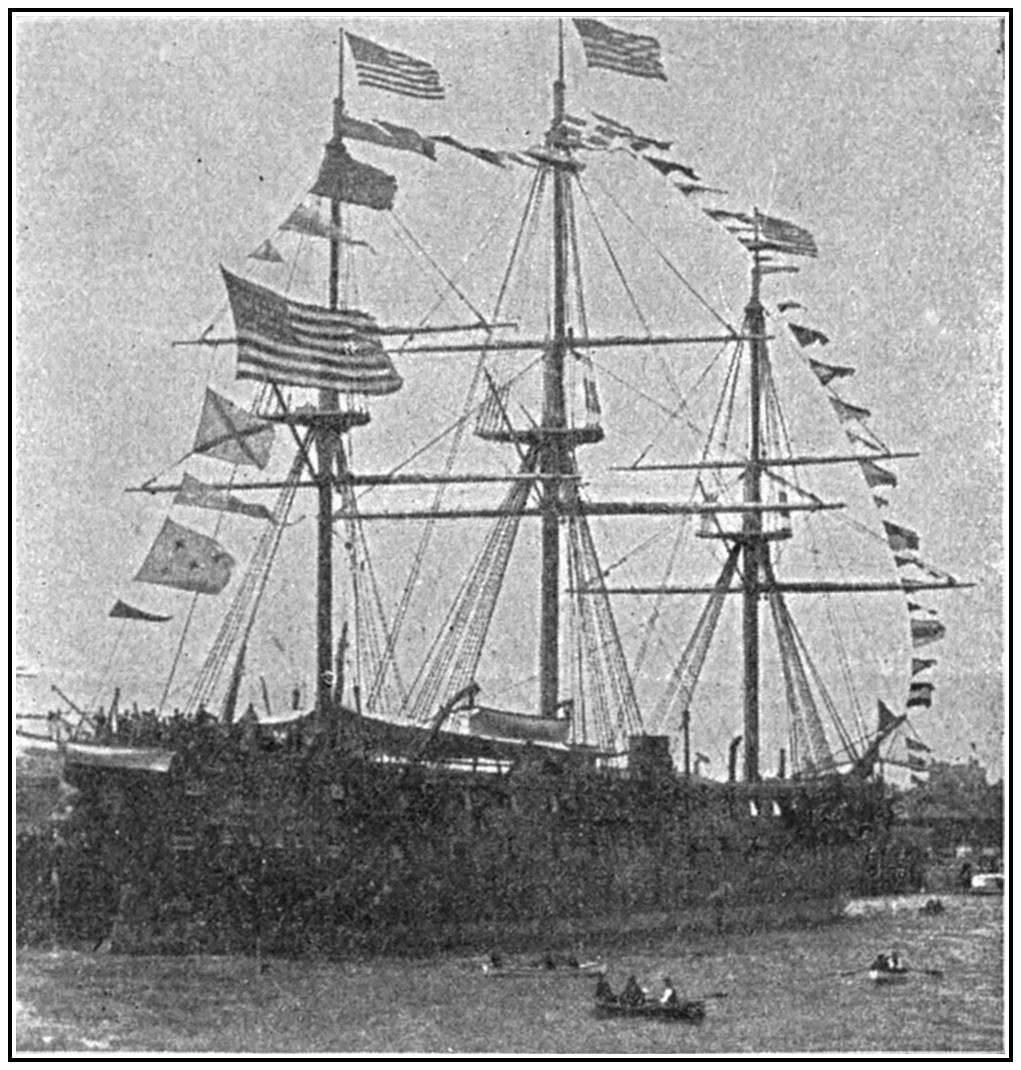
The Minnesota as a Receiving Ship.
From a photograph by Rau.
Remarkable as it seems to the present-day student of naval history, the changes in naval ships that produced the Minnesota before the year 1859—even the changes that gave us the steel fort afloat—were foreshadowed in 1813 when the immortal Fulton made plans for a ship of war that should not only be propelled by steam, but should be as impregnable to the4 guns of that day as were the ironclads of 1862 to the guns of their day.

Although this ship was designed in 1813, she was not sent afloat until October 29, 1814, and even then, although swifter and more convenient than Fulton had promised that she should be—although she was the very craft that on a smooth-water day could meet and destroy the insolent blockading squadron then off Sandy Hook—she was not put into commission immediately, and the war came to an end before there was opportunity to show what steam might do for the sea power of a nation.
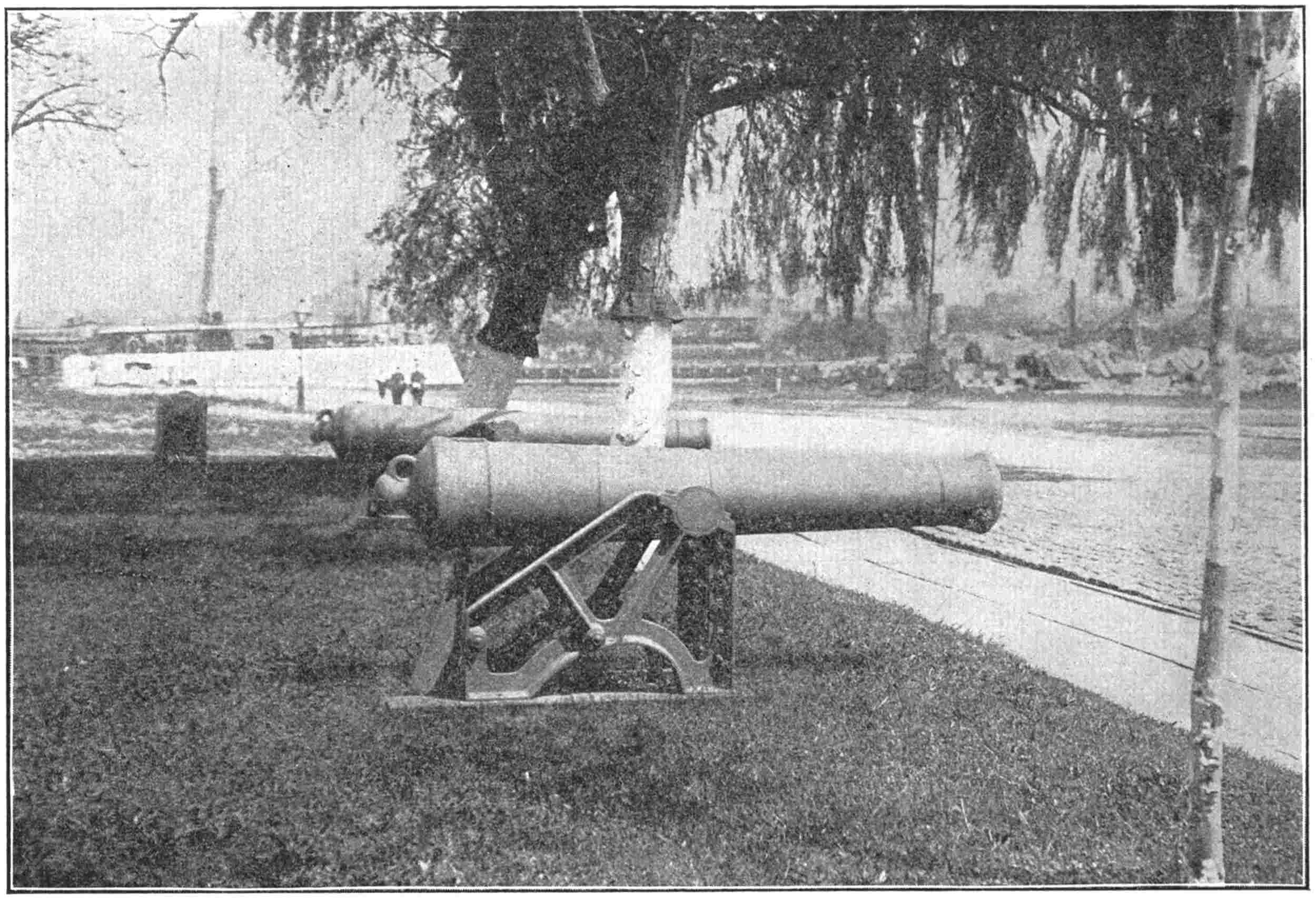
A Thirty-two-pounder from the Captured Macedonian—now at the Brooklyn Navy Yard.
From a photograph.
But because this was the first steam warship the world ever saw, and because, when sent on trial trips, she more than fulfilled every promise of her designer, it is worth while giving a full description of her. Her length was 150 feet; breadth, 56 feet; depth, 20 feet; water-wheel, 16 feet diameter; length of bucket, 14 feet; dip, 4 feet; engine, 48-inch cylinder, 5-feet7 stroke; boiler, length, 22 feet; breadth, 12 feet; and depth, 8 feet; tonnage, 2,475. She was the largest steamer by many hundreds of tons that had been built at the date of her launch. The commissioners appointed to examine her, in their report say:
“She is a structure resting upon two boats, keels separated from end to end by a canal fifteen feet wide and sixty-six feet long. One boat contains the caldrons of copper to prepare her steam. The vast cylinder of iron, with its piston, levers, and wheels, occupies a part of its fellow; the great water-wheel revolves in the space between them; the main or gun-deck supporting her armament is protected by a bulwark four feet ten inches thick, of solid timber. This is pierced by thirty portholes, to enable as many 32-pounders to fire red-hot balls; her upper or spar deck, upon which8 several thousand men might parade, is encompassed by a bulwark which affords safe quarters. She is rigged with two short masts, each of which supports a large lateen yard and sails. She has two bowsprits and jibs and four rudders, two at each extremity of the boat; so that she can be steered with either end foremost. Her machinery is calculated for the addition of an engine which will discharge an immense column of water, which it is intended to throw upon the decks and all through the ports of an enemy. If, in addition to all this, we suppose her to be furnished, according to Mr. Fulton’s intention, with 100-pounder columbiads, two suspended from each bow, so as to discharge a ball of that size into an enemy’s ship ten or twelve feet below the water-line, it must be allowed that she has the appearance9 at least of being the most formidable engine of warfare that human ingenuity has contrived.”
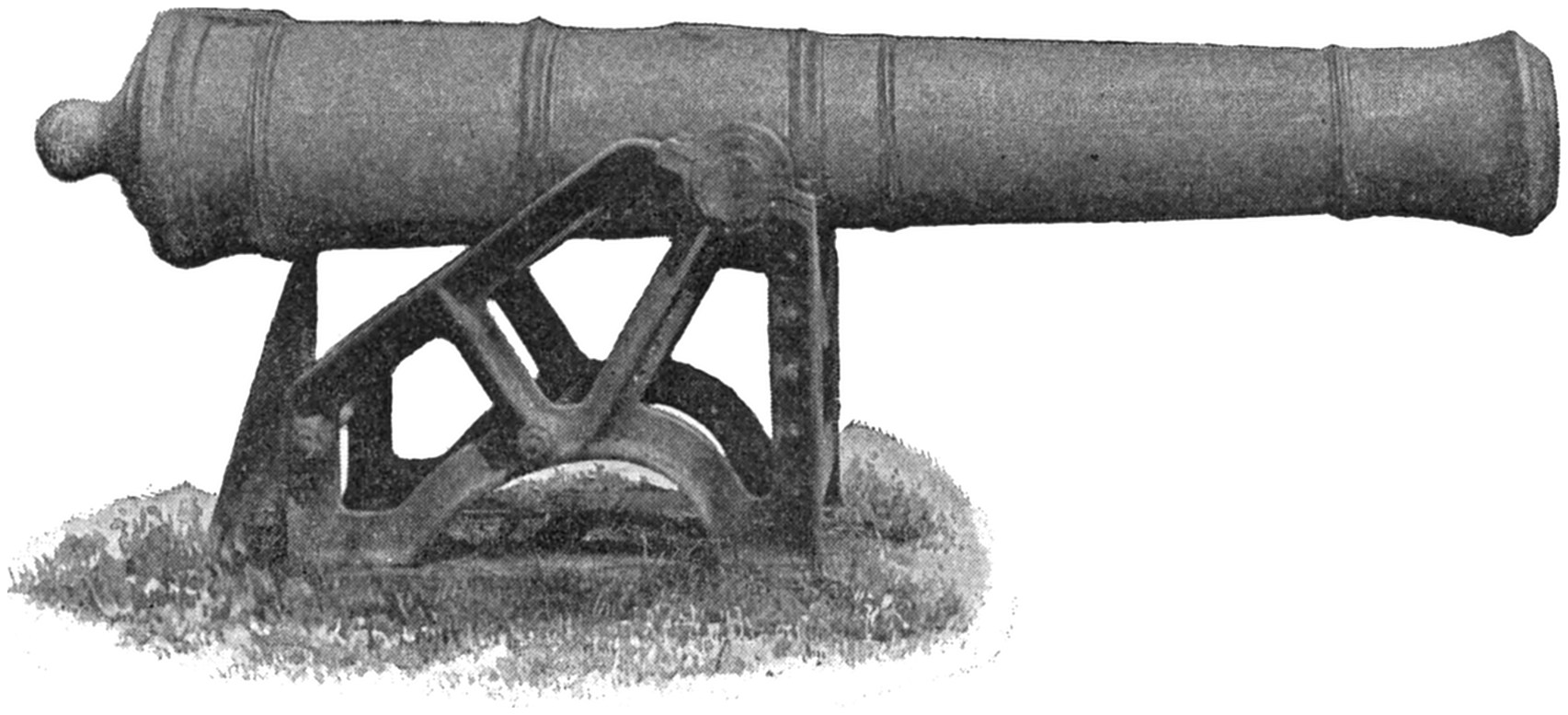
Formidable she certainly was, but no war came to demonstrate her powers, and she lay in the Brooklyn Navy Yard as a receiving-ship until the 4th of June, 1829, when her magazine was fired, presumably by a drunken member of the crew, and she was blown to pieces.
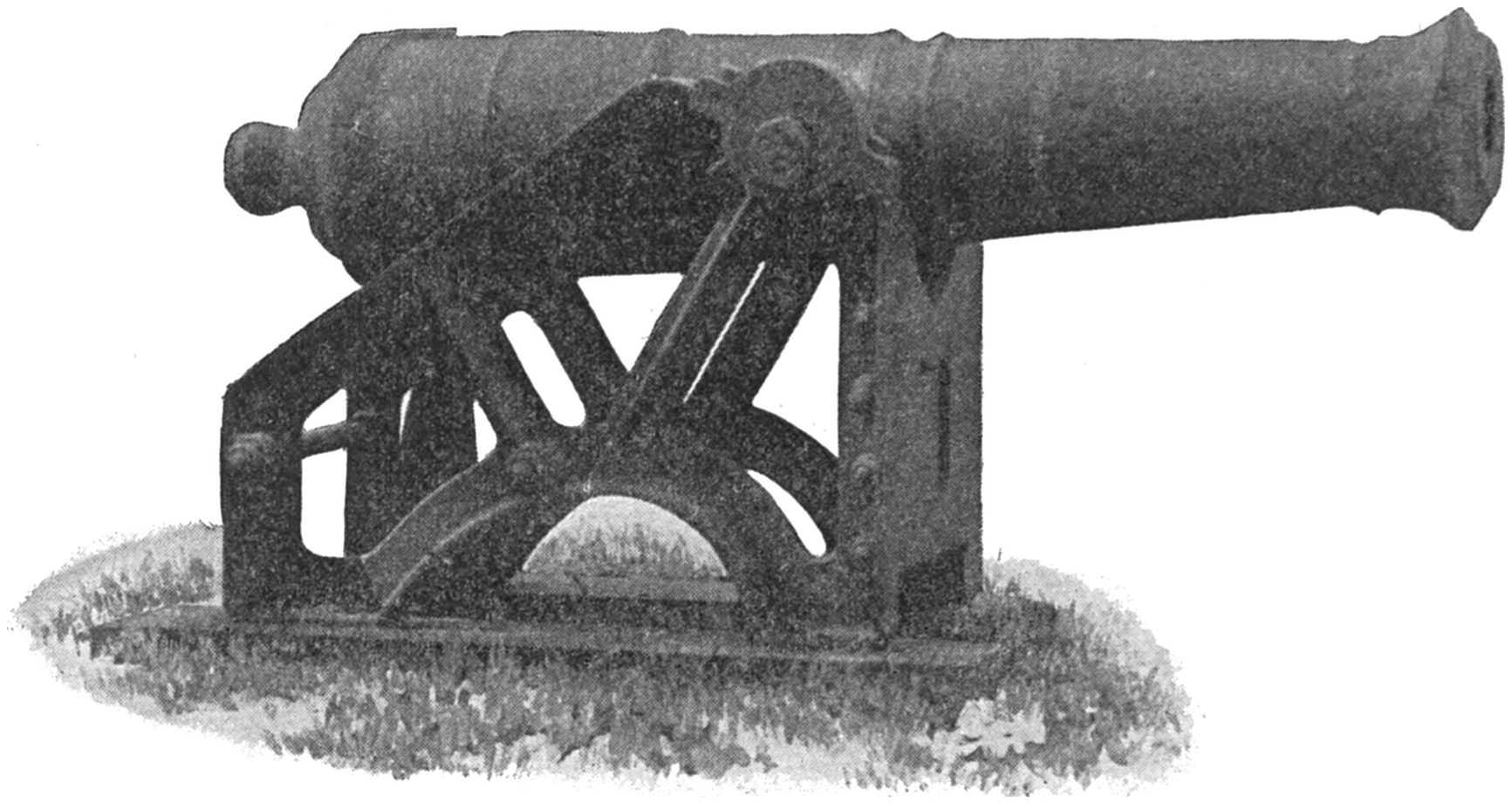
Robert L. Stevens, of Hoboken, in 1832, conceived the idea of an ironclad ship that was to be 250 feet long and twenty-eight wide—something lean and eager in pursuit and yet shot-proof. It was an idea that cost him and his family nearly $2,000,000 before he was done with it; but nothing came of it, save as it kept the restless inventors of the world thinking on the subject of swift, impregnable ships of war. Mr. Clinton Roosevelt, of New York, proposed to build a steamer that should be sharp at both ends, “plating them with polished iron armor, with high bulwarks, and a sharp roof plated in like manner, with the design of glancing the balls. The means of offense are a torpedo, made to lower on nearing an enemy, and driven by a mortar into the enemy’s side under water, where, by a fusee, it will explode.” The idea of polishing the armor to make it slippery seems amusing now; but the fact is that even as late as10 1862 the armor of vessels in the Civil War was greased to make the projectiles glance off. Of course, the grease was of no use.
It is worth noting that it was in 1836 that John Ericsson patented in England his screw propeller. A model boat forty-five feet long, which he named, for the American consul at Liverpool, the Francis B. Ogden, attained in 1837 a speed of ten miles an hour. The Lords of the Admiralty took a trip in this boat, and the opinion of Sir William Symonds, who spoke for the others, is worth giving as showing how thick-skulled prejudice operates to retard naval progress. He said: “Even if the propeller had the power of propelling a vessel, it would be found altogether useless in practice, because the power being applied in the stern, it would be absolutely impossible to make the vessel steer.”
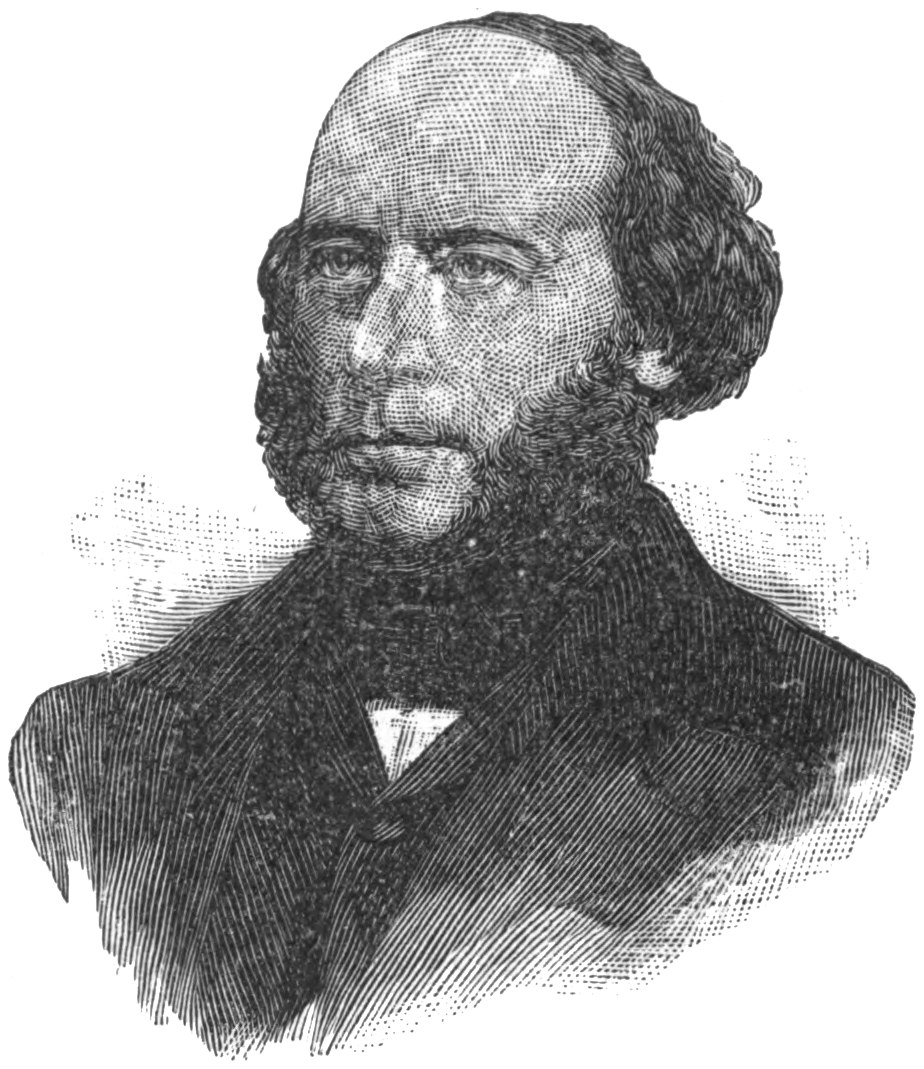
However, Capt. Robert F. Stockton made a trip on the Ogden, and fortunately Stockton was at once a man of wealth and of common11 sense. Being convinced of the value of the invention, he induced Ericsson to leave England for the United States in the year 1839, and that was, in a way, one of the most interesting events in the history of the American republic.
Meantime, however, a steamer to replace the old Demologos, Fulton’s first war steamer, had been launched in 1837. Practically the Fulton 2d, as she was called, was a sloop-of-war—a ship of one deck of guns, propelled by paddle-wheels. She was broad and shallow in model, being 180 feet long by thirty-five wide and thirteen deep. She had horizontal engines lying on her upper deck. Her paddle-wheels were twenty-two feet in diameter, towering high above the deck, and her boilers were made of copper. However, she carried eight long forty-twos and a long twenty-four—a right powerful set of guns for that day, and she behaved so well that Capt. Mathew C. Perry, who was assigned to her, expressed the opinion that a time would come when sails, as a means of propelling a man-of-war, would become obsolete. However, it must be said that this remark made almost every one who heard of it, and especially the other officers of the navy, think that Perry was a “visionary.”
It was in 1839 that Perry risked his reputation by an expression of opinion—about the12 time that Ericsson reached the United States. Backed by Stockton, Ericsson planned a man-of-war that should be driven through the water by a submerged screw at the stern. The idea of a ship being driven by machinery that was placed wholly below the water-line, and so out of danger from an enemy’s shot, was of a kind to appeal even to a backwoods congressman, and an appropriation was obtained. In 1843 the ship was launched under the name of Princeton, and she was in a variety of ways vastly superior to anything built before her. She was 164 feet long by thirty wide and twenty-one deep, and with 200 tons of coal and all supplies on board, she had a draft of nearly twenty feet.
Among other features, it appears that she was the first warship fitted to burn anthracite coal, thus avoiding the dense volumes of black smoke which revealed all foreign war-steamers. She was the first to carry telescopic funnels that could be lowered to the level of the rail out of the way of sails, and the first to use blowers to force the draft in the furnaces. She was also the first to couple the screw directly to the engine instead having cog-wheels intervene.
Her armament was also peculiar, for she was fitted with two long wrought-iron guns that threw balls about a foot in diameter, weighing14 225 pounds—guns that, when fired at a target at a range of 560 yards, pierced fifty-seven inches of solid oak timber.
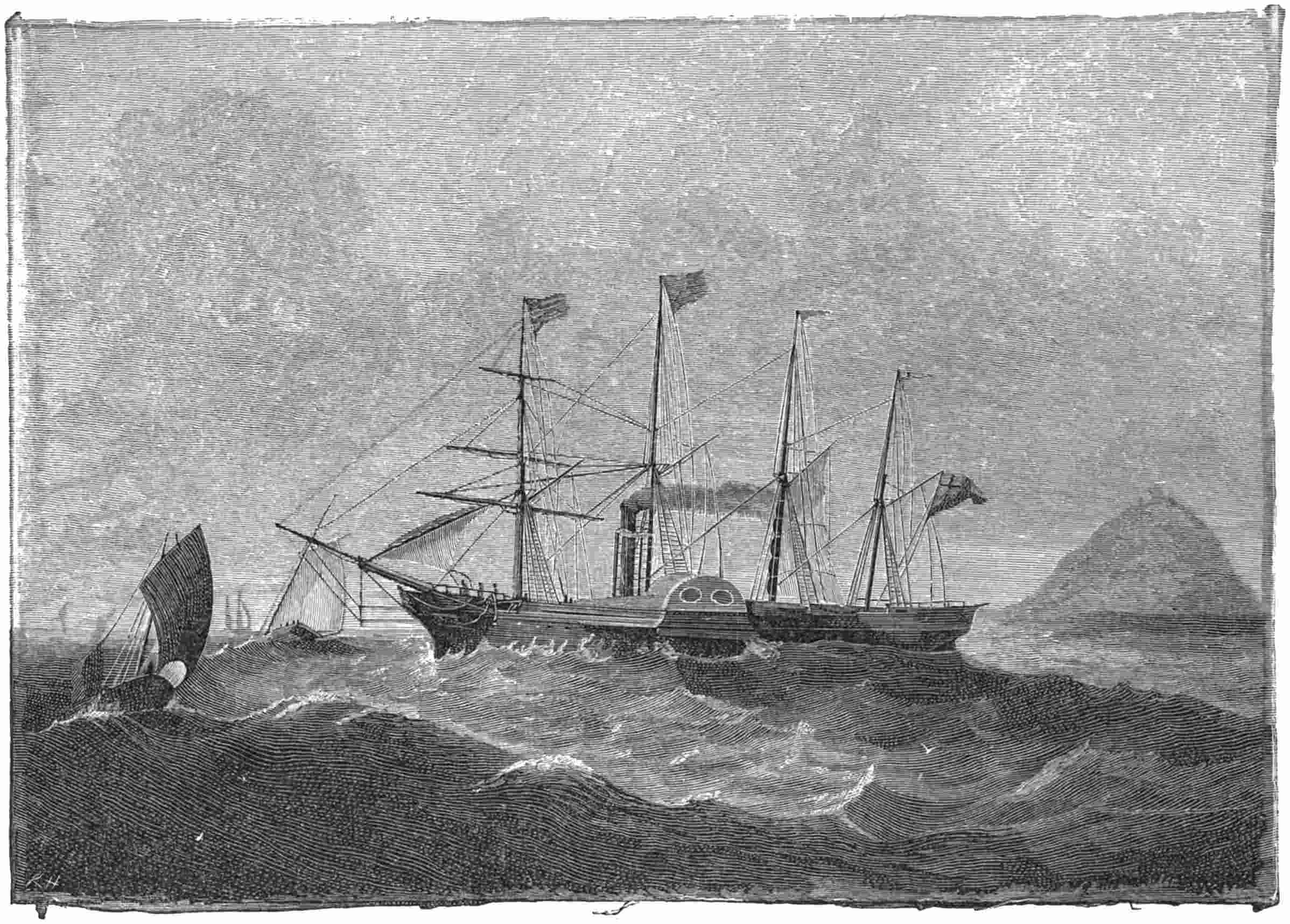
The Great Western—One of the First Steamships to Cross the Atlantic Ocean.
After an old painting.
And there was one other peculiarity to which Stockton, who commanded her, called attention with pride: “To economise room, and that the ship may be better ventilated, curtains of American manufactured linen are substituted for the usual wooden bulkheads.”

Twelve-inch Wrought-iron Gun—the Mate to the “Peacemaker,” which Burst on the Princeton.
(The carriage is a mortar carriage from Porter’s mortar fleet at New Orleans.)
From a photograph of the original at the Brooklyn Navy Yard.
As a steamship the Princeton was a very great success, but the art of forging was not then sufficiently advanced to warrant the manufacture of any but cast-iron guns. On a trial trip made from Washington in 1844, one of the great forged guns burst, killing and wounding a number of gentlemen, including the Secretary of State and the Secretary of15 the Navy, with several ladies who had been invited to go on the trip. Stockton had boasted that “the numerical force of other navies, so long boasted, may be set at naught, and the rights of the smallest as well as the greatest nations may once more be respected.” And the boast would have been almost justified but for the failure of the wrought-iron gun.
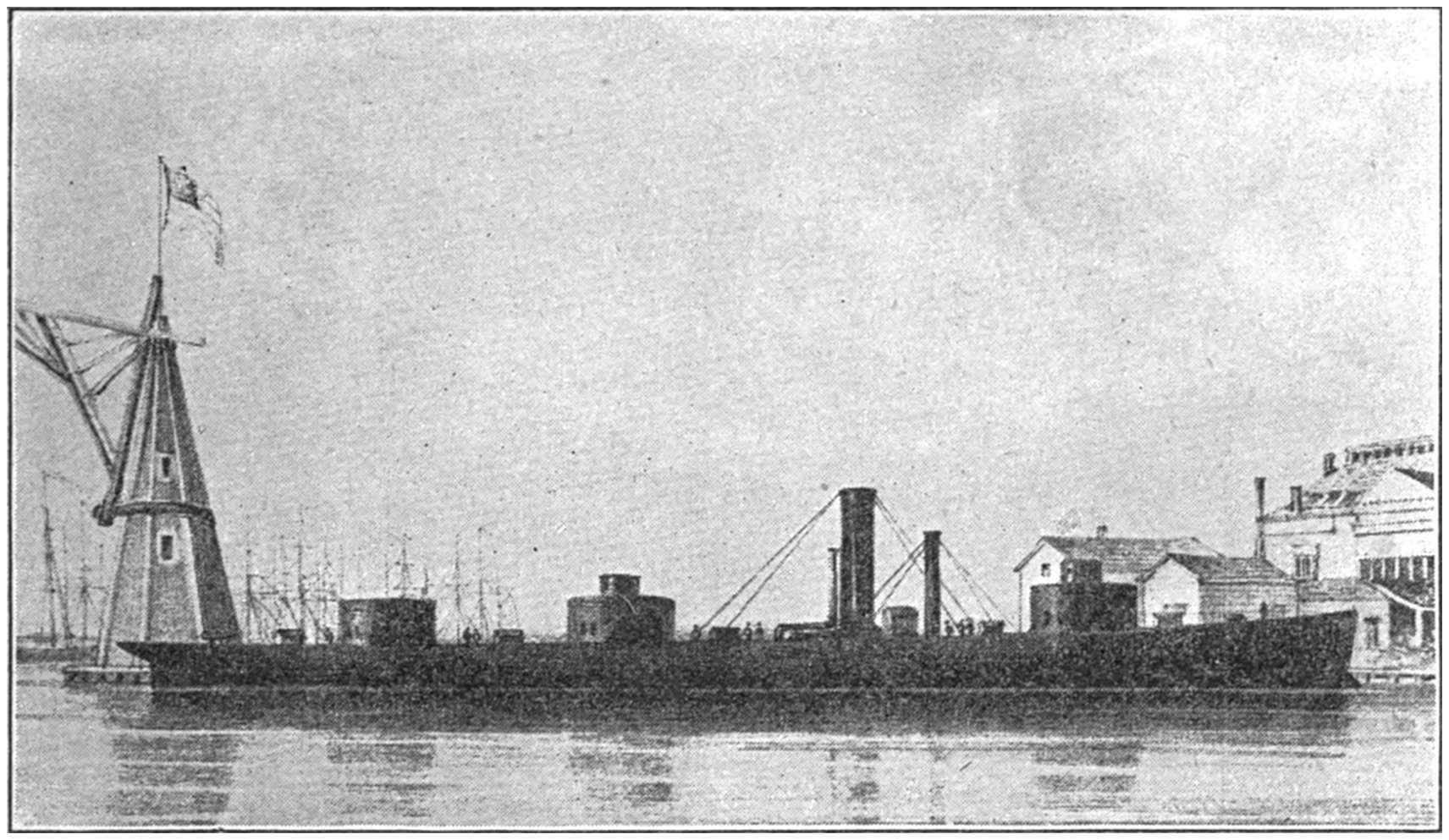
U. S. Ironclad Steamship Roanoke.
(The first turreted frigate in the United States, 1863.)
From an old lithograph.
However, the success of the Princeton as a ship was so pronounced that money was appropriated from time to time for others designed much as she was until the navy had six screw frigates—the Niagara, the Roanoke, the Colorado, the Merrimac, the Minnesota, and the16 Wabash; six screw sloops of the first class—the San Jacinto, the Lancaster, the Brooklyn, the Hartford, the Richmond, and the Pensacola, besides eight screw sloops of the second class, of which the Iroquois was a type, and five of the third class, of which the Mohawk was a type. There was also a screw frigate on the stocks at the Portsmouth, New Hampshire, dock-yard. The guns that these ships carried, when compared with those of the war of the Revolution, were quite as interesting as the ships themselves.
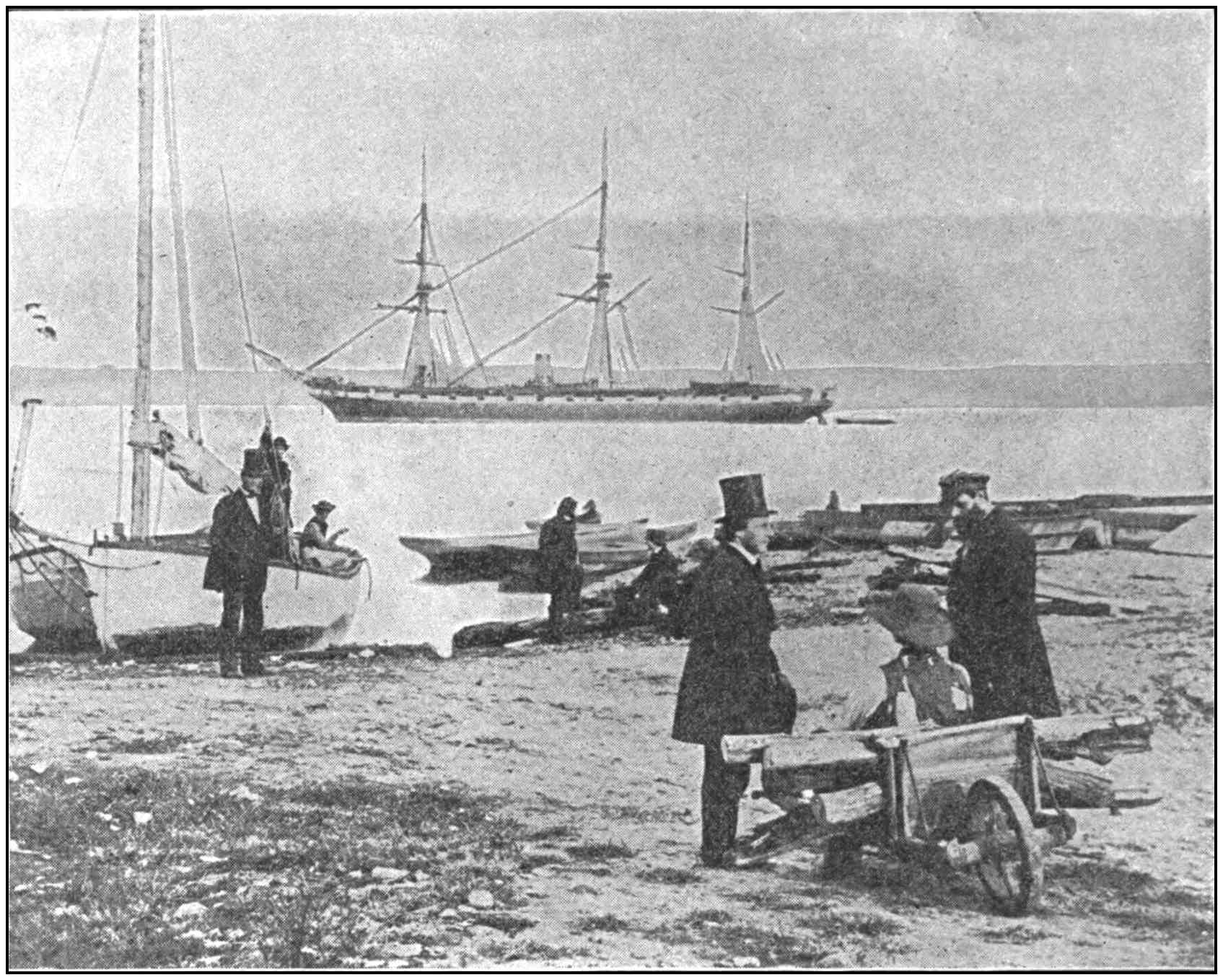
U. S. Frigate Pensacola off Alexandria.
From a photograph taken in 1865.
17
The prejudices in the way of improving great guns were not only strong, but they were founded on experiences that were seemingly convincing beyond peradventure. For instance, under Charles V a cannon was cast at Genoa that was fifty-eight calibres long; that is, it was of about six inches diameter of bore and twenty-nine feet long. When fired, its ball of thirty-six pounds weight had less range than an ordinary twelve-pounder. So they cut off four feet of the gun and found that its range increased. Cutting off three feet more still further increased the range, as did another cut of six inches—“which shows,” says Simpson’s text-book on gunnery, printed in 1862, “that there is for each piece a maximum length which should not be exceeded.” So that dictum stood in the way of arriving at the design of a gun like the modern rifle, that would really give the greatest possible range to a projectile. Then, the distribution of the metal in the cannon with which Arnold fought on Lake Champlain seems now ridiculous. One must needs see a picture of the old gun beside one of the guns as developed just previous to the Civil War to realize the difference; but it may be said that, with the bell-shaped muzzle and the “rings” and “reinforces,” the old gun in outline had as many ups and downs as some step-ladders, while the cast-iron weapon of 186018 was as smooth and symmetrical as the hull of a Yankee clipper.
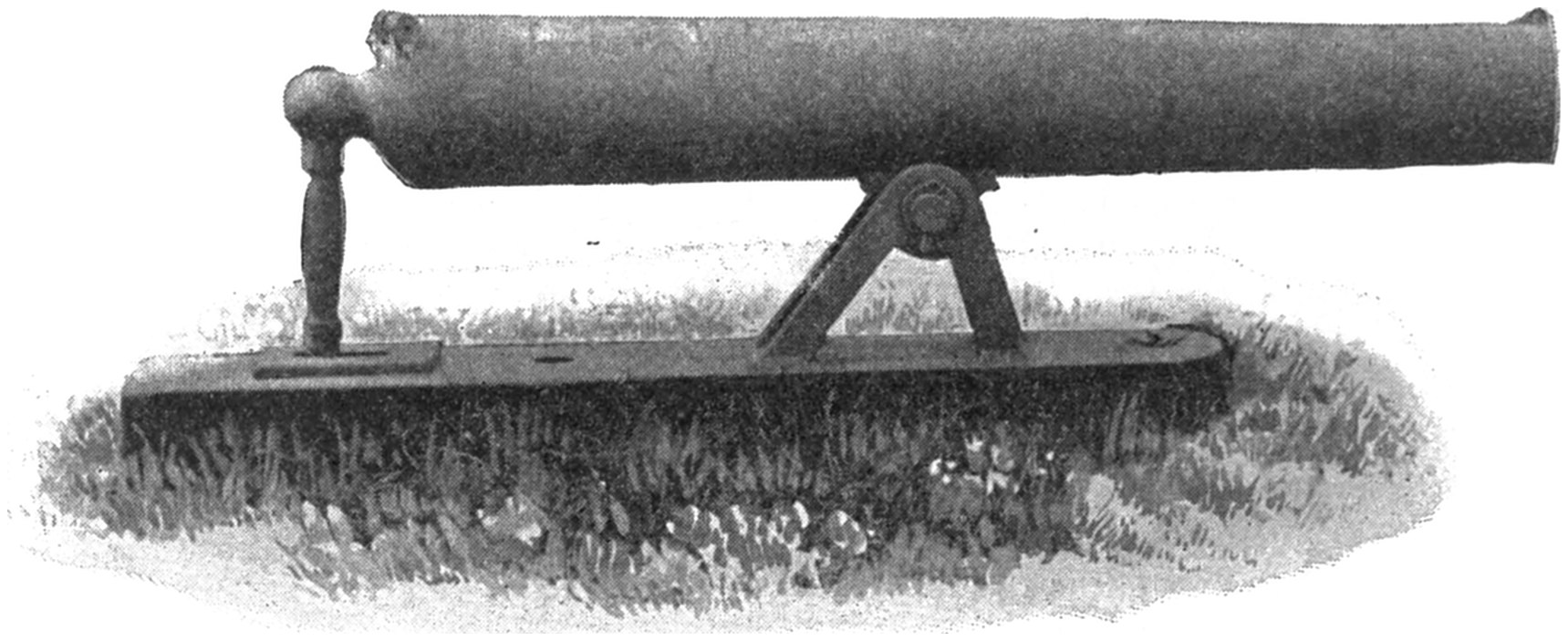
A Twelve-pound Bronze Howitzer—the First One Made in the United States.
From a photograph of the original at the Brooklyn Navy Yard.
A curious series of experiments, made by Colonel Bomford of the United States Ordnance Department, told for the first time where the greatest strain was exerted on the bore of a gun, and gave some idea of the relative strain elsewhere along the bore. Taking an old cannon, he drilled a hole from the side near the muzzle directly into the bore and inserted a pistol-barrel. Then he put a bullet into the pistol-barrel, and after loading the cannon in the ordinary way, he fired it. Of course, as the cannon-ball was driven from the big gun the powder gas behind it drove the pistol-ball from the pistol-barrel. The colonel measured the velocity of the pistol-ball and made a note of it. Then he drilled another hole in the cannon some inches farther from the muzzle, and repeated19 the experiment. The force exerted on the pistol-ball was slightly greater there. By drilling other holes he learned approximately the pressure all along the bore. It appeared that the greatest pressure was directly over the shot when it was rammed home against the powder. From there the pressure decreased rapidly, being only about half as much when the ball had travelled four times its own diameter from its original resting place.

Captain Rodman of the Ordnance Department, put a piston in place of Bomford’s pistol-barrel and let the piston punch into a piece of copper, and then determined the pressure on the piston by forcing the same kind of a piston into the same kind of a piece of copper by a known weight. “Although not an accurate process,” it was good enough, and with the figures obtained by it before him, Lieut. John Dahlgren, of the United States navy, designed the gun of smooth outline that by its splendid20 success in the hands of both forces, during the Civil War, made him famous. The greatest thickness of metal was placed around the greatest strain, and a proper thickness at every inch of length of the bore.
It was not alone, however, in putting the metal where it would prove most serviceable that Dahlgren made his gun efficient. He was a metallurgist, and was careful to improve the quality of iron used.
Meantime Captain Rodman had proposed to cast cannon hollow and cool them from the interior, instead of casting a solid log of iron and boring it out on the old plan. Although the first experiments did not show any especial improvement in the strength of a gun so cast, the method was eventually found to be the best.
With Dahlgren’s model a gun of eleven inches of diameter of bore was cast in 1852. It was fired 500 times with shells and 655 times with solid shot that weighed 170 pounds, the service charge of powder being fifteen pounds. The gun was not seriously injured or worn even by the work. That settled the status of the Dahlgren guns, and from that time on they were furnished with reasonable rapidity to the new steam warships of the navy.
Meantime rifled cannon made of cast iron reinforced over the breech by a wrought-iron21 jacket that was shrunk on had been introduced into the American navy. They varied from thirty-pounders up to 100-pounders, and, except for the smaller calibres, were in many cases more dangerous for their crews than for the enemy. It must be told also that a cast-iron rifle known as the Brooke, because designed by Commander John M. Brooke, of the Confederate navy, was produced in Richmond that was better than the Parrott. It was strengthened in its early service days by a series of wrought-iron bands two inches thick and six wide, that were shrunk on over the breech. Later a second series of bands was shrunk on over the first, breaking joints with them, of course, and so a very good 150-pounder was produced.
Meantime one Dahlgren smooth-bore, with a bore fifteen inches in diameter, had been successfully made, and the shells for all the Dahlgren guns were provided with fuzes that could be set to explode just about where and when the gunner wished to have them do so. But whether the damage to be done by a fifteen-inch round shot smashing its way through a ship’s side would be greater or less than that of a rifle projectile boring its way through was a question that had not been decided. It was granted that the rifle had the longer range—with a reasonable elevation a rifle would carry22 three miles, maybe four, and do some damage when the projectile arrived, while the effective range of the smooth-bore was, say, 1,500 or 1,600 yards, though gunners made efforts, when the time came, to run in to a range of 600 yards or less instead. But, on the whole, it was the belief among American naval officers before the Civil War that the big Dahlgren smooth-bore was the best gun afloat.
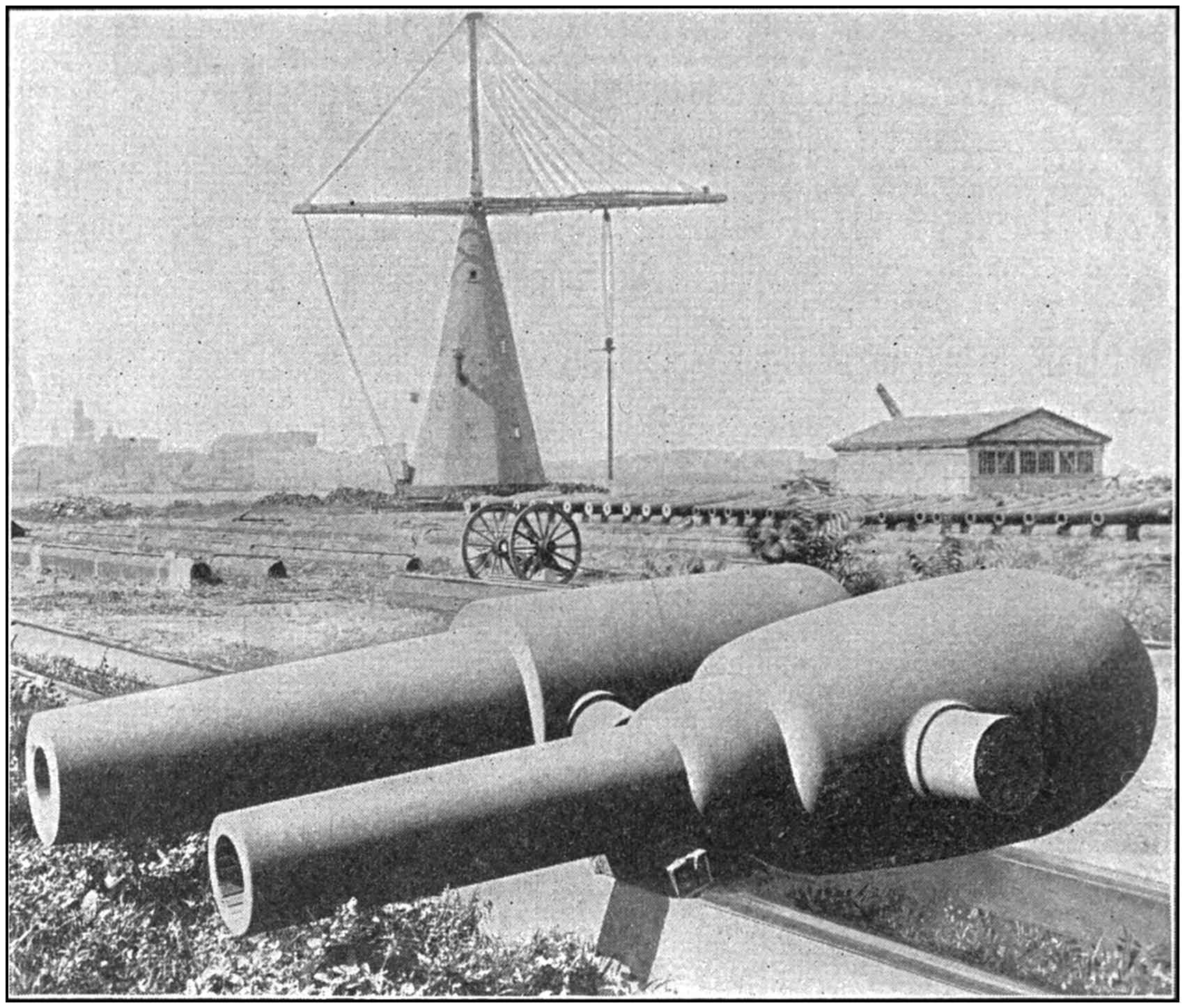
So it came to pass that the newest and best ships of the navy were armed with the Dahlgren gun. The Merrimac, which was not the23 best of the frigates, carried twenty-four nine-inch guns on her gun deck, with fourteen eight-inch and two ten-inch pivots on her spar deck. She could throw 864 pounds of metal from her gun-deck broadside, 360 pounds from her broadside of eight-inch guns, and 200 from her ten-inch, both of which could be fired over either rail.
Mr. Hans Busk, M.A., of Trinity College, Cambridge, was moved to write on page 104, in his “Navies of the World,” that “the navy of the United States has a tolerably imposing appearance upon paper,” but he concludes that a British frigate of the Diadem class, “avowedly built to cope with those of the description of the Merrimac, etc., would speedily capture her great ungainly enemy.” To fully appreciate this remarkable statement it must be known that the Diadem could fire at a broadside ten ten-inch shells, weighing in the aggregate 820 pounds, five thirty-two-pound solid shot, and two sixty-eight-pound solid shot—in all 1,116 pounds of shot to 1,424 pounds that the Merrimac’s broadside weighed.
The frigate Minnesota carried, soon after the Civil War broke out, no less than forty-two nine-inch Dahlgrens, one of eleven inches, four 100-pounder rifles, and one 150-pounder rifle. She could throw 1,861 pounds of metal at a broadside. Moreover, it was not a mere matter24 of weight of metal. The diameter of the American projectiles was a matter for serious consideration by the enemy, and so was the ability of the gun to stand service. The best English gun could stand a charge of twelve pounds of powder, and the best American fifteen. There was a vast difference in the smashing effect of an eleven-inch shell driven by fifteen pounds of powder and a ten-inch shell driven by twelve.
All this seems worth telling only because it shows that the ideas of armament which prevailed among the English and the Americans before the War of 1812 were still held by the two nations in 1859. Indeed, the disproportion between the Minnesota’s armament and that of the Diadem was very much greater than that between the United States and the Macedonian.
In short, all things considered, the American people had just the fleet they needed for that day to resist foreign aggression.
But while the patriot holds up his head in pride at the thought of the ships of 1859, he hesitates and stammers when he comes to tell of the men—of the personnel of the navy. It was a far cry from the sailing ships of the old days to the steam frigates of the later, but it was a farther one, and a cry over the shoulder at that, from the men who swept the seas25 under the once-despised gridiron flag to those who carried the American naval commissions in 1859. It was not that courage and enterprise were dead, or knowledge and skill were lacking. There were, of course, men a-plenty who were brave and tactful and energetic and learned—plenty who were to become during the war men of the widest fame. But “long years of peace, the unbroken course of seniority promotion, and the absence of any provision for retirement,” had served the officers as lying in ordinary served white oak ships. Nearly all of the captains were more than sixty years old. The commanders at the head of the list were between fifty-eight and sixty years of age. There were lieutenants more than fifty years old, and only a few of the lieutenants had known the responsibility of a separate command.
And then, “as a matter of fact,” as Professor J. R. Soley says in his work on “The Blockade and the Cruisers,” “it was no uncommon thing, in 1861, to find officers in command of steamers who had never served in steamers before, and who were far more anxious about their boilers than about their enemy.”
But that was not all nor the worst that can be said of the personnel of that day, for a sentiment—a faith—had developed and spread to a degree that now seems almost incredible,26 under which men who had made oath that they would always defend the Constitution of the United States came to believe that they were under obligations to draw their swords against the flag they had sworn to defend—the flag which some of them had defended with magnificent courage.
That the politicians should have been secessionists is not at all a matter of wonder. It was entirely natural. But how a Tatnall, the story of whose bravery at Vera Cruz still thrills the heart; how an Ingraham, whose quick defence of the rights of a half-fledged American in the Mediterranean is still an example to all naval officers—how these men could have placed the call of friends and neighbors and a State above the obligation of their oath to support the Constitution, is something that is now incomprehensible.
It must be granted that they were of good conscience. There was not a sordid thought in their minds—not one. Indeed, most of them felt that they were making the greatest of sacrifices for the sake of principle. But, if the writer may express his thoughts without offence, no patriot can now read of the glorious achievements of the men who in other days fought afloat for the honor of the nation, without feeling inexpressibly shocked at the thought that any man of the navy should have27 been found willing under any circumstances to strike at the gridiron flag.
There is not a little interest in considering the actual numbers of the men who left the navy to take part with the Southern States. Before South Carolina passed her ordinance of secession there were 1,563 officers, commissioned and warrant, on the naval register. Of these, 677 were from Southern States; but 350 of these Southern-born men remained true to the flag, while 321 resigned to enter the Confederate navy. Of thirty-eight Southern captains, sixteen resigned; of sixty-four Southern commanders, thirty-four resigned; of 151 Southern lieutenants, seventy-six resigned; of 128 Southern acting midshipmen, 106 resigned.
And that is to say that so demoralized had the navy become under the influence of quarrelling politicians that more than one-fifth of all the officers were ready to forsake their allegiance.
28
LINCOLN’S PROCLAMATION—IT WAS SOMETHING OF A TASK TO CLOSE 185 INLETS AND PATROL 11,953 MILES OF SEA-BEACHES, ESPECIALLY WITH THE FORCE OF SHIPS IN HAND—ONE MERCHANT’S NOTION OF THE EFFICIENCY OF THIRTY SAILING VESSELS—GATHERING AND BUILDING BLOCKADERS—INCENTIVES AND FAVORING CIRCUMSTANCES FOR BLOCKADE-RUNNERS—WHEN PERJURY FAILED AND UNCLE SAM WAS ABLE TO STRIKE WITHOUT WAITING FOR ACT OF CONGRESS—WHEN BLOCKADE-RUNNERS CAME TO NEW YORK AND YANKEE SMOKELESS COAL WAS IN DEMAND.
The story of the actual work done by the navy in this last war for the preservation of the life of the nation begins when a blockade of the ports of the seceded States was ordered. Two proclamations were issued to provide for this measure. The first was issued on April 19, 1861, which, as the reader will remember, was six days after the capture of Fort Sumter, in Charleston harbor, by the secessionists. It covered all the ports of the South except those of Virginia and Texas; but on the 27th of the same month, these two States having also joined the Confederacy, their ports were included by a second proclamation. Because,29 from a naval point of view, that was the most important proclamation issued by a President of the United States since the War of 1812, its words shall be given literally.
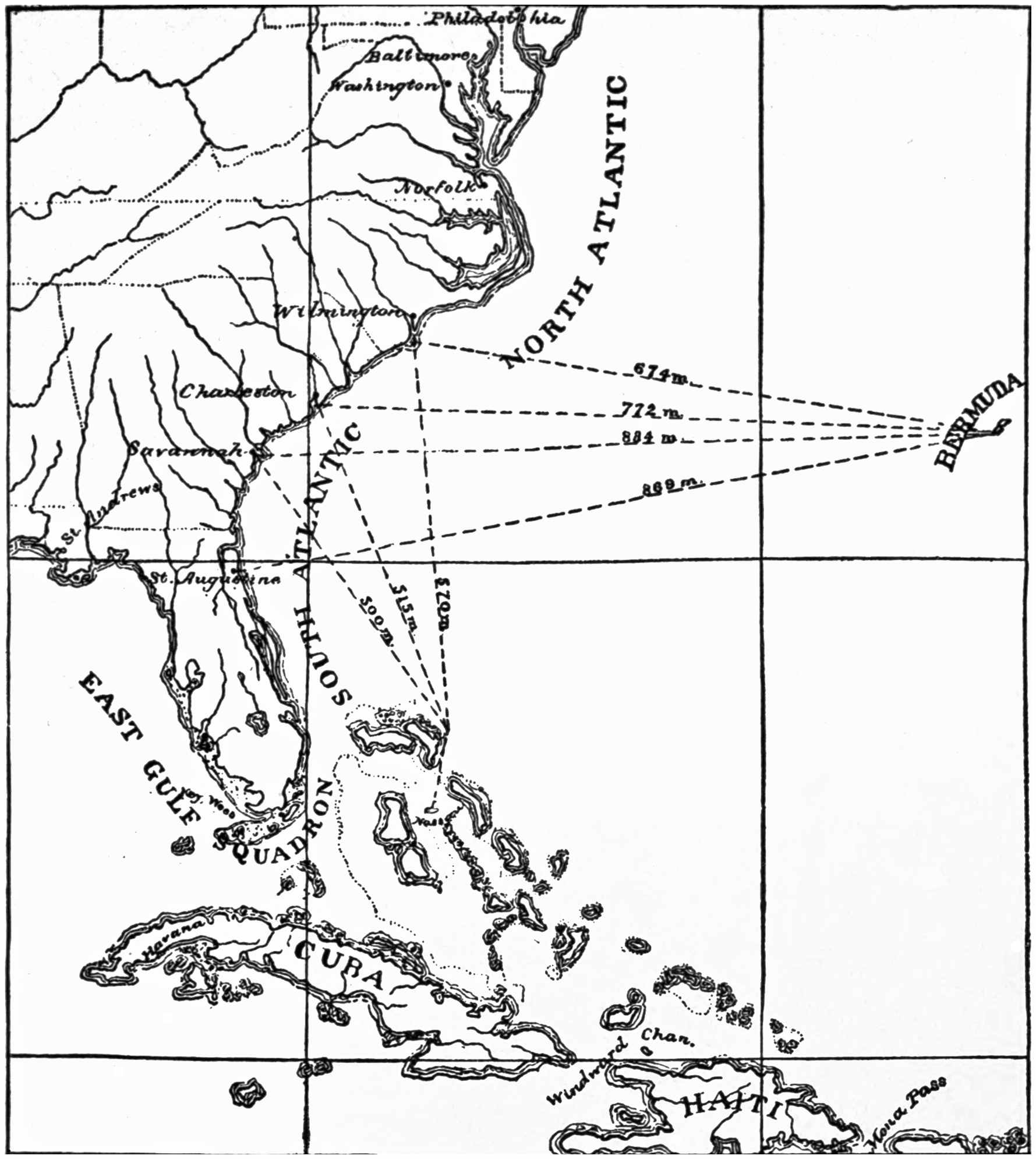
The Blockaded Coast.
From “The Navy in the Civil War.”
“Now therefore I, Abraham Lincoln, President of the United States ... have further deemed it advisable to set on foot a blockade30 of the ports within the States aforesaid, in pursuance of the laws of the United States and of the Law of Nations in such case provided. For this purpose a competent force will be posted so as to prevent entrance and exit of vessels from the ports aforesaid. If, therefore, with a view to violate such blockade, a vessel shall approach or shall attempt to leave any of the said ports, she will be duly warned by the commander of one of the blockading vessels, who will endorse on her register the fact and date of such warning, and if the same vessel shall again attempt to enter or leave the blockaded port, she will be captured, and sent to the nearest convenient port for such proceedings against her, and her cargo as prize, as may be deemed advisable.”
It is worth while considering in advance some of the facts relating to the task that was thus set for the navy. The coast line invested extended from Alexandria, Virginia, to the borders of Mexico on the Rio Grande. The continental line was 3,549 miles long. The coast or shore line, including bays and similar openings, was 6,789 miles long; and if to this be added the shore lines of the islands which were included in the blockade and which were necessarily watched by the blockading fleet, the entire length of beaches under guard was exactly 11,953 miles.
31
The South Carolina islands, as described by Jedidiah Morse, “are surrounded by navigable creeks, between which and the mainland is a large extent of salt marsh fronting the whole State, not less on an average than 4 or 5 miles in breadth, intersected with creeks in various directions, admitting through the whole an inland navigation between the islands and mainland from the northeast to the southeast corners of the State. The east sides of these islands are for the most part clean, hard, sandy beaches, exposed to the wash of the ocean. Between these islands are the entrances of the rivers from the interior country, winding through the low salt marshes and delivering their waters into the sounds, which form capacious harbours of from 3 to 8 miles over, and which communicate with each other by parallel salt creeks.” And that will apply to the whole coast.
More than that, in this length of shore line were found 185 harbor and river openings that might be used for the purposes of commerce with the Confederate States. It is also an important fact that these harbor openings were, in almost every instance, too shoal for the ordinary ocean-going cargo ships of that day. If too shoal for a merchantman, they were so for a man-o’-war, and the more intricate and variable the channels the better adapted they32 were to the purposes of a trade that was to be carried on in spite of the blockade.
To close these 185 harbor openings the government had, on the day the proclamation was issued, twenty-six steamers and sixteen sailing ships in commission. But let not the uninformed reader suppose that such a great fleet as this was at once started off on that duty. There were in the home squadron but five sailing ships and seven steamers, while of these a number were at sea en route from nearby foreign to American ports, and of those actually in the United States harbors but three—the Pawnee, the Mohawk, and the Crusader—were in Northern waters. To close 185 harbor openings the Secretary of the Navy had for the moment just three steamers, the rest of the commissioned fleet being either in the ports of the Southern States or scattered the wide world over. And that is to say, there was for the moment no force adequate to blockade efficiently even the one Southern port of Charleston.
The navy register showed, however, in addition to the forty-two ships in commission, twenty-seven that were lying at the navy yards in ordinary but fit for service. The government had thirty-nine steamers and thirty-four sailing ships that might be brought together in the course of a few months to enforce the34 blockade of the 185 harbors of the South and keep contraband trade clear of the eleven thousand and odd miles of Southern sea-beaches.
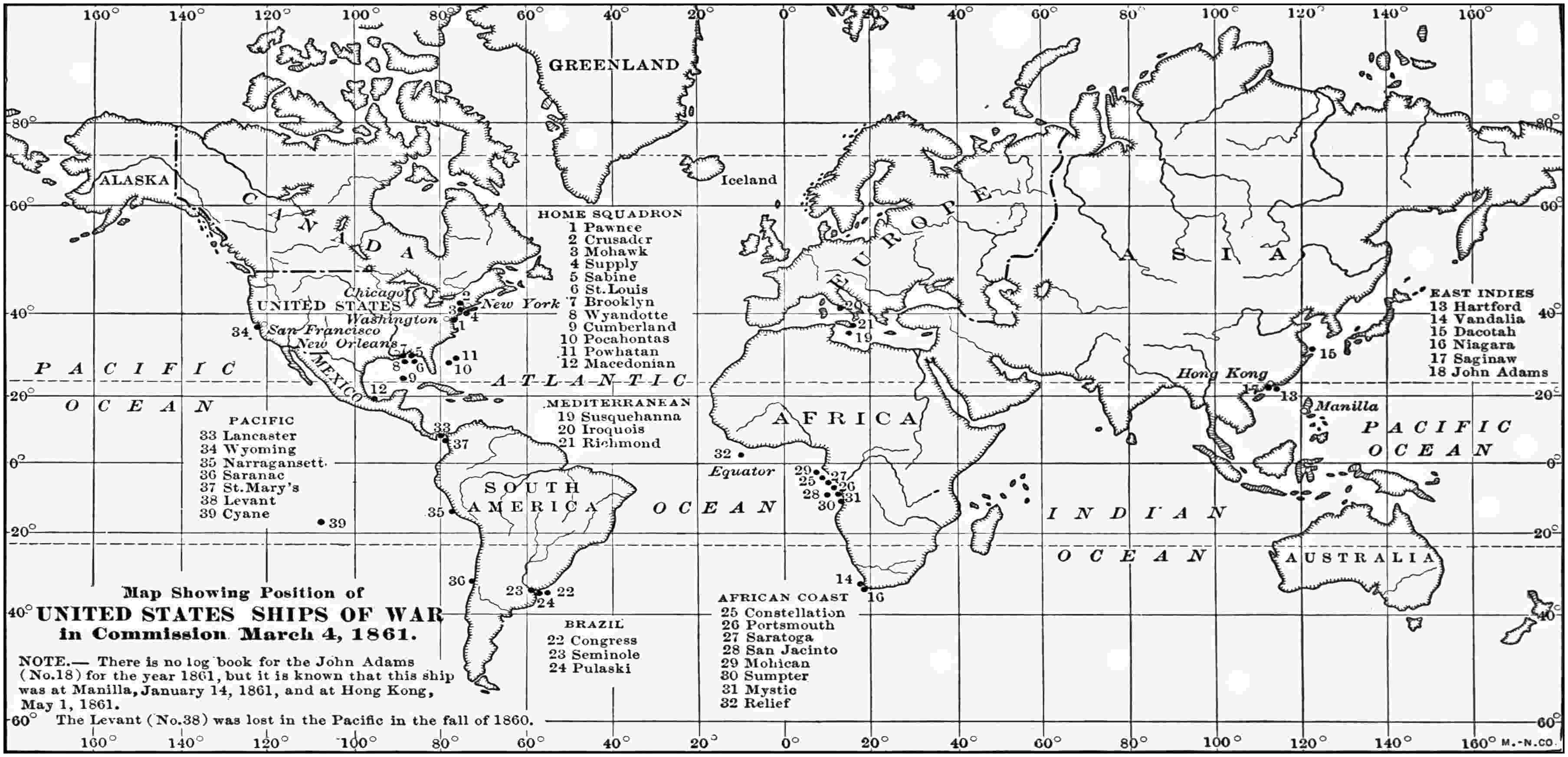
Map Showing Position of
UNITED STATES SHIPS OF WAR
In Commission March 4, 1861.
NOTE:—There is no log book for the John Adams (No. 18) for the year 1861, but it is known that this ship was at Manilla, January 14, 1861, and at Hong Kong, May 1, 1861.
It is worth noting here that when the Navy Department was first considering its lack of ships for the purpose of enforcing the blockade, a consultation was had with a number of the most eminent ship-owners of New York. The leader of these eminent ship-owners, after considering the subject carefully, said to Secretary Welles that thirty sailing vessels would have to be purchased before an actual blockade of the ports could be completed. As a matter of fact, over 600 ships were employed at the end, and even then some blockaders got through.
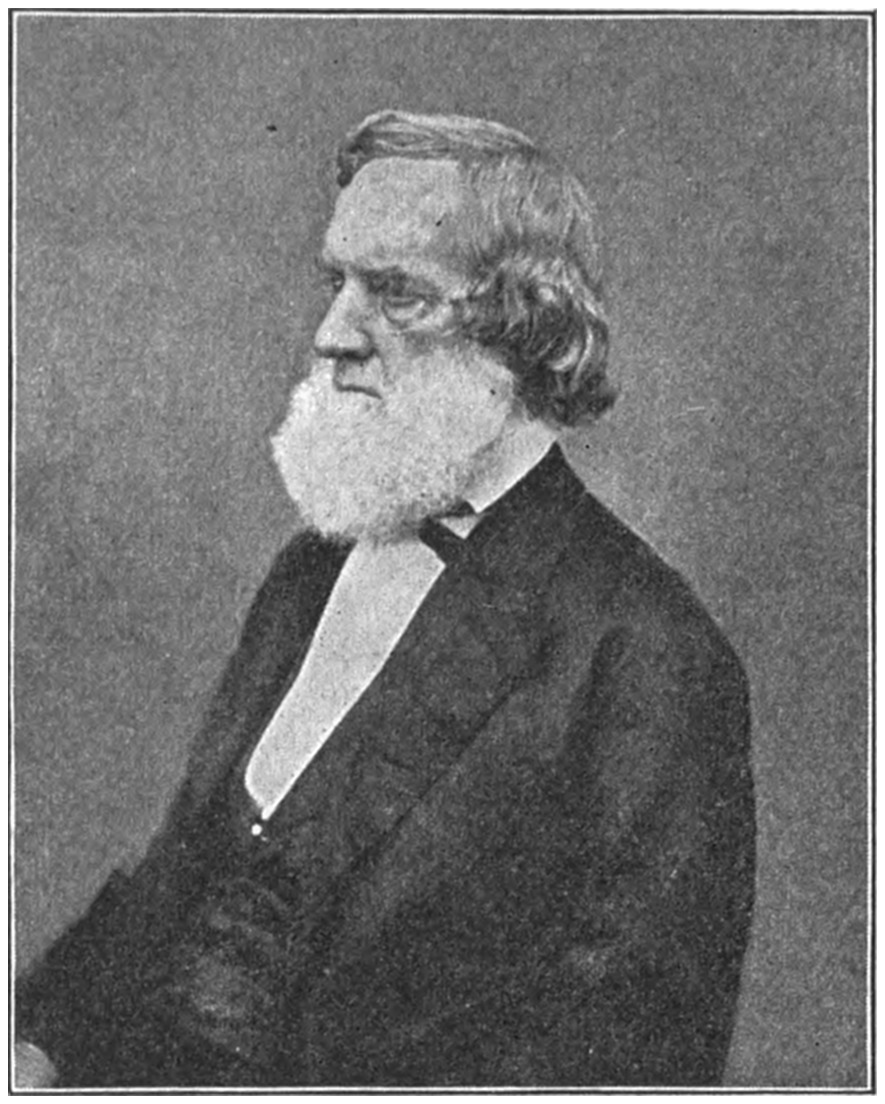
Gideon Welles.
From a photograph.
But it was not alone in a lack of ships that the government was embarrassed. It was necessary to find officers and crews for the ships that were not in commission. Hundreds35 of men were needed to man even one of the five screw frigates, and yet to man the whole twenty-seven ships not in commission there were, on March 4, 1861, “only 207 men in all the ports and receiving ships on the Atlantic coast.” “It is a striking illustration of the improvidence of naval legislation and administration that in a country of thirty millions of people only a couple of hundred were at the disposal of the Navy Department.”
And as for the officers, as has been already shown, when the need of the nation was greatest, a fifth of them drew swords against the flag instead of defending it.
To still further hamper the work of the Navy Department, Congress was very slow to learn that a vast naval force was needed. The fact that the South had no navy and no merchant marine of its own, seemed, in the minds of the Congressmen, to make it wholly unnecessary to spend money on fighting ships. Indeed, a Navy Department has rarely been in a more distressful condition than was that under Mr. Gideon Welles in the first six months or so of the administration of President Lincoln.
However, a beginning was made. Perhaps the first step of importance in fitting the navy for war was the appointment of Mr. Gustavus V. Fox as assistant to Mr. Welles, for Fox36 had been a naval lieutenant and brought a practical knowledge of naval affairs with him when he was placed in charge of the actual war operations of the ships.
First of all, of course, was the work of getting men by a call for volunteers. The call was answered by hosts, but never by as great numbers as were needed. Captains and mates from the Northern ports and the Great Lakes were the more valuable part of this volunteer force, but so great was the need of officers that not a few men who had never been at sea received appointments. The youngsters at the Naval Academy who had had one year’s instruction, or more, were taken at once into the service. They were mere boys, but they had learned something of warships, and some of them made names that will not be easily forgotten.

Gustavus V. Fox.
From an engraving.
The next effort after the call for men was to issue a call for ships. The department strove to buy “everything afloat that could be37 made of service,” and where owners would not sell, to charter the ships. At first the ships were purchased by the department direct or by naval officers. Altogether, twelve steamers had been purchased and nine chartered by July 1, 1861; and it is worth recording that, because greed was a stronger passion than love of country, the prices charged were outrageously high. Afterwards a business man was appointed to the task of buying ships, and somewhat better rates were then obtained, while a board of naval officers inspected the ships to decide on their fitness and the alterations needed to make them serviceable.
It was a heterogeneous collection, a nautical curiosity shop, that they got together—deep-water ships, inland-water steamers, ferryboats, and harbor tugs. The inspecting officers were compelled by stress of need to accept about everything that would float and carry a gun. And, singular as it may seem at first thought to those who in these days ride on them, the double-ended ferryboats made very successful naval ships. It was the Fulton ferryboat Somerset that captured the blockade-runner Circassian off Havana—a prize that yielded $315,371.39 to her captors. Nor was that her only service. Being well built to stand the hard knocks of their ordinary service, the ferryboats were easily fitted with heavy guns and38 served well in battering down alongshore forts.
By the 1st of December, 1861, the government had purchased 137 vessels, of which, however, fifty-eight were sailing vessels; and it may as well be told here as elsewhere that 418 vessels were purchased during the war, of which 313 were steamers.
Meantime the department started the work of building ships. Congress authorized seven sloops-of-war, and the department laid down eight, of which four were built to the lines of the sloops of 1858 in order to save time; and it is worth noting that the Kearsarge was among the four. The eight were begun immediately, and six more were laid down before the end of the year.
Without waiting for an appropriation, the department contracted with private shipyards for the building of twenty-three heavily armed screw gunboats. And this contract is worth more space than the mere statement of the fact, for it draws attention to the importance of the private shipbuilder as a factor in the sea power of a nation. Even in the War of 1812, when wooden sailing ships were the sole evidence of sea power, the private shipbuilder was of essential importance. It was a private shipbuilder from New York, Mr. Noah Brown, who sent Perry’s victorious squadron afloat on39 Lake Erie, and it was the private shipbuilder who gave the Americans the supremacy that they enjoyed from time to time on Lake Ontario. Without private yards amply equipped for the construction of the best warships afloat, no nation can have a sea power adequate for the protection of its honor and the preservation of peace.
These twenty-three gunboats mounted from four to five guns each, of which one was an eleven-inch smooth-bore. They were wooden boats, of course, and they were known as the ninety-day fleet because some of them were in commission within three months from the signing of the contract.
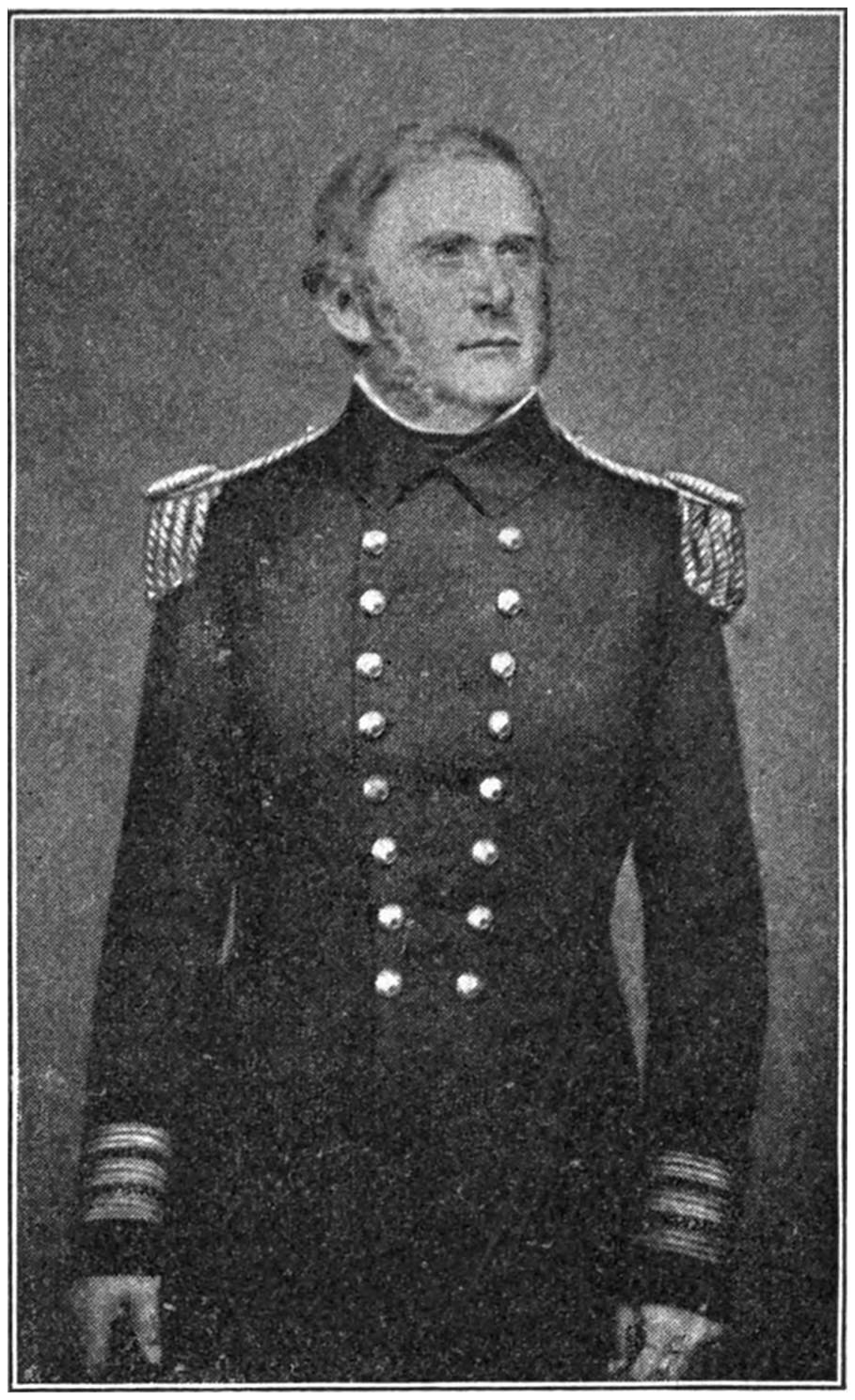
The fact that they were so quickly built is also worth considering in connection with the fact that ships relatively as efficient as they were could not now be built in less than a40 year. The day of a ninety-day fleet passed when steel was substituted for wood.
The first point actually blockaded was Hampton Roads. Flag Officer G. J. Pendergrast established the blockade there, and issued the following proclamation on April 30, 1861:
“To all whom it may concern:
“I hereby call attention to the Proclamation of his Excellency Abraham Lincoln, President of the United States, under date of the 27th April, 1861, for an efficient blockade of the ports of Virginia and North Carolina, and warn all persons interested that I have a sufficient naval force there for the purpose of carrying out that Proclamation.
“All vessels passing the Capes of Virginia, coming from a distance and ignorant of the Proclamation, will be warned off, and those passing Fortress Monroe will be required to anchor under the guns of the fort, and subject themselves to an examination.
“United States’ Flagship Cumberland, off
“Fortress Monroe, Virginia, April 30, 1861.
(Signed) “G. J. Pendergrast,
“Commanding Home Squadron.”
This proclamation is worth careful perusal for two reasons: The first reason is that it contained an untrue statement. Instead of having “sufficient naval force” “for an efficient blockade of the ports of Virginia and North Carolina,” he had barely enough for41 Virginia alone. Wilmington was a most important harbor of the South; it eventually became the favorite with blockade-runners, but there was not a ship ready to close it for many weeks after this proclamation was issued.
More important still is the second reason for reading the proclamation carefully—the fact that it was issued at the behest of the Navy Department, and illustrates clearly the department’s idea of a blockade at that time. It is necessary to say here that, owing to the excitement of the times, the government was making a very grave error—it was trying to establish a “paper blockade.” That is to say, there was a determined effort made to interdict trade where there was no blockade de facto—not a ship, or a rowboat even, stationed to close the port. And this was a most remarkable undertaking, because the “free trade” for which the War of 1812 was waged was the freedom to trade in any belligerent port not actually closed by the presence of a warship. The government was sacrificing a great principle for the sake of a temporary advantage.
This was not due to the mistake of a naval officer. It was the deliberate action of the administration, and it is not unlikely that it will come back, some time, to plague us when42 we are the neutral nation seeking for trade in a belligerent port.
Proof of the fact that the whole Cabinet was involved is found in the correspondence of Mr. Seward relating to the blockade off Charleston. The Niagara had arrived home from Japan on April 24th, and was sent to blockade Charleston as soon as possible, arriving off the bar on May 11th. She remained there four days only, and then went away in search of a ship that was said to be bringing arms from Belgium to a port further south, and there was no warship off that harbor until May 28th (some accounts say the 29th), when the Minnesota came to take the Niagara’s place. The Harriet Lane, a revenue cutter, used as a warship, did lie off the harbor on the 19th, but for thirteen days Charleston was entirely uncovered.
On May 22, 1861, Lord Lyons, the British minister at Washington, in the interest of British ships at Charleston, called the attention of Mr. Seward to the fact that the Niagara had left Charleston on the 15th and that the harbor was thereby opened. Replying to this, Mr. Seward wrote, along with other things, the following:
“The blockade of the port of Charleston has been neither abandoned, relinquished, nor remitted, as the letter of Her Britannic Majesty’s43 Consul would lead you to infer. We are informed that the Niagara was replaced by the steamer Harriet Lane, but that, owing to some accident, the latter vessel failed to reach the station as ordered until a day or two after the Niagara had left.
“I hasten, however, to express the dissent of this Government from the position which seems to be assumed by your note, that that temporary absence impairs the blockade and renders necessary a new notice of its existence. This Government holds that the blockade took effect at Charleston on the 11th day of this month, and that it will continually be in effect until notice of its relinquishment shall be given by Proclamation of the President of the United States.”
On May 13th the British ship Perthshire appeared off Pensacola, having heard nothing of the blockade there, but she was told that Mobile was open. So she went to Mobile, loaded cotton, and sailed on the 30th, although the port was closed on the 26th by the Powhatan. She was captured at sea on June 9th, by the Massachusetts, but released by the flagship Niagara, whose captain “considered the capture illegal, as, by order of the Department, no neutral vessel not having on board contraband of war was to be detained or captured unless attempting to leave or enter a blockaded port44 after the notification of blockade had been indorsed on her register,” The owner made a claim for £200 compensation on account of the detention of his ship, which had lost twelve days of her voyage; and the claim was allowed and paid by the government of the United States.
The United States had now to abide by the law that its navy had in 1812 established. The ship of a neutral had a right to enter any port left open by the government ships, and for several months after the President’s proclamation nine-tenths of the 185 Southern harbors remained open.
This matter is of importance because of the right of neutrals in case the blockade of a port was actually abandoned or raised even for an hour. The opening of the port made it legally necessary for the blockaders to begin over again as if no blockade had existed. The neutral entering an opened port had a right to remain fifteen days, as the law was applied, after she was officially notified of the blockade, while neutrals approaching a re-blockaded port had the right to go away unmolested if they had not been notified, actually or constructively, that the new blockade existed.
New Orleans was blockaded on May 26, 1861, by the Brooklyn, and Galveston on June 2d by the South Carolina. For celerity of45 movement in carrying out orders to blockade the different ports no man exceeded Lieutenant Woodhull, for within forty-eight hours after receiving orders to charter a steamer he had left Washington, obtained the Keystone State in the Delaware, carried her to Hampton Roads, and reported ready for duty.
On the whole, it may be said that on July 1, 1861, the magnitude of the work of blockading 185 ports and inlets began to be appreciated by the Navy Department. Moreover, the hesitation and vacillation that had characterized the early movements of the government were becoming submerged. The determination of the people of the North to preserve the American nation intact was growing, under the shame of early reverses ashore, into a mighty tide that was to be irresistible at the last. A blockade was established within the time mentioned, in which even the critical eye of British men-o’-warsmen, sent especially to examine it in the interests of British commerce, could find no flaw. When, on the 13th of July, Commodore Pendergrast issued another proclamation saying Virginia and North Carolina were legally closed, he stated the fact, and from that time on the whole coast was, at worst, under guard, if not impassable. It was a blockade that was to starve the hosts fighting against the flag into abandoning their arms and returning46 once more to the ballot-box for a redress of grievances.
This is by no means to say that the blockade was absolutely effectual. Tales of the blockade-runners are to be told further on, but some of the difficulties in the way of effecting a blockade, even when ships a-plenty were on the coast, must be considered here. Mention has already been made of the physical aspects of the coast. No more difficult coast for a blockade can be found in the world. With this in mind, let the reader recall the fact that the South in those days was about the only producer of cotton in the world, and that the sap of the long-leaved pine was converted into tar and turpentine, which were produced there in very great quantities. On the other hand, consider that the South had scarcely anything in the way of factories. The people there were dependent on commerce for their supplies of even the most common necessities of life—for household goods, for clothing, and even for some kinds of food. And as for the arms and supplies needed for a war, there was one small powder mill, but nothing more in all the South, unless, indeed, the existence of the Tredegar iron mills at Richmond might be called a gun and engine factory.
Here, then, were the conditions for commerce: The South was the chief source of47 cotton and naval stores, and it was in desperate need of manufactured articles in a great variety. The blockade stopped all lawful traffic between it and the rest of the world. The cotton for the mills of the world was shut off. The mills of France and England were shut down for want of raw material, and people starved to death in England because the mills were shut down, and there was no way in which the unfortunate operators could get money for food. We can afford to recall this fact when we feel embittered by the attitude of a certain part of the English people toward us during our struggle for national life. In Lancashire, England, no less than ten million dollars had been given away by relief committees to the starving mill hands within two years after the war began. Moreover, the English government was not always one-sided, as will appear further on.
The price of cotton rose to a level that now seems fabulous in the markets of the world. The prices of the goods that the people of the South were accustomed to import rose as rapidly there, while munitions of war commanded any price that might be asked by one who could supply them. Here was a chance for profit such as the world had not seen since the wars of Napoleon, and greed is the steam that turns the wheels of commerce.
48
Just off the Southern coast lay the Bahama Islands, while the Bermudas were but a day’s sail farther away. It is 674 miles from Bermuda to Wilmington, and 515 from Nassau to Charleston—three days’ run, or less, in either case. Here were neutral ports to serve as a basis for the contraband trade, and thither the contraband traders flocked as the pirates of old swarmed about Jamaica.
Nassau was a natural resort for the blockade runners, for its people had been wreckers—had “thanked God for a good wrack”—for time out of mind. Besides that, it was not only near by the Southern coast, but it was surrounded by a host of reefs awash, every one of which was neutral territory, and was surrounded by its marine league of neutral waters, where a blockade-runner was safe.
As the reader will remember, the blockade-running traffic was chiefly in the hands of the British, although Yankees were found not unwilling to turn a contraband dollar with one hand while they flapped the old flag in the air with the other and shouted over Union victories vociferously.
At the beginning of the contraband business the vessels were loaded in England, cleared for Bermuda or Nassau, and sent thence to the Southern destination, Charleston being the chief port. Any vessel, even a condemned49 sailing schooner, was counted good enough; in fact, worthless vessels were preferred because the loss would be less in case of failure.
The touch at the neutral port was, of course, a mere device to deceive the American government officials; but a change was soon made in that game, for the courts held to the doctrine of the continuity of a voyage. If the ultimate destination of the ship and cargo was Charleston, she might be lawfully captured anywhere en route in spite of the fact that she was cleared for a neutral port when the voyage began.
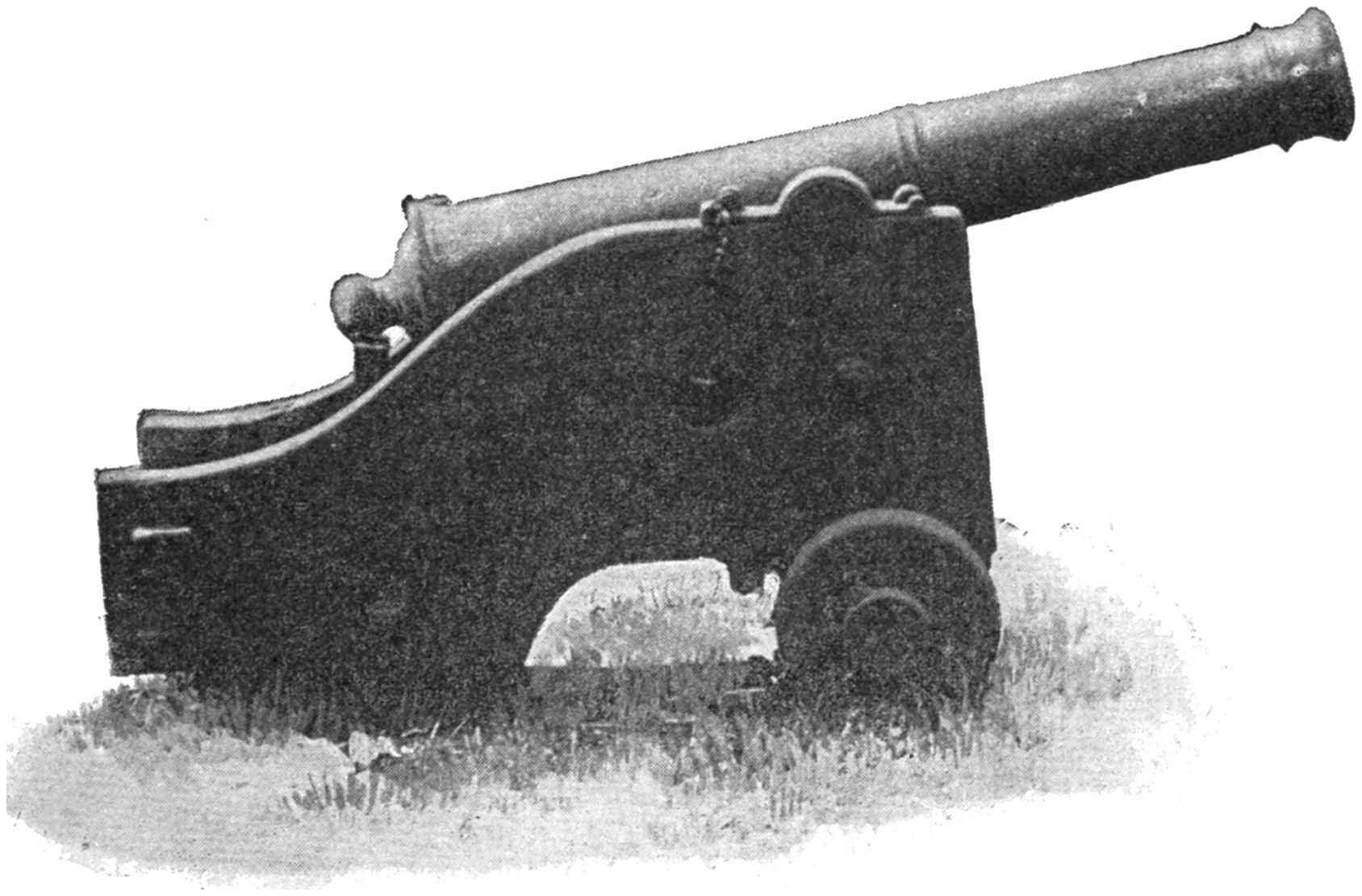
There being no appeal from this decision, the contraband dealers resorted to shipping goods from England to the neutral port off the50 coast, and there unloading the goods. The papers, of course, were made out in proper form, under oath, giving the neutral port as the ultimate destination. They showed, for instance, that a house in Nassau was buying shoes, woollens, guns, gunpowder, swords, etc., sufficient to supply an army, and it was called legitimate trade. Perjury was as common in this contraband business as the drinking of wine. In fact, one cannot help quoting here the words of the favorite “Naval History of Great Britain”—the words of James where he is writing of American traders in the days of the “paper blockades” of 1812. He says:
“Every citizen of every town in the United States, to which a creek leads that can float a canoe, becomes henceforward ‘a merchant’; and the grower of wheat or tobacco sends his son to a counting-house, that he may be initiated in the profitable art of falsifying ship’s papers, and covering belligerent property. Here the young American learns to bolt custom-house oaths by the dozen, and to condemn a lie only when clumsily told, or when timorously or inadequately applied. After a few years of probation, he is sent on board a vessel as mate, or supercargo; and, in due time, besides fabricating fraudulent papers, and swearing to their genuineness, he learns (using a homely phrase) to humbug British officers,51 and to decoy and make American citizens of British seamen.”
What Mr. James says of the American people as a whole, can be truthfully said in substance of the British blockade-runners. They were an infamous lot, without exception, and ever ready to sacrifice honor and risk life so long as the number of pieces of gold was large enough.
But this is not meant to apply to the Confederates engaged in running supplies through the blockaded lines. Their case was entirely different, for they were legally belligerents, and to obtain supplies was, from their point of view, a patriotic duty. So it might—so it usually did happen that a blockade-runner carried one man (the pilot) whose courage and firmness excite the heartiest approbation of every unprejudiced mind, while every other member of the crew was at heart a coward who dared not fight the blockaders in pursuit, and a sneak who would sell his soul for gold.
However, even the trick of transferring cargo at Nassau did not serve them long, for “it was held that the ships carrying on this traffic to neutral ports were confiscable, provided the ultimate destination of the cargo to a blockaded port was known to the owner.”
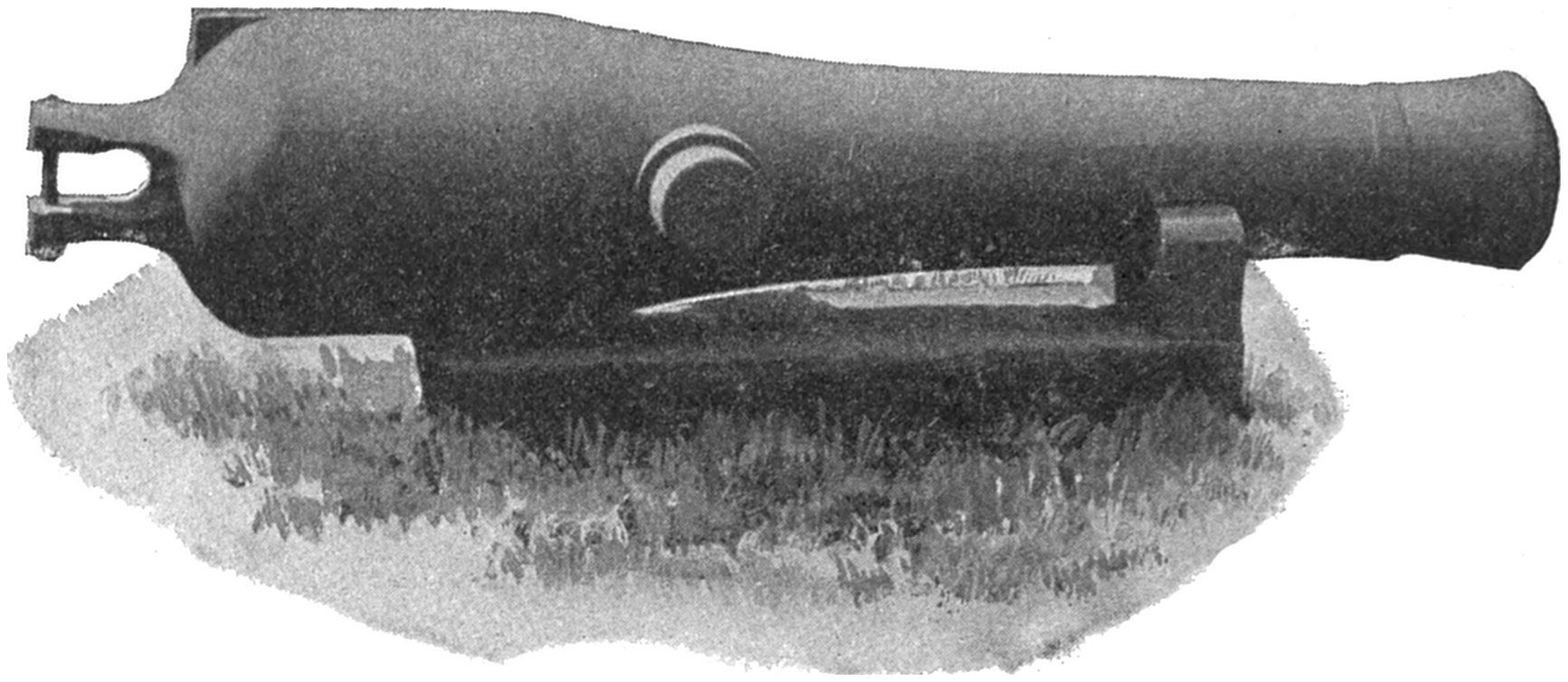
For this “the United States were accused of sacrificing the rights of neutrals, which they52 had hitherto upheld, to the interests of belligerents, and of disregarding great principles for the sake of momentary advantage.” In fact, however, Lord Stowell had held where a neutral, when trading between two ports of a belligerent, had landed the cargo in a neutral port and re-shipped it on another vessel, the continuity of the voyage was not broken. Cargoes shipped in due form to Nassau and taken before reaching that port having been declared lawful prizes in spite of perjury, the contraband traders then adopted the bold expedient of shipping their goods by regular lines to New York and there re-shipping them to Nassau and Bermuda; but the moment this trade attracted attention the New York customs officials were instructed to refuse clearances to ships “which, whatever their ostensible destination, were believed to be intended for Southern53 ports, or whose cargoes were in imminent danger of falling into the hands of the enemy.”
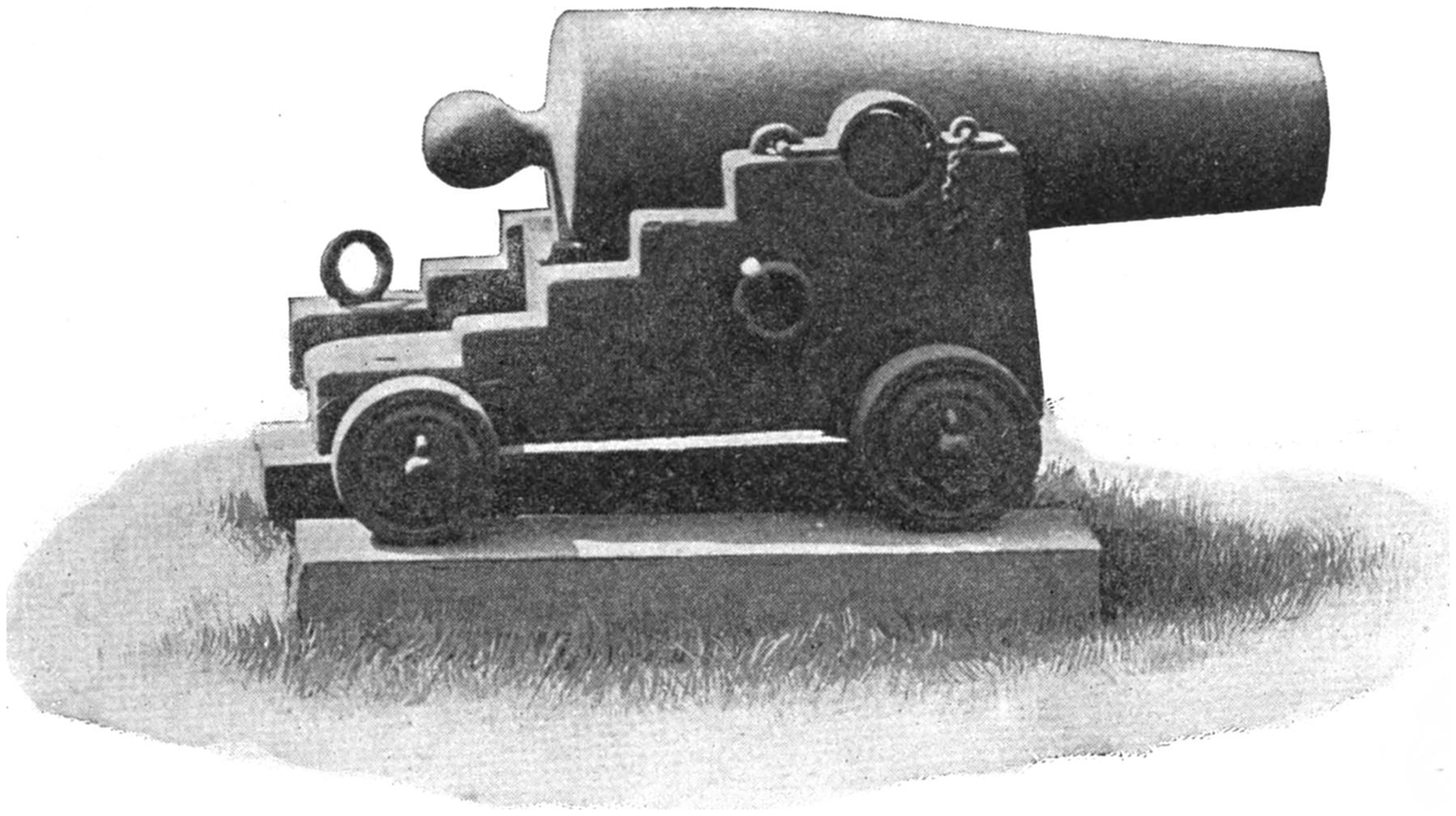
The Nassau merchants got the British authorities to inquire into this refusal to clear ships to their port, the ground taken being that an unjust discrimination was made against them, but after considerable correspondence the British decided to let Uncle Sam alone in that matter. The subject is of special interest for the reason that it shows how strong the American government is in an emergency, even though the Executive is very often obliged to wait on Congress before making a move.
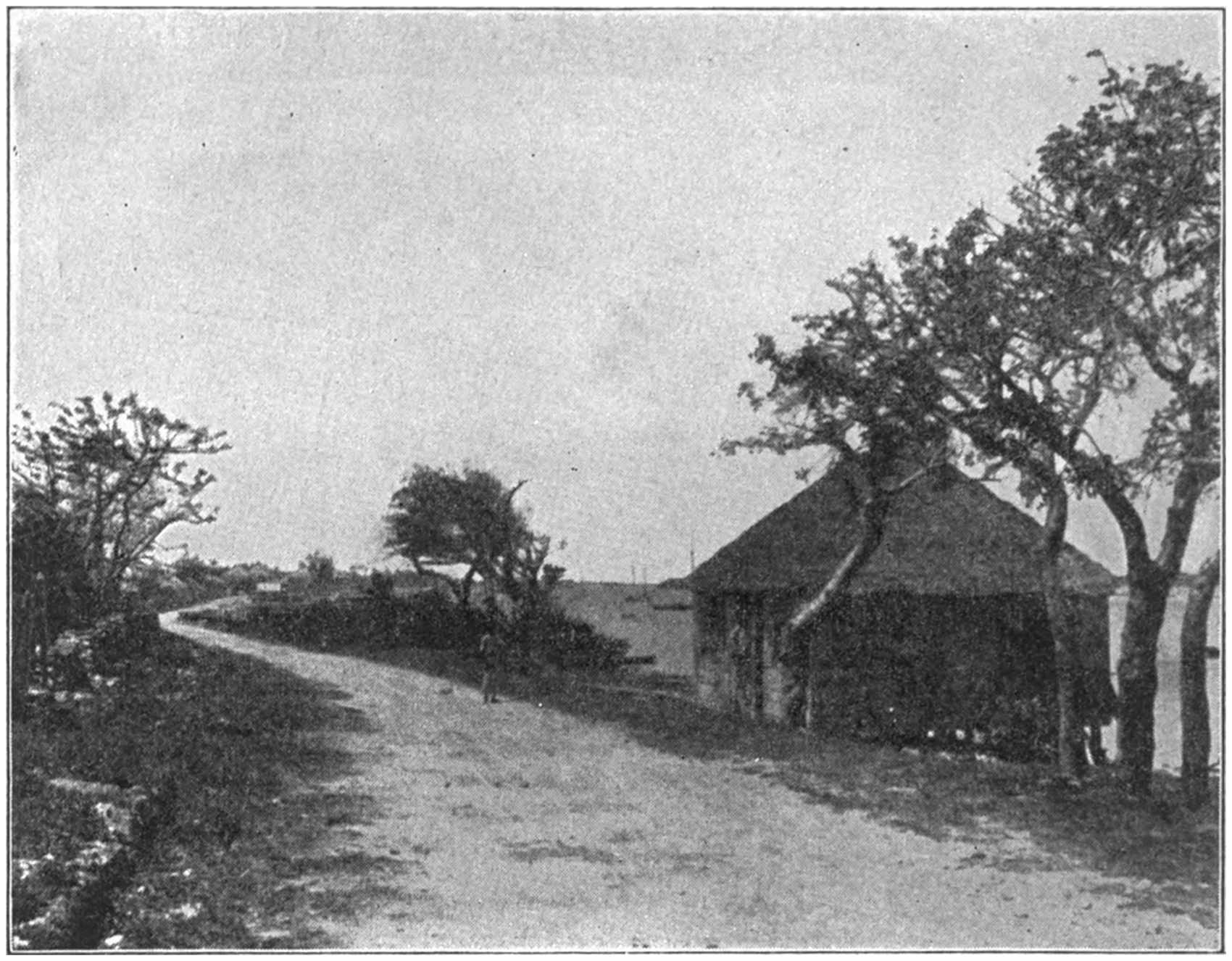
A Nassau View—Along the Shore East of the Town.
From a photograph by Rau.
So, at last, the contraband traders were obliged to rely entirely on their ability as sneaks. The goods were sent to Nassau and54 Bermuda as before, though, meantime, Havana, Cuba, and Matamoras, Mexico, on the Rio Grande, were of considerable importance. Cargoes of Southern products were safe after reaching these ports, if cargoes of contraband goods en route to them were not. Moreover, there was a change in the forms of ships used that made these nearby ports absolutely necessary to the traffic; for soon after the blockading fleets became efficient the use of condemned ships as blockade-runners was abandoned and smaller and swifter vessels were adopted. The transition from these to55 vessels built especially to run between the islands and the Confederate ports was easy and was quickly made. The inventive talent of the traders was worthy of a better cause. Low and slender hulls, with the most powerful engines and twin screws or feathering paddles, were adopted. The paint used was of an obscuring color. There was no spar save that necessary to support a crow’s nest for the lookout. The one thing that they could not keep from betraying them, at the last, was the smoke, but at one time they burned anthracite coal, and they stopped using it only when the American government prohibited the export of it. As time passed and the strangulation56 caused by the blockade became more severe, the skill and ingenuity of the blockaders increased, so that the traffic never was stopped. There was, at one time, talk in Richmond of having the Confederate government take the traffic into its own hands absolutely, because of the demoralization caused by the illegitimate traders. They brought what they could sell at the most profit, of course. They brought liquors where medicines were needed, and silks and fancy slippers in place of the necessities of life for which the people suffered. It is a pity that the change was not made, for then one might have considered the blockade-runners with other feelings than disgust.

Nassau Schooners.
From a photograph by Rau.
But if the traffic never ceased absolutely, the constriction of the blockade was and is now manifest. It was so efficient that one can scarcely read of the effects produced by it in the South without tears. One can believe that the blockade was a merciful as well as a just measure of war in that it shortened the struggle more than any other measure, and so saved many lives on both sides; but it is a pitiful fact that those who suffered most from the effects of the blockade were the women and the little ones. There are many tiny graves in the South that were dug because the blockade excluded the medicines needed by the sick.
57
Lest the reader think the language used here regarding the foreign blockade-runners is too strong, a story told by one of them, Thomas E. Taylor (see p. 110, “Running the Blockade”), shall be given. Taylor was a leader in the business. He ran the first steel ship (the Banshee) built especially for the purpose. Among other vessels under his control was the Will-o’-the-Wisp. She was a wretched ship, and here is what he says:
“I found her a constant source of delay and expenditure and I decided to sell her. After having her cobbled up with plenty of putty and paint, I was fortunate enough to open negotiations with some Jews with a view to her purchase. Having settled all preliminaries, we arranged for a trial trip, and after a very sumptuous lunch I proceeded to run her over a measured mile for the benefit of the would-be purchasers. I need scarcely mention that we subjected her machinery to the utmost strain, bottling up steam to a pressure of which our present Board of Trade, with its motherly care for our lives, would express strong disapproval. The log line was whisked merrily over the stern of the Will-o’-the-Wisp, with the satisfactory result that she logged 17½ knots. The Jews were delighted, so was I; and the bargain was clinched.”
As to the legal status of a blockade-runner,58 Taylor says: “The blockading force is entitled to treat such a ship in all respects as an enemy, and to use any means recognized in civilized warfare to drive off, capture or destroy her. A crew so captured may be treated as prisoners of war, nor is any resistance to capture permitted, and a single blow or shot in his own defence turns the blockade-runner into a pirate.” In the same line is what Wilson’s “Iron Clads in Action” says regarding the fact that the crews of captured blockade-runners “at least once or twice rose up on the prize crew and recaptured the ship. It was a big risk—piracy upon the high seas—with the penalty of death if blood was shed.”
One of the cases wherein the crew recaptured the ship from the prize crew is described very well in the Mercantile Marine Magazine (London) for June, 1862, p. 177. The story begins: “On Saturday, May 3, the rooms of the Liverpool Mercantile Marine Association were crowded almost to suffocation by the merchants and Mercantile Marine officers of Liverpool, to witness the presentation of a magnificent testimonial to Captain William Wilson, of the British ship Emily St. Pierre, for his pluck and gallantry in recapturing his ship which had been seized by the United States cruiser James Adger, off Charleston.” He had been guilty of “piracy upon the high59 seas,” but 170 Liverpool merchants united to give him a silver tea and coffee service, the association named gave him a gold medal, the owners of the ship gave him 2,000 guineas, and his crew gave him a sextant. The captain, in his little speech, said that the “token of your kindness” would remind the British sailor that “his efforts for the right and true will not be lost sight of nor go unrewarded.” The story is well worth quoting as showing how men, naturally inclined to “the right and true,” may be led by the exigencies of trade to applaud and reward even “piracy upon the high seas.”
The reader should observe here that for a captured crew of one belligerent to rise against a prize crew of the other belligerent is a very different matter from this act of “piracy.”
As already said, the blockade-runners were at first chiefly old sailing ships of various rigs or old steamers, the idea being to risk as little capital as possible in this illegitimate trade while making the utmost profit—not an unknown plan in legitimate trade, and never a wise one. Small schooners were used all through the wars to run the numerous shoal-water inlets along the coast, but the real interest in the blockade-runners begins when the Liverpool merchants began to build steamers especially designed for that purpose—build60 them without hindrance on the part of their government.
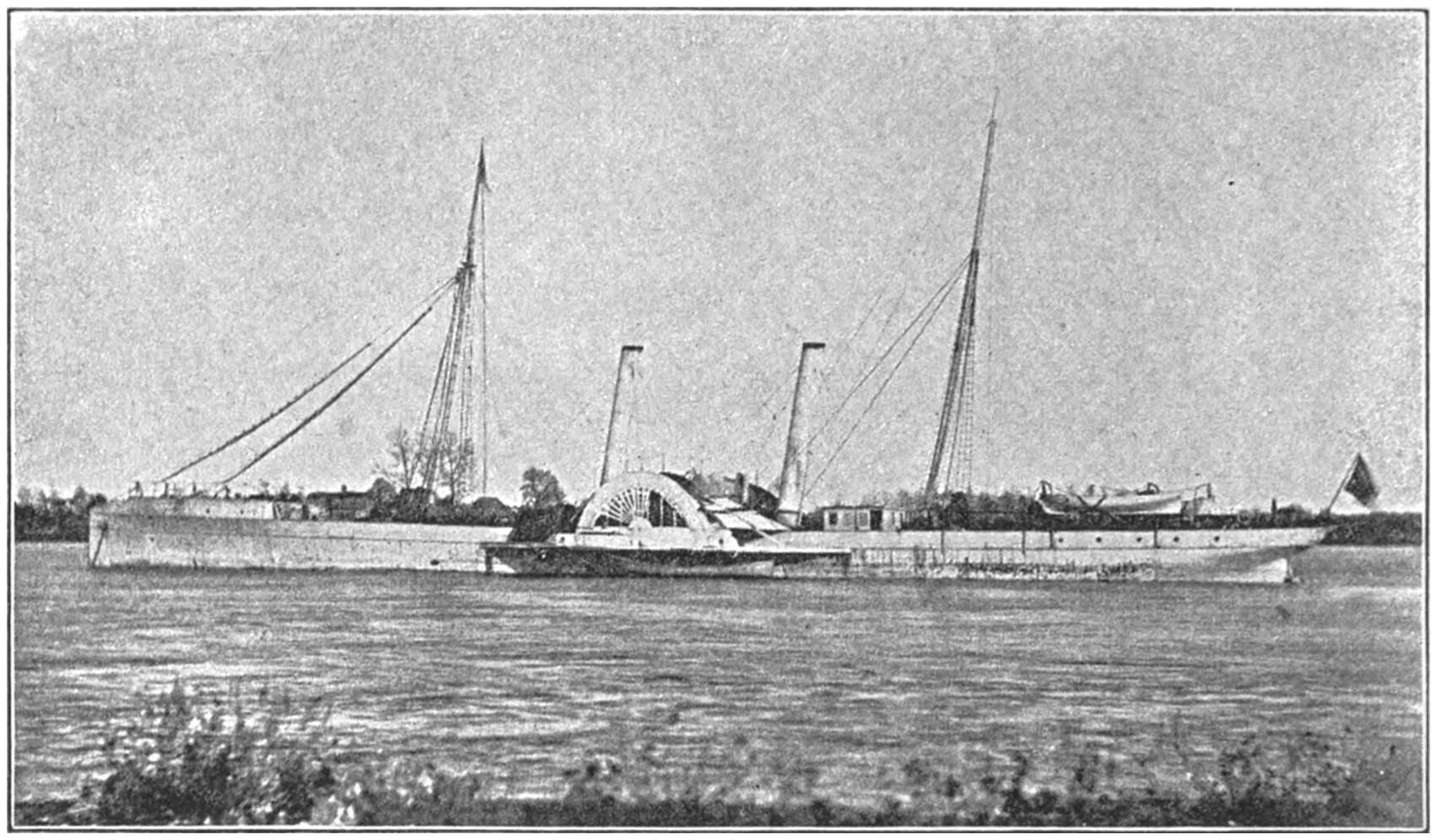
The Blockade-runner Teaser.
From a photograph made in 1864.
Taylor, as said, was the first to carry out one of these swift vessels, and he describes her as follows:
“The new blockade-runner was a paddle boat, built of steel, on extraordinarily fine lines, 214 feet long and 20 feet beam, and drew only 8 feet of water. Her masts were mere poles without yards, and with the least possible rigging. In order to attain greater speed in a sea-way she was built with a turtle-back deck forward. She was of 217 tons net register, and had an anticipated sea speed of eleven knots, with a coal consumption of thirty tons a day. Her crew, which included three61 engineers and twelve firemen, consisted of thirty-six hands all told.” And she was a type of the best sort, although they eventually reached a speed of seventeen knots.
At Nassau “everything aloft was taken down, till nothing was left standing but the lower masts, with small cross-trees for a lookout man on the fore, and the boats were lowered to the level of the rails. The whole ship was then painted a sort of dull white, the precise shade of which was so nicely ascertained by experience before the end of the war that a properly dressed runner on a dark night was absolutely indiscernible at a cable’s length. So particular were captains on this point that some of them even insisted on their crews wearing white at night, holding that one black figure on the bridge or on deck was enough to betray an otherwise invisible vessel.
“The reckless loading, to which high profits and the perquisites allowed to officers led, is to a landsman inconceivable. That men should be found willing to put to sea at all in these frail craft piled like hay wagons is extraordinary enough, but that they should do so in the face of a vigilant and active blockading force, and do it successfully, seems rather an invention of romance than a commonplace occurrence of our own time.”
So prepared, the steamer sneaked away from62 port, fled from every sail and every smoke, crossed the Gulf Stream by daylight in order to determine her position uninfluenced by the current, and struck in on the coast at night. The light on the blockading flagship was commonly used to locate the harbor, and when this was seen the runner either ran away around the end of the squadron and slipped in along the coast or else plunged boldly through under the guns of the flagship.
The Banshee on her first inward trip received $250 per ton in gold for freight on war material. She carried out 100 tons of tobacco at $350 per ton, and 500 bales of cotton, that yielded $250 net per bale.
In January, 1865, Jefferson Davis, “in a message to Congress on this subject, said that the number of vessels arriving at only two ports—Charleston and Wilmington—from November the first to December the sixth, had been forty-three, and that only a very small portion of those outward bound had been captured; that out of 11,796 bales of cotton shipped since July the first, 1864, but 1,272 bales had been lost. And the special report of the Secretary of the Treasury in relation to the same matter stated that there had been imported at the ports of Wilmington and Charleston since October 26th, 1864, 8,632,000 pounds of meat, 1,507,000 pounds of lead,63 1,933,000 pounds of saltpetre, 546,000 pairs of shoes, 316,000 pairs of blankets, 520,000 pounds of coffee, 69,000 rifles, 97 packages of revolvers, 2,639 packages of medicines, 43 cannon, with a very large quantity of other articles. From March 1st, 1864, to January 1st, 1865, the value of the shipments of cotton on Confederate government account was shown by the Secretary’s report to have been $5,296,000 in specie, of which $1,500,000 had been shipped out between July 1st and December 1st, 1864.
“A list of vessels which were running the blockade from Nassau and other ports, in the period intervening between November, 1861, and March, 1864, showed that 84 steamers were engaged; of these, 37 were captured by the enemy, 12 were totally lost, 11 were lost and the cargoes partially saved, and one foundered at sea.
“They made 363 trips to Nassau and 65 to other parts. Among the highest number of runs made were those of the Fanny, which ran 18 times, and the Margaret and Jessie, which performed the same feat and was captured. Out of 425 runs from Nassau alone (including 100 schooners), only 62—about one in seven—were unsuccessful.”
The following estimate of the disbursements and profits of a blockade-runner is taken from64 Scharf, as is the quotation above. The estimate refers to the last part of the war, when the Confederate government took a half of the cargo space of runners:
| One captain, per month | $5,000 00 | |
| First officer, $600, second do., $250; third do., $170 | 1,020 00 | |
| One boatswain | 160 00 | |
| One carpenter | 160 00 | |
| One purser | 1,000 00 | |
| One steward, $150; three assistants, $80 | 330 00 | |
| One cook, $150; two assistants, $120 | 270 00 | |
| One engineer and three assistants | 3,500 00 | |
| Twelve firemen and coal-heavers | 2,400 00 | |
| 240 tons of coal at $20 | 4,800 00 | |
| Rations for crew | 2,700 00 | |
| Oil, tallow, and packing | 1,000 00 | |
| Stevedores | 5,000 00 | |
| Pilotage, out and in | 3,000 00 | |
| Sea insurance | 3,500 00 | |
| Wear and tear | 4,250 00 | |
| Incidental expenses | 1,000 00 | |
| Interest | 875 00 | |
| Risks, 25 per cent | 37,500 00 | |
| Provisions for passengers | 3,000 00 | |
| $80,265 00 | ||
| Earnings, out and home: | ||
| 800 bales of cotton for government | $40,000 00 | |
| 800 bales of cotton for owners | 40,000 00 | |
| Return freight for owners | 40,000 00 | |
| Return freight for government | 40,000 00 | |
| Passengers, out and home | 12,000 00 | |
| $172,000 00 | ||
| Leaving a monthly profit of | $91,735 00 | |
65
On the other hand, it should be observed that the Federal ships captured over 1,000 prizes during the war. One of these, the Memphis, paid $510,914.07 in prize money to her captors, two or three paid over $400,000, and whole fleets yielded from $100,000 to $300,000. The Banshee, of which Taylor boasts, paid $104,948.48 to the Yankee crews of the Fulton and Grand Gulf. Blockade-running, like privateering in 1812, paid a few firms handsomely. The Frasers of Charleston are said to have cleared $20,000,000 in gold, but many others lost heavily—the Jews who bought the Will-o’-the-Wisp, for instance. It was a thoroughly disreputable business, but so much of the story must be told, if only to show the character of part of the opposition which the government faced in the Civil War.
66
EFFECTIVE WORK DONE BY SOUTHERN NAVAL OFFICERS WHO CONTINUED TO WEAR THE NATIONAL UNIFORM THAT THEY MIGHT THE MORE READILY BETRAY THE NATIONAL GOVERNMENT—THE SECRETARY OF THE NAVY WAS DECEIVED AND THE COMMANDANT AT NORFOLK DEMORALIZED—WILLIAM MAHONE’S TRICKS ADDED TO THE DEMORALIZATION AT THE YARD, AND IT WAS ABANDONED AT LAST IN A SHAMEFUL PANIC—PROPERTY THAT WAS WORTH MILLIONS OF DOLLARS, AND GUNS THAT TOOK THOUSANDS OF LIVES, FELL INTO THE CONFEDERATES’ HANDS—THE FIRST NAVAL BATTLE OF THE WAR—THREE LITTLE WOODEN VESSELS WITH SEVEN SMALL GUNS SENT AGAINST A WELL-BUILT FORT MOUNTING THIRTEEN GUNS—THE HAZARDOUS WORK OF PATROLLING THE POTOMAC.
The first actual battle of the war in which the navy took part occurred on May 20 and 21, 1861, and resulted in the capture of the Confederate forts that had been erected on the Potomac River at Acquia Creek to shut off communication between Washington and the sea. As the reader will remember, there was but one railroad running from the North to Washington in those days. The authorities of Maryland had decided that they would keep their State neutral during the impending69 strife, acting, of course, on the theory of State sovereignty then held in the South, and had prohibited the transportation of troops across their State. The Confederates actually believed that this prohibition would prevent the Northern troops coming to the defence of the nation’s capital overland, and that resort to ships would be had in strengthening the forces at Washington. To head off the ships, the Confederates swarmed to the bank of the Potomac River, and there were Confederate fortifications with colors flying, in plain view of Washington itself. The Confederates, in the few weeks following the secession of Virginia, were confident of capturing the national capital.

Washington, D. C., and Its Vicinity.
1. Matthias Point. 2. Acquia Creek. 3. Shipping Point. 4. Fredericksburg. 5. Mt. Vernon. 6. Alexandria. 7. Orange & Alexandria RR. 8. Loudon & Hampshire RR. 9. Manassas Junction. 10. Bull Run. 11. Centreville. 12. Fairfax Court House. 13. Vienna. 14 Falls Church. 15. Arlington House. 16. Chain Bridge. 17. Aqueduct Bridge. 18. Long Bridge. 19. Georgetown. 20. Washington. 21. President’s House. 22. Smithsonian Institution. 23. Patent Office. 24. General Post Office. 25. Capitol. 26. Navy Yard. 27. Arsenal. 28. Maryland shore. 29. Fort Washington. 30. Indian Head. 31. Maryland Point. 32. Port Tobacco. 33. Forts Scott, Albany, Runyon, Richardson, etc.
It is easy to show there was really some basis for the Confederate confidence. While the North groped and discussed, the Confederates were at work collecting material for war. Officers who, like Semmes, had left the service of the nation for that of the State, had gone North—communications being still open—and had purchased arms and ammunition in considerable quantities. They were very near to getting good steamers, too; and a patriot now reads with pleasure the keen words of scorn with which those officers spoke afterwards of the Northern men who were so ready to sell these goods—of the stay-at-home-and-make-money70 patriots. But the South had not stopped at mere buying. Indeed, all the supplies purchased combined were as a pistol-shot to a torpedo in comparison with what they obtained when the Norfolk Navy Yard was abandoned to them.
It is certain that the whole story of this event will never be told; for it was brought about by officers of the navy, who, after serving honorably for many years under the flag, were not only willing to turn on the flag, as many did with satisfied consciences, but were willing to stoop to the shameful work of pretending to be loyal advisers of the nation’s naval Secretary when they were secretly plotting the destruction of the nation. While yet Virginia had not passed the ordinance of secession these men “lost no opportunity to impress upon the mind of the Secretary of the Navy the importance of doing nothing to offend the State of Virginia.” These naval officers, who were working day and night to overthrow the government, stopped at nothing. The commandant of the navy yard at Washington was one of them. In the midst of his plottings his daughter was married to one of the younger plotters, and the others of the gang were, of course, present at the wedding. “The house was everywhere festooned with the American flag, even to the bridal71 bed.” And down at the Norfolk Navy Yard one of the Southern officers went to Commodore McCauley, after the Pensacola Navy Yard had been turned over to the Confederates, and said: “You have no Pensacola officers here, Commodore; we will never desert you; we will stand by you to the last, even to the death.” And this was said with the deliberate intent of keeping the commodore from doing anything that might save the nation’s property for the use of the government. One need not search long for words to describe such actions.
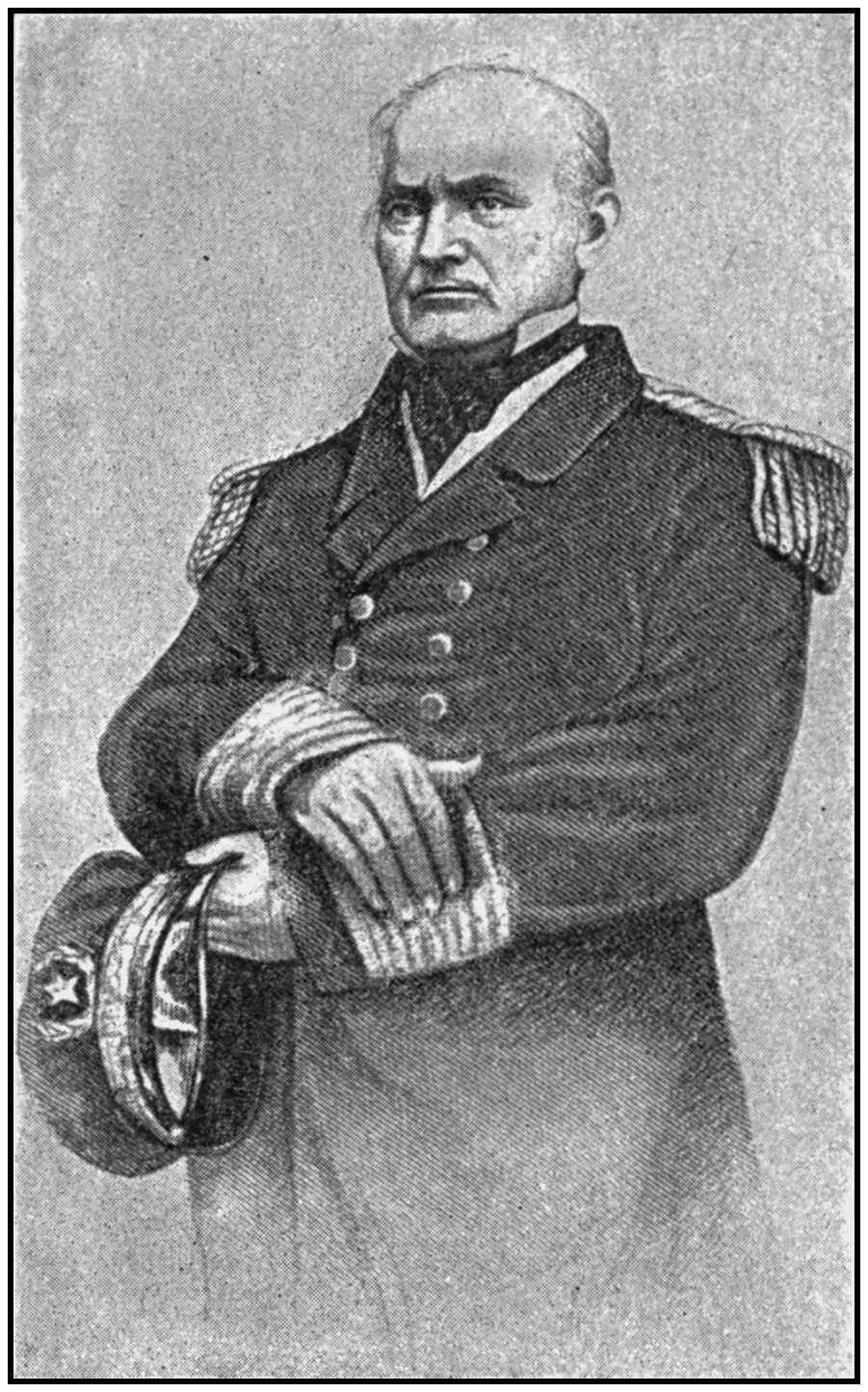
Hiram Paulding.
From an engraving by Hall.
Secretary Welles called Capt. Hiram Paulding, an officer of known loyalty, to advise him. Paulding broke up the nest of scoundrels who wore the uniform that they might the more easily betray the flag, but it was then too late to prevent the accomplishment of the object for which they had chiefly72 labored—the betraying of the Norfolk Navy Yard into the hands of the enemy. Large bodies of Confederate troops were already gathering at Norfolk, although Virginia had not passed her secession ordinances. Commodore McCauley was an old man and no match for the young scoundrels who at Norfolk, as in Washington, held on to their commissions and drew their pay up to the last day possible. They were incessant in their labors to prevent anything being done that would move a ship or a gun from the yard or add a loyal man to its forces.
“Early in April”—note that it was not until April—“the Department began to get very uneasy for the safety of the navy yard.” “The Department was most anxious to get the Merrimac away, but was informed by Commodore McCauley that it would take a month to put her machinery in working order.” No one seemed “to reflect that a few armed towboats with marines on board” could have taken every ship from the yard to an anchorage under Fortress Monroe.
However, on March 31st, 250 seamen were ordered from the New York Navy Yard to Norfolk, and fifty seamen were transferred to the revenue cutter Harriet Lane, which was sent to Norfolk. “On April 11th Commander James Alden was ordered to take command of73 the Merrimac and Chief Engineer Isherwood was sent to Norfolk to get the ship’s engines in working order.” “On the 14th the work was commenced, and on the 17th the engines were in working order—so much for the commandant’s assertion that it would take a month to get the ship ready to move.” These quotations are from Admiral Porter’s “Naval History of the Civil War.” But he does not say McCauley was disloyal. McCauley had merely believed the wilful lies of those under him.
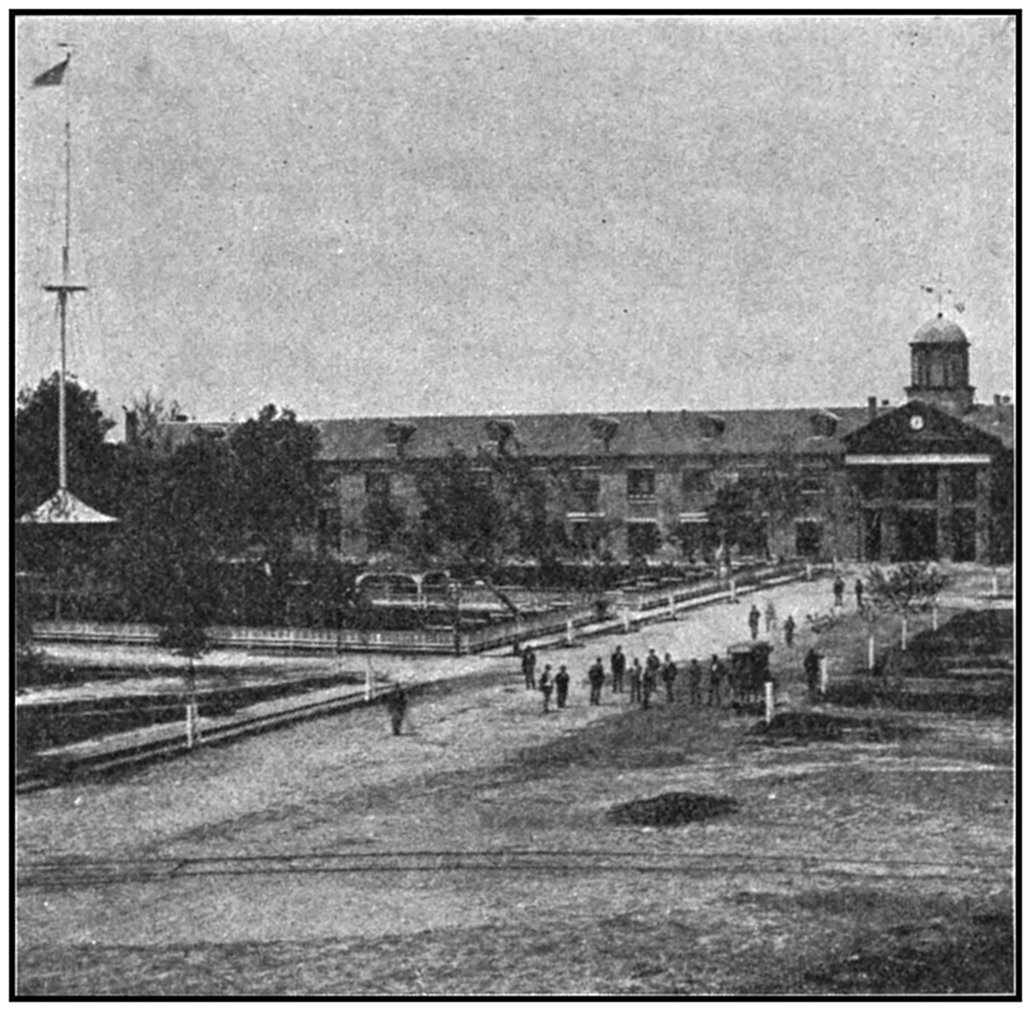
A View of the Norfolk Navy Yard.
From a photograph by Cook.
It is cheering to read that “the disloyalty did not at that time extend to the mechanics,” and that “they worked day and night” to get the ship ready. “Then forty-four firemen and coal heavers volunteered for the service of taking the Merrimac out.” At this Commodore McCauley, mindful of his orders to do nothing to excite the suspicions of hostile intent, said “that next morning would be time74 enough.” Next morning, there being a good head of steam on, word was again sent that she was ready, but he replied that he had decided not to send her out. “He gave as a reason the obstructions that had been placed in the channel, and when the anxious Alden told him they could clear away the obstructions he merely ordered the fires drawn. He had become utterly demoralized, and his demoralization was infectious.”
At about this time came Captain Paulding in the Pawnee from Washington with a regiment of Massachusetts volunteers. His instructions were to “save what he could and act as he thought proper.” When he arrived the Southern officers had just resigned, and the mechanics, being citizens of Virginia, had been induced to leave the yard in a body. It was reported that thousands of Virginia militia were coming to reinforce the Confederates gathering about the yard. The report was due to a trick of William Mahone, afterwards a noted practical politician of the State. He was president of the Norfolk & Petersburg Railroad, and ran empty cars up the line, loaded on a mob sent there for the purpose, and brought them back “with every man yelling with all his might.” This was on April 19, 1861. The next day Confederate troops did arrive, and the demoralization in75 the yard was completed. It was the most disgraceful panic in the history of the nation, for it was a panic that came on when not a gun had been fired, and the only overt acts of war were the robbing of a government powder magazine and the sinking of a few hulks (Mahone did this also), so that the government officers would think the channel was being obstructed.
“The broadside of the Germantown, which was all ready for sea and only waiting a crew, would have saved the navy yard against attack, overawed Norfolk and Portsmouth, and prevented the channel from being obstructed by the Confederates.” So says Porter. Elsewhere he adds, that the “five heavy guns on a side on board the Pennsylvania” with fifty good seamen on board, “could have bid defiance to 5,000 Confederates in arms and held Norfolk and Portsmouth.”
Nevertheless, “after the arrival of the Pawnee had made the yard doubly secure, the shells were drawn from the Pennsylvania’s guns, and the guns spiked.” Every other gun in the yard, afloat and ashore, except 200, was spiked. Men with sledge-hammers ran about the yard, vainly trying to knock the trunnions from the guns in store. Others soaked the decks of the ships and the buildings with tar and turpentine. Others laid a76 mine in the dry dock—put twenty-six barrels (2,600 pounds) of powder there. Only the Pawnee and the Cumberland, which were full-manned, escaped the work of the destroyers.
“It was a beautiful starlight night, April 20th, when all the preparations were completed. The people of Norfolk and Portsmouth were wrapped in slumber, little dreaming that in a few hours the ships and public works which were so essential to the prosperity of the community would be a mass of ruins, and hundreds of people would be without employment and without food for their families. The Pawnee had towed the Cumberland out of the reach of the fire, and laid at anchor to receive on board those who were to fire the public property. Commodore McCauley had gone to bed that night, worn out with excitement and anxiety, under the impression that the force that had arrived at Norfolk was for the purpose of holding the yard and relieving him of responsibility, and when he was called at midnight and informed that the torch would be applied to everything, he could hardly realize the situation, and was chagrined and mortified at the idea of abandoning his post without any attempt to defend it.
“At 2.30 A.M., April 21st, a rocket from the Pawnee gave the signal; the work of destruction commenced with the Merrimac, and in77 ten minutes she was one vast sheet of flame. In quick succession the trains to the other ships and buildings were ignited and the surrounding country brilliantly illuminated.”
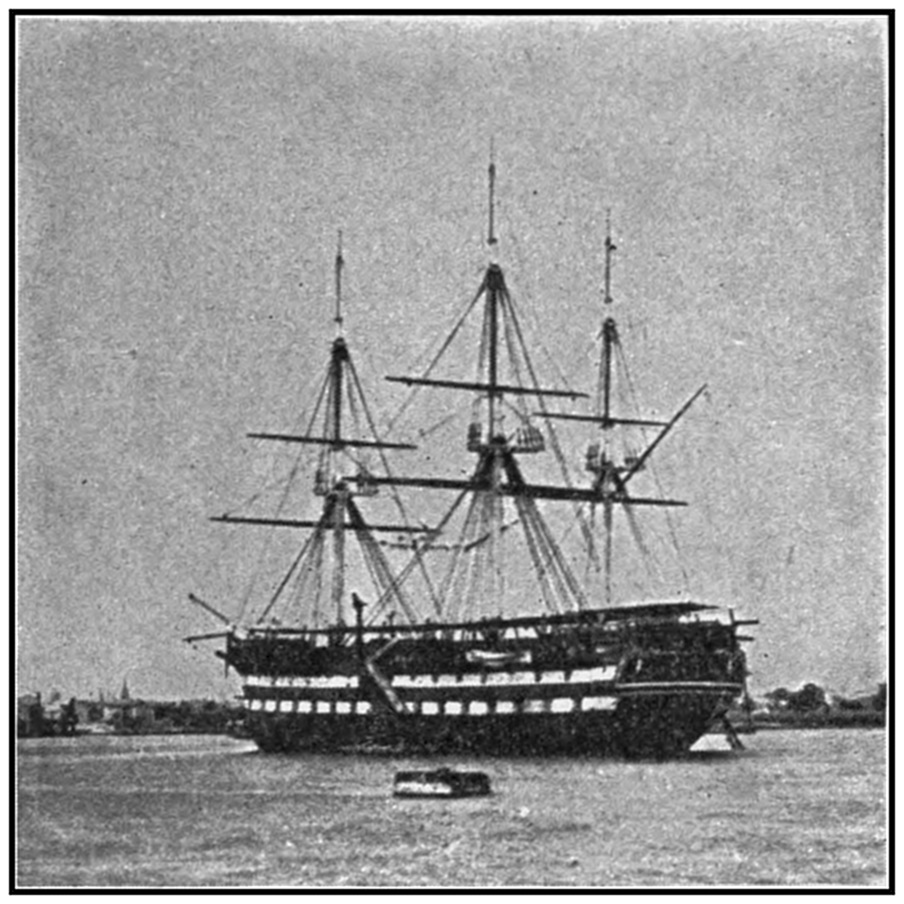
The Old New Hampshire at the Norfolk Navy Yard.
From a photograph by Cook.
At the beginning of April, 1861, there were stored at this yard 2,000 cannon, of which 300 were new Dahlgrens; 150 tons of powder, besides vast quantities of loaded shells, machinery, castings, material for ship-building, and ordnance and equipment stores—all in great quantities. It contained a first-class stone dock. The steam frigate Merrimac was there undergoing repairs, the shops of the yard being well fitted for such work. The sailing sloops-of-war Germantown and Plymouth, of twenty-two guns each, and the brig Dolphin, of four guns, were there, not manned, but fit for sea. Six other sailing ships, including the famous United States, that were not of much use, but worth something, were also there. On the whole, the material of this yard was of more value, probably, than that in any two beside it in the country. The78 Confederates estimated the value of the property abandoned to them at $4,810,056.68 in gold. “But the greatest misfortune to the Union caused by the destruction of the Navy Yard was the loss of at least twelve hundred fine guns, most of which were uninjured. A number of them were quickly mounted at Sewell’s Point to keep our ships from approaching Norfolk; others were sent to Hatteras Inlet, Ocracoke, Roanoke Island, and other points in the Sounds of North Carolina. Fifty-three of them were mounted at Port Royal, others at Fernandina and at the defences of New Orleans. They were met with at Fort Henry, Fort Donelson, Island No. 10, Memphis, Vicksburg, Grand Gulf, and Port Hudson. We found them up the Red River as far as the gunboats penetrated, and took possession of some of them on the cars at Duvall’s Bluff, on White River, bound for Little Rock. They gave us a three hours’ hard fight at Arkansas Post, but in the end they all returned to their rightful owners, many of them indented with Union shot, and not a few permanently disabled.
“Had it not been for the guns captured at Norfolk and Pensacola, the Confederates would have found it a difficult matter to arm their fortifications for at least a year after the breaking out of hostilities, at the expiration of79 which time they began to manufacture their own ordnance and import it from abroad. Great as was, therefore, the loss of our ships, it was much less than the loss of our guns.” So says Porter.
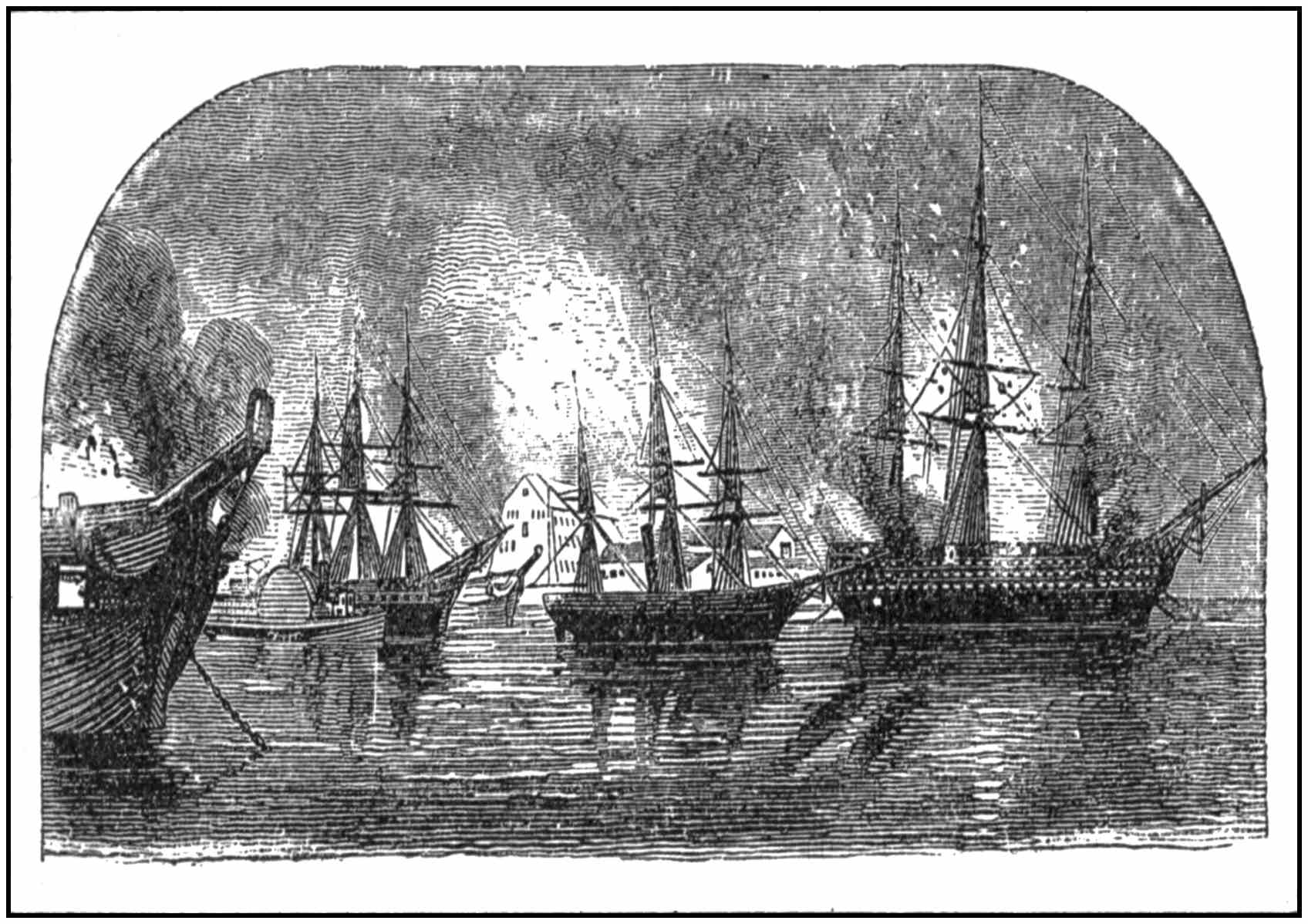
Rightly considered, the abandonment of the Norfolk Navy Yard was as great a misfortune to the South as to the North, for it needlessly prolonged and intensified a conflict that could have but one end. No one can estimate the number of lives that these guns cost both sides—the fortifications that were erected and the battles that were fought in consequence of their falling into Confederate hands. But if it took the Confederates a whole year to get at the work of casting cannon, it is not unreasonable to suppose that one year of the war would have been saved had the government held its own.
80
It was with guns that were needlessly abandoned at Norfolk that the Confederates made their first fight against the Federal navy—the battle at Acquia Creek. Something like thirty miles below Washington the Potomac makes a wide sweep to the east. Two creeks enter it there from the west—one, right on the point of the elbow, being known as Potomac Creek, and the other, that enters a little way to the north of the elbow, being called Acquia Creek. There is a considerable bluff on the point between Acquia Creek and the river, known in those days as Split Rock Bluff. Because this creek was the terminus of a railroad leading to Fredericksburg, Virginia, and because it was believed by the Confederates that the point commanded the Potomac River, three batteries were erected. The Confederate accounts say that there were thirteen guns here, of which two were eight-inch Dahlgrens, brought from Norfolk. The Confederates completed this battery about May 14, 1861. They had decided to abandon Alexandria whenever the Federals chose to take it, and make Acquia Creek their frontier post on the river.
Accordingly, when the Federals, under cover of the Pawnee, Capt. S. C. Rowan, crossed over on the 24th, the Confederates moved out, and there was no bloodshed until the insane hotel-keeper, Jackson, shot Colonel Ellsworth81 because the Confederate flag was taken down from the Marshall House. Then the Potomac flotilla, which was under Fleet Officer James H. Ward, was ordered to attack the Acquia Creek batteries.
In one respect that order was one of the most remarkable ever issued in the navy, up to that date, for Ward had under him the Freeborn, a wooden paddle-wheel steamer of 250 tons, carrying three guns, the largest being a thirty-two-pounder smooth-bore; the Anacostia, a screw steamer of 100 tons, carrying two little howitzers, and the Resolute, a steamer of ninety tons, carrying two howitzers. In all, three frail wooden vessels, carrying seven small guns, were sent to attack a well-planned, well-manned fort with not less than thirteen guns, of which the worst was better than the best afloat before it. This matter is especially worth considering in connection with what a Secretary of the Navy is likely to do in future if the nation is ever again unexpectedly obliged to fight.
However, Ward was a great man. He had already distinguished himself as a writer on gunnery and naval tactics and as an inventor. He now showed his pluck by bravely attacking the forts.
It was on Friday, May 31, 1861, at 10.30 o’clock at night, that the first shot of this war82 was fired from a naval ship at a fort. In all, fourteen shots were fired, and the Confederates fired fifty-six at the ships. The forts were not damaged, and one Confederate soldier lost a finger. However, the Confederates abandoned the battery they had erected at the water level and took the guns to the top of the bluff. Next day, the Pawnee having come to reinforce the fleet, the attack was renewed, and for five hours the four little steamers hurled their shot at the forts. The Confederates fired over 1,000 shot in return. It is instructive to note that no one was hurt on either side by all that firing. The ships were struck several times, but “there was no irreparable damage done.” The attack failed absolutely.
Ward was afterwards killed in an attack on the Confederate forts erected at Matthias Point, fifteen miles or so farther down the river. This was on June 27, 1861. The Federal forces attempted to land there and were driven off easily. But for the coolness of Lieut. J. C. Chaplin, of the Pawnee, who rallied his force, in spite of a heavy fire, the whole landing party would have been captured. Ward was the only one killed, but four others were wounded.
On the whole, the work of the navy on the Potomac was confined to patrolling the stream for the purpose of preventing the Confederates83 of the two slave-holding States that bordered it from communicating with each other. The men engaged in it have not received and never can receive the credit they deserve for what they did, simply because there was nothing striking about the work. More unfortunate still, they had steamers that were wholly inadequate to the work, and the fighting, when any was done, was like that at Acquia Creek—ineffective necessarily. Instead of an opportunity to win fame, the men found toil of the most wearisome kind, and as a reward for it they got the reproaches of ignorant editors at the North and the jeers of exultant editors at the South. Nevertheless, this much was done: The river was kept open, so far as was needed, for the transportation of troops and supplies, to and fro, and when, in 1862, the Confederates found that their forts could not stop traffic, even though their guns had an effective range greater than the width of the river, they retired from the bank of the Potomac altogether.
84
THEY DID PLENTY OF DAMAGE FOR A TIME, BUT THEIR CAREER WAS BRIEF—CAPTURE OF THE FIRST OF THE CLASS, AND TRIAL OF HER CREW ON A CHARGE OF PIRACY—REASONS WHY THEY COULD NOT BE HELD AS CRIMINALS—LUCK OF THE JEFFERSON DAVIS—A NEGRO WHO RECAPTURED A CONFEDERATE PRIZE TO ESCAPE THE TERRORS OF SLAVERY—A SKIPPER WHO THOUGHT A GOVERNMENT FRIGATE WAS A MERCHANTMAN—THE “NEST” BEHIND CAPE HATTERAS.
From a blockade of the ports of the Southern States it was a short and natural step for the navy to land and effectually close some port to Confederate commerce by occupying it. But before telling the story of the first expedition organized for this purpose the story of the Confederate privateers—real privateers, as distinguished from Confederate cruisers like the Alabama—will be told, for the reason that it was the work of these privateers that in good part led the government to decide on the first expedition for occupying a Southern port.
As a matter of fact, the idea of blockading the Southern ports was born of the determination of the Confederates to commission privateers.85 The sequence of events was as follows: The Confederates captured Fort Sumter on April 13, 1861. On the 15th President Lincoln called for 75,000 troops to protect the government property and enforce the laws of the nation in the seceding States. On the 17th Jefferson Davis “published a counter proclamation inviting applications for letters of marque and reprisal to be granted under the seal of the Confederate States against ships and property of the United States and their citizens.” The quotation is from Scharf’s “Confederate States Navy.” It was on receipt of this that Mr. Lincoln, on the 19th, ordered the blockade of the Southern ports.
However, Mr. Davis did not issue any commissions to privateers until after the Confederate Congress had passed, on May 6, 1861, an act authorizing him to do so. This act provided such safeguards as had ruled American privateers in the War of 1812. On May 14th another act supplemented the first by regulating the sale of prizes and the distribution of the proceeds.
Sufficient time has passed since that war to enable at least the younger generation of Northern-born men to view its events judicially, and it is therefore likely that no student of history will now be found to deny that the letters of marque subsequently issued under86 these acts of the Confederate Congress were entirely legal. The Confederates were entitled to the rights of belligerents—they at least became entitled to them the moment that President Lincoln issued his proclamation blockading the Southern ports. There is no point of international law more firmly established now than that a proclamation of a blockade carries with it a concession that war exists between the blockaders and the blockaded. And this is worth remembering, because Secretary of State Seward was unwilling to admit it for a very long time after a state of war did actually exist. At the same time it was entirely natural that Northern shipping men should have called these privateers pirates. Business operations tend to concentrate one’s nerves in his pocket and to render them so sensitive that any diminution of weight in the pocket causes excruciating agony. Naturally these would not hesitate to ignore the belligerent rights of an enemy, nor to use harsh and unjust language when they felt this pain.
Availing themselves of the invitation to do so, a number of citizens of Charleston equipped the pilot boat Savannah with an eighteen-pounder, mounted on a pivot; procured a crew of thirty men, all told, under Capt. Thomas H. Baker; supplied them with small arms and ammunition, and sent them out87 under a commission which, because it was the first issued, shall be given in full, as follows:
“Jefferson Davis, President of the Confederate States of America, To all who shall see these Presents, Greeting:
“Know ye, That by virtue of the power vested in me by law, I have commissioned, and do hereby commission, have authorized, and do hereby authorize, the schooner or vessel called the Savannah (more particularly described in the schedule hereunto annexed), whereof T. Harrison Baker is commander, to act as a private armed vessel in the service of the Confederate States, on the high seas, against the United States of America, their ships, vessels, goods, and effects, and those of their citizens, during the pendency of the war now existing between the said Confederate States and the said United States.
“This commission to continue in force until revoked by the President of the Confederate States for the time being.
“Given under my hand and the seal of the Confederate States, at Montgomery, this eighteenth day of May, A.D., 1861.
“(Signed) Jefferson Davis.
“By the President. R. Toombs, Secretary of State.
“SCHEDULE OF DESCRIPTION OF THE VESSEL.
“Name—Schooner Savannah. Tonnage—Fifty-three 41/95th tons. Armament—One large88 pivot gun and small arms. No. of crew—thirty.”
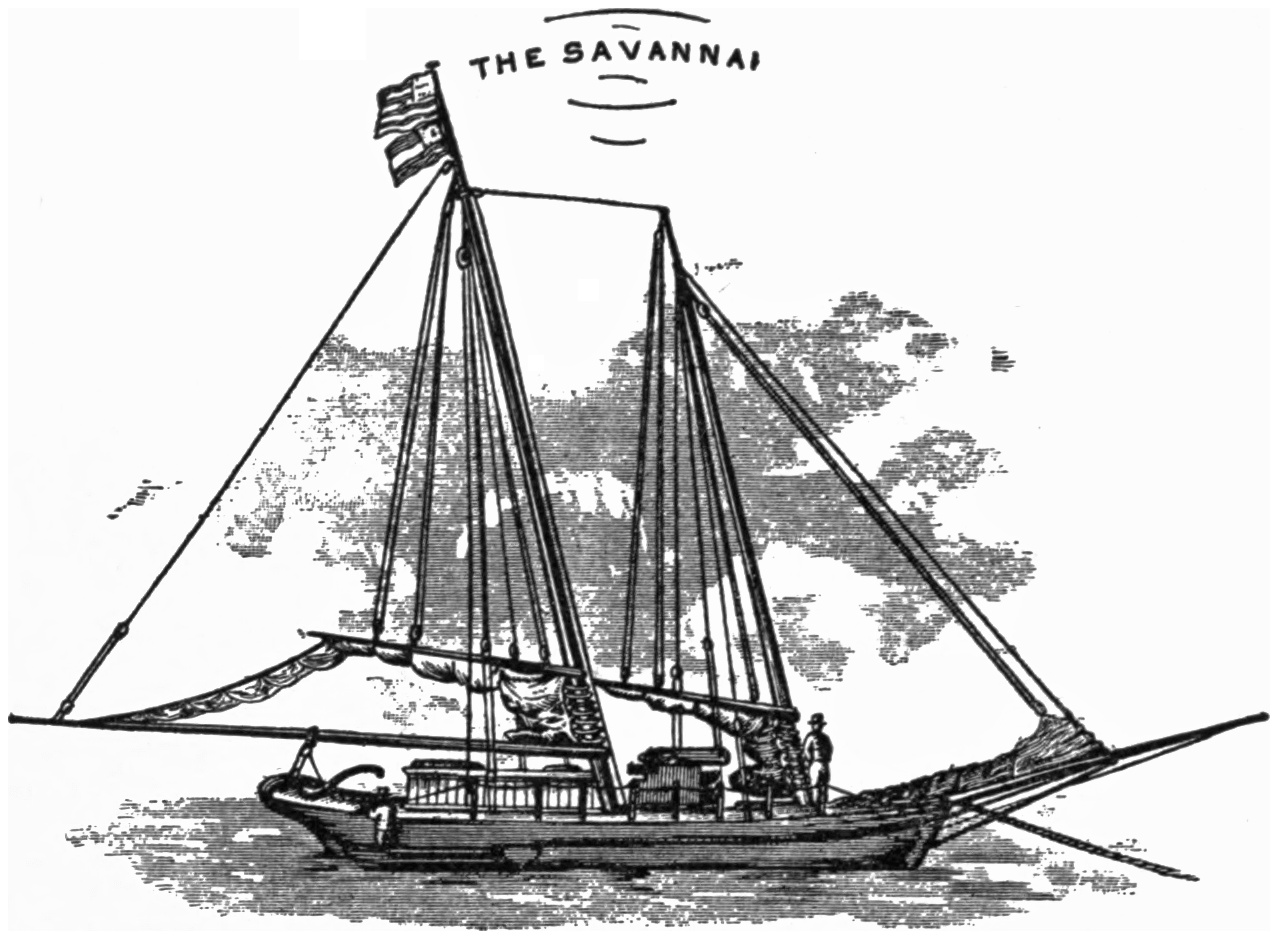
THE SAVANNAH
THE CONFEDERATE STATES PRIVATEER SAVANNAH, LETTER OF MARQUE No. 1, CAPTURED OFF CHARLESTON, BY THE U.S. BRIG PERRY, LIEUT. PARROTT.
Entered according to act of Congress in the Year 1861 by E K KIMMEL 59 NASSAU ST. N.Y. in the Clerks Office of the District Court for the Southern District of New York.
The Savannah sailed out of Charleston on the night of Sunday, June 2, 1861, and, eluding the Federal frigate Minnesota, went cruising for Northern merchantmen. The schooner was small, and the weather hot. The crew slept on deck that night, and, as was testified in court later on, they were not feeling very well next morning. In fact, “being on a flare-up the night before, not much was said,” even when a sail was seen, and it became certain that the sail “was a Yankee vessel.” Eventually the sail was overhauled. It proved to be the brig Joseph, of Rockland, Maine, Capt. Thies N. Meyer, bound, sugar laden, from Cardenas, Cuba, to Philadelphia. The brig had a89 crew of six, all told. She was easily taken, and with a prize crew of six men was sent to Georgetown, South Carolina, where she was condemned and sold in the usual form.
Nevertheless, the cruise was not a paying venture, for soon after sending the prize away the Savannah chased the government man-o’-war brig Perry, thinking her another merchantman, and was, in consequence, captured. The Perry turned her over to the Minnesota; the Minnesota towed her into Charleston harbor near enough to let her owners learn of their loss, and then sent her North. At New York the Savannah’s crew was thrown into prison as pirates, and on July 16, 1861, they were indicted for piracy. The printed report of the trial that followed makes an interesting book of 385 pages. The accused as a whole claimed the rights of prisoners of war, but in spite of the plain evidence that they were entitled to such rights, the jury disagreed. Perhaps when one considers the state of the public mind in the North at that time, the wonder is that they were not convicted and hanged.
Having been remanded in irons to prison, the Confederate authorities took up their case. The victory the Confederates had obtained at Manassas enabled them to put a number of Federal prisoners into irons to abide the fate of the Savannah’s crew. The Federal officers90 so confined included five colonels, two lieutenant-colonels, three majors, and three captains. Mr. Davis sent an envoy with a protest to Washington. Nothing was done about the matter just then.
Meantime, on October 25, 1861, a member of the crew of the privateer Jefferson Davis was convicted on a charge of piracy, and on the 29th three others of the crew were convicted. Nevertheless, on February 3, 1862, all of the alleged pirates, with thirty-four men from the privateer Petrel, were sent to Fort Lafayette as prisoners of war, and the date is of some importance because the change of policy, even though it were compelled by a threat of retaliation, was another official acknowledgment that the government had a very great war upon its hands instead of a local insurrection of no concern to the rest of the world.
Much more interesting than that of the Savannah are the stories of some of the other privateers. The Jefferson Davis, for instance, had a career that approached that of some of the American privateers in 1812. She was built by Northern capitalists in 1854 for a slaver, and was captured on the coast of Africa with many slaves on board, and sent to Charleston. A fine Baltimore clipper she was, and when the war came she was seized and armed with three eighteen-pounders and two91 twelves. She got out to sea on June 28th, having seventy men before the mast. On July 6th, off Hatteras, she got the brig John Welsh, loaded with sugar. On the same day the schooner Enchantress was captured, and the next day, being but 150 miles from Sandy Hook, she took the schooner S. J. Waring, that was bound to Montevideo with a valuable cargo. The first-named prizes were sent to Southern ports; but William Tillman, a colored man, recaptured the Waring, and one fact connected with the adventure makes the story worth telling.
The Davis placed a prize crew of five men on the Waring, Mr. Montague Amiel, a Charleston pilot, being the prize master. William Tillman, who was the Waring’s cook; Brice Mackinnon, a passenger, and two of the Waring’s seamen were left on board of her, and she was headed toward the South. The Northern men at once made friends with their captors. The negro continued to cook perforce, but he made no objection to the work, and the two Northern seamen volunteered to make the best of a bad streak of luck by helping to work the ship.
But because Tillman knew that he would become a slave as soon as he was carried into a Southern port, he determined that he would never go there, and on the night of July 16,92 1861, when fifty miles south of Charleston, he found opportunity to become master of the schooner.
It was at about midnight. Prize Master Amiel was asleep in the cabin, with the prize mate in a nearby berth. The second mate was on deck, but about half-asleep, while one of the Waring’s original crew was at the wheel, and two of the prize seamen were on duty near the bow. Taking the hatchet which he used in splitting wood for the galley stove, the negro killed the prize captain and the two mates, when the Confederate seamen surrendered and agreed to help work the ship back to New York. There was no one on board who understood navigation, but the negro knew enough to lay a course that would bring “the broadside of America in sight,” and after that he followed the coast until he reached New York.
Meantime the Davis had captured the Mary Goodell, from New York to Buenos Ayres; but she was allowed to go after the prisoners were put on board, and five of her crew had shipped in the Davis. On the same day (July 9th) the Mary E. Thompson, of Searsport, was captured and sent in, after which the Davis went to the West Indies.
In all, nearly a dozen merchantmen were captured by the energetic captain, Louis M.93 Coxetter, of the Davis. He then returned, and while trying to enter St. Augustine, Florida, grounded, and the vessel was lost. Not all of his prizes ever reached home, and it was from the recaptured vessels that the men convicted of piracy were taken. It is said that the prizes sent in, however, netted over $200,000 in gold for the crew. Coxetter himself, like most of his class, became a blockade-runner after the blockade, and England’s refusal to permit the sale of Confederate prizes in her ports made privateering unprofitable—that is, say, after January 1, 1862.
Between July 19 and August 27, 1861, the privateer Dixie sent in three prizes. The Freely, another Charleston privateer, was also a successful boat. So was the York. The revenue cutter Aiken, which was converted into the privateer Petrel, at Charleston, was about the most unlucky of the fleet. She went chasing the frigate St. Lawrence soon after getting safely to sea, thinking the big man-o’-war was a merchantman. Certainly no men worse fitted for their task than the Petrel’s crew were ever sent to sea, for even when within short range they failed to recognize the warship. They fired three guns—the first two across the bows of the St. Lawrence to heave her to, and the last one at her. Then the St. Lawrence opened her ports and94 fired three guns at the privateer. An eight-inch shell and a thirty-two-pound solid shot struck her below the water-line, the shell bursting while right in the planks. The hole made was so large that the Petrel rolled to the swell and sank instantly, leaving her crew afloat in the water. Four men were drowned, and the rest were picked up by the St. Lawrence.
There were a number of other privateers from Charleston, but they neither accomplished nor suffered anything worth especial mention. In addition, there was a fleet of small schooners that had their headquarters in the Pamlico Sound. It is worth the reader’s time to take a look at the map of the enclosed waters along the coast south of the Chesapeake Bay; it is worth any traveller’s time to visit the region. A series of long, narrow islands, built of the débris of New England rocks, lie along there, enclosing the waters of Currituck, Albemarle, and Pamlico sounds. They are but narrow, and, for the most part, but barren stretches of sand. Here and there a shoal inlet cuts across this sand-bar—an inlet that is shifted to and fro, and deepened and shoaled by the wind-driven water of the sea, but always kept open somewhere by the outflow of the waters from the slope of land east of the Alleghany ridge. There are a few inlets that are never closed wholly, no matter how the set of the97 tide piles the sand into them, and of these the most important are known as Hatteras and Ocracoke inlets.
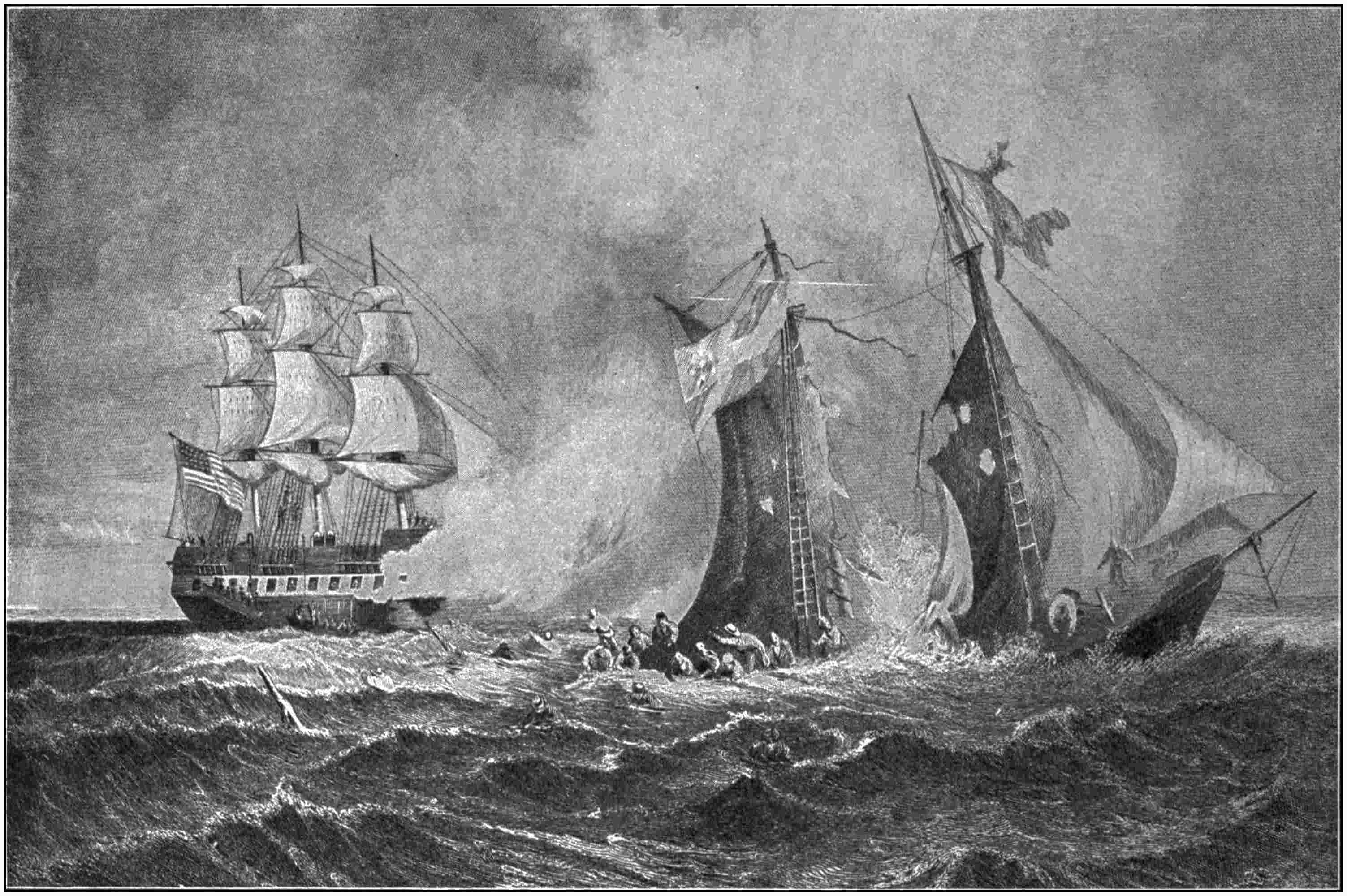
Destruction of the Privateer Petrel by the St. Lawrence.
From an engraving by Hinshelwood of the painting by Manzoni.
The Hatteras Inlet, which lies thirteen miles southwest of Cape Hatteras, is the most important. Here the water over the bar is, at high tide, usually fourteen feet deep; within is a safe anchorage for any ship that can pass in. But a mile inside the bar lies another, where the water is ordinarily but seven feet deep. Once across that, plenty of deep water is found, both north and south, and away inland to the ports whence came, in those days, the bounties of nature called naval stores. Hatteras is of small importance in these days, since railroads have been stretched along the coast, but the time was when not a small fleet of coasters used it regularly.
It was from among these vessels and their crews that the “Hatteras pirates” came in the first four or five months of the Civil War. They were, of course, lawfully commissioned private cruisers, but the records of their deeds have been lost, save, as it is known, that one bark, seven brigs, and eight schooners had been carried in there as prizes previous to August 28, 1861, and condemned and sold. The Transit, of New London; the Wm. S. Robins, and the J. W. Hewes were lying at Newbern alone, on the first of July, awaiting adjudication.
98
Then, too, it speedily became a haunt of blockade-runners seeking cotton as well as naval stores, and to dispose of manufactured goods from England.
To the Northern merchant Pamlico Sound was a “pirates’ nest” that needed immediate attention, and the next chapter shall tell what was done.
99
AN EXPEDITION PLANNED BY THE NAVY DEPARTMENT THAT RESULTED IN THE FIRST FEDERAL VICTORY OF THE CIVIL WAR—AN AWKWARD LANDING FOLLOWED BY INEFFECTUAL FIRE FROM SHIPS UNDER WAY—ONE FORT TAKEN AND ABANDONED—ANCHORED BEYOND RANGE OF THE FORT AND COMPELLED SURRENDER BY MEANS OF THE BIG PIVOT GUNS—A WEARISOME RACE FROM CHICAMICOMICO TO HATTERAS LIGHTHOUSE WON BY THE FEDERALS—CAPTURE OF ROANOKE ISLAND—ORIGIN OF THE AMERICAN MEDAL OF HONOR.
For the work that was to be done in restoring the Federal authority over Hatteras Island and adjacent inland waters a large force was prepared, because no accurate estimate of the Confederate force there was obtainable. To Flag Officer Silas H. Stringham was assigned the command of the expedition. His squadron consisted of the frigate Minnesota, Capt. G. I. Van Brunt; the frigate Wabash, Capt. Samuel Mercer; the Monticello, Capt. John P. Gillis; the Pawnee, Capt. S. C. Rowan, and the Harriet Lane (revenue cutter), Capt. John Faunce. The tug Fanny, under Lieut. Pierce Crosby, went along as a tender, while the transports100 Adelaide, Capt. H. S. Stellwagen, and Peabody, Capt. R. R. Lowry, carried 860 soldiers under Gen. B. F. Butler. The troops under Butler had orders to return to Fort Monroe as soon as the object of the expedition was attained.
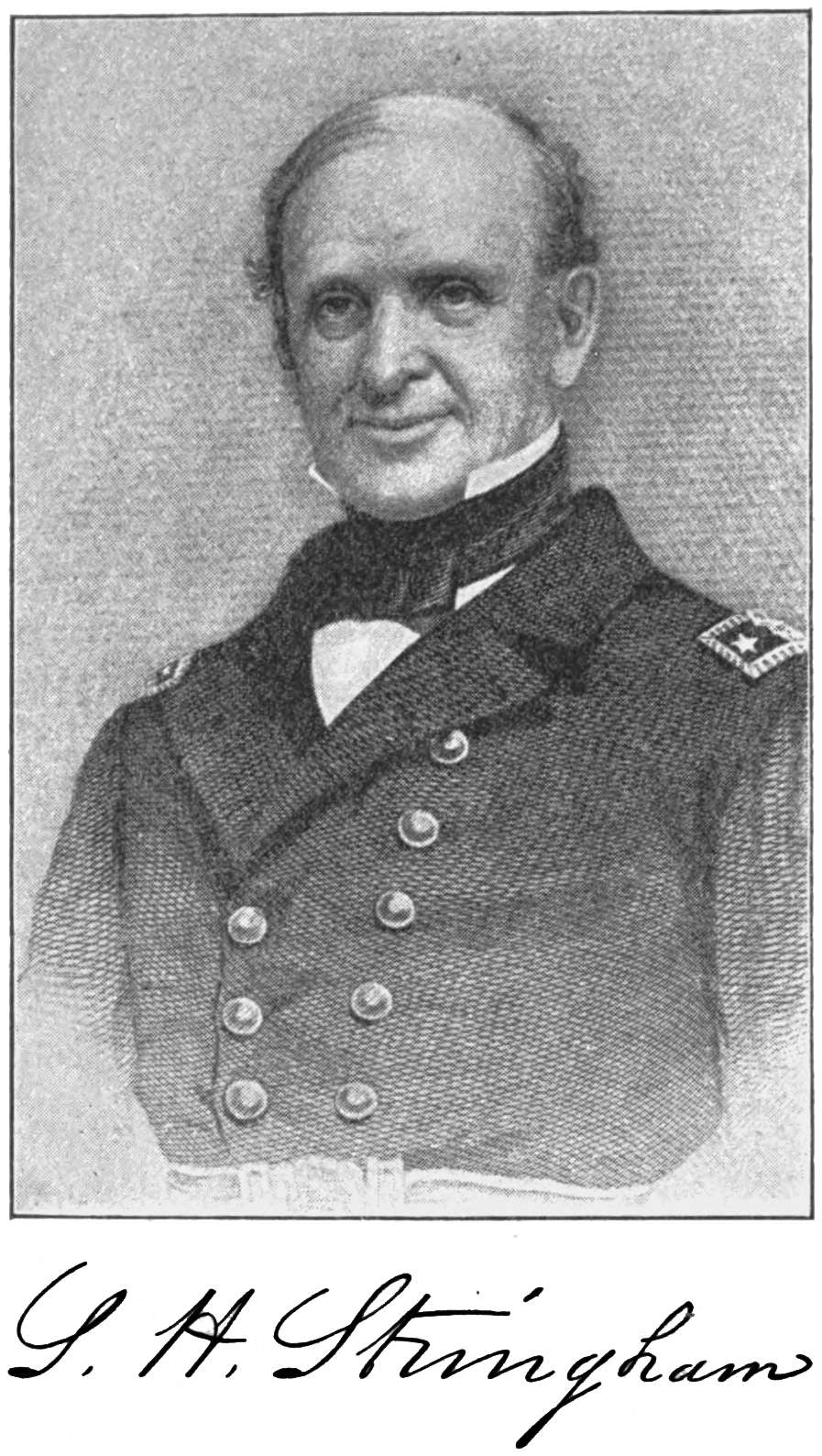
S. H. Stringham
From an engraving by Buttre.
On the afternoon of August 26, 1861, the squadron rounded Cape Hatteras and anchored about three miles above the inlet, where it was proposed to make a landing. Two schooners, with their decks loaded with “heavy iron surf-boats,” had been brought along, and these surf-boats were floated before dark. The next morning the debarkation of General Butler’s force began, and Captain Shuttleworth, of the marines, with enough of his men to raise the whole landing force to 915 men, went along. The Pawnee, the Monticello, and the Harriet Lane steamed close in and opened the attack on the beach by shelling the live-oak and other101 trees that grew in profusion just beyond the reach of the waves.
When the surf-boats started ashore at 8.45 o’clock in the morning, the other ships of the squadron made a swoop at the forts that could be plainly seen guarding the inlet. The sailing frigate Cumberland had joined the force during the night, and the Wabash took her in tow and followed in the wake of the flagship Minnesota. Meantime the frigate Susquehanna had happened along, and she joined in the procession, the plan of attack being to steam in until within range, fire as the forts were passed, and then steam out to sea and back again over an elliptical route. It was a plan that was followed in several attacks of the kind; but it is condemned by Admiral Porter as “not the best calculated to bring an engagement to a speedy conclusion.” The plan “bothers the enemy’s gunners”—it is safer for the ships—but it also “detracts from the accuracy of the fire on board the vessels.”
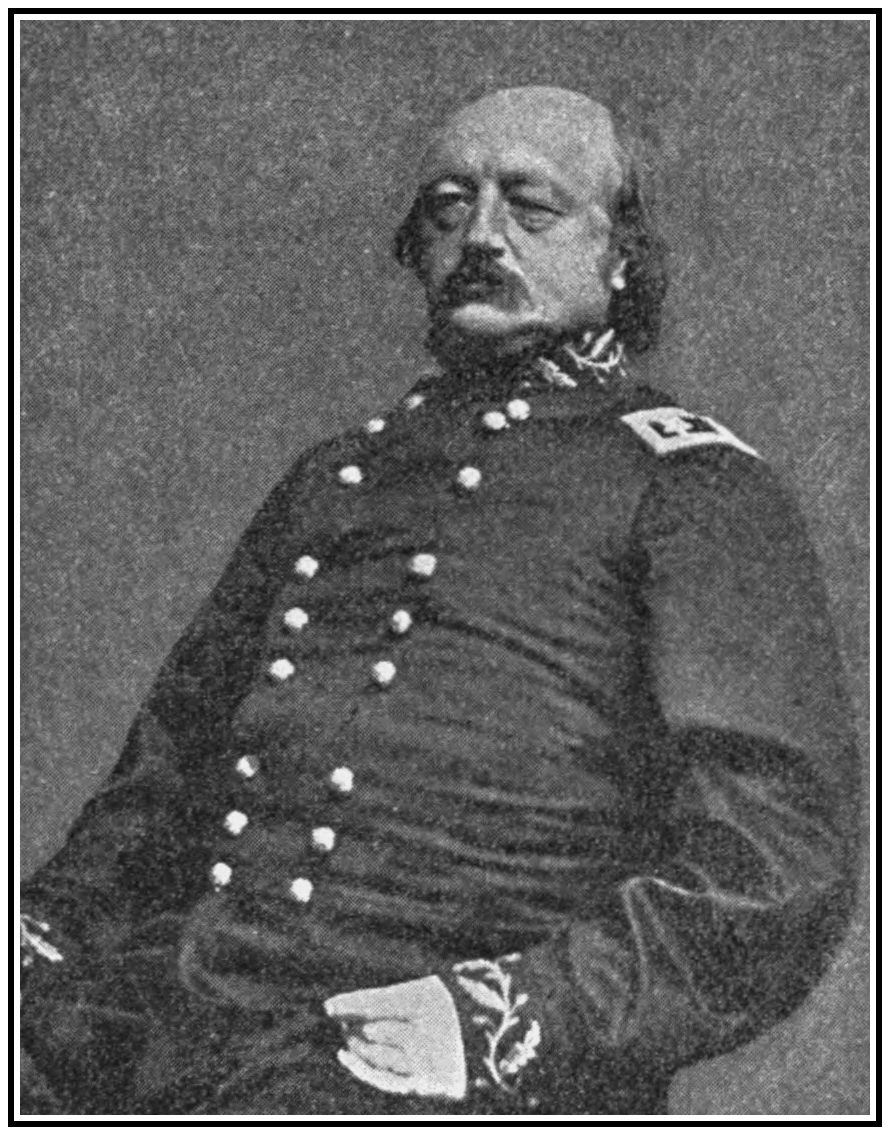
B. F. Butler.
From a photograph.
102
A small earthwork called Fort Clark was the first one met. It had no bomb-proof, and it mounted five guns. The ships opened fire on this fort long before they were within range, and the fort replied. Both sides sowed the water with shot and shells; but the Confederates soon ceased to waste their ammunition, and when the ships got within range, their fire proved so hot that the fort was abandoned.
Meantime the troops had reached the surf in their boats, and for a pleasant day they found it a right vigorous surf. There was very little difficulty in getting the boats to the sand; they were so large that a gale would scarcely have swamped them; but the moment they touched bottom forward, the waves caught them under the floating stern, slewed them around broadside on, and hove them up hard and fast. In vain the soldiers and sailors and marines tugged and pried and swore. In all 420 men, with two howitzers, were placed on the beach, and not another armed man could they land. And what made matters worse was the fact that they had neither provisions nor supplies of any kind, and their ammunition (it was the day of paper cartridges) was in great part wet by the surf. It was a fortunate thing that the Confederates were kept busy in Fort Hatteras about that time.
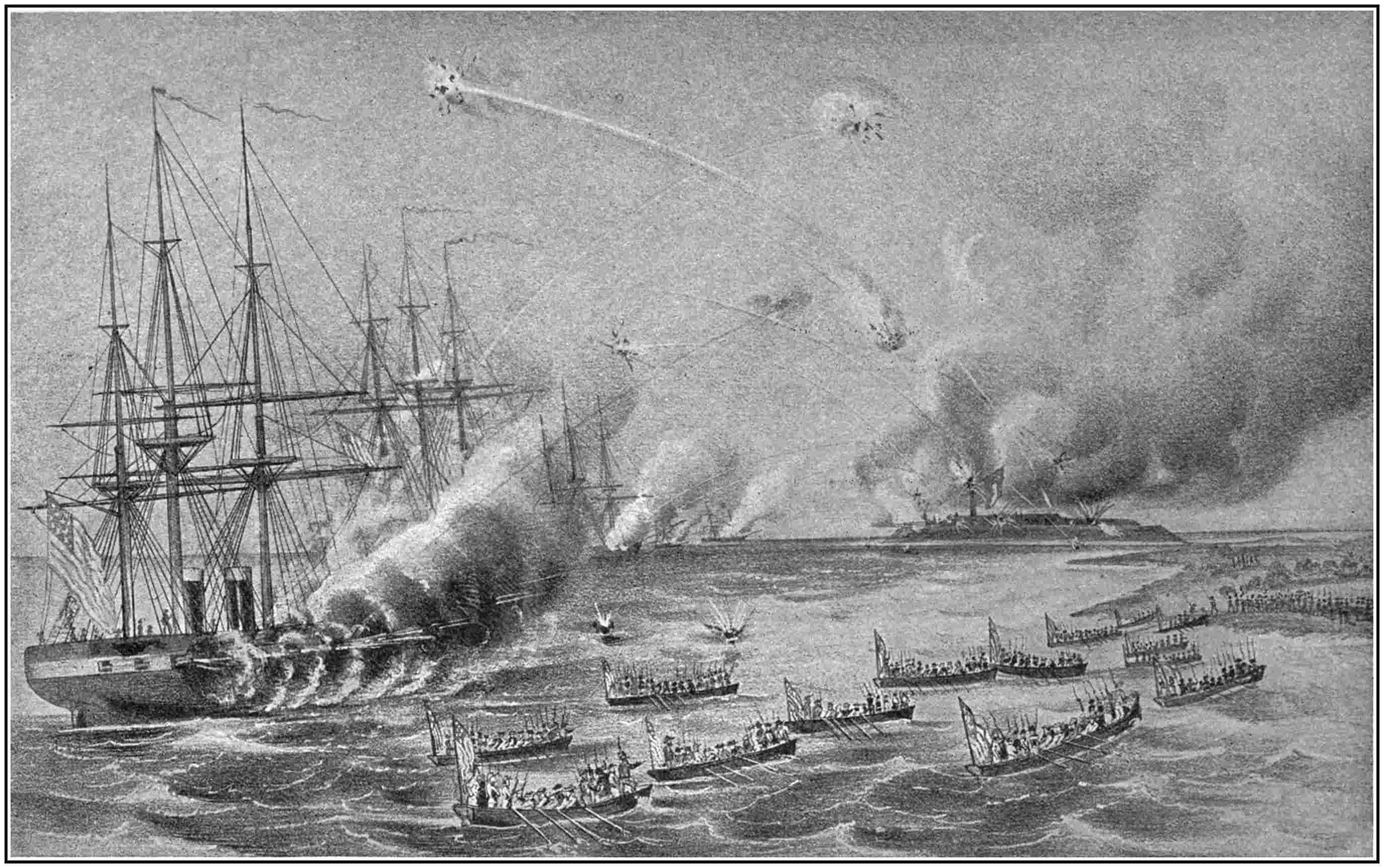
Bombardment and Capture of the Forts at Hatteras Inlet, N. C.
From a lithograph published by Currier & Ives.
However, the Confederates having abandoned105104 Fort Clark, the Federal troops were marched to it, and at 2 o’clock in the afternoon the Union flag was hoisted above it.
Meantime the fire of Fort Hatteras had been “smothered by the fire of the frigates,” and the Confederate flag had disappeared. Seeing this, the frigates ceased firing at 12.30 o’clock, on the supposition that the Confederates were willing to surrender. But when, at 4 o’clock in the afternoon, the Monticello was ordered to go in through the inlet and take a look at the small fleet of Confederate vessels inside the inner bar, the Confederate fort opened fire on her. The Wabash was at this time towing the Cumberland to a safe anchorage off shore, but the Minnesota, Susquehanna, Pawnee, and Harriet Lane returned the fire with vigor until sunset. But the fire was, “for the most part, ineffective, from too great a distance,” as Ammen says. The fact is, there was nothing reckless in the attack.
At sundown the Union troops abandoned Fort Clark and camped up the beach, where the smaller steamers could protect them. They had had a hungry day of it, but food was sent ashore at night. Then, as the night wore away, the troops threw up a sand battery facing the sound, and from this threw some shells at the Confederate vessels, “which seems to have materially disconcerted the enemy,” and prevented106 the landing of reinforcements for the fort.
The next morning the Susquehanna led the way in to attack Fort Hatteras, and the Minnesota, the Wabash, and the Cumberland followed, and all came to anchor “in excellent position and commenced firing with effect.” That is to say, the position was excellent because the ships were entirely beyond the range of the fort, while their pivot guns, fifteen in number, were throwing every shell fired into the Confederate works. The fire began at 8 o’clock in the morning. The bomb-proof in the fort was seriously damaged, and at 11 o’clock it was set on fire by a shell that dropped through a ventilator. The magazine being in great peril, the Confederates hoisted a white flag at 11.10 o’clock. This was on August 28, 1861; and that was not only the first victory that the navy of the nation had gained, but it was the first victory that any Union force had gained in this war for the defence of the nation’s life. The Union force did not lose a man. The Confederates lost two killed and thirteen wounded of which we are certain. It is asserted that the losses were greater.
Flag Officer Samuel Barron, of the Confederate navy, who had charge of a small fleet of armed boats on the sound; Major W. S. G.107 Andrews, commanding the forts, and 615 men and officers were captured. The two forts contained together twenty-five guns, every one of which came from the Norfolk Navy Yard, as did also 1,000 muskets and a quantity of ordnance stores found in the fort.
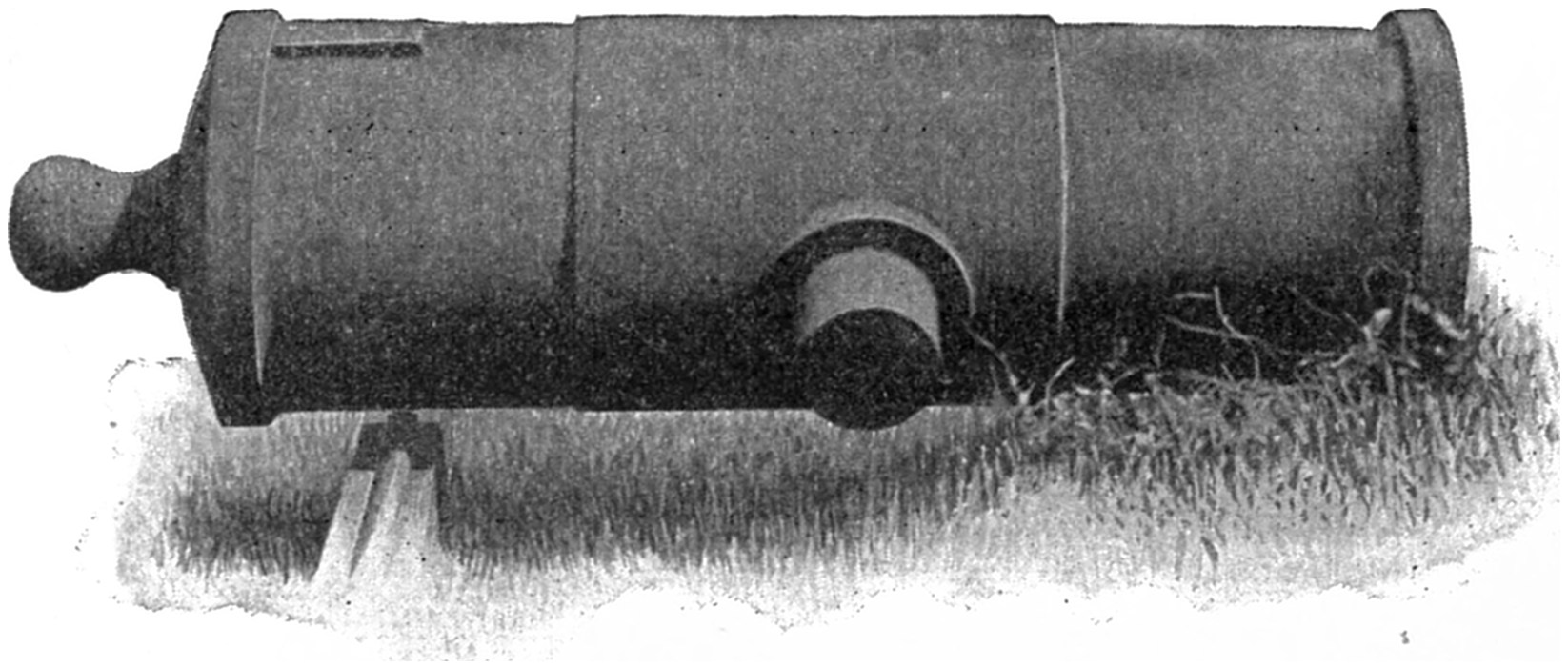
This point was thereafter held by the Union forces throughout the war. To show the value of this victory, we may quote the report of General Butler. He said:
“From there the whole coast of Virginia and North Carolina, from Norfolk to Cape Lookout, is within our reach by light draught vessels, which cannot possibly live at sea during the winter months. From it offensive operations may be made upon the whole coast of North Carolina to Bogue Inlet, extending many miles inland to Washington, Newbern, and Beaufort. In the language of the chief-engineer of the rebels, Colonel Thompson, in108 an official report, ‘it is the key of Albemarle.’ In my judgment, it is a station second in importance only to Fortress Monroe on this coast. As a depot for coaling and supplies for the blockading squadron it is invaluable. As a harbor for our coasting trade, or inlet from the winter storms or from pirates, it is of the first importance.”
A fort at Ocracoke Inlet was abandoned by the Confederates when those at Hatteras fell.
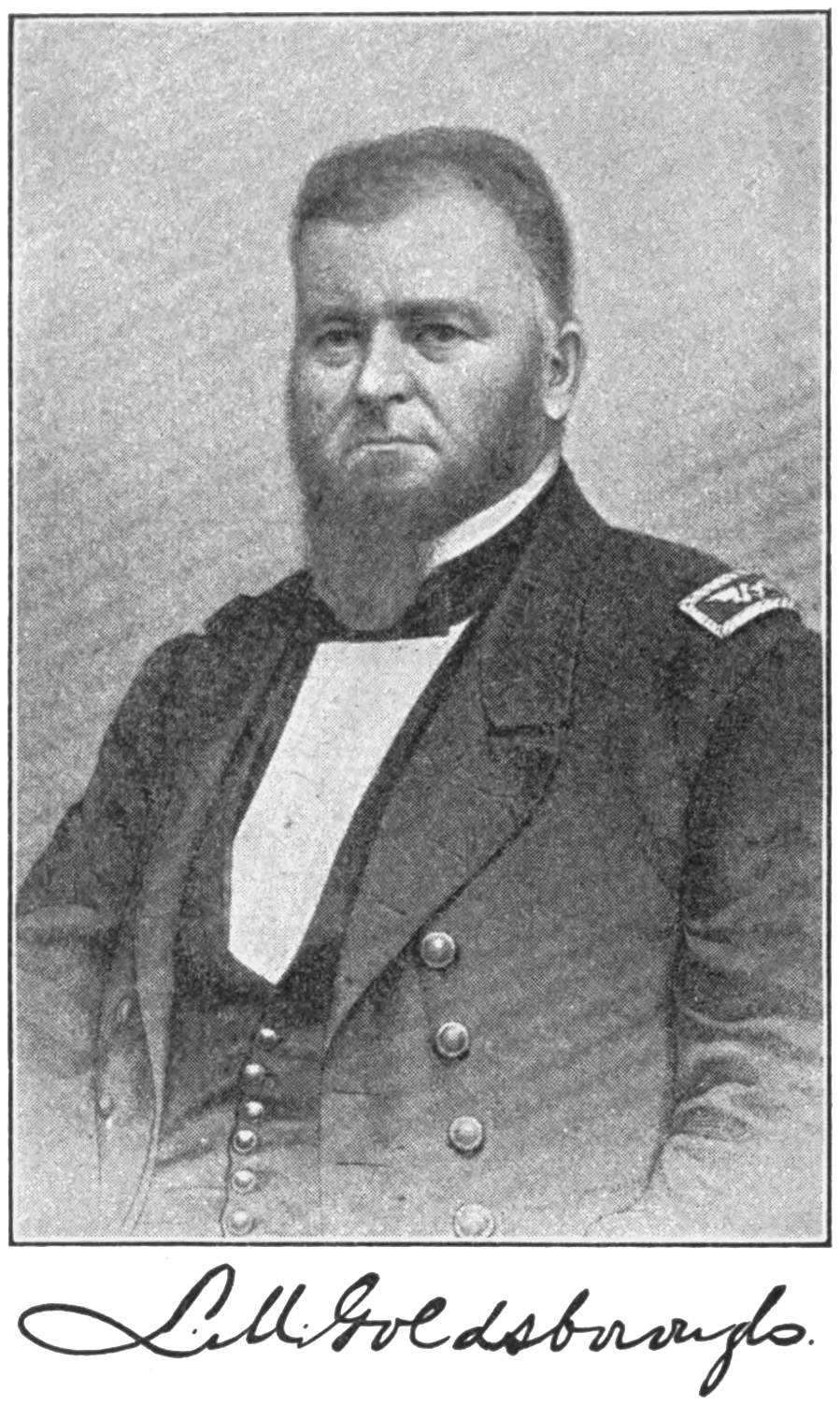
L. M. Goldsborough
From an engraving by Buttre.
Meantime the Twentieth Regiment of Indiana Volunteers, under Colonel Brown, of the Hatteras Island garrison, got into serious trouble. The regiment had gone to a small settlement at the north end of the island—Chicamicomico by name—twenty-five miles north of Cape Hatteras lighthouse. Just what purpose they were to serve there is not now apparent; but the Confederates, who had fortified Roanoke109 Island, came with a superior force to cut them off from communication with the forces at the inlet, and there was a most fatiguing race down the beach. The Union force won, the Confederates being driven off by the Union steamer Monticello, Capt. D. L. Braine.
Following this, in 1862, came the expedition under Flag Officer L. M. Goldsborough and Gen. A. E. Burnside against Roanoke Island. The force left Hampton Roads on January 11th. There was a long delay at Hatteras Inlet bar, but on Friday morning, February 7th, they were facing the Confederate forts on the north end of Roanoke Island, and a squadron of Confederate ships, which their commander, Commodore W. F. Lynch, described as “two old side-wheel steamers, and six propellers—the former possessing some speed; the latter slow in their movements, and one of them frequently disabling its shaft.”

Stephen C. Rowan.
From a photograph.
110
The Union steamers were, in fact, no better. Both fleets were wholly unarmored, but the guns on both sides were good for that day, and therein lies the one point worth noting. The Union fleet on one side and the Confederate forts and fleet on the other fought for six hours at one stretch at easy range. One Union ship reports firing 181 shells, and probably those that made no report of the matter (there were nineteen in all) did as well, but only one ship—a Confederate—was sunk, and she was able to run away to a fort before going down. After two days the Confederate forts surrendered, and the Confederate ships fled to Elizabeth City.
Commander S. C. Rowan, with a part of the Union fleet, pursued and destroyed or captured them all save one that passed through the canal to Norfolk. The conflict at Elizabeth City is especially notable, because the deed of a heroic gunner led Congress to pass an act creating a Union naval medal. Says Lossing:
“An extraordinary example of heroism was exhibited during this engagement by John Davis, a Finlander, who was a gunner’s mate on board the Valley City. A shell entered that vessel, and, exploding in the magazine, set fire to some wood-work. Davis was there, and, seeing the imminent danger to the vessel and all on board, because of an open barrel of111 gunpowder from which he had been serving, he seated himself upon it, and so remained until the flames were extinguished. For this brave act the Secretary of the Navy rewarded him with the appointment of acting-gunner in the navy (March 11, 1862), by which his salary was raised from $300 to $1,000 a year. Admiring citizens of New York raised and presented to him $1,100. The Secretary of the Navy, by authority of an act of Congress, approved December 21, 1861, presented him with a Medal of Honor, on which are inscribed the following words: ‘Personal Valor, John Davis, Gunner’s Mate, U.S.S. Valley City, Albemarle Sound, February 10, 1862.’ Such medals were afterward presented to a considerable number of gallant men in subordinate stations, for acts of special bravery ‘before the enemy.’ Davis was the first recipient.”
112
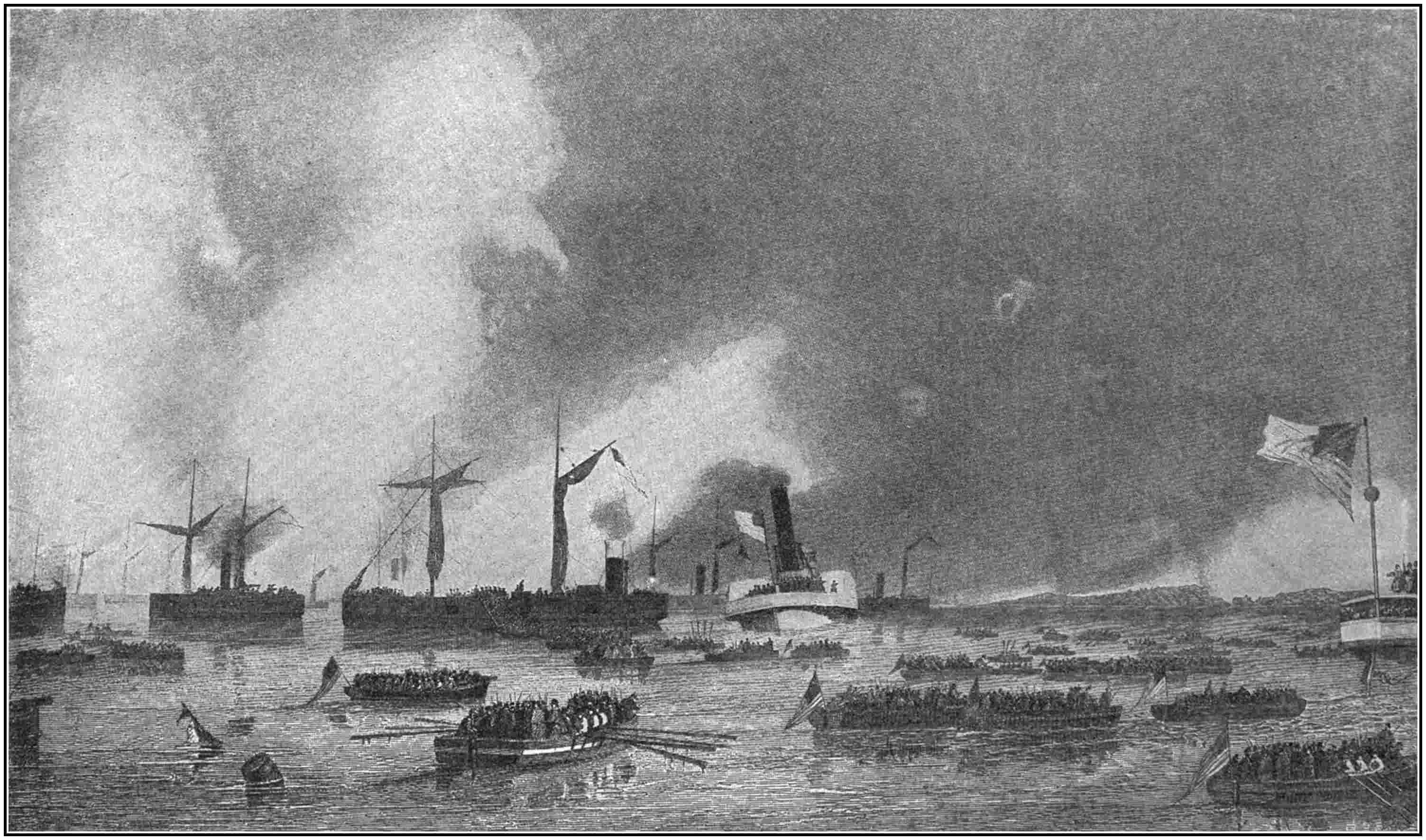
Attack on Roanoke Island—Landing of the Troops.
From an engraving of the painting by Chappel.

Landing of Troops on Roanoke Island.
From an engraving by Perine of a drawing by Momberger.
THE SHAMEFUL STORY OF PENSACOLA AND FORT PICKENS—WHEN LIEUTENANT RUSSELL BURNED THE JUDAH—A BRITISH CONSUL’S ACTIONS WHEN CONFEDERATE FORTS WERE ATTACKED AT GALVESTON—EXTRAORDINARY PANIC AT THE HEAD OF THE PASSES IN THE MISSISSIPPI WHEN FOUR GREAT WARSHIPS, CARRYING FORTY-FIVE OF THE BEST GUNS AFLOAT, FLED FROM A DISABLED TUGBOAT THAT WAS REALLY UNARMED—ONCE MORE IN GALVESTON—LIEUTENANT JOUETT’S FIERCE FIGHT WHEN HE DESTROYED THE ROYAL YACHT.
There were stirring events in and around the Gulf of Mexico during the year 1861—some of them stirring the naval sailors in one way and some in another. The trouble began there very early in the year—on January 12th, in fact, when Colonel Lomax and Major W. H. Chase, with some Florida and Alabama troops, surrounded the navy yard at Pensacola and compelled Commodore James Armstrong to surrender it to the Confederates. It was very well known that an attack impended a long time before it actually happened, but no effort was made by any one in the yard to preserve any of the government property for114 government use. Armstrong was not, indeed, disloyal, but he was very properly suspended from the navy for five years for his failure at Pensacola. The executive officer under him, Commander Ebenezer Farrand, and Lieut. Francis B. Renshaw had already decided to join the Confederate forces, and it should not be forgotten that they were among the men willing to serve the Confederates while still wearing the uniform of the government. Renshaw himself, while in national uniform, had the old flag hauled down and the Confederate flag sent up in its place. Farrand did still worse. He refused to allow the powder to be removed from the magazine when a loyal officer, Commander Henry Walke, proposed removing it. He kept it in the magazine unguarded in order that the Confederates might get it. When he could do no more for the Confederates by remaining in the pay of the government, he sent in his resignation.
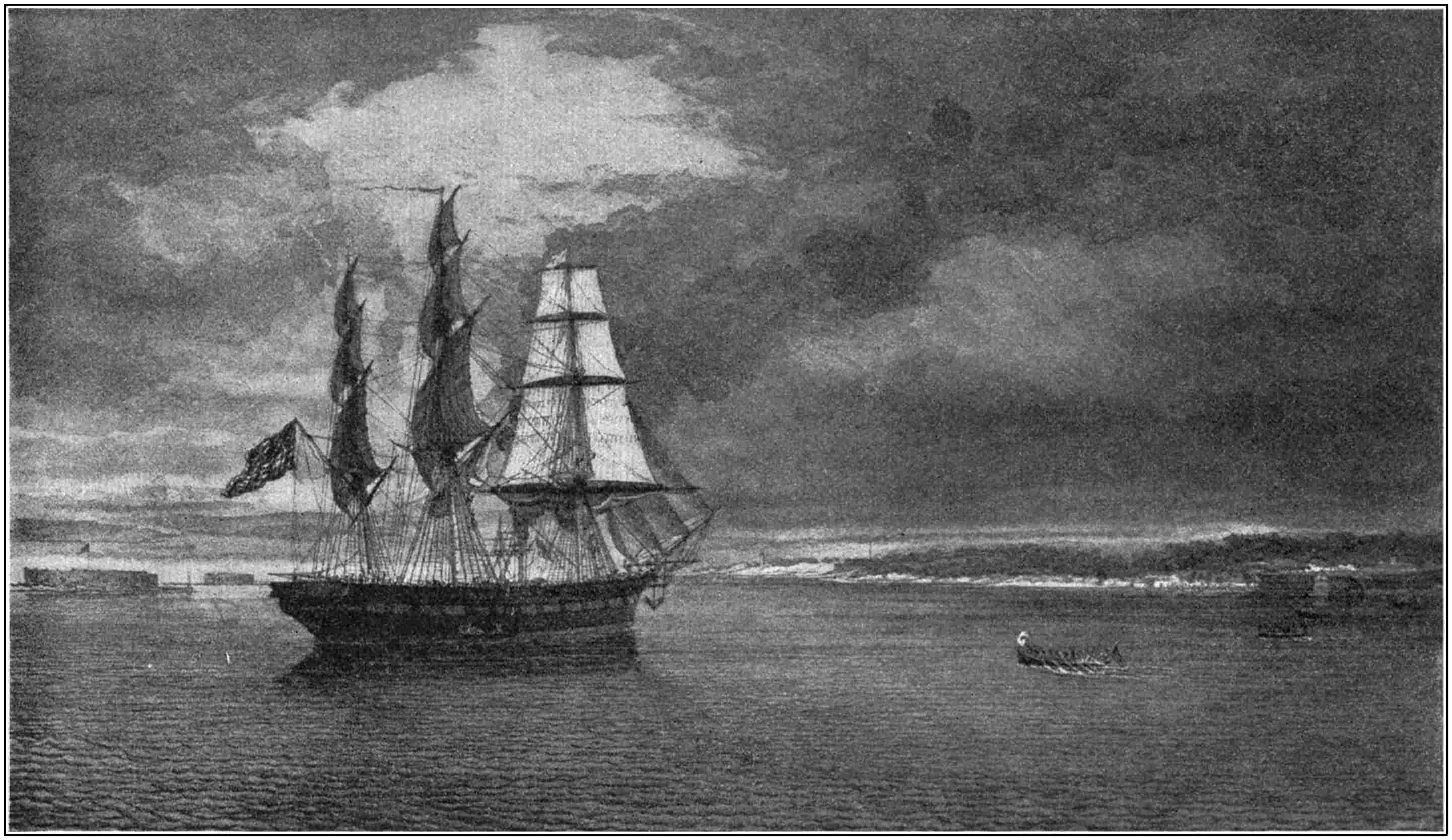
Surrender of the Navy Yard at Pensacola.
From a painting by Admiral Walke.
115
Meantime the soldiers in charge of the three forts that guarded the harbor had been concentrated at Fort Pickens on the 10th by Lieut. Adam J. Slemmer, U. S. A. At that time Commander Henry Walke was in Pensacola, in command of the transport Supply. She was en route to Vera Cruz with stores for the government ships lying there. On January 9th, Walke was ordered by Commodore Armstrong to assist Slemmer in concentrating the troops and army supplies at Fort Pickens. Walke at once started to obey this order; but when about to engage in doing so, another order came under which he was to merely give some food to the men already in Fort Pickens and then return to the navy yard, leaving the army forces scattered among the three forts about the harbor. Walke, in his “Reminiscences,” says Farrand “hood-winked” the commodore into issuing that order. Walke showed it to Slemmer, and Slemmer, in despair, said if that order was obeyed, no further effort to hold the forts should be made. But Walke at once determined to disobey the order in so far as he must in order to concentrate the army forces at Fort Pickens.
Walke’s act was one of the most remarkable of that day. It was almost without precedent that a naval officer should be independent-minded116 enough to do what was right in the interests of the government without first receiving an unmistakable order to do it. But that a man should save a fort for the government by actually disobeying the order of a superior—that was then unheard of, though an officer of a higher grade saved three fine ships from the Merrimac in like fashion some time later. By concentrating the army forces at Pickens, contrary to Armstrong’s orders, Walke saved the fort. Then, when the yard had been surrendered to the Confederates, he took the paroled officers and men, with their families, from the yard and carried them to New York. This, although done in the interest of the government, and as an act of humanity, was also contrary to his original order which contemplated a passage to Vera Cruz. So Walke was court-martialled, found guilty, and sentenced to be censured! This is perhaps the only case on record where the legal censure of an American naval officer was as a badge of honor.
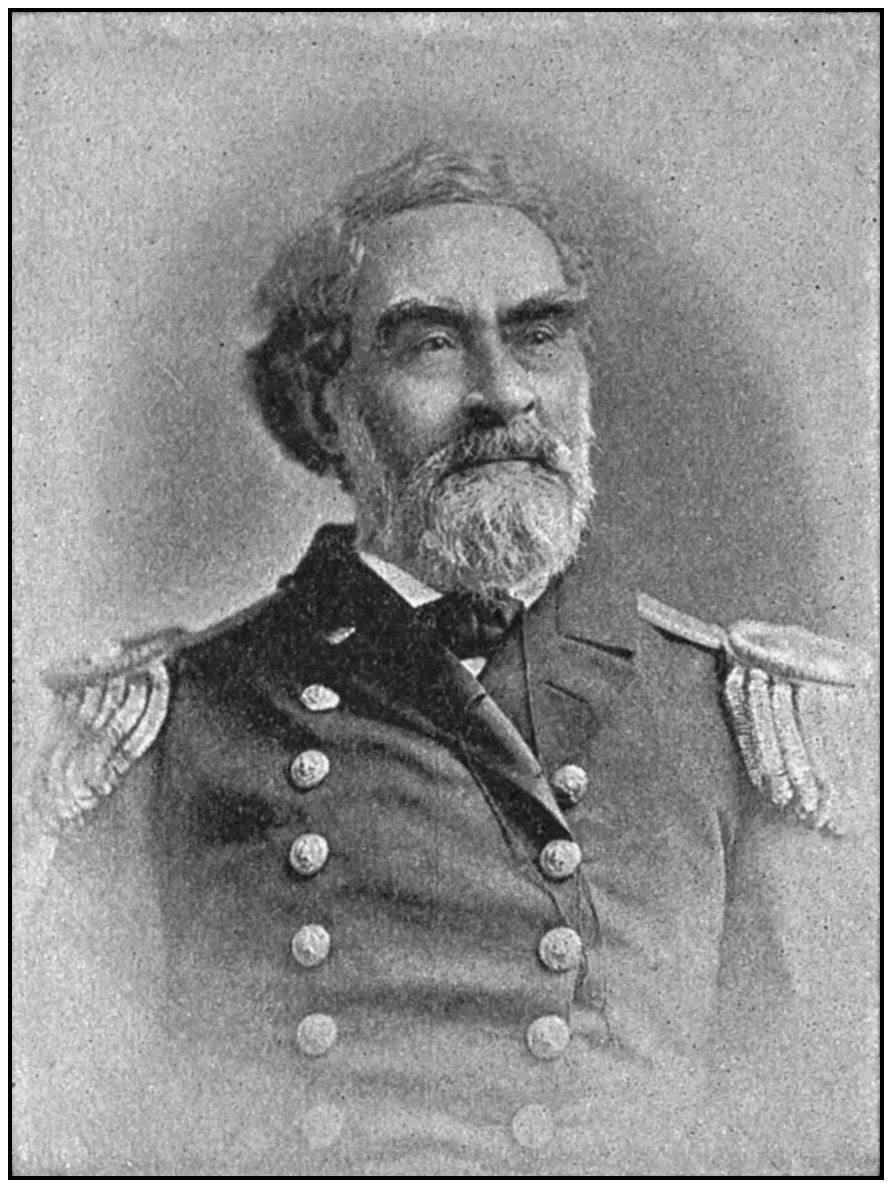
Henry Walke.
From a photograph.
Meantime the Buchanan administration was in some way moved, after the navy yard was captured, to send the Brooklyn down there with eighty-six artillery men and 115 marines. But before these could be landed the administration repented, and the Brooklyn was117 ordered to lie off the harbor. And there she lay when Mr. Lincoln came into office. On March 12th an order was sent to Capt. J. Vodges, commanding the artillery company on the Brooklyn, to land. This order was received by Vodges on March 31st, and on April 1st he called on Capt. H. A. Adams, of the Brooklyn, for boats, etc., for the landing. Instead of giving them, Adams declined, and wrote a letter to the Navy Department, saying that the order to Vodges “may have been given without a full knowledge of the condition of affairs here.” He was sure that reinforcing the fort “would be viewed as a hostile act, and would be resisted to the utmost.” The department was warned that “it would be a serious thing to bring on, by precipitation, a collision.” In short, this officer, who was a Union man, had been cajoled into a state of mind where he ignored the fact that the Confederates were working day and night to place their defences in the best possible order and were adding to their forces daily. He had, in truth, been instructed by Buchanan’s Secretary of the Navy “not to land the company unless said fort shall be attacked or preparations be made for its attack.” The italics are not in the original document, of course, but they are inserted to make plain the way in which Adams ignored the Confederate118 work of preparing to capture Fort Pickens by increasing the effectiveness of Fort McRae and Fort Barrancas. To land a man in Fort Pickens would be “viewed as a hostile act,” and would “bring on, by precipitation, a collision.” To improve the Confederate Fort McRae was not to be considered! Certainly the contempt which the Southern people of that day felt for men of the North was not without some justification.
These facts seem worth giving because they show the difference between the state of mind on the Union side and that on the Confederate. The Confederates knew what they wanted and were reaching after it ceaselessly: The Union forces at this time were not much short of mental demoralization, anywhere, and the quick-witted Confederates took advantage of it.
This letter was carried to Washington by Lieut. Washington Gwathmey, who afterwards joined the Confederates. It took him five days to cover the distance, and the reinforcement of Fort Pickens was delayed by that much.
The department could hardly tell whom to trust, but Lieut. John L. Worden was chosen to carry an order to Adams for the landing of the troops; and no mistake was made in his case, for he was the Worden who afterward119 commanded the Monitor. He reached Pensacola on April 11th, and on telling Gen. Braxton Bragg, of the Confederate forces, that he had an oral order for the captain of the Brooklyn, was allowed to go off to her on the 12th. He had committed the order to memory and destroyed the document. That night, April 12, 1861, Fort Pickens was reinforced. Bragg had planned an attack on Fort Pickens for the night of the 13th—an attack that must have succeeded, because the Union force had been only eighty-three men, all told; but when the artillerymen and the marines were landed the face of matters was changed and the attack postponed indefinitely. The flag has never ceased to float over Fort Pickens. The Confederates were greatly exasperated, and Worden was arrested in Montgomery and held a prisoner for seven months.
In September the general dulness of affairs about Pensacola was relieved by a brilliant dash which a force from the blockader Colorado made into the harbor. The Confederates had been strengthening their works along shore gradually, and had at last started fitting out a schooner called the Judah at the navy yard for use as a privateer. This schooner was guarded by a ten-inch columbiad (a columbiad being a gun half-way between a carronade and a long gun) and a field-piece, both120 being placed to sweep her deck. There was also a large force of men camped in the yard—some accounts say 1,000—while the schooner had a full crew on board, with a long pivot gun and two broadside guns in place. It is a remarkable fact that the yard where she was fitted and the schooner herself were within easy range and plain sight of Fort Pickens, and the fact that she intended to sail out after American merchant ships was obvious. But not a shot was fired from the fort to disturb her owners or the workmen.
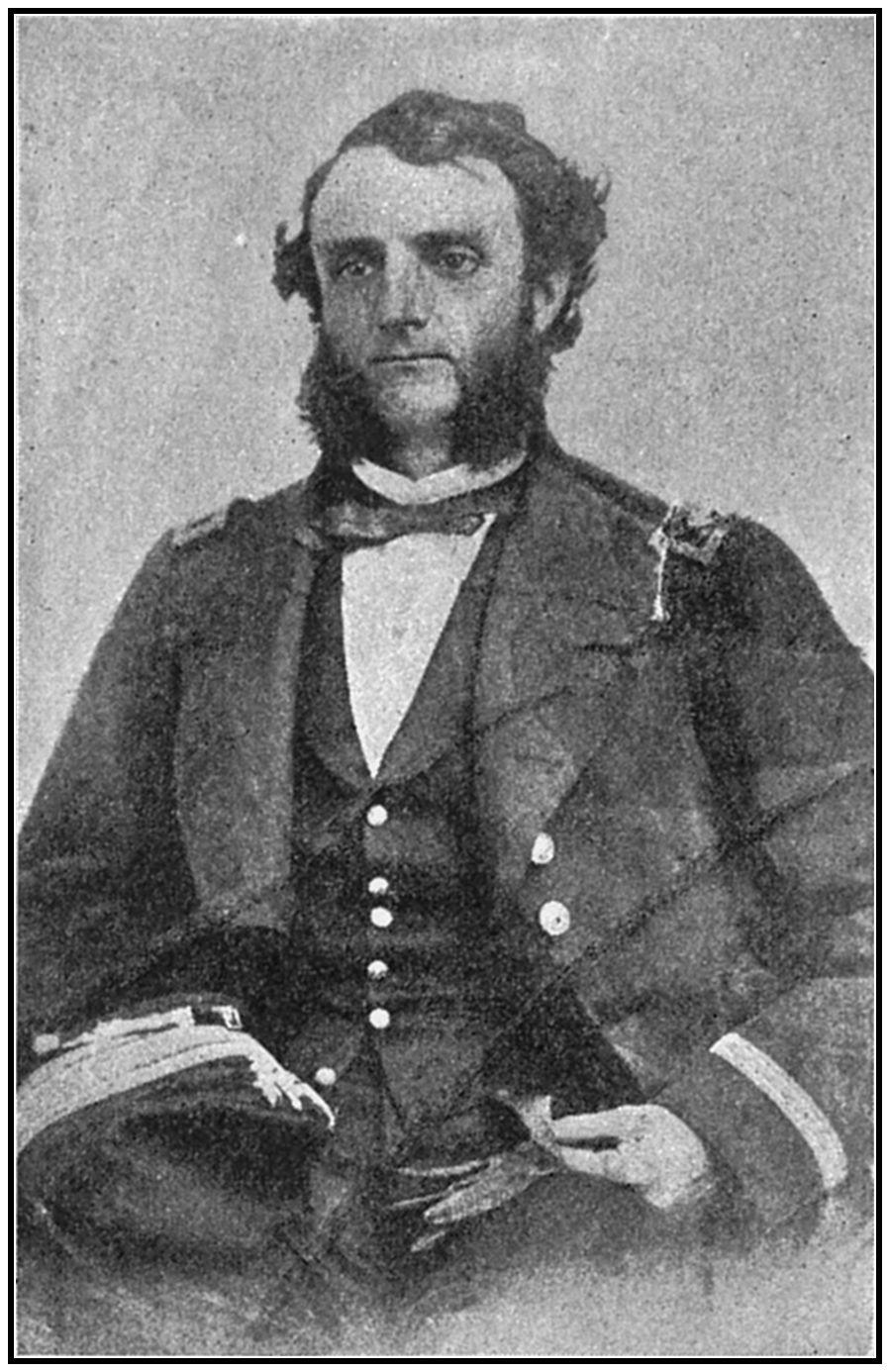
John G. Sproston.
(Who commanded one of the boats in the attack on the Judah.)
From a photograph at the Naval Academy, Annapolis.
So Commodore William Marvine, commanding the Gulf squadron, sent 100 men in boats under Lieut. J. H. Russell, on the night of September 13, 1861, to destroy her. In spite of the vigilance of the Confederates, they arrived near the schooner undiscovered, and were entirely successful121 in firing her, in spite of a determined opposition.
Meantime a wave of trouble had rolled over Galveston, Texas—a wave that stirred the foreign consuls living there into an astonishing state of anger, and through their efforts it was used with some effect to misrepresent and prejudice the case of the government throughout Europe. The affair occurred on August 3, 1861. Galveston was first blockaded by the South Carolina, Capt. James Alden, in the latter part of June. Captain Alden “never had any intention of troubling” the people of the city further than interrupting their ocean trade, and this determination was stated to them in an official communication. Nevertheless, the Confederates erected a number of batteries in a place where any attack on them by the blockading squadron would necessarily result in throwing projectiles into the city. A glance at the map will show that Galveston is built on the northerly point of an island that forms the harbor. The city faces the bay, and there is a wide stretch of sand behind the city—that is, between the city and the sea. It was between the city and the sea that the batteries were placed.
On the morning of August 3d a tender of the blockading ship was returning north from a cruise to the south end of Galveston Island.122 She passed within range of the batteries, and they opened fire on her. She returned the fire and reported it to Captain Alden, who “waited all day for some explanation or disavowal on the part of the authorities.” He could scarcely realize that people “could be so insane as to initiate hostilities when their town was so completely at our mercy.” At 4 o’clock no disavowal having come, he took the South Carolina within a mile of the works. The Confederates opened fire on her and Alden replied with fifteen shots, after which,123 finding that he could not prevent the shot going into the city as well as the works, he withdrew.
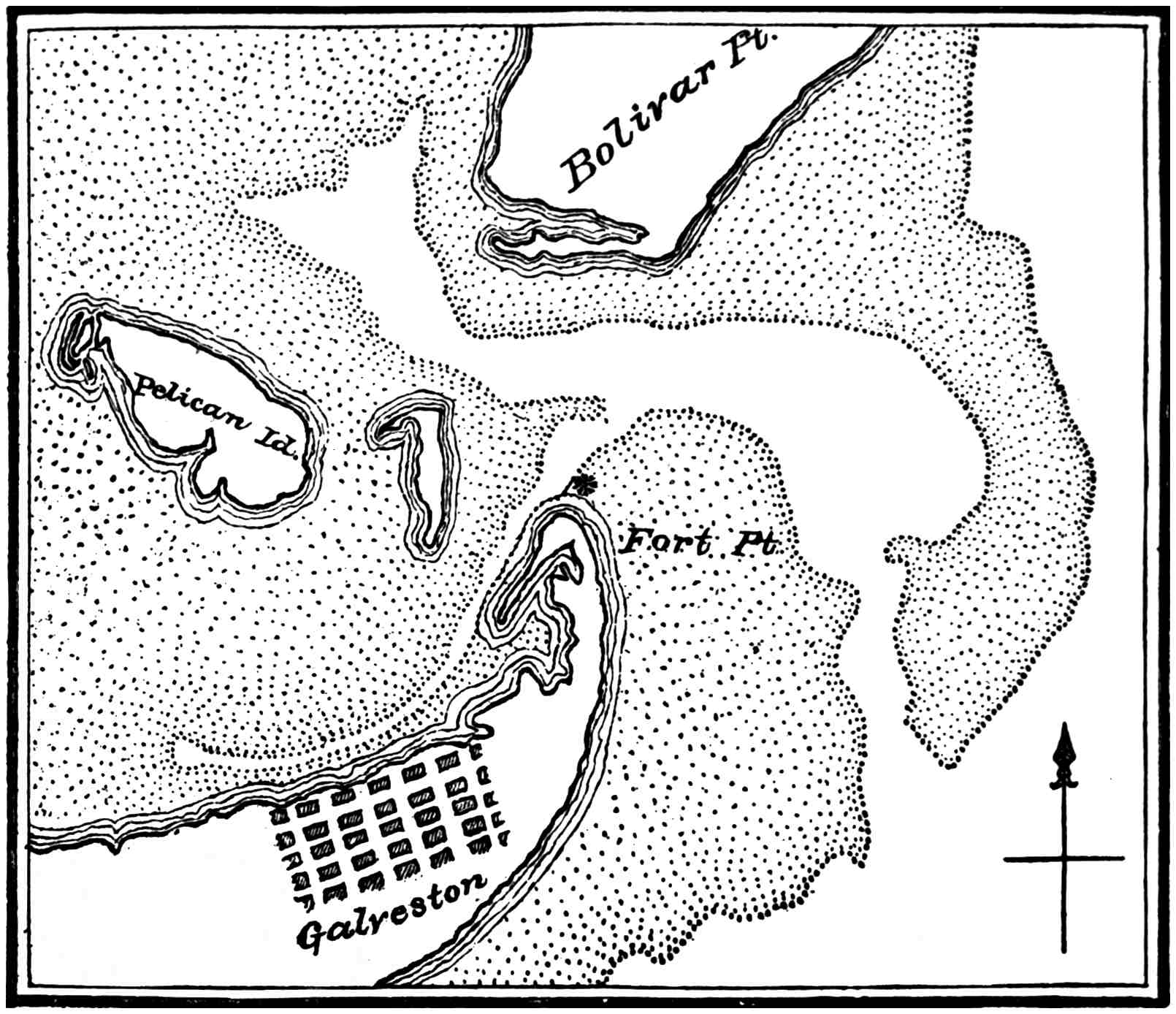
Galveston Harbor.
From “The Navy in the Civil War.”
The next day Mr. Arthur Lynn, the British consul, gathered together the Hanoverian and Oldenburg consul, the Swiss consul, the Mexican consul; the deputy consul for Bremen, Saxony, Belgium, and Holland; the consul pro tem. for Electoral Hesse, and the consul for Nassau, besides representatives of some other countries, and wrote and signed the following:
“The undersigned, consuls and vice-consuls at Galveston, consider it their duty to enter their solemn protest against your bombardment of this city on the evening of the 3d instant, without having given any notice, so that the women and children might have been removed, and also against your firing a shell in the midst of a large crowd of unarmed citizens, amongst whom were many women and children, causing thereby the death of an unoffending Portuguese and wounding boys and peaceably disposed persons, as acts of inhumanity, unrecognized in modern warfare, and meriting the condemnation of Christian and civilized nations.”
A copy of the protest was sent to Alden, another to the reporters, of course, and then each official sent one under seal to his government124 in such fashion that it would appear in the papers there also.
It was a small affair in itself. The Confederate authorities made no protest about it. So far as the attack on the blockading squadron and the return of the fire were of interest from a historical point of view, the matter was not worth mention. But because this was the first case in which a British consul, acting in his official capacity, undertook the work of misrepresenting the deeds of the government officers, it may not be omitted. For the official attitude of the European governments has a very important part in the naval history of the Civil War.
The next event of interest that occurred in the Gulf region might very well be termed the battle of Bull Run afloat, because a squadron of American naval ships became involved in a panic and fled precipitately before a force so utterly insignificant that the shame of it was felt by every man who wore the uniform.
The mouths of the Mississippi were at first blockaded by the Brooklyn, Captain Poor, and the Powhatan, Capt. D. D. Porter, but when the Powhatan was away, one day, the Brooklyn went chasing a strange sail, and the watchful Semmes carried the Sumter, the first of the noted Confederate cruisers, out to sea. As the Confederates had before this carried125 fifteen ships, two barks, and three schooners from the Gulf to New Orleans as prizes, the government was moved to place a sufficient force in the river to close it absolutely.
This force included the flagship Richmond, a screw steamer of 2,000 tons, carrying twenty large guns, Capt. John Pope; the sailing sloop-of-war Vincennes, ten guns, Capt. Robert Handy; the sailing sloop-of-war Preble, eleven guns, Capt. H. French, and the little screw steamer Water Witch, of four guns (howitzers). In all, there were forty-five guns in the squadron, of which twenty were nine-inch Dahlgrens.
As the reader will remember, a chart of the mouth of the Mississippi is marvellously like a picture of the roots of a crooked tree. The waters divide into three main channels, with a host of offshoots. To effectually close all the entrances to the river it was necessary only to anchor the squadron in the river itself above the point where it was split up, and this was done. There were no Confederate forts near the anchorage, and the officers and men, so far as is known, possessed their souls in peace until the month of October.
Meantime the Confederates had been working against very great difficulties to prepare a squadron fit to clear the river. They had incidentally striven to get a steamer called the McRae in commission for a cruiser, but had127 failed in making her machinery work well, and she was relegated to the work of harbor defence.
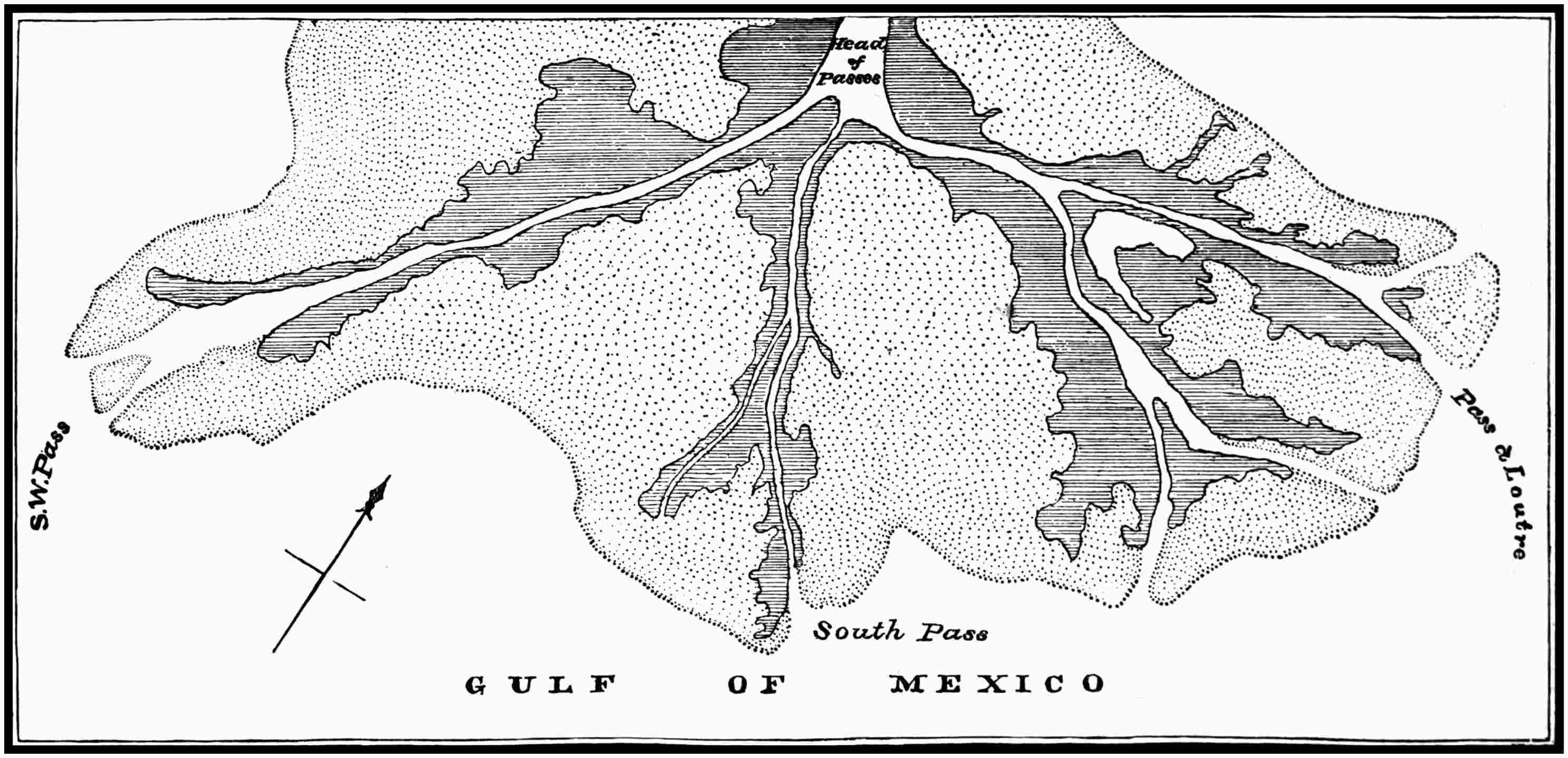
Passes of the Mississippi.
From “The Navy in the Civil War.”
The work of shipbuilding was done under the eyes of a commission that included Capt. L. Rousseau, Commander E. Farrand, and Lieut. Robert J. Chapman, of the Confederate navy, all of whom had been reared in the government navy. Capt. George N. Hollins, formerly of the American navy, was assigned to command the fleet when built.
By the first of October, four river steamers had been converted into the semblance of gunboats by adding timbers so that they could carry eight or nine guns. They were called the Polk, the Ivy, the Livingston, and the Maurepas. A merchant steamer with a bark rig became the McRae. To this was added a most remarkable vessel—the first of her class, the ironclad ram Manassas.
The Manassas was originally the double-screw tug Enoch Train, of Boston. She was 128 feet long, twenty-six wide, and when loaded she drew thirteen feet of water. She was, in short, a tug of the first class in size. Capt. John A. Stevenson, of New Orleans, undertook the contract of making a ram of this vessel for a company of capitalists who determined to use her, privateer-fashion, against the government blockaders immediately after128 the Confederate Congress enacted a law on May 21, 1861, binding the Confederate treasury to pay to the destroyers twenty per cent. of the value of any government ships that might be destroyed by volunteers.
The tug was cut down almost to the water, first of all, and then her bow was filled in solid with timbers for a space of twenty feet abaft the stem. A deck in the shape of half of a long, sharp egg was built over her, twelve-inch oak timbers being used for the purpose. Of course, all the woodwork was thoroughly bolted. Then the bow and the rounded deck were everywhere plated with flat bar-iron one and a half inches thick. There was one gun-port forward, where a sixty-eight-pounder was mounted, but for some fault of construction they were not able to use it at first.
For motive power she had one compound engine and two screws, the high-pressure cylinder working one shaft and the low-pressure the other. There was but one hatch, a small one, at that, and through this everything—coal, supplies, men—must pass. A ship like that, no matter what her power, could never be popular in any navy in time of peace, but she was built for an emergency, and there was no trouble in finding a crew. Lieut. Alexander F. Warley, formerly in the government service, took command of her for her owners.
129
From time to time the government officers on the blockaders down at the head of the passes heard about the work in the New Orleans ship-yards. They learned some of the details of the ram that was building, as well as of the gunboat, but they not only did not make any preparations for meeting or guarding against an attack: they did not even consider what might be done if the Confederates should come.
At 3.30 o’clock on the morning of October 13, 1861, the government fleet lay quietly at anchor, save that the schooner Joseph H. Toone was alongside the Richmond, and the Richmond’s watch on deck were taking coal out of her. The Preble was in advance—that is, was further up the river than any. Below her lay the flagship Richmond, and below her the Vincennes, while the Water Witch lay between the Richmond and the east shore, with a little prize schooner, the Frolic, near by. It was a moonlight night, with some clouds flying, the worst kind of a night, as all seamen know, for seeing anything clearly, but there had been no especial care in posting or warning lookouts. It was with the squadron literally “the careless end of night.” Within ten minutes after the bell struck the hour of 3.30, a lookout on the Preble saw a dark object driving down the river, but without any smoke or130 steam or other appearance of motive power. At nearly the same moment the lookout on the prize schooner saw it, and as the alarm was raised on the Preble the schooner lookout bawled to Richmond: “A rebel steamer is coming down the river.”
In a minute the whole squadron awoke, and with rattle and shout the crews ran to quarters, but before they could get a gun cast loose, the dark object afloat, the ram Manassas, driving with the aid of the current at about nine miles an hour, glanced across the coal schooner’s bow, crashed through a cutter, and struck the Richmond “abreast of the port forechannels, tearing the schooner from her fasts.” “Three planks on the ship’s side were stove in, about two feet below the water-line, making a hole about five inches in circumference.” These quotations are from Pope’s official report, but the report did not use italics.
Immediately “a red light was shown as a signal of danger,” and then the whole squadron except the Water Witch slipped their cables and fled. “I ordered the Preble and Vincennes to proceed down the Southwest Pass,” says Pope, and “they did.” Meantime, “after the first blow given to this ship by the ram,” it “remained under our port quarter, apparently endeavoring to fix herself in a position to give us a second blow, but the slipping131 of our chain and the ship ranging ahead under steam frustrated the object.” That was Pope’s idea. The fact was that the ram’s machinery had not been properly stayed to sustain a shock, and the blow had entirely crippled the low-pressure engine, and left her with barely enough power to stem the current. She lay there making repairs, with her crew in a state of alarm lest she be disabled altogether. However, they got the high-pressure engine working independently, and then, to the great relief of her crew, she went creeping and coughing up the river, hugging the shoal water lest the Richmond or Water Witch pursue her after she had passed them. Both the Richmond and the Preble fired broadsides at her; the Richmond fired three, “with what effect it was impossible to discover owing to the darkness,” but “some officers are of opinion they heard shot strike the ram.” As the ram disappeared up the river, the Richmond’s “helm was put up, and the ship rapidly fell off, presenting her broadside up and down the river.” In that position they let her drift with the current to “cover the retreat” of the squadron.
A squadron of four great ships, armed with forty-five first-class guns, had been driven into a shameful panic by one crippled tug carrying a gun that couldn’t be fired.
At about this time a rocket was thrown up132 from the ram, and at once three lights were seen—“three large fire rafts, stretching across the river, were rapidly nearing us, while several large steamers and a bark-rigged propeller were seen astern of them.” In the minds of the flying officers the peril was frightful. Nevertheless, as the Richmond “drifted near the Passes ineffectual attempts were made to get her head upstream.” The attempts did not include the dropping of an anchor, because that would have stopped her in her flight for the sea. Pope was willing to head upstream provided he could keep travelling away from the fearsome ram and fire-rafts “stretching across the river.” When the “ineffectual attempts” were stopped “I found myself a mile and a half down the Southwest Pass.” “I then put the helm up, and continued down the river, hoping to be able to get her head around off Pilot Town. In doing this she drifted some distance below, grounding broadside on.”
Meantime the Vincennes and the Preble had been “drifting” also, and without making any attempts to get their bows pointed upstream. They were under sail, and the wind was in the north. The Preble outran the Richmond, even. Captain French says that as he passed the Richmond Captain Pope told him to “proceed down the pass.” He obeyed, and after bumping on the bar two or three times, crossed133 over into water unfretted by rams and fire-rafts. So he “anchored near the coal ships Kuhn and Nightingale to protect them if necessary.”
Meantime the Vincennes, like the Richmond, had grounded in the pass, and a little later along came the Water Witch. She had found, as she steamed down the pass, “that the fire rafts were drifting with the wind steadily over toward the western shore,” so the “Water Witch was now steered to the northward and eastward (upstream) and easily cleared them.” The river at this “time in the vicinity of the passes was entirely clear of the enemy.” Nevertheless, a “general signal, ‘cross the bar,’” was displayed on the Richmond.
The effect of this signal on Captain Handy of the Vincennes is well-nigh past belief. He read it “abandon the ship,” he says, but he was not quite sure about the reading, and so sent a boat to the Water Witch to ask how Captain Winslow read it. Captain Winslow replied “that it was impossible” an order to abandon the ship had been given. Captain Handy was of his original opinion still, and at once ordered the boats away. A slow match was set to the magazine, and then, as the crew started over the side of the ship, Captain Handy wrapped the ship’s flag about him in broad folds and climbed down the ladder to his gig.
134
Fortunately, a quarter-gunner (whose name has not been preserved, alas!) slipped down below, and cutting off the burning end of the slow match, tossed it overboard. Two of the boats went to the Water Witch, but the others, including the gig, to the Richmond. Here Handy’s theatrical air left him. The utter disgust of his crew became manifest after it was told that the slow match had been cut, and Handy was sent back crestfallen to his ship. But, though crestfallen, he was as nerveless as ever.
Of course daylight had come long before the time the two ships had grounded, and the Confederates, who had followed their fire-rafts with the bark-rigged McRae and the four converted gunboats and a river tug, found, to their astonishment, the whole river clear. They had hoped, at first, to make some disturbance—possibly to sink the Richmond with the ram—and, at any rate, get the McRae to sea. But the McRae’s engines had failed, and so had the ram’s, while the fire-rafts had drifted ashore harmless. And yet there were the government ships out at sea, or aground inside and sorry they couldn’t get away. Very naturally the Confederates came down where their long-range Whitworth rifles would take effect, and opened fire on the grounded ships. The only damage done was when a shell lodged in135 the locker where Captain Pope kept his linen. Fortunately, the shell did not explode, and the linen was not wholly destroyed. The Richmond replied with a nine-inch gun on her forecastle, and the Confederates, having boats so frail that one shell could have sunk any one of them, were obliged to keep at long range. The Water Witch was sent in great haste to bring the South Carolina from Barrataria, and after she came to the rescue the transport McClellan also arrived with rifles for the Richmond. “My mind was very much relieved, knowing that the armament of four rifled guns on board the McClellan, together with the long gun of the South Carolina, would keep the enemy at bay,” says Pope in his report. Imagine the state of mind of this officer! “Four rifled guns on board the McClellan, together with the long gun of the South Carolina, would keep the enemy at bay!”
But before the relief ships arrived, Captain Handy, of the Vincennes, had once more become so nervous he couldn’t stand the strain without doing something. The Confederates were firing at the Richmond; but they might fire at him and he might get hurt. So he wrote a note to the already overwrought Pope. Because no other case of the kind is known to the annals of the American navy, because the exhibit forms an interesting study136 in mental phenomena, and because the shame of it, when spread in history, must serve to make a repetition of the story impossible, the note shall be given in full:
“Sir: We are aground. We have only two guns that will bear in the direction of the enemy. Shall I remain on board after the moon goes down, with my crippled ship and worn-out men? Will you send me word what countersign my boats shall use if we pass near your ship? While we have moonlight, would it not be better to leave the ship? Shall I burn her when I leave her?
“Respectfully,
Robert Handy.”
He was not allowed to abandon his ship again, but it is a fact, incredible as it may seem, that even after the South Carolina had come—the South Carolina that, single-handed, was of a force to have destroyed, with one watch in their hammocks, the whole Confederate squadron—even after she had come, Handy, in his haste to get clear, threw overboard all of his guns, and it was done by permission of Pope. So the Vincennes got away in tow of the steamers.
On the 14th they were all at anchor outside, but even here, according to Captain Pope’s report, Captain French, of the Preble, did not feel safe. He was ordered to blockade137 Pass à Loutre, but, after starting, came back and asked permission to go to Ship Island for wood for the galley fire. Pope told him there was wood a-plenty at the Northeast Pass, but he “earnestly requested to go to Ship Island,” and Pope “reluctantly consented.” At Ship Island the Preble would be safe, but there was no telling what might happen if she were caught all alone by a Confederate gunboat off Pass à Loutre.
And then, in his report, written on the 17th, Pope makes this statement: “My retreat down the pass, although painful to me, was to save the ships by preventing them being sunk and falling into the hands of the enemy; and it was evident to me they had us in their power.”
This one other quotation will complete the story: “It having been rumored there was a panic on board this ship at the time she was engaged with the enemy, I state it to be false; both officers and men exhibited the utmost coolness and determination to do their duty.”
This chapter shall conclude with the brief story of brave men at Galveston.
It was in November. The frigate Santee was blockading Galveston, and a Confederate steamer, the General Rusk, was inside, together with a privateer schooner called the Royal Yacht. The Confederates were fitting the138 Rusk for a cruiser, but she could not be shelled without throwing shot into the city. So Lieut. James E. Jouett volunteered to go in and cut her out.
One has to look at the chart of the harbor to appreciate the danger of the service, for the boats would have to pull around the north end of the island, on which the city stands, and then along the water front of the city itself, to reach the ship. Nevertheless, Jouett, with forty men in two boats, started at 11.40 o’clock on the night of November 7, 1861. Everything went well while passing the sentinels on the point, and those on the Royal Yacht that lay near the point, also. But in keeping well to the off side of the channel when approaching the city the leading boat grounded, and the second crashed into her. The noise of the collision and the efforts to get afloat betrayed them, and fire was opened from the land and the Rusk. There was nothing for it but to retreat. The forty men could do nothing against the forces of the Confederates, now that they were alarmed. But Jouett was not to be balked altogether, and turning about, he dashed at the Royal Yacht. The first boat to reach her had a twelve-pound howitzer in its bow, with Gunner William W. Carter in charge. Aiming at her water-line Carter fired just as the boat’s bow was within139 jumping distance of the schooner, and as the shell crashed through the schooner’s side he leaped to her deck. Unfortunately, the recoil of the howitzer drove the boat away from the schooner, leaving Carter, with cutlass in hand, alone to face the enemy. But Carter was the man for the place, and at them he went, slash and parry and thrust, while Jouett slewed the boat up once more to the schooner’s rail and leaped on board. But the moment he landed there a Confederate thrust a bayonet through his arm and into his lung. It was a dangerous wound, but Jouett cut the man down and hewed his way to Carter’s side.
Even then the fight was not won. Twice the Confederates rallied and drove the Federals back, but Jouett led on again, gained the victory at last, and destroyed the schooner. The Federals lost three killed and six wounded. They carried off thirteen prisoners, but the Confederate loss in killed and wounded is not recorded. And it is worth adding that Jouett is to be heard from further on.
140
CAPT. CHARLES WILKES, OF THE AMERICAN NAVY, TOOK FOUR CONFEDERATE DIPLOMATIC AGENTS FROM A BRITISH SHIP BOUND ON A REGULAR VOYAGE BETWEEN NEUTRAL PARTS, AND WITHOUT ANY JUDICIAL PROCEEDING CAST THEM INTO A MILITARY PRISON—A CASE THAT CREATED GREAT EXCITEMENT THROUGHOUT THE CIVILIZED WORLD—A SWIFT DEMAND, WITH A THREAT OF WAR ADDED, MADE BY THE BRITISH—COMPARING THIS CASE WITH ANOTHER OF LIKE NATURE—THE UNITED STATES ONCE WENT TO WAR TO ESTABLISH THE PRINCIPLE WHICH CAPTAIN WILKES IGNORED—THE BRITISH OFFICIALLY ACKNOWLEDGE THAT THE AMERICANS WERE JUSTIFIED IN DECLARING WAR IN 1812.
This is to tell the story of what is known, in the history of the Civil War, as the Trent affair. And it is worth saying in advance that few, if any, events that have occurred on the high seas are of more interest to the American patriot than this. For not only did it involve the capture and subsequent release of two very important enemies of the American government in time of war; it settled forever in our favor the troublesome question that drove the American people into the War of 1812. There was, indeed, what may rightly be called an official declaration, on the part of141 the Prime Minister of Great Britain, that the United States was entirely justified in that war.
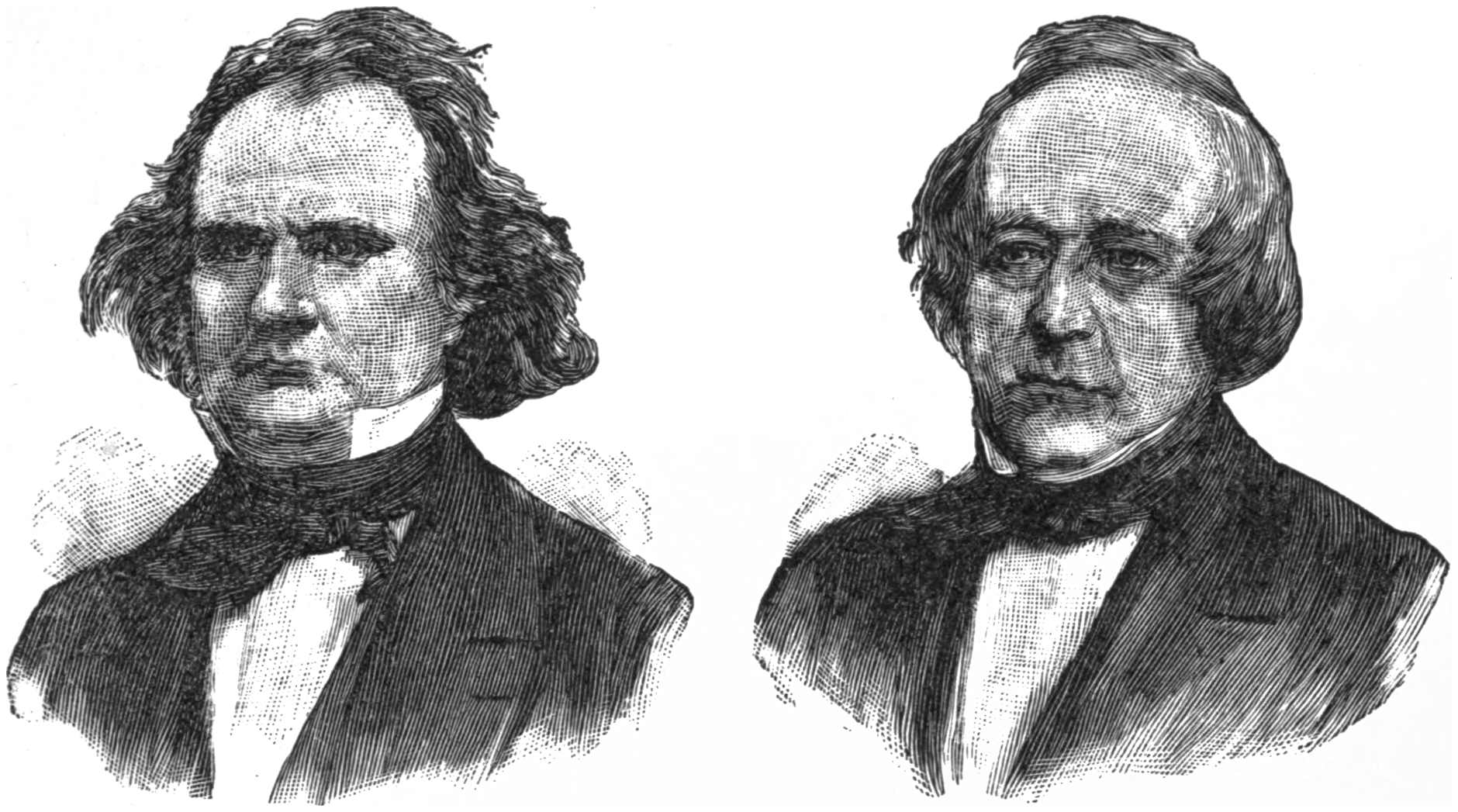
James Murray Mason. John Slidell.
The two captured commissioners.
On the 12th of October, 1861, Mr. James Mason, of Virginia, and Mr. John Slidell, of Louisiana, with two other gentlemen, acting as their secretaries, sailed from Charleston in the blockade-runner Theodora, and, “unimpeded by the blockading ships,” arrived at Cardenas, Cuba, whence they proceeded to Havana. Mr. Mason had, in former years, been chairman of the Senate Committee on Foreign Affairs and American Minister in Paris. Mr. Slidell had represented the United States at the capital of Mexico. These two gentlemen had been chosen by the Confederates142 to go to Europe as special representatives—Mr. Mason to England and Mr. Slidell to Paris—to secure, if possible, the recognition of the Confederate States as a nation. It is important to note that these special envoys were sent because three others previously sent had failed. “Lord Russell had received them (the three) on the footing of private gentlemen and listened to what they had to say, but had avoided correspondence, and remained immovable in his refusal to enter into any official communication. At the French court they had been equally unsuccessful,” and the Confederates hoped that Messrs. Mason and Slidell would do better.
On the day that these Confederate envoys arrived in Havana the United States cruiser San Jacinto, Capt. Charles Wilkes, was at Cienfuegos, on the south side of Cuba, looking for the Confederate cruiser Sumter—Wilkes, by the way, being the officer who conducted the celebrated Wilkes expedition to the southern seas, of which mention is made elsewhere.
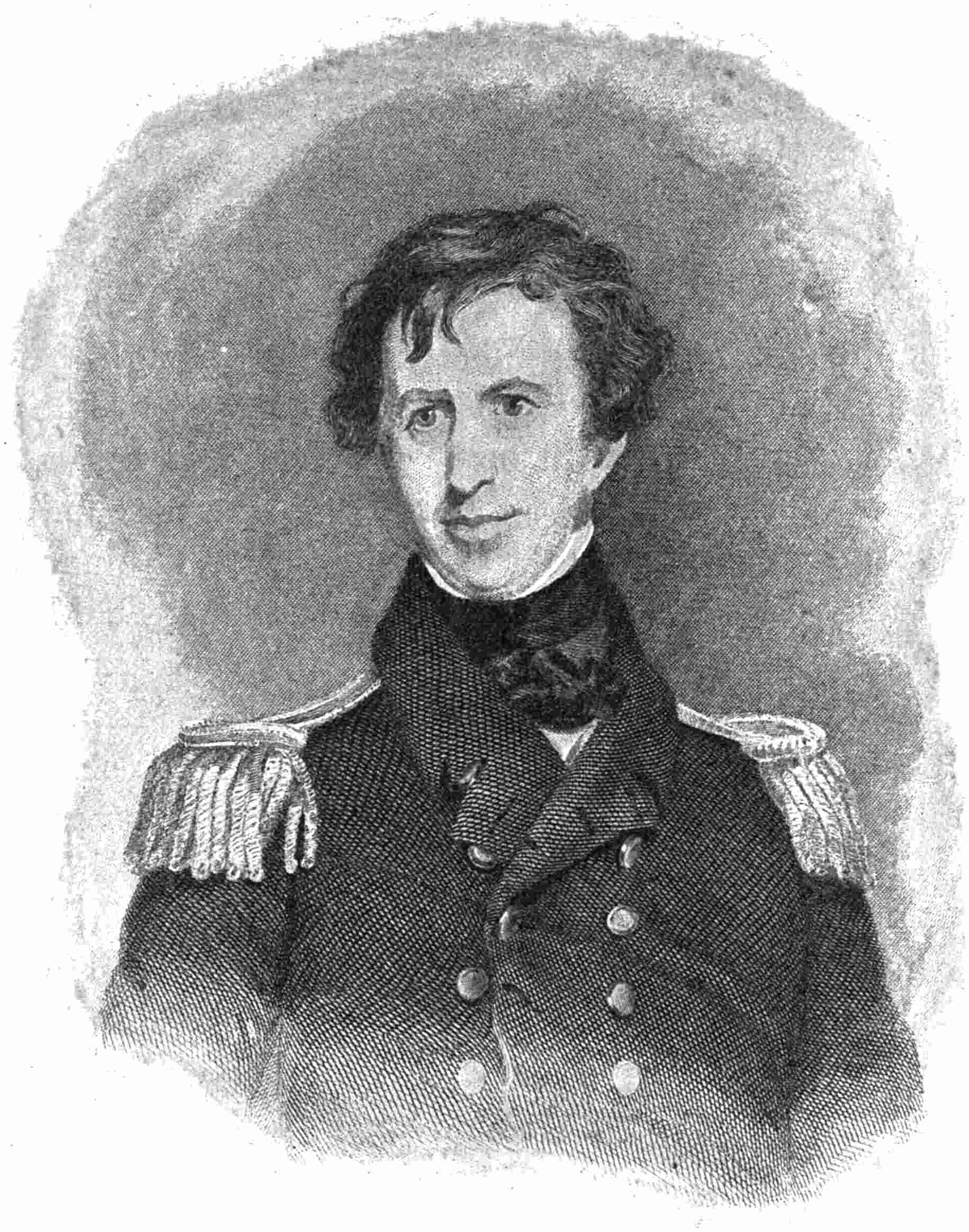
Charles Wilkes.
From an engraving by Dodson of the portrait by Sully.
While at Cienfuegos, Wilkes heard of the arrival of the Theodora on the north coast, and made haste ineffectually to reach Havana to intercept her. But while he failed to catch the Theodora he learned at Havana that the Confederate envoys were to sail in the Royal143 mail line steamer Trent for the island of St. Thomas, where, in the regular course of the line’s business, they would be transferred to a144 steamer bound to England. Having failed to learn when the Trent would sail—failed because of “the notorious action of her British Majesty’s subjects in doing everything to aid and abet the escape of these four persons”—Wilkes went to “where the old Bahama Channel contracts to the width of fifteen miles, some 240 miles from Havana, and in sight of the Paredon del Grande lighthouse.” The Trent must pass through that neck of water, and “at 11.40 on the 8th her smoke was seen.” “We were all prepared for her, beat to quarters, and orders were given to Lieut. D. M. Fairfax to have two boats manned and armed to board her and make Messrs. Slidell, Mason, Eustis, and McFarland prisoners, and send them on board.” Eustis and McFarland were the secretaries. “The steamer approached and hoisted English colors, our ensign was hoisted, and a shot was fired across her bow; she maintained her speed and showed no disposition to heave to; then a shell was fired across her bow, which brought her to. I hailed that I intended to send a boat on board, and Lieutenant Fairfax, with the second cutter of this ship, was despatched.” The quotations are from official reports.
On arriving beside the Trent, Fairfax went on board alone, “leaving two officers in the boat with orders to wait until it became necessary145 to show some force.” He met the captain on the quarter-deck and asked “to see the passenger list,” but “he declined letting me see it.” Fairfax then said he had learned that the Confederate envoys were on board, and should satisfy himself “whether they were on board before allowing the steamer to proceed.”
“Mr. Slidell, evidently hearing his name mentioned, came up to me and asked if I wanted to see him. Mr. Mason soon joined us, and then Mr. Eustis and Mr. McFarland, when I made known the object of my visit. The captain of the Trent opposed anything like the search of his vessel, nor would he consent to show papers or passenger list.” This is from the report of Lieutenant Fairfax, and it adds that “there was considerable noise among the passengers just about this time.” The fact is the passengers were, to a man, in ardent sympathy with the Confederates. “The passengers and ship’s officers were making all kinds of disagreeable and contemptuous noises and remarks.” “Did you ever hear of such an outrage?” and “Did you ever hear of such a piratical act?” were two of the expressions that were heard by the officers waiting in the boat. “Mr. Fairfax appeared to be having an altercation with some one,” and at last one waiting officer “heard some one call out, ‘Shoot him!’”
146
At this some armed marines were sent on board, and when they “advanced the passengers fell back.” The most insolent of all on board was a retired commander of the British navy, who was in charge of the mails. According to Lieut. James A. Greer, “the mail agent, (a man in the uniform of a commander in the royal navy, I think,) was very indignant and talkative, and tried several times to get me into discussion of the matter. I told him I was not there for that purpose. He was very bitter; he told me that the English squadron would raise the blockade in twenty days after his report of this outrage (I think he said outrage) got home; that the northerners might as well give up now,” etc., etc. The Confederate envoys, in their letter to Captain Wilkes, say that “it must be added here, omitted in the course of the narration, that before the party left the upper deck an officer of the Trent, named Williams, in the naval uniform of Great Britain, and known to the passengers as having charge of the mails and accompanying them to England, said to the lieutenant that, as the only person present directly representing his government, he felt called upon, in language as strong and as emphatic as he could express, to denounce the whole proceeding as a piratical act.”
Further than that, “nearly all the officers147 of the vessel showed an undisguised hatred for the northern people, and a sympathy for the Confederates. I will do the captain of the vessel the justice to say that he acted differently from the rest, being, when I saw him, very reserved and dignified. The officers and men of our party took no apparent notice of the remarks that were made, and acted with the greatest forbearance.”
However, in spite of the bluster and the determination of the envoys to go only when compelled to do so by force, the four were taken on board the American warship. The force used was not violence, of course. “Three officers laid their hands on an envoy, after which the envoy walked down a ladder to the boat.” It is conceded on all hands that Lieutenant Fairfax and his men acted in a manner entirely becoming to gentlemen of the navy.
Having taken the Confederate envoys, Captain Wilkes permitted the Trent to proceed on her voyage. He says:
“It was my determination to have taken possession of the Trent, and sent her to Key West as a prize, for resisting the search and carrying these passengers, whose character and objects were well known to the captain; but the reduced number of my officers and crew, and the large number of passengers on board, bound to Europe, who would be put to great148 inconvenience, decided me to allow them to proceed.”
It is worth noting, as illustrating the character of Wilkes and his officers, that they were absolutely certain that if they took the ship to Key West she would be sold as a good prize for a sum that would have given many thousand dollars to the San Jacinto’s crew. But for the sake of the convenience of the passengers, they allowed her to go on.
After the Trent started on her way to St. Thomas, the San Jacinto headed for Boston. “Why he did not go into New York or Hampton Roads, where he could have communicated with the Government, is unexplained, but the information of the capture was kept from the Department four days longer than it should have been.”
But when at last he did reach port, and the news of the capture was given to the reporters, the whole North went wild with joy, and the rest of the civilized world, and especially Great Britain, was stirred as rarely, if ever before, by the capture of an envoy. Even Secretary of the Navy Welles lost his head and officially wrote to Wilkes: “Your conduct in seizing these public enemies was marked by intelligence, ability, decision, and firmness, and has the emphatic approval of this department.” As for the people of Boston, it may be said that149 not in all the years since the War of 1812 had they made such demonstrations over a naval officer. Even Hull, with the Guerrière crew on board the Constitution, did not receive so much banqueting; and Congress passed enthusiastically a resolution requesting the President to give Wilkes a gold medal.
To the writer hereof it seems that the story of all this excitement is worth careful consideration, not so much because it was incited by the capture of two enemies of the flag, but because it was an expression of feeling against the British. For the capture of Mason and Slidell could not harm the Confederates greatly. There were other statesmen in the South to take their place. But they had been taken from a British ship, and the people at the North then believed that the British government, while publicly professing friendship for their cause, was secretly doing everything possible to aid the South. The enthusiasm over Wilkes appears to have been in good part a protest against what was then called British hypocrisy and enmity for the North. So great was this enthusiasm, that for a man to openly express the opinion that a grave mistake had been made was to incur the most rabid denunciations—to be called a “copperhead” and a “traitor” and a “toady.”
Meantime the British were, as said, but little150 less excited than the Americans, though for quite a different reason. A British packet ship had been assaulted on the high seas while making her usual voyage between neutral ports, and the people—especially the seafaring people—wanted to know what their government was going to do about it. As a matter of fact, they did not have to wait long to learn.
“Richard Williams, Commander R.N., and Admiralty agent in charge of mails” on the Trent, made his report under date of November 9th, and this in due time reached Lord Russell, the British Prime Minister. A Cabinet meeting was called to consider the matter, and on November 30, 1861, Russell sent a despatch to Lord Lyons, the British Minister at Washington, of which the following are the important paragraphs:
“It thus appears that certain individuals have been forcibly taken from on board a British vessel, the ship of a neutral Power, while such vessel was pursuing a lawful and innocent voyage, an act of violence which was an affront to the British flag, and a violation of international law.
“Her Majesty’s Government, bearing in mind the friendly relations which have long subsisted between Great Britain and the United States, are willing to believe that the United States’ naval officer who committed this aggression151 was not acting in compliance with any authority from his Government, or that, if he conceived himself to be so authorized, he greatly misunderstood the instructions which he had received.
“For the Government of the United States must be fully aware that the British Government could not allow such an affront to the national honour to pass without full reparation, and Her Majesty’s Government are unwilling to believe that it could be the deliberate intention of the Government of the United States unnecessarily to force into discussion between the two Governments a question of so grave a character, and with regard to which the whole British nation would be sure to entertain such unanimity of feeling.”
In another letter of the same date Lord Russell added the following, setting a time limit with instructions in case the British demand was not allowed:
“In my previous despatch of this date I have instructed you, by command of Her Majesty, to make certain demands of the Government of the United States.
“Should Mr. Seward ask for delay in order that this grave and painful matter should be deliberately considered, you will consent to a delay not exceeding seven days. If, at the end of that time, no answer is given, or if any152 other answer is given except that of a compliance with the demands of Her Majesty’s Government, your Lordship is instructed to leave Washington with all the members of your Legation, bringing with you the archives of the Legation, and to repair immediately to London.”
These were the public official orders to Lord Lyons; but in order to set forth accurately the condition of affairs, it is necessary to quote from a letter of private instructions in which, as it now appears, Lord Russell, while determined to enforce the British demand for reparation, was anxious “to mitigate the effect of their peremptory demand.” He said:
“The despatches which were agreed to at the Cabinet yesterday, and which I have signed this morning, impose upon you a disagreeable task. My wish would be that at your first interview with Mr. Seward you should not take my despatch with you, but should prepare him for it, and ask him to settle with the President and the Cabinet what course they would propose.
“The next time you should bring my despatch and read it to him fully.
“If he asks what will be the consequence of his refusing compliance, I think you should say that you wish to leave him and the President quite free to take their own course, and153 that you desire to abstain from anything like menace.”
Although, as said, the patriotic Americans, as a whole, were greatly excited and incensed, there were many of them who did not share in these feelings, and among these were Secretary of State Seward. To set forth the reasons for this opposition to the opinions of their countrymen more forcibly, the following incident of the history of the Revolutionary War shall be told:
It appears that when that war was at its height “the colonial government despatched as ambassador to Holland, then a neutral power, Henry Laurens, a former President in the Congress of the country, vested with power to secure from that Government a recognition of the United Colonies as an independent nation—to conclude a treaty, and to negotiate a loan. In 1780 he left Charleston, on board the brigantine Adriana, bound to Martinique. From thence he took passage in a Dutch packet, the Mercury, for Holland, and thus was on board a neutral vessel, sailing between neutral ports.
“When three days out from Martinique, the Mercury was overhauled by the British frigate Vestal, Mr. Laurens, with his secretary, was forcibly removed from on board the Mercury; his papers were seized; they were taken in the Vestal to St. Johns, Newfoundland, and thence,154 by an order of the British admiralty, he, with his secretary, was taken to England, and he was committed, as a prisoner, to the Tower of London, on a charge of high treason. The British reverse at Yorktown soon changed the character of his confinement to that of a prisoner of war, and he was, not long thereafter, released, in exchange for Lieutenant-general Lord Cornwallis.”
The quotation is from Upton’s “Maritime Warfare and Prize.” No one familiar with this work will accuse Mr. Upton of lack of patriotism. The fact is that the case of Laurens, from a legal point of view, was precisely the case of Mason and Slidell. If the British were wrong in taking the American from a Dutch ship and treating him as a criminal in 1780, the Americans were wrong in taking the Confederate envoys from the British ship in 1861 and treating them as criminals.
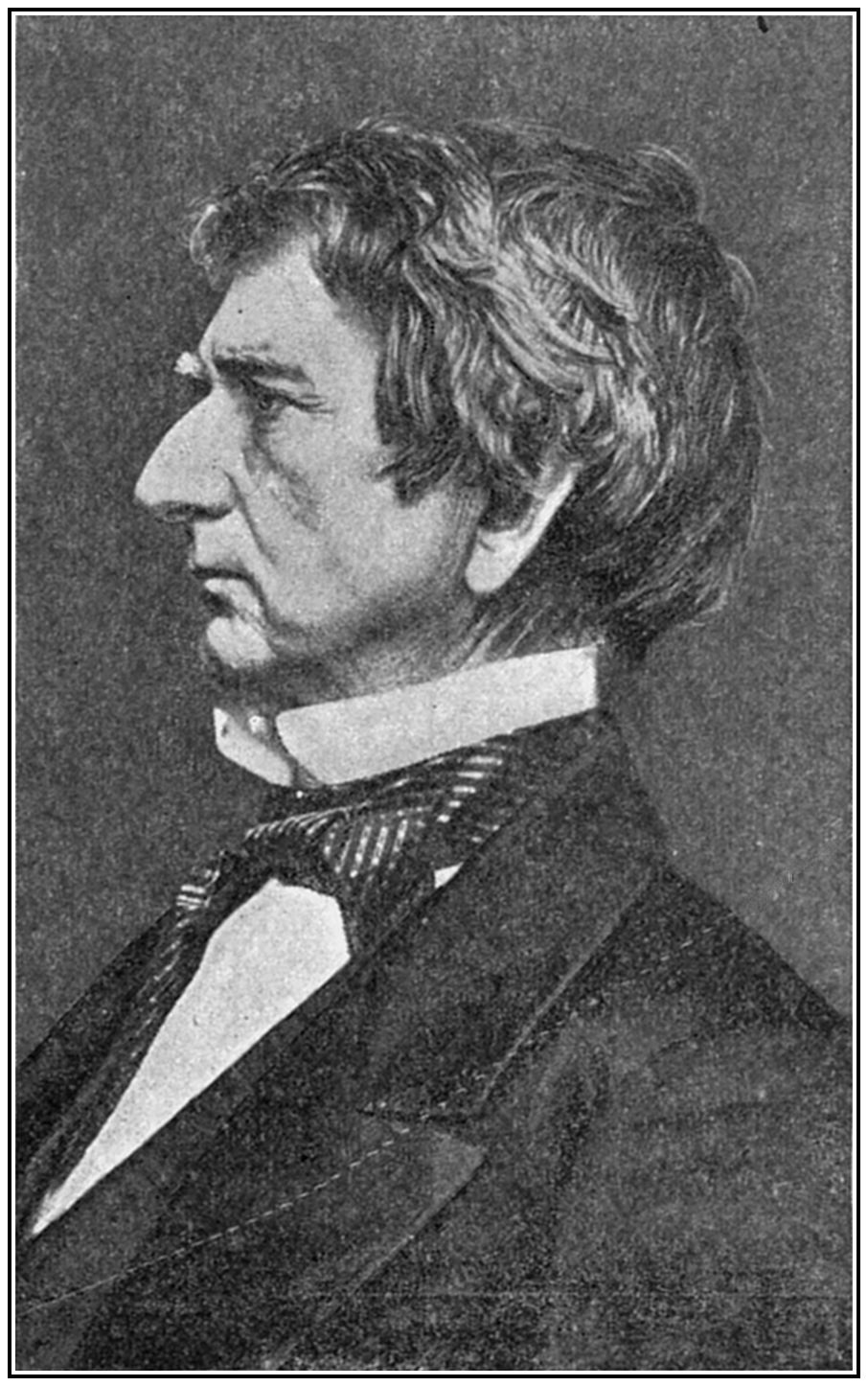
William H. Seward.
From a photograph.
But that is by no means the end of the story of the Trent affair. The demand of Great Britain was officially communicated to Secretary of State Seward on December 19th. On December 26th Mr. Seward delivered to Lord Lyons a reply reviewing the entire case. The important points of this reply are as follows:
The American government did not authorize the act of Captain Wilkes and knew nothing about it until Captain Wilkes arrived and155 reported it. Captain Wilkes believed that what he had done was “a simple legal and customary belligerent proceeding to arrest and capture a neutral vessel engaged in carrying contraband of war for the use and benefit of the insurgents.” The “four persons taken from the Trent by Captain Wilkes, and their despatches, were contraband of war.” If the envoys were contraband, Captain Wilkes had a right, under the law of nations, to capture the Trent, but the contraband “has a right to a fair trial of the accusation against him.” “The neutral state that has taken him under its flag is bound to protect him, if he is not contraband, and is therefore entitled to be satisfied upon that important question.” Both the accused and the neutral state have a right to demand “a tribunal and a trial.” In the Trent case there was neither tribunal nor trial. Captain Wilkes constituted himself captor,156 judge, and executioner. A very great wrong had been done. For this wrong “the British Government has a right to expect the same reparation that we, as an independent State, should expect from Great Britain or any other friendly nation in a similar case.” “The four persons in question are now held in military custody at Fort Warren in the State of Massachusetts. They will be cheerfully liberated.”
The comment of Commodore Joseph Smith on Seward’s letter sums it up admirably. In a letter to Flag Officer Foote he says, “It is ingenious, gassy, too long, but able.”
It is to be observed that the letter of Mr. Seward did not contain the word regret nor any form of apology. It stated the case and argued it, and admitted that an error—“simply an inadvertency,” on the part of a naval officer—had been made, and agreed to deliver up the prisoners. Whether the Secretary should have expressed regret when he admitted the wrong, the reader can judge for himself. What Lord Russell thought about this point is not told in the documents, but what he said was that “Her Majesty’s Government have arrived at the conclusion that they (the matters in Mr. Seward’s letter) constitute the reparation which Her Majesty and the British nation had a right to expect.”
Then, in another letter, he controverted157 Mr. Seward’s statements that the Confederate envoys made the Trent a good prize that might have been lawfully condemned. Of course no settlement of this question was reached, but whether Lord Russell or Mr. Seward was right, may be, perhaps, decided by the reader. At this writing there is trouble between Spain and the people of Cuba. If a Cuban agent escaped from Cuba to the United States and sailed from New York in an American liner for England, would the government of the United States permit a Spanish warship to carry the Yankee liner to Spain and there have her condemned as a prize? As this question must be answered in the negative, it is impossible to resist saying that in the Trent case the British government, instead of showing a spirit hostile toward the American government, was, in spite of the time limit, forbearing.
No direct reference to the British threat of war has been made so far, nor has the policy of adding to one’s enemies, when one is already full of trouble, been mentioned. It was a question of right and wrong. If, on sober second thought, the whole American people had concluded that they were right, or if it had been manifest that it was necessary for the life of the nation to keep those Confederates, no threat of war and no attack from any158 nation would have taken them from Fort Warren. It is an idle speculation; but most writers on this subject are sure that if Mason and Slidell had not been liberated the British would have declared war against us and so have set up the Confederate States as an independent government. But if the writer hereof may be allowed to express an opinion, he must say that, in spite of the seven days’ limit, England was not quite ready to declare war. And it is by no means certain that if she had done so, the combination would have resulted as predicted. For the people of the United States were not in their last ditch, nor were they friendless in the world.
If one other point in this controversy be considered, the patriotic American can look upon the Trent case with unmixed pleasure. From 1783 until 1861—for seventy-eight weary years the American government had vainly striven with all the arts of diplomacy, and even with the argument of open war, to get from Great Britain a disavowal of her assumed right to search a neutral ship in time of war and take from it any persons whom one of her naval officers might decide to be British subjects—a renunciation of what the Prince Regent (afterward George IV) proclaimed at the palace of Westminster, in 1813, as the “undoubted and hitherto undisputed right of159 searching merchant vessels in time of war, and the impressment of British seamen when found therein.”
It was, indeed, not a very lively strife in the later years of this period, for Great Britain had abstained from exercising her “undoubted and hitherto undisputed right” as against American ships. But on November 8, 1861, an American captain, being not well informed in the causes of America’s fights for life and liberty, undertook the very act that, when done by Great Britain, led to the War of 1812. He stopped a neutral ship on the high seas and took from her men whom he declared to be American citizens, and without any form of trial haled them away to a condition that was in law, if not in fact, exactly the condition of the impressed American seamen before the War of 1812. Great Britain had often taken advantage of such an act; she had in more than 6,000 cases, of which we have official knowledge, benefited by such doings on the part of her naval officers. But she had never suffered from such an aggression as that until November 8, 1861. There is no recorded act nor official utterance of the government of Great Britain during the first seventy-eight years of the existence of the United States that can be construed as a renunciation of the right of taking British subjects from neutral160 ships in time of war; but when an American naval captain took an American subject from a British ship the British Prime Minister, with swift indignation, declared it “an act of violence which was an affront to the British flag and a violation of international law.” And that was not all. “The British Government could not allow such an affront to the national honour to pass without full reparation.” Indeed, the affront was so great that the British Minister was to consent, for the purpose of consideration and negotiation, “to a delay not exceeding seven days.”
The outrages perpetrated on American seamen in the old days have never been avenged; but because the British were at last willing to acknowledge in the most emphatic of official documents that the United States waged a just war in 1812, they may be forgiven.
161
A FLEET OF SEVENTEEN SHIPS, CARRYING 155 GUNS, SENT TO TAKE A HARBOR THAT WOULD MAKE A CONVENIENT NAVAL STATION FOR THE ATLANTIC BLOCKADERS—THERE WERE TWO “EXCEEDINGLY WELL-BUILT EARTHWORKS” “RATHER HEAVILY ARMED” DEFENDING THE CHANNEL, BUT ONE PART OF THE SQUADRON ATTACKED THEM IN FRONT, ANOTHER ENFILADED THEM, AND IN LESS THAN FIVE HOURS THE CONFEDERATES FLED FOR LIFE—A HEAVY GALE WEATHERED WITH SMALL LOSS—INTERESTING INCIDENTS OF THE BATTLE.
Within a month after the chief Confederate ports on the Atlantic coast had been blockaded, the imperative need of a nearby naval station, where ships could lie in a harbor and make repairs and take on coal, was manifest. To run away north from Charleston and Savannah to Hampton Roads, every time coal was needed, was something that could not be tolerated. For, as the reader will remember, the majority of the steamers of those days could carry no more coal than would last them for a week or ten days under steam. And what was worse, the machinery was always going wrong, even though steam-pressures were so low that steam-chests were known to burst inward162 on the creation of a sudden vacuum. The capture of Hatteras Inlet, in a small measure supplied this want. Vessels drawing no more than thirteen feet of water could make a harbor there in any but the worst weather. But because the majority of the blockading ships drew much more than this, the government was compelled to provide a deeper port. Fortunately, “a harbor sufficient to contain the largest fleet in the world” lay right where it was needed. It was a little-known harbor, in those days, even among shipping merchants, for no great town overlooked its waters, and it was visited only by coasters. It lay within the State of South Carolina, about one-third of the distance from Savannah harbor to Charleston, and it was called very properly Port Royal. Although neglected entirely by commerce, it was really the best harbor on the Southern coast. The bar that guarded it lay well out at sea and had an ample depth of water over it. The channel between Hilton Head on the south and Bay Point on the north was a mile wide. Although “the land hereabouts is generally low, the trees are high,” and “a small grove of trees, which tower above all the other trees like a high-crowned hat,” marked the entrance to the harbor unmistakably, so that even a stranger could easily work his way in unless a gale prevailed.
163

S. F. Dupont.
From a photograph.
Accordingly, the government decided to take possession of Port Royal, and in October, 1861, began to gather a fleet of warships and transports at Hampton Roads for that purpose. On October 10th Flag Officer Samuel Francis Dupont hoisted his flag on the steam frigate Wabash, of which Capt. C. R. P. Rodgers was commander. The squadron under him included the Susquehanna, Capt. J. L. Lardner; Mohican, Capt. S. W. Godon; Seminole, Capt. John P. Gillis; Pocahontas, Capt. Percival Drayton; Pawnee, Capt. R. W. Wyman; Unadilla, Capt. N. Collins; Ottawa, Capt. T. H. Stevens; Pembina, Capt. J. P. Bankhead; Seneca, Capt. Daniel Ammen, and the Vandalia, Capt. F. L. Haggerty. All of these were regular warships, and the Vandalia was the only sailing ship in the squadron. In addition to these, there were six merchant steamers that had been purchased and armed for use as164 warships. The warships proper carried 125 guns, all told, of which seven were eleven-inch Dahlgrens, and seventy-nine were eight-inch or better—most of them being nine-inch. The converted merchantmen carried from two to eight thirty-two-pounders each, save one, the Isaac Smith, which carried a rifled thirty-pounder. A force of soldiers, 12,000 strong, under Gen. Thomas W. Sherman, was detailed to coöperate with the squadron, and transports were provided to carry them, while coal-laden schooners were gathered in order to keep the steamers in fuel.
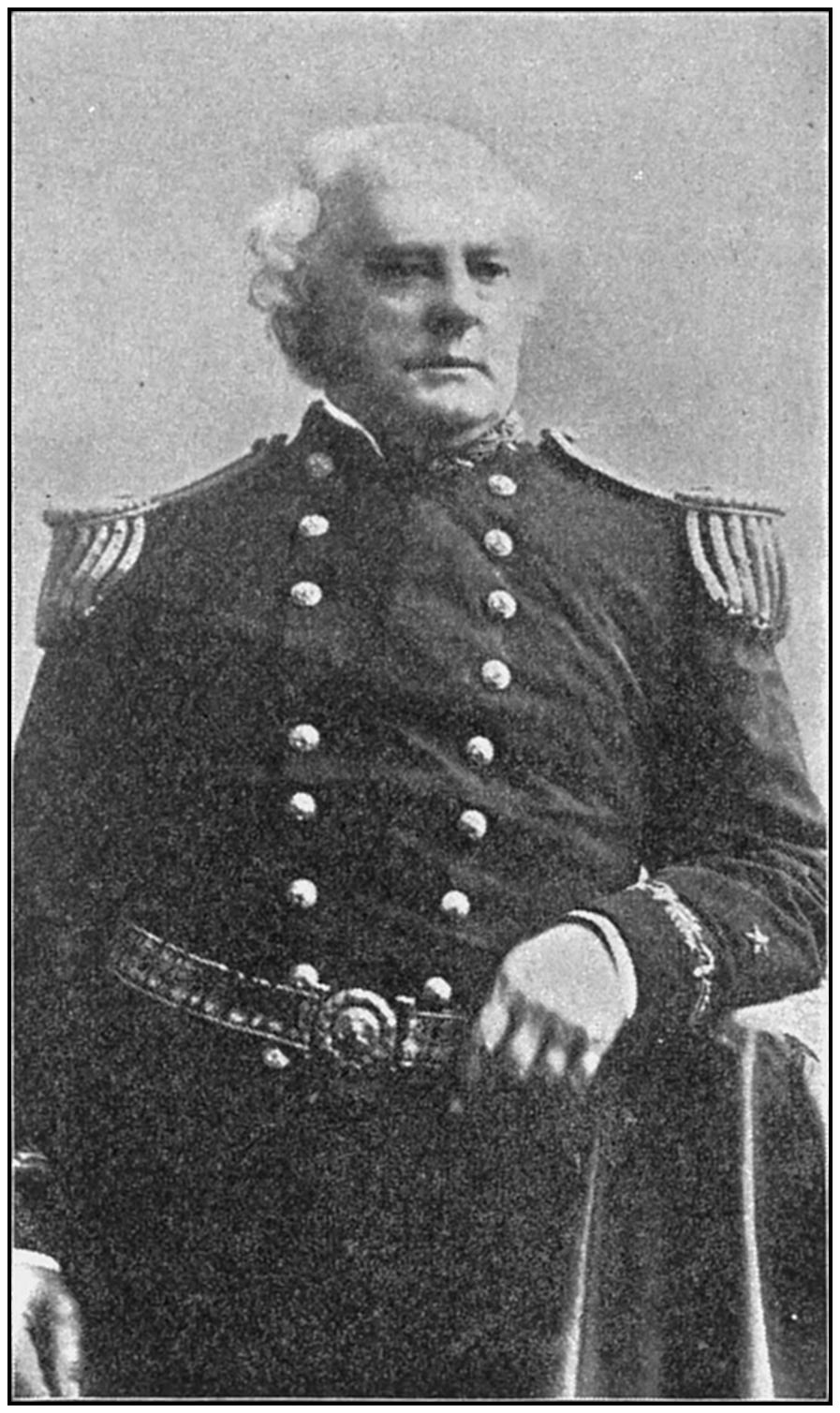
C. R. P. Rodgers.
From a photograph.
The older readers of this will remember very well the excitement occasioned throughout the nation by the gathering of this vast fleet at Hampton Roads. For the administration had determined to keep the destination of the expedition a secret, and it succeeded so well that165 the mystery remained until after the fleet was gone.
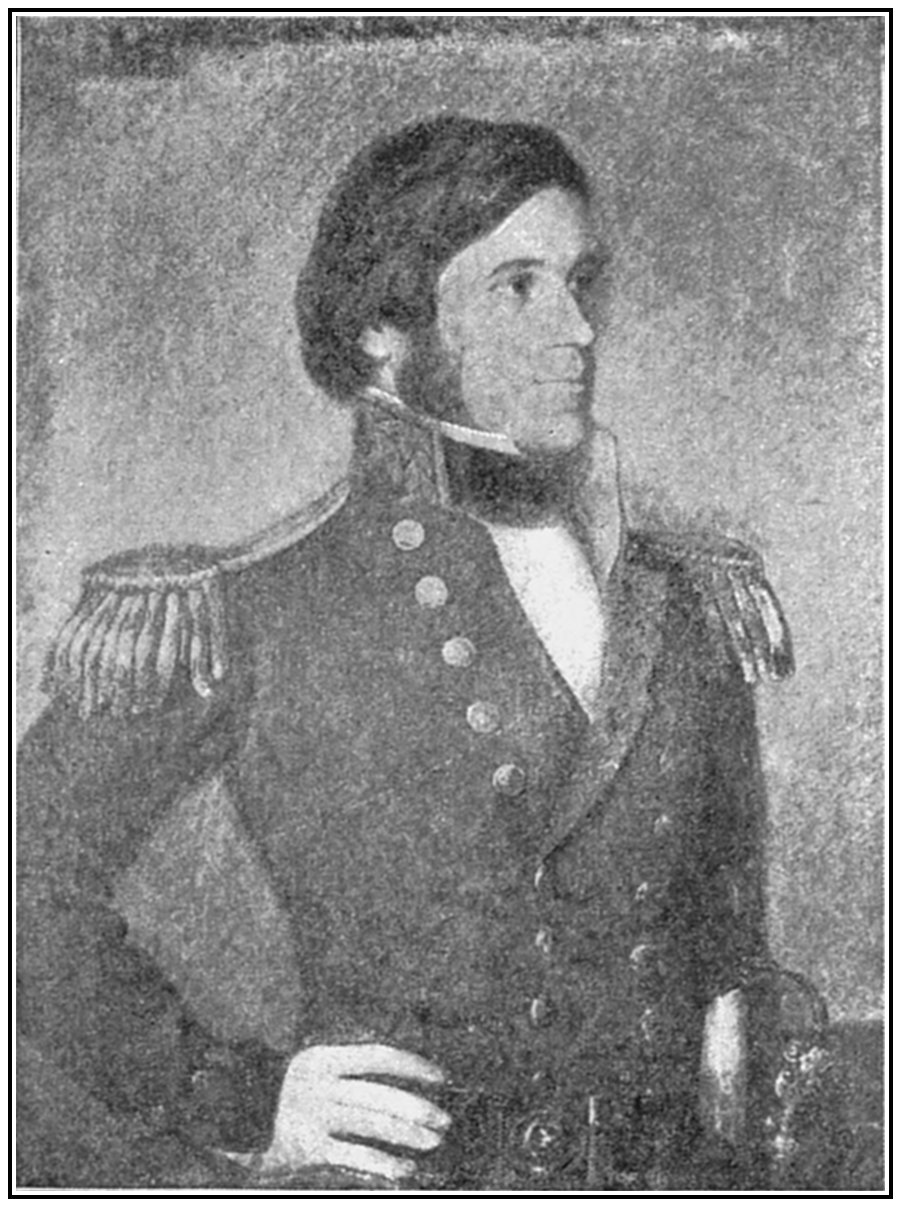
S. W. Godon.
From a painting at the Naval Academy, Annapolis.
On October 28th the Vandalia sailed away from Hampton Roads at the head of the coal fleet of twenty-five schooners, the schooner captains having been ordered to go to Tybee Bar, Savannah, in case they parted company. The next day, October 29, 1861, the squadron, the most powerful aggregation of fighting ships the United States had ever brought together, steamed slowly out of the Chesapeake and headed away to the South “after considerable delay in forming a double echelon line outside.” All that night and all the next day the squadron was easily kept in hand, but during the next night the easterly breeze hardened and the seas began to grow. As the squadron passed Cape Hatteras, on the 31st of October, two of the transports touched on the Diamond Reef. No damage166 was done, but as the squadron continued down the coast the wind canted to the southeast, and before nightfall of Friday, November 1st, a hurricane was upon them. The flag officer gave orders for each captain to look out for himself, and at that the fleet slowly scattered as the ships were headed into the gale.
That was a night never to be forgotten by any landsman afloat in the fleet. As the seas rose the foam and spoondrift turned into tossing, phosphorescent flames that swept across the black water, adding terrors by their weird light to the fears already excited by the laboring of the ships. The warships were well found and able, of course, but a sorrier fleet of transports was never sent to sea, for it was composed in great part of inland water steamers, lighters, and ferryboats, and here they were trying to live in a Hatteras hurricane.
The first to suffer disaster was the transport Governor, a side-wheeler, carrying a battalion of marines, 700 strong. As night came on, the big arching timbers known as the hog-braces gave way one after another. The marines and the crew worked together to repair the damage, with partial success; but she rolled so heavily that her smoke-stack was pitched over the rail, and it was then impossible to keep a full head of steam on, and the pilot could no longer control her. In swinging off167 into the trough of the sea, she was strained so badly that the seams were opened. The leak grew worse and the rudder chains parted, and there she lay, absolutely helpless and steadily filling with water, in spite of the labors of hundreds of willing men at the pumps and with buckets.
At last daylight came, and with it help. The sailing ship Sabine, Captain Ringgold, hove in sight. It was known that the ships were on soundings, and the Sabine anchored, with the Governor astern of her also at anchor. Then the Sabine paid out chain until she was near enough for a transfer of the men. Seven were killed by being caught between the ships or tumbling into the sea, but the rest were saved, with their arms. The Governor sank. The transport Peerless was also lost, but her people, twenty-six in number, were taken off by the Mohican, Captain Godon.
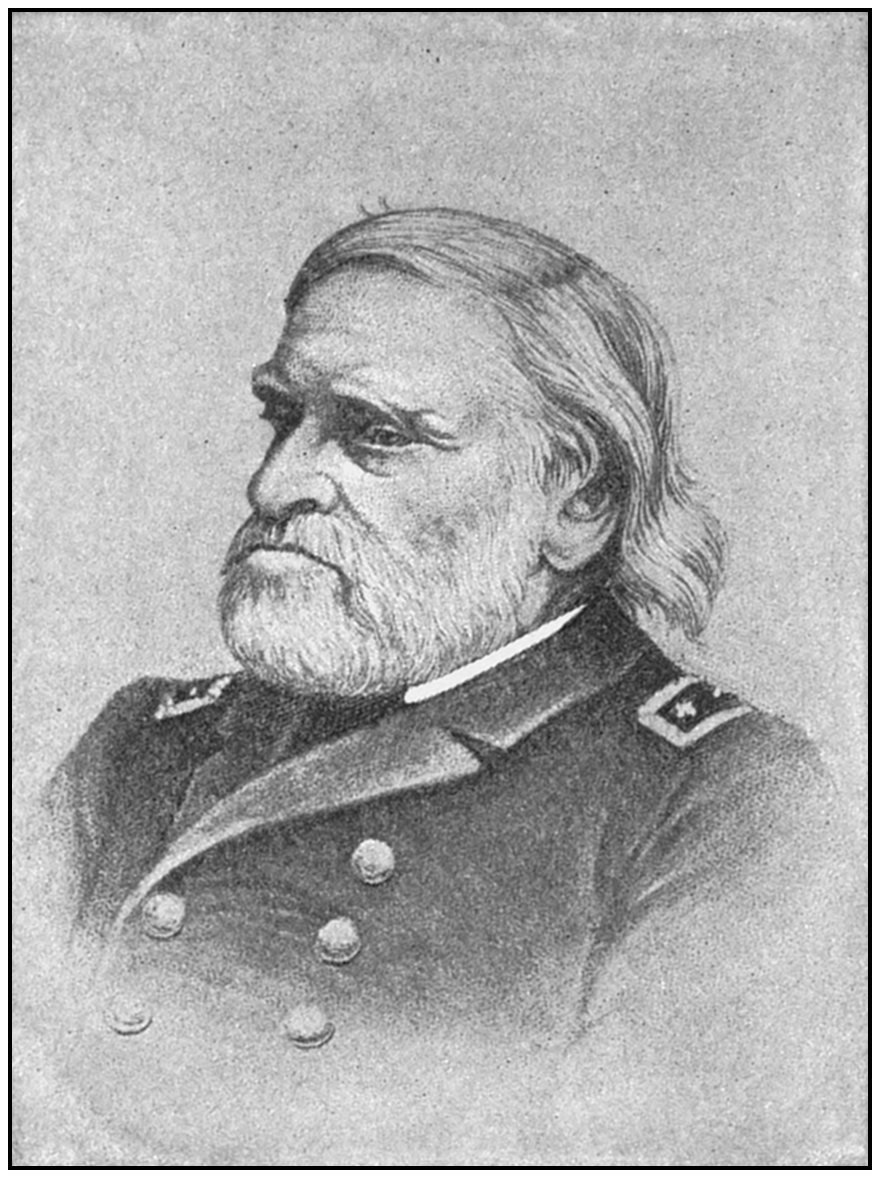
Josiah Tattnall.
From an engraving by Hall.
Off Charleston the squadron took the Susquehanna from the blockaders, and on Monday morning, November 4th, the flagship, with twenty-five other vessels of the fleet, came to anchor off the bar at Port Royal, and here they were eventually joined by all the others that survived the gale.
The storm was widespread, and the people at the North watched the clouds with an anxiety that was equalled by the hope of the168 South. Moreover, it was the first great expedition the nation had undertaken, and the people were unused to war.
Meantime, some one in the confidence of the government had betrayed the secret, and on November 1st, two days after the fleet sailed, the Confederate Secretary of War telegraphed a warning to the forts at Port Royal and the Confederate fleet at Savannah. The Confederate squadron was under Commodore Josiah Tattnall, he who braved the fire of the Mexican works at Vera Cruz. “His flagship consisted of an old passenger St. John’s steamer, mounting one 32-pound gun forward and one 18-pound gun aft. Then came two ancient, used-up tug-boats, each mounting one 32-pound gun; the next, a rotten North River cattle-boat, mounting one 18-pound gun; a dwarfish tug-boat from the James River, slightly armed, bringing up the rear.”
It was a fleet in which machinery and men169 were wholly unprotected and, for the purposes of war, was worthless. The Confederate forts were two in number—one, on Hilton Head, on the south side of the channel, called Fort Walker, and the other, on Bay Point, opposite, called Fort Beauregard. These two forts were two and five-eighths miles apart. As described by Scharf, “they were exceedingly well-built earthworks and were rather heavily armed,170 Fort Walker mounting 23 guns and Fort Beauregard 18, a total of 41; but 22 of these were only 32-pounders or lighter pieces, so that there were in fact but 19 guns fit to cope with the at least 100 heavy rifles and shell-guns of the Federal ships. Gen. Thomas F. Drayton was in command of both posts, with his headquarters at Hilton Head, and Col. R. M. Dunovant had immediate command at Fort Beauregard. The defences were garrisoned by about 2,000 men, but this force was very deficient in trained artillerists, and a small supply of shot and shell forbade much practice with the larger guns.”

Plan of Fort Walker on Hilton Head.
From a drawing by R. Sturgis, Jr., in 1861.
John N. Maffitt, a better authority on the Confederate side, says that “the construction of these works had been reprehensibly procrastinated until the ninth hour, when, in haste and confusion, raw troops, strangers to any ordnance above a 12-pound field piece, were hurried into the imperfectly-constructed earthworks to battle without drill or target practice against a masterly array of force.
“The excuse offered by the commanding general for neglecting to exercise and familiarize his artillerists with target-drill was the scarcity of ammunition. The commodore replied: ‘Half the allowance spent in practice will more likely insure good results for the balance in fighting.’”
171
Within a few hours after the flagship reached the bar at Port Royal, all but two or three of the government force was safely anchored inside. They found that the channel marks had all been removed or placed to deceive. Capt. Charles H. Davis and Mr. Boutelle of the coast survey went in the coast survey steamer Vixen to replace the buoys, being guarded by five of the smaller warships. When this had been done four of the gunboats—the Ottawa, the Seneca, the Pembia, and the Penguin—anchored within three miles of Fort Walker.
Meantime Commodore Tattnall had brought his river-boat squadron through the inland waters to help defend Port Royal, and seeing the gunboats within reach, he made a dash at them, regardless of the character of his own ships. It was like Tattnall to do that; but he was fighting his own countrymen now, and not Mexicans or Chinese. Capt. T. H. Stevens, of the Seneca, who was senior officer, without waiting for orders from the flagship, got up anchor, and with the four gunboats headed in to meet the Confederates. Of course the encounter could have but one result, for the government force was much the greater, and after Lieut. Daniel Ammen had fired an eleven-inch shell into Tattnall’s Savannah, Tattnall turned and ran. And that was the end of the offensive172 warfare waged by that Confederate squadron.
The plan of attack chosen by Flag Officer Dupont was to divide his force into two squadrons. The first included the Wabash, the Susquehanna, the Mohican, the Seminole, the Pawnee, the Unadilla, the Ottawa, the Pembina, and the Vandalia in tow of the Isaac Smith, a steam gunboat that had been obliged to throw overboard all but one of her guns in the gale, and so was useless for any other purpose than that of a tug. The smaller squadron included the Bienville, the Seneca, the Curlew, the Penguin, and the Augusta, of which all but the Seneca were converted merchantmen carrying thirty-two-pounders; the Seneca, being armed with one eleven-inch Dahlgren and a twenty-pounder rifle, besides two howitzers, was the only one of much consequence for attacking an earthwork.
The larger squadron was to steam in past the fort on Hilton Head (on the south side of the channel), at a distance, when abreast, of 800 yards, and bombard it while passing in; the small squadron was to keep at the north side of the larger one and give such attention as it might at long range to Fort Beauregard over on the north side of the channel. When the forts had been passed, the larger squadron was to turn back and steam out past Hilton173 Head, firing as before, while the little squadron remained in the harbor to head off any attack from Commodore Tatnall, and, what was of more importance as the event proved, to attack the forts from the rear.
For both forts had been planned to face the roadstead and open sea, and very little had been done to protect the landward faces from an attack from within the harbor.
An offshore gale of wind prevented an attack on the 6th, but the morning of the 7th came with scarcely a ripple on the sea, and at 9 o’clock the two squadrons of warships, in the order named, headed with a flood tide in close order to attack the fort on Hilton Head. They steamed along at six knots per hour, and at 9.26 o’clock precisely a puff of white smoke was seen on the parapet of the fort at the south. Instantly an answering puff was seen on Fort Beauregard at the north, and a round black ball from each came bounding over the smooth water, to fall short and sink out of sight. In a minute the Wabash replied with her two big ten-inch pivots, the Susquehanna followed with an eight-inch pivot, and in ten minutes more the whole fleet was engaged. A hundred huge shells were falling upon and around the fort, burying themselves for a moment in its walls, and then bursting and throwing great masses of sand in the air—masses of174 sand that fell upon the gunners and the guns there.
But, though inexperienced in war, and but slightly trained in the handling of great guns, the men within the forts were a sturdy host, and fought back in a way that must excite the admiration of all who read the story. The ships were drawing nearer steadily, and there was need for rapid work. To bring one cartridge from the magazine every time a gun was to be loaded required too much time, and the gun’s crews in the forts, regardless of the bursting shells that fell thickly around them, brought cartridges by the armful, and piled them beside the guns.
Nevertheless, they labored in vain. Fire as swiftly as they might and as accurately as they could, the majestic column of steamers passed in with the tide, unimpeded, until well within the harbor, when the longer column turned slowly around and came back, heading to pass this time within 600 yards instead of 800 as before. Sweeping out to sea, they came back again, passing once more at the shorter and more deadly range, and then a number of them came to anchor at a distance of 1,200 yards from the fort, and began a steady fire at a sure range, while “the Vandalia, in tow of the Isaac Smith by a long hawser, swept in long, graceful, but inconvenient curves past and among177 these vessels. The Unadilla, whose machinery was disabled, pursued her eccentric orbit, her commanding officer hailing and requesting other vessels to get out of the way, as he ‘could not stop.’ As he swept by, again and again the droll song of the man with the cork leg that would not let him tarry was brought to mind.” So says Ammen. But while the Unadilla amused the government forces she was not amusing the Confederates, for she kept her batteries working as relentlessly as her machinery worked.
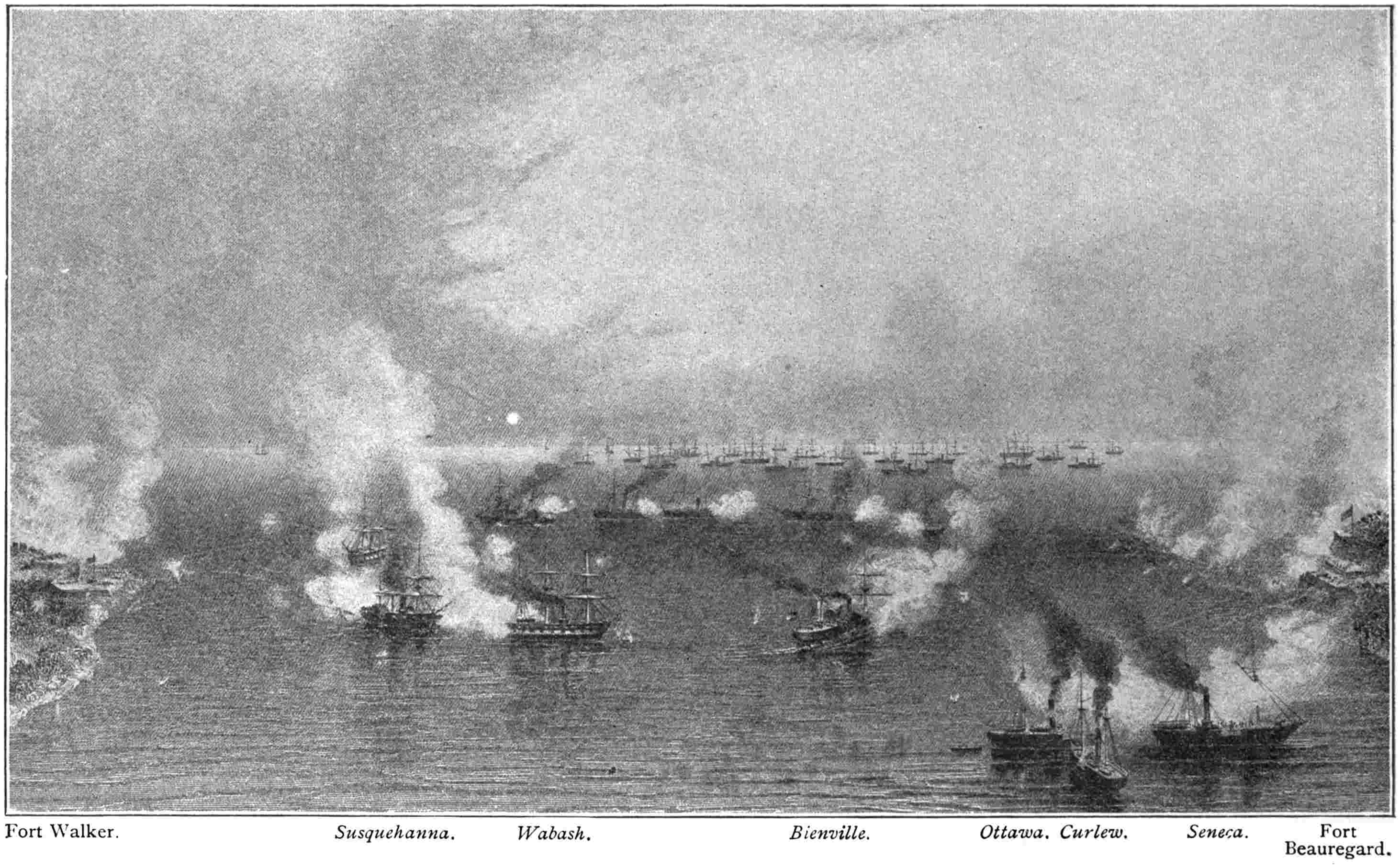
Bombardment of Port Royal, S. C.
From an engraving by Ridgeway of a drawing by Parsons.
And then came the steamer Pocahontas, under Capt. Percival Drayton, a Southern-born naval officer whose regard for his oath had prevented his deserting the flag. The Pocahontas had been delayed at sea by the great gale, but although she arrived too late to join in the procession, she ran in close to the beach southeast of the fort, and, stopping there, opened an enfilading fire. There was a single thirty-two-pounder on this flank of the fort, and Gen. Thomas Drayton, commanding the fort, had it trained on the Pocahontas. General Drayton on shore and Captain Drayton afloat, brothers, were firing on each other. But the gun ashore was knocked to pieces by a shot from the ship, and thereafter the fire of the Pocahontas began to drive the Confederates from their guns, for there were no traverses178 between the guns to protect the men from an enfilading fire.
Meantime the smaller squadron left within opened an enfilading fire on both the Hilton Head fort and Fort Beauregard on the north side of the channel. “This enfilading fire on so still a sea annoyed and damaged us excessively,” says General Drayton in his report. It became more annoying still as time passed, for the ebb tide began to run, and the gunboats were swept down until within 400 yards of the forts, and shots from even the howitzers began to tell with deadly effect. It was a storm that no force of men could stand. By 1.15 P.M., according to one account, and by 2 o’clock at the latest, “all but three of the guns on the water front had been disabled, and only 500 pounds of powder [remained] in the magazine” of the Hilton Head fort. The work of the fleet was done. The Confederates began to evacuate the fort on Hilton Head. Lookouts on the Ottawa were the first to see the men leaving the fort, and signals were soon flying to announce the fact. In a moment the Pembina was signalling the same story, while men who ran aloft on the Wabash hailed the deck to confirm the news.
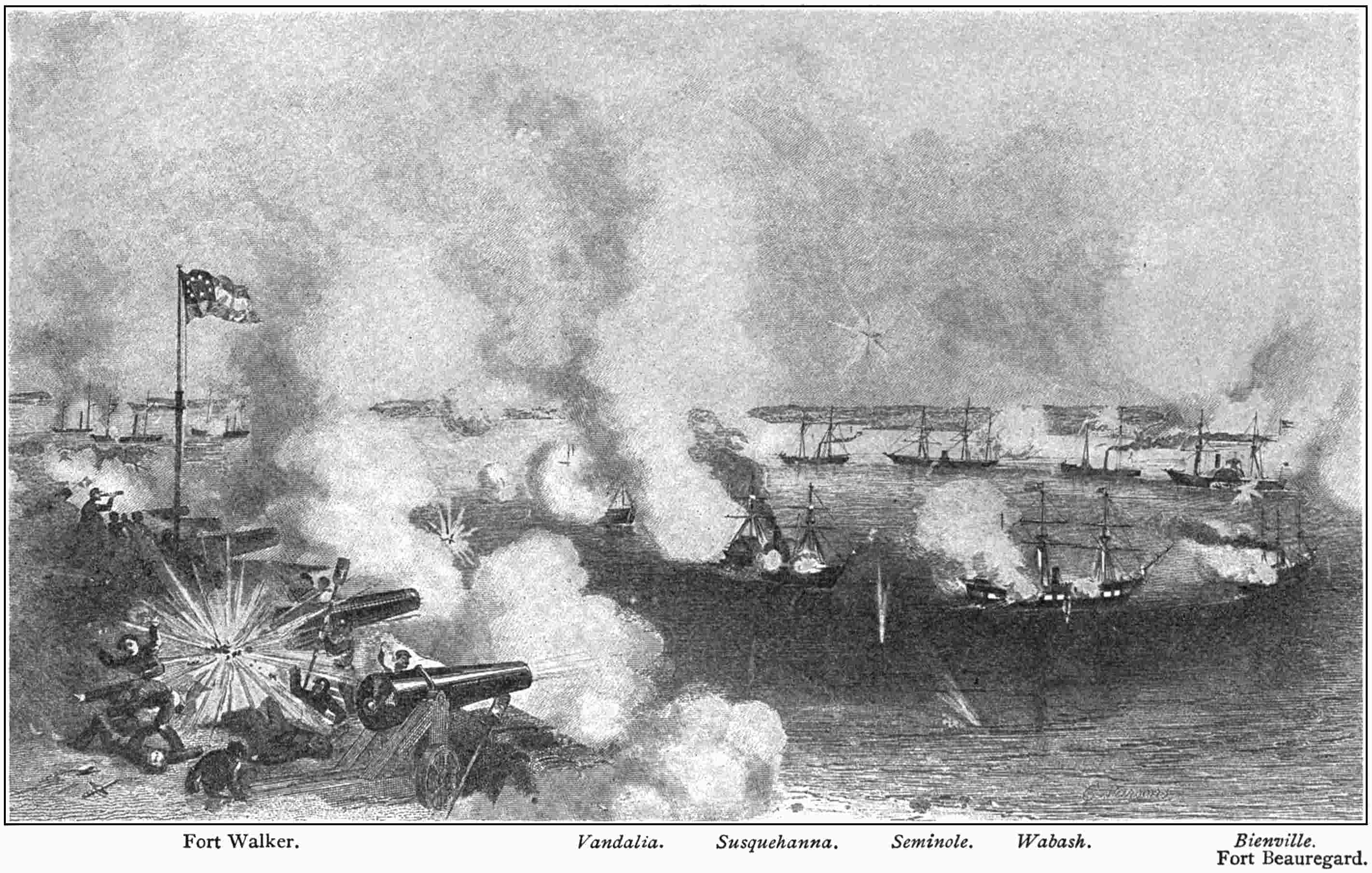
Bombardment and Capture of Forts Walker and Beauregard, November 7, 1861.
From an engraving by Perine.
At this the order to cease firing fluttered in the air. The Wabash and the Susquehanna steamed close in where their huge broadsides181 would bear directly on the fort, and Capt. C. R. P. Rodgers was sent in a boat to make an examination.
“The entire fleet, now resting on its guns, watched the whaleboat pull out from the wing of the huge frigate and make its way like a cockleshell toward the grim and silent fort. Thousands of eyes centered on the little boat with increasing interest as she drew nearer the shore. Her keel soon grated on the beach, and the officers were seen to jump out, approach the fort and enter, and for a time they were lost to view. Then Commander Rodgers was seen scrambling up the highest part of the ramparts, carrying the American colors with him; and at the first glimpse of the beautiful ensign the long suspense gave place to tremendous cheers from every craft in the fleet.” So says Maclay.
Although the main attack had been made on the Hilton Head fort, the one at the north had received attention at long range from the larger squadron, and the gunboats within the harbor had enfiladed it. It had suffered so much, in fact, that the troops abandoned it as soon as they saw that Hilton Head had surrendered. Vessels that were sent to reconnoitre found the flag down, and the next morning Capt. Daniel Ammen of the Seneca hoisted the American flag over the building that had182 been used as headquarters there. Of his experience Ammen has written as follows:
“He went into the house without a suspicion of possible injury, and found everything had been removed. The earthworks and magazines were hastily examined, and the encampment under the pine trees half a mile distant was then visited.
“Returning to the vicinity of the earthworks, where our flag had been hoisted an hour before, a dull explosion was heard, a cloud of smoke went up, and when it passed away there was no vestige of the small frame house upon which our flag had been hoisted. A sailor walking near had fallen into the snare by his foot striking a wire fastened to a peg, through which a ‘spur tube’ had exploded a quantity of powder placed under the floor of the house. The sailor was knocked down and stunned for a few minutes.”
The government loss in the fight was eight killed, and six seriously and seventeen slightly wounded. The Confederates lost “eleven killed, forty-eight wounded and four missing.”
Admiral Porter says that “the victory at Port Royal put new life into Union hearts.” It “gave the powers of Europe notice that we could and would win back the forts that had been filched from us.” It “showed conclusively that the time-honored theory that one gun on183 shore was equal to five on shipboard no longer held good.” And of Dupont he says that “all the qualities of a great commander were possessed in an eminent degree” by him.
The harbor of Port Royal remained under the flag. The adjoining waters were patrolled by government gunboats, and Tybee Island and other approaches to Savannah soon fell into government hands. Later on Port Royal was used as a base for the operations against Charleston, which will be described further on.
184
SUPERIOR ACTIVITY OF THE CONFEDERATES IN PREPARING FOR IRONCLAD WARFARE AFLOAT—STORY OF THE BUILDING AND ARMING OF THE MERRIMAC—SHE WAS A FORMIDABLE SHIP IN SPITE OF DEFECTS IN DETAIL, BUT HER DESIGN WAS NOT THE BEST CONCEIVABLE—ORIGIN AND DESCRIPTION OF THE SHIP THAT REVOLUTIONIZED THE NAVIES OF THE WORLD—A WONDROUS TRIAL TRIP—FOR ONE DAY THE MERRIMAC WAS IRRESISTIBLY TRIUMPHANT—TWO FINE SHIPS OF THE OLD STYLE DESTROYED WHILE SHE HERSELF SUFFERED BUT LITTLE—THE MAGNIFICENT FIGHT OF THE CUMBERLAND—A DIFFERENCE IN OPINIONS.
The story of the most famous ship duel known to the history of the world, the battle between the Monitor and the Merrimac, begins on June 10, 1861, when Lieut. John M. Brooke, C.S.N., formerly of the American navy, was assigned to assist the Confederate Navy Department in designing an ironclad that should be able to gain control of the navigable waters in and about the Chesapeake Bay. Brooke “entered upon this duty at once, and a few days thereafter submitted to the department, as the results of his investigations, rough drawings of a casemated vessel, with submerged185 ends and inclined iron-plated sides. The ends of the vessel and the eaves of the casemate, according to his plan, were to be submerged two feet; and a light bulwark or false bow was designed to divide the water and prevent it from banking up on the forward part of the shield with the vessel in motion, and also to serve as a tank to regulate the ship’s draft. His design was approved by the department,” and Constructor J. L. Porter was brought up from Norfolk to Richmond to assist in making the working drawings. Porter had already been considering this subject, and brought with him a model of a light-draft, screw-driven scow, that was to support a “casemated battery, with inclined iron-covered sides and ends.” In the opinion of Brooke this would have been, “for ordinary purposes, a good boat for harbor defence,” but a blunt-ended hull was, naturally, not to the liking of a naval man, and he proposed to have the ends of the hull “prolonged and shaped like those of any fast vessel, and submerged two feet under water, so that nothing was to be seen afloat but the shield itself.”
Plans were drawn for such a ship, and, with Chief Engineer W. P. Williamson, Brooke went looking for engines to drive the proposed ironclad, but failed to find any. It was186 in this emergency that Williamson thought of the hulk of the Merrimac, that had been partly burned and sunk at Norfolk. Her engines were old and in bad order when she arrived at Norfolk before the trouble began, and new ones were to have been provided. Moreover, the fire and the soaking in sea-water had injured them; but Williamson knew that they could be made to work. Both Porter and Brooke “thought the draft too great, but were nevertheless of the opinion that it was the best thing that could be done,” and the order to transform the old frigate into a floating fort was issued. Williamson “thoroughly overhauled her engines, supplied deficiencies, and repaired defects, and improved greatly the motive power of the vessel.” Porter “cut the ship down, submerged her ends, performed all the duties of constructor, and originated all the interior arrangements.” The casemate was built according to the plans of his model.
“Mr. Brooke attended daily to the iron armor, constructed targets, ascertained by actual tests the resistance offered by inclined planes of iron to heavy ordnance, and determined interesting and important facts in connection therewith, and which were of great importance in the construction of the ship; devised and prepared the models and drawings of the ship’s heavy ordnance, being guns187 of a class never before made, and of extraordinary power and strength.”
Porter having got the hull in the dry dock, cut it down to where the berth deck had been. Then he laid a heavy timber deck over the entire hull, and on this, amidships, he erected a casemate, with its walls inclined in at an angle of “about thirty-six degrees,” according to one of her officers, and forty-five according to another. This casemate was two feet thick, and was made of twelve-inch timbers standing on end, covered with eight-inch timbers laid horizontally, which were in turn covered with oak plank four inches thick. On these were laid iron plates two inches thick and eight inches wide, placed horizontally, with another layer of the same dimensions over them placed vertically. The side-walls of this casemate projected down and out over the sides of the hulk, like the eaves of a country house, to protect the water-line, and the hull itself was plated with one-inch iron for two feet below the deck, although the design called for three-inch iron. The inclined sides were carried up high enough to give seven feet head room inside, and then a heavy flat deck twenty feet wide, with hatches in it, was laid across. On the bow, two feet below the water-line, was bolted a cast-iron wedge that projected two feet from the stem, and was for use as a ram.
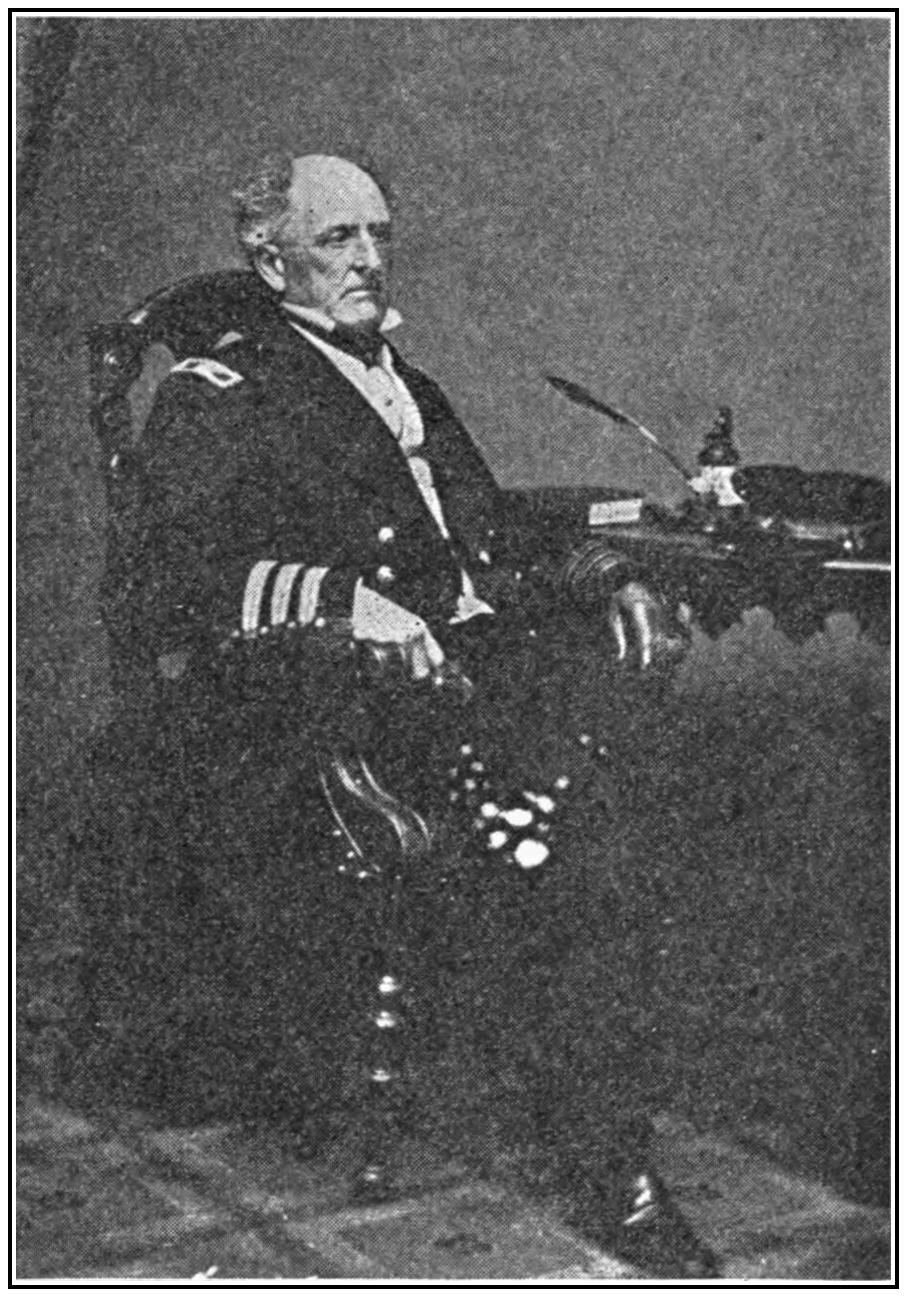
188
The battery of the Merrimac contained six of the nine-inch Dahlgrens found in the Norfolk Navy Yard, and four rifles designed by Brooke. Two of these rifles were mounted as pivots at bow and stern, and two smaller ones were in the broadside. The pivots were cast-iron muzzle-loading rifles of seven-inch calibre, and they weighed 14,500 pounds each. The reader will appreciate the weight of the gun when it is told that the best gun in the British navy at that time was the 68-pounder, having a calibre of eight inches and weighing 9,500 pounds. Moreover, Brooke’s heavy casting was reinforced by wrought-iron bands shrunk on. The broadside guns were of the same construction, but weighed 9,000 pounds and were of four-inch calibre. Brooke’s guns were far and away the best then afloat.
When ready for a trial trip, with all weights on board, the Merrimac drew twenty-two feet six inches of water. Her crew numbered 320. She was commanded by Flag Officer Franklin Buchanan, and Lieut. Catesby Ap R. Jones was chief officer. Another lieutenant was John Taylor Wood, and both of these lieutenants have written accounts of the ship. They agree in saying that the engines were in wretched order, and that the great draft of the ship was a serious disadvantage in the waters where she was to be used is manifest.189 Nevertheless, for smooth water she was the most powerful ship afloat. She was named the Virginia, and should have been called so in history, for she was a rebuilt ship; but it is too late to change history now.
Of course, the government heard about the building of a floating battery on the Merrimac hull. The spy service of the government was never as good as that of the Confederates, and the news obtained was not always appreciated. Porter tells of seeing a mechanic who had fled from the Norfolk Navy Yard ill-treated when taken on board the government flagship to tell what he knew. This matter is referred to, not to make an ill-natured criticism of a government officer, but to show how important it is in time of war to make a full and just estimate of the power of the enemy.
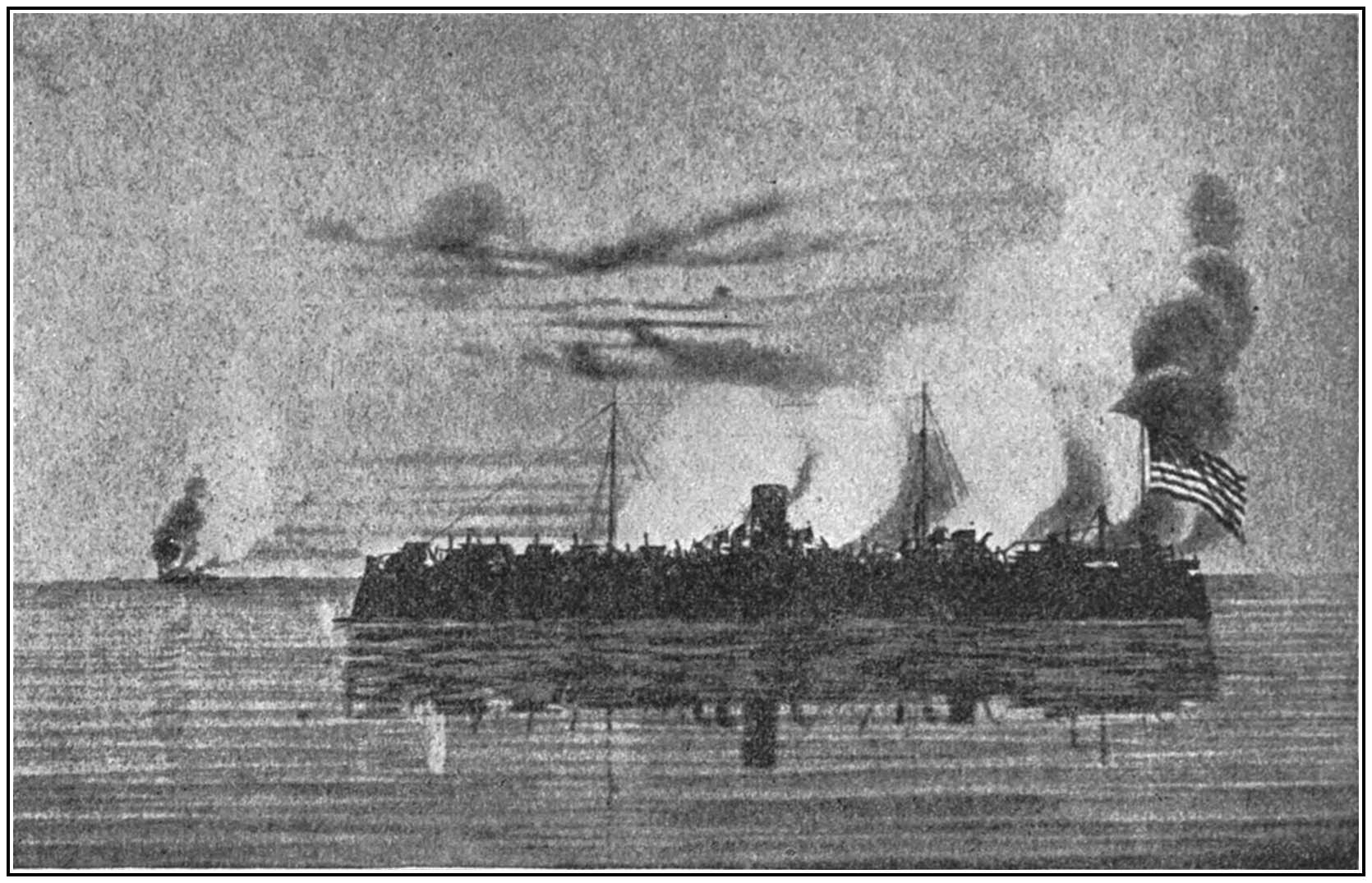
The New Ironsides in Action.
From a photograph, of a drawing, owned by Mr. C. B. Hall.
The Confederates began the work of converting the Merrimac in June, 1861. There190 were several frigates in the Union navy that might have been converted, with Northern resources, into more powerful ironclad batteries than the Merrimac was, but nothing was done until Congress met, and on August 3d made an appropriation for ironclads. Then designs were called for, and three were selected for acceptance after long consideration. One of these proved a failure as an ironclad. One proved a great success a year or so later (she was called the New Ironsides), and, fortunately, the third was of a design that might be built quickly and yet prove efficient. This ship was from the brain of John Ericsson, who had already revolutionized the navies of the world191 by introducing the submerged screw propeller; and the name which he gave to the marvel he produced, at once became generic.
Although Congress appropriated the money for ironclads on August 3d, the board appointed to consider plans did not convene until the 8th. It took them until September 8th to make up their minds, and it was not until October 4, 1861, that the final contract with Ericsson was signed. This was a needless delay, and this fact is worth emphasizing because it is not unlikely that similar delays will be experienced whenever the nation is again unexpectedly plunged into war.

The Giant and the Dwarfs; or John E. and the Little Mariners.
[From a Swedish caricature, February 10, 1867.]
John.—Come here, little boys, and I will show you. What do you say to this model of a gunboat for our coast defence?
The Little Boys.—Won’t do ... too small ... too heavy draught ... too large guns ... too light draught ... too large ... too small guns ... won’t do,—that’s what I say ... and I also,—because it isn’t our invention.
John.—Well, little boys, that is at least some reason.
But if the authorities were dilatory, the mechanics were not. The keel was stretched in that part of the Brooklyn water front called192 Greenpoint, before the end of the month, although working plans had to be laid in the mould loft and contracts for materials made. Three gangs of men were employed, working eight hours each in succession; the iron was kept hot from the day the work began until January 30, 1862, when the hull was sent afloat in the waters of the East River, under the name of Monitor.
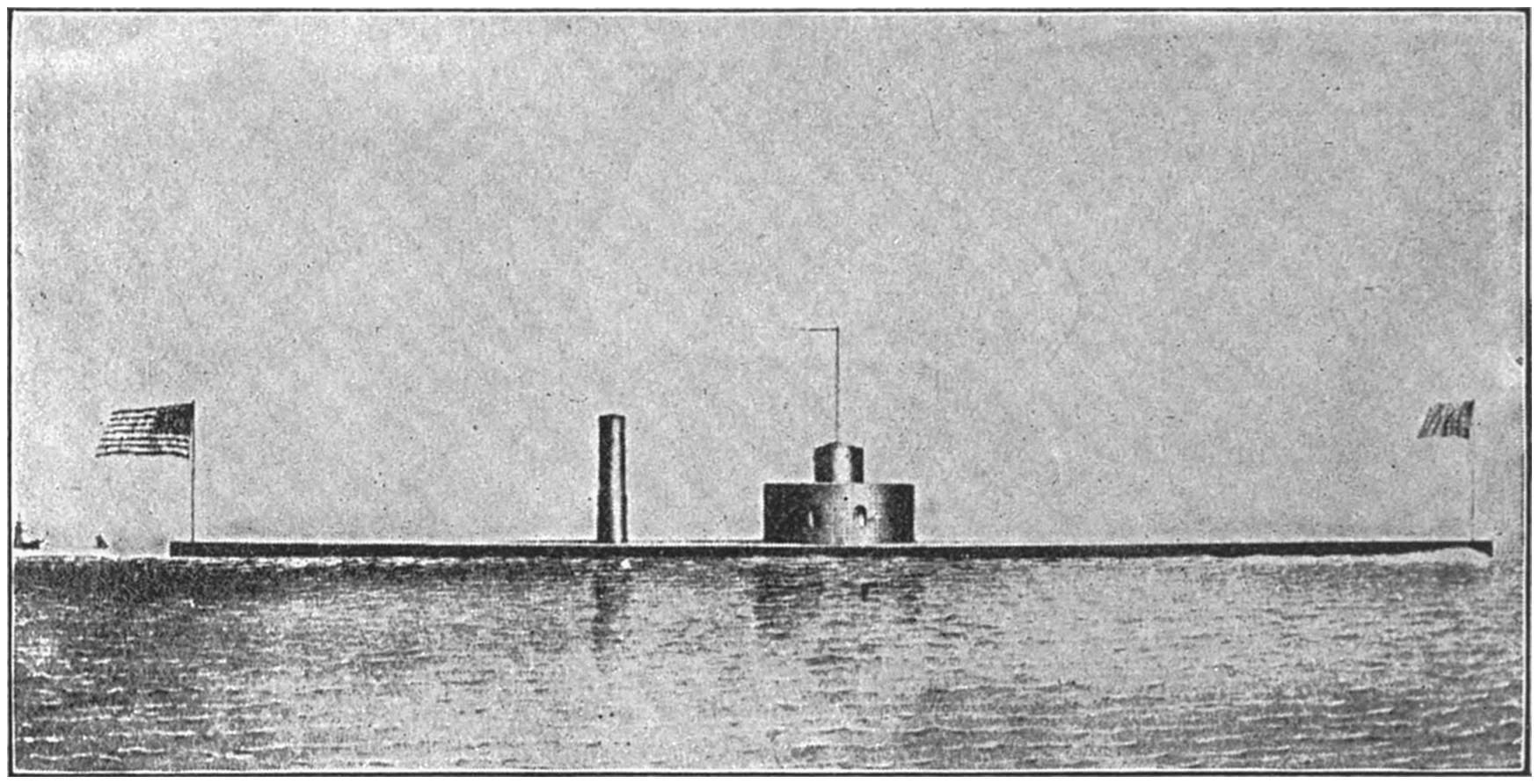
The hull of the Monitor, as it stood on the land, was in a way something like that of the common ferryboat. There was a smooth, rounded hull, 124 feet long, thirty-four wide, and about six feet deep, with a superstructure laid flat across the top of this hull and projecting out like a guard-rail on all sides.
It projected three feet and eight inches on each side, and twenty-five feet at each end.193 But this overhanging part was really a super-added hull; it was a flat-bottomed hull, 172 feet long, forty-one wide, and five feet deep, laid on top of the lower hull, and secured to it by a single row of rivets. As a whole, the Monitor was unlike any other hull ever built. And it is no disparagement of the genius of Ericsson to say that no sailorman could ever have dreamed of such a thing even when in a delirium from drink.
This hull was made of boiler-iron riveted to suitable frames, and the vertical sides of the overhang were protected by five one-inch iron plates bolted on and backed by heavy oak timbers. A heavy timber deck, supported on big wooden beams, was protected from a plunging fire by two layers of half-inch iron plates. On the centre of this hull rose a round turret, twenty feet in diameter inside and nine feet high, made of eight one-inch iron plates. It was supported on a pivot, to which an engine was geared so that it could be readily turned in either direction. Her deck was one foot above the water-line. She carried two eleven-inch smooth-bore guns, firing solid shot weighing from 170 to 180 pounds. Her speed was between four and five knots. A novel feature was the absence of smoke-stacks in action; they were taken apart and laid flat on deck, which gave an all-round194 fire abaft. The draught to the furnaces was maintained by powerful blowers. Forward of the turret stood a pilot-house made of iron logs, nine inches square, built up log-cabin fashion by notching and bolting the ends together. Her anchor was suspended in a well under the bow, the cable passing through a pipe beneath the deck to a winch further aft. The propeller was, of course, concealed under the overhang aft. In short, her machinery was altogether below the water-line, while her guns were placed as near the centre of gravity as could well be imagined, and were well protected. It is perhaps as well to say here as elsewhere that with such modifications as experience has suggested, the Monitor type is, in the opinion of many of the American captains who have commanded them, not only the best protected, but the most efficient and the safest style of coast-defence ships.
As the month of January, 1862, came on, the Confederates learned from their spies that the Monitor was rapidly nearing completion, and the number of men at work on the Merrimac was doubled. They had already been pushing the work as fast as daywork could do it, but with the added force, the Merrimac rapidly assumed the form where she might be placed in commission. The collecting of a crew proved a matter of some trouble, for the195 people of the South were all soldiers rather than seamen; but by visiting the various armies, Captain Buchanan was able to select a thoroughly good crew for the work—men who could fix the boilers, steer the ship, and work the guns to the best advantage. The fact that many of them did not know a royal halliard from futtock shroud was of no importance, for, like the latest of warships, the Merrimac had neither halliards nor shrouds. With the arrival of the crew the eagerness of the officers to try their ship increased. She had never steamed a mile in her new form—she had never steamed at all save only to turn her shaft at the dock to see whether the engines would work or not; but this did not matter. The men were fore and fit, and on Saturday, March 8th, they would show what the ship was good for.
A glance at the map shows that the waters of the James River come down from the northwest, those of the Nansemond come from the southwest, and those of the Elizabeth come up from the south to unite in Hampton Roads, and flow out to the northeast to empty into Chesapeake Bay. Old Point Comfort, with Fortress Monroe, guarded the north side of the mouth of Hampton Roads, but away south, on the route to Norfolk, was Sewell’s Point, where the Confederates had erected strong batteries197 that completely commanded the channel running south from Hampton Roads to Norfolk. Over on the northwest corner, so to speak, of Hampton Roads lay Newport News Point, which was held by the government; so the government ships were in the habit of anchoring along the northerly side of Hampton Roads all the way from Fortress Monroe to Newport News, a distance of seven miles. They were in plain sight of the Confederate batteries on Sewell’s Point, but far out of range, for it is a wide stretch of water.
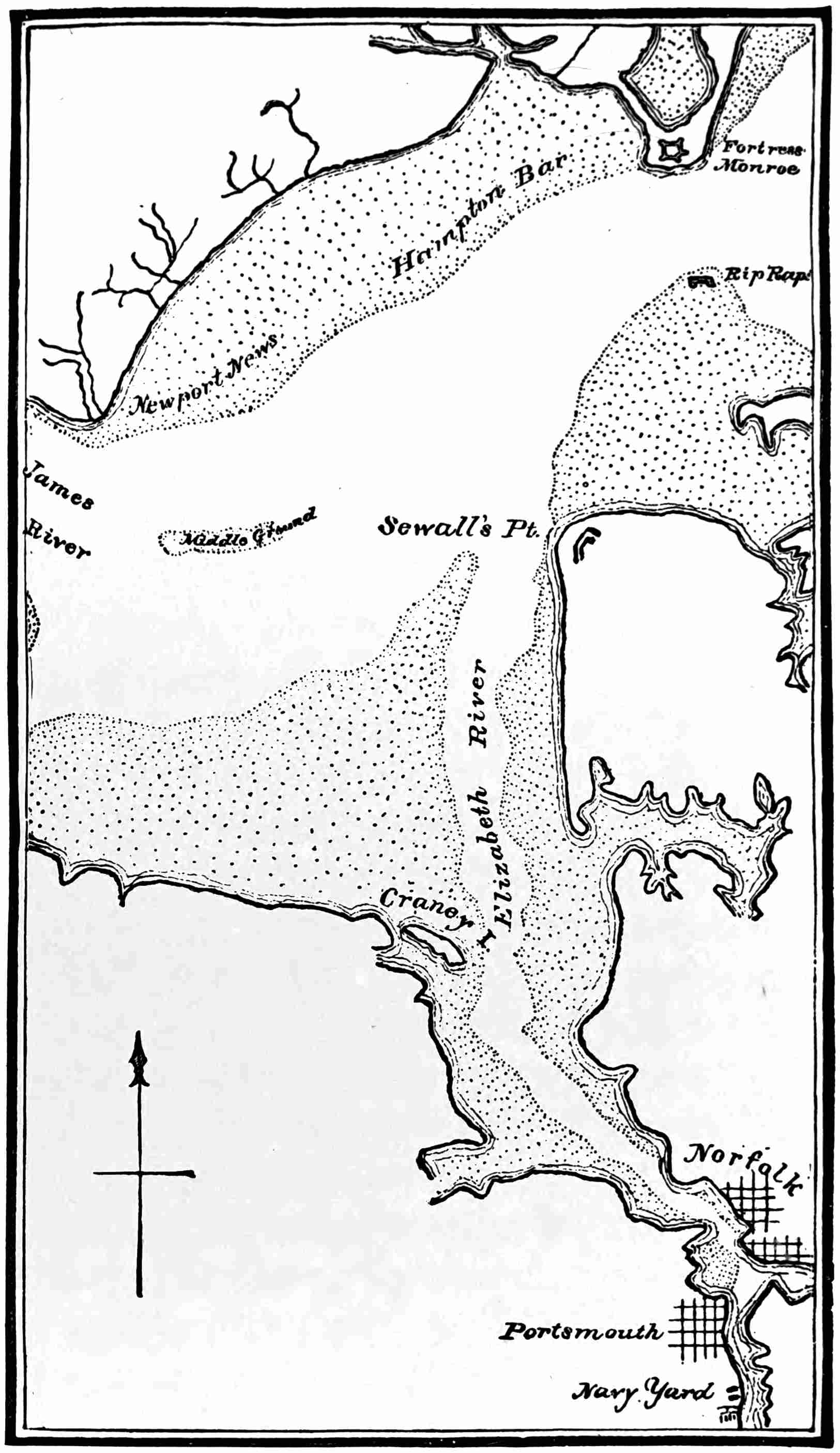
Hampton Roads.
From “The Navy in the Civil War.”
On the morning of March 8, 1862, the steam frigates St. Lawrence, Roanoke, and Minnesota were anchored at wide intervals, in the order named, in a line southwest from Fortress Monroe toward Newport News Point, while the sailing frigate Congress lay just east of Newport News Point, and the sailing sloop-of-war Cumberland lay just a little to the west of the point. It was a lovely day of the early spring. The ships swung easily to their cables; the small boats wabbled over the tiny waves as they tugged at the painters that held them fast to the wide-spread booms. The wash-clothes, on well-filled lines stretched in the rigging, fluttered in the gentle breeze. There was nothing to indicate that any officer had any care or thought of the ironclad ship that for months past the Confederates had198 been building at Norfolk. And as a matter of fact they did not give the ironclad a serious thought, for they were conservatives. What could a newfangled notion like this ironclad do, any way? Hadn’t Lord Howard Douglas and other good English authorities proved to the satisfaction of the experienced men of the world that a ship plated with iron would really prove more dangerous to her crew than to an enemy in the oft-approved frigates of the day? He had.
The morning wore away in peace, but at noon exactly, the crew of the Cumberland saw the long trail of smoke from steamers that were boldly coming up the channel from Norfolk. A careful lookout kept watch of that smoke until it was seen that the steamers were three in number, of which one, although it made more smoke than both the others, did not look at all like a ship, but like a low black box instead. There was no mistaking her character, however. She looked as the escaped colored people had said the new ironclad looked, and the drums beat the long call to quarters.
Over on the Congress, lying east of Newport News Point, there was a similar stir while signal flags fluttered aloft to warn the big steam frigates lying up to the northeast toward Fortress Monroe.
199
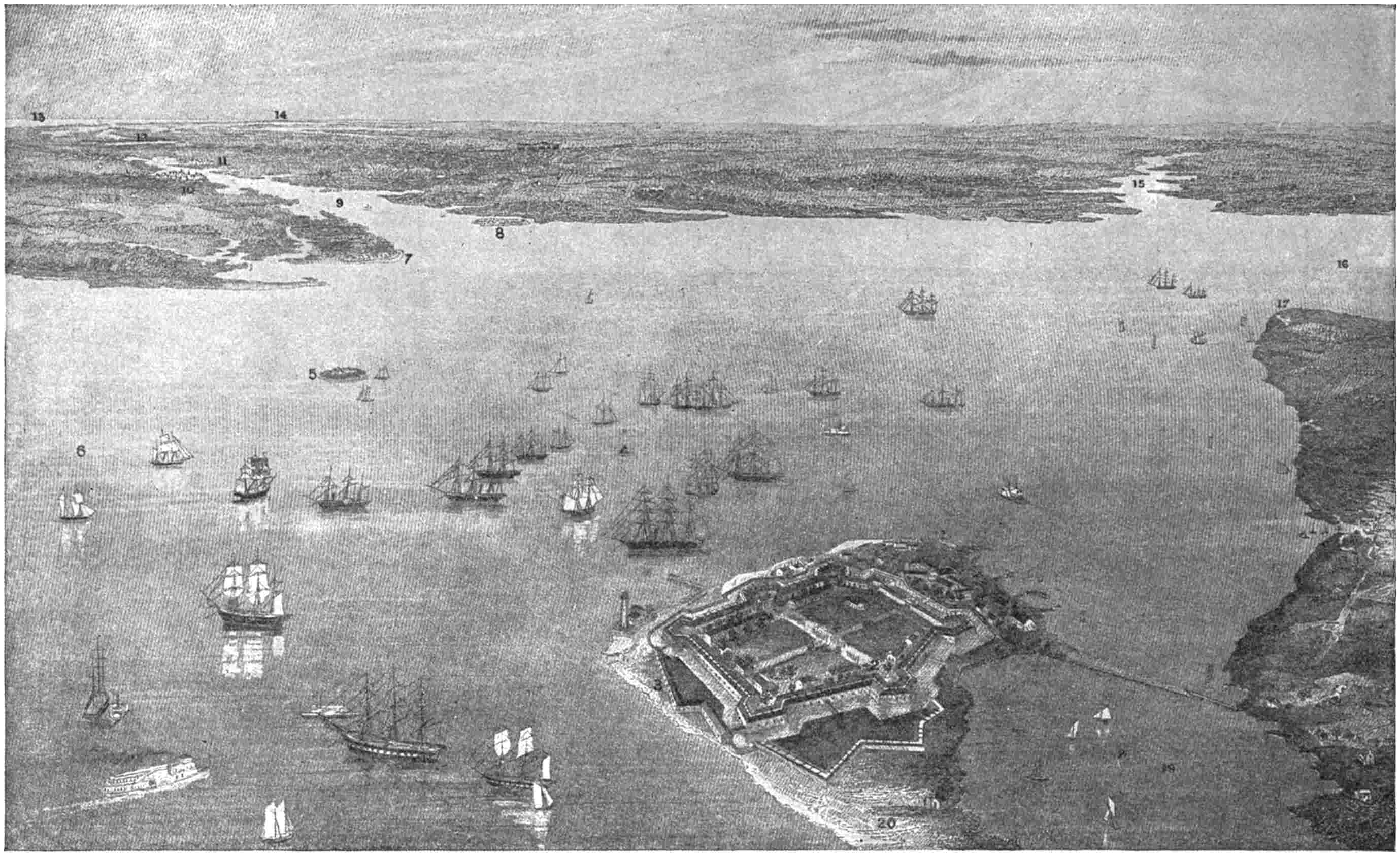
Fortress Monroe and its Vicinity.
1. Old Point Comfort, 2. Fortress Monroe. 3. Water battery. 4. Hampton Roads. 5. Rip Raps. 6. Chesapeake Bay. 7. Sewell’s Point. 8. Craney Island. 9. Elizabeth River. 10. Norfolk. 11. Portsmouth. 12. Dismal Swamp. 13. Atlantic Ocean. 14. Cape Hatteras, N. C. 15. Nansemond River. 16 James River. 17. Newport News. 18. Hampton. 19. Mill Creek. 20. Land approach to Fortress.
200
Capt. John Marston, who was senior officer and commanded the Roanoke, reports that he had already seen the enemy coming. At 12.45 o’clock they passed Sewell’s Point, over on the south shore, and on getting out into deep water they headed away to the west toward Newport News.
The Merrimac had left Norfolk for a trial trip, but the crew had slushed her walls to make the Yankee shells slip off, and their enthusiasm made them determine to give her such a trial as no new-idea ship ever had either before or since. Running across to Newport News, the Merrimac headed for the Cumberland, that lay beyond the point. The government crews were at their quarters, and while yet the Merrimac was three-quarters of a mile away, the Cumberland’s ten-inch pivot began to talk. Then the frigate Congress opened fire. The Merrimac passed her broadside to broadside, for the Congress swung head to the east with the young flood-tide. It was an experienced crew on the Congress, and her shot rattled and burst against the Merrimac’s side—rattled and burst “like peas from a pea-shooter.” They made the slush there sizzle and smoke, but they did no damage whatever. As the Merrimac passed the Congress, however, and opened fire with her broadside, the shot struck home, carrying death on every side.
201
One broadside only, and then she was gone. She was going to begin on the Cumberland. Lieut. George U. Morris was in command of the Cumberland, for Capt. William Radford was away on other duty. But Morris was equal to the emergency. As the Merrimac drew near, the Cumberland’s guns were loaded with solid shot and the heaviest service charge of powder. The broadside guns were carefully aimed, and almost every shot struck the moving target—struck it and bounded clear or burst into harmless fragments. There was nothing they could do to impede the coming monster. And then, when the Merrimac was within a few yards, her long bow rifle blazed forth. It was aimed by Lieut. Charles Simms, and it killed and wounded “most of the crew of the after pivot gun of the Cumberland.”
The Cumberland returned the shot with a broadside, but the Merrimac was now upon her; the long bow, that was just awash, slid through the water and into the side of the old sloop just under the fore rigging. The crash of the timbers was heard above the roar of the guns. The Cumberland shivered and heeled slightly to the blow, while the Merrimac hung for a moment in the wound she had made, and then backed off, firing every gun that would bear, while the water went roaring into the202 Cumberland through the hole where the ram had struck.
Heading to the west, the Merrimac steamed slowly away astern of the wounded ship, and then turned to come back again. While the Merrimac turned she raked the Cumberland first with the big stern pivot and then with the broadside guns, killing and wounding many, and then ranging up beside her, hailed and demanded that she surrender.
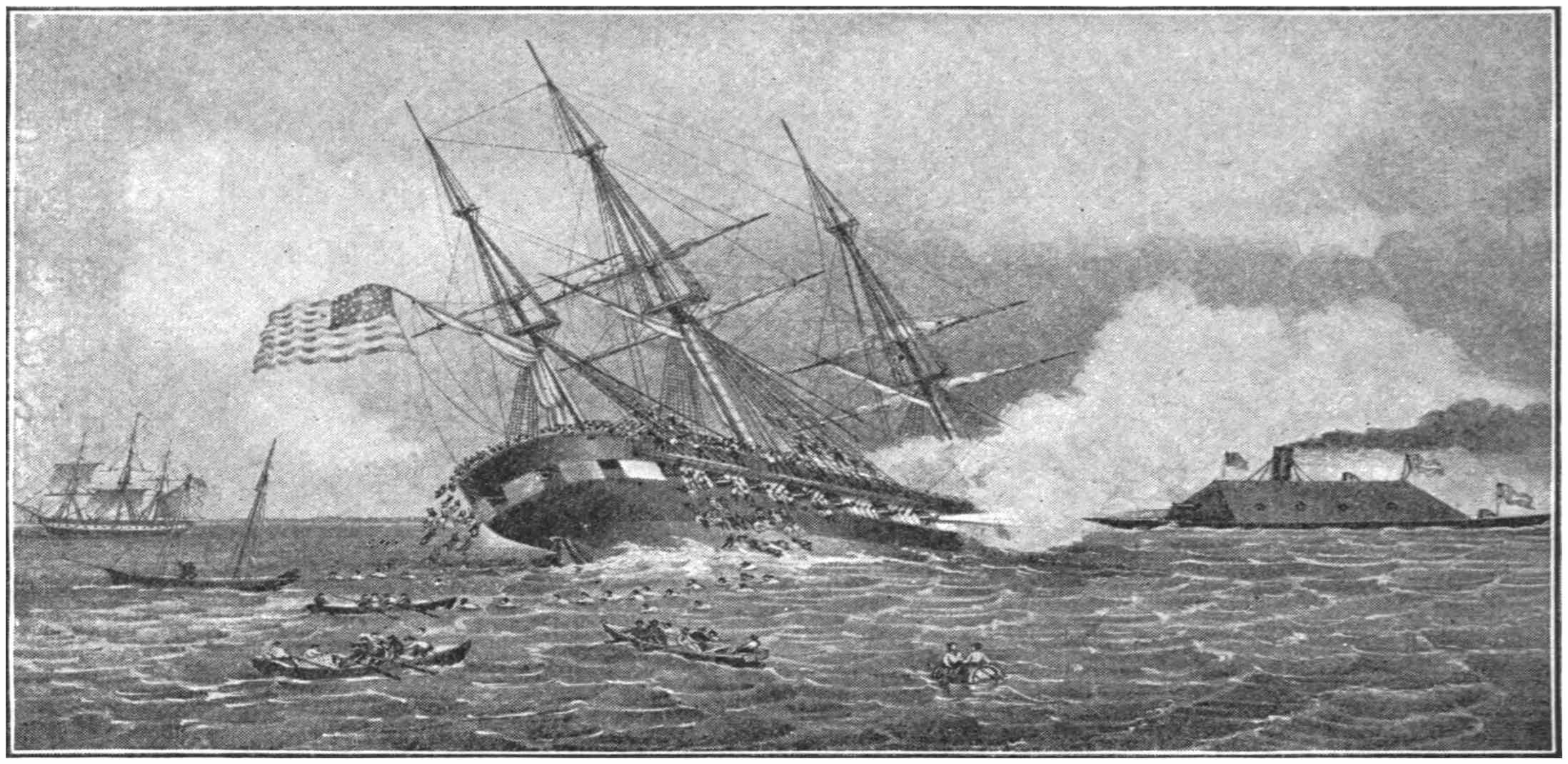
The Sinking of the Cumberland by the Ironclad Merrimac.
From a lithograph published by Currier & Ives.
The Cumberland was now settling down forward under the weight of water there; it was plain that she must sink. It was certain that her shot could not pierce the side of the ironclad. But Lieutenant Morris replied:
“Never! I’ll sink alongside.” And then203 the Cumberland’s “gun’s crews kicked off their shoes, and stripped to the waist. Tanks of cartridges were hoisted on the gun-deck and opened, and round after round was fired at the ironclad. A shell passing through the hatch burst in the sick-bay, killing four of the wounded. On the berth-deck, the wounded men were lifted upon racks and mess-chests, to keep them from drowning; and as the water rose, those who fell on the upper decks were carried amidships and left there. Already, the boats had been lowered and made fast in a line on the shore side. At half-past three, the forward magazine was drowned, and five minutes later the order was given to the men to leave quarters and save themselves.”
The water had risen at this time to the gun-deck, and the ship was heeling swiftly to port. There was need of haste if the crew were to save themselves even by swimming, but with their feet in the rising flood one crew lingered to fire a last shot. And as its smoke rolled from the ship’s side she sank out of sight with her flag flying.
“Never did a crew fight a ship with more spirit and hardihood than these brave fellows of the Cumberland while the vessel was going down. Nor was it a mere idle display of gallantry, this holding on to the last; for in these days, in naval battles,” “c’est le dernier coup204 qui peut-être nous rendra victorieux” (the last shot may give us the victory). “Tirez, tirez toujours!”
Flag and all disappeared as the ship went down, but the water was only fifty-four feet deep, and when she struck bottom she righted, and the peaks of her masts appeared once more to flutter the old flag in the sunlight.
And let it be told to the honor of the Cumberland’s crew, who fought till their feet were wet by the water above the deck of the sinking ship, that their shot did more damage than any others fired at the Merrimac, not excepting the Monitor’s; for they shot off the muzzles of two of the Confederate guns and burst a shell in a port where its fragments killed two and wounded several others.
There were 376 souls on board the Cumberland when she went into action. Of these, 117 were lost and twenty-three were missing.

The Merrimac Ramming the Cumberland.
From a drawing by M. J. Burns.
“The gallantry of her officers and crew was the theme of great praise, and painting and poetry celebrated their heroism. Lieutenant Morris, who was commanding in the absence of Captain Radford, was the recipient of special commendations from the Secretary of the Navy in a letter to him on the 21st March. Just a week later, twelve citizens of Philadelphia, all personal strangers to him, presented to Lieutenant Morris, at the house of 207R. W.206 Leaming, an elegant sword, saying in a letter to him, that it could have ‘no worthier recipient than the brave sailor who fought his ship while a plank floated, fired his last broadside in sinking, and went down with his flag flying at the peak.’ On the sword was the motto in Latin, ‘I sink, but never surrender.’”
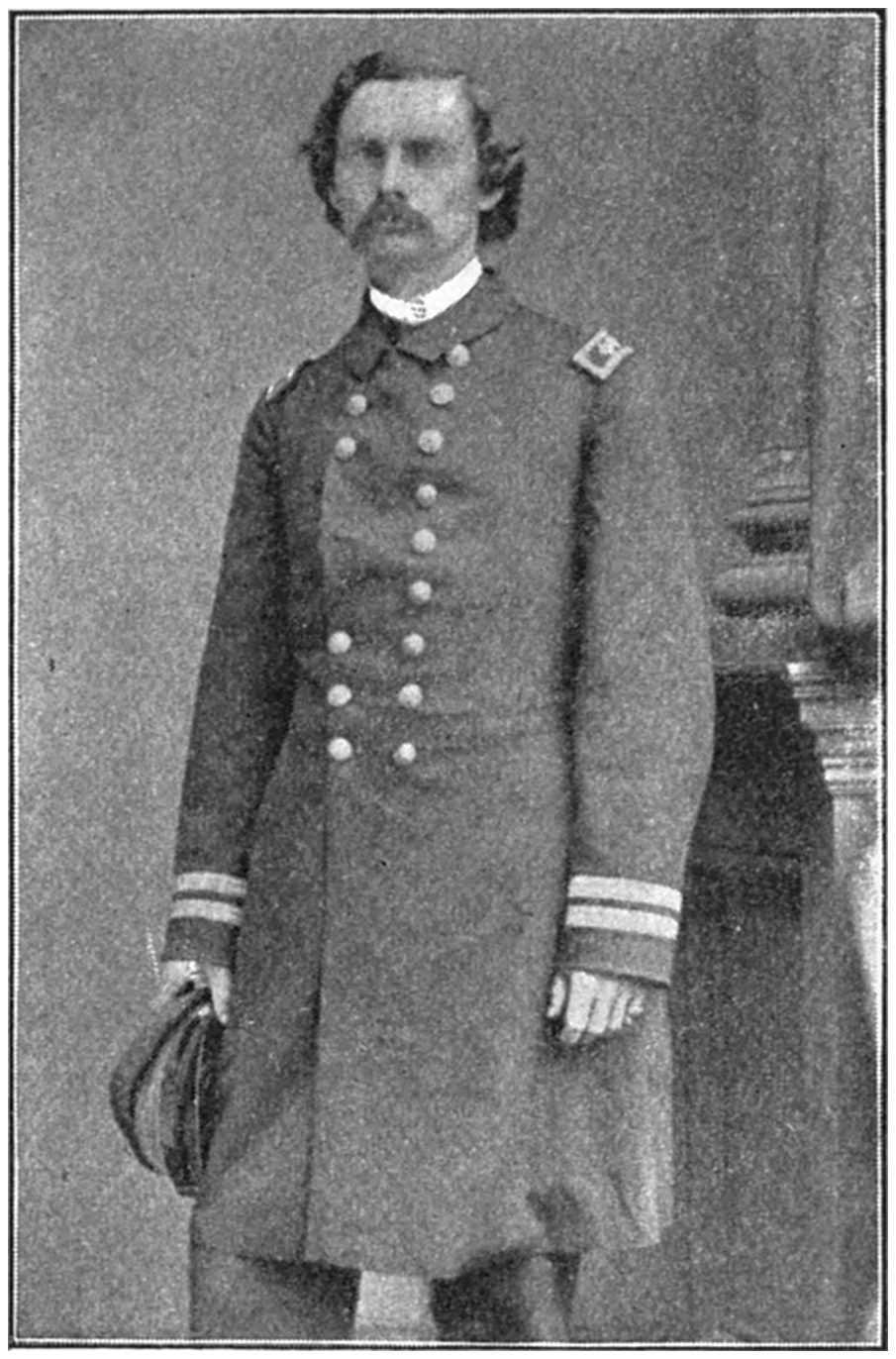
George U. Morris.
From a photograph owned by Mr. C. B. Hall.
From the Cumberland the Merrimac turned to the government batteries on shore, which were silenced for brief intervals, and then she began on the Congress. Lieut. Joseph B. Smith was in command that day. Seeing the fate of the Cumberland, he made sail to fly toward Fortress Monroe, but unfortunately grounded. Two Confederate gunboats that had come with the Merrimac got under the stern of the Congress and opened a hot fire where only two guns would bear on them, and then finally came the Merrimac to take a raking position at a distance of 150208 yards. She could not use the ram because the water was shoal, but her powerful battery knocked the guns of the Congress to pieces and “searched the ship.” Just before the last stern gun was disabled the powder cartridges ceased coming to it. The division lieutenant went to learn why. “After my eyes became a little accustomed to the darkness and the sharp smoke from burning oak,” he wrote, “I saw that the line of cooks and wardroom servants stationed to pass full boxes had been raked by a shell, and every one of them either killed or wounded.” For an hour the crew of the Congress stood to their guns, and then, Lieutenant Smith having been killed, and the ship being on fire in several places, Lieut. Austin Pendergrast hoisted a white flag.
Meantime the flagship Roanoke had sent the Minnesota over toward Newport News to attack the Merrimac, and had herself followed with the St. Lawrence. But only the Minnesota got near enough to fight. The other two “very prudently ran aground not far from Fortress Monroe.”
“As soon as the Congress surrendered, Commander Buchanan ordered the gun-boats Beaufort and Raleigh to steam alongside, take off her crew, and set fire to the ship. Lieutenant Pendergrast surrendered to Lieutenant Parker, of the Beaufort. Delivering his sword and209 colors, he was directed by Lieutenant Parker to return to his ship and have the wounded transferred as rapidly as possible. All this time the shore batteries and small-arm men were keeping up an incessant fire on our vessels. Two of the officers of the Raleigh, Lieutenant Taylor and Midshipman Hutter, were killed while assisting the Union wounded out of the Congress. A number of the enemy’s men were killed by the same fire. Finally it became so hot that the gun-boats were obliged to haul off with only thirty prisoners, leaving Lieutenant Pendergrast and most of his crew on board, and they all afterward escaped on shore by swimming or in small boats. While this was going on, the white flag was flying at her mainmast-head. Not being able to take possession of his prize, the commodore ordered hot shot to be used, and in a short time she was in flames fore and aft. While directing this, both himself and his flag-lieutenant, Minor, were severely wounded. The command then devolved upon Lieut. Catesby Jones.
“Our loss in killed and wounded was twenty-one. The armor was hardly damaged, though at one time our ship was the focus on which were directed at least one hundred heavy guns afloat and ashore. But nothing outside escaped. Two guns were disabled by having their muzzles shot off. The ram was left in210 the side of the Cumberland. One anchor, the smoke-stack, and the steam-pipes were shot away. Railings, stanchions, boat-davits, everything was swept clean. The flag-staff was repeatedly knocked over, and finally a boarding-pike was used. Commodore Buchanan and the other wounded were sent to the Naval Hospital, and after making preparations for the next day’s fight, we slept at our guns, dreaming of other victories in the morning.”
The quotations above are from John Taylor Wood’s story of the action, as printed in the Century Magazine, and Wood was a lieutenant on the Merrimac. There is no dispute as to the facts which he there relates. The points especially worth observing in this account are these: The government batteries on shore continued their fire at the Confederates after the Congress showed the white flag, and this fire killed friend and foe alike. The commanding officer of the Congress “was directed by Lieutenant Parker to return to his ship and have the wounded transferred,” and the Confederate “gunboats were obliged to haul off with only thirty prisoners, leaving Lieutenant Pendergrast” on the Congress. Captain Buchanan’s report of the fight says that the firing on the Confederate gunboats was “vile treachery”; and Scharf’s history says that “very great indignation was felt and expressed by the Confederates,”211 because the officers of the Congress who had surrendered did not hasten on board the last Confederate gunboat leaving the side of the surrendered ship. It says their remaining on the Congress was “to the discredit of the honor of American sailors.” Admiral Porter says, regarding Buchanan’s firing red-hot shot at the Congress when the white flag was flying and many wounded as well as the unhurt were on board, “this was certainly most inhuman, since the crew of the Congress were not responsible for the act of the troops on shore.”
It was a right fierce battle, and the things done were inevitable under the circumstances—inevitable because of the passions excited by actual conflict. If another battle of the kind be conceivable, then just such doings must follow in its wake.
In after years Secretary of the Navy Welles wrote an account of the effect this first raid of the Merrimac had upon a Cabinet meeting at Washington. Because it showed a lamentable ignorance of the real power of the ship, and because the losses of the day were wholly due to needless delays in preparing to meet the new style of warship, it is worth while quoting one paragraph from his article:
“‘The Merrimac,’ said Stanton, ‘will change the whole character of the war; she will destroy,212 seriatim, every naval vessel; she will lay all the cities on the seaboard under contribution. I shall immediately recall Burnside; Port Royal must be abandoned. I will notify the governors and municipal authorities in the North to take instant measures to protect their harbors.’ He had no doubt, he said, that the monster was at this moment on her way to Washington; and, looking out of the window, which commanded a view of the Potomac for many miles, ‘Not unlikely, we shall have a shell or cannon-ball from one of her guns in the White House before we leave this room.’ Mr. Seward, usually buoyant and self-reliant, overwhelmed with the intelligence, listened in responsive sympathy to Stanton, and was greatly depressed, as, indeed, were all the members.”
But that was not all nor the worst of the panic. Assistant Secretary of War John Tucker wrote to Commodore Vanderbilt of New York to ask “for what sum you will contract to destroy the Merrimac ... answer by telegraph, as there is no time to be lost.” Humiliating as such panics are, they must not be forgotten; they must be remembered because they are humiliating, in order that they may be avoided in future.
By the time the Congress was ablaze beyond remedy, five o’clock had come, and the ebb-tide had run so far that the Merrimac213 could not go to look after the Minnesota, which was grounded some distance off toward Fortress Monroe. Moreover, another day was coming, and to the mind of Lieutenant Jones, who now commanded, he would much better return to Sewell’s Point for the night and take the others on the first of the flood-tide next day. That he would have destroyed them at leisure next day, had no new element come into the conflict, is now unquestioned. But a new and a remarkable element—the Monitor—was at hand.
214
A COMPARISON BETWEEN THE MONITOR AND THE MERRIMAC BY THE ENGLISH STANDARD OF 1812—IT ASTONISHED THE SPECTATORS TO SEE THE TINY MONITOR’S TEMERITY—AFTER HALF A DAY’S FIRING IT WAS PLAIN THAT THE GUNS COULD NOT PENETRATE THE ARMOR—ATTEMPTS TO RAM THAT FAILED—THE MERRIMAC A-LEAK—CAPTAIN WORDEN OF THE MONITOR DISABLED WHEN THE MERRIMAC’S FIRE WAS CONCENTRATED ON THE PILOT-HOUSE—WHERE THE MONITOR’S GUNNERS FAILED—FAIR STATEMENT OF THE RESULT OF THE BATTLE—WORDEN’S FAITHFUL CREW—THE MERRIMAC DEFIED THE MONITOR IN MAY, BUT WHEN NORFOLK WAS EVACUATED SHE HAD TO BE ABANDONED AND WAS BURNED AT CRANEY ISLAND—LOSS OF THE MONITOR.
As it happened, the gunners on the Merrimac, when firing red-hot shot at the Congress, aimed high, and the shot were lodged in the upper part of the hull. The flames quickly spread over the bulwarks and up the rigging, but were slow in eating down toward the magazine. For hours the flames illuminated the whole region, while now and again a gun that had been left loaded was fired by the growing heat. It was a scene that attracted thousands of eyes ashore and afloat until, soon215 after midnight, the fire arrived at the magazine, and the exploding powder hurled the huge mass of blazing timbers high in air. A thunderous roar shook all the region round about, and then “the stillness of death” followed.
But while the men on the Merrimac watched the fruition of their day’s work, one of them, a pilot, saw “a strange-looking craft brought out in bold relief by the brilliant light of the burning ship, which he at once proclaimed to be the Ericsson.” The pilot was right. The Monitor had arrived after a fearsome passage, during which the water had poured in through the hawse-pipe where the anchor chain led, and even down the smoke-stack, until the fires were all but extinguished. The belts on the fans got wet, so that it was not possible to keep up the draft, and the engineers and firemen were all but suffocated. The water dashed through the lookout slats of the pilot-house with such force as to knock the pilot over the wheel. The water gained in the hold until there was imminent danger of sinking. Nevertheless, it was an offshore wind, and the tug that went with her got her inshore, where the water was quiet, and at 4 o’clock on the afternoon of Saturday, March 8th, she passed in at Cape Henry and headed north for Hampton Roads. She was commanded by Capt. J. L. Worden, with Lieut. S. D. Greene as216 executive officer, and A. C. Stivers and Isaac Newton as chief and first assistant engineers. The roar of the guns of the Merrimac as she fired hot shot into the Congress twenty miles away, fell upon the ears of the Monitor’s crew, and the ship was at once cleared for action. After a little they “could see the fine old Congress burning brightly, and soon a pilot came on board to tell the direful news.” The Monitor was then driven at full speed to the Roanoke, where Flag Officer Marston directed her to go to the assistance of the Minnesota, then aground not far from the scene of the day’s conflict. In doing this Marston disobeyed orders he had received from Washington to the effect that the Monitor was to be sent there, presumably to protect the capital; and this is to be remembered because it shows that the authorities at Washington were as loath to trust in aggressive warfare in 1862 as they were in 1812 when they ordered Hull to keep the Constitution in Boston harbor.
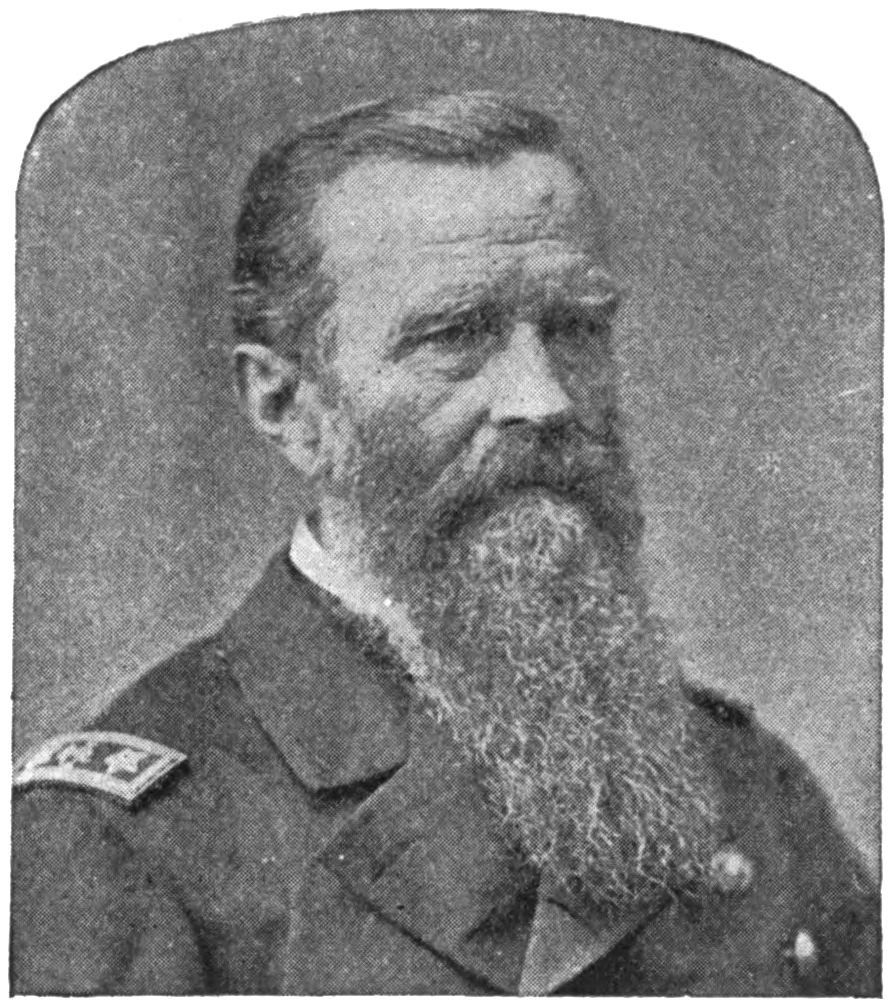
J. L. Worden.
From a photograph.
217
Steaming over to where the Minnesota lay, the Monitor came to anchor, an officer reported on board the big frigate, “and then all on board [the Minnesota] felt that we had a friend that would stand by us in our hour of trial.” So wrote Captain Van Brunt of the Minnesota.
How far this confidence was justified was proved by the event of the next day; but when one contrasts the apparent power of the two ships as they lay that night, the one at Sewell’s Point and the other at Newport News, the chance of the Monitor’s accomplishing anything seems very remote. Consider her guns. They were eleven inches in bore, but ten-inch shot had been fired at the Merrimac for hours that day without effect. The Minnesota fired seventy-eight solid ten-inch shot and 169 solid nine-inch shot, with full service charges of powder, at the Merrimac during the two days’ fighting. Only a few of these were fired on Saturday, but the Congress and the Cumberland had fired shot a-plenty of that size at her, and none had hurt her massive walls. The eleven-inch shot of the Monitor was not so much heavier that her crew could be confident of piercing the armor where the ten-inch had failed utterly. The eleven-inch solid shot used weighed from 170 to 180 pounds, the ten-inch about forty pounds less.218 Moreover, the Monitor had but two guns to the ten of the Merrimac. The weight of the Merrimac’s broadside of five guns is not given in any of the authorities known to the writer, but her three Dahlgrens fired 270 pounds, her small rifle at least forty-five more, and, with one pivot counted in, the whole discharge was 465 pounds, or more than double that of the Monitor. The Monitor’s crew numbered fifty-eight, all told, while the Merrimac carried 320. Certainly if one may judge by the standards set up in English literature on the War of 1812, these differences in numbers of crews and weights of broadsides would make the result a foregone conclusion. Nor is that all to be said about the crews, for the men on the Merrimac had had their usual rest and food, while the crew of the Monitor had had scarcely a wink of sleep since leaving New York, and it had been impossible to make a fire in the galley and cook their food. They were served with food that night, but no one slept. “The dreary night dragged slowly on; the officers and crew were up and alert, to be ready for any emergency.” At daylight the Confederate ships were seen at anchor off Sewell’s Point, and at 7.30 o’clock they left their anchorage and headed across toward Newport News to begin anew their destruction of the Government ships.
219
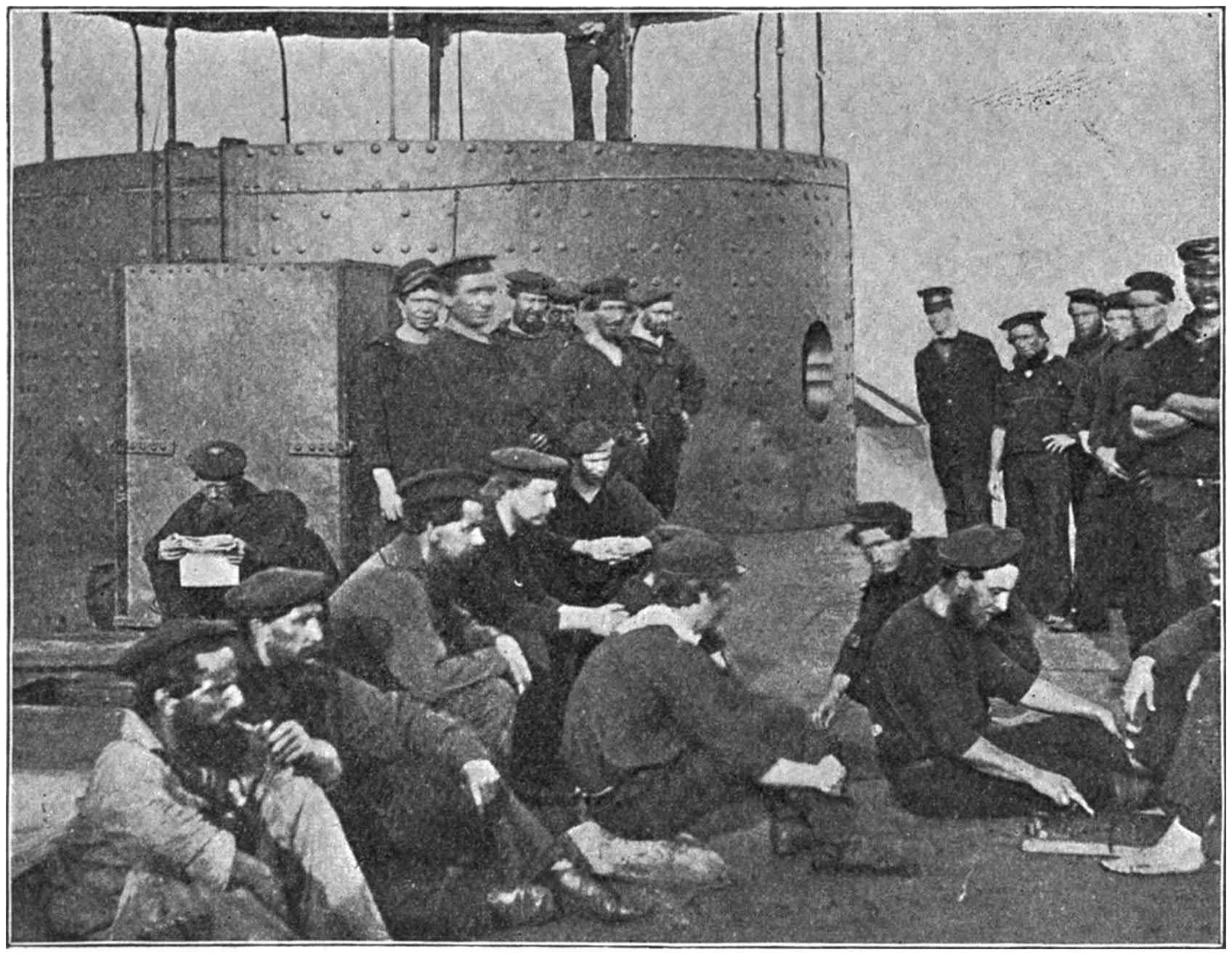
Deck View of the Monitor and her Crew.
From a photograph.
“At the same time the Monitor got under way, and her officers and crew took their stations for battle,” Captain Worden going into the pilot-house with Quartermaster Peter Williams, who was to handle the wheel, and Pilot Howard to tell the route. These three filled the little coop, that rose just four feet above the deck. Lieutenant Greene went to the turret with “sixteen brawny men, eight to each gun.” Engineer Stivers also entered the turret to assist in handling the machinery turning it, and Acting Master L. N. Stodder was there as second in command. Newton220 had charge of the engines. The most important man in the ship that day was Greene, for it was his duty to aim and fire the guns.
Something like an hour passed, after the Merrimac left her anchorage, before she arrived in range of the government ships, but when yet a mile away she opened with her big bow rifle on the Minnesota. The Monitor had waited for her, and now, as the first shot was fired, headed straight at her. It astonished the hosts of spectators to see the tiny steamer taken directly alongside her huge antagonist. As she ranged up in place, her engine was stopped, and Worden, stooping over a speaking-tube that led to the turret, shouted the order:
“Commence firing!”
The crew in the turret triced up the shutter that covered the port, ran the gun out as far as it would go, and then Lieutenant Greene, taking deliberate aim at the broad but sloping wall, pulled the lock-string. The shot struck its target with a resounding crash, split and broke the iron plates in its path and bounded clear. The Merrimac replied with a broadside, and every shot struck the revolving turret, but all without exception bounded away harmless. “A look of confidence passed over the men’s faces in the turret,” and with good will they fell to the work of reloading221 the gun, while Greene ran out the other one and fired as before.
The most important naval battle in the history of the world was fairly on. “Never before was anything like it dreamed of by the greatest enthusiast in maritime war.”
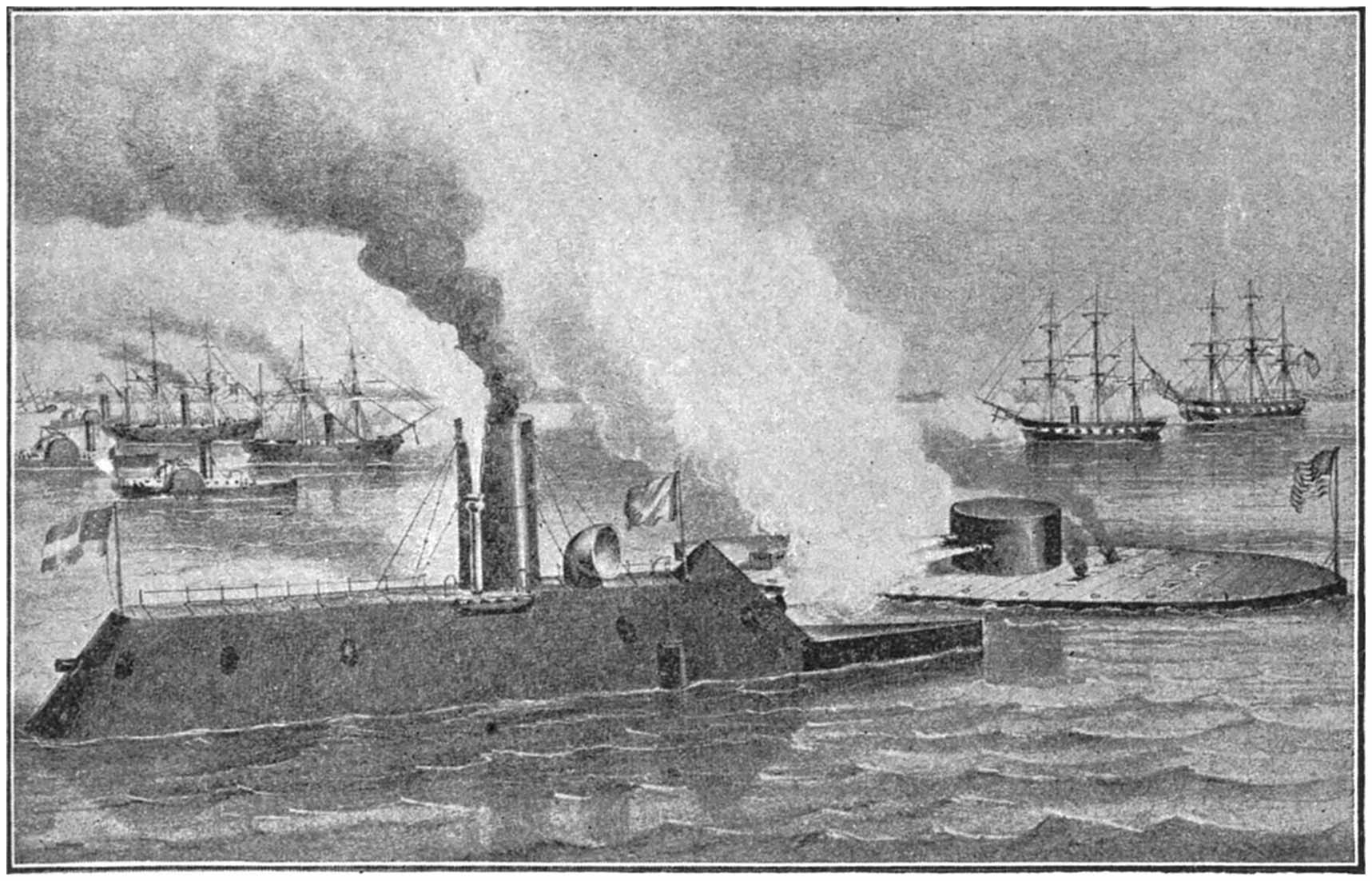
The Fight between the Merrimac and the Monitor.
From a lithograph published by Currier & Ives.
With deliberation the crews on both sides worked their guns. The Monitor fired a gun in seven or eight minutes, and the Merrimac for a time made an average of a gun once in less than three minutes. But the Monitor, having a revolving turret, could easily direct her guns at the Merrimac, while the latter, huge and unwieldy and with narrow ports, had to trust to the fortunes of the battle for222 a chance to get a good aim at her tiny opponent.
Standing in the little pilot-house, Captain Worden peered through the chinks left for eye-holes between the iron logs of which it was built. He saw that the shot first fired against the broad wall of the Merrimac bounded away without doing material harm, so he lessened the range—laid the Monitor so close beside her that an active man might have leaped from ship to ship. Still the Monitor’s shot failed to penetrate, and he then went cruising to and fro, seeking a vulnerable point, but finding none, although a single well-directed shot would have sunk the Merrimac out of sight. Failing in this, Worden made a dash at the stern of the Merrimac, hoping to disable her rudder or screw. He missed the mark, it is said, by the narrow margin of two feet. Then the speaking-tube leading to the turret broke, and the purser and the surgeon were stationed to pass the orders of the captain. The interior of the turret became filled with smoke, and the walls and deck were covered with the grime of battle. A painted mark which had been laid to enable the turret’s crew to tell which side was starboard and which port, was obliterated. The turret’s crew were shut in and unable to learn, save with great difficulty, the bearing of the enemy. The machinery223 that turned the turret was not quite equal to the work; “it was hard to start and harder to stop when once agoing.” Greene was obliged to fire from a moving turret, and the intervals between shots were lengthened.
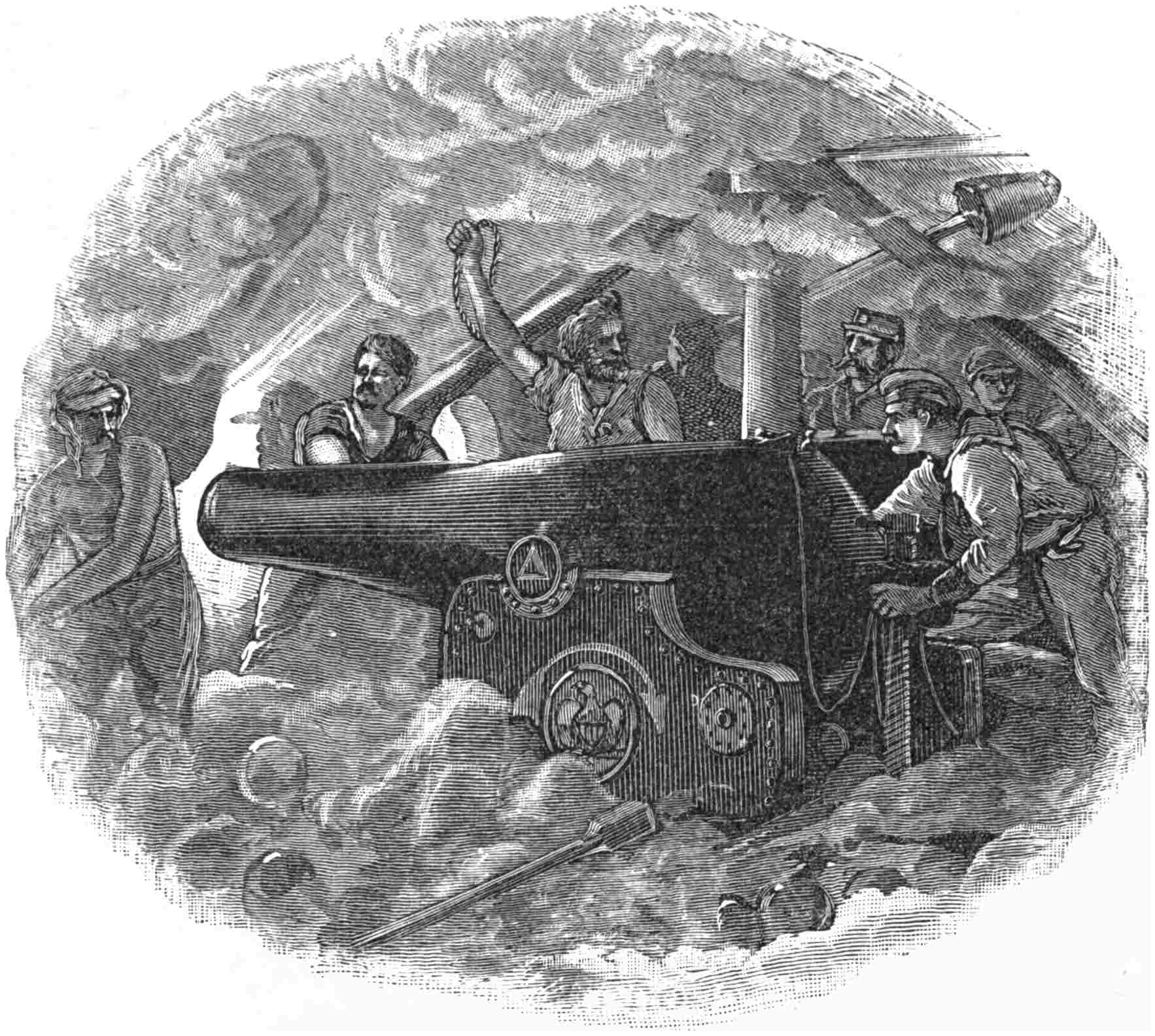
But over on the Merrimac matters were in quite as bad a condition. The “ship was working worse and worse. The smoke-stack was carried away, and the steam went down. Twice she grounded, while the Monitor, having but a little more than half her draft, played224 around her.” And even the shot from the big rifles made no impression on the turret of the Monitor. Lieutenant Jones, on going to one part of the gun-deck, found the men standing idle.
“‘Why are you not firing?’ he said to the lieutenant in charge.
“‘Why, our powder is very precious,’ replied the lieutenant, ‘and after two hours I find that I can do her about as much damage by snapping my thumb at her every two and a half minutes.’” So says Wood, already quoted.
At this, Jones determined to ram the Monitor, and for an hour manœuvred for a position before he was able to order, “Go ahead full speed!” Even then he failed because the watchful Worden gave the handy little Monitor a turn, and the Merrimac struck a glancing blow that did not hurt the Monitor, but it opened up her own bow, making an “alarming leak.” The leak was temporarily plugged, but it had its effect on the fortunes of the day, later on.
As the Merrimac sheered past the Monitor when trying to ram her, the Monitor fired while the ships’ sides were touching. The shot struck at right angles, and not only broke the armor-plates, but bulged in the wood backing from two to three inches. The concussion made the men in the immediate225 vicinity bleed at the nose and ears. It happened on the Monitor that a shot which struck the turret about that time disabled Mr. Stodder, but he was thoughtlessly leaning against the turret wall. These were the most effective shots fired on either side during about six hours of steady fighting. The crew of the Merrimac were ordered to board the Monitor at this time, but the ships drifted apart before it could be tried.
Meantime the Merrimac had been making occasional efforts to get at the vulnerable Minnesota. She had fired not a few shots at her from the off-side battery. One shot exploded the boiler of the tug Dragon alongside, and others made havoc on board the big ship. The Minnesota replied as well as her situation permitted, but without effect.
And then the end came when the commander of the Merrimac so far appreciated the condition of affairs as to order his gunners to concentrate their fire on the Monitor’s pilot-house. The result was paralyzing. A shell fired at a range of ten yards struck and burst against a lookout slot through which Captain Worden was gazing. Flaming grains of powder and shreds of iron were driven into his face and eyes. It knocked him across the pilot-house, and blinded and wholly disabled him.
The force of the explosion lifted a loose226 plate that lay on top of the pilot-house, and let in a flood of light. This “caused Worden, blind as he was, to believe that the pilot-house was seriously injured, if not destroyed; he therefore gave orders to put the helm to starboard and sheer off.” “The Monitor retired temporarily from the action in order to ascertain the extent of the injuries she had received.” Worden was helped down from the pilot-house, and Greene was sent for. He found Worden, “a ghastly sight, with his eyes closed and the blood apparently pouring from every pore in the upper part of his face.” Greene helped him to a sofa, where the doctor took charge of him. He believed himself dangerously hurt, but did not lose his fortitude. Greene then went to the pilot-house and took command.

The Action between the Monitor and the Merrimac.
From an engraving of the picture by Chappel.
During the time that was needed by this change of commanders the Monitor was heading toward Fortress Monroe. Captain Van Brunt “thought it probable she had exhausted her supply of ammunition, or sustained some injury.” Lieutenant Jones and his officers on the Merrimac very naturally supposed that the Monitor had given up the contest. Jones says:
“We for some time awaited the return of the Monitor to the Roads. After consultation it was decided that we should proceed to the229 navy-yard in order that the vessel should be brought down in the water and completed. The pilots said if we did not then leave that we could not pass the bar until noon of the next day. We therefore at 12 M. quit the Roads and stood for Norfolk. Had there been any sign of the Monitor’s willingness to renew the contest we would have remained to fight her.”
Lieutenant Greene, of the Monitor, says of this matter:
“Exactly how much time elapsed from the moment that Worden was wounded until I had reached the pilot-house and completed the examination of the injury at that point, and determined what course to pursue in the damaged condition of the vessel, it is impossible to state; but it could hardly have exceeded twenty minutes at the utmost. During this time the Merrimac, which was leaking badly, had started in the direction of the Elizabeth River; and, on taking my station in the pilot-house and turning the vessel’s head in the direction of the Merrimac, I saw that she was already in retreat. A few shots were fired at the retiring vessel, and she continued on to Norfolk. I returned with the Monitor to the side of the Minnesota, where preparations were being made to abandon the ship, which was still aground. Shortly afterward Worden was230 transferred to a tug, and that night he was carried to Washington.”
Undoubtedly fair is the statement made by Lieut. John Taylor Wood:
“Although there is no doubt that the Monitor first retired,—for Captain Van Brunt, commanding the Minnesota, so states in his official report,—the battle was a drawn one, so far as the two vessels engaged were concerned. But in its general results the advantage was with the Monitor.”
The italics are not in Lieutenant Wood’s statement, but are inserted here to emphasize the effect of what he says. Greene adds:
“It has never been denied that the object of the Merrimac on the 9th of March was to complete the destruction of the Union fleet in Hampton Roads, and that in this she was completely foiled and driven off by the Monitor; nor has it been denied that at the close of the engagement the Merrimac retreated to Norfolk, leaving the Monitor in possession of the field.”
The reader is likely to think that “retreat” is a strong word to use under the circumstances, especially as the ebb-tide and not the Monitor made the Merrimac leave. Nevertheless, there was also the leak in the Merrimac’s bow to be considered. That leak was “alarming,” according to Jones, and the Merrimac231 got it in battle by ramming the Monitor.
But while the controversy over the result of the battle is interesting, it is in no sense practical. It is certain that neither crew was whipped, whatever happened to the ships. The bravery on both sides must excite the pride of every American. But the one point of the battle that is of practical consideration is the gunnery.
Says Lieutenant Wood: “The Monitor was well handled, and saved the Minnesota and the remainder of the fleet at Fortress Monroe. But her gunnery was poor. Not a single shot struck us at the water-line, where the ship was utterly unprotected, and where one would have been fatal. Or had the fire been concentrated on any one spot, the shield would have been pierced; or had larger charges been used, the result would have been the same.” Here are statements of fact that ought never to be forgotten. The haymakers of the lost Wasp came back from the mists in which they disappeared to mock at the gunnery displayed in the Civil War, and especially in this battle, for they, in a battle at night, laid their guns by the sissing line of foam cast off by the Avon’s bow, and so struck the water-line and sank the ship in spite of the utmost efforts of three crews to save her.
232
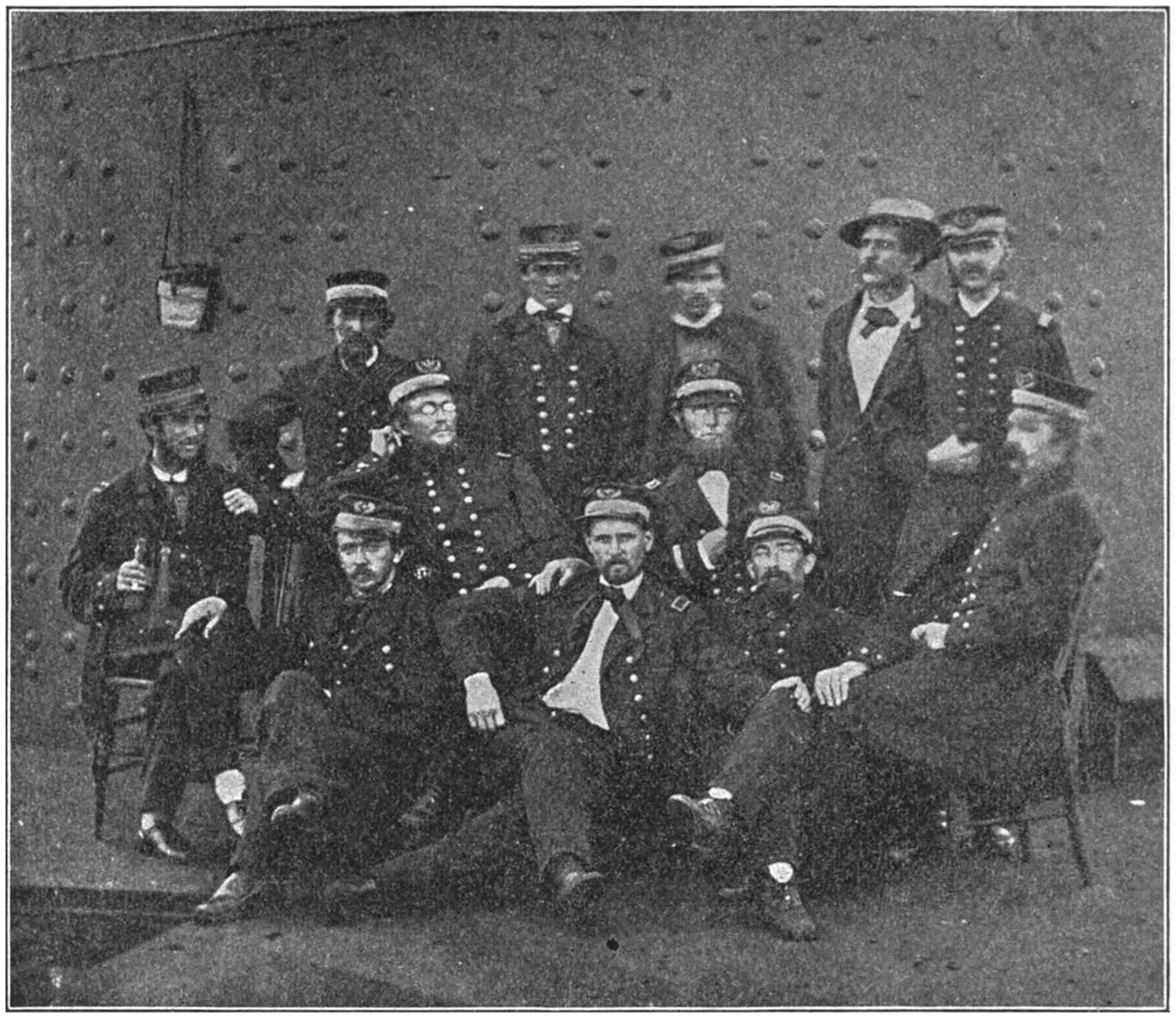
Group of Officers on Deck of the Monitor.
From a photograph.
In her battle with the Monitor the Merrimac was floating with her unarmed bow, seventy feet long, more than a foot out of water, instead of a-wash, as was originally intended. Had one shot from the Monitor struck the Merrimac at the water-line’s junction with the armor, she would have gone down. And yet Greene elevated instead of depressing his guns. The gunnery of the Merrimac was better than that of the Monitor, for it was concentrated at the last on a vulnerable point—the233 pilot-house—and so Worden was disabled (he was the only one badly hurt in this fight), and the Monitor, for the time, was driven away. The battle between the Monitor and the Merrimac did not result in a glorious victory, but it was an unparalleled lesson in naval warfare.
As a part of the history of the two famous ironclads, and as a portrayal of the heart of the typical naval seaman of that day, the following letter, written to Captain Worden while he was under the surgeon’s care in Washington, must be given:
“To Captain Worden.
“Hampton Roads, April 24th, 1862.
“U. S. Monitor.
“To our Dear and Honored Captain.
“Dear Sir: These few lines is from your own crew of the Monitor, with their kindest Love to you their Honored Captain, hoping to God that they will have the pleasure of welcoming you back to us again soon, for we are all ready able and willing to meet Death or anything else, only give us back our Captain again. Dear Captain we have got your Pilot-house fixed and all ready for you when you get well again; and we all sincerely hope that soon we will have the pleasure of welcoming you back to it.... We are waiting very patiently to engage our Antagonist if we could only get a chance to do so. The last time she came out we all thought we234 would have the Pleasure of sinking her. But we all got disappointed for we did not fire one shot and the Norfolk papers says we are cowards in the Monitor—and all we want is a chance to show them where it lies with you for our Captain We can teach them who is cowards. But there is a great deal that we would like to write to you but we think you will soon be with us again yourself. But we all join in with our kindest love to you, hoping that God will restore you to us again and hoping that your sufferings is at an end now, and we are all so glad to hear that your eyesight will be spaired to you again. We would wish to write more to you if we have your kind Permission to do so but at present we all conclude by tendering to you our kindest Love and affection, to our Dear and Honored Captain.
“We remain untill Death your Affectionate Crew
“The Monitor Boys.”
The stories of the Monitor and the Merrimac may soon be completed. The Merrimac was overhauled at Norfolk. Commodore Josiah Tattnall relieved Admiral Buchanan in command. On the 11th of April he took the Virginia (Merrimac) down to Hampton Roads, expecting to have a desperate encounter with the Monitor. “Greatly to our surprise, the Monitor refused to fight us. She closely hugged the shore under the guns of235 the fort, with her steam up. Hoping to provoke her to come out, the Jamestown was sent in, and captured several prizes, but the Monitor would not budge.” That is from a Confederate account, and it is truthful. The Monitor was under strict orders from Washington not to engage the Merrimac unless forced to do so. A great fleet, that included a number of vessels which were supposed to be able to sink the Merrimac by ramming, had gathered at Hampton Roads. Commodore Goldsborough was in command of the fleet. The prizes mentioned, two brigs and a schooner, were taken from Newport News and in plain sight of the fleet. Professor Soley’s history says very truly that this incident was “humiliating.” For about a month after that nothing was done, but “on the 8th of May a squadron, including the Monitor, bombarded our batteries at Sewell’s Point. We immediately left the yard for the Roads. As we drew near, the Monitor and her consorts ceased bombarding, and retreated under the guns of the forts, keeping beyond the range of our guns. Men-of-war from below the forts, and vessels expressly fitted for running us down, joined the other vessels between the forts. It looked as if the fleet was about to make a fierce onslaught upon us. But we were again to be disappointed. The Monitor and the other236 vessels did not venture to meet us, although we advanced until projectiles from the Rip Raps fell more than half a mile beyond us. Our object, however, was accomplished; we had put an end to the bombardment, and we returned to our buoy.”
As the reader observes, this is also a Confederate account. Commodore Goldsborough’s report says, on the contrary, that “the Merrimac was more cautious than ever”; and that the “Monitor was kept well in advance so that the Merrimac could have engaged her without difficulty had she been so disposed.” But the unprejudiced reader will say that a Farragut was needed at the head of the Union force.
The Merrimac remained unmolested until government operations ashore compelled the Confederates to evacuate Norfolk and the battery at Sewell’s Point. Tattnall wished to retreat with the Merrimac up the James River, but his pilots said it could not be done, and accordingly, on the night of May 10, 1862, he ran her ashore “in the bight of Craney Island,” not far from where he had, as a midshipman in his teens, led the sortie from the little fort built there to keep the British from Norfolk—led the sortie that drove the boastful Pechell’s men helter-skelter back to their ships. On Craney Island he fired the Merrimac and237 retreated ashore, leaving her to blow up on the morning of the 11th at 5 o’clock.
The Monitor lasted a few months longer. She was ordered to Beaufort, North Carolina, in tow of the Rhode Island, and sailed from Hampton Roads on the afternoon of December 29, 1862. The Passaic, in tow of the State of Georgia, went along. On the morning of January 2d a long swell set in with a wind that grew to a gale, and just before midnight she foundered, although not until all but sixteen of her crew were saved.
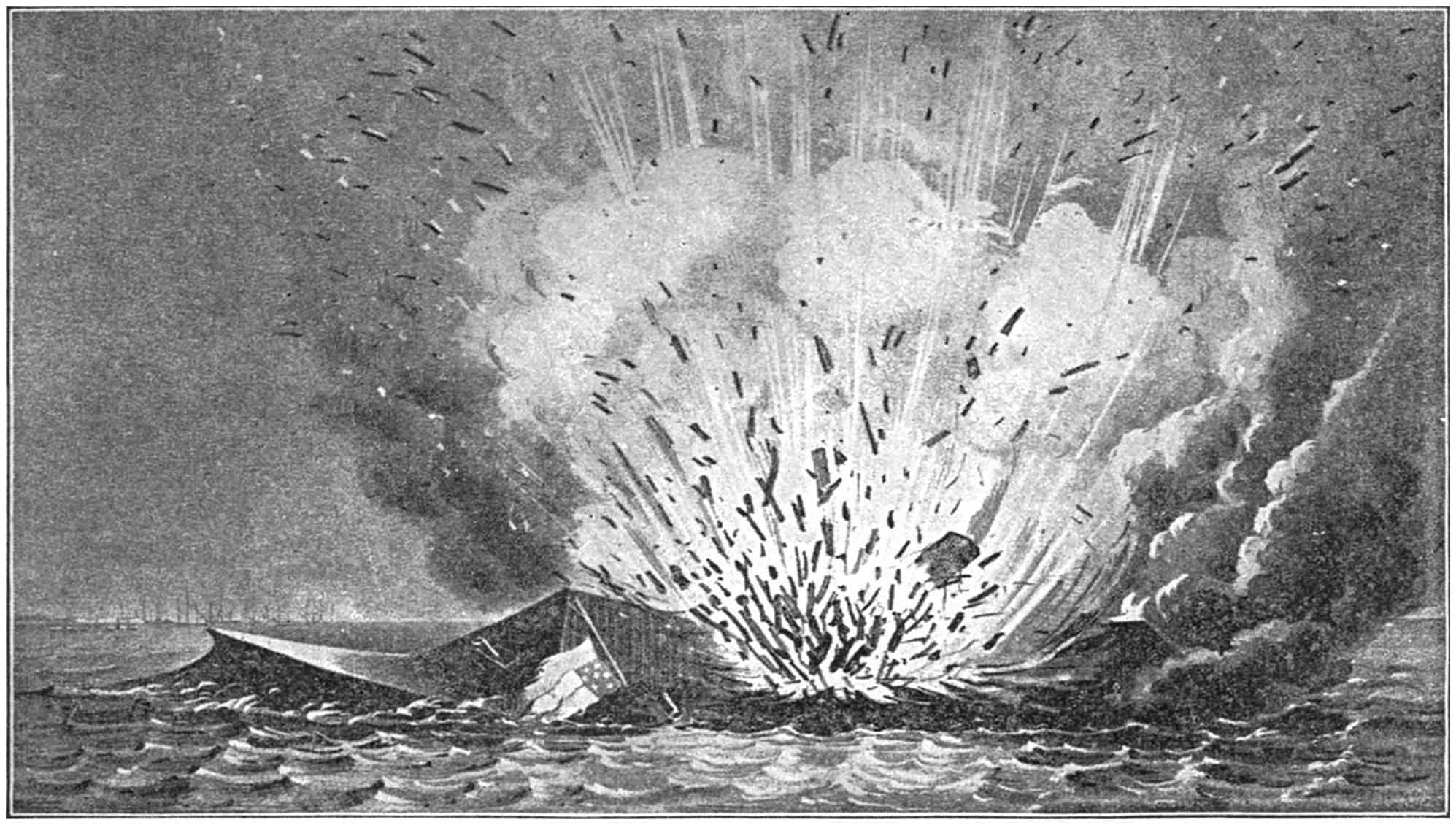
Destruction of the Merrimac off Craney Island.
From a lithograph published by Currier & Ives.
If the reader would know the effect of this fight on the navies of the world, let him compare the best ships afloat in 1860—the old-style238 ships with lofty masts and swelling canvas—with the latest designs of battle-ships. For the old frigates all disappeared, one may say, when the Cumberland went, and the turreted floating fort has followed in the wake of the Monitor.
239
CREATING A FLEET FOR THE OPENING OF THE WATER ROUTE ACROSS THE CONFEDERACY—IRONCLADS THAT WERE NOT SHOT-PROOF, BUT FAIRLY EFFICIENT NEVERTHELESS—GUNS THAT BURST AND BOILERS THAT WERE SEARCHED BY SHOT FROM THE ENEMY—WHEN GRANT RETREATED AND WAS COVERED BY A GUNBOAT—FIRST VIEW OF TORPEDOES—CAPTURE OF FORT HENRY—A DISASTROUS ATTACK ON FORT DONELSON—WHEN WALKE BRAVED THE BATTERIES AT ISLAND NO. 10—THE CONFEDERATE DEFENCE SQUADRON AT FORT PILLOW—THE FIRST BATTLE OF STEAM RAMS—FRIGHTFUL EFFECTS OF BURSTED BOILERS—IN THE WHITE RIVER—FARRAGUT APPEARS.
In all the naval operations of the Civil War hitherto described in this history, the object had in view by the government was to strangle and starve the Confederates. The blockade and the occupation of points on the Confederate coasts had but one object, and even the capture of the Confederate agents on the Trent was intended as a part of the same work. The battle between the Monitor and the Merrimac was fought on one side to raise and on the other to maintain the blockade at Hampton Roads. The Merrimac was not seaworthy and could not have been made so.240 The Confederates had no thought of using her beyond the waters of the Chesapeake. But while the naval forces were carrying on this alongshore work with practically uninterrupted success, an aggressive movement that was to have far-reaching consequences was planned and in time carried out by the naval power. This was the opening of the Mississippi.
In the early days of the war the Confederates having erected a number of forts along the principal streams of the lower Mississippi watershed, the government army officers were of the opinion that no armed vessels would be of any use there. They thought, curiously enough, that the forts must effectually close navigation on the streams.
However, this hopeless view vanished as the importance of the navigation of those streams grew upon the minds of all interested in the conflict in that region. One has now but to glance at the map of the Mississippi Valley to understand the situation as it was then. For the Mississippi itself, below Cairo, wound its way through a course more than 1,000 miles of what was practically Confederate territory. And, then, there were the Cumberland and the Tennessee Rivers, that were navigable almost into the heart of the Confederate States, while other streams like the Red, further south, were to be considered. In241 these streams were found the cheapest and most comfortable highways for the conveyance of armed forces; but more important still was the fact that if the government controlled the Mississippi, it cut the Confederacy into two parts and shut off the supplies grown in the western part from the hungry East. An inland navy was an imperative necessity, and the War Department undertook the task of providing one.
Commander John Rodgers was ordered to report for duty to Gen. John C. Frémont, who was then in command in the Mississippi Valley, in order that he might attend to this work. His first move, like the work of the Navy Department in establishing the blockade, was to buy and arm some merchant vessels. Three that were named Taylor, Lexington, and Conestoga were obtained at Cincinnati, and converted into warships by shifting the boilers and steam-pipes into the hold and building five-inch oak bulwarks around the decks to protect the crews from musket-shots. These bulwarks were pierced with portholes, and old guns were mounted in them, navy fashion. The Taylor had seven, and the others five and three respectively, nearly all the guns being medium-length sixty-four-pounder shell guns. They had no iron armor of any kind.
242
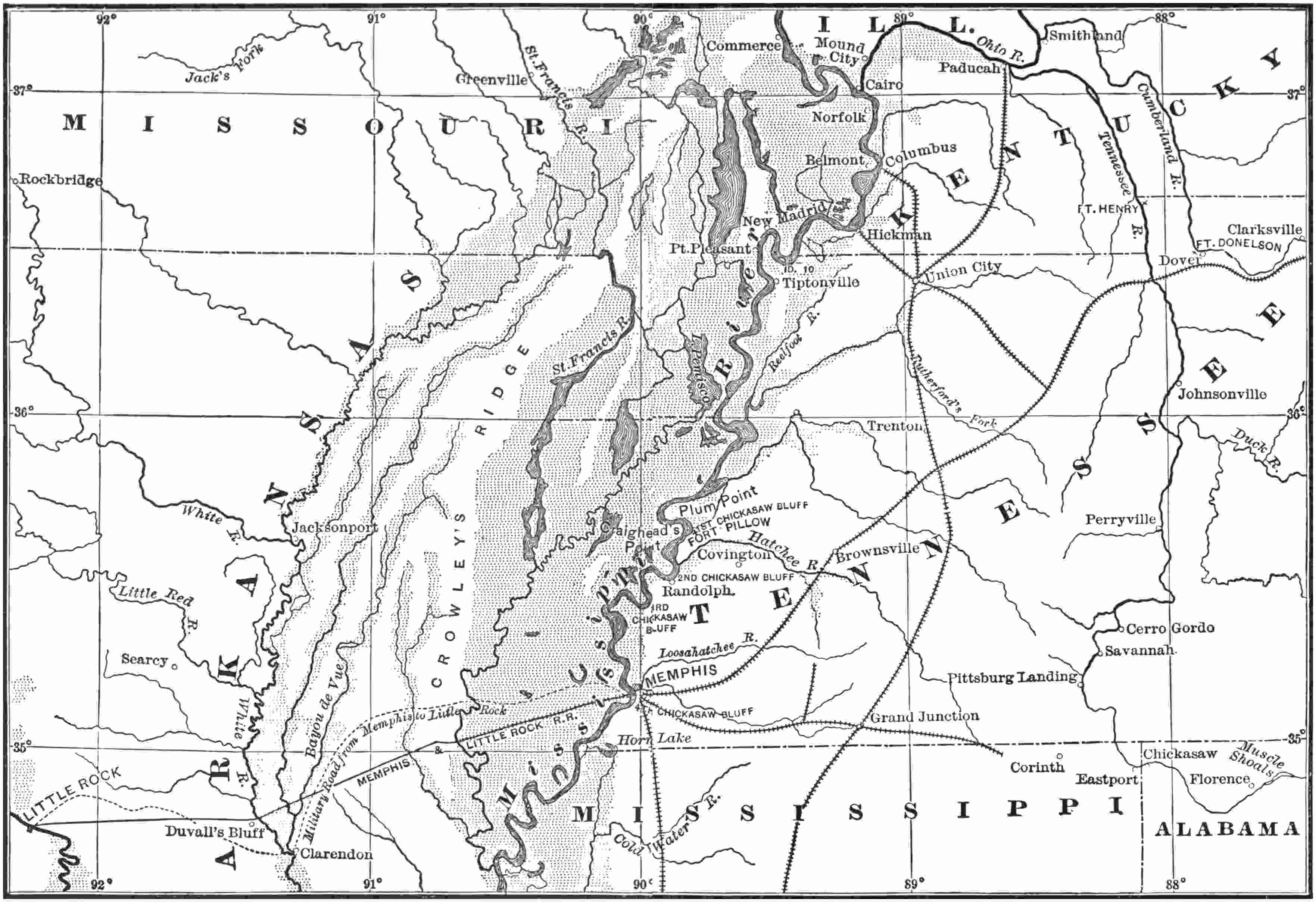
Mississippi Valley—Cairo to Memphis.
From “The Navy in the Civil War.”
In those days James B. Eads, afterwards famous as an engineer, was a river-boat builder, having his yard at Carondelet, Missouri.243 When in July, 1861, the quartermaster-general of the army advertised for bids for the construction of seven ironclad gunboats for244 service in the Mississippi Valley, Eads submitted plans, with estimates of cost and time, that were at once accepted by the government. The contracts were signed on August 7th, and it was agreed that the seven should be ready for crews and guns in sixty-five days, although the birds were teaching their young to fly among the branches of trees that were to be used in building the hulls of these vessels, and the shops that were to supply the iron were and had been idle ever since hostilities had stopped the business of the country.
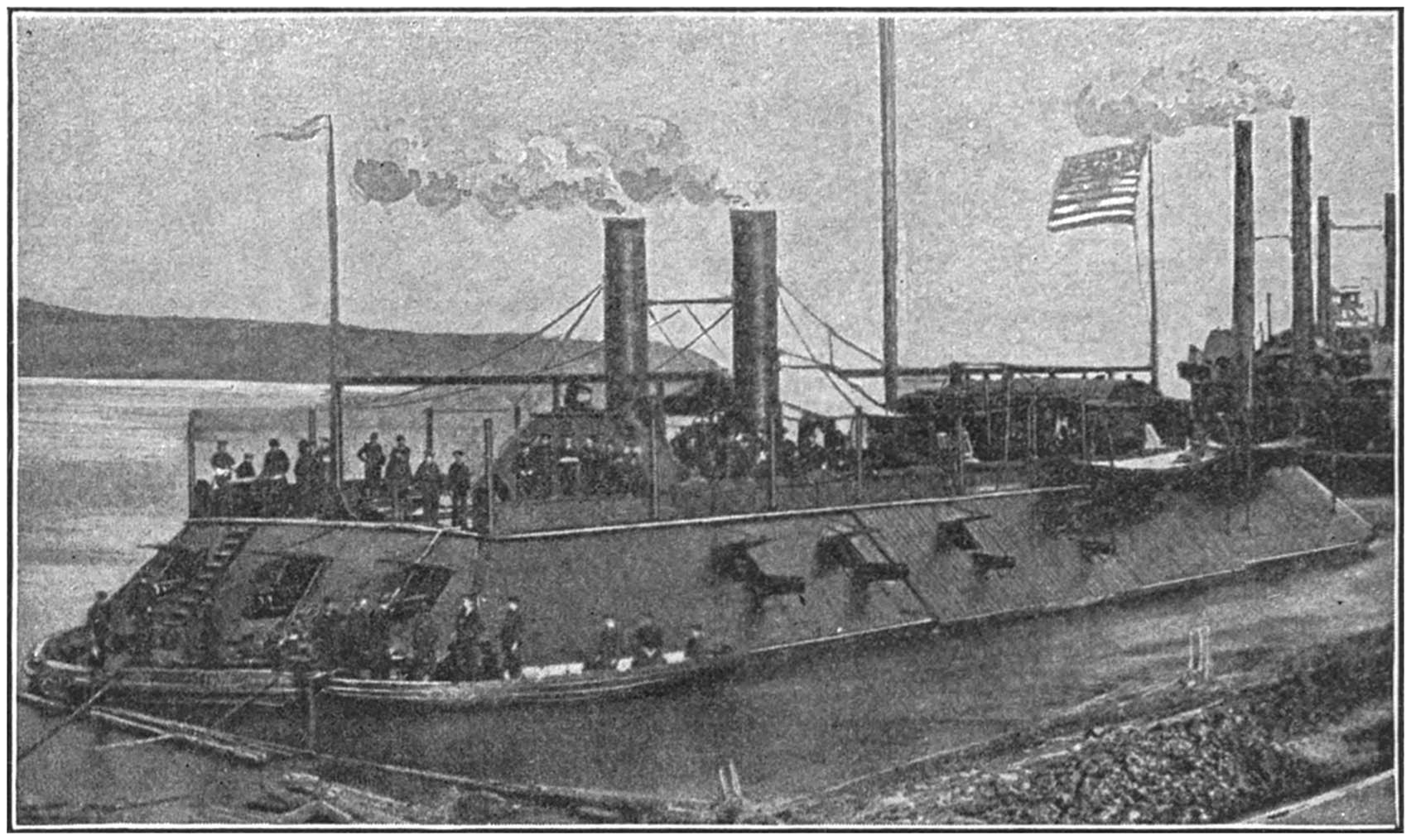
The Cairo.
From a photograph.
As the event showed, Eads was for the Mississippi what Ericsson was on the coast. He was a man of original ideas. And yet, as Porter says, “it is strange how slowly even245 the cleverest of men receive new ideas.” He built ironclads, it is true, but with the smooth water in which he was to send them afloat they might have carried a thickness of armor fit to turn the heaviest shot instead of the boiler plate that was used. As described by Eads himself, these boats “were to draw six feet of water, carry thirteen heavy guns each, be plated with two-and-a-half-inch iron, and have a speed of nine miles an hour. The De Kalb (at first called the St. Louis) was the type of the other six, named the Carondelet, Cincinnati, Louisville, Mound City, Cairo, and Pittsburg. They were 175 feet long, 51½ feet beam; the flat sides sloped at an angle of about thirty-five degrees, and the front and rear casemates corresponded with the sides, the stern-wheel being entirely covered by the rear casemate. Each gun-boat was pierced for three bow guns, eight broadside guns (four on a side), and two stern guns. Before these seven gun-boats were completed, I engaged to246 convert the snag-boat Benton into an armored vessel of still larger dimensions.”
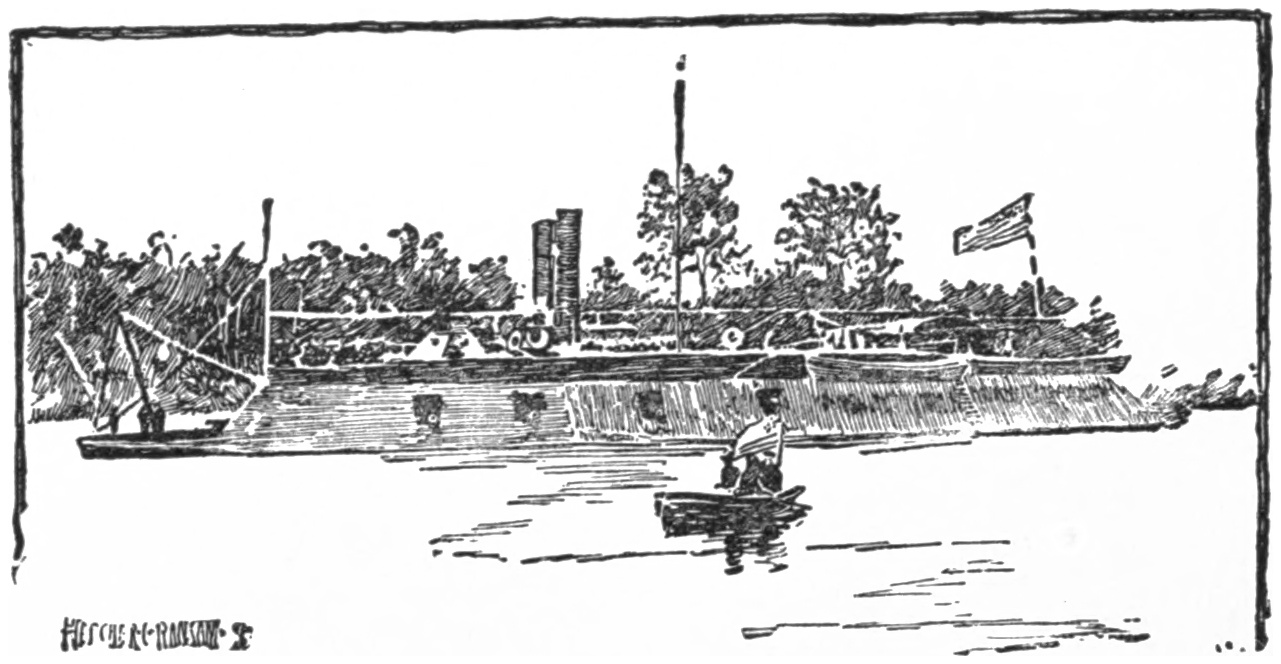
The Pittsburg.
After a photograph.
Each was propelled by a single paddle-wheel set into the stern, where it was protected by the fork-shaped hull as well as a casemate. The boats were expected to fight bow on, and the iron plate across the bow was backed by two feet of oak. On the sides opposite the boilers the iron armor was not backed save by a slender supporting frame, while the stern had neither armor nor oak wall. The pilot-house was of good oak covered with two and a half inches of iron in front and an inch less in the rear. The crews had every incentive to keep the bow of the ship toward the enemy.
“The armament was determined by the exigencies of the time. The army supplied thirty-five old forty-two-pounders, which were rifled and so threw a seventy-pound shell. These having lost the metal cut away for grooves, and not being banded, were called upon to endure the increased strain of firing rifled projectiles with actually less strength than had been allowed for the discharge of a round ball of about half the weight. Such makeshifts are characteristic of nations that do not prepare for war, and will doubtless occur again in the experience of our navy.” So says Mahan.
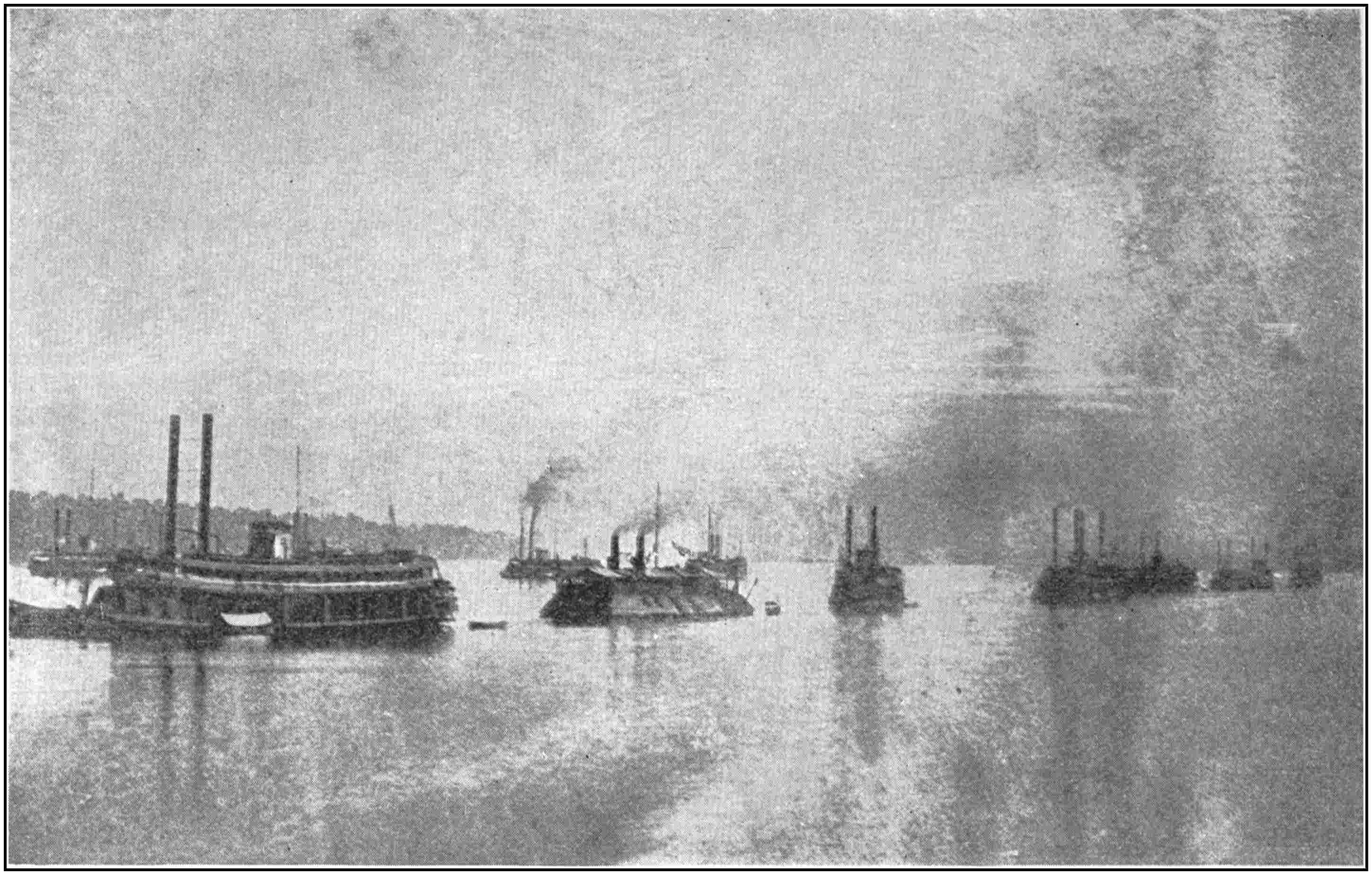
The Mississippi Fleet off Mound City, Illinois.
From a photograph owned by Mr. C. B. Hall.
The Benton had been a snag-boat—a craft249 with two hulls so joined and strengthened that she could get the largest kind of a cottonwood tree between the hulls, hoist it out of the mud, and drag it clear of the steamer channel. She had had two wheels, but one between the hulls was substituted, and the whole was built over into the semblance of an angular turtle, and armored with plates of iron three and a half inches thick, well backed with oak. She was a five-knot boat and of deep draft for the service (nine feet), but she was at that date the most powerful warship afloat, and “she went by the name of the Old War Horse.” She carried sixteen guns, of which two were nine-inch Dahlgrens.
Another vessel, like the Benton, was called the Essex, because commanded by Capt. William Porter, a son of the Porter of Essex fame. “After bearing a creditable part in the battle of Fort Henry she became separated by the batteries of Vicksburg from the upper squadron, and is less identified with its history.” She carried one ten-inch and three nine-inch guns besides several smaller ones.
Other vessels were added to this upper Mississippi squadron from time to time, but “they bore no proportionate share in the fighting. The eight (from the Eads’ yards) may be fairly called the ships of the line of battle on the Western waters.”
250
Commander John Rodgers was relieved by Flag Officer Foote on September 6, 1861. He brought a number of younger officers who were to command the ships of the new fleet while taking orders from the commanding general of that department. Among these was Commander Henry Walke, who had saved Fort Pickens at Pensacola, as already told, by disobeying orders. Walke was sent to the Taylor.
These salt-water fighters found strange materials awaiting them—ships such as they had never dreamed of in connection with war, and men from the river banks and the corn-fields who knew nothing of great guns and less, were that possible, of the restraints of naval discipline. Nevertheless, the effects of naval discipline made first-class tars out of the raw material, and the gunboats proved good enough for the occasion.
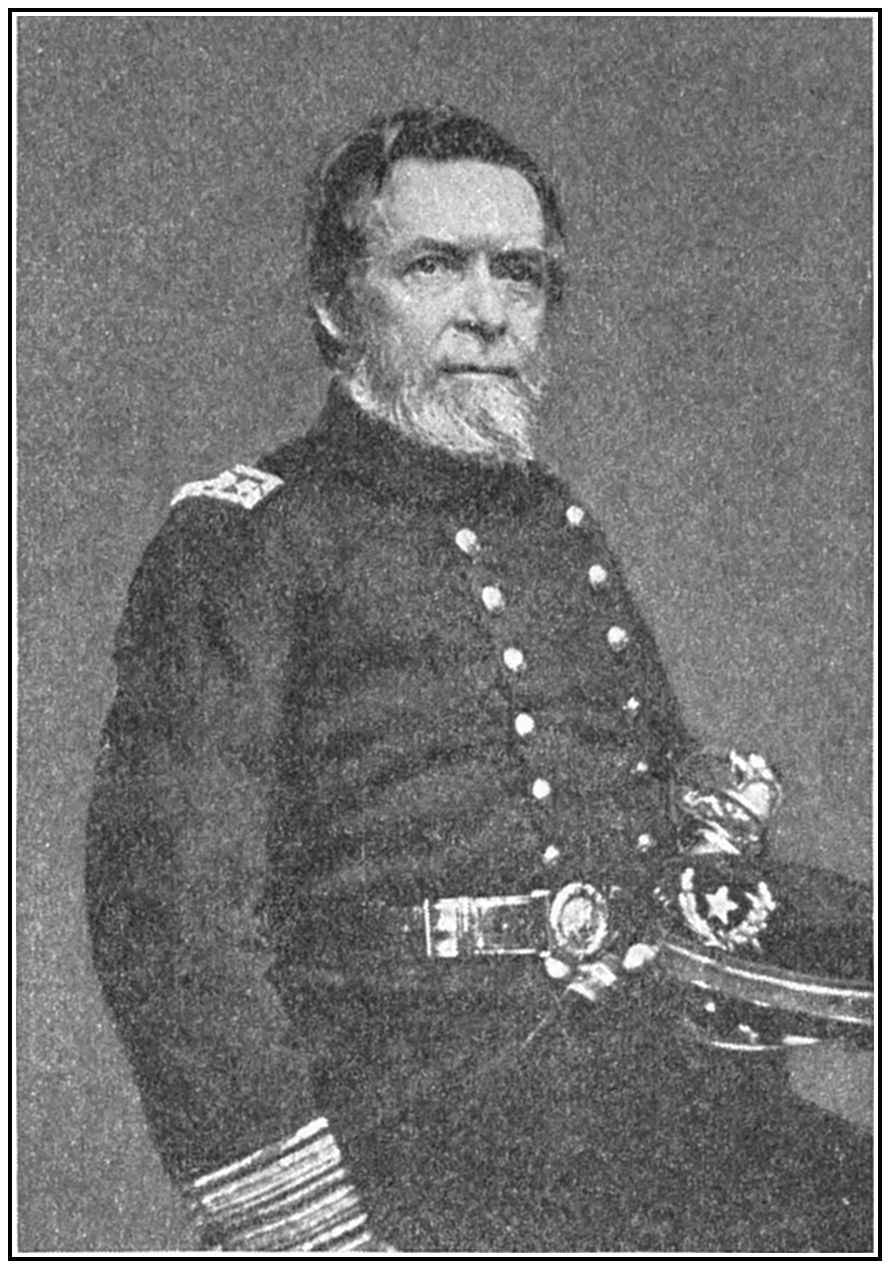
A. H. Foote.
From a photograph.
The first actual conflict between the gun-boats251 and the Confederates was on September 10, 1861, when Grant (who was then under Frémont) determined to dislodge a body of Confederates stationed on the west side of the Mississippi, eight miles below Cairo, and near Norfolk, Missouri. The Conestoga, Captain Phelps, and the Lexington, Captain Stembel, were sent down. They found the Confederates had sixteen field-pieces and a considerable body of cavalry. There was a lively bit of cannonading for a time, and two Confederate gunboats (converted river steamers) came up to join in. The Confederates’ guns were silenced, and then the government gunboats returned to Cairo.
A number of equally fruitless skirmishes followed. On November 7th there was quite a battle at Belmont, on the Missouri side of the river, opposite Columbus, Kentucky. Grant, with between 3,000 and 4,000 men, went down the river in transports convoyed by the gunboats Taylor, Captain Walke, and Lexington, Captain Phelps. They landed just out of range of the Iron Bluff forts above Columbus, and attacked the Confederates at Belmont with success, while gunboats under Walke shelled the works on the Columbus side. Although each boat might have been penetrated and its boiler exploded by a stray grapeshot, they were repeatedly carried by Walke, who was252 senior officer afloat, under the Confederate batteries. The reader should understand that taking a frail steamboat under the fire of heavy guns is a much more dangerous affair than going under fire with an old-fashioned ship with sails; for one shot could scarcely disable even a thin-walled sailing ship, but one shot into a steamer’s boiler not only disabled her, but slaughtered her crew with the steam. Walke and Phelps showed great gallantry on this occasion.
The Confederate troops were driven to their transports at first, but they rallied and were reinforced from the Columbus side of the river until they numbered about 7,000. Grant then retreated, and his troops were in some disorder, for they were yet undisciplined.
When Grant was compelled to retreat, Walke took the Taylor within a few yards of the banks where the Union troops embarked and drove off the victorious Confederates. It is not unlikely that Grant would have been captured but for Walke’s timely aid, for he was the last man to board the transports, and the Confederates were at hand in force with plenty of field-guns to sink the Union transports.

The Battle of Belmont: First Attack by the Taylor and the Lexington.
From a painting by Admiral Walke.
The next operation of importance was the capture of Fort Henry on the Tennessee River, just south of the Kentucky line. It was the255 first of the advances into the Confederate territory by way of the rivers of the West. On February 2, 1862, Flag Officer Foote assembled at Paducah, at the mouth of the Tennessee, the ironclad gunboats Essex, Capt. William D. Porter; Carondelet, Captain Walke; St. Louis, Captain Paulding; and Cincinnati, Captain Stembel; besides the three wooden gunboats Conestoga, Taylor, and Lexington to act as a reserve. Here the troops under Grant were embarked on transports, and the expedition proceeded cautiously up the river—cautiously because a boastful woman in a wayside house had told a scouting party that the ships would be blown out of water by torpedoes before passing an island just below the fort. On Tuesday, February 3d, the expedition had arrived within a few miles of Fort Henry, and the troops were landed, and a combined assault by the ironclads and the troops was ordered. But before the movement could be made, a tremendous storm came on; the river rose until the gunboats, with both anchors down, had to keep their engines going at full speed to hold their own against the tide and the flotsam.
To the impatient sailors this seemed a misfortune, but after a time they saw they were enjoying the greatest good luck, for there were full-sized trees in the flood, and these swept256 the torpedoes clear of their moorings and brought them floating down. Small boats were sent out to gather them in, and very ugly things they were—cylinders of sheet iron big enough to hold seventy-five pounds of powder, with a lock and trigger that should catch on a boat’s bottom and explode the powder.
However, on the 6th the water was low enough to permit an advance. Flag Officer Foote went to the ships to inspect the crews, and told the gunners that every shot cost the government eight dollars, so none must be wasted. They were to aim at the guns of the fort—aim, and not merely point in the direction.
Finally, the soldiers on shore waded away through the mud, and the gunboats steamed slowly up the river.
The fort they were to attack was a well-planned earthwork mounting twenty guns, but of these only eleven or twelve (accounts differ) could be brought to bear on the approaching fleet. The best of these was a sixty-pounder rifle, but a ten-inch medium-weight shell gun and two forty-two-pounders supported it, and the rest were thirty-twos. As the gunboats were to fight bows on, they could bring to bear twelve guns, of which two were nine-inch Dahlgrens, and the rest sixty-four-pounders,261 or better. The weight of metal afloat was superior, but until the days of armored ships one gun in a fort was counted equal to from three to five afloat.
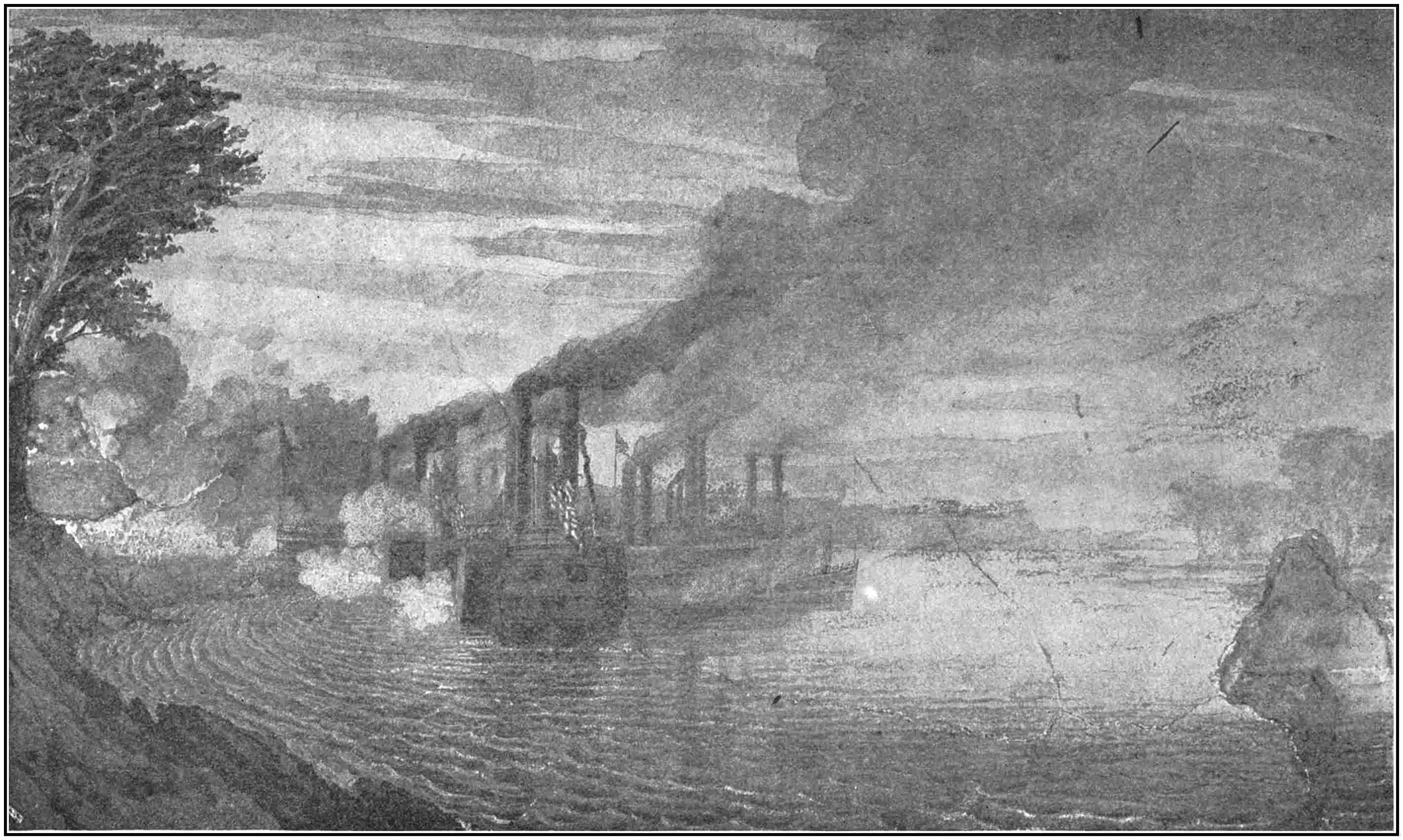
Battle of Belmont: U. S. Gunboats Repulsing the Enemy during the Debarkation.
From a painting by Admiral Walke.
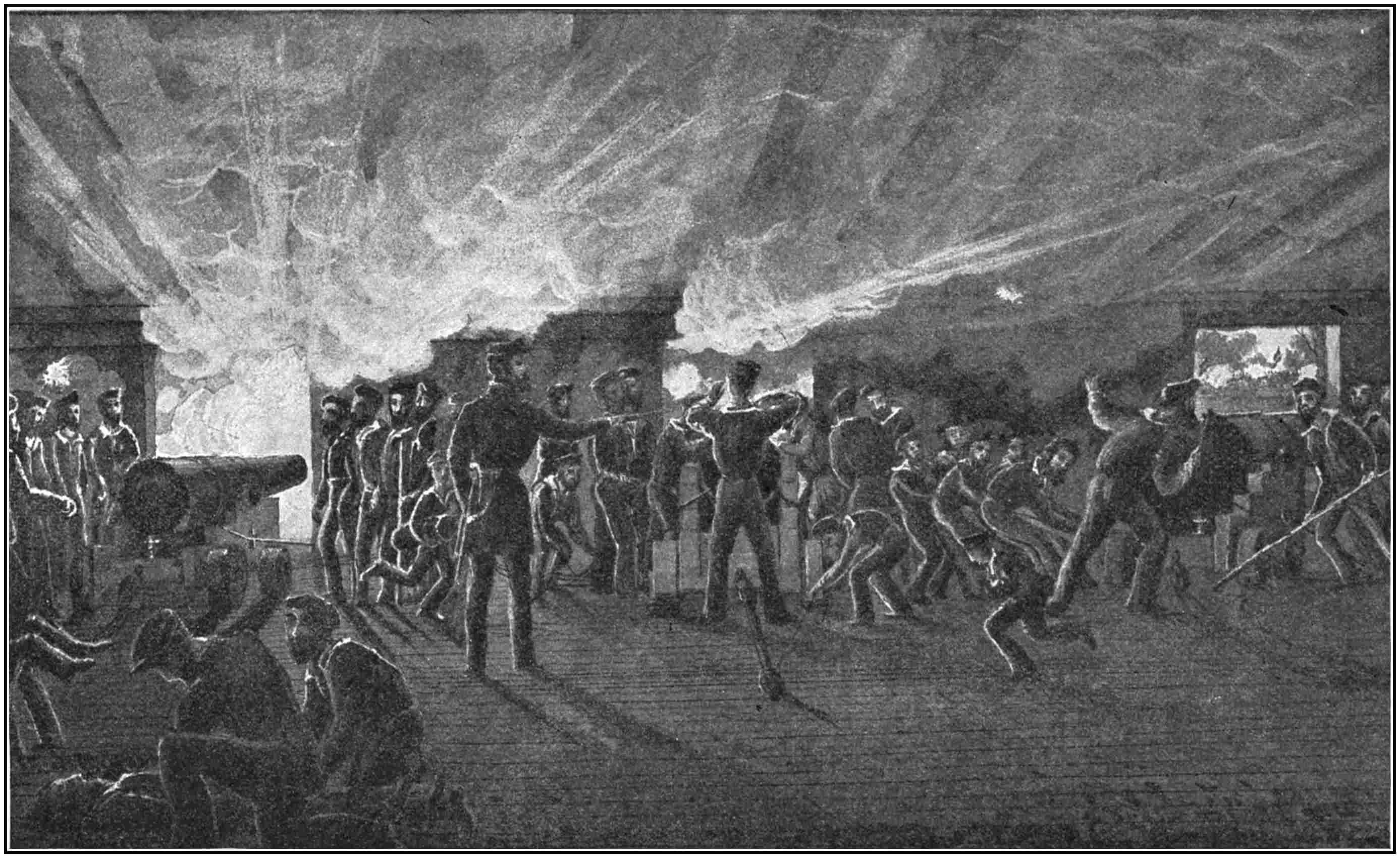
Interior of the Taylor during the Battle of Belmont.
From a painting by Admiral Walke.
By any reasonable standard here was as fair a fight as one could hope to find between ships and forts at that day, and at 12.30 o’clock on Friday, February 6, 1862, the Cincinnati (the flagship) fired her three bow guns simultaneously at an estimated range of 1,700 yards. The wily gunners on the other ships, remembering Flag Officer Foote’s warning about wasting shot, waited to see the effect of these shots, and saw them all fall short. “So there was $24 worth of ammunition wasted,” writes an officer of the Essex; but the gunners had learned the range, and “Jack Mathews, an old tar who had seen much service on men-o’-war, and was always restive under the command of a volunteer officer,” was the first to get his gun elevated, and the first to fire when the word came.
A fresh breeze athwart the bows drove the smoke away, and a shout arose as the shell from Jack’s gun burst in the parapet under one of the Confederate guns and covered it with the soft earth.
The squadron advanced slowly but steadily, reducing the elevation of the guns from seven to six and then five degrees, and cutting the262 fuses of the shells shorter and shorter. Every shot reached home in the parapet, and some passed clear through to lodge in and fire the barracks of the Confederates. The Confederates fought back stubbornly. “The fort seemed a blaze of fire.” Their shells drove the officers of the boats down into the casemates, but when the casemates were struck the projectiles bounded clear, doing little or no harm until the battle had raged for nearly fifty minutes. Then the gunner in charge of the Confederate rifle got the range of the Essex and drove his sixty-pound shell right through her bow armor just above a port. Continuing its flight, it took off the head of Master’s Mate Brittain and plunged into the middle boiler located amidships.
In an instant the deck was deluged with steam and scalding water, and the crew who could reach them went plunging through the ports, while the ship herself began drifting with the current out of the fight.
When the steam had exhausted itself the men from aft hastened forward. The deck was covered with men dead or writhing in their last agony. “Marshall Ford, who was steering, was found at the wheel, standing erect, his left hand holding the spoke and his right hand grasping the signal-bell rope,” dead at his post.
263
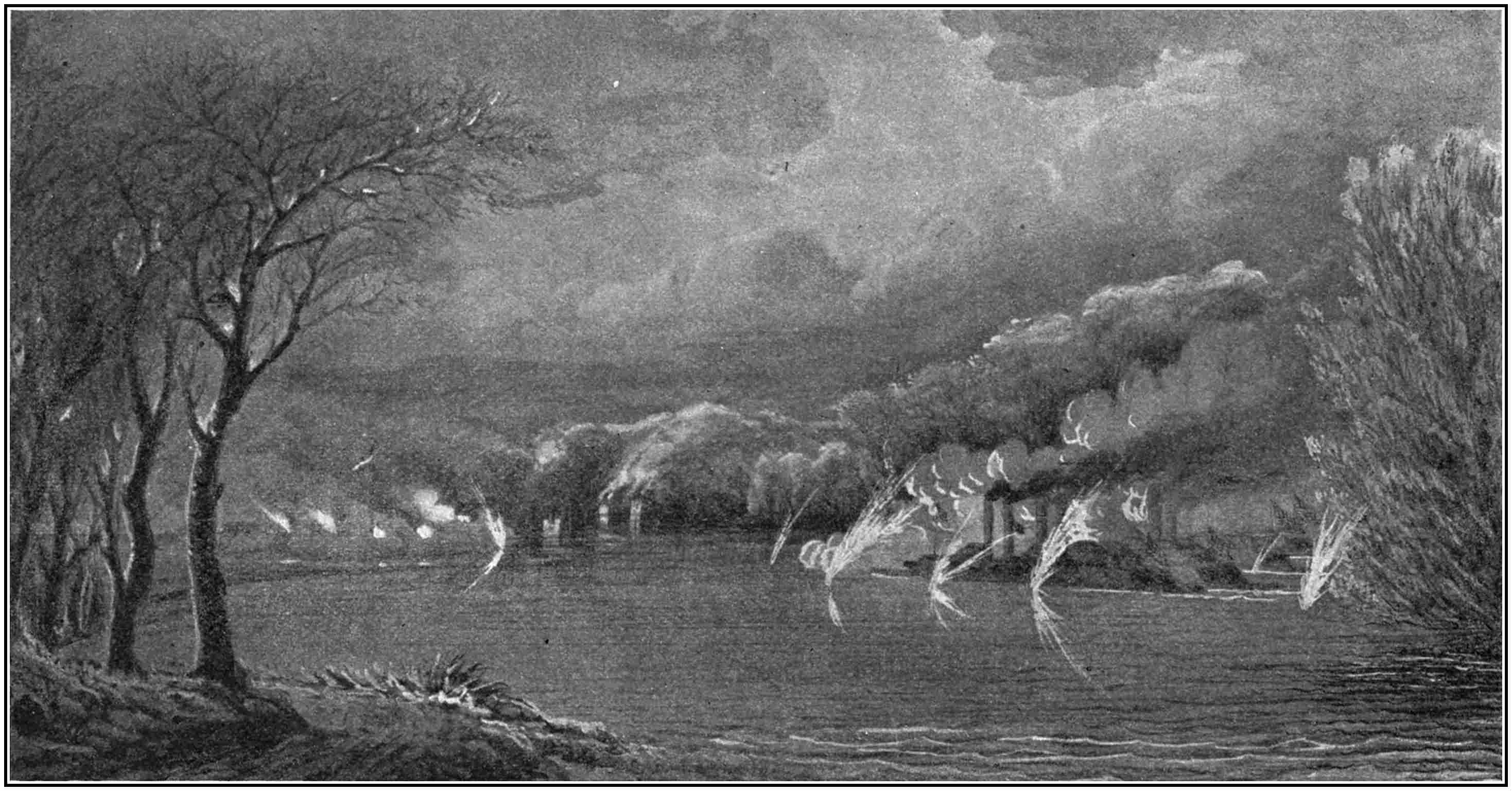
Battle of Fort Henry.
From a painting by Admiral Walke.
265
The men who had been working the bow guns from the first had just been relieved and sent aft to rest, but Jack Mathews had his blood up and had obtained permission to stay at his gun. He was among those who crawled through the port and was picked up by the boats, but he died that night. In all, twenty-nine men were scalded, and more than half of them died. Captain Porter was one of the severely scalded.
But while one ship was disabled by a well-directed shot, the other three steadily advanced, and their shot told with increasing effect. The Confederate rifle burst a few minutes later, and the ten-inch shell gun was spiked with its own priming wire. Five other guns were disabled by the fire of the gunboats, and this fire was rapidly becoming more deadly, for they were soon less than 500 yards away. Gen. Lloyd Tilghman, the Confederate commander, had “done all that could be done to defend his charge, and saying, ‘It is vain to fight longer—our gunners are disabled, our guns dismounted—we can’t hold out five minutes longer,’ he ordered a white flag hoisted.”
As the firing ceased the Carondelet grounded, and the steam on the flagship Cincinnati having been shut off, she began drifting with the current. To Flag Officer Foote it seemed that the Carondelet was steaming ahead of the flagship,266 and Foote ordered her to fall back. Of course she could not do so. Foote became excited at the seeming insolence of Captain Walke, and, running forward, he shouted himself hoarse, and then a junior officer tried it also. Finally the Carondelet got free, and the matter was explained; but it is apparent, from the published memoirs of the two men, that ill-feeling prevailed between them thereafter.
Tilghman went on board the Cincinnati and surrendered to Foote, for the army under Grant was detained by the muddy roads, and did not arrive until an hour after the fort had been silenced. It was a victory for the gunboats exclusively.
The importance of taking the fort appears when it is recalled that it was a main point in the frontier chain of Confederate posts that extended from Columbus, Kentucky, on the Mississippi, east to the Cumberland Mountains. The way to the interior of Tennessee was open, and the Confederate positions at Bowling Green and Columbus, Kentucky, were becoming untenable because the Union forces were in their rear.
Foote returned to Cairo immediately with three ironclads, leaving the Carondelet at Fort Henry, while the three unarmored gunboats were sent up the river to destroy the bridge of the main line of railroad from Memphis267 to the East, thus cutting off rail communication between the Confederate capital and all the western parts of Kentucky and Tennessee. Lieutenant Phelps was in charge of these boats, and after reaching the bridge, he left the Taylor to destroy both bridge and trestle-work while he pushed on with the other two. Three Confederate steamers, two of which were loaded with military stores, were grounded and fired above the bridge when Phelps appeared, and there was a tremendous explosion when they blew up.
Continuing on to Cerro Gordo, near the Mississippi State line, he captured a river steamer called the Eastport, that was already partly converted into a gunboat. Further up two more steamers were captured, and three others were fired by the Confederates. The raid extended to Florence, and was one of the notably brave deeds on Western waters.
The Eastport was taken into the government service, and Phelps commanded her until she ran on a torpedo in the Red River two years later and was destroyed.
From Fort Henry the gunboats turned to Fort Donelson on the Cumberland River. This fort, although on another river, was but twelve miles from Fort Henry. It was a much stronger position. As described by Mahan, “the main work was on a bluff about268 a hundred feet high, at a bend commanding the river below. On the slope of the ridge, looking down stream, were two water batteries, with which alone the fleet had to do. The lower and principal one mounted eight 32-pounders and a X-inch columbiad; in the upper there were two 32-pounder carronades and one gun of the size of a X-inch smooth-bore, but rifled with the bore of a 32-pounder and said to throw a shot of one hundred and twenty-eight pounds. Both batteries were excavated in the hillside, and the lower had traverses between the guns to protect them from an enfilading fire, in case the boats should pass their front and attack them from above. At the time of the fight these batteries were thirty-two feet above the level of the river.”
Foote thought the position too strong for the gunboats because the forts could deliver a plunging fire that would strike on top, where the gunboats were not armored, but he consented to join the expedition. Meantime Grant had sent the Carondelet, Captain Walke, around in advance of the others, and she arrived within range of Fort Donelson at 11 o’clock A.M. on February 12, 1862. Grant arrived overland an hour later.
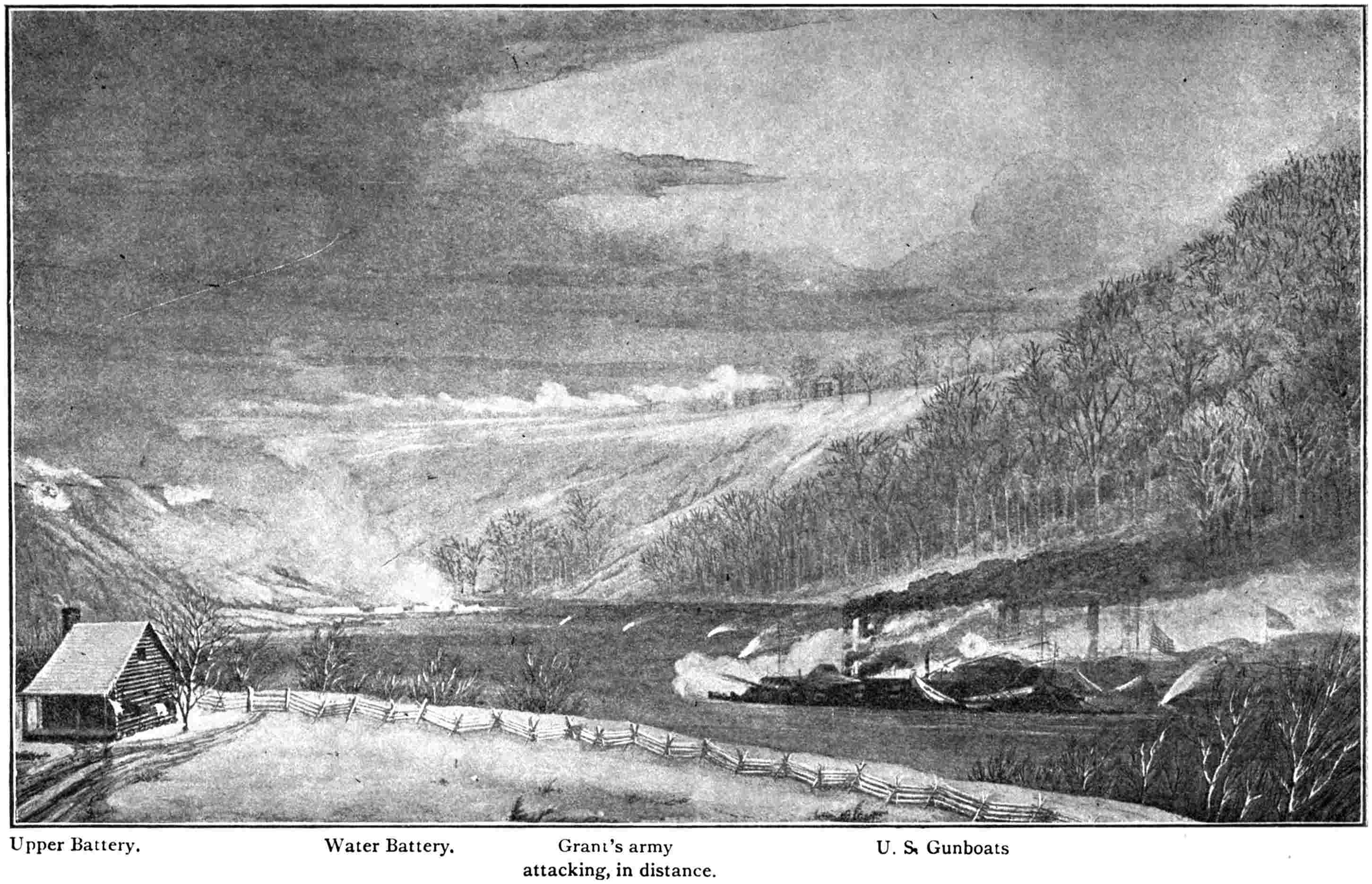
Battle of Fort Donelson.
From a painting by Admiral Walke.
To announce her arrival to General Grant the Carondelet threw a few shells at the enemy and then dropped down out of range. Next271 day, by order of Grant, the Carondelet took a partly sheltered position behind a point, and at a range of a mile and a quarter fired 184 shells into the fort to divert the attention of the Confederates as much as possible from General Grant. She was twice hit by the return fire, and one shot penetrated, wounding a few men with splinters.
On the night of the 13th Foote, with the St. Louis, Louisville, and Pittsburg, arrived, and at 3 P.M. on the 14th the squadron advanced in line abreast to the attack. Opening fire at a range of a mile, they steadily lessened the range until at last within 400 yards of the lower Confederate battery. The Confederates were rapidly abandoning their guns at this moment (4.30 P.M.), when a shot passed through the pilot-house of the flagship St. Louis, wounding Foote seriously, the pilot also, and smashing the wheel; and at the same moment a shell cut the tiller ropes of the Louisville. The preventer tackles that had been provided proved utterly inadequate in both cases—a most serious fault that should have been foreseen—and both vessels drifted helplessly out of the fight.
Seeing this, the Confederates rallied to their guns and renewed the fight. The Carondelet and Pittsburg were soon seriously damaged, and followed the disabled boats down stream.
272
Mahan says of this fight: “Notwithstanding its failure, the tenacity and fighting qualities of the fleet were more markedly proved in this action than in the victory at Henry. The vessels were struck more frequently (the flagship fifty-nine times, and none less than twenty), and though the power of the enemy’s guns was about the same in each case, the height and character of the soil at Donelson placed the fleet at a great disadvantage. The fire from above, reaching their sloping armor nearly at right angles, searched every weak point. Upon the Carondelet a rifled gun burst. The pilot-houses were beaten in, and three of the four pilots received mortal wounds. Despite these injuries, and the loss of fifty-four killed and wounded, the fleet was only shaken from its hold by accidents to the steering apparatus, after which their batteries could not be brought to bear.
“Among the injured on this occasion was the flag-officer, who was standing by the pilot when the latter was killed. Two splinters struck him in the arm and foot, inflicting wounds apparently slight; but the latter, amid the exposure and anxiety of the succeeding operations, did not heal, and finally compelled him, three months later, to give up the command.”
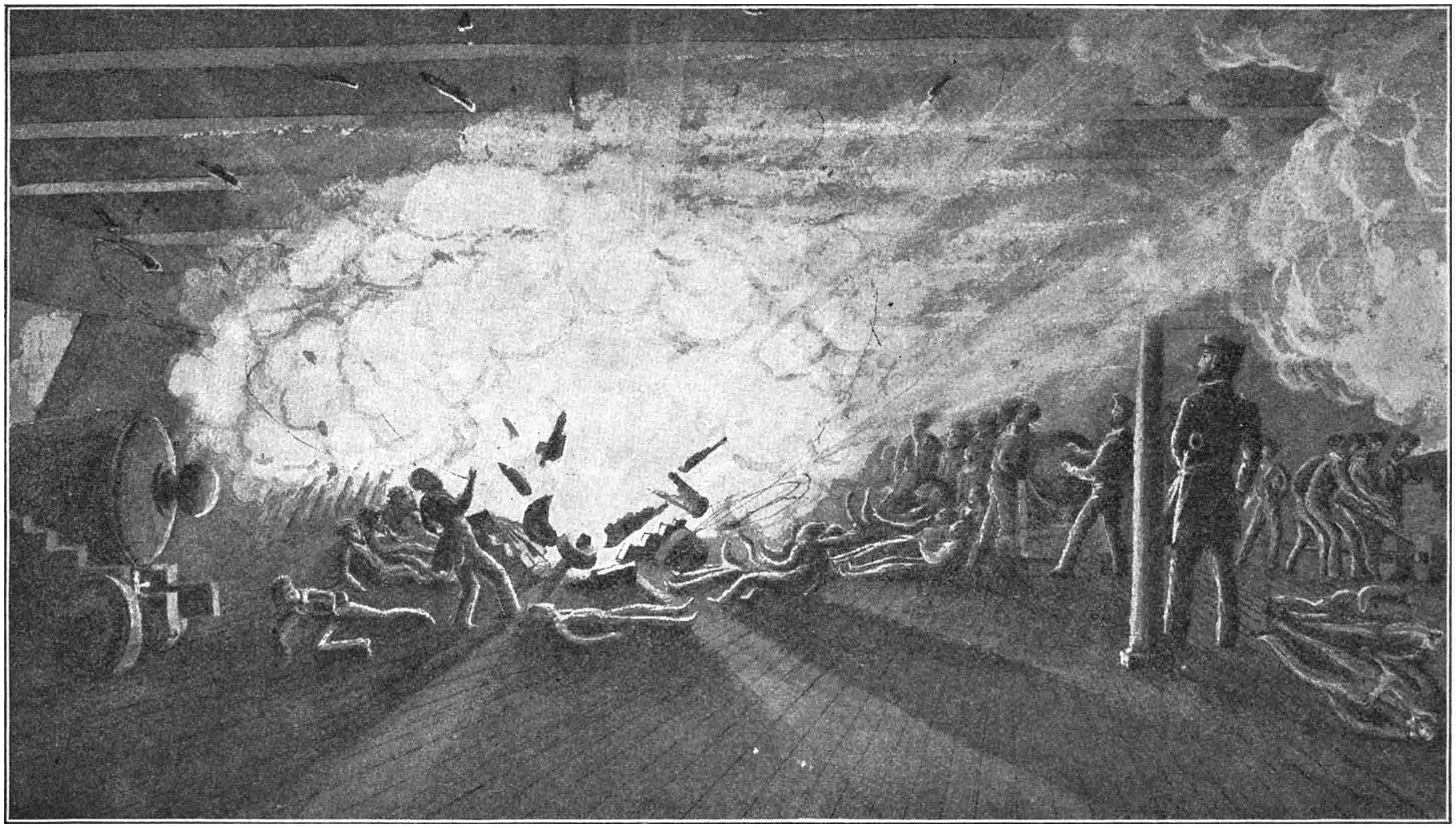
Explosion on Board the Carondelet at the Battle of Fort Donelson.
From a painting by Admiral Walke.
The Confederates surrendered to Grant on275 the 16th. It was an army victory. Nashville fell on the 25th, and on March 1st the Confederates began to evacuate Columbus, on the Mississippi. No attempt was made by the Confederates to hold Hickman, the next town down the Mississippi, but they fortified Island No. 10, that lay in the river opposite the dividing line between Kentucky and Tennessee, and both banks of the river. The position there was particularly strong. The river, for some distance, flowed south until the island was reached, and then turned to the northwest, and sweeping around a horseshoe bend, came back again to its old line and continued on south. The island lay right in the pocket of the sharp bend where the river turned to the northwest. The current was strong and full of eddies, and the channel lay right under the muzzles of the guns that were placed to defend it. “On the island itself were four batteries mounting twenty-three guns, on the Tennessee shore six batteries mounting thirty-two guns. There was also a floating battery, which, at the beginning of operations, was moored abreast the middle of the island, and is variously reported as carrying nine or ten IX-inch guns.” So says Mahan.
Nevertheless, the Union forces were sweeping down, and this stronghold had to yield, and the most interesting fact in connection with its276 capture was the brave dash of an American sailor, Captain Walke of the Carondelet.
Pope captured New Madrid, on the Missouri side of the river, on March 3d, and began fortifying the river below that town. A glance at the map will show this necessarily cut off river communications between Island No. 10 and the Confederates down stream. But the Confederates could come to Tiptonville, and from that place a good road led across the neck of land three miles to the shore opposite Island No. 10, and that was but a small overland journey for supplies. However, supplies could come by no other route, because the region east of the island was one vast swamp. Accordingly Pope determined to cross over to Tiptonville and so shut the Confederates in.
Meantime Foote’s flotilla had arrived in the river just above Island No. 10, bringing along a number of mortar boats—mere floating platforms carrying a thirteen-inch mortar each. Pope soon sent to Foote, asking that a couple of the gunboats be sent down the river, on the first favorable night, past the Confederate batteries to New Madrid to serve as ferryboats for the troops and to cover the landing. To this request Foote sent a positive refusal, although Capt. Henry Walke, of the Carondelet, was urgent in asking permission to make the run. Foote said that the risk was too great,281 and he could not afford to lose even one ship from his present command. But he added that when “the object of running the blockade becomes adequate to the risk,” he would consent.
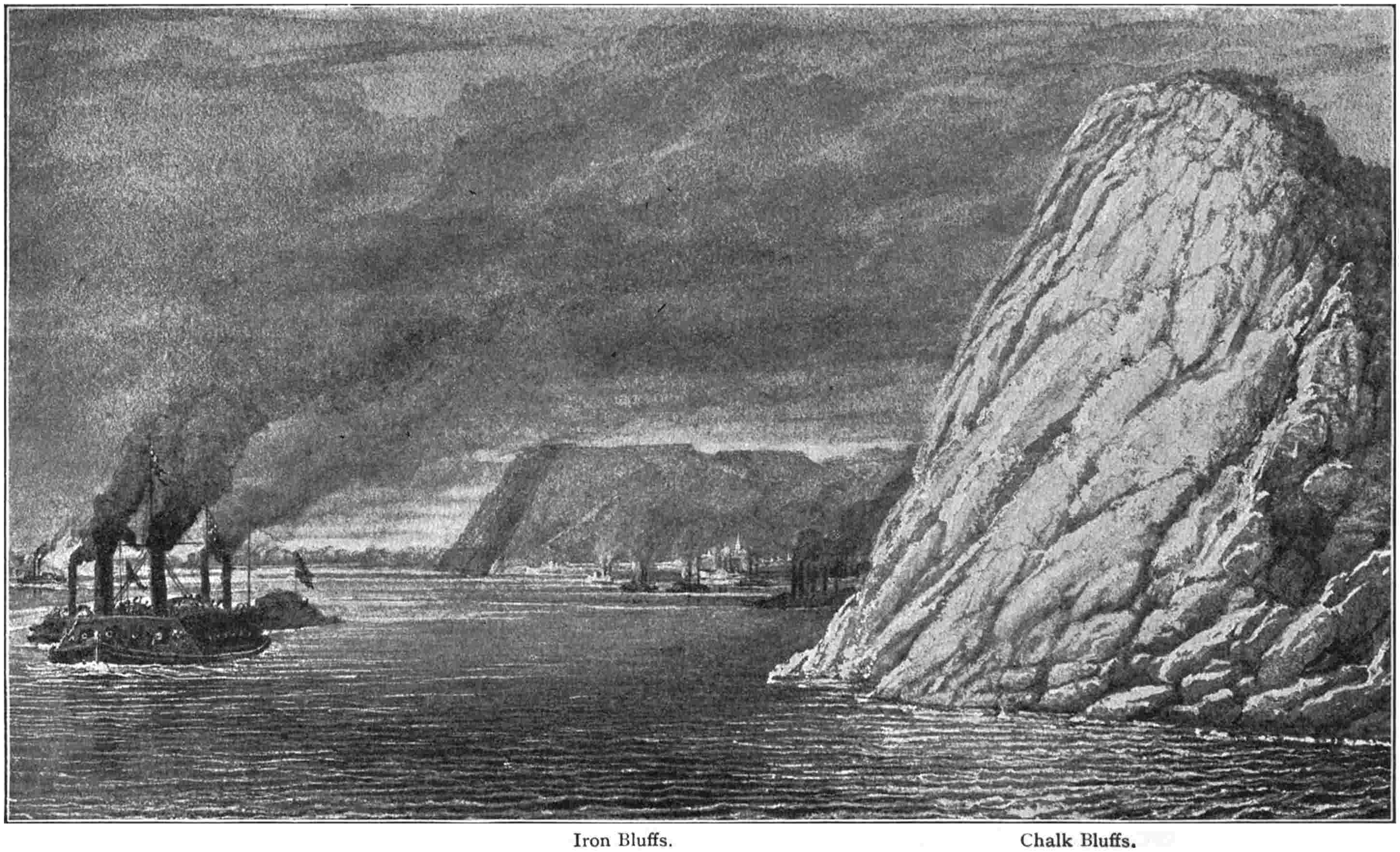
U. S. Flotilla Descending the Mississippi River.
From a painting by Admiral Walke.
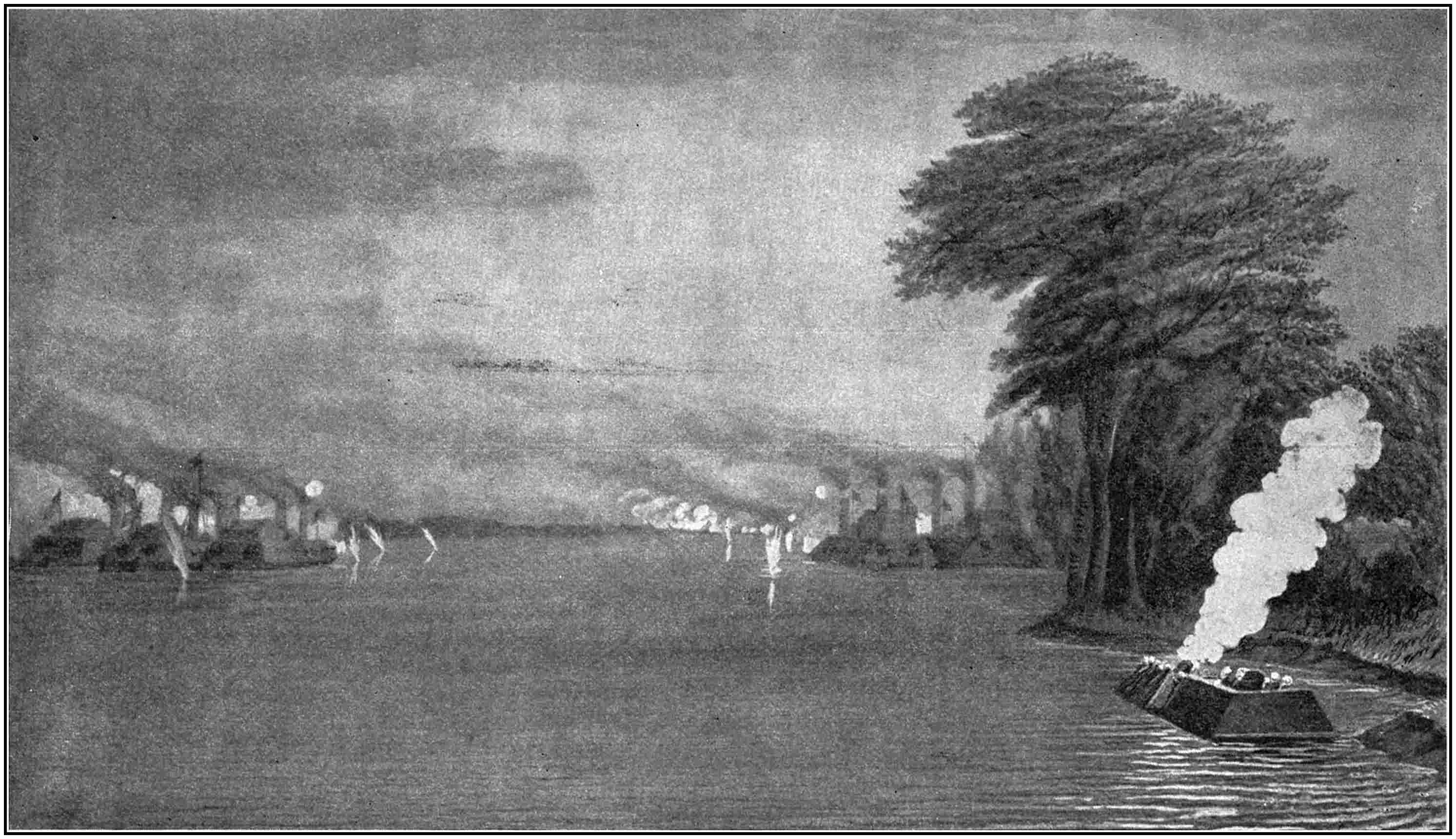
Battle with Fort No. 1 above Island No. 10.
From a painting by Admiral Walke.
This unexpected attitude of Foote delayed the capture of the island about two weeks. At the suggestion of Schuyler Hamilton, a channel was cut through the trees of the swamp from the Mississippi to New Madrid. There was water enough there to float shoal transports and barges, and when this work was done and the transports for ferry use were lying in the bayou behind New Madrid, Foote gave Captain Walke, of the Carondelet, permission to try running the batteries.
Captain Walke got his orders on March 30th. To prepare his ship for the iron deluge he put extra planking over her deck, and then ranged her chain cables across it to serve as additional armor—a use of chain cables that became famous in the one great naval duel of the Civil War, as will appear further on. Lumber and cord wood were piled where they would protect the boiler and engines, and the pilot-house was wrapped with ropes to a thickness of eighteen inches, while the escape-pipes were changed so as to exhaust in the wheel-box, that thus the puffing or coughing noise of the high-pressure engines then in use282 should be drowned. To still further protect her, a barge loaded with baled hay was lashed on the left side, which was the one that must receive the Confederate fire. The resourcefulness of Captain Walke was well shown in these preparations.
The night of April 10, 1862, was selected for the dash. The moon set at 10 o’clock that night and, as fortune favored, a heavy thunderstorm came on. Lifting her anchors as the first breath of the squall arrived, the Carondelet swung around and headed down the stream. The crew were at quarters, and every man but two was under cover. One, a seaman, Charles Wilson, stood at the rail heaving the lead, while Theodore Gilmore stood half-way between him and the pilot-house to pass the whispered call of the leadsman. By the time they were heading their course the rain began to fall in sheets, and the monotonous words “no bottom” from the leadsman were drowned, as was the puffing of the engine. Not a lamp was burning anywhere about the ship. The pilot, William R. Hall, was a man who could feel his way. But just before the batteries were reached, the boat met the one contingency for which no provision was made. Wood was used as fuel in the furnaces, and the soot in the chimney caught fire and went blazing up from the top of the smoke-stack.283 The lightning, too, was streaming across the sky, and “the gallant little ship floated like a phantom” before the eyes of the Confederates, who ran to their guns, and in a moment set the batteries flaming. The roar of the cannon echoed to the boom and rumble of the thunder. But the lightning that revealed the “phantom ship” blinded the eyes of the gunners, and they strove in vain to aim their guns with accuracy. The Carondelet passed unharmed, and the fate of Island No. 10 was sealed.
The hardy spirit of the brave Walke has never been sufficiently appreciated. This was because other batteries were run safely later on. But Walke was not only the pioneer. He alone of all the captains in Foote’s command favored the project from the first. The others “believed that it would result in the almost certain destruction of the boat, passing six forts under the fire of fifty guns.” He was willing to face the danger when all previous experience made even the most daring of his associates believe the task impossible. Nor was the danger from the batteries the only one, for it must not be forgotten that the Confederates had a half dozen well-armed gunboats at New Orleans, besides the ram Manassas, that created so great a panic at the mouth of the Mississippi. The Carondelet,284 when below the Confederate batteries, was for the time cut off from all support. The power of the Confederate fleet was exaggerated at the time, as we now know, but the officers of Foote’s flotilla had no means of learning the real facts. Moreover, it would have been rank folly for them to underestimate the power of the enemy.
It is worth telling that Island No. 10 has disappeared under the action of the current, and the main channel lies where the Confederate batteries stood.
On April 6th Pope crossed over to Tiptonville under cover of Walke’s guns. On that day, also, Grant fought the Confederates at Pittsburg Landing on the Tennessee. The Taylor, under Lieutenant Gwin, and the Lexington, Lieutenant Shirk, had part in that battle. During the afternoon the Confederates made a desperate attempt to turn Grant’s left and capture the landing place and transports. Gwin opened fire and silenced their batteries. At 4 o’clock the Lexington arrived, and the two gunboats silenced the Confederate batteries three-quarters of a mile above the landing. Again at 5.30 the Confederates came in such force against Grant’s left that they arrived within an eighth of a mile of the landing, but the boats then drove them back in confusion. It is not unlikely that Grant would have been289 entirely overwhelmed by the superior force of the Confederates but for the support of the gunboats. They enabled him to hold out until reinforcements came. And that night, to quote a Confederate account, “the enemy broke the men’s rest by a discharge, at measured intervals, of heavy shells thrown from the gunboats.” The Confederates could not sleep because a great shell was dropped somewhere in their camp, bringing death and disaster every fifteen minutes. Imagine those soldiers lying there all night counting the time as they waited for the next shell.
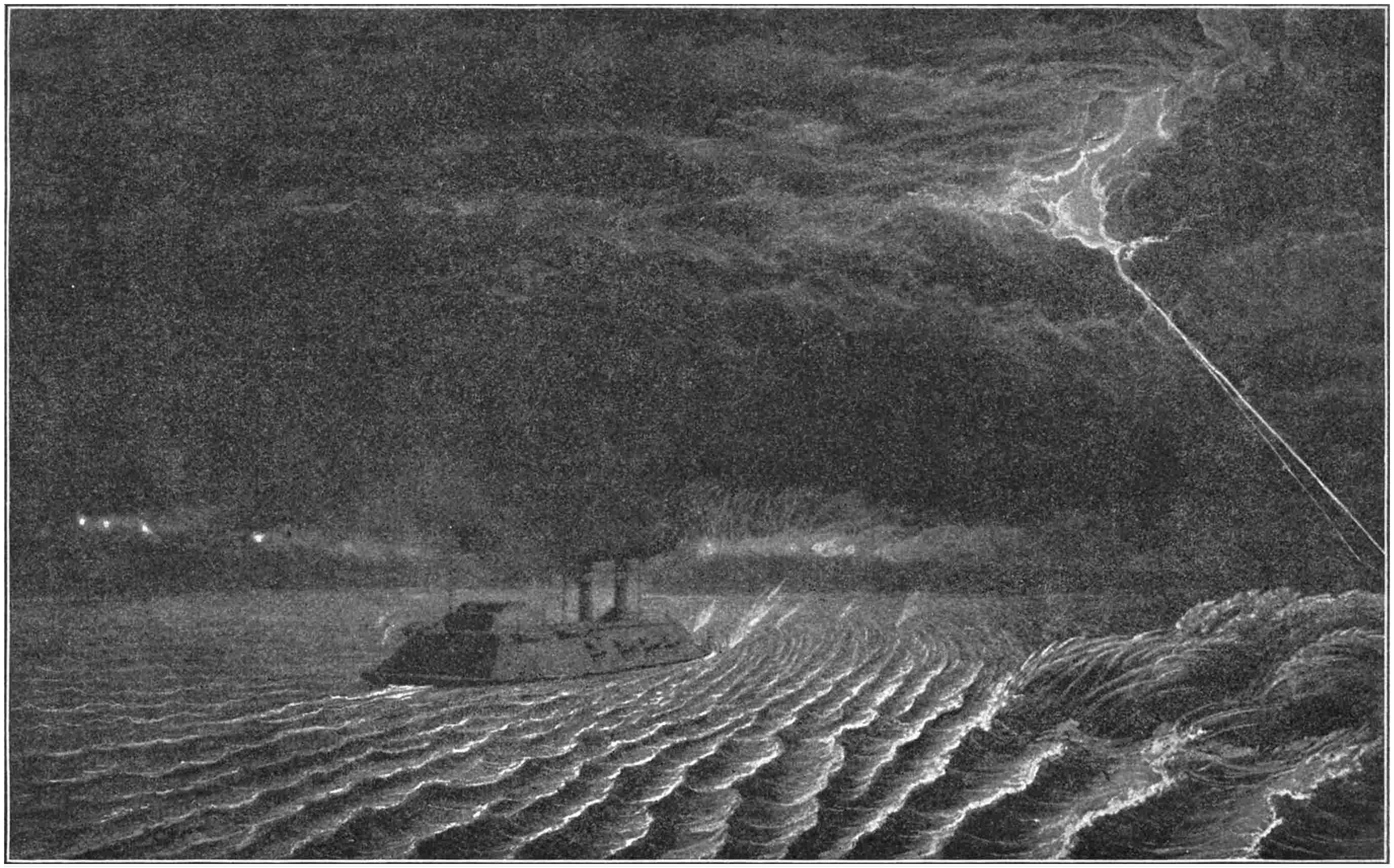
The Carondelet Running the Gauntlet at Island No. 10.
From a painting by Admiral Walke.

The Carondelet Attacking the Forts below Island No. 10.
From a painting by Admiral Walke.
The next matter of interest in the story of the Mississippi flotilla was what may be called an irregular squadron battle. Island No. 10 surrendered on May 7, 1862, and the government fleet advanced until near Fort Pillow, which the Confederates had erected on the First Chickasaw Bluffs, not far above the Hatchie River. Here a stand was made awaiting the coöperation of the army. Foote, suffering from his wound, had to be relieved. Capt. Charles H. Davis took his place on May 9th. The fleet at this time numbered seven gunboats, four of which were stationed on the Arkansas (westerly) shore and three on the Tennessee side. They were the Mound City, Capt. A. H. Kilty; Cincinnati, Capt. R. N. Stembel; St. Louis, Capt. Henry Erben;290 Cairo, Capt. N. C. Bryant; Benton (flagship), Capt. S. L. Phelps; Carondelet, Capt. Henry Walke; and Pittsburg, Capt. Egbert Thompson.
It was the custom while lying there to send one of the gunboats every day to tow a mortar boat to a mooring under Craighead’s Point, where it could throw shells into Fort Pillow, the gunboat lying handy by meantime to protect the mortar boat from Confederate boats known to be in the river below the fort.
The Confederate gunboats were the ordinary river boats converted into warships by putting cotton bales and pine timber about the boilers, and by casing the bows with iron, and in other ways adding to their strength forward so that they became, after a fashion, rams. Each carried at least one gun. This work was done by the pilots themselves at New Orleans, and the old line navy officers there were not allowed to interfere. When ready, eight of these boats had been sent up to Fort Pillow, nominally under Capt. J. E. Montgomery, one of the pilots, but, as a matter of fact, each captain did as he pleased, and the wonder is that anything worth mention should have been accomplished.
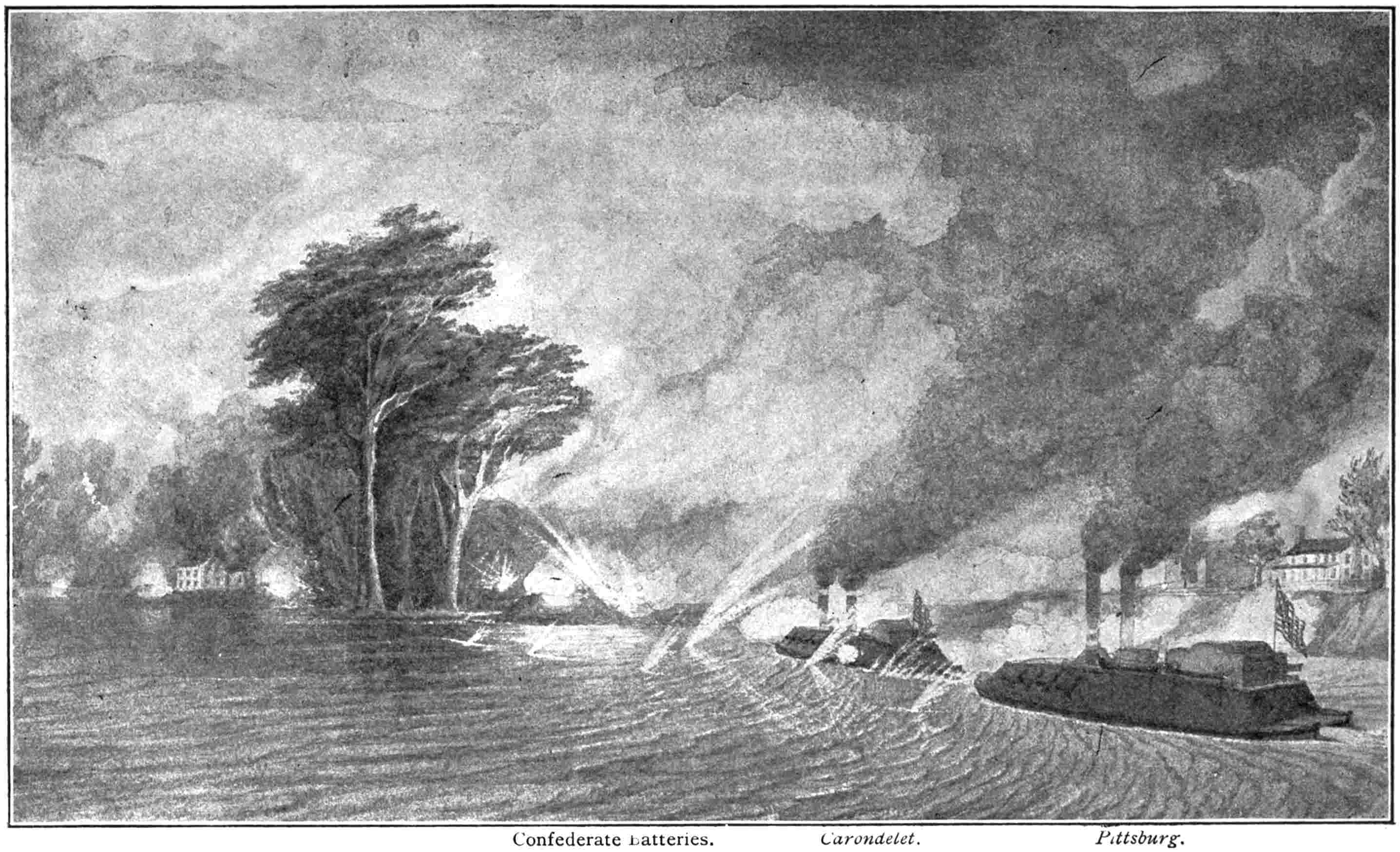
U. S. Gunboats Capturing the Confederate Forts below Island No. 10, April 7th.
From a painting by Admiral Walke.
Early on May 10th the government gunboat Cincinnati towed a mortar boat to its post, and then tied herself to a snag near by.293 At 5 o’clock the mortar hurled its first shell into Fort Pillow, and thereafter continued its work until 6 o’clock, when a dense smoke was seen rising in the air below Fort Pillow. The Confederate rams were leaving their landing for a dash at the mortar boat and the Cincinnati. The Cincinnati quickly slipped her moorings, and running out into the river, faced the Confederates—faced them alone, although the whole Confederate flotilla was in plain sight of the government flotilla long before they reached the Cincinnati. Apparently Flag Officer Davis overslept that morning.
As the Confederates came in range the Cincinnati opened fire and stood her ground. The Confederates scattered at once, but continued advancing. The leading Confederate boat, the General Bragg, hugged the Arkansas shore, passed above the Cincinnati, and then turning around, drove her bow into the unprotected quarter of the lone government boat. The two boats were alongside each other in a moment, and the Cincinnati gave the Confederate boat a broadside that sent her skurrying down the stream and out of the battle.
Behind the Bragg came two more Confederates, the Price and the Sumter, firing with guns and muskets at the ports of the Cincinnati, while one of them rammed her again in the place where the Bragg had struck her, and294 at the same moment Captain Stembel fell with a ball through his throat that well-nigh proved mortal, and the executive officer was mortally hurt.
Meantime Flag Officer Davis woke up, while Captain Kilty, of the Mound City, without waiting for orders, started to the aid of the mobbed Cincinnati. Captain Walke, with the Carondelet, was not far behind him, but both were three miles away from the scene of conflict when they started. The Carondelet was the first to open fire, and the first shot raked the fleeing Bragg. Another shell struck the Price at the water-line, cutting a water-supply pipe and causing her to leak so badly that she was thrown out of the fight.

Battle of Fort Pillow.
From a painting by Admiral Walke.
But while aid was coming the Cincinnati was run into shoal water, and there she sank. The Mound City had meantime been firing at the Confederates, and the Van Dorn turned to ram her. She avoided the full strength of the blow by a skilful use of the helm, but she was cut into, nevertheless, and had to be run ashore on the Arkansas side to keep her from sinking. The Pittsburg had been obliged to go to the assistance of the Cincinnati to get her into shoal water, and the Cairo rendered the same service to the Mound City. This left only the flagship Benton, the Carondelet, and the St. Louis to continue the battle with the six297 remaining Confederate gunboats, though it must be said that the guns of both the Pittsburg and the Cairo were still firing at the Confederates. But the Confederates retreated as soon as the belated Benton and St. Louis got fairly into the fight. Flag Officer Montgomery said he retreated because the government boats all went into water too shoal for his rams, while their guns were far heavier as well as much more numerous than his. As to the guns, he had only thirty-two-pounders, but it is certain that neither the Benton, the Carondelet, or the St. Louis went into shoal water. In fact, the Benton drew more water than any of the Confederate “River Defence Squadron,” as it was called, and the other two government boats quite as much as any.
The fact is, Montgomery’s force was a lot of militia afloat. They made a most brilliant dash at the government forces, sank two gunboats, and then, militia fashion, got out of it when they were really just ready to begin to fight. Not one of their boats was seriously hurt. The Bragg had lost her tiller ropes, and the Price was aleak, but both might have continued the fight after a few minutes devoted to repairs. The whole force was, so far as hurts were concerned, “ready for action at Memphis a month later.” As to the government force, it may be said that Stembel, on the298 Cincinnati, made a brilliant defence, and Walke and Kilty, of the Carondelet and Mound City, seemed to fully appreciate what was required under the circumstances. The unprotected mortar boat, Acting Master Gregory, kept up a steady fire on the Confederates throughout the conflict, and Gregory was promoted for his bravery.
Soon after this fight the government flotilla was reinforced by seven river steamers that had been converted into rams along the Ohio River by Col. Charles Ellet, Jr. Part of them were stern-wheelers and part side-wheelers. They were strengthened with fore-and-aft bulkheads, and the boilers were protected with two feet of oak. Ellet had independent charge of them, with instructions to coöperate with the gunboats under Flag Officer Davis.
Meantime the advance of the government army in Tennessee had made it impossible for the Confederates to hold Fort Pillow, and it was evacuated on June 4, 1862. On the evening of the 5th the government flotilla came to anchor just above Memphis, that was yet in Confederate control. The Confederate fleet was seen at the levee next morning, but they soon cast off and took a position where the Union fleet could not fire on them without danger of throwing shells into the city. It was to be the last battle between the two flotillas,301300 and a great throng of citizens gathered on the bluffs.
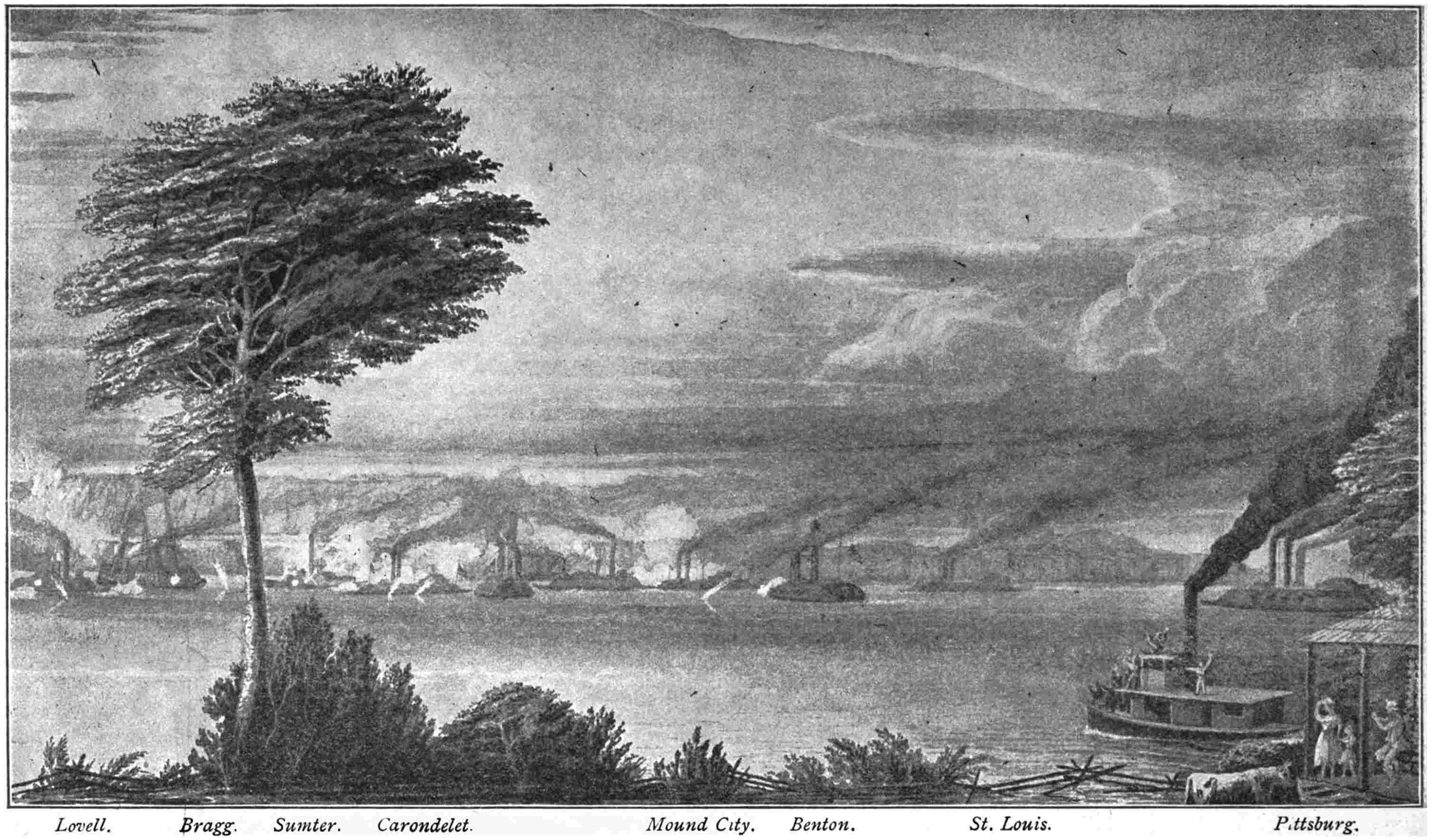
The Battle of Fort Pillow.
From a painting by Admiral Walke.
The government gunboats started at 4.20 o’clock and dropped slowly down, stern first, until the Confederates opened fire, when they turned about and returned the fire with vigor. The Union rams under Ellet had, until this time, kept in the rear, but when the firing began two of them—the Queen of the West and the Monarch, swift vessels for their day—took advantage of the smoke, dashed through the government line, and boldly headed for the Confederate boats.
This attack was wholly unexpected, and the crowds of Memphis citizens on the heights groaned aloud. The officers of the Confederate ships were startled, too. Some of their vessels swerved about under the nervous handling of their tiller wheels, and that gave the gallant Ellet the opportunity he hoped for. With the Queen of the West he crashed fairly into the broadside of the Confederate ship Lovell, and she sank out of sight immediately. But as the Queen of the West hauled clear, the quick-witted pilot of the Confederate ram Beauregard rammed her, and she was headed for the Arkansas shore, where she grounded. The government ram Monarch was close behind the Queen of the West, and the Confederate rams Beauregard and Price made a dash302 at her from opposite sides. She cleverly eluded them, and they crashed together, the Beauregard making a hole in the Price that sent her to the Arkansas shore.
That mishap very naturally confused the pilot of the Beauregard, and while he was recovering his wits the Monarch turned on him and rammed. Just then a shot from the Benton pierced the Beauregard’s boiler, and with the steam and scalding water pouring over her crew, she surrendered. The Monarch took charge of her and towed her over toward the Arkansas shore, where she sank and quelled the agonies of the dying by burying them under the river.
And then, to add to the disasters of the Confederates, a shot pierced the steam-chest of the Little Rebel, sending her also to the morgue on the Arkansas shore.
The remainder of the Confederate squadron now turned and fled for safety, but the shells from the government flotilla were too swift for them. The Thompson was sunk, and the Bragg and Sumter surrendered. Only the Van Dorn escaped.
On the whole, this was the most interesting day in the history of the flotilla. The fight was soon over (Memphis was in the hands of the flotilla at 11 o’clock), but the Confederates fought with the greatest gallantry until four307 of their ships were destroyed. The chief feature of the fight, from a naval point of view, was the destructive work of the rams, for therein one may find a foreshadowing of what shall come to pass if ever two modern squadrons are arrayed in battle. Three ships were rammed out of the conflict within fifteen or twenty minutes; the actual time does not appear. It was the first fight of steam rams in the history of the world.
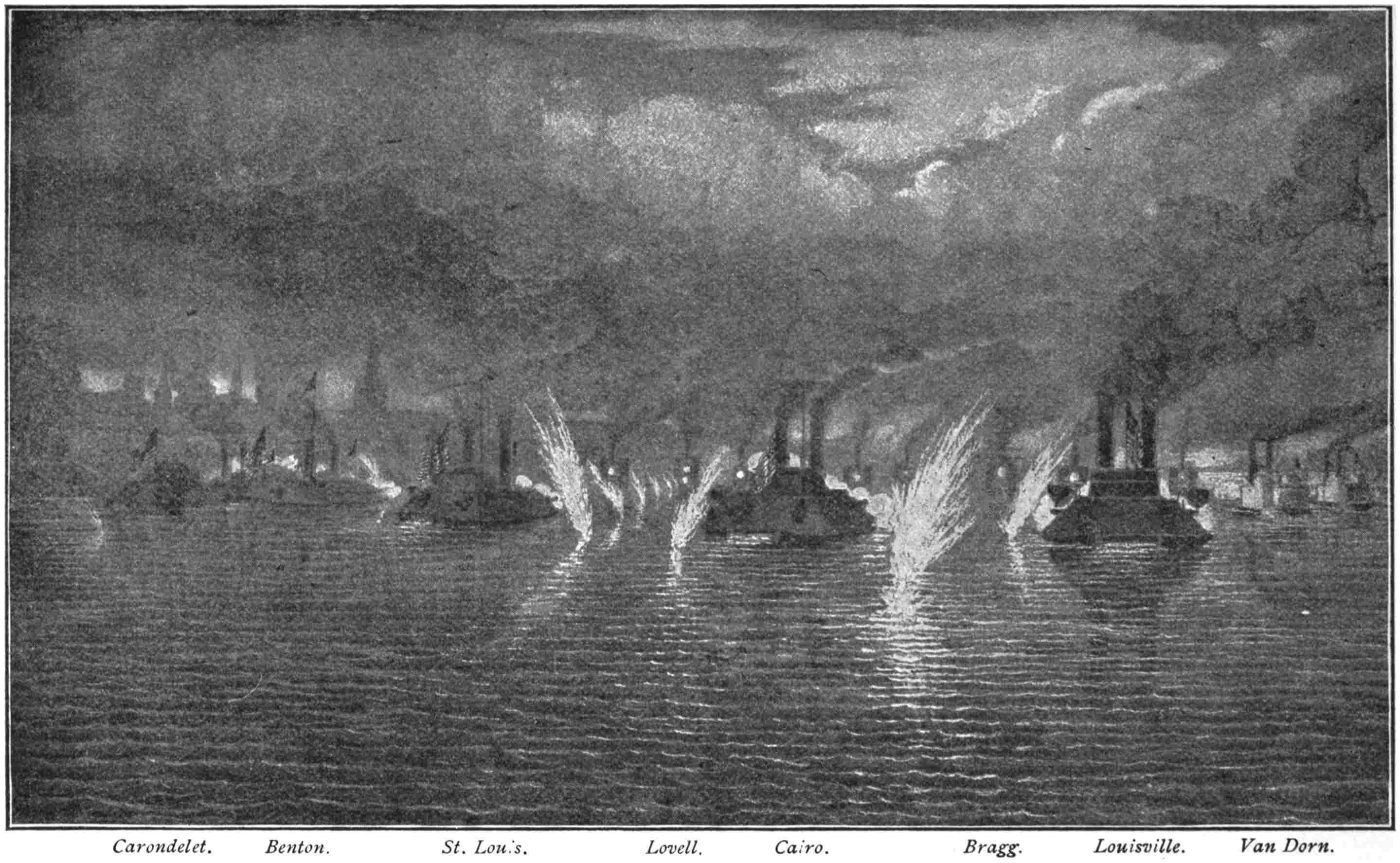
The Battle of Memphis—First Position.
From a painting by Admiral Walke.

After the Battle of Memphis.
From a painting by Admiral Walke.
While the flagship remained at Memphis until June 29th, the river was practically opened as far as Vicksburg by this fight. An expedition to coöperate with the army was sent up the White River in Arkansas, where, at Charles City, a combined attack was made by the gunboats and an Indiana regiment under Colonel Fitch, on the Confederate works. The Mound City was leading the gunboats, and had arrived within 600 yards of the Confederate fort, when a shell entered her casemate, killing three men and bursting her boiler. Of 175 officers and men on board, but three officers and twenty-two men escaped unhurt from the frightful blast. Eighty-two died of wounds and the scalding, and forty-three were drowned or shot in the water when they jumped overboard to escape the steam, for the Confederates continued firing at her crew when they were swimming away from her.
308
The other gunboats continued battle until Fitch was ready to make an assault from the rear, when they ceased firing, and Fitch carried the works by storm. The Confederate commander was Capt. Joseph Fry, who was captured and executed by the Spaniards in the Virginius expedition, of which he was the leader.
On June 29th Flag Officer Davis steamed down the river from Memphis, and early on the morning of July 1, 1862, came upon a government fleet lying just above Vicksburg, under the command of Admiral Farragut.
The story of Farragut’s journey from the Gulf of Mexico to this point will be told in the next chapter.
309
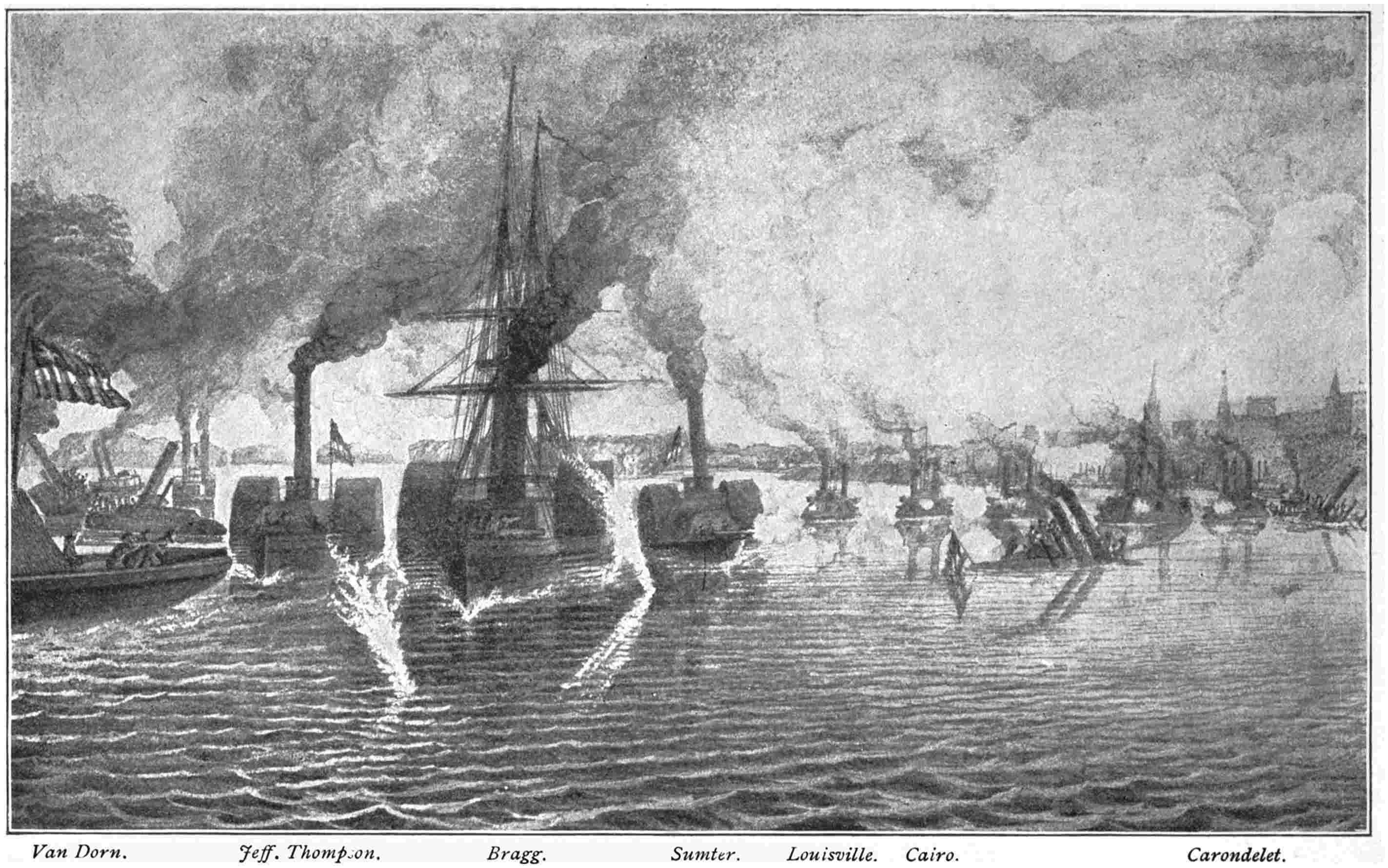
Battle of Memphis—The Confederates Retreating.
From a painting by Admiral Walke.
311
IT WAS HARD WORK GETTING THE SQUADRON INTO THE MISSISSIPPI—PREPARING THE SHIPS TO RUN BY THE FORTS GUARDING THE RIVER—MORTAR SCHOONERS HIDDEN BY TREE BRANCHES—THE FORTS WERE WELL PLANNED, BUT POORLY ARMED—A BARRIER CHAIN THAT WAS NO BARRIER AT THE LAST—THE HETEROGENEOUS CONFEDERATE SQUADRON—THE FIRE-RAFTS—WORK OF THE COAST SURVEY—BRAVERY OF CALDWELL—FOREIGNERS WHO INTERFERED—WORK OF THE MORTAR FLEET—WHEN THE SQUADRON DROVE PAST THE FORTS—SCATTERING THE CONFEDERATE SQUADRON—NEVERTHELESS, AT LEAST THREE GOOD CAPTAINS WERE FOUND AMONG THEM—SINKING THE VARUNA—FATE OF THE RAM MANASSAS—SURRENDER OF THE FORTS—END OF THE IRONCLAD LOUISIANA—THE WORK OF THE MISSISSIPPI SQUADRON.
In the story of the capture of New Orleans, early in the year 1862, the name of David Glasgow Farragut first appears in the annals of the Civil War. When the war began Farragut was a captain, and was awaiting orders at his home in Norfolk, Virginia. He was a Southern man by birth, and his family were of the South. A most determined effort was made by the Southern leaders to enlist him on their side; but Farragut was a man who could not forget his oath to support the Constitution312 of the United States. His only recorded reply to them was, “Mind what I tell you: You fellows will catch the devil before you get through with this business.”
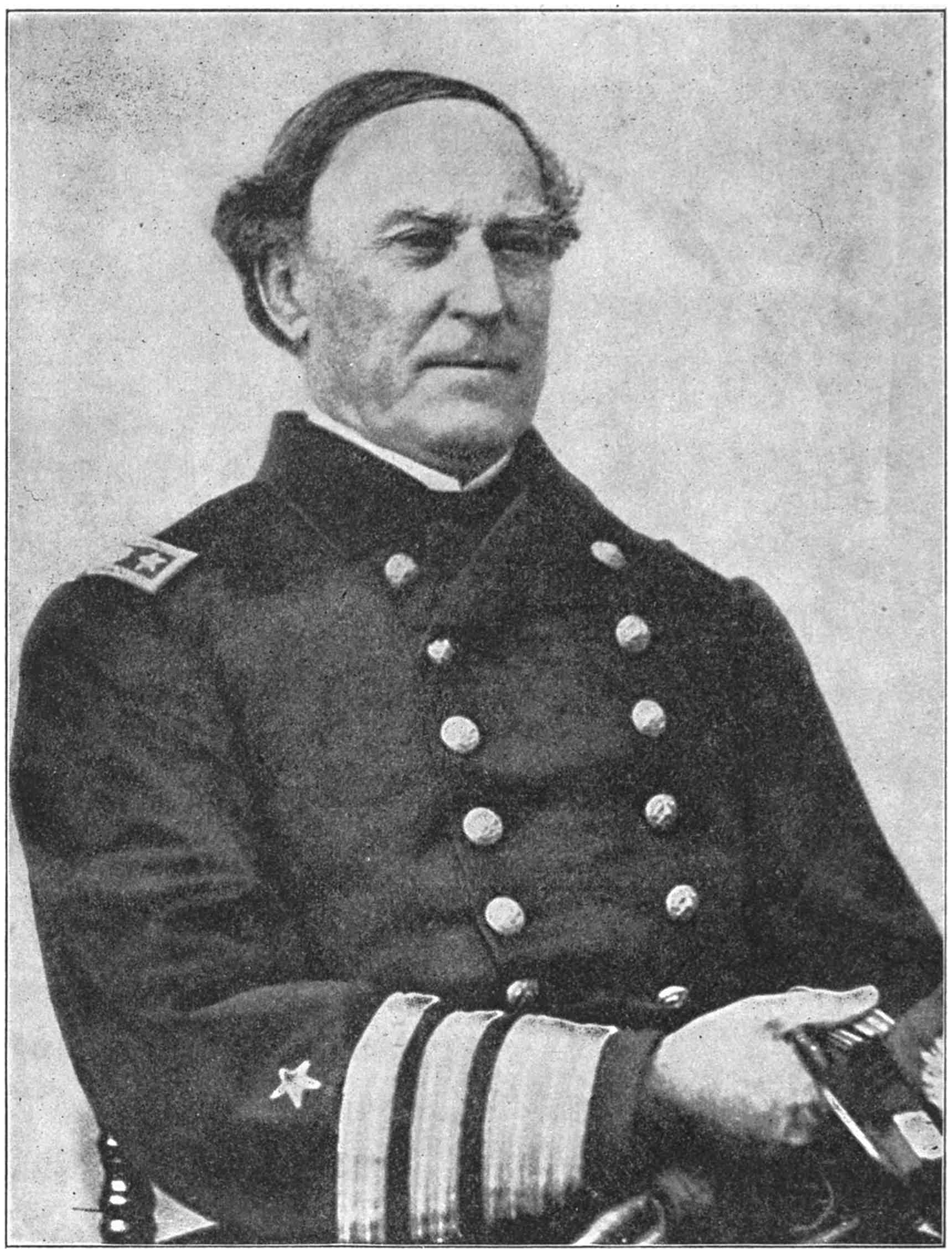
David Glasgow Farragut.
From a photograph.
313
Removing his family to a home on the Hudson River, he reported himself “ready for duty,” and felt some relief when he was made a member of the naval retiring board, created by a new law passed to get rid of superannuated officers. This appointment was at least a show of confidence in his loyalty. And there he was trying his official peers on a charge of old age when the expedition against New Orleans was planned.
The idea of attacking New Orleans originated with Commander David D. Porter, when in charge of the blockading steamer Powhatan, that, during the summer of 1861, was lying off the Southwest Pass of the Mississippi. Porter made it a point to collect all the information possible about the river and the defences, and he found the fishermen from New Orleans very good spies. Returning North, Porter went to the Secretary of the Navy. He had a knack of getting the ears of the leaders in those days, as well as some luck, as one may say, and the expedition was decided on. Of course, Porter’s rank was too low for the command of such a force, but he was permitted to suggest the name of a suitable captain, and Farragut was promptly named. As the reader will remember, Farragut was reared in the old Essex under Commodore David Porter, and David Porter was the father of David D. Porter.314 It was, perhaps, what may be called log-rolling for one of the family, but David D. Porter never did the nation a better service than when he spoke for Farragut.
The offer of the leadership of this expedition was eagerly accepted, and David Glasgow Farragut, whose form and features are more familiar to the eyes of the American people than those of any other naval hero, had the first opportunity of his life.
Making the Hartford his flagship, he sailed from Hampton Roads on February 2, 1862, and on the 20th arrived at Ship Island, near the mouth of the Mississippi. Here he gathered the following squadron:
Screw sloops: Hartford, twenty-four guns, Flag Officer David G. Farragut, Fleet Captain Henry H. Bell, Commander Richard Wainwright; Pensacola, twenty-three guns, Capt. Henry W. Morris; Brooklyn, twenty-two guns, Capt. Thomas T. Craven; Richmond, twenty-four guns, Commander James Alden.
Side-wheel steamer: Mississippi, seventeen guns, Commander Melancthon Smith.
Screw corvettes: Oneida, nine guns, Commander S. Phillips Lee; Varuna, ten guns, Commander Charles S. Boggs; Iroquois, seven guns, Commander John De Camp.
Screw gunboats: Cayuga, two guns, Lieut. Napoleon B. Harrison; Itasca, two guns,315 Lieut. C. H. B. Caldwell; Katahdin, two guns, Lieut. George H. Preble; Kennebec, two guns, Lieut. John H. Russell; Kineo, two guns, Lieut. George M. Ransom; Pinola, two guns, Lieut. Pierce Crosby; Sciota, two guns, Lieut. Edward Donaldson; Winona, two guns, Lieut. Edward T. Nichols; Wissahickon, two guns, Lieutenant Albert N. Smith.
Of the guns on this squadron ninety-three could be fired in broadside, but none could be fired directly ahead; the pivots, however, could be fired within a point or two of the line of the keel, and were practically bow guns. More than half these guns were nine-inch smooth-bores or better.
In addition to these ships, there were twenty schooners carrying one thirteen-inch mortar each, and six gunboats (among them three ferryboats), carrying heavy guns, were assigned to handle and protect them. The mortar flotilla was placed under Porter.
It was an easy matter to get the gunboats up the river, but the big ships stuck on the bar. The Pensacola had to unload all of her guns as well as other weights before she could pass, and even then her bottom cut the channel a foot deeper when she was dragged through on April 7th, and the Mississippi had a like experience. An attempt made to drag the Colorado over failed altogether; but the316 attempt had to be made in order to please the officials at Washington, even though two weeks of precious time were wasted.
However, Capt. Theodorus Bailey and nearly all of the crew of the Colorado were taken along if the ship was left behind, and on reaching the head of the Passes the work of preparing the ships for the task before them began.
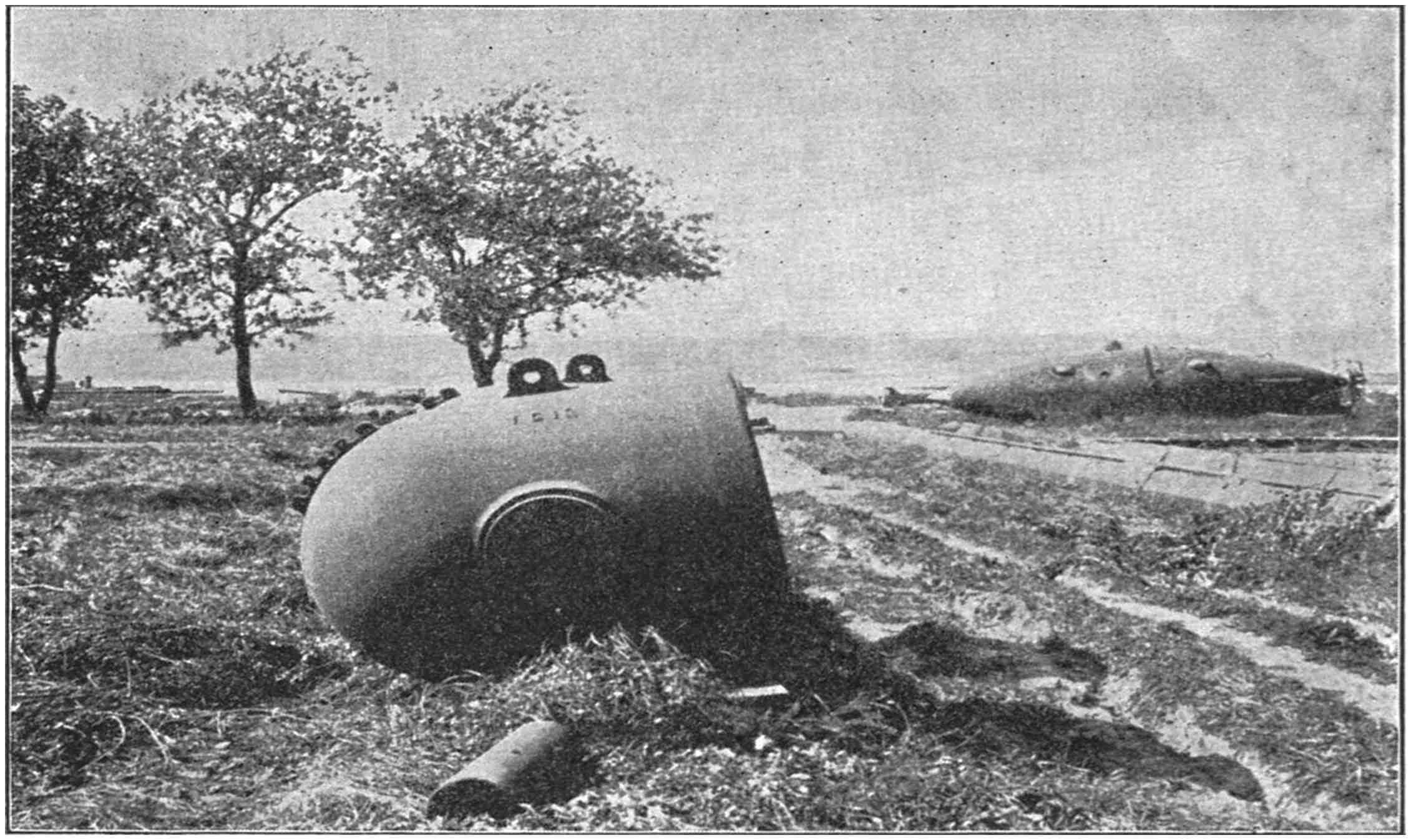
Thirteen-inch Mortar from Farragut’s Fleet.
From a photograph made at the Brooklyn Navy Yard.
Howitzers were placed in the tops (i.e., on platforms at the tops of the lower masts), and there protected by boiler iron from musket fire. Each ship was made to draw more water317 forward than aft so that she would have a better chance to get off in case of grounding. As the ships were to fight at point-blank range care was taken to secure the guns so their elevation should not increase under the shock of firing. The rigging was stripped down to the topmasts, and the spars, etc., sent ashore, while some of the gunboats took their masts out altogether. Chain cables were secured up and down the sides of the ship to ward off shot, and “bags of coal or sand or ashes, or whatever else came to hand,” were piled to keep the shot from the boilers and engines. Nets were hung inside to stop the flying splinters in case of shot piercing the wooden walls. Decks and gun carriages were whitewashed to help the light for the night battle, and the outsides of the ships were smeared with mud to make them less easily visible.
The mortar schooners were disguised by lashing tree limbs to the masts in such fashion that they could not be distinguished from the trees along the banks. In short, no precaution was omitted.
As for the Confederates, they rested in perfect confidence behind the forts that had been erected to defend the river. As a glance at the map will show, there was some reason in the location, if not in the armament of these forts, for the confidence they felt. As will be318 seen, the river comes down in a southerly direction until within twenty miles of the head of the Passes. There it suddenly turns to the northeast for nearly two miles, when it makes a sharp bend to the south once more. It was right on this sharp, knee-like bend that the forts were built. Fort St. Philip stood on top of the knee-bend, so to speak, and from its walls a fair view was had for a long way down the river. On the under side of the knee lay Fort Jackson. By the compass it was about due south of Fort St. Philip and but 800 yards away. Its guns pointed all over the bend of the river and away to the south, the timber on the west side of the river having been cut away to allow an unobstructed view of the stream almost to the uttermost range of the guns.
But when the guns of these forts are considered, one must say they were very poor. The Confederates made a mistake there. In all there were 109 cannon that might be used on passing ships at one point or another, but of these, fifty-six were twenty-four-pounders—excellent guns in 1812, but very small fifty years later. More than half of the others were thirty-twos and forty-twos—in fact, but fifteen of them were really guns of the day, and but two—the seven-inch rifles—could be called first-class.
319
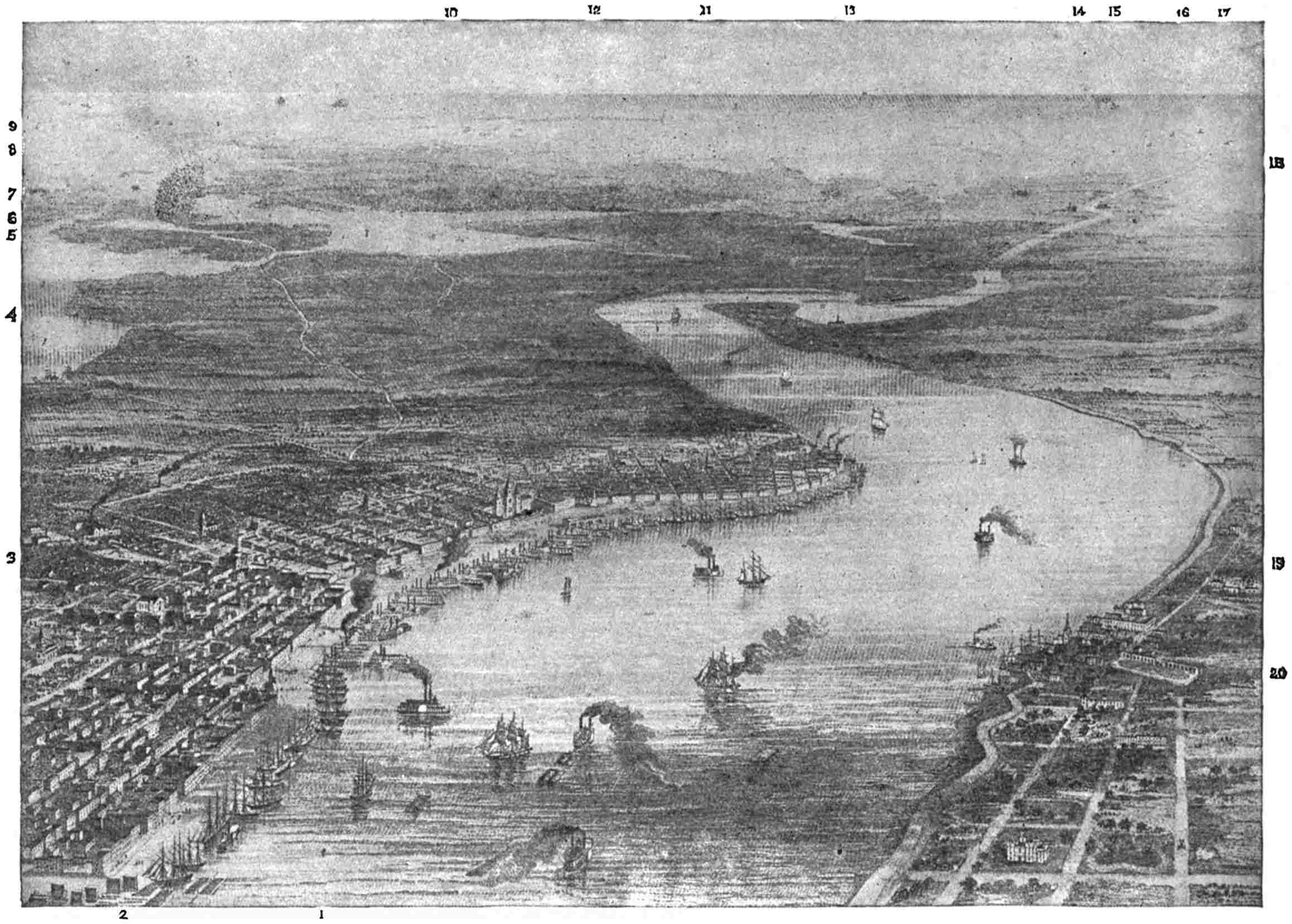
New Orleans, La., and its Vicinity.
1. Mississippi River. 2. Levee. 3. St. Charles Hotel. 4. Lake Pontchartrain. 5. Fort Pike. 6. Rigolets. 7. Lake Borgne. 8. Mississippi Sound. 9. Ship Island. 10. Chandeleur Islands. 11. Gulf of Mexico. 12. Proctorsville. 13. Fort Dupré. 14. Fort St. Philip. 15. Fort Jackson. 16. Balize. 17. South Pass. 18. Southwest Pass. 19. McDonoughville. 20. Algiers.
320
Doubtless the Confederates depended too much on what nature had done for the defence, but they tried to add to the forces of nature by stretching a barrier from Fort Jackson to the east across the river. Barriers appeal to the unlearned mind, but they have never obstructed a fleet that was commanded by a determined man. Rafts of big cypress logs were built and anchored in line, and then chain cables taken from the Pensacola Navy Yard were stretched from trees on the Fort Jackson side over these supporting rafts to heavy anchors buried on the east side. Before Farragut arrived the floods of spring and the accumulation of driftwood had broken the barrier, but it was renewed by substituting schooners in place of the rafts where the current was heaviest.
In addition to the forts and barrier chain, the Confederates had the support of eleven steamers and a floating battery. This battery was built as an ironclad steamer to carry sixteen heavy guns behind plenty of armor, but there were so many strikes in the shipyard where she was built that she barely got afloat, and she was towed to a place at the forts. Her engines were never used. Had Farragut been delayed ten days more, she would have been a formidable ship, and she would have had a still more formidable consort in another and larger ship of her class that never got afloat.321 She was called the Louisiana, and was commanded by Capt. John K. Mitchell. Another of this squadron was the ram Manassas, that under Lieutenant Warley had created a Manassas-like panic in the blockading squadron some months before. Two of the squadron belonged to the State of Louisiana. They were called the Moore, Capt. Beverly Kennon, and the McRae, Capt. Thomas B. Huger. These were cotton-clads—ocean-going steamers protected with cotton bales—very inferior as fighting ships, and yet the able Kennon made a name for himself with the Moore. Of the remainder of the squadron it may be said that six were of the “River Defence Squadron”—the guerrillas afloat—and that one of the captains said just before the battle that they were there “to show the naval officers how to fight.”
There were also a number of unarmed vessels present, whose duty it was to handle the fireboats that had been prepared—huge coal barges loaded with fat pine knots that might have made serious trouble had they all been turned loose together at the right time. And one of these unarmed boats was the Mosher, with a crew of six men under Captain Sherman—the bravest man in the Confederate squadron; but because he was only a tug captain no record was made of his first name, nor322 is anything said in history of his antecedents. Of the armament of the Confederate squadron little need be said. The Louisiana was well armed, and the rest poorly. The Moore, under Beverly Kennon, had two thirty-two-pounders, and she was about as well off as any.
While Farragut prepared his fleet a coast survey party under F. H. Gerdes triangulated the river, under fire at times, and set flags on the banks where the mortar schooners were to be moored. One division of these was placed on the west bank, under shelter of forest trees, and at an average distance of about 3,500 yards from the fort. The other division was on the east bank. The exact range was given to each schooner captain, and at ten o’clock in the morning on April 18, 1862, the bombardment of Fort Jackson began. The mortars were fired once in ten minutes, and the fire was continued for six days.
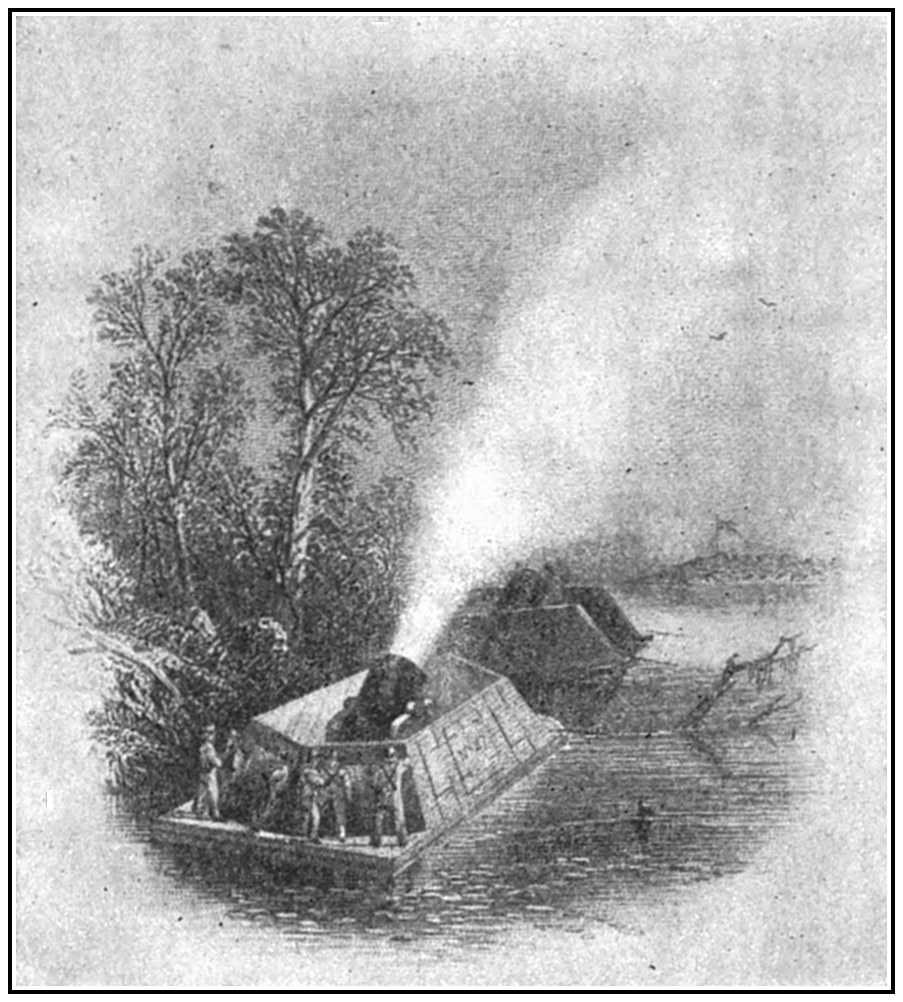
Mortar Boats.
From an engraving.
Meantime Lieut. C. H. B. Caldwell had requested permission to break the chain barrier,323 and on the night of the 20th he was sent with his boat, the Itasca, and the Pinola, Lieut. Pierce Crosby commanding, to do so. While the mortar schooners dropped their shells in a shower on Fort Jackson to keep down the fire as much as possible, two of the barrier hulks were boarded, and on one of them it was found possible to slip her anchor chain. This was done, and she drifted away, leaving the barrier chain to sag down under water. Then Caldwell got above the barrier with his shoal-draft Itasca, passing through a narrow space between the hulks and what remained of the old raft barrier. Running up far enough for good headway, he turned back at full speed with the current to aid him, and headed for the place where the released hulk had been. As the Itasca struck the sagging chain with her curved bow, she rose more than three feet out of water, and then the chain snapped under her weight, and away she went. The barrier was effectually broken, and the route to New Orleans was open. All this was done under heavy fire, but there was no picket boat guarding the chain.
At this time the British frigate Mersey, Captain Preedy, and a Frenchman were lying with Farragut’s fleet. These two foreigners steamed up the river to examine the barrier, and on coming back were at great pains to324 inform the Union forces that the forts were in perfect order and the barrier absolutely impassable. The French were at that time planning to establish an emperor on a throne in Mexico.
As said, for six days the mortar flotilla hurled shells high in air to drop in and around Fort Jackson. By day each mortar threw a shell every ten minutes—the flotilla of twenty threw 120 per hour—and at night they threw one every half-hour each. On the 19th one of the schooners was sunk by a shot from the fort, and another was thrown out of the fight later on; but on an average about 1,900 shells were thrown each day. The effect of these shells was to destroy all the buildings in the fort, and, by cutting the levee, to flood the floors of the bomb-proofs. They kept the men under cover, and rendered them so uncomfortable that in the end they became desperate. What they did then will be told further on. The garrison lost fourteen killed and thirty-nine wounded in the course of the fighting.
Having the way clear, Farragut, on the 23d of April, 1862, issued his orders for an advance that night. The squadron was divided into two divisions, and Capt. Theodorus Bailey had the honor of commanding the first division. His division flag was hoisted on the Cayuga, that was to lead the line in what was325 supposed to be the post of real danger. A ship’s cutter under Caldwell rowed up to the break in the barrier and found it still open. The Confederates had a big wood-fire burning, and the cutter crossed its light, but was not attacked. It was a dark, still night—not the best for the work—but at 2 o’clock in the morning of the 24th two red lanterns were hoisted at the peak of the flagship Hartford, and a moment later the shrill piping of the boatswain’s whistle was heard throughout the squadron with the call “All hands up anchor!”
The merry click of the pawls as the men walked around the great capstans soon rose on the still air—rose so high that it reached up to the sentinels on Fort Jackson and roused the garrison to a knowledge that an important action impended. It was a long task to get the anchors of the largest ships, for they were breasting a three-knot current, but soon after 3 o’clock they all got under way, and Porter’s mortars, firing as fast as the men could tong the shells into them, began drawing an almost unbroken arch of fiery bombs from the schooners to Fort Jackson. The nation had never seen such a display of fireworks as that. At 3.30 o’clock precisely the division leader Cayuga passed in silence through the barrier, followed by the huge Pensacola, and then a flaming storm broke loose from the forts.326 Huge piles of wood were lighted on the shore to illuminate the river, and away upstream the blaze of fire-rafts opened the murk of night to reveal the Confederate ships, weird and indistinct of outline, scattered along the shores. The Union gunboats dashed ahead at full speed, but the Pensacola and Mississippi steamed slowly, their black hulls at regular intervals sheeting the air with lurid fire as they replied to the forts. Abreast of St. Philip, where the Confederate fire was hottest, they drew in so close that the gunners afloat and those ashore heartily cursed each other as they worked. With fierce energy the men ashore drove shot and shell into the wooden ships, while those afloat dusted the rampart with hurtling showers of grape and canister. And these were showers that no man could face, and the garrison fled to cover for a moment, but they returned again as the blasts ceased with the passing of each ship.
For the first division it was at first but a simple journey. They were through the barrier and away before the Confederates fully realized what was upon them. But for Farragut, at the head of the second division, it was another matter. The clouds of smoke from the batteries settled low upon the water to blind the pilots, and then came the blazing fire-rafts to add to the confusion and the danger.329328 As it happened, it was the Hartford that caught the first of these rafts. She had grounded in the smoke and was trying to back off, when the Confederate tug Mosher shoved the flaming barge against her. In an instant the paint on the whole side of the ship was flaming up almost to the lower yards.

Beginning of the Battle of New Orleans.
From a painting by Admiral Walke.
As the flames rose, the men at the guns on that side drew back, but they faced the danger again as Farragut shouted:
“Don’t flinch from that fire, boys; there’s a hotter fire than that for those who don’t do their duty.”
But in a moment the case seemed desperate even to Farragut’s courageous soul, for he raised his hands above his head and exclaimed, “My God, is it to end in this way?” Just then Master’s Mate Allen, in charge of the ship’s fire-brigade, climbed into the mizzen rigging with the nozzle of a hose in his hand, and a moment later the spurting water of the hose had drowned the soaring flames.
Meantime the tug Mosher had held the raft faithfully against the Hartford, although under the very muzzles of the ship’s big guns and in the brilliant light of the blazing fire. But a half dozen shells were fired at her, and drifting away, she sank in the black water, carrying down every one of the heroic men upon her.330 And that was not the last case where men were found to face certain death in this fashion.
The accounts of what was done by other vessels of the fleets are as confused as were their movements as seen by the various spectators. It appears, however, that while the last division of the squadron struggled through the pass in the barrier the Cayuga, at the head of the first, suddenly found herself among the Confederate gunboats and the guerrillas that were going to show the naval officers how to fight. She had passed, perhaps without seeing her, the dread ironclad Louisiana, moored above Fort St. Philip, but the rest of the Confederate ships were lively enough. The guerrillas were lively in their haste to escape, those that had steam up flying for life, and the crews of those without steam setting them on fire and scrambling ashore in haste, while the Cayuga fired right and left at everything in sight. The Moore was close beside the Cayuga on one side, and the McRae on the other. Both received a severe pounding as the Cayuga passed on. The Oneida was not far in the wake, and she, too, gave broadsides to the Confederates. The Varuna, swiftest of the government squadron, ran past everything and continued up the river, followed by the Confederate steamer Moore with the Union signals aloft. Captain Kennon, seeing that the Confederates332331 were being whelmed by the Union forces, determined to escape up the river.
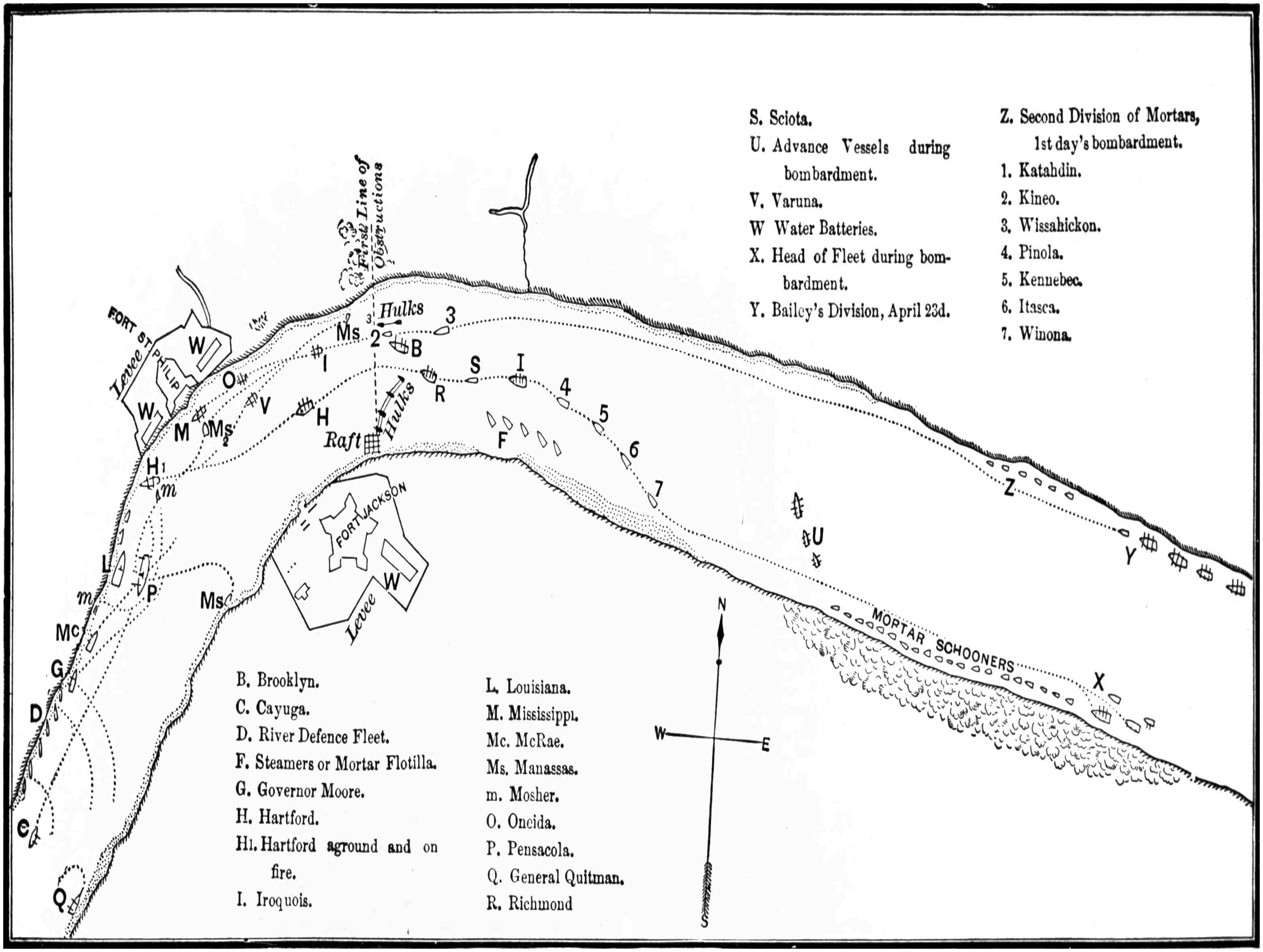
B. Brooklyn.
C. Cayuga.
D. River Defence Fleet.
F. Steamers or Mortar Flotilla.
G. Governor Moore.
H. Hartford.
H1. Hartford aground and on fire.
I. Iroquois.
L. Louisiana.
M. Mississippi.
Mc. McRae.
Ms. Manassas.
m. Mosher.
O. Oneida.
P. Pensacola.
Q. General Quitman.
R. Richmond.
S. Sciota.
U. Advance Vessels during bombardment.
V. Varuna.
W. Water Batteries
X. Head of Fleet daring bombardment.
Y. Bailey’s Division, April 23d.
Z. Second Division of Mortars, 1st day’s bombardment.
1. Katahdin.
2. Kineo.
3. Wissahickon.
4. Pinola.
5. Kennebec.
6. Itasca.
7. Winona.
Battle of New Orleans.
From “The Navy in the Civil War.”
As the Varuna and the Moore disappeared the McRae turned down toward Fort St. Philip. On the way she ran aground, and then the Union steamer Iroquois came along. The McRae fired a broadside of grape and copper slugs at her, and the Iroquois returned it with grape and canister. The slaughter was great on the McRae, her commander, Thomas B. Huger, being among the mortally hurt. Huger, but a few months before, had been executive officer of the Iroquois, and most of her crew were the men who had served under him. The McRae afterward got under Fort St. Philip.
The Manassas during this time had not been idle. She had, indeed, plunged into the thick of the Union force. The Brooklyn, in coming through the barrier, almost ran down the Kineo. The collision changed her course, and a minute later the Manassas butted her. Her chain cable saved her from a fatal wound.
As the Manassas glanced clear, a man climbed out of her hatch and stood by her smoke-stack a moment to see what damage she had done, and then he suddenly tumbled over into the water and disappeared. An officer of the Brooklyn afterwards asked the quartermaster, who was heaving the lead in the chains of the Brooklyn on that side, if he333 saw the man fall off the Manassas. “Why, yes, sir,” he replied; “I saw him fall overboard—in fact, I helped him; for I hit him alongside the head with my hand-lead.”
As the Brooklyn passed on, the Manassas turned upstream after the Union ships, watching for an opportunity to strike. She was seen, and the Mississippi and Kineo turned back to crush her, but she eluded them and ran ashore. At that her crew fled to the river bank, and the Mississippi gave her a broadside that knocked her clear of the mud, and she floated down the river. Opposite Fort St. Philip, Lieutenant Read, of the McRae, boarded her. He reported that she was then sound save for a cut pipe, but he must have been mistaken, for when she was passing Porter’s mortar flotilla she was seen to be on fire, and she soon “exploded faintly” and sank.
About the time the Manassas was abandoned, the Moore, under Beverly Kennon, was overtaking the Varuna not far from the quarantine station. The Varuna’s captain was deceived by the Moore’s false lights. So was one of the Confederate fleet—a swift vessel called the Jackson. The Jackson fired with her one gun at both steamers, and then fled to New Orleans, where her captain set her afire and abandoned her. Then one of the guerrilla fleet, the Stonewall Jackson, came up near the two,334 and Kennon, on seeing her, opened fire on the Varuna. He expected the Stonewall Jackson to come to his help, for the Moore, with only two thirty-two-pounders, was no match for the Varuna. Nevertheless, Kennon had to fight it out alone until victory was won. He was now close on the Varuna’s quarter, where her broadside would not bear on him, but because of the height of his own ship’s bow he could not bring his gun to bear, so he depressed the muzzle of his gun and shot a hole through his own bow to make way for shot to be aimed at the Varuna. The next shot from the Moore raked the Varuna, and to bring his broadside to bear, Captain Boggs, of the Varuna, put her helm over, and turned her across the course of the Moore. And that was a fatal error, for Kennon, instead of turning away, turned toward the Varuna and drove the sharp bow of the Moore, crashing through her side. The Varuna got in a raking broadside that was very destructive, but was herself cut through. The Moore hauled off and kept on upstream, and then came the Stonewall Jackson and rammed the Varuna on the other side. The Varuna was then headed to the easterly bank, where she sank, leaving her bow out of water.
But neither the Moore nor the Stonewall Jackson escaped, for the Oneida and Cayuga came on and drove them both ashore. The337 Moore was fired, but her crew surrendered when the Pensacola came along.

The Battle of New Orleans.
From a painting by Admiral Walke.
Of the whole Confederate squadron only the Louisiana, the McRae, and the guerrilla Defiance remained, and they were under the guns of Fort St. Philip. The Defiance had been abandoned, but men from the McRae took possession of her. The Louisiana, even as a floating battery, did nothing but fire a broadside or two at the passing squadron.
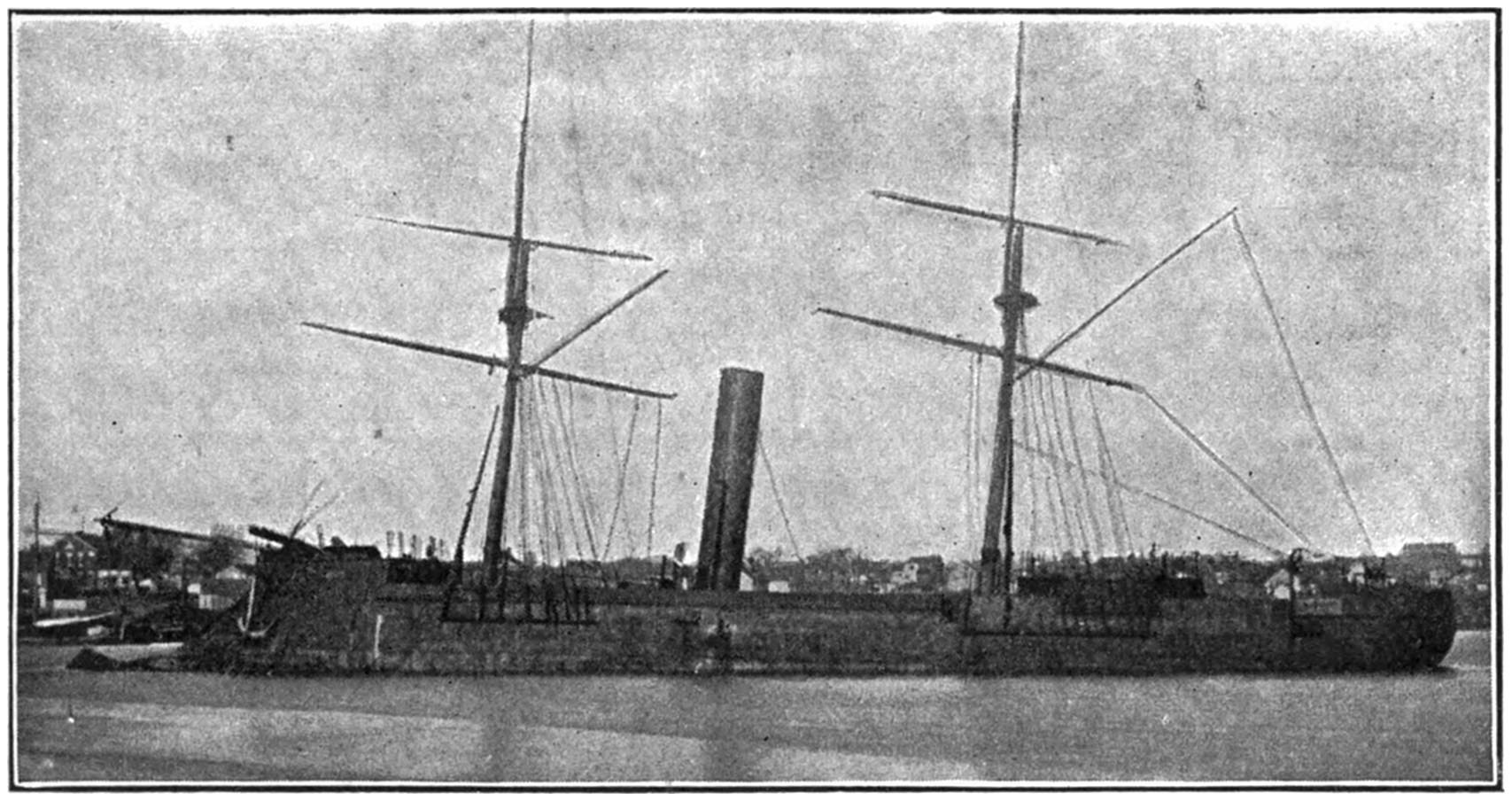
Confederate Ironclad Ram Stonewall Jackson.
From a photograph.
The river was clear, save for two batteries of no account, as far as New Orleans, and at 1 o’clock in the afternoon, on April 25, 1862, the triumphant government squadron was before the Crescent City. It had lost only thirty-five killed and 128 wounded.
But two or three incidents of the occupation338 of the city need be mentioned. Captain Bailey and Lieut. George H. Perkins were sent ashore to demand that the mayor haul down the Confederate flags. A howling mob surrounded and insulted and even threw filth upon the two lone officers, who were simply obeying orders. The letter of Farragut was delivered to Mayor Monroe in the presence of Pierre Soulé, who had been a senator and a minister to Spain. Primed by Soulé, the mayor wrote a letter filled with such expressions as “you have a gallant people to administer”; “sensitive to all that can affect its dignity and self-respect”; “order and peace may be preserved without resort to measures which could not fail to wound their susceptibilities and fire up their passions”; “you may trust their honor, though you might not count on their submission to unmerited wrong.” As to the Confederate flags, “nor could I find in my entire constituency so wretched and desperate a renegade as would dare to profane with his hand the sacred emblem of our aspirations.”
The flags came down, however, and the old flag was raised over the Mint. A gambler named Mumford, with three associates, hauled it down, dragged it in the streets, and tore it to pieces. It was a wild town until May 1st, and even for a few days later; but on May 1st came Benjamin F. Butler with his troops339 from the transports that had accompanied the Union warships, and Butler was the man for the place. If any reader wants to learn how to tame a mob with superabundant “sensibilities” and “passions” and “aspirations” and “honor” mixed in the jumble exhibited by Pierre Soulé and Mayor Monroe, let him read “Butler’s Book.”
To return to Forts St. Philip and Jackson, it must be said that with the government forces above and below them, they were in such a desperate strait that when Porter threatened to renew the bombardment, more than half the garrison mutinied. Most of them were foreigners, anyway. The forts were surrendered to Porter on April 28, 1862. While Porter was opposite Fort Jackson negotiating for the surrender, under a flag of truce hoisted on the fort and on his flagship, Commander John K. Mitchell, of the ironclad Louisiana, set her on fire, and she came drifting down upon the Union squadron lying under the flag of truce. Fortunately, she blew up just before she arrived where she could do any damage. Some Confederate writers like Scharf assert that Mitchell had a perfect right to destroy her, because she was not included in the surrender. This is correct. But when they say Mitchell “took caution that no injury should fall to the enemy’s fleet while under the flag of truce,”340 they assert somewhat more than the facts warrant, for Mitchell left the ship moored by ropes that he knew would burn off before the fire reached the magazine, and they admit that he did not draw the charges from her heavy guns. They say that he tried to “drown the magazine” and failed, and that he then sent an officer to warn Porter. The officer was sent, but he was sent so long after the fire was started that she blew up before he reached Porter’s ship. Moreover, before the passing of the fleet the Louisiana was moored far up the stream, against the protest of the military authorities, instead of down below, where she could have driven off Porter’s mortars. The Confederate heroes of the fight were Sherman, Kennon, and Huger. Every American thinks of their bravery and skill with pleasure, but Mitchell was another kind of a man.
The capture of New Orleans was of the greatest moment, as the reader will remember. Baton Rouge and Natchez surrendered to Captain Craven, of the Brooklyn, a few days later. Pensacola was evacuated, and the Union forces took possession on May 10th. And because of these gains the French Emperor, who was looking on Texas as well as on Mexico as a good prize, was led to change his mind.
It was Porter’s belief that had Farragut341 been sent to Mobile immediately, it would have fallen with small resistance, if any, and the great battle later on would have been saved. But the Administration wanted the Mississippi opened immediately, and Farragut went up to try it. He succeeded in passing all the fortifications, including those at Vicksburg, where he met Flag Officer Davis. But at Vicksburg the forts were from 150 to 264 feet above the water, and the ships of that day could not successfully attack such works. And even had Farragut captured the forts, there were not enough soldiers at hand to hold the town.
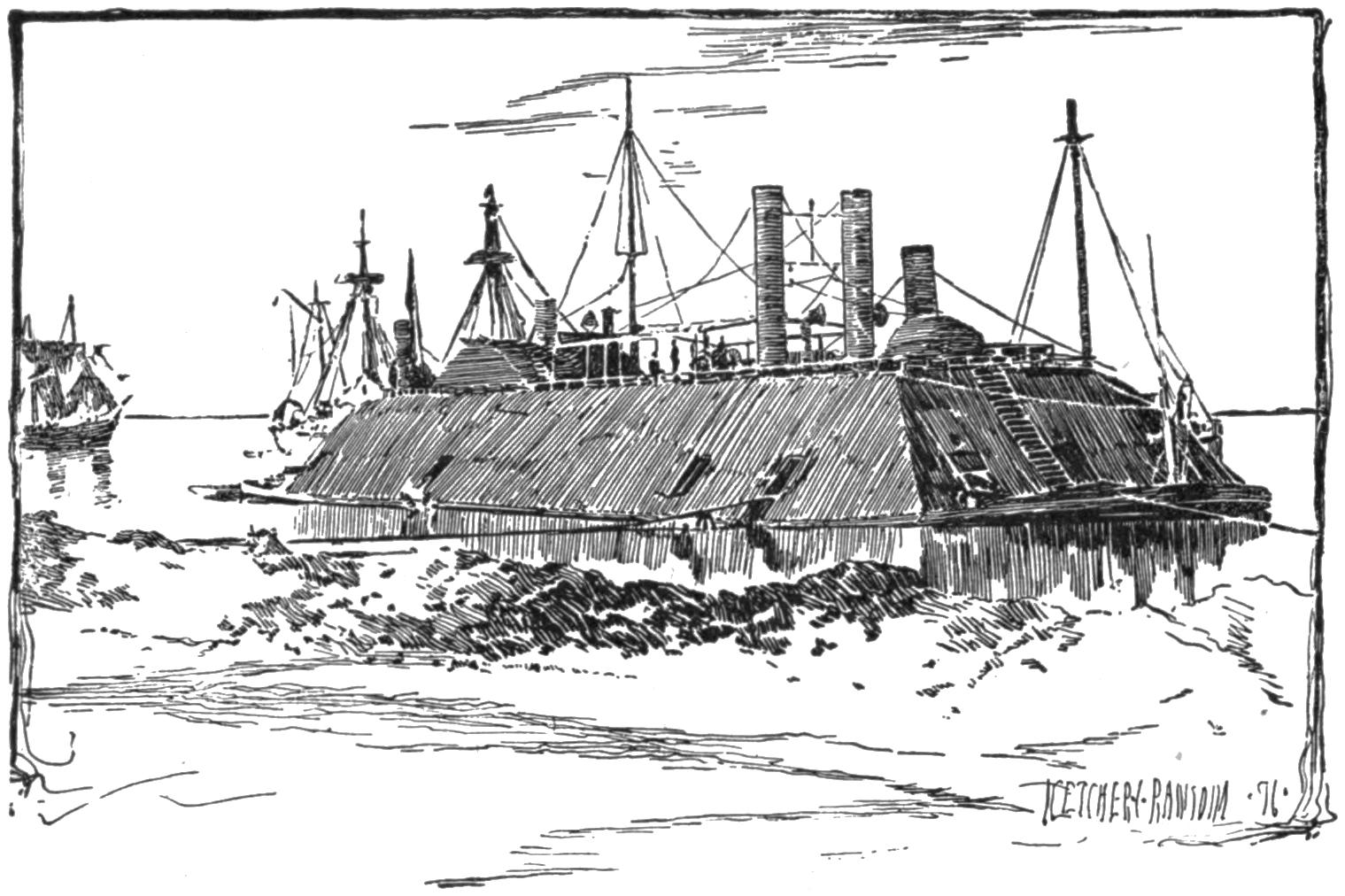
The Essex after Running the Batteries at Vicksburg and Port Hudson.
After a photograph.
In fact, Farragut’s bold cruise up the river was practically fruitless because the Administration342 did not follow it up. This is not said to criticise the Administration. It is the common belief of the American people that no man in the nation could have done better than Abraham Lincoln. But after the batteries were passed at Vicksburg, the Union forces made what Mahan calls a recoil. Vicksburg was more strongly fortified than ever, and so was Port Hudson, while Grand Gulf became a point of no small importance to the Confederates.

The Carondelet after Passing Vicksburg.
From a photograph.
While the combined squadrons of Farragut and Davis lay above Vicksburg a Confederate ram called the Arkansas, Capt. Isaac N. Brown, was reported as about ready for action at a shipyard up the Yazoo River. “Little apprehension was felt in the Union fleet,” but Captain Walke, with the Carondelet, the Taylor, and Ellet’s ram, Queen of the West, went up for343 a look at her on July 15, 1862. Very unexpectedly they met her coming down for a look at the Union forces. The Taylor was in the lead, and she immediately turned back for the support of the Carondelet. The Carondelet turned back for the support of the ram, and the ram turned back for the support of the squadron in the Mississippi. Being very swift, the ram ran soon out of sight. The gunboats now had their unarmored sterns toward the Confederate ship, and for an hour she spanked them soundly, as they richly deserved. The Carondelet at this time actually threw 150 pounds of metal from rifled guns in her bow ports to the 106 that the Arkansas threw from her bow ports, while her broadside fire was 170 pounds to 165 on the Arkansas. And yet, although supposably supported by the Taylor, she ran away, hugging the left bank, where the Arkansas, of thirteen feet draft, could not ram her, and there she eventually grounded, leaving the triumphant Arkansas to chase the Taylor and surprise the government squadrons.
Fortunate it was that the Confederates at the Yazoo shipyards were poor mechanics. When the Arkansas reached the Union squadrons her machinery was in such bad order that she was making barely one knot an hour. The captured ram General Bragg had steam up, but her captain waited for orders, and so missed344 the chance of a lifetime, as Farragut remarked at the time.
Boldly steering through the unprepared squadron, the Arkansas fired right and left and took a position under the Vicksburg batteries. Her crew numbered forty-one. The two Union flag officers were greatly mortified because they were caught napping, and Farragut, to retrieve himself, took his squadron down past the batteries that night, hoping to destroy the Arkansas as he passed, but he failed because she was safely moored. Two days later Farragut and part of his ships went to New Orleans, and the handful of Union troops that had been on the point opposite Vicksburg went to Baton Rouge.
On October 5th Breckenridge attacked the Union forces at Baton Rouge, and the Arkansas went there to help. The Union ironclad Essex, Capt. William Porter, with four other gunboats, were below Vicksburg at the time, three of the others being of Farragut’s fleet. The Katahdin and Kineo were able to give the Union army a good support in a fight against superior numbers. The Arkansas, while trying to come to the aid of Breckenridge, broke down and ran ashore. While she lay in the mud the Essex came up looking for her, and as she could not be moved her crew set her on fire and escaped. She was of the349 usual form of the river ironclads, and was armored with railroad iron. The design and the material were good for that day, but she was doomed to defeat by her builders before she was launched.
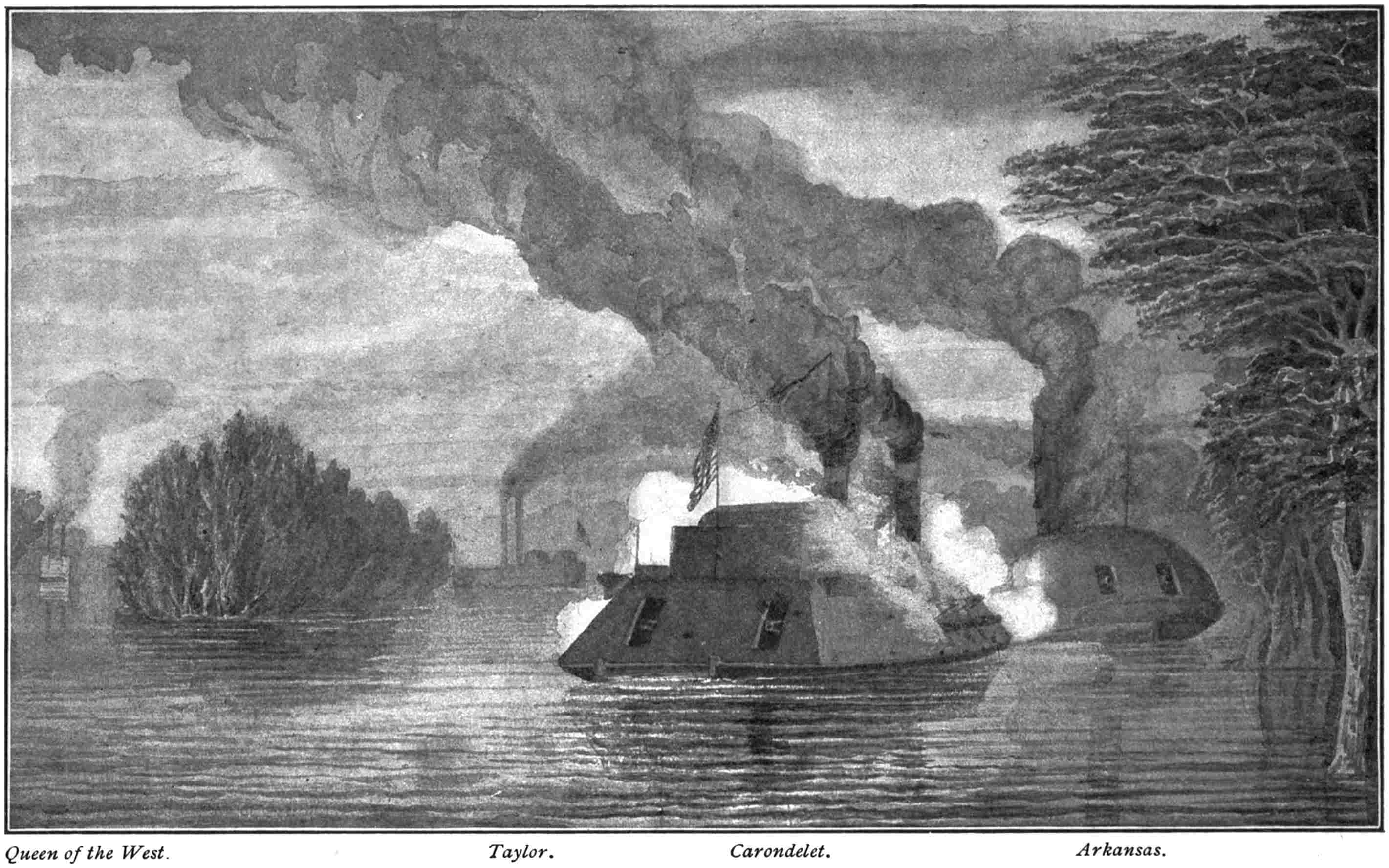
Battle between the Carondelet and the Arkansas.
From a painting by Admiral Walke.
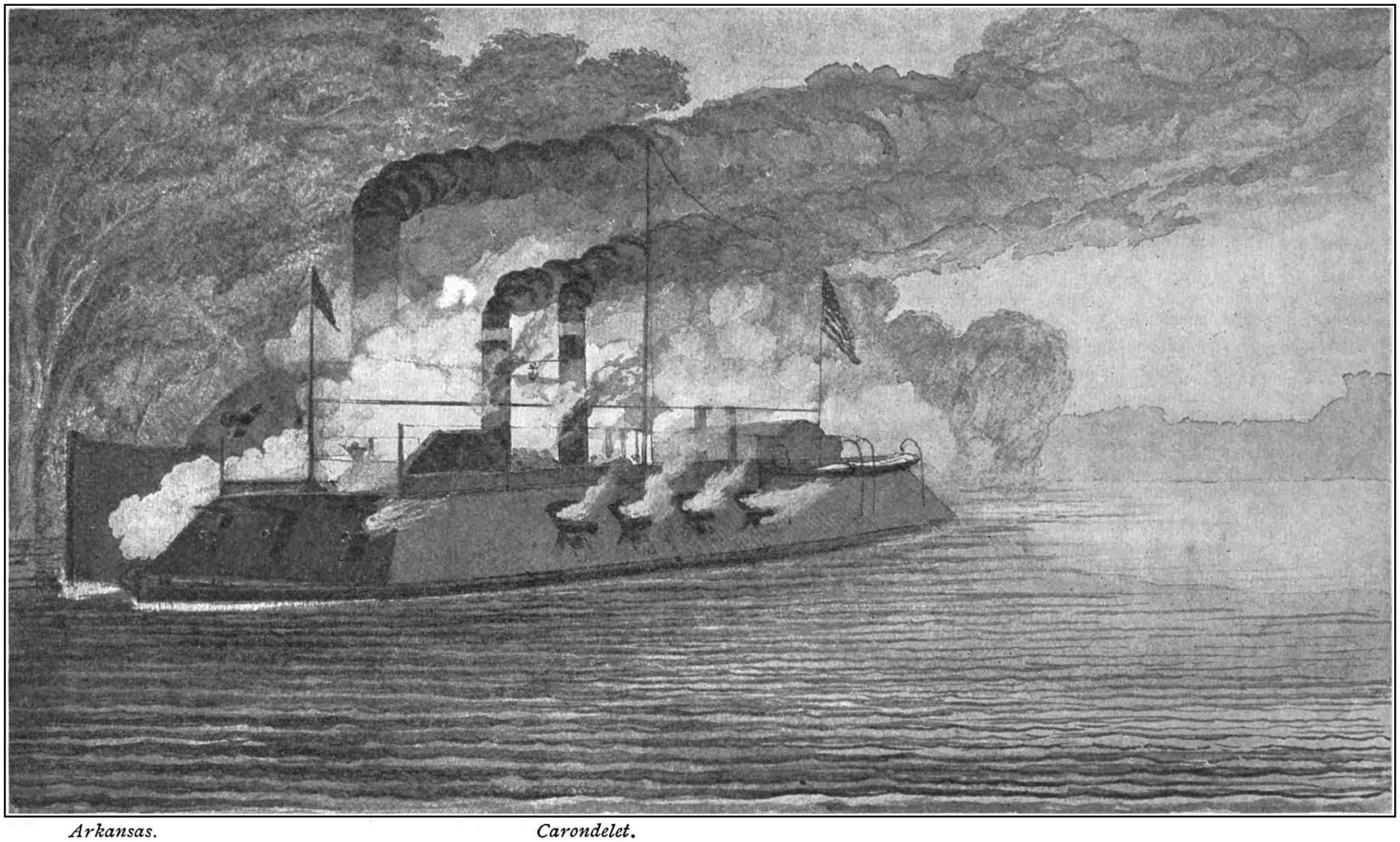
Battle between the Arkansas and the Carondelet.
From a painting by Admiral Walke.
On October 1, 1862, the Mississippi squadron was transferred to the Navy Department, and David D. Porter was promoted and placed in charge. A lot of light-draft steamers clad with half-inch or better iron were added to the squadron and were armed with howitzers. They were called tin-clads, and were of service in carrying transports, and for light work generally.
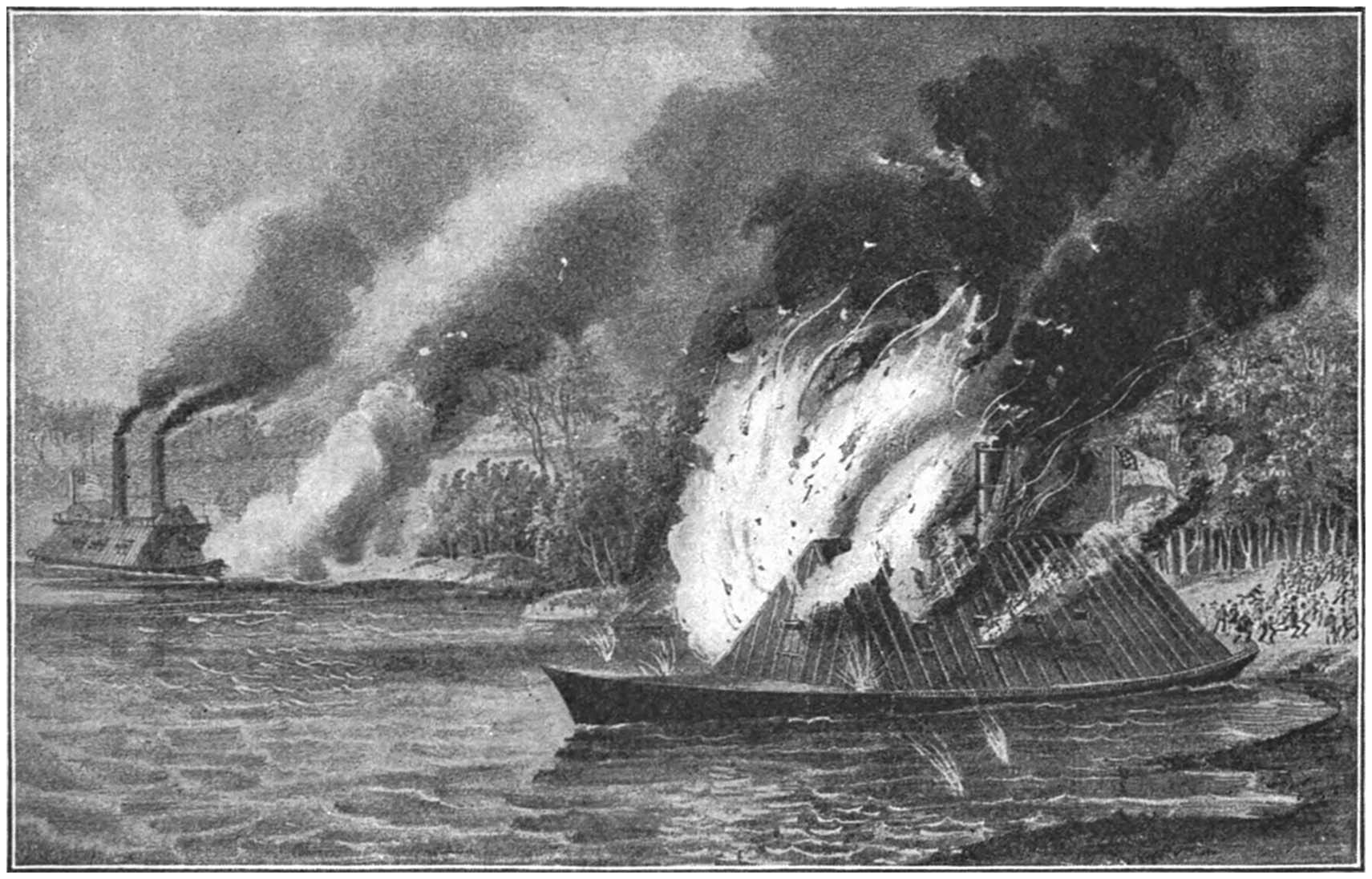
Destruction of the Arkansas near Baton Rouge, August 4, 1862.
From a lithograph published by Currier & Ives.
Another addition to the squadron was a class of heavy boats with their wheels well350 aft and rectangular casemates forward. They carried some eleven-inch Dahlgrens, and were plated with two and three-inch iron, one carrying as much as six inches on the casemate. But they were built in actual war-time, so the builders took advantage of the haste to rob the nation by scamping the work, and the engines were constantly breaking down.
In November the first of a series of moves against Vicksburg was made by the way of the Yazoo River country. The swamps of the Yazoo had served to keep the Federal forces from turning the north end of the Confederate defences along the Vicksburg side of the river, and an expedition was sent across through the bayous, leaving the Mississippi near Helena, and entering the head-waters of the Yazoo. It failed utterly, and the gunboat Cairo was destroyed by torpedoes made of whiskey demijohns.
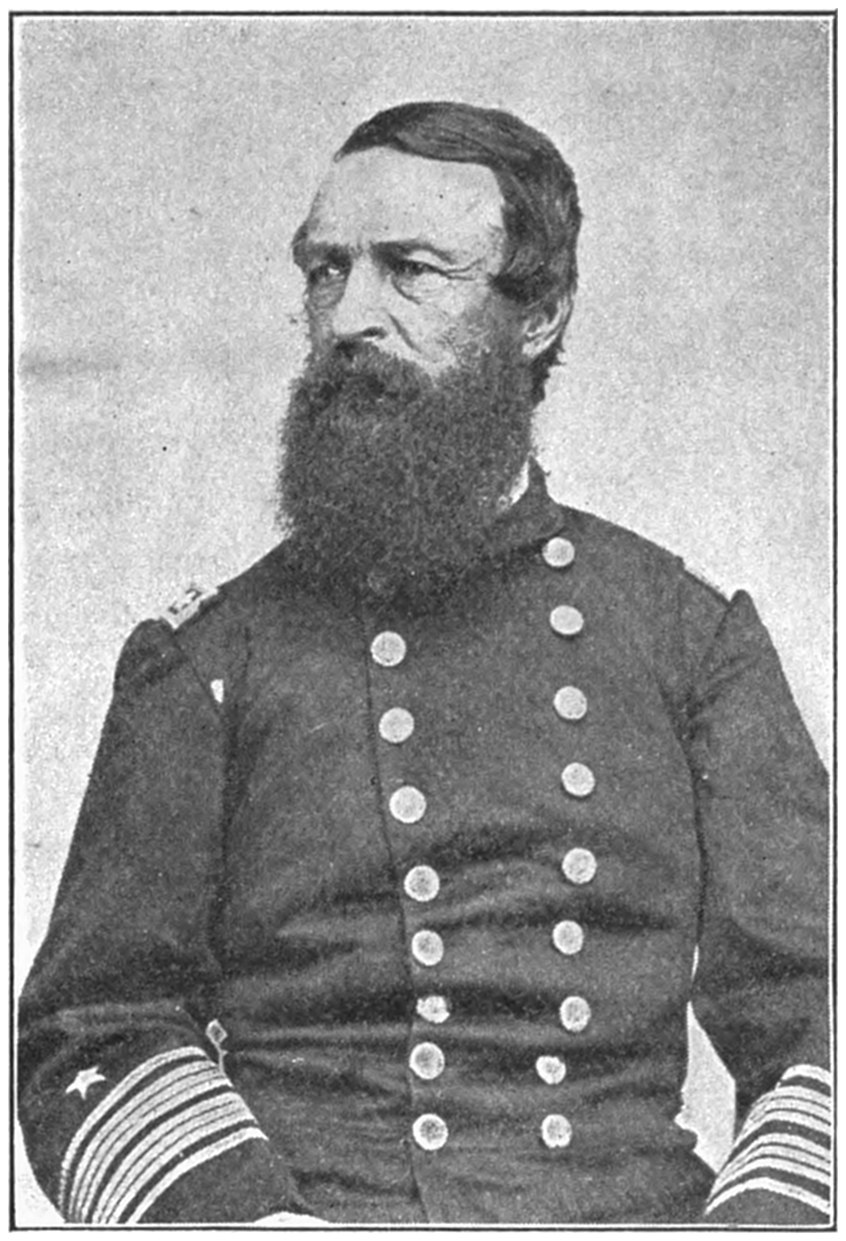
David D. Porter.
From a photograph.
Then, in January, 1863, a naval force was351 sent to help the army capture Arkansas Post, fifty miles up the Arkansas River. The De Kalb (former St. Louis), the Louisville, and the Cincinnati, and all the tin-clads were in the expedition, and on January 9th and 10th they shot the forts to pieces, and disabled all the guns, seventeen in number, including two nine-inch Dahlgrens that had come all the way from the Norfolk Navy Yard. The white flag was raised before the army could make an assault.
General Grant arrived opposite Vicksburg on January 30, 1863, and the plan of attacking Vicksburg by turning the river line on the south was adopted, and that succeeded some months later. Meantime Porter, to control the river between Vicksburg and Port Hudson, sent Col. Charles R. Ellet, with his ram, Queen of the West, down past the Vicksburg batteries. Owing to trouble with her steering gear, she did not get off till daylight on February 2d; but the Ellets were the most recklessly brave family known to the Mississippi. The colonel started in the face of fire, rammed and set fire to a Confederate steamer at the Vicksburg wharf, and passed on without losing a man.
A small ferryboat, called the De Soto, was added to Ellet’s command when below Vicksburg, and then Porter sent down the Indianola, one of the newest armored boats. That seemed to give the Union forces full sway as352 far as Port Hudson; but within a week Ellet attacked a fort near Gordon’s Landing, on the Red River, got his ship aground, and had to abandon her. He retreated in the De Soto until a prize they had captured was reached, when the De Soto was burned, and in the prize (a steamer called the Era) they reached the Indianola. But the Confederates were still after them, using the abandoned Queen of the West and one of the original Confederate rams, called the Webb, with a couple of ordinary river steamers, the whole fleet being protected with cotton. The Indianola tried to escape up the river, but the rams being swifter, chose their own time, and rammed her to death on the night of the 24th. The Confederates once more held the river.
A curious thing then happened. The Indianola was sunk on the easterly bank, not far below Vicksburg. A Confederate force set to work to raise and repair her. They were getting on well, when, early on the morning of the 26th, a Federal gunboat was reported coming down the river. There was a most furious cannonading at the Vicksburg batteries, and the four steamers that had so gallantly captured the Indianola at once fled militia-fashion. A lieutenant with a hundred men was left on the wreck (she was awash and near shore); but when he saw what a fearsome357 aspect the coming monster had, he set the Indianola’s two big guns muzzle to muzzle, fired them to destroy them, and then fled. The story of these doings made the government forces laugh and the Confederates curse for many a day after that, for the so-called gunboat was a dummy in the form of a monitor, sent adrift for a lark by Porter’s men.

Admiral Farragut Passing Port Hudson.
From a painting by Admiral Walke.
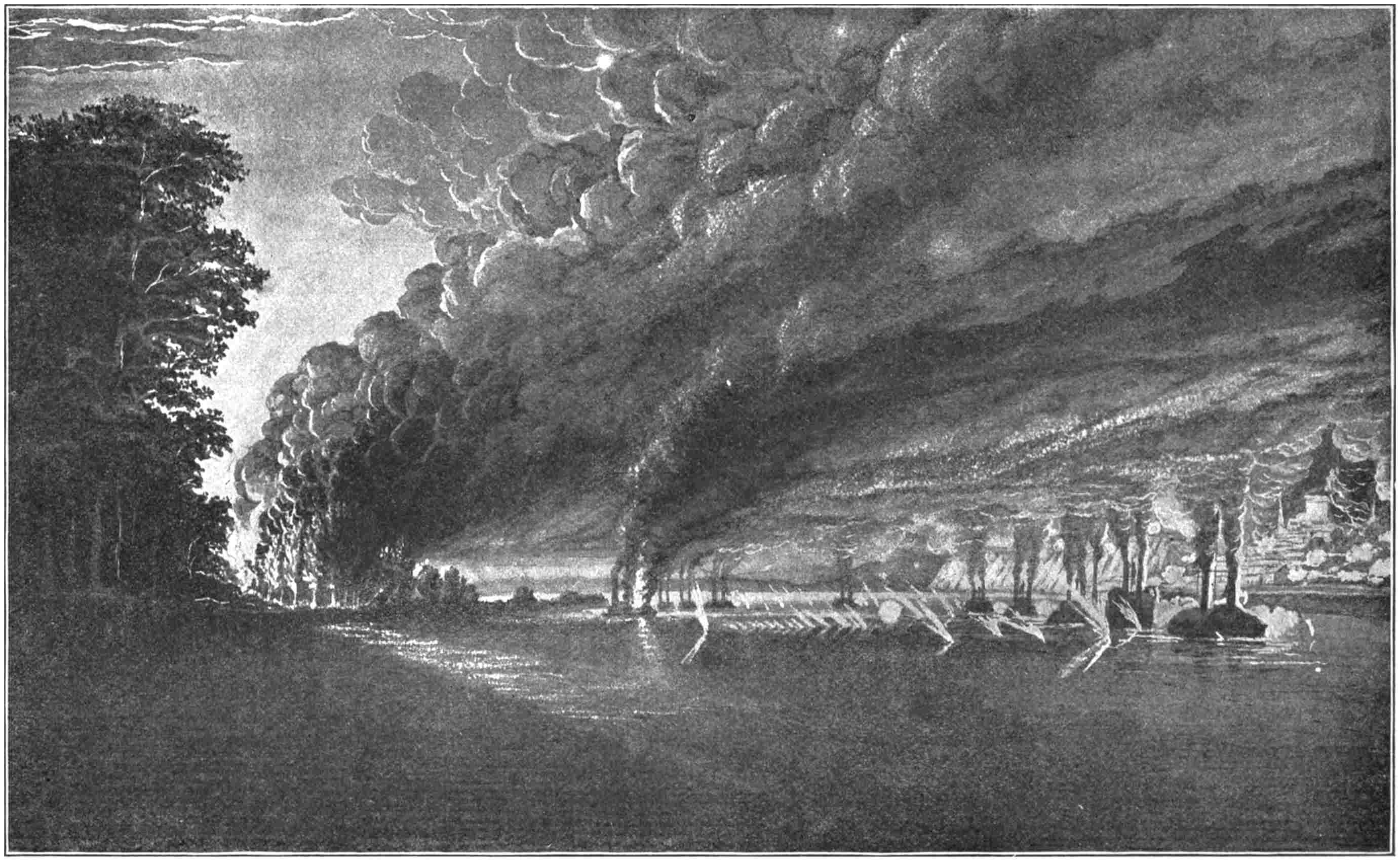
The U. S. Flotilla Passing the Vicksburg Batteries.
From a painting by Admiral Walke.
On the whole, however, the Confederates were plainly having the best of the contest, and Farragut came up from the Gulf to see about matters. He had himself had both good and bad fortune in the Gulf. A number of Texas ports, including Galveston and Corpus Christi, were captured, but Galveston was retaken by the Confederates, who attacked it with a combined land and marine force, the ships being cotton-clads. The Union navy had the Westfield destroyed, and the Harriet Lane captured, after both her captain and executive officer were killed. And a little later the famous Alabama appeared at night off Galveston. An armed merchant steamer was sent to inspect her, and the Alabama opened fire and sank her, escaping before the other blockading steamer could come out to assist.
So Farragut was in a state of mind to take risks, and he ran his squadron past the works at Port Hudson on the 14th of March, 1863, where nineteen heavy guns were mounted. It358 was a dangerous place naturally on account of the currents in the stream and the shoals. Seven vessels, including the Hartford, tried the passage. The Hartford, with the gunboat Albatross alongside, led the procession. The Monongahela, with the Kineo alongside, were next, with the Richmond and Genesee following, and the Mississippi alone in the rear.
The Hartford with her consort got past the batteries after some little trouble. The Richmond was disabled by a shot, and with her consort’s aid turned back. The Monongahela and consort both grounded, but the Monongahela passed on, while the Mississippi grounded so hard that she was fired and abandoned. It was a pretty serious affair for the government force, but the Red River was blockaded, and it was not opened for traffic until the end of the war. When two of the Ellet rams were sent down past Vicksburg to increase Farragut’s force above Port Hudson, one, the Lancaster, was sunk, and the other got through. Both were commanded by the indomitable Ellet boys.
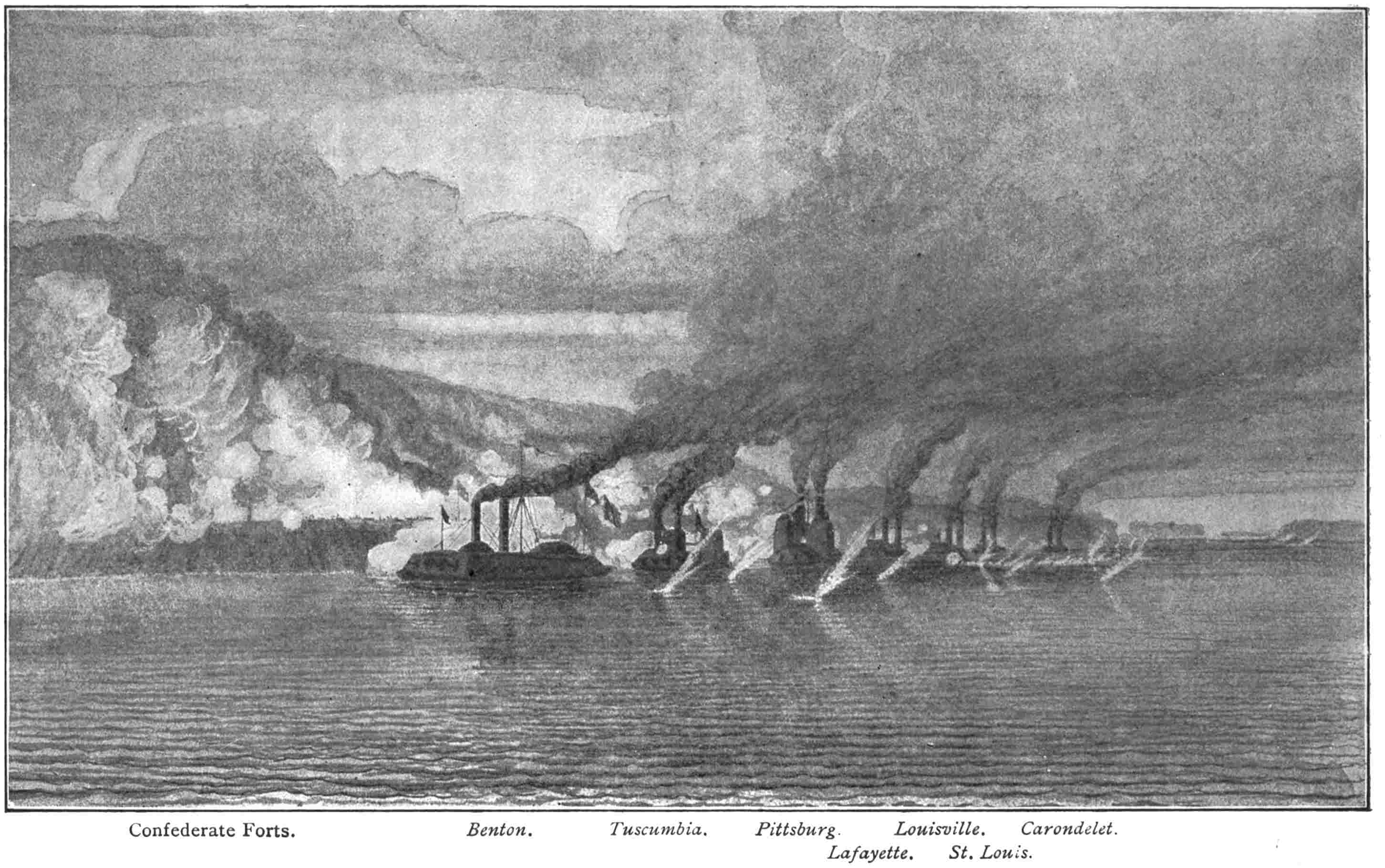
Battle of Grand Gulf—First Position.
From a painting by Admiral Walke.
Near the end of February, while Farragut held the river between Port Hudson and Vicksburg, Porter tried to get in behind Vicksburg by the way of the Yazoo swamps once more. He took a different route from that of the first expedition, but he could not drive the tin-clads361 over the willows, and the Confederates cut trees across the bayous both in front of and behind his steamers until he was well-nigh lost. And at the last he found his way blocked by the hulk of the Star of the West, the steamer at which the first shot of the war was fired—the shot that turned her back when she was carrying supplies to Fort Sumter. After the Sumter event she had gone to New Orleans, was there taken forcibly by the Confederates, and ended her existence as a barrier hulk in a Yazoo bayou.
This expedition having failed, Grant determined to go down the westerly bank of the Mississippi to New Carthage, and then cross and surround Vicksburg. On the night of April 16, 1863, Porter took the following vessels down past Vicksburg to cover Grant when crossing: The flagship Benton, sixteen guns, Lieut.-commander James A. Greer, leading, and the other vessels in the following order: Lafayette, eight guns, Capt. Henry Walke; Louisville, twelve guns, Lieut.-commander Elias K. Owen; Mound City, fourteen guns, Lieut. Byron Wilson; Pittsburg, thirteen guns, Lieut. W. R. Hoel; Carondelet, eleven guns, Lieut. J. McLeod Murphy; Tuscumbia, five guns, Lieut.-commander James W. Shirk. The Lafayette carried with her, lashed to the other side of her coal barge, the ram General362 Price, Lieut. S. E. Woodworth, which had continued in the service after being taken from the Confederates at Memphis. After the Carondelet, between her and the Tuscumbia, came three army transports, the Silver Wave, Henry Clay, and Forest Queen, unprotected except by bales of hay and cotton round the boilers. They carried stores, but no troops.
The armed vessels were repeatedly hulled, but were in no way disabled. One transport, the Henry Clay, caught fire and sank. On the 22d of April a number of transports ran the batteries, and on the 29th, the plans having been changed somewhat, the squadron attacked the works at Grand Gulf. Here there were four of the best rifled cannon of the day, two eight-inch smooth-bores, two old thirty-twos, and some light guns—a battery of not a fourth of the power of the fleet, but it was seventy-five feet above the water, and the fleet pounded it all day and accomplished nothing. They lost eighteen killed and fifty-six wounded at that.
However, the work of carrying the army across the river at Bruinsburg, below Grand Gulf, began next day. This was on April 30th. On that day the gunboats left above Vicksburg made such a determined attack on the works there that no reinforcements were sent down to Grand Gulf. Having carried the367 Union army over at Bruinsburg, Porter, on May 3d, attacked the works at Grand Gulf and found them evacuated. Then Grant made Grand Gulf his base of supplies, and the surrounding of Vicksburg was accomplished by May 21, 1863. From that time on a steady advance was made by the army, and the flotilla supported every movement by shelling the river batteries. There was no great conflict on the part of the navy, but the help of the ships in keeping open the water route for supplies and in covering the movements of the army was fully appreciated by General Grant and by the whole nation. The writer hereof, who was a lad in the backwoods of Ohio at the time, remembers that when, on the afternoon of the 4th day of July, the people of the village where he lived, half crazy with joy over the news, were piling up dry rails fifty feet high for a bonfire to celebrate the fall of Vicksburg, the name of Porter was frequently mentioned by the shouting crowd, with that of Grant, although the people there didn’t know a warship from a coal barge.

Battle of Grand Gulf—Second Position.
From a painting by Admiral Walke.
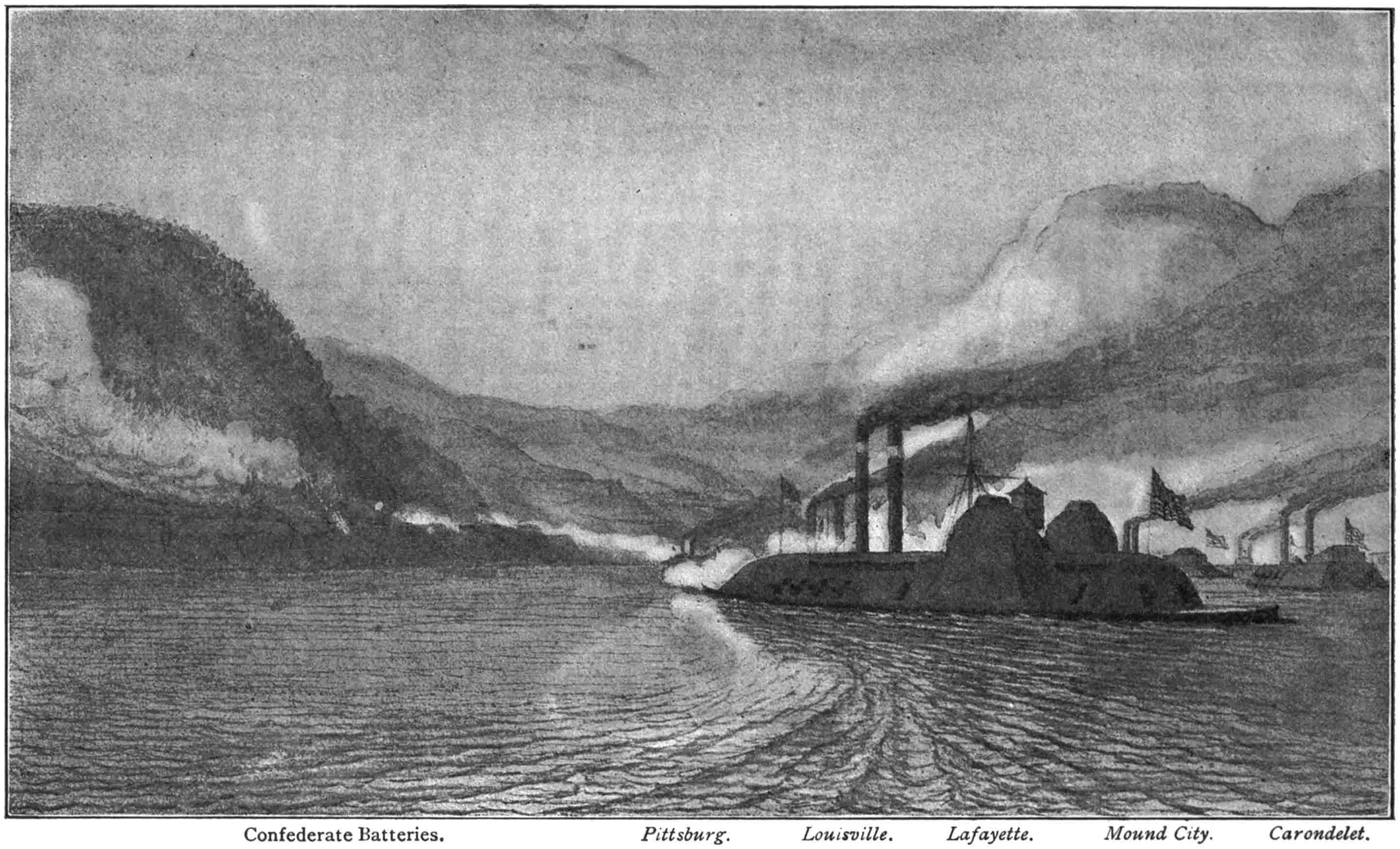
Battle of Grand Gulf—Third Position.
From a painting by Admiral Walke.

Admiral Porter on Deck of Flagship at Grand Écore, La.
From a photograph.
Meantime, while Grant was before Vicksburg the French troops were in Mexico, and on June 10, 1863, they entered Mexico City, the capital. The French Emperor, Napoleon III, had shown an unfriendly disposition toward the United States, and, as already intimated,368 had been trying, through his diplomatic agents, to get Texas to secede from the Confederacy and establish an independent government. The operations of the French led the Administration at Washington to send General Banks on an expedition that had Shreveport, on the Red River, near the boundary between Louisiana and Texas, and about 400 miles from369 the Mississippi River, for its destination. It may be briefly said that the expedition won some battles and accomplished nothing. Admiral Porter, with the following vessels, accompanied the expedition:
Essex, Commander Robert Townsend; Eastport, Lieut.-commander S. L. Phelps; Black Hawk, Lieut-commander K. R. Breese; Lafayette, Lieut.-commander J. P. Foster; Benton, Lieut.-commander J. A. Greer; Louisville, Lieut.-commander E. K. Owen; Carondelet, Lieut.-commander J. G. Mitchell; Osage, Lieut.-commander T. O. Selfredge; Ouachita, Lieut.-commander Byron Wilson; Lexington, Lieut. G. M. Bache; Chillicothe, Lieut. S. P.370 Couthouy; Pittsburg, Lieut. W. R. Hoel; Mound City, Lieut A. R. Langthorne; Neosho, Lieut. Samuel Howard; Ozark, Lieut. G. W. Browne; Fort Hindman, Lieut. John Pearce; Cricket, Master H. H. Gorringe; Gazelle, Master Charles Thatcher.
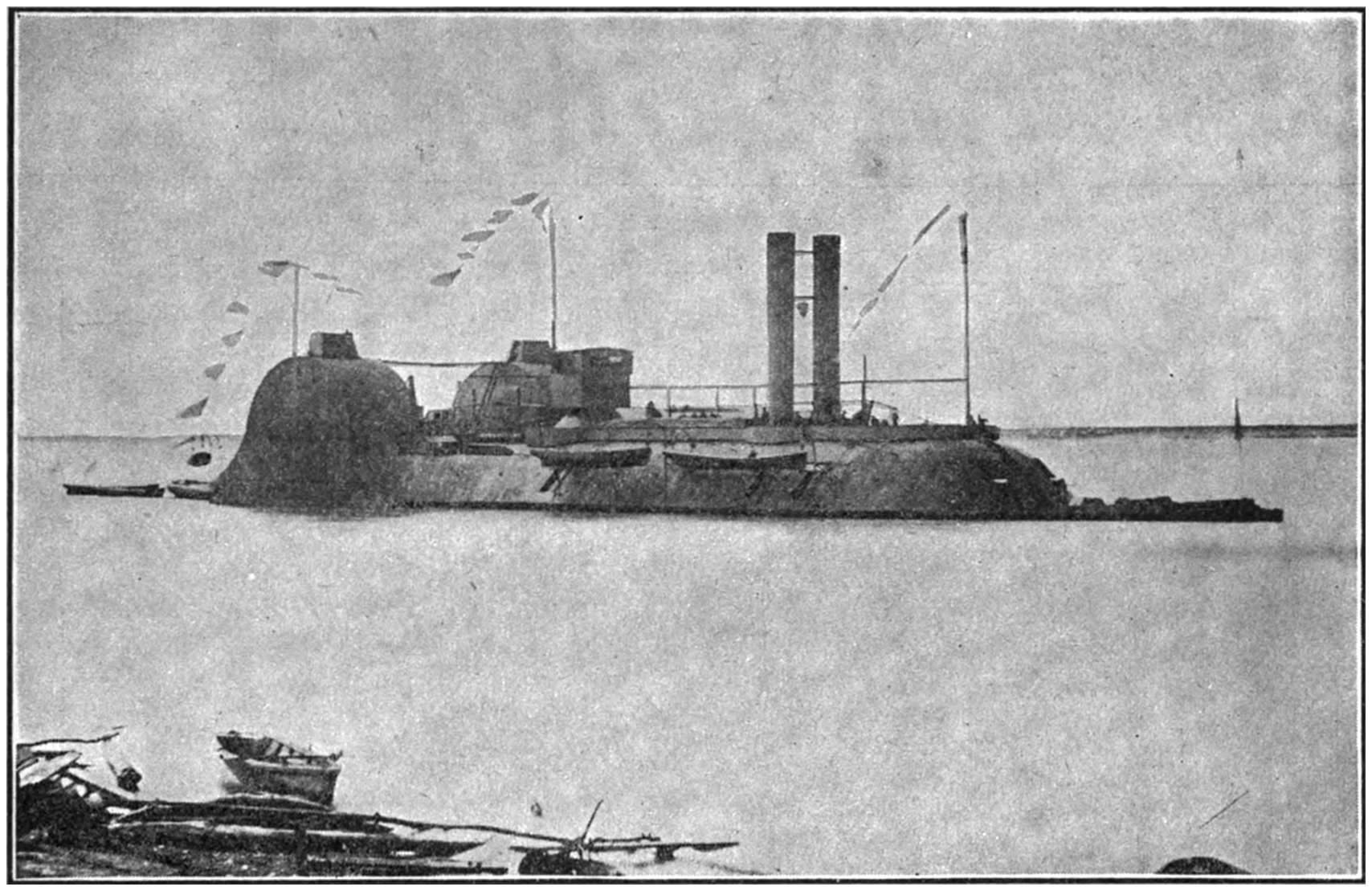
U. S. Ram Lafayette.
From a photograph.
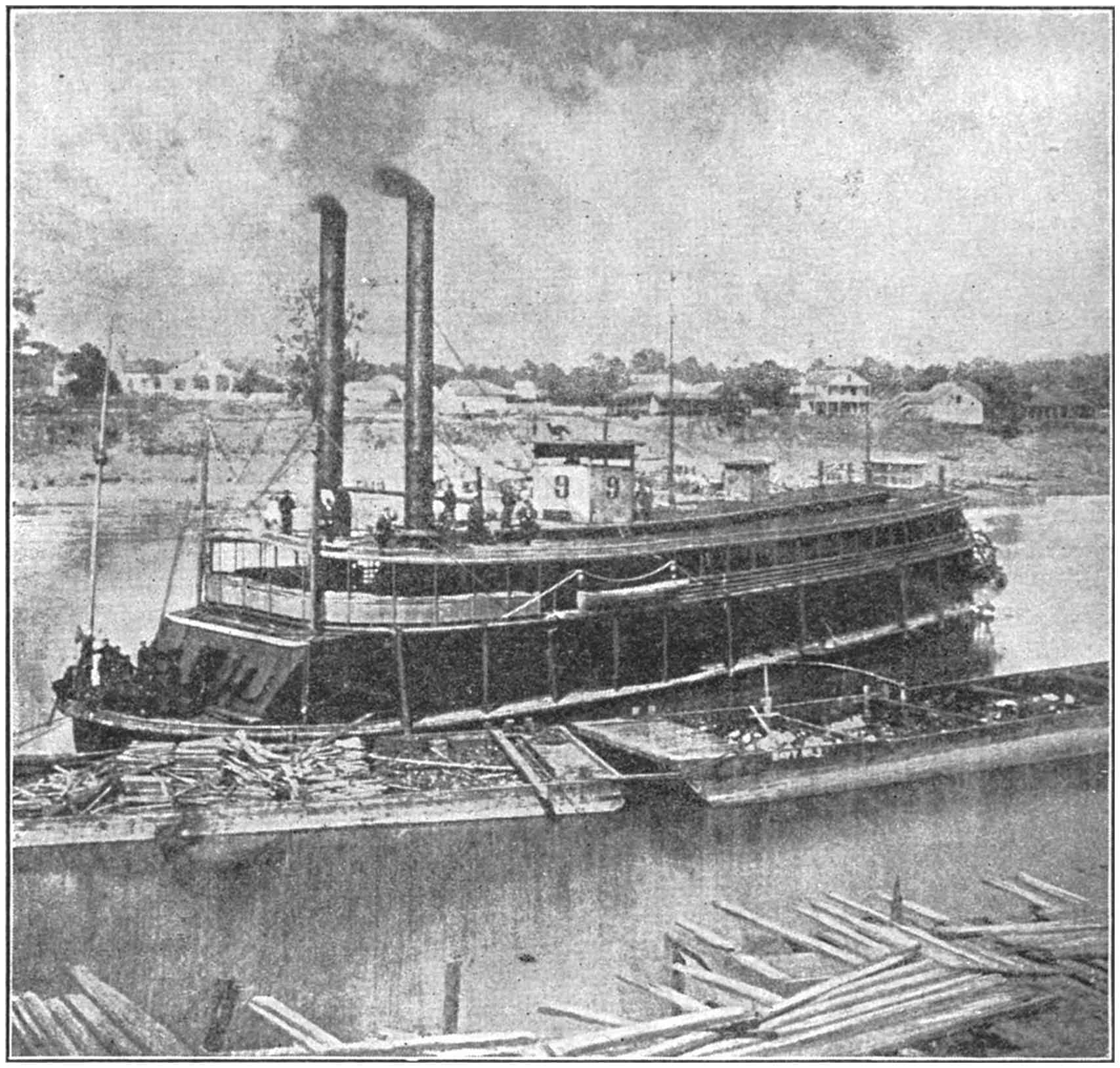
U. S. Gunboat Fort Hindman.
From a photograph.
It was on March 12, 1863, that Porter’s command started up Red River. The advanced vessels of the fleet reached Alexandria on the 15th, and all the fleet was there on the 16th.371 It was an easy voyage so far, but above Alexandria were (and are) two rapids not to be passed during low water, and in the spring of 1863 the water was exceptionally low.
However, the Eastport, Mound City, Carondelet, Pittsburg, Louisville, Chillicothe, Ozark, Neosho, Lexington, and Hindman were dragged over with some thirty transports. These went up the river and rendered considerable aid to the army, but the real interest in the expedition lies in the backwoods scheme by which the whole squadron above the falls was saved from destruction.

Joseph Bailey.
From a photograph.
Instead of finding high water at the season when it was naturally expected, the river fell, and ten gunboats and two tugs were left helpless above the falls. Nevertheless, help came when Lieut.-col. Joseph Bailey, of the Fourth Wisconsin Volunteers, saw the situation. Bailey was a log-driver, and knew how to lift a jam over any kind of rifts or obstructions. Nearly everybody who heard of his plan, doubted and many jeered at the idea; “but Bailey had the372 faith that moves mountains.” Moreover, there were right at hand two regiments of men from Maine—nearly 2,000 men, of whom Jeremiah O’Brien, who captured the Margaretta, would have been proud.
The rifts were a mile long, and at a point below them the high banks were 758 feet apart. The water between the high banks was deep enough to float any gunboat, but not too deep for building a dam. Bailey said he would build a dam there that would flood the rifts to navigating depth, and he did it. The men from Maine swung their axes in the forest near by, and the teamsters hauled the cut trees, branches and all, and dumped them into the water. Here other Maine men piled the trees up with their butts down-stream, cross-tied with logs and their branches interlacing above. Similar dams can be seen in any of the logging regions of the United States in these days. This dam extended from the north bank, a little more than half-way across the stream. From the south bank, for lack of trees, a crib dam—cribs of logs filled with stone—was built. When the opening between the ends of these dams was small enough—when it was but 150 feet wide—it was filled with four coal barges that were loaded with brick and sunk there.

Red River Dam.
From “The Navy in the Civil War.”
Astonishing as it seems to one who has374 seen such dams built, Bailey and his men from Maine had completed the dam in eight days, deepening the water on the rifts by more than six feet—the water was deep enough on the rifts for the Osage, the Neosho, and Hindman to pass down and anchor in the still water between the foot of the rifts and the dam.
But just as this success had been attained two of the sunken coal barges in the centre of the dam were shoved out of line by the weight of water, and in an instant the backwater above the dam began to pour through the opening in a mighty torrent.
At that moment the gunboat Lexington, with steam up, was at the head of the rifts, ready to follow the gunboats that had passed down to safety, while Admiral Porter stood on the bank, overseeing the operation. One glance at the broken dam showed that the level of the water must quickly fall, and Porter shouted to the Lexington to go ahead over the rifts and through the break in the dam to the still water below. Instantly her pilot rang the bell to start the engines.
Up to this moment the thousands of soldiers who lined the banks had been shouting and talking to each other, and making a most confused noise; but when the Lexington entered the growing current on the rifts a hush fell upon the great throng, until no sound was375 heard save the beating of her paddles and the rush of the current as the pilot drove her straight at the opening. There the current took her from his hands, lifted her up on the leaping waves, and, rolling her heavily from side to side, dashed her down into the pool below.

The Fleet Passing the Dam.
From an engraving.
The mighty cheer that the great host of spectators raised seems to echo in the ear to this day as one reads the story of the incident, for the ship was safe.
The Neosho, Hindman, and Osage passed through the dam after the Lexington, but there were others still above the rifts, and these376 could not pass. But after a while it was found that, even with the break unrepaired, the dam still raised the water more than five feet, and so, instead of repairing the break, Bailey built two wing dams on the rifts above, and these gave the needed depth, and the remainder of the squadron passed down in safety. Bailey received the thanks of Congress, and was made a brigadier-general.
And to conclude the story of the Mississippi squadron, we may quote the words of Mahan in his admirable “Gulf and Inland Waters”: “After the Red River expedition little is left to say of the operations of the Mississippi squadron during the rest of the war.”
377
THE FORTS AND THE CONFEDERATE SQUADRON THE UNION FORCES WERE COMPELLED TO FACE—THE CONFEDERATE IRONCLAD JUST MISSED BEING A MOST FORMIDABLE SHIP—TEDIOUS WAIT FOR MONITORS—WHEN THE SOUTHWEST WIND FAVORED—THERE WAS A FIERCE BLAST FROM THE FORTS AT FIRST, BUT THE TORPEDO WAS WORSE THAN MANY GUNS—FATE OF THE TECUMSEH AND CAPTAIN CRAVEN—THE LAST WORDS OF THE MAN FOR WHOM “THERE WAS NO AFTERWARD”—TORPEDOES THAT FAILED BENEATH THE FLAGSHIP—CAPTAIN STEVENS ON THE DECK OF HIS MONITOR—WHEN NEILDS UNFURLED THE OLD FLAG IN THE MIDST OF THE STORM—HOW FARRAGUT WAS LASHED TO THE MAST—JOUETT WOULD NOT BE INTIMIDATED BY A LEADSMAN—MOBBING THE TENNESSEE.
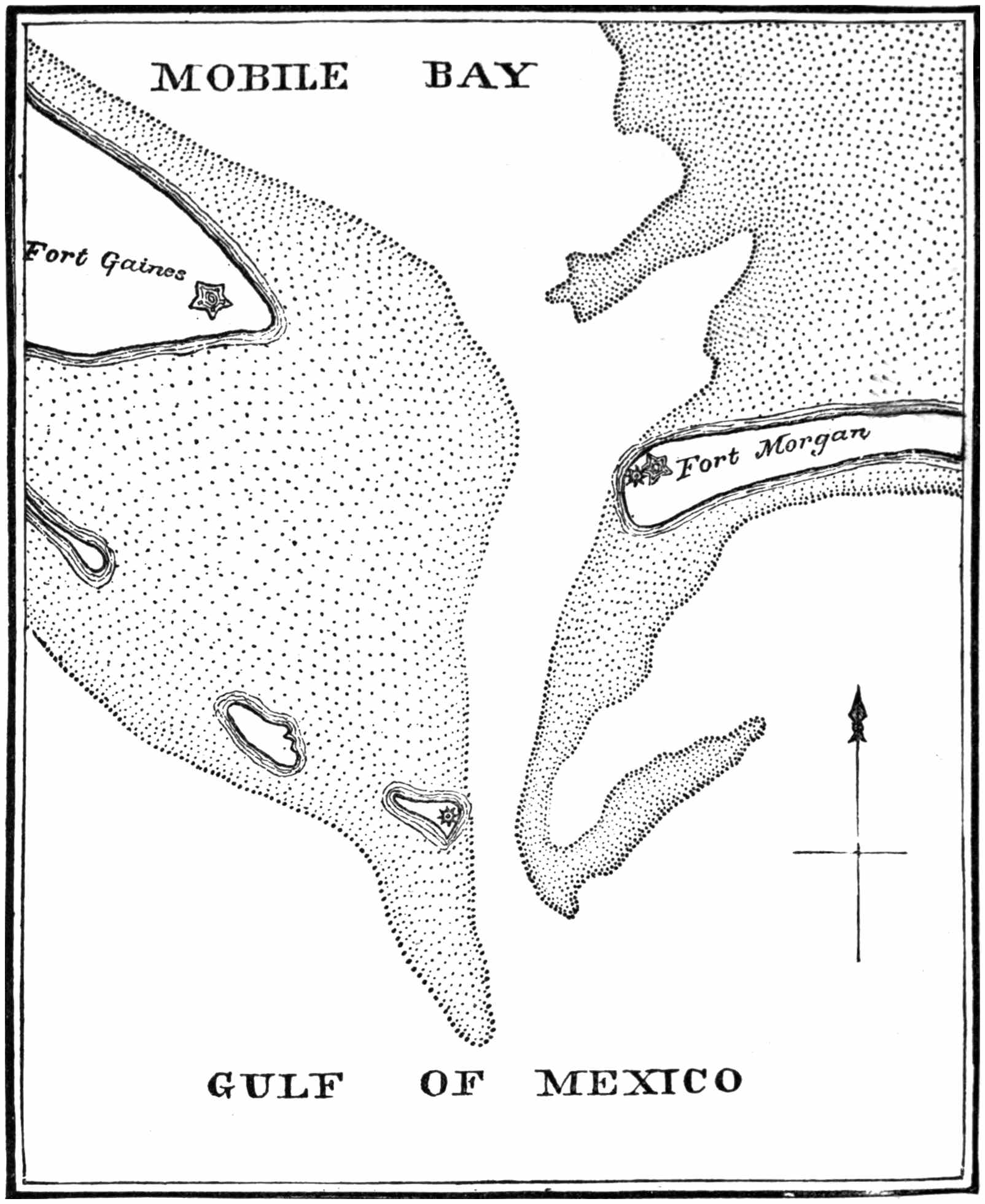
Entrance to Mobile Bay.
From “The Navy in the Civil War.”
Mobile Bay lies like a great bell open to the south—a bell that is thirty miles long, fifteen wide at the mouth, and six at the head. It is a shoal-water bay, save for a rather deep hole (twenty-one feet) just within; the two sandy islands that stretch out from either side across its mouth almost meet. That is to say, they reach within 2,000 yards of each other, and between them lies the entrance to the channel. In these days a wide ditch carries twenty-three feet of water from the deep378 hole inside the islands clear to the town of Mobile; but at the time of the Civil War that had not been dredged, and the water shelved gradually from the ripples at the beach to twelve feet at the centre line above the hole. There was a bar outside; but ships drawing twenty feet of water could pass. The main379 point of land at the entrance to Mobile Bay lay on the east, and was called Mobile Point. On the west lay Dauphin Island, and the water between this island and the mainland was and is called Mississippi Sound—a stretch of shoal water that gives inland navigation to New Orleans. The Confederate defences, ashore and afloat in 1864, are described by Mahan as follows:
“The entrance from the Gulf was guarded by two works, Fort Morgan on Mobile Point, and Fort Gaines on Dauphin Island. The approach by Mississippi Sound was covered by Fort Powell, a small earthwork on Tower Island, commanding the channel which gave the most water, known as Grant’s Pass. Gaines was too far distant from the main ship channel to count for much in the plans of the fleet. It was a pentagonal work mounting in barbette three X-inch columbiads, five 32-, two 24-, and two 18-pounder smooth-bore guns, and four rifled 32-pounders; besides these it had eleven 24-pounder howitzers for siege and for flank defence. In Fort Powell there were one X-inch, two VIII-inch and one 32-pounder smooth-bore and two VII-inch Brooke rifles; these bore on the sound and channels, but the rear of the fort toward the bay was yet unfinished and nearly unarmed. The third and principal work, Fort Morgan, was much more380 formidable. It was five-sided, and built to carry guns both in barbette and casemates; but when seized by the Confederates the embrasures of the curtains facing the channel were masked and a heavy exterior water battery was thrown up before the northwest curtain. The armament at this time cannot be given with absolute certainty. The official reports of the United States engineer and ordnance officers, made after the surrender, differ materially, but from a comparison between them and other statements the following estimate has been made: Main fort, seven X-inch, three VIII-inch and twenty-two 32-pounder smooth-bore guns, and two VIII-inch, two 6.5-inch and four 5.82-inch rifles. In the water battery there were four X-inch and one VIII-inch columbiads and two 6.5-inch rifles. Of the above, ten X-inch, three VIII-inch, sixteen 32-pounders and all the rifles, except one of 5.82 calibre, bore upon the channel.
“In the waters of the bay there was a little Confederate squadron under Admiral Franklin Buchanan, made up of the ram Tennessee and three small paddle-wheel gunboats, the Morgan, Gaines, and Selma. They were unarmored, excepting around the boilers. The Selma was an open-deck river steamer with heavy hog frames; the two others had been built for the Confederate Government, but381 were poorly put together. The batteries were: Morgan, two VII-inch rifles and four 32-pounders; Gaines, one VIII-inch rifle and five 32-pounders; Selma, one VI-inch rifle, two IX-inch, and one VIII-inch smooth-bore shell-guns. Though these lightly built vessels played a very important part for some minutes, and from a favorable position did much harm to the Union fleet in the subsequent engagement, they counted for nothing in the calculations of Farragut.
“The Tennessee was the most powerful ironclad built, from the keel up, by the Confederacy, and both the energy showed in overcoming difficulties and the workmanship put upon her were most creditable to her builders. The work was begun at Selma, on the Alabama River, one hundred and fifty miles from Mobile, in the spring of 1863, when the timber was yet standing in the forests, and much of what was to be her plating was still ore in the mines. The hull was launched the following winter and towed to Mobile, where the plating had already been sent from the rolling mills of Atlanta.
“Her length on deck was 209 feet, beam 48 feet, and when loaded, with her guns on board, she drew 14 feet. The battery was carried in a casemate, equidistant from the bow and stern, whose inside dimensions were382 79 feet in length by 29 feet in width. The framing was of yellow pine beams, 13 inches thick, placed close together vertically and planked on the outside, first with 5½ inches of yellow pine, laid horizontally, and then 4 inches of oak laid up and down. Both sides and ends were inclined at an angle of forty-five degrees, and over the outside planking was placed the armor, 6 inches thick, in thin plates of 2 inches each, on the forward end, and elsewhere 5 inches thick. Within, the yellow pine frames were sheathed with 2½ inches of oak. The plating throughout was fastened with bolts 1¼ inches in diameter, going entirely through and set up with nuts and washers inside. Her gunners were thus sheltered by a thickness of five or six inches of iron, backed by twenty-five inches of wood. The outside deck was plated with two-inch iron. The sides of the casemate, or, as the Confederates called it, the shield, were carried down to two feet below the water line and then reversed at the same angle, so as to meet the hull again six to seven feet below water. The knuckle thus formed, projecting ten feet beyond the base of the casement, and apparently filled in solid, afforded a substantial protection from an enemy’s prow to the hull, which was not less than eight feet within it. It was covered with four inches of iron, and383 being continued round the bows, became there a beak or ram. The vessel carried, however, only six guns; one VIII-inch rifle at each end and two VI-inch rifles on each broadside. These were Brooke guns, made in the Confederacy; they threw 110-pound and 90-pound solid shot. The ports were closed with iron sliding shutters, five inches thick; a bad arrangement, as it turned out.
“Though thus powerfully built, armored, and armed, she had two grave defects. Her engines were not built for her, but taken from a high-pressure river steamboat, and though on her trial trip she realized about eight knots, six seems to be all that could usually be got from her. She was driven by a screw, the shaft being connected by gearing with the engines. The other defect was an oversight, her steering chains, instead of being led under her armored deck, were over it, exposed to an enemy’s fire. She was therefore a ram that could only by a favorable chance overtake her prey, and was likely at any moment to lose the power of directing her thrust.”
While Banks was on the useless Red River expedition Farragut had been anxious to attack Mobile, but had been unable to do so because no troops could be spared for use against the forts and to hold the place when it should be taken. For six months, in fact, the384 admiral had to lie idle while the Confederates strengthened their works—even watching them while they brought the Tennessee down the river on which she had been built, and then carried her over the shoal waters of the upper part of the bay, just as Perry carried his two brigs out of Erie harbor on Lake Erie when he went out to win his great victory. It was in March, 1864, that the Confederates began this slow task under Farragut’s eyes (figuratively speaking; Farragut was not with the fleet constantly), and it was not until May 18th that they had her anchored in the deep water within the forts guarding the channel.
As a matter of fact, Buchanan, the Confederate admiral, intended to go out and attack Farragut’s fleet that night, as the Merrimac had attacked the wooden fleet in Hampton Roads. What he would have accomplished may not now be guessed; but Farragut had wooden ships only to meet the Tennessee, although he had done everything he could to get ironclads. However, the Tennessee grounded, and when she was floated Buchanan, for some reason unknown, changed his mind.
Meantime the Confederate had anchored forty-six beer-keg torpedoes and 134 torpedoes made of tin, all fitted with percussion fuses, across the channel, leaving a pass, marked by a red buoy, near Fort Morgan (on the east385 side) for the blockade-runners. The pass was about 100 yards wide and at the most deadly range from the fort.
After six months of tedious delay four monitors came with the assurance that a sufficient number of troops would coöperate. Two of these monitors had single turrets, armored with ten inches of iron and carrying two fifteen-inch Dahlgren guns—guns that used sixty pounds of powder (and might have used a hundred) behind solid-steel shot weighing 440 pounds. The others had eleven-inch Dahlgrens.
Eventually a day for landing the troops on Dauphin Island was fixed—August 4, 1864—and Farragut was to pass the forts and anchor in the bay before daylight. The troops were landed, but Farragut had to wait for some of his squadron that had failed to arrive. But during the day they were all there. The wooden ships were prepared much as they had been at the battle of New Orleans, and then all that was wanting was a flood-tide to help sweep the ships, and a southwest wind to blow the smoke of battle into the eyes of Fort Morgan’s gunners. As fortune turned, Farragut got both early on the morning of August 5, 1864. It had been raining the night before, and it is recorded that Farragut could not sleep well. At 3 o’clock in the morning he sent a man on386 deck to ask how the wind was, and the man brought word that it was southwest.
“Then we will go in this morning,” said Farragut, and a few minutes later the boatswains were turning out all hands on every ship of the fighting squadron. It was not a long task to get the men to quarters, but the ships had to be lashed together two and two,—the little Octorara on the off side of the Brooklyn, and the little Metacomet on the off side of the flagship Hartford, and so on, to protect the little ones from the fire of Fort Morgan.
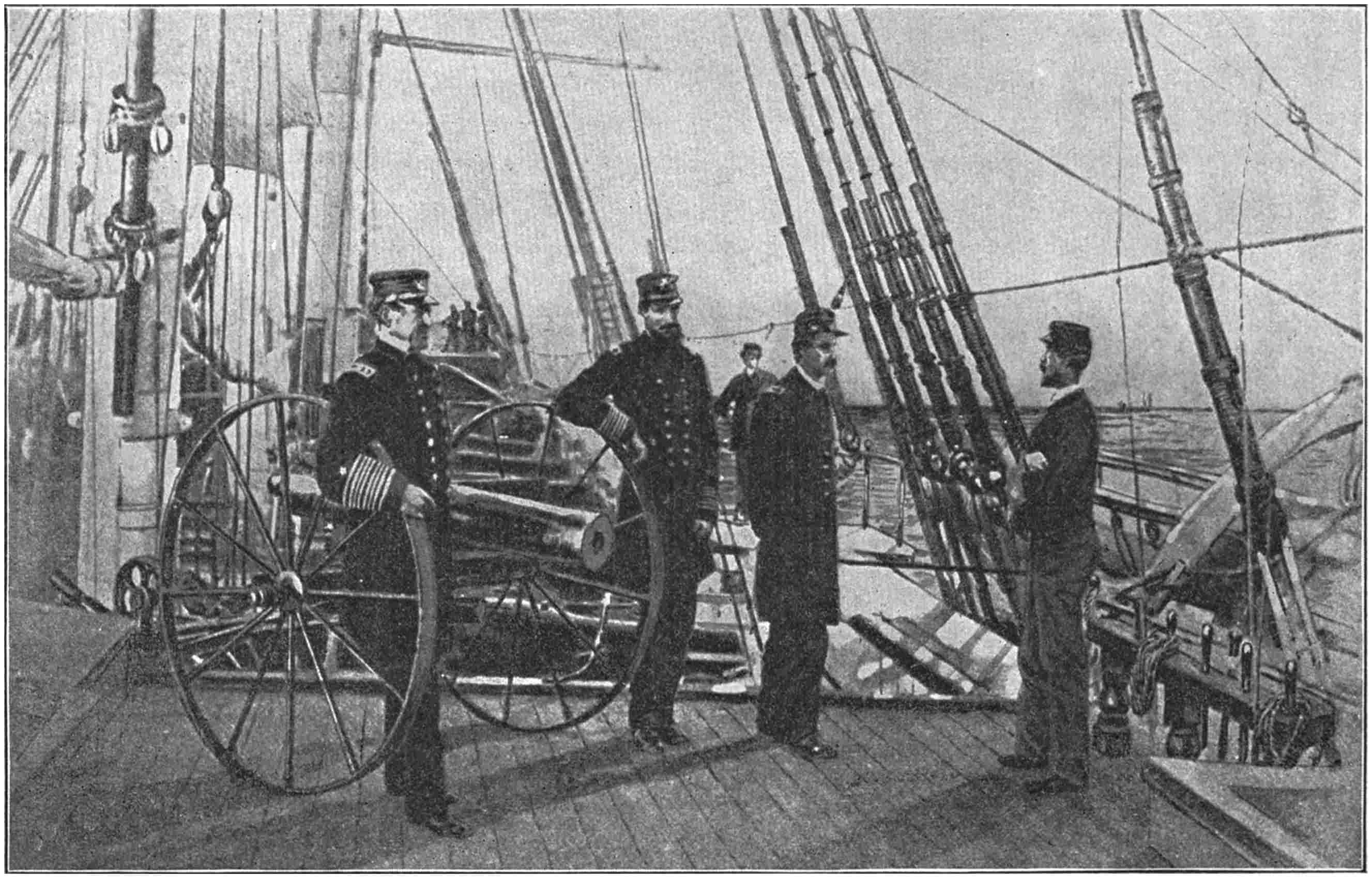
Farragut and Drayton on Board the Hartford at Mobile Bay.
Drawn by I. W. Taber from a photograph.
When this was done the line was formed in two columns, the monitors on the right, next to the fort, in the following order of battle:
Monitors—starboard column: Tecumseh, 1,034 tons, two guns, Commander T. A. M. Craven; Manhattan, 1,034 tons, two guns, Commander J. W. A. Nicholson; Winnebago, 970 tons, four guns, Commander Thomas H. Stevens; Chickasaw, 970 tons, four guns, Lieut.-commander George H. Perkins.
Wooden ships—port column: Brooklyn, twenty-four guns, Capt. James Alden; Octorara, six guns, Lieut.-commander Charles H. Greene; Hartford, twenty-one guns, Rear-admiral David G. Farragut, Capt. Percival Drayton; Metacomet, six guns, Lieut.-commander James E. Jouett; Richmond, twenty guns, Capt.389 Thornton A. Jenkins; Port Royal, six guns, Commander Bancroft Gherardi; Lackawanna, eight guns, Capt. John B. Marchand; Seminole, eight guns, Commander Edward Donaldson; Monongahela, eight guns, Commander James H. Strong; Kennebec, five guns, Lieut.-commander William P. McCann; Ossipee, eleven guns, Commander William E. Le Roy; Itasca, five guns, Lieut.-commander George Brown; Oneida, nine guns, Commander J. R. M. Mullany; Galena, ten guns, Lieut.-commander Clark H. Wells. The Octorara, Metacomet, and Port Royal were side-wheel double-enders; the others were screw ships. All had been built for the naval service.
The signal to move rose to the Hartford’s masthead at 5.30 o’clock, and by 6.10 the leaders were crossing the bar, heading for the narrow passway marked by the red buoy just under the heaviest guns of Fort Morgan.
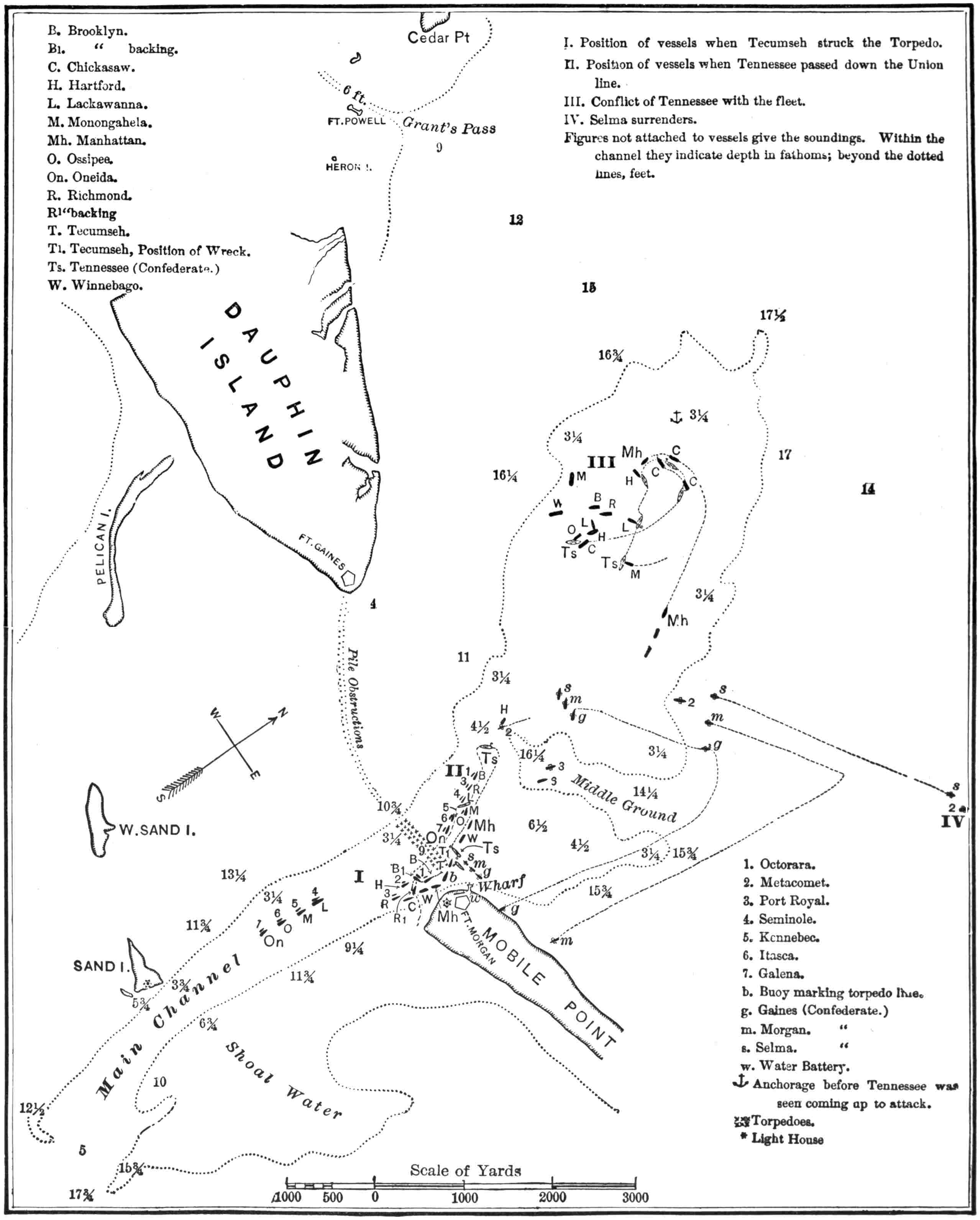
I. Position of vessel when Tecumseh struck the Torpedo.
II. Position of vessels when Tennessee passed down the Union line.
III. Conflict of Tennessee with the fleet.
IV. Selma surrenders.
Figures not attached to vessels give the soundings. Within the channel they indicate depth in fathoms; beyond the dotted lines, feet.
Battle of Mobile Bay.
From “The Navy in the Civil War.”
“It was a glorious sight to see those brave fellows wearing a smile of joy upon their faces in view of such odds against them, and not knowing how soon they and their comrades would be lying at the bottom of the bay. All could not hope to escape this trying ordeal, when several of the coolest officers calculated that at least six of the ships would be blown up. They never stopped to consider whose fate this would be; all they desired was to392 grapple with the enemy, and see the Union flag floating over the forts that had been taken from their lawful owners.”
Slowly—too slowly, the squadron steamed in, the American flag fluttering at every peak until within easy range, when the Tecumseh, the leading monitor, hurled two fifteen-inch shot at the fort. There was no reply, and the squadron continued slowly on with the monitors blazing away.
The silence of the fort was ominous, for its garrison were waiting for the shortest range; but at 7.7 o’clock, as the head of the squadron drew in to make the turn at the red buoy, the time had come, and a roaring blast of iron hail struck the leading ships. But ominous as the silence of the fort had seemed, the result of their best aim was insignificant, for only one shot did any damage worth mention, and that one killed nearly all of a gun’s crew on the Hartford.
All the guns of the fleet that would bear were now opened on the fort, grape and canister being chiefly used in order to drive the men from the guns, and so steady was the rain of the small projectiles through the fort’s portholes that the fire there was instantly slackened.

T. A. M. Craven.
From a photograph owned by Mr. C. B. Hall.
And then came the Confederate squadron from behind the fort to take a position above393 the line of torpedoes to help repel the fleet. As the Tennessee opened fire the monitor Tecumseh, at the head of the Union line, had her turret turned with portholes from the fort while the guns were loaded. Captain Craven, intent on reaching the Tennessee as quickly as possible, saw that if he had to pass between the red buoy and the fort, his route would be a crooked one, and turning to the pilot at his side in the pilot-house, he said:
“It is impossible that the Admiral means us to go inside the buoy; I cannot turn my ship.” He knew that outside the red buoy lay the torpedoes, but saying “starboard” to the man at the wheel, he headed the Tecumseh straight for the Confederate ram. For a few minutes she held her course undisturbed, but as the red buoy394 was brought abeam, her bow was suddenly lifted out of water, she lurched heavily from side to side, and then down she went bow first, her screw lifted up to view, and with a minute or two of time between the shock and the sinking. A torpedo had ripped open her hull. A few men in the turret climbed out. Craven and Pilot John Collins both started for the opening in the pilot-house, and then Craven drew back and said:
“After you, pilot.” But there was no afterward for Tunis Augustus Craven. There was a chance for one, but not for two. “When I reached the uppermost round of the ladder,” said Collins, “the ship dropped from under me.” In all, ninety-two good men went down with their immortal captain.
Farragut, who had climbed into the port main rigging of the Hartford, where he could see over the smoke of battle, saw the Tecumseh sink, and turning to Capt. J. Jouett, of the little Metacomet alongside, asked him to send a boat to rescue some of the Tecumseh’s crew. But Jouett had already ordered the boat away, and it carried another hero of that battle—Ensign H. C. Neilds. Neilds was only a lad, but he sat unmoved in the stern of the frail craft as it passed out from the shelter of his ship into the hurtling storm that ripped the water into a misty spray. A moment later he395 remembered that his flag was not flying, and standing up, as a Perry might have done, he unfurled the flag, set it to its staff in the face of friend and foe, and then sat down quietly to guide the boat on her mission.
Over on the monitors was still another hero—Commander Stevens, of the Winnebago. He was of the old school of seamen, who believed that the captain’s place was on the quarter-deck. The double-turreted monitor had no quarter-deck, but Stevens, restive in the iron box, got out on the deck between the turrets, and pacing to and fro alone in the storm, gave his orders now to one turret and then another. And what was more, the monitors were all driving ahead in the wake of the lost Tecumseh—driving toward the torpedoes.
But just then the captain of the Brooklyn, being in the lead of all, saw some little floats that marked the location of a nest of torpedoes, and first stopped and then backed his engines. It was not the right move for a ship in Farragut’s squadron to make, and it threw the line into confusion, and held the ships under the hottest fire of the fort—held the Hartford in particular where the shot from the enemy turned her gun-deck into a slaughter pen so that blood ran in streams from her scuppers, and the splinters of her walls and bits of flesh and clothing from the dead were scattered in a396 shower over the deck of the gunboat lashed alongside.
As the Hartford ranged up near the Brooklyn, Farragut, from his perch in the rigging, asked what was the trouble, and the one word “torpedoes” came back to him.
“D——n the torpedoes! Follow me,” said the admiral, and as the Hartford took the lead of her column, he signalled for “close order.”
A moment more, and the Hartford had reached the torpedo nest. The torpedo cases were distinctly heard striking against her bottom, and their primers were heard snapping, but not one exploded.
It was at this time that Captain Drayton, of the Hartford, seeing Farragut clinging to the shrouds just under the maintop, sent a sailor up to make fast a slender rope from one shroud to another in such a way that the admiral could not fall in case he was struck. It is so far literally true that Farragut was “lashed to the mast.”

Battle of Mobile Bay.
Front a painting by Admiral Walke.
And then came the Richmond with her consort to narrowly escape a collision with the Brooklyn, but as she turned away, her broadside was brought to bear fairly on the fort, and she opened such a rapid fire that she was wholly hid from view. Admiral Buchanan, who had watched her with more than ordinary398 interest because of a personal friendship for Captain Jenkins, was led to say:
“What became of Jenkins? I saw his vessel go handsomely into action, and then lost sight of her entirely.”
Nevertheless, Jenkins was there, and in a most active condition of health. With the other larger ships, she helped to silence the forts so far that the last ships of the line passed in with but slight damage.
But once inside the line of torpedoes—torpedoes that had failed because made of tin that rusted away or because of other defects in make—the Union squadron had to face the Confederate ships. The Confederate gunboats had seemed of no moment at first, but as the Hartford advanced they retreated slowly, keeping within about 700 yards, and delivering an effective fire. Farragut sent the Metacomet after them, and she disabled the Gaines, drove another flying back to the fort, while the third, the Selma, kept on, with Jouett eager in the chase. The two were soon in shoal water, and the man at the lead on the Metacomet called out a foot less water than she drew. It was reported instantly to Jouett.
“Call the man in,” said Jouett. “He is only intimidating me with his soundings.”
Fortunately, it was a soft mud bottom. The Metacomet kept on. A squall came to hide399 the Selma, but when it passed, Jouett was upon her, and her flag came down.
Meantime the Tennessee had run amuck among the Union squadron. Her first attempt to ram was on the Hartford, but the Hartford was swifter and handier, and so escaped. Then she passed the Brooklyn, the Richmond, and the Lackawanna, and turned toward the Monongahela. Captain Strong of this ship strove in turn to ram the Tennessee, and each glanced from the other. Thereafter the Tennessee passed clear through the fleet, doing and receiving but little damage. Then she turned near the fort to follow up the Union squadron.
At about this time (8.35 o’clock) Farragut ordered the men on the Hartford sent to breakfast. Captain Drayton said:
“What we have done has been well done, sir, but it all counts for nothing so long as the Tennessee is there under the guns of Morgan.”
“I know it,” said Farragut, “and as soon as the people have had their breakfasts I’m going for her.”
The mess kits were on the deck when word came down that the Tennessee, instead of staying near Fort Morgan, as Farragut had supposed she would do, was coming. In a jiffy the scouse and coffee were sent back to the galley, and the men ran to their guns. The400 anchor was slipped, and with signals flying to direct the Monongahela, Lackawanna, and Ossipee to ram the Confederate ship, and the monitors to attack her, the Hartford headed at full speed to lead the ramming gunboats. In this the spirit of Farragut was shown even more faithfully than when he braved the fire of the forts, for the Tennessee was a much more powerful ship than the Merrimac, and the Hartford was not so powerful as any of the steamers that lay in Hampton Roads when the Merrimac made her first raid. Indeed, one involuntarily compares the action of Farragut on this day with that of Goldsborough on the day that the Merrimac ran down within range of the Rip Raps, and defied a squadron gathered especially to ram her.
There was no hesitation at Mobile. The Monongahela was the first to reach the Confederate ship. Two raking shots were received, but at full speed the Monongahela struck her amidships on the starboard side, and a minute later, as the two swung side by side, the Monongahela gave her a broadside.
And then came the Lackawanna to ram the Tennessee on the port side. A good blow it was too; but as the Hartford approached to give a third blow, the Tennessee turned so that she and the Hartford struck bow to bow, but both glanced clear.
401
A broadside from the Hartford also proved harmless, but the Tennessee, that had been unable to return the fire for some time on account of defective primers, managed to discharge one shell that entered the Hartford, though it did no material damage. And then the danger of mobbing a ship, as the Tennessee was mobbed, became apparent, for the Lackawanna, in coming around to ram again, struck the Hartford instead of the Tennessee, and narrowly missed sinking her, while Farragut, by an equally narrow margin, escaped death, for he was standing near where the Lackawanna struck.
Meantime the three monitors were coming with all speed, the Chickasaw burning tallow and tar to get up steam faster. Passing along the Tennessee’s port side, the Chickasaw got under the stern of the Confederate, and there she hung, working her four eleven-inch guns with deadly accuracy. The monitors Manhattan and Winnebago both attacked the Tennessee, but one of the former’s guns was accidentally spiked, and the latter’s turret machinery failed, and it was the Chickasaw that did the work.
“D——n him!” said the Tennessee’s pilot afterward. “He stuck to us like a leach; we could not get away from him. It was he who cut away the steering gear, jammed402 the stern port shutters and wounded Admiral Buchanan.”
And that was true. Both the bow and the stern port shutters were jammed so that the guns of the Tennessee could not be worked at the ends of the ship. Her smoke-stack was shot away, and the smoke from the stump poured down through the upper-deck gratings to fill the casemate, where the temperature had risen to 120 degrees. Buchanan, to clear one of the port shutters, sent for a machinist and personally superintended his work for a few moments, when one of the Chickasaw’s projectiles struck the iron plating just outside where the machinist was at work, and the concussion, although the shot did not enter, reduced the man to a pulp, so that his remains were shovelled into buckets to be carried away. Worse yet for the ship, an iron splinter was driven through the admiral’s leg, breaking the bone.
It was near this time that the tiller chains were carried away, and that completed the needed work of destruction. Capt. J. D. Johnson took command of her when Buchanan fell, and for twenty minutes longer endured the hammering while wholly unable to return the fire or steer the ship. But to hold out longer under such circumstances was useless, and the flag was hauled down.
As it happened, the flag had been shot down403 before, and it was flying from a boat hook thrust up through a deck grating. The Union forces, supposing the flag had been shot away again, continued firing, and to end the matter Johnson went on the upper deck and waved a white flag.
Just then the Ossipee came slicing through the water at top speed to ram the Tennessee. Captain Le Roy was out on deck, and recognized Johnson instantly as an old friend. Sheering the Ossipee to one side, he shouted cheerfully:
“Hello, Johnson, old fellow! How are you? This is the United States steamer Ossipee. I’ll send a boat alongside for you. I’m Le Roy; don’t you know me?”
The boat was sent. The American flag was hoisted on the Tennessee. The battle was ended.
Farragut, in his report, gave special praise to the following men: Capts. Percival Drayton and Thornton A. Jenkins; Commanders Mullany, Nicholson, and Stevens; Lieut.-commanders Jouett and Perkins; Lieutenants Watson and Yates; Acting-Ensigns Henry C. Nields, Bogart, and Heginbotham; Ensign Henry Howard Brownell, Secretary McKinley, the pilot Martin Freeman, Acting Volunteer Lieuts. William Hamilton and P. Giraud. Of his crew he said: “I have never404 seen a crew come up like ours. They are ahead of the old set in small arms, and fully equal to them at the great guns. They arrived here a mere lot of boys and young men, and have now fattened up and knocked the 9-inch guns about like 24-pounders, to the astonishment of everybody. There was but one man who showed fear, and he was allowed to resign. This was the most desperate battle I ever fought since the days of the old Essex.”
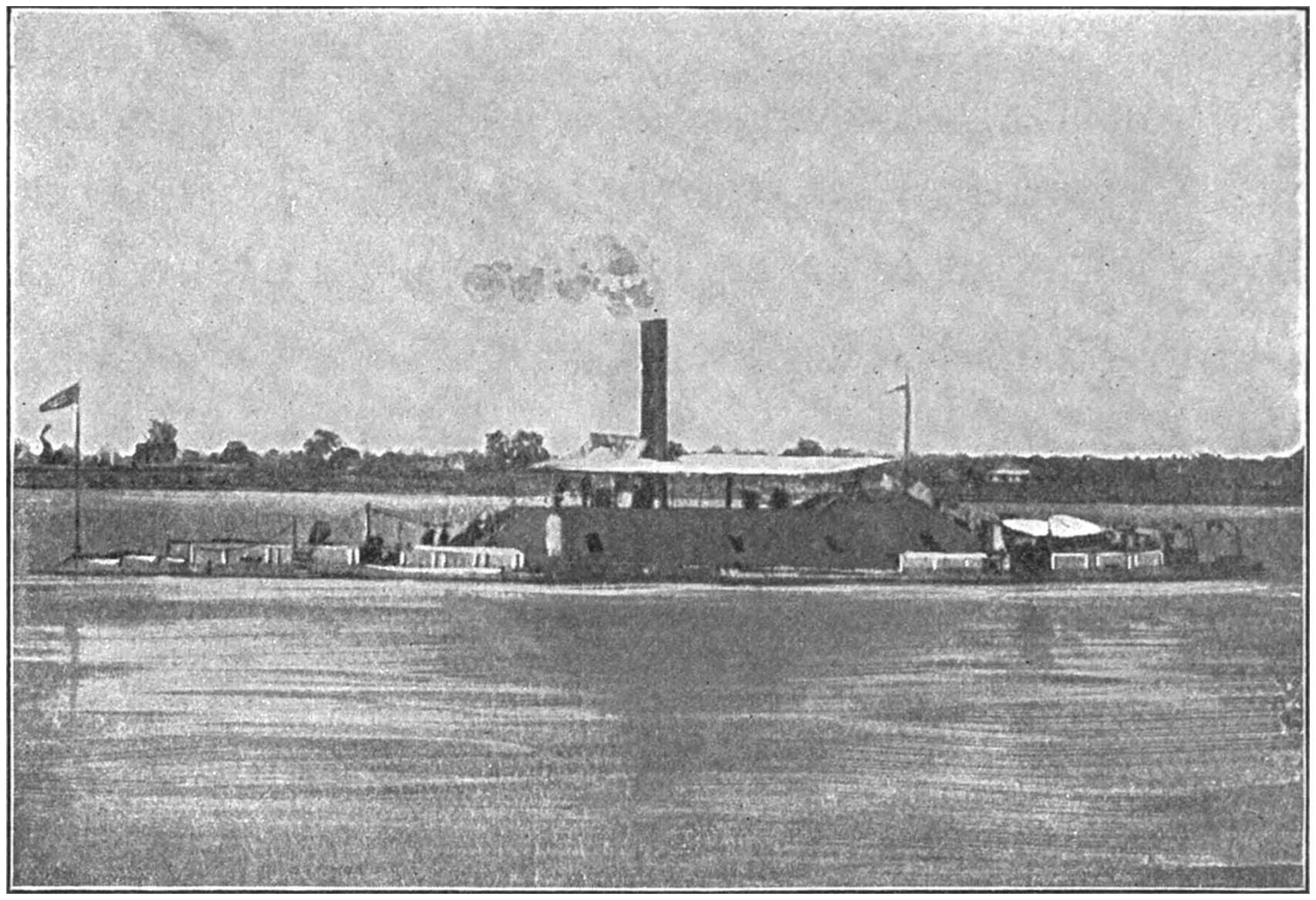
The Confederate Ram Tennessee, Captured at Mobile.
From a photograph.
A consideration of this fight shows that the Union forces had their blood up, and that nothing but an impregnable ship could have withstood this onslaught. The Tennessee was405 not that kind of a ship. The defects in the shutters and the steering gear, and the inability to keep up the fires after the smoke-stack fell, ruined her chances. These matters must be emphasized because such defects are inevitable in ships built during actual war. The Confederacy lacked ships just as the United States would lack them in case a war with a first-class nation were suddenly precipitated upon us, and the ships we should then build would very likely fail, as the Tennessee failed. It is worth noting that not one shot penetrated the Tennessee’s casemate, but one from the Manhattan bulged the wood backing of the armor into a mass of splinters.
The Tennessee lost two killed and ten wounded. The Union forces lost fifty-two killed by shots, 120 drowned in the Tecumseh, and 170 wounded.
The Chickasaw shelled Fort Gaines on the 6th, and it surrendered next day. The fort on the other point was invested by the troops as well as the ships, the shelling beginning on the 22d of August, and the next day it surrendered. This effectually closed Mobile harbor as a port for blockade-runners, but the city was not taken until the middle of the next spring. The naval forces helped in bombarding the defences about the city, but the only incidents of real importance to history of this406 kind were the various losses from torpedoes. The bay was swept for torpedoes thoroughly, and yet the Milwaukee ran on one on returning from a trip up to shell a fort near the city, and was sunk. The Osage, in shifting her anchorage in a fresh breeze, was sunk in like fashion. The wrecking steamer Rodolph, while going to raise the Milwaukee, struck another and went down. Even after the Confederate troops withdrew and 150 torpedoes had been removed from the Tombigbee channel, two tugs and a launch struck torpedoes and were destroyed. The danger from such obstructions had never been so well shown as at Mobile.
407
THE MOST INSTRUCTIVE CHAPTER IN THE HISTORY OF THE UNITED STATES—WORK ACCOMPLISHED BY AN ENERGETIC SEAMAN IN A SHIP HIS BROTHER OFFICERS CONDEMNED—BRILLIANT WORK OF THE FLORIDA UNDER JOHN NEWLAND MAFFIT—BAD MARKSMANSHIP AND A WORSE LOOKOUT OFF MOBILE—A CASE OF VIOLATED NEUTRALITY—SEMMES AND THE ALABAMA—THE BATTLE WITH THE KEARSARGE—WHAT KIND OF A MAN IS IT THAT FIGHTS HIS SHIP TILL SHE SINKS UNDER HIM?—AMERICAN COMMERCE DESTROYED—THE BRITISH WITHOUT A RIVAL ON THE SEA, AT LAST, AND AT VERY SMALL COST.
The most instructive chapter in the history of the United States is that relating to the deeds of the cruisers in the Confederate navy; for, though few in number, they proved to the world that the over-sea commerce of a nation at war could be swept away entirely by means so inexpensive and of such little power as to be absolutely insignificant. Consider the first Confederate cruiser worth mention—the Sumter. She was a small coaster lying at New Orleans. Her cabins for passengers were on deck, and her coal-carrying capacity was equal to but five days at sea, and her hull was so408 frail that she was condemned by a board of able Confederate officers who examined her. But Raphael Semmes eagerly took hold of her. He cleared away the cabin hamper on deck, overhauled her sails and rigging, mounted an eight-inch pivot and some thirty-two-pounders from the Norfolk Navy Yard, and then did one other thing to her worth especial mention: “The engine which was partly above the water line was protected by a system of woodwork and iron bars.” So says Semmes’ “Memoirs”; and that is important because he said the captain of the Kearsarge, having used chains for armor, was unchivalrous. He began work on April 22, 1861. On June 3d he put her in commission under the name of Sumter. Thereafter some time was spent in drilling the crew, and then he dropped down to the head of the Passes to wait opportunity409 to get to sea. Very naturally he was astonished to find that the Brooklyn, the only blockading steamer, was lying out at sea instead of anchoring at the head of the Passes. He was also astonished that he was not attacked by the Brooklyn during the nine days that he lay there, and the reader is likely to share his feeling. And then came Sunday, June 30th. While the men on the Sumter prepared themselves for the usual man-o’-war inspection, a report that the Brooklyn was off on a chase was received.
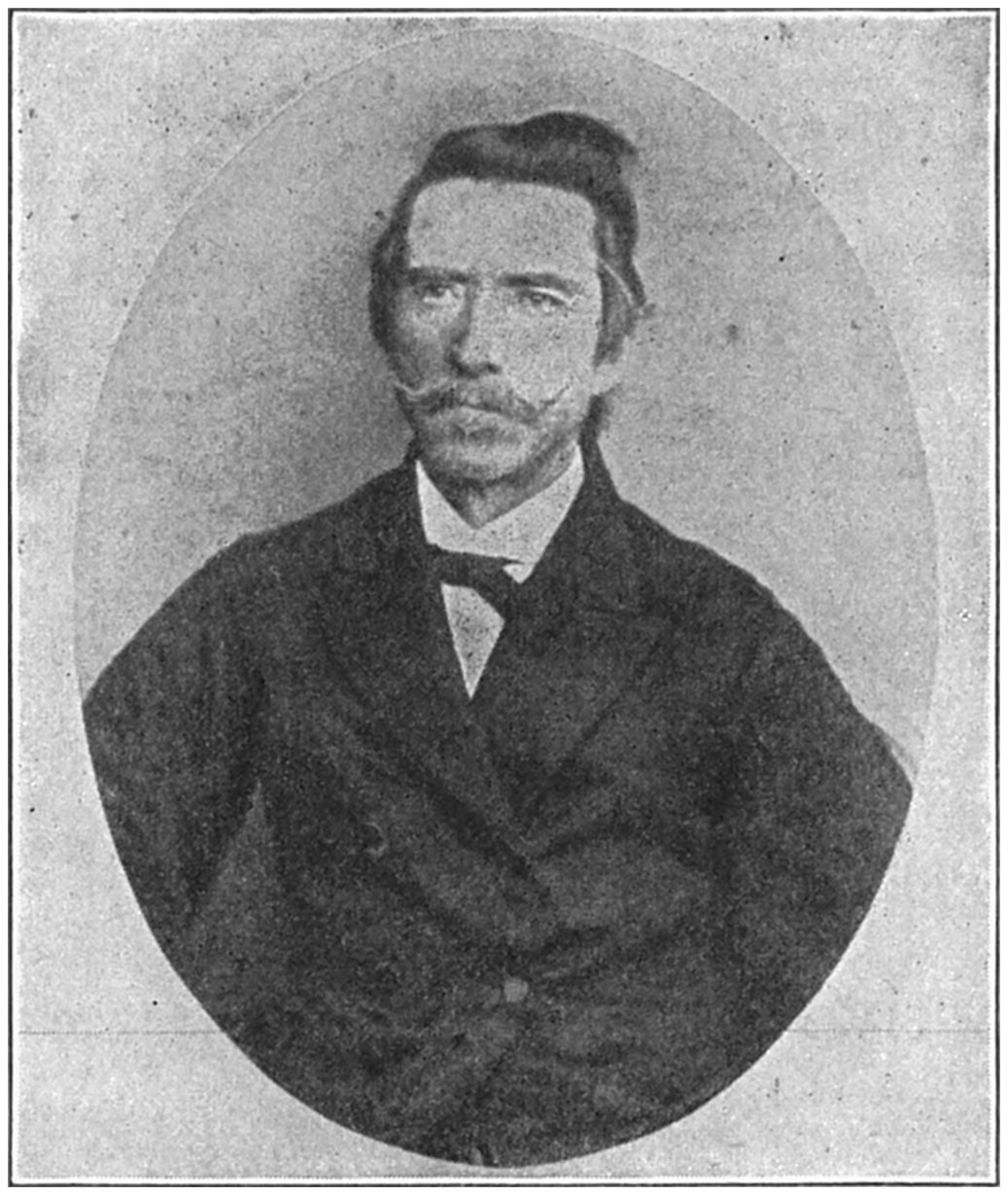
Raphael Semmes.
From a photograph owned by Mr. C. B. Hall.
Instantly preparations began for a run to sea. It was a hopeless attempt in the eyes of one of her lieutenants, for he had been on the Brooklyn, and thought her the faster ship; but Semmes was a daredevil who would “make a spoon or spoil a horn.” As they approached the bar the Brooklyn was seen coming, and she was but four miles away when the Sumter crossed the bar. But she did not overhaul the Sumter. There was a fresh breeze, and both ships made sail. The Sumter had large fore and aft sails, which enabled her, when they were set, to lie closer to the wind than the Brooklyn could do, and the Sumter fairly ran her out of sight.
As the pilot left the Sumter at the bar he said to Semmes: “Now, Captain, you are all clear; give her h-ll and let her go,” and that is just what Semmes did after “this bold and410 dashing adventure,” as Porter calls it. Going to the south coast of Cuba, he fell in with his first prize, a ship called the Golden Rocket, “from the Black Republican State of Maine.” A gun—the first fired by any Confederate naval officer afloat—brought her to, with the American flag flying. She was found to be in ballast, and was, of course, burned. Her flag was marked with her name and the date of capture, and stowed in a bag, where many others came to keep it company, for Semmes saved all the flags he captured, and when the Alabama was at last shot from under his feet he says: “I committed to the keeping of the guardian spirits of that famous battle ground a great many bags full of ‘old flags,’ to be stowed away in the caves of the sea as mementoes that a nation once lived whose naval officers loved liberty more than the false memorial of it, and who were capable, when it became ‘Hate’s polluted rag,’ of tearing it down.”
Within three days Semmes captured five American vessels, three of which he determined to carry into a Cuban port. On the fourth day, being then off Cienfuegos, he saw three more come out, and by hoisting false colors he disguised his ship so that they all proceeded on their courses until a marine league or more from the coast, when they were411 captured, and all taken into port. Semmes hoped that he should be able to sell them as prizes, but the Cuban authorities, after proper consideration, refused to allow this to be done.
In explanation of the refusal it should be said that when England declared in favor of granting the South belligerent rights, orders were issued that “required every ship-of-war or privateer of either belligerent which should enter British waters to depart within twenty-four hours afterwards, except in case of stress of weather, or of her requiring provisions, or things necessary for the subsistence of her crew, or repairs. In either of these cases she was to put to sea as soon after the expiration of the twenty-four hours as possible, taking in no supplies beyond what might be necessary for immediate use, and no more coal than would carry her to the nearest port of her own country, or some nearer destination. Nor, after coaling once in British waters, was she to be suffered to coal again within three months unless by special permission.” These orders were very annoying to the North, because when made, the Confederates had not a single ship of any kind afloat. It was simply excluding United States warships from what had once been friendly ports. On the other hand, the determination that no prizes should be sold in British ports was a hardship upon the412 South, because it prevented the Southern cruisers, that were eventually sent afloat, disposing of their prizes. Because of it the South did not sell a single prize, for the other nations followed England’s lead in this matter. But, on the whole, it must be said that while England’s attitude toward the cruisers of the two belligerents was, by the letter of the law, that of strict neutrality, the operation of this neutrality was a much greater hardship to the North than to the South, considered as national governments. The crews of the Confederate cruisers failed to get any prize money, but they could “sink, burn, and destroy ad lib.” They were about as great a menace to American commerce as if they had been getting prize money. There is now no disputing the oft-repeated assertion that England managed to maintain a neutrality that should help the South and hurt the North as much as was possible without causing open war with the United States.
Having failed to get his prizes sold in Cuba, because Spain had followed England in refusing to allow such sales in her ports, Semmes took another prize, the Abby Bradford, to Puerto Cabello, Venezuela, hoping to find a market there. He says of this attempt:
“All these small South American towns are, more or less, dependent upon American413 trade. The New England States and New York supply them with their domestic cottons, flour, bacon, and notions; sell them all their worthless old muskets, and damaged ammunition, and now and then, smuggle out a small craft to them, for naval purposes. The American Consul, who is also a merchant, represents not only those ‘grand moral ideas,’ that characterize our Northern people, but Sand’s sarsaparilla, and Smith’s wooden clocks. He is, par excellence, the big dog of the village. The big dog was present on the present occasion, looking portentous and savage, and when he ope’d his mouth, all the little dogs were silent. Of course, the poor Sumter, anchored away off in the bay, could have no chance before so august an assemblage.”
The Abby Bradford was ordered to New Orleans, but the Powhatan, Capt. D. D. Porter, captured her.
The Sumter was at Puerto Cabello on July 26th. She had taken nine prizes cruising in the island region of the Caribbean Sea. To follow her in all the details of her voyage would be monotonous. The reader can find the story in full, even to the number of ladies who showered their favors upon the Confederate captain, for Semmes was so proud of all of his conquests as to omit none. She was usually under sail, but used coal in chasing, and414 was able to renew her supply at Trinidad as well as other ports.
Meantime Semmes had been carrying a considerable number of merchant seamen to abide the fate of the crew of the Savannah (privateer) who were held for trial in New York on a charge of piracy. Semmes informed these merchant seamen that he should hang them if the Savannah’s crew were executed, and he says himself he should have done so, but does not tell by what process of reasoning he concluded it would be right to retaliate on men not engaged in warring against the Confederacy.
From Trinidad the Sumter went down the Brazil coast to Maranham, and thence to a point near the equator, where homeward-bound American ships from South America crossed, and then back to the Caribbean Sea islands, where, eventually, at St. Pierre, she was blockaded by the Iroquois. The Iroquois’ captain made a mistake. He arranged with an American shipmaster in the harbor to hoist signals, in case the Sumter sailed at night, to tell what course she was steering from the open roadstead. The signals were duly hoisted as Semmes started away south, but Semmes saw and understood them, and after running a mile or two with the Iroquois making all steam to head him off, he turned around and ran away to the north and escaped.
415
The Sumter now went to Spain, stopping at Cadiz, where she was not cordially received, and from there went to Gibraltar, where, as Semmes says, “the army and navy of Great Britain were with us almost to a man,” while “the Yankee officers of the several Federal ships of war, which by this time had arrived, were kept at arm’s length. No other than the customary official courtesies were extended to them. We certainly did not meet any of them at the club.”
However, if the Sumter’s officers had a good time ashore, they were unable to have one afloat, for the “several Federal ships” that had arrived effectually blockaded her. The work she did and the fate of the ship are thus summed up by Semmes:
“She cruised six months, leaving out the time during which she was blockaded in Gibraltar. She captured eighteen ships, as follows: the Golden Rocket, Cuba, Machias, Ben. Dunning, Albert Adams, Naiad, Louisa Kilham, West Wind, Abby Bradford, Joseph Maxwell, Joseph Parke, D. Trowbridge, Montmorency, Arcade, Vigilant, Eben Dodge, Neapolitan, and Investigator. It is impossible to estimate the damage done to the enemy’s commerce. The property actually destroyed formed a very small proportion of it. The fact alone of the Sumter being upon the seas,416 during these six months, gave such an alarm to neutral and belligerent shippers, that the enemy’s carrying-trade began to be paralyzed, and already his ships were being laid up, or sold under neutral flags—some of these sales being bona fide, and others fraudulent. In addition to this, the enemy kept five or six of his best ships of war constantly in pursuit of her, which necessarily weakened his blockade, for which, at this time, he was much pressed for ships. The expense to my Government of running the ship was next to nothing, being only $28,000, or about the price of one of the least valuable of her prizes. The Sumter was sold in the course of a month or two after being laid up, and being put under the English flag as a merchant-ship, made one voyage to the coast of the Confederate States, as a blockade-runner, entering the port of Charleston. Her new owner changed her name to that of Gibraltar. She was lost afterward in the North Sea.”
The next cruiser to be considered was named the Florida. She was built at Liverpool under the name of Oreto. The American officials learned, while she was building, that she was of the same model and scantling as the best British gunboats of that day. She had ports for four guns. On February 18, 1862, complaint was made to the British government417 by the American representative charging that she was building for use as a Confederate cruiser, whereat “orders were given that she be vigilantly watched.” On March 3d she was registered in the name of a member of a Sicilian firm, then in Liverpool, and cleared for “Palermo, the Mediterranean and Jamaica” in ballast. She sailed on March 22d with a crew of fifty men, but she went directly to Nassau, in the Bahamas. When there she appeared as a merchant ship consigned by Fraser, Trenholm & Co., of Liverpool, notorious as Confederate agents, to their Nassau house. Here, on complaint of the United States consul, she was libelled, and there was a farce of a trial in the Nassau court. Of course she was released. It was proved that she had taken on munitions of war, but these had been sent ashore again, and to the mind of the court she was a genuine British merchantman. Meantime her crew asked the British authorities to discharge them, alleging as a reason for the request that they had been deceived when they shipped in her. She had been represented as a merchantman, they said, but it was plain she was a man-o’-war, and they did not want to fight. On this plea they were at once discharged.
On August 2d she cleared for Havana, shipped twenty-two men of the blockade-running418 class, went to a desolate island called Green Key, and met a vessel that had brought out a first-class English armament of two seven-inch rifles and six six-inch guns. Her new commander was John Newland Maffitt, formerly of the American navy, and one who, because of his good qualities, did not lose his friends there when he forsook the flag. Maffitt was so pressed for men that he worked as a common sailor himself to transfer the arms. In fact, every man on board worked so hard that when one man came down with yellow fever the others took it. The ship reached Cardenas, in spite of losses from the fever. While still ill with the fever, Maffitt was compelled by the authorities to go to Havana.
Finding he should never get a crew there, he decided on the desperate expedient of running over to Mobile and braving the blockade, although he had barely enough men to man the stoke-hole.
The blockaders were sighted on September 4, 1862, and Maffitt, with just one man on deck to steer, hoisted the British flag, and headed directly for the blockaders.
At that time Commander George H. Preble was in charge of the station, and he had the Oneida and Winona under him. Seeing a boat exactly like a British gunboat, and under British colors, and knowing that British gun-boats419 were frequently sent alongshore to see whether the ports were really blockaded, Preble was deceived. He called his men to quarters and approached the stranger, but did not seem to have been suspicious when he saw that she was running at full speed and had no men on deck. He hailed her when near enough, and got no reply. Then he fired, in rather slow succession, three shots across her bow. As she still kept on he opened on her with a broadside, and the Winona joined in.
The Florida was but 300 yards away, and yet so wretched was the American marksmanship, that the broadsides cut the rigging and tore away the upper part of her bulwarks. One shell did, indeed, pass through and through the Florida near the water-line, to explode beyond her, but it did her no material damage. She passed in clear. The remarks which all the writers on the subject make about the narrow margin of luck in the time fuse of that one shell are not adapted to increase one’s respect for the ability of the gunners. It is a fact, as already noted, that the gunners of the war of 1861 were not to be compared in skill with those of 1812. And this is a subject that cannot be impressed deeply enough on the minds of American readers. For we may shout “Tirez! Tirez toujour!” as the Frenchman did, till we are blind, and still suffer defeat420 unless we can hit the target when we fire.
As between John N. Maffitt, sitting alone on deck because unable to stand—alone save for the man at the wheel—while his ship made that desperate dash for home, and the Union forces wasting their ammunition on the salt-sea air, one cannot hesitate long in bestowing his sympathy even if Maffitt was an enemy of the flag. It was a most heroic deed on one side and a sorry exhibit of incompetence on the other. On the other hand, when Preble was dismissed the punishment was unjust, for he had done his duty as he saw it. He had given his men all the target practice that the regulations provided. The fault was not in the man, but in the naval regulations that are careful to provide that every man blacks his shoes daily and limit the target practice of the gunners to, say, ten shots a year.
When Maffitt had recruited his health and a good crew, he found the blockading squadron increased, among other ships, by the Cuyler, Capt. Francis Winslow, that, because of her speed, was sent there especially to take him should he run out. But little that worried Maffitt. At 2 o’clock on the morning of January 16, 1863, he was ready, and out he went.
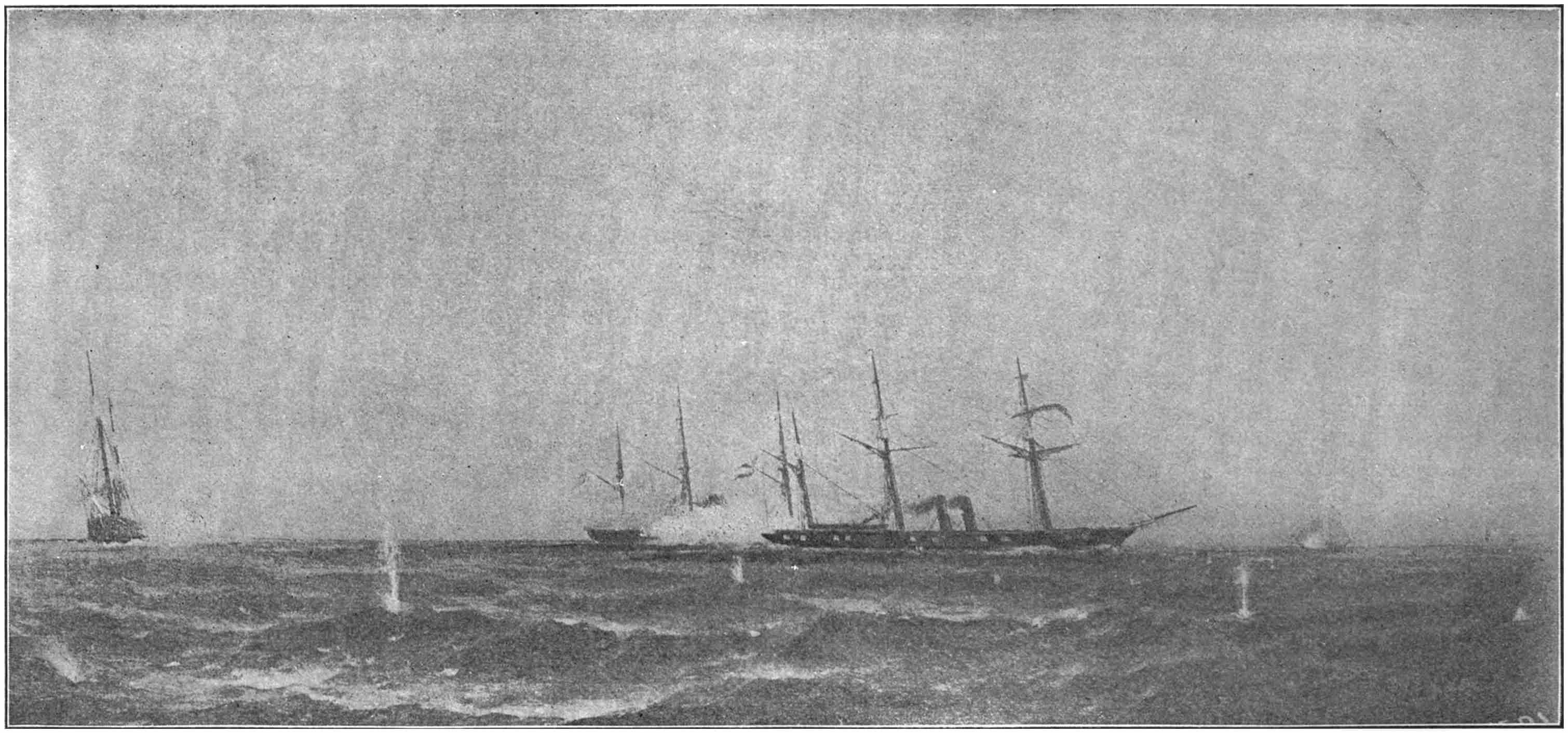
The Florida Running the Blockade at Mobile.
After a painting by R. S. Floyd.
The lookout on the Cuyler saw him coming423 when he was a long way from the bar, and notified the officer of the deck. Now, there was a regulation on the Cuyler which forbade the officer of the deck slipping the cable until Captain Winslow was on deck to order it done. By this regulation just a half hour’s time was lost. So the Florida was away, passing between the Susquehanna and the Cuyler at a distance of 300 yards while the Cuyler was still at anchor. The Cuyler did get under way at last, and chased the Florida until the next night, when the Florida changed her course and escaped.
The Oneida’s crew saw the signal announcing the coming of the Florida, and beat to quarters, but remained at anchor, although she was one of the swifter vessels present. And she remained at anchor until 3.50 o’clock, when, to quote her log, “having seen no vessel run out, beat the retreat.” Porter calls this affair “the greatest example of blundering committed throughout the war.” Certainly the captains of the Cuyler and the Oneida were not fit for their commands.
Maffitt went to Nassau, where the British population went delirious with joy over his success, and sold him coal to last three months, instead of enough to last to the nearest Confederate port, as the government orders had provided. Then Maffitt went cruising between424 New York and Brazil. In the course of five months he took seventeen prizes, and then went to Brest, France, where the ship was thoroughly overhauled.
Meantime Maffitt fitted one of his prizes, the Clarence, with light guns, and sent her cruising under Lieut. Charles W. Read. Read was as brave and dashing as Maffitt. Between the 6th and 10th of May, 1863, he took five prizes, shifting his flag to the fifth, the Tacony, and burning the Clarence. Then he took ten prizes, including the Archer, to which he made another shift. With the Archer he came to off Portland, Maine, and with small boats rowed in and cut out the revenue cutter Caleb Cushing. The Archer was a sailing ship. Read burned the Cushing, but steamers overhauled him next day and he was captured.
At Brest, Maffitt was relieved by Capt. Charles M. Morris, who took the Florida to Bahia, where Capt. Napoleon Collins, in the Wachusett, found her. Morris thought he was safe, and with half his crew went ashore. Collins rammed the Florida, fired a few shots into her, and took her to the United States. That carrying her home was a very grave mistake will soon appear; for a more open violation of a neutral port was never recorded, and if a naval officer feels justified in such an act he should not try to get prize money out of it,427 but make an end of his capture as soon as possible.
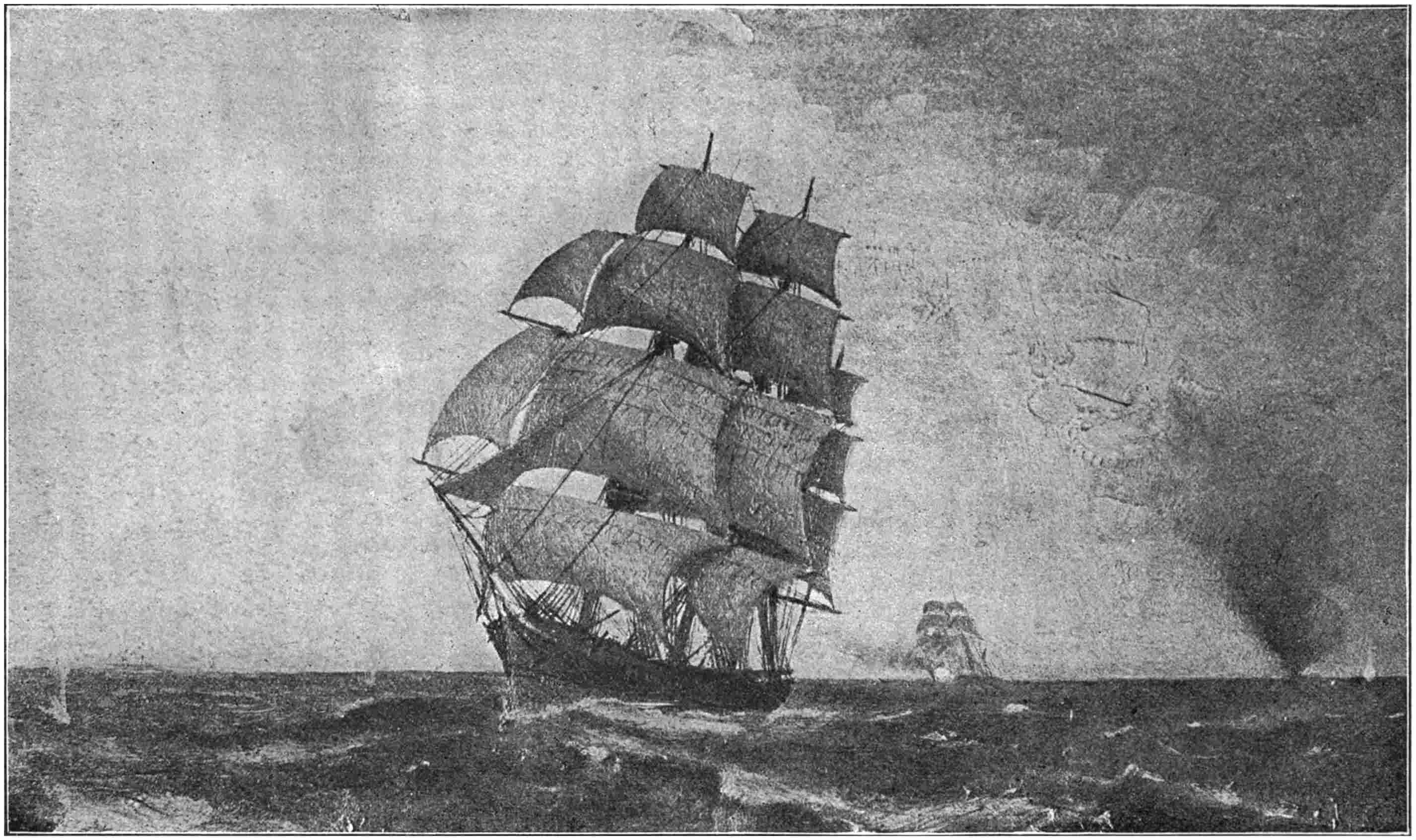
“A Prize Disposed and one Proposed.”
(The Florida in chase, having burnt the Star of Peace.)
After a painting by R. S. Floyd.
In considering violations of neutral ports, one may say that in practice the neutral port of a weak power has always been violated whenever there was any occasion for it. Moreover, since respect for a neutral port is a matter of courtesy only, we may be sure that whenever wars shall occur in future, weak neutral ports will be violated as they have been in the past. It is a question of policy in each case, and the captain of the aggressive ship must decide for himself whether the circumstances warrant the insult to the weak power.
As to this particular case, it is the sentiment of the people of the United States, if the writer knows that sentiment, that Captain Collins was entirely justified in capturing the Florida, especially as the Brazil authorities had permitted Semmes, of the Alabama, to use Fernando de Noronha as headquarters, so to speak, while cruising against American commerce. Indeed, Semmes took an American ship, the Louisa Hatch, into the port at that island, coaled his ship from her, and then towed her outside and burned her. While lying there, too, he saw two American vessels in the offing, went out and burned them, and came back again within a few hours to hobnob with the Governor. The mouth of Brazil was stopped. If Collins428 had sunk the Florida in port or burned her outside, it would have been proper for the United States government to set off the Alabama’s case against that of the Wachusett, and leave it to arbitration to decide which government should pay damages. But the most interesting feature of this case is found in the attitude of the British writers on the subject. When one recalls how the Essex was captured at Valparaiso after Porter’s too generous treatment of Hillyar, and how the Armstrong was attacked in the Azores, and how the Levant was taken at Porto Praya, one might suppose that the British would be rather lenient with their cousins across the sea, especially as blood is thicker than water; but we find in a work printed in 1896, called “Ironclads in Action,” by H. W. Wilson, a work that deals with ironclads as late as 1895, the capture of the Florida is denounced (page 151, vol. 1) as “disgraceful.” The writer really goes out of his way to do this, for neither the Wachusett nor the Florida was an ironclad in any sense. Moreover, he asserts that “the Florida’s officers were very badly treated,” which is simply a false statement.
Nevertheless, there was one disgraceful feature of the Florida affair. When Brazil demanded the restoration of the ship with her crew on board in the harbor of Bahia, the429 United States agreed to give her up, and Collins, who had captured her, was ordered to take her back as a punishment for his violation of international law. But the Florida never left the waters of the United States as a warship. She was lying at Hampton Roads when the order was issued—lying “just at the spot where the Cumberland was sunk in very deep water. An engineer was placed on board in charge with two men to assist him in looking after the water cocks; but, strangely enough, although the Florida was to all appearances water tight when she reached Newport News, she sank that night at 2 o’clock in ten fathoms.” “When the sinking of the vessel was reported to Admiral Porter (he was there fitting for the Fort Fisher expedition) he merely said ‘Better so’; while the Secretary of State and Secretary of the Navy never asked any questions.”
Those quotations are from Admiral Porter’s “Naval History of the Civil War,” and they are not unlikely to give the reader a choking sensation, for they show that the sinking of the Florida was the work of a sneak—that the “two men,” when “looking after the water cocks,” opened them under orders. The humiliating story is inserted here because the shame of it should serve to prevent the necessity of ever writing another of the kind.
The story of the Alabama is longer but not430 more interesting than that of the Florida. She was built by the Lairds and was known as No. 290, because she was the 290th ship the firm had built. The British government had full information that she was building for a Confederate cruiser under the supervision of Commander James D. Bullock of the Confederate navy, and, later, that Bullock was shipping men (British subjects) for her, promising petty offices to this and that capable man. The reader who wants to go into the details of this matter will find plenty of them in an Englishman’s work on the “Neutrality of Great Britain during the American Civil War,” by Mountague Bernard, of Oxford University. It furnishes, curiously enough, abundant proof that England escaped with a light penalty when in court in the matter of the “Alabama claims.”
The Alabama was a perfect cruiser for her day—long, lean, and shoal of draft. She was 230 feet long, only thirty-two wide, and she drew but fifteen feet of water. She had the rig of a barkentine, with long lower masts to give her plenty of fore and aft sail so that she could lie closer to the wind than any ordinary square-rigged ship. She had also a steam power able to drive her ten knots an hour, and her screw propeller could be detached and hoisted out of water whenever it was desirable431 to work with sails only. She carried eight guns, of which one was a hundred-pounder Blakely rifle, mounted on a pivot forward; one an eight-inch smooth-bore on a pivot aft, and six were thirty-twos in broadside.
Semmes, for his activity in the Sumter, was ordered to the new cruiser. He gathered his officers and crew at Liverpool, and shipping the outfit of all kinds in the merchant ship Bahama, he, with all hands, took passage in her. The cruiser, that was still known only as No. 290, was allowed to go on a trial trip. Although the ship was plainly a cruiser, and although men had testified under oath that they had shipped in her as a Confederate cruiser, the law officer of the customs authority decided that the evidence was insufficient, and she did not return from that trial trip. She met the Bahama at Terceira, a Portuguese island, and there, a marine league from land, on Sunday, August 24, 1862, No. 290 became the Alabama, and Semmes her captain, in the usual form. She was without any doubt a Confederate man-of-war. The people who still persist in calling her a pirate craft are probably unaware that if she had really been a pirate the United States would never have presented any claims against Great Britain for the damages she did to American commerce. And as for Semmes, he is entitled, in his official capacity as her432 captain, to as courteous treatment at the hands of historians as any captains that ever went afloat. Of his personal character it need only be said that he has written it into his “Memoirs.”
To his “Memoirs,” also, the reader may be referred for details of the burning of the hosts of American merchantmen that he captured. From Terceira the Alabama made a cruise against the whalers off the Azores, and thence went to Martinique, where the American warship San Jacinto found her. But Semmes escaped on the night of October 20, 1862. His first prize of consequence after this adventure was the Ariel of the Panama line. She was expected to bring a million or so in gold, but in this Semmes was disappointed.
From the place where the Ariel was captured Semmes went to Galveston to intercept the transports of the Banks expedition, of which he had read in captured papers. As he approached Galveston, on the afternoon of January 11, 1863, the Hatteras, a merchant steamer fitted with guns, was sent off to inspect him. Semmes pretended to run, and so drew the Hatteras away from the other blockaders, and then at 7 P.M. (it was dark of course) lay to for her. When the Hatteras ranged up and hailed, Semmes said his ship was “Her Britannic Majesty’s ship Vixen.”433 Capt. H. C. Blake, of the Hatteras, said he would send a boat, but when the boat had been lowered Semmes shouted, “We are the Confederate steamer Alabama,” and fired a broadside. Semmes was not at any time more than 100 yards away, and the Hatteras, a paddle-wheel steamer, was soon riddled. Blake tried to get alongside the Alabama to board, but could not do it, of course, and the Hatteras was soon rapidly sinking. A lee gun was fired and help called for. The living were all taken off by the Alabama’s crew, save the boat’s crew that had started to board the Alabama.
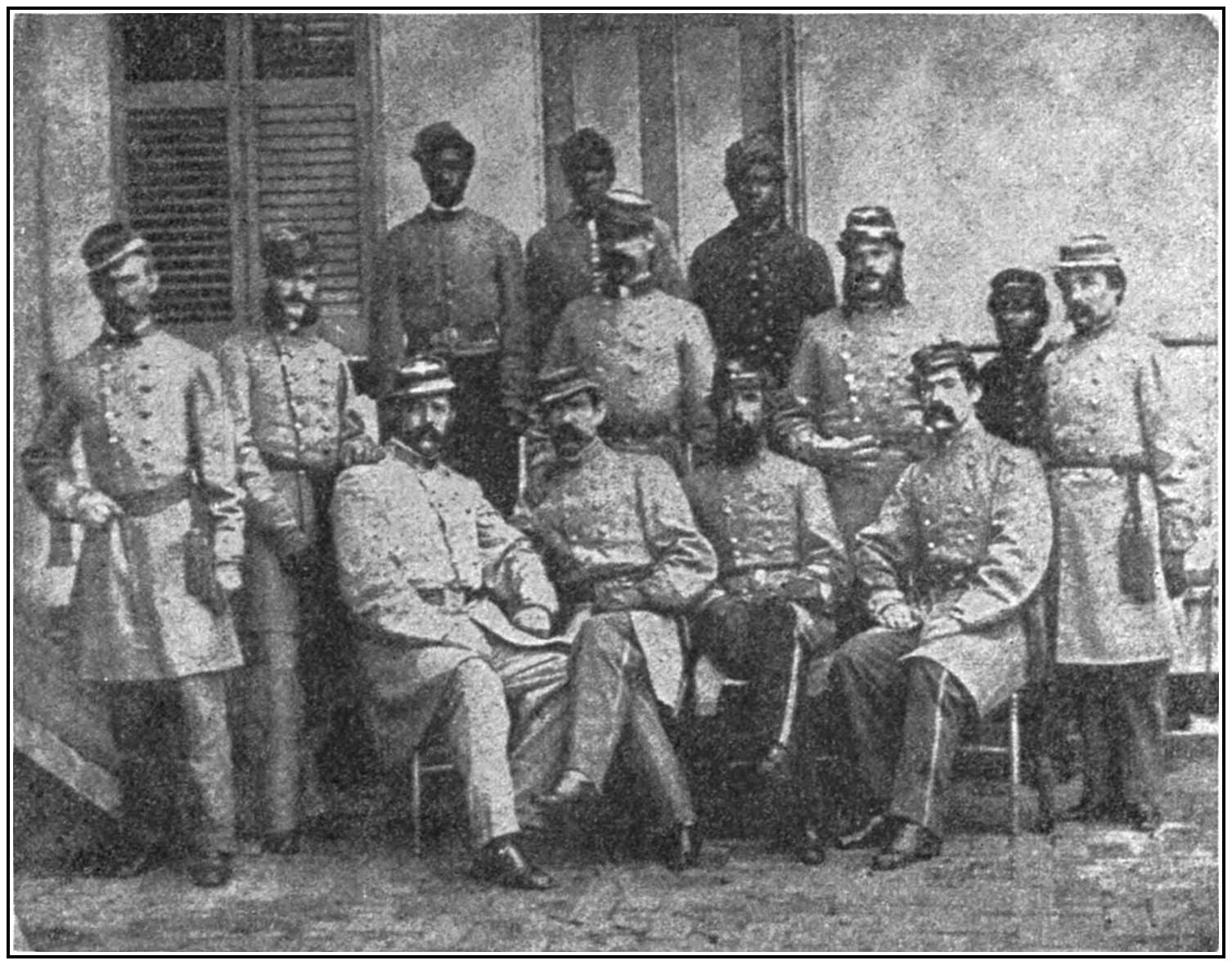
Raphael Semmes and his Alabama Officers.
From a photograph owned by C. B. Hall.
434
The Hatteras carried two short thirty-twos and two small rifles—a twenty-pounder and a thirty-pounder—that she was able to bring to bear. The prisoners were landed at Jamaica.
From this point Semmes went to the coast of Brazil, and then off to the point near the equator where homeward-bound American Indiamen cross the line. It was on the Brazil coast, in April, 1863, that he gave the Americans good excuse, by his violations of neutral waters, for the taking of the Florida. In July he went to the Cape of Good Hope, and at Cape Town was even more heartily welcomed than he had been at Gibraltar when in the Sumter. Here is the way he describes his reception:
“During my entire stay, my table was loaded with flowers, and the most luscious grapes, and other fruits, sent off to me every morning, by the ladies of the Cape, sometimes with, and sometimes without, a name. Something has been said before about the capacity of the heart of a sailor. My own was carried by storm on the present occasion. I simply surrendered at discretion, and whilst Kell was explaining the virtues of his guns to his male visitors, and answering the many questions that were put to him about our cruisers and captures, I found it as much as I could do, to write autographs, and answer the pretty little435 perfumed billets that came off to me. Dear ladies of the Cape of Good Hope!”
Perhaps while we are about it, it may be worth while to make one more quotation to show the full extent of the gallantry of which Semmes makes boast in every chapter. It will be found on page 620 of the “Memoirs,” where he describes the Brazilian people, but no part of the original is italicized:
“The effete Portuguese race has been ingrafted upon a stupid, stolid, Indian stock, in that country. The freed negro is, besides, the equal of the white man, and as there seems to be no repugnance, on the part of the white race—so called—to mix with the black race, and with the Indian, amalgamation will go on in that country, until a mongrel set of curs will cover the whole land. This might be a suitable field enough for the New England school-ma’am, and carpet-bagger, but no Southern gentleman should think of mixing his blood or casting his lot with such a race of people.”
At Cape Town Semmes was troubled a little by “the stereotyped American consul; half diplomat, half demagogue.” The American consuls were in chase wherever he entered a port, but the truth is that they were rarely able to do more than accumulate facts that were eventually handed in along with the bill436 for damages when the Alabama claims got into court in 1871.
Before reaching Cape Town a prize was turned into a cruiser, and she was of some little consequence in the Cape waters, but did nothing as compared with what the dashing Read accomplished on the American coast.
From the Cape of Good Hope Semmes went to the East Indies, where he found a harvest of prizes, came back to the Cape, and eventually went to Europe; and late at night, on the 10th of June, 1864, the Alabama reached Cherbourg, France, which was her last port, for there the Kearsarge, Capt. John A. Winslow, caught her.
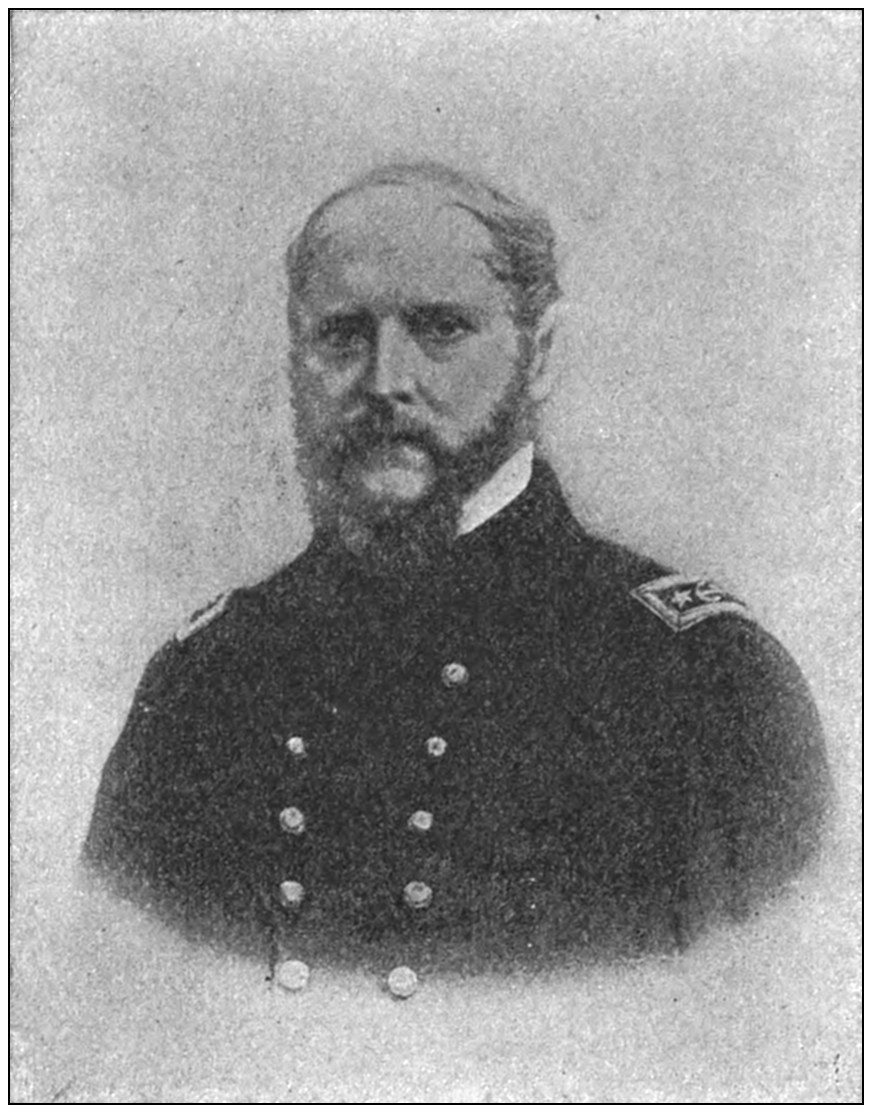
John A. Winslow.
From a photograph.
It is to the credit of Captain Semmes that he had no wish to escape the Federal ship, though he says that had he known that the Kearsarge had been armored by placing iron cables on her sides opposite her machinery he should not have done so. Ship for ship and crew for crew, the Alabama was inferior to the437 Kearsarge by a greater extent than has usually been told in history. In size they were practically the same—1,031 tons for the Kearsarge and 1,016 for the Alabama, but the Kearsarge was the swifter ship of the two. The Alabama carried eight guns, and she fired 328 pounds of metal at a broadside. The Kearsarge carried seven guns, and fired 366 pounds at a broadside; but these figures do not fully tell the superiority of the guns of the Kearsarge, for her two pivots were eleven-inch Dahlgrens, a style of gun that, at the range of this battle, and in a fight between unarmored ships, were far superior to the 100-pounder Blakely and the eight-inch (sixty-four-pounder) smooth-bore on the Alabama. And, then, in the crews the Kearsarge carried 163 men, chiefly Americans, to the Alabama’s 149, almost exclusively Europeans. The officers of the Alabama were about the only ones who had any sentiment in the fight; the men before the mast were at best filibusters—as ragged a crew (mentally) as that of the Bonhomme Richard. That they should have made any fight at all was due to the training received from men who had been reared under the old flag. Another great difference was in the powder, for that on the Alabama was very old and bad.
The Alabama remained in Cherbourg until Sunday, June 19, 1864, when soon after 9438 o’clock Semmes headed her out of the harbor. The French ironclad Couronne went along to see that the fight took place three sea miles from shore, and a steam yacht, the Deerhound, followed to give her owner and his family a chance to see a sea battle. The shores were soon covered with equally eager if less fortunate spectators, trains being run from Paris to bring people to the fight. And the sympathy of nearly all the spectators was with the Confederate ship.
Captain Winslow steamed off shore until seven miles from land, and then at 10.50 o’clock turned and drove the Kearsarge straight at the Confederate cruiser. At 10.57, when the ships were yet 1,800 yards apart, the Alabama yawed enough to open fire with a broadside. It was aimed rather worse, perhaps, than that which the Oneida fired into the Florida off Mobile, for the shot flew over the Kearsarge. Two more broadsides were fired from the Alabama as the Kearsarge approached head on, but when the Kearsarge, at a range of 900 yards, was seen to be heading to run across the Alabama’s stern, the Alabama started off in a way that set the two ships running “in a circle against the sun”—starboard side to starboard side, gradually approaching nearer and nearer, while the current swept them slowly down the coast.
439
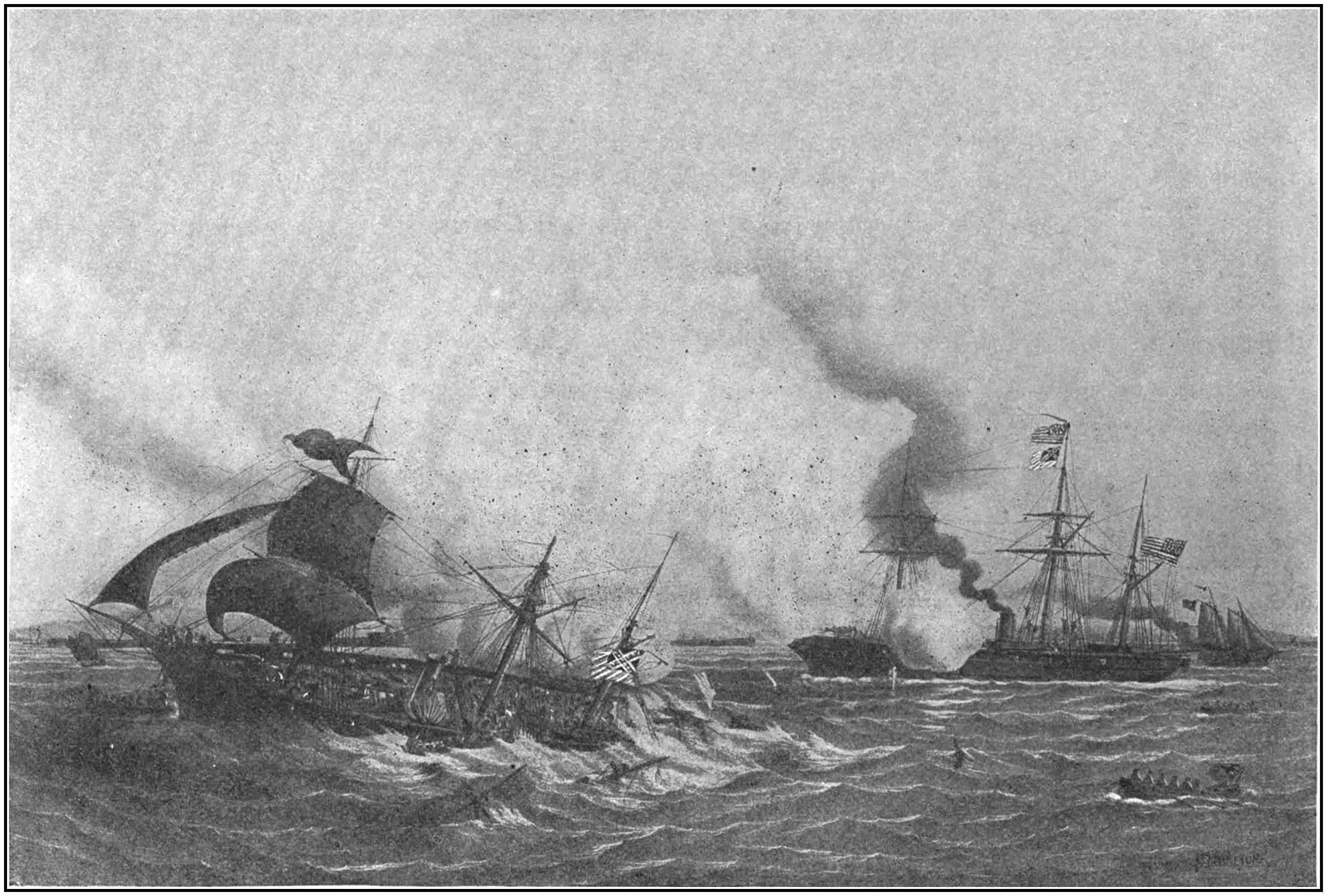
Engagement between the U. S. S. Kearsarge and the Alabama off Cherbourg, on Sunday, June 19, 1864.
From a French lithograph.
441
As this circling was started the Kearsarge opened fire. Word was sent to every gunner to “make every shot count,” and they obeyed. The gunnery of the Kearsarge was the best shown during the Civil War. The Alabama fired rapidly—she hurled 370 shot in sixty-five minutes, of which only twenty-eight struck the Kearsarge. Of these, two were turned by the chain armor, but had they penetrated they would have had no serious effect. One shell penetrated the stern post, but failed to explode. Had it exploded, the Kearsarge would have had difficulty in steering—perhaps she would have been made helpless; but the battle was then so far done that the Alabama would, at best, have been able to escape.
The Kearsarge fired only 173 shot, but so many of these struck home that before the end of an hour the Alabama was sinking.
Hoisting trysail and jib, Semmes headed for the shore, hoping to escape with the aid of his sails, but it was too late. The Kearsarge ran across her bow to deliver a raking broadside, and then the Alabama hauled down her flag. A little later a white flag was displayed, and then it was seen that the Alabama was rapidly settling in the water. A boat put off from her to ask for assistance. The Kearsarge sent two boats to rescue the crew, and the steam yacht Deerhound came up to help also. Semmes442 seeing at last that she must sink, threw his sword into the sea and leaped overboard, and while he swam for life the Alabama’s stern sank under the sea, the bow was lifted high out of water, and down she went, with her bowsprit disappearing last of all.
There was some diplomatic trouble over the escape of a lot of the Alabama’s crew, including Semmes, on the Deerhound. The reader will, perhaps, be able to determine the rights of the Deerhound in this case by putting himself mentally in her owner’s place. Suppose Ireland should secede from Great Britain and an Irish cruiser should be sunk in the presence of a Yankee yacht. Would the Yankee yacht-owner deliver up the Irishmen’s crew to the triumphant British warship? Certainly, if the Yankee yacht-owner was a politician, he would not do so.
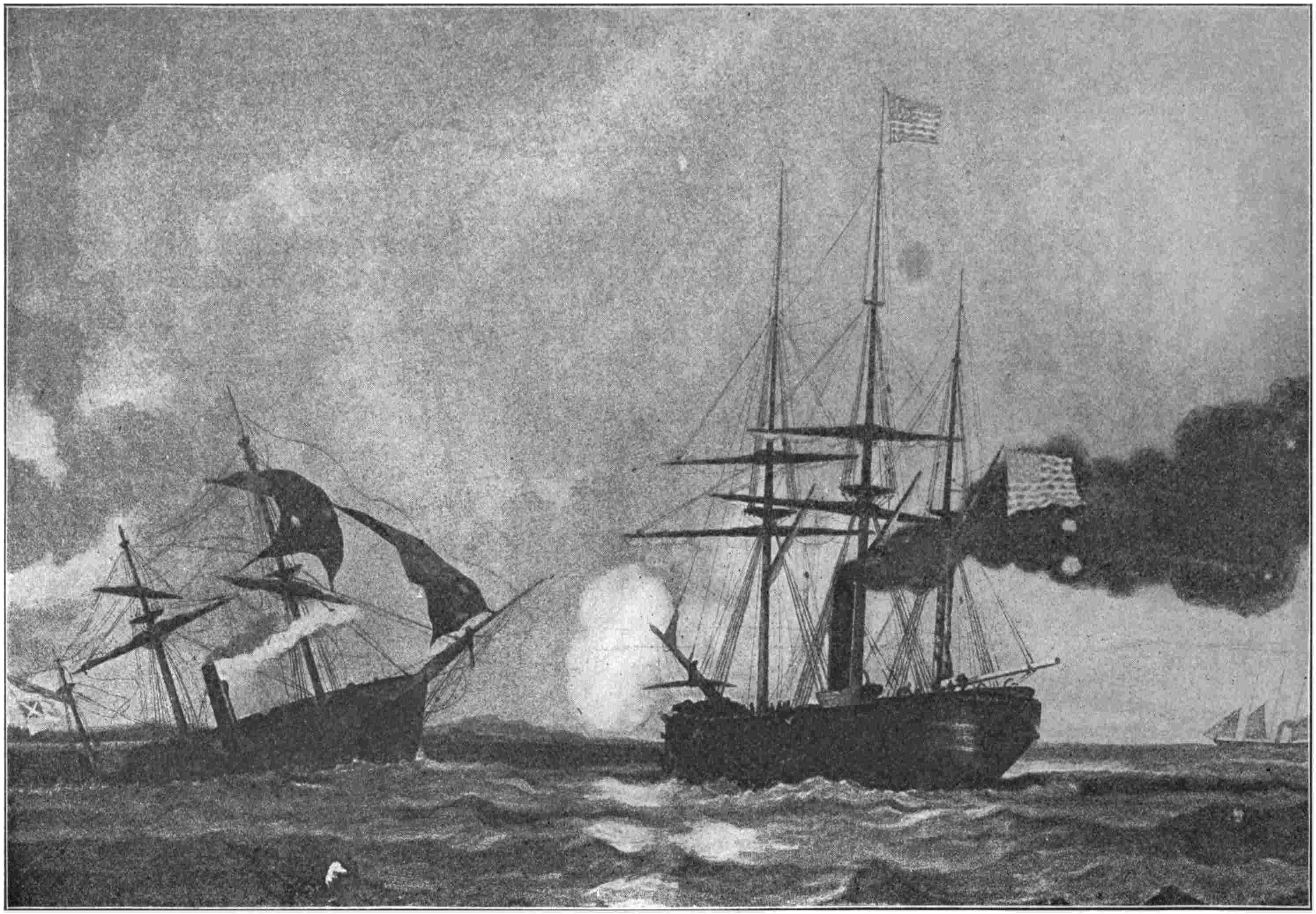
The Kearsarge Sinking the Alabama.
From an engraving.
And, then, there were the virulent attacks on Semmes for swimming to the Deerhound instead of swimming to the Kearsarge. What would the reader have done? What would that other “pirate,” John Paul Jones, have done in a case like that?
It is now thirty-seven years since the Alabama sank in the green waves off Cherbourg. Those of us who were old enough to read the newspaper extras that were issued when the account of it was telegraphed home are old447 enough to know better than to call Semmes a pirate.
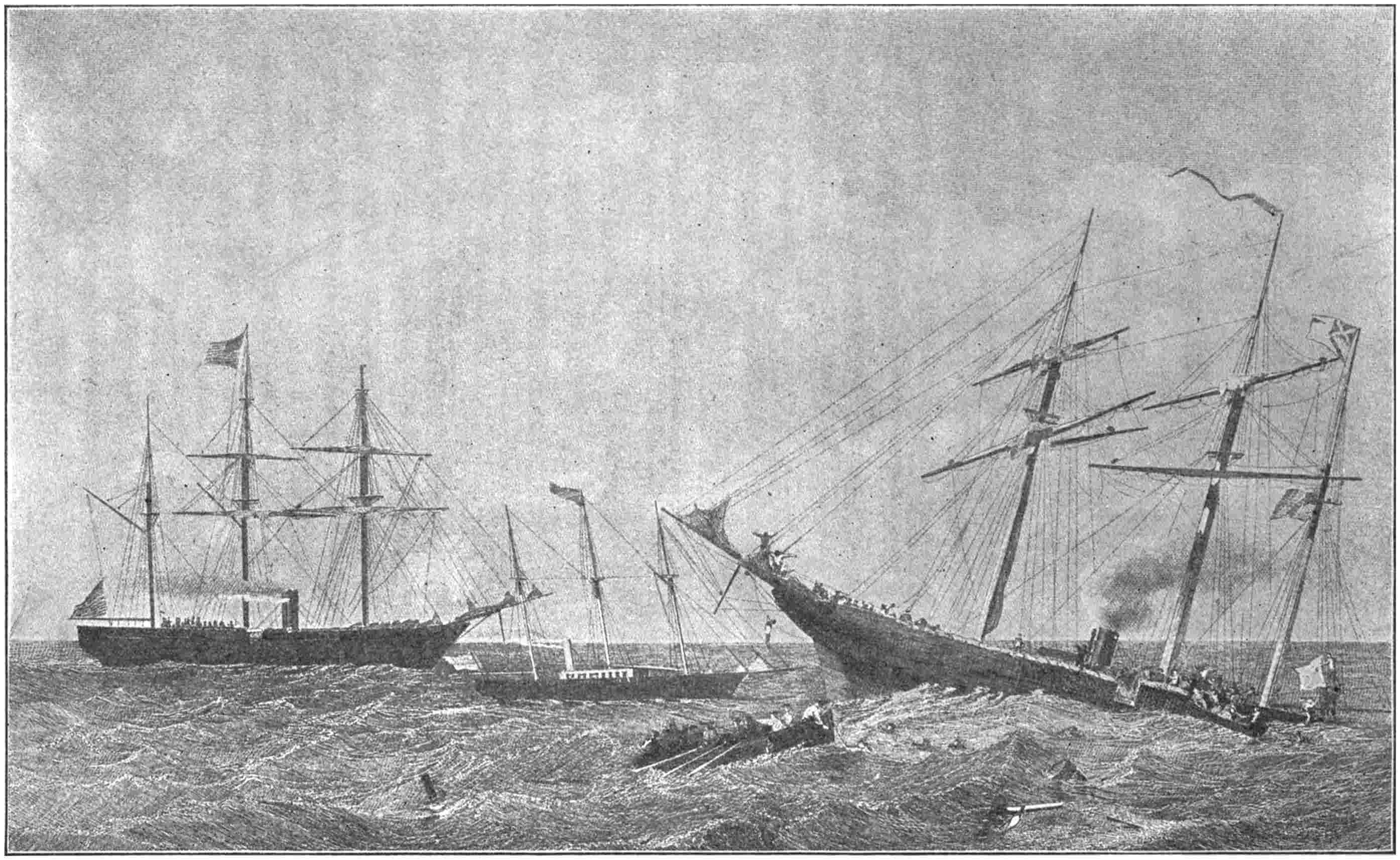
Action between the Kearsarge and the Alabama.
(Rescue of the crew of the Alabama by the Deerhound.)
From an engraving of the painting by Chappel.
Semmes having escaped to England, was counted a hero there, and a fine sword was given to him to replace the one he threw into the sea. Let the prejudiced shipowner who lost money through the work of this sea rover candidly ask himself what kind of a sea captain it is who, knowing his force is inferior, sails boldly out to meet a watchful enemy, and then fights till his ship is shot from under his feet.
Raphael Semmes earned the right off Cherbourg to have his name inscribed in the list of the sea heroes of America.
The total number of prizes made by the Alabama was sixty-nine, of which fifty-three were destroyed, two had their cargoes only destroyed, and eleven were bonded. The Florida took thirty-seven, of which twenty-eight were destroyed. While the number taken was but a small percentage of the American merchant fleet, the effect of the captures was to raise insurance rates, frighten shippers as well as shipowners, and so prevent the employment of the ships at sea. The carrying trade utterly abandoned American ships.

There were a few other Confederate cruisers, the Shenandoah being the most important, although she did nothing but destroy the American whaling and sealing fleet on the448 northwest coast. Her total number of captures was thirty-six. What the cruisers did altogether might be told in a list of the American ships destroyed, but it is better to express the facts by saying that they literally swept the American flag from the sea. England was obliged to pay $15,000,000 for the aid she gave the Confederates in this work. As has been said, “she got off cheap.” What she failed to do when she sent shiploads of war material to help the Barbary pirates who were attacking American commerce, she accomplished entirely when she allowed the Confederate warships to fit out in her ports. She destroyed the only competitor on the high seas of whom she had any fear. Does any one doubt that she did it deliberately? From 1864 until this day in 1897 the maritime supremacy of Great Britain has been undisputed. She paid $15,000,000 in damages, and every year has collected in profits on the American carrying trade which she then secured—who451 shall say how many times $15,000,000 her profits on the American carrying trade are? Perhaps if the reader will learn the answer to this question, he may make up his mind what the American people ought to do about it.
452
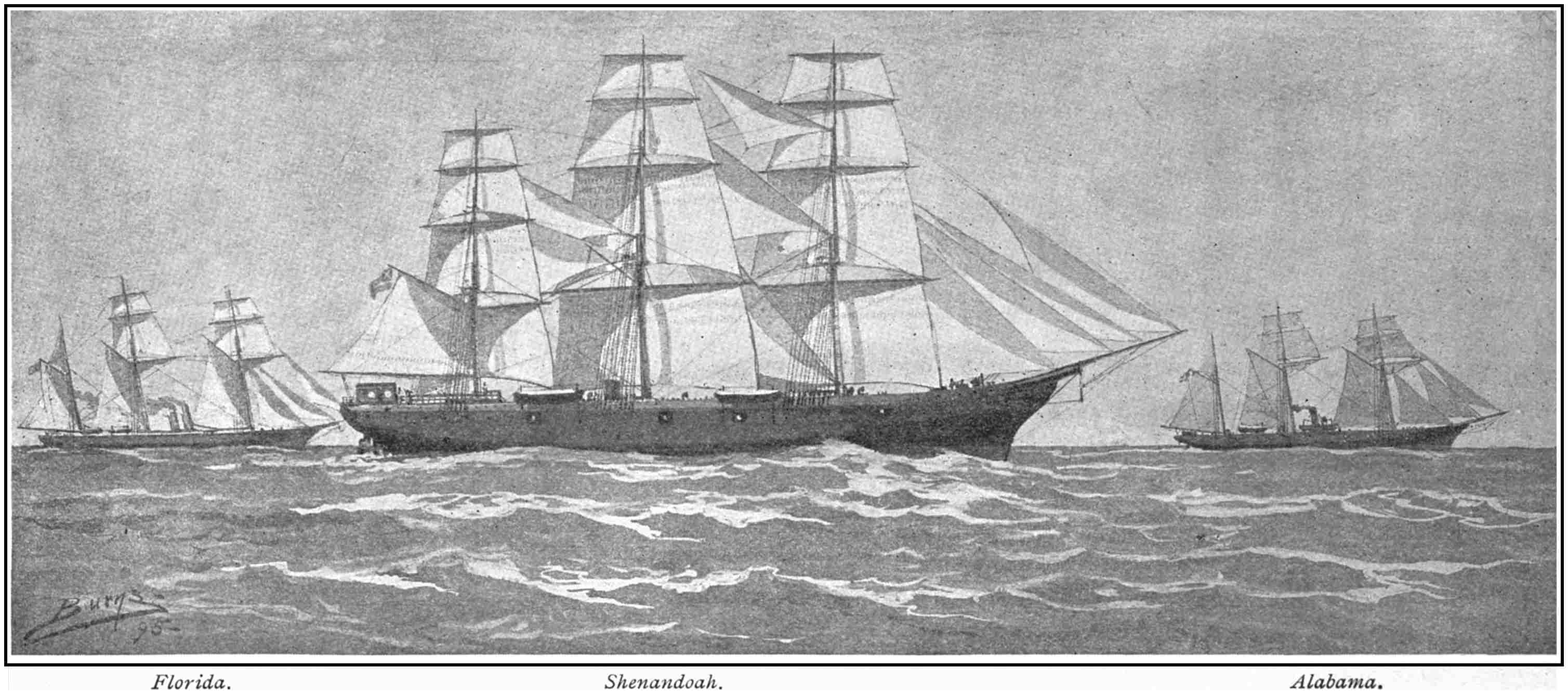
Three Famous Confederate Cruisers.
From a painting by M. J. Burns.
A FORMIDABLE WARSHIP WAS BUILT UNDER REMARKABLE CONDITIONS TO ENABLE THE CONFEDERATES TO REGAIN CONTROL OF THE INLAND WATERS OF NORTH CAROLINA—VERY SUCCESSFUL AT FIRST, BUT SHE WAS LAID UP TO AWAIT THE BUILDING OF ANOTHER ONE, AND THEN CAME CUSHING WITH HIS LITTLE TORPEDO BOAT, AND THE CONFEDERATE HOPES WERE DESTROYED WITH THEIR SHIP.
The loss of the control of the North Carolina sounds, as already told, proved more damaging to the Confederate forces than they realized at first, but they very soon began making efforts to establish themselves there once more, and the oftener they were defeated in their hopes the more determined they became. To tell the complete story of the skirmishes that took place between the Dismal Swamp and Newbern would be to give a hundred instances of the courage, enterprise, and persistence of the men on both sides. There was the case of John Taylor Wood, who, with a party of Confederates, boarded and destroyed the Union gunboat Underwriter under the eyes of the Union forces453 afloat and ashore. As another instance, there is also the story of Cushing’s trip up the New River Inlet with the Ellis, where he got into the wrong channel and had to destroy her, and then row in an open boat for a mile and a half under fire of the Confederates to escape. They were all brilliant, but none of them was decisive in any way.
Eventually it became apparent that no dashing exploit could restore Confederate supremacy there, and their hope was dying, when two flatboat-builders living at Edward’s Ferry, on the Roanoke River, offered to build an ironclad, somewhat on the plan of the Merrimac, that should be able to navigate the shoal waters of the Sound and yet be invulnerable to the shot of the Union gunboats. Because the water at Hatteras Inlet was too shoal for any of the Union ironclads to pass, it was reasonable to suppose a well-built craft could clear the Union wooden gunboats from the waters of North Carolina.
The chief contractor for the boat that was, in accordance with these ideas, laid down at Edward’s Ferry, was Mr. Gilbert Elliott. Naval Constructor John L. Porter, who had rebuilt the Merrimac, was sent to work out the plans, and Commander J. W. Cooke was appointed to gather the outfit and supervise the construction.
454
Work began on her in January, 1863. Her keels (she was flat-bottomed) were laid in a cornfield. A common country blacksmith shop was the only “machine shop.” Her engines were put together from the scrap heaps of the iron works at Richmond and Wilmington. The timbers were from good pine logs, and her armor was like that of the Merrimac, but the ship, as a whole, excited the amusement even of many of the Confederates until she was afloat.
At this time the gunboats Miami, Capt. C. W. Flusser, and the Southfield, Captain French, were stationed at the west end of Albemarle Sound, rather in the mouth of Roanoke River, near Plymouth. Flusser, as early as June 8, 1863, sent to Rear-admiral S. P. Lee, then commanding the station, a very accurate description of the new ironclad. An expedition was sent up the river to destroy her on the ways, but it could not pass—at least it did not pass—the Confederate forts. Then an appeal was made to Gen. John G. Foster, commanding the Federal troops, to send a cavalry regiment to burn the ship, but “General Foster expressed his unconcern about the rebel ram.” Sorrowful to relate, the vigilant Flusser, and not the self-satisfied Foster, suffered the penalty of this unconcern.
455
The Albemarle was “122 feet over all, had forty-five feet beam and drew eight feet of water. The casemate, built of massive pine timbers, covered with four-inch planking, was sixty feet long, and was covered with two layers of two-inch iron. The vessel was propelled by twin screws, operated by engines of 200 horse power each. She was armed with an Armstrong 100-pounder in the bow and one in the stern, while the casemate was so pierced that they could be used as broadside or quarter guns.”
She was not ready for action, however, until April, 1864. On the 17th of that month the Confederate General Hoke advanced on Plymouth. Captain Cooke, of the Albemarle, had promised to coöperate in order to deprive the Union soldiers of the help of the Union gun-boats. The Albemarle was not quite ready, but she left her moorings with the mechanics still at work screwing on her armor plates. While the foreman shouted orders to the mechanics, naval officers alongside were drilling the crew at great guns; and John N. Maffitt tells an amusing story of how the orders were mingled: “Drive in spike No. 10! Serve vent and sponge! On nut below and screw up! Load with cartridge!” And the fact that all this was done is especially interesting when we remember that the men equal456 to such an occasion were the kind to win, and they did win in their first onslaught.
The Union forces had driven piles to keep her up the river, but, aided by high water, the Albemarle passed them with no delay whatever, and just before midnight, on April 19th, the Union gunboats found her upon them. The Miami and the Southfield had been yoked together with long booms and chains in such fashion that the Albemarle was expected to strike in between them and there get caught at such short range that their nine-inch Dahlgren projectiles would easily penetrate her armor. But instead of going between them, the Albemarle crossed the Miami’s bow and rammed and sunk the Southfield. Flusser bravely worked his guns, but one shell that he himself fired against the Albemarle’s side broke into pieces, which, rebounding back, killed him where he stood. Then the Miami fled and Plymouth surrendered.
On May 5th the Albemarle had another fight with a squadron gathered to disable her. She was rammed by the Sassacus. The blow hurt the Sassacus more than the ironclad, and a few shot from the Albemarle’s guns sent the Union ship adrift and almost unmanageable. She would have been entirely so but for a heroic engineer who kept her engine going in spite of escaping steam in the engine-room.457 The Whitehead, the Mattabesett, and the Wyalusing also took part, firing as rapidly as possible. The action is described in one history as a “desperate battle.” The casualties on the Union side in this desperate affair amounted to four killed, twelve wounded by projectiles, and fourteen scalded by steam from a cut pipe. The hero of the battle was Engineer J. M. Hobby, who stood at his post on the Sassacus in spite of the scalding steam when every other man fled, and so saved the ship.
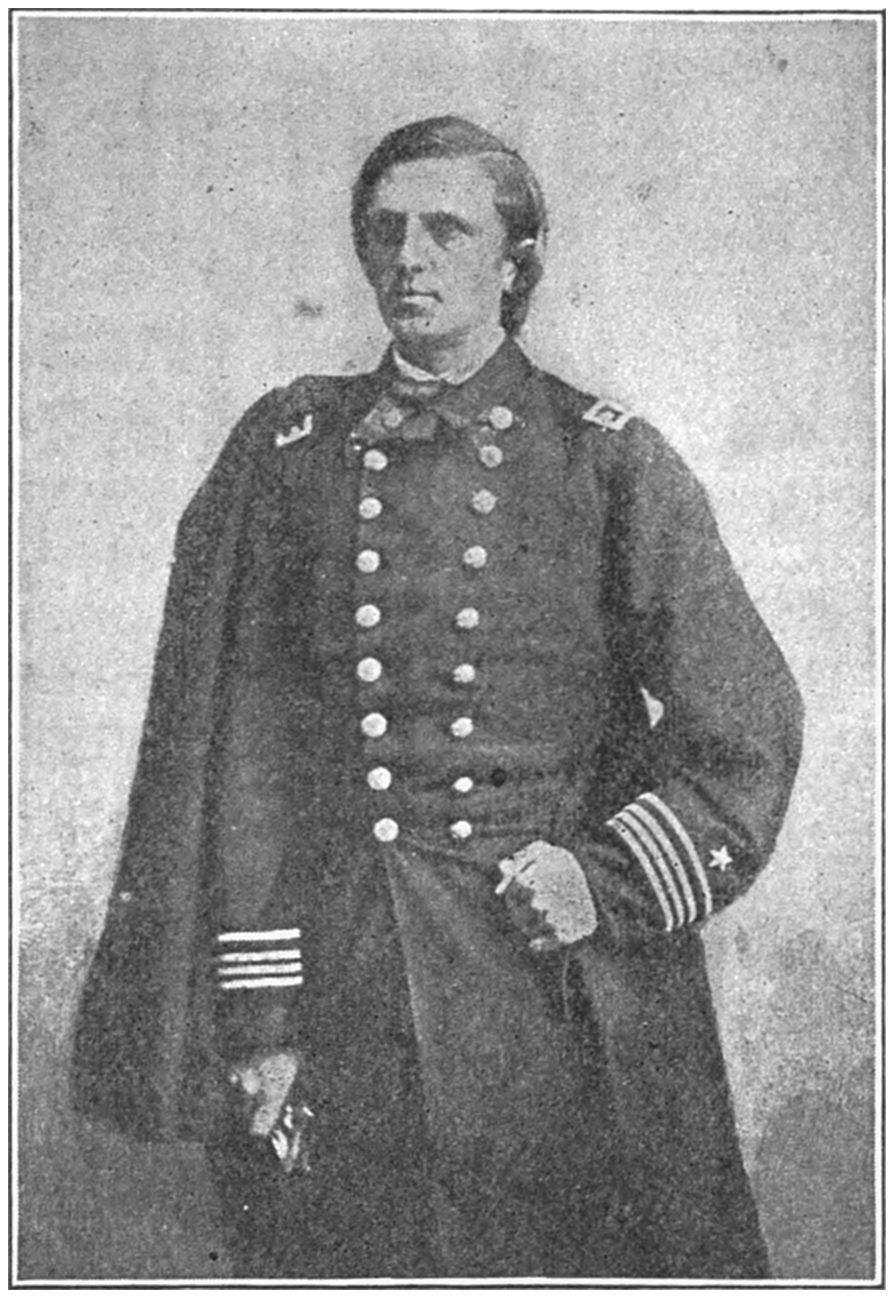
William B. Cushing.
From a photograph.
Thereafter the Albemarle was tied up at the Plymouth wharf to await the completion of another ship like her that was building on Tar River, and this needless delay was fatal, for Lieut. William B. Cushing asked for, and obtained, the task of destroying her, and he was of the kind that succeed.
Cushing, after serving as a cadet nearly four years at the Naval Academy, resigned on458 March 21, 1861—just why has never been told. In May he entered the navy once more. He was made a master’s mate, and by July, 1862, had obtained a lieutenant’s commission through repeated “acts of successful daring.” He was with Rowan at Elizabeth City, and obtained command of the Ellis, captured there. His courage, combined with good judgment, continued to keep him in the eyes of his superior officers. He was constantly looking for something to do, and when he offered to destroy the Albemarle he was allowed to try.
At about this time Engineer John L. Lay, U. S. N., had devised a torpedo boat that consisted of a light steam launch rigged to carry a torpedo at the end of a long spar—a torpedo that might be placed against a ship’s side and fired by means of a string that led from the trigger of the torpedo to the launch’s bow. It would be considered a crude affair now, for the man operating the torpedo had to stand erect in the bow of the launch, wholly unprotected even from musketry. Two of these little boats were built in New York, and Cushing carried one of them through inland waters to Albemarle Sound, Norfolk being then in Federal hands. Admiral Ammen, in his history, complains that “the newspapers had gratuitously furnished the enemy with information” about all the movements of Cushing, “as459 well as the avowed object of destroying the Albemarle.” The writer hereof was not a reporter in those days, but he imagines that some naval officer told the reporters where Cushing was going before the destination was announced in any newspaper; though the matter is important only as a warning to naval officers not to tell vital secrets to reporters. As to the effect of this publicity, the Confederates put double lines of pickets along the river below Plymouth, stationed 1,000 soldiers about the wharf, built a boom of cypress logs around the Albemarle at such a distance that no torpedo spar could reach over it to the hull, and kept the sentries on board, pacing to and fro at night, constantly on the lookout, while an outpost was established in the river on the wreck of the sunken Southfield, one mile down-stream.
It was in the month of October, 1864, that Cushing brought his boat to the waters below Plymouth, and on the night of the 26th the gunboat Otsego towed the launch to the mouth of the river, where Cushing cast off, and with a ship’s cutter loaded with armed men in tow of his launch, he started up the river. The cutter’s men were to land at the outpost, on the old wreck, if necessary, and care for the Confederates there, while the steam launch was to be driven at full speed to the Albemarle, a mile460 away. But luck was against the expedition. The launch grounded, and before she could be gotten afloat day was at hand, and Cushing returned to the Otsego.
And then came the night of the 27th. There were thirteen officers and men in the launch with Cushing, besides the cutter load in tow. It was a dark night, and with no light and with his machinery working in perfect silence, Cushing steamed up the river. Cushing himself stood in the bow, steering-wheel in hand, with a loaded howitzer on one side ready for firing, and with the gear for working the torpedo on the other. There were two schooners beside the old wreck; but the sentinels failed to see Cushing, and wholly unobserved, he arrived opposite the well-guarded ironclad, and then for the first time learned that the boom was so far out from the ship that the torpedo could not reach her.
For a moment Cushing thought to land, walk boldly on board, and strive to carry her out into the stream. But even as the thought came to him he was discovered by the sentinels on shore, and a hail was heard.
“Boat ahoy!” followed almost instantly by a musket-shot, and then by a rattling fire from an uncounted line of sentinels up and down the shore and on the ship. A huge bonfire of fat pine knots blazed up to illuminate the461 shore, and the call of the ship’s crew to quarters arose on the air.
To the mind of any other man than a Cushing the expedition was a failure, but casting off the cutter with orders to pull for life, Cushing turned his launch out into the stream, swung her around in a wide circle to give her full speed, and then headed straight at the log-boom abreast of the fated ram. A host of Confederates gathered on the ram’s deck to beat him off. Two howitzers loaded with canister, and a score of muskets, were fired at him, and a man by his side fell, but Cushing with his own well-aimed howitzer scattered the Confederate host. And then the sled-runner bow of the launch struck the half-submerged boom, rose with the impetus, and over she went with her bow half under water, but inside the boom. The muzzle of a hundred-pounder was shoved out through the Albemarle’s broadside port, directly in front of the launch, but Cushing drove the torpedo under the hull of the ironclad, raised it up until he felt it strike her bottom, and then, as the Confederates fired their big gun, he pulled the trigger. A dull roar from beneath the ship answered to the crash of the broadside gun. The charge of the gun flew over the heads of the launch’s crew, but the torpedo opened wide the hull of the Albemarle, and down she went.
462
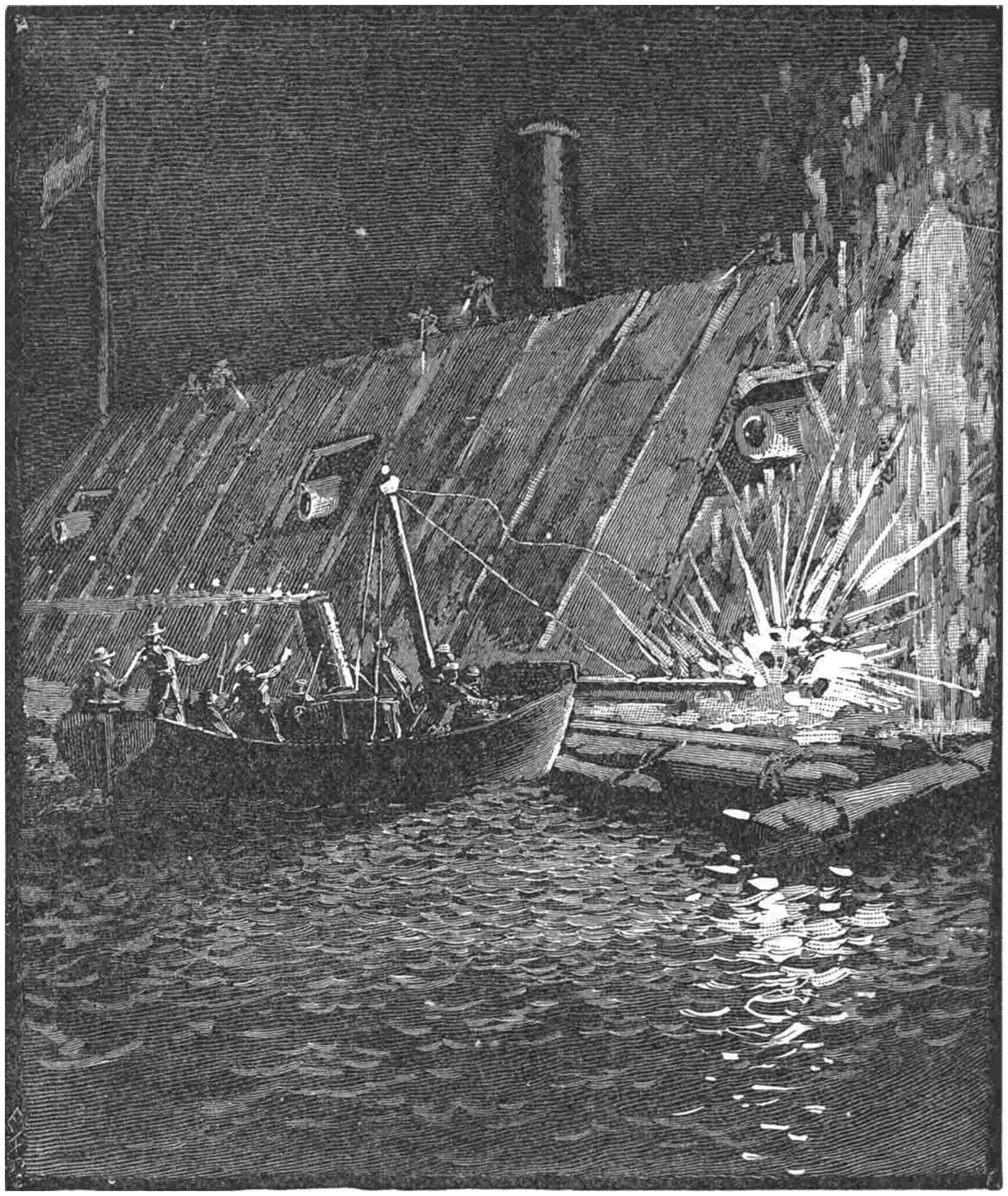
The huge wave thrown up by the torpedo swept over the bow of the little launch, and she, too, sank. Even then the fortitude and resourcefulness of Cushing preserved him. Plunging into the river, he swam away unhurt and reached the swampy shore below, utterly exhausted. There he lay in the water until463 day was breaking, when he crawled into the woods and hid himself. While lying there he heard two men talking as they walked in an alongshore path, and learned how complete had been his work. During the day he found one of the enemy’s picket-boats, and that night he paddled his way off to the Valley City, where he arrived at 11 o’clock at night.
He was only a boy—he was but twenty-one years old—but no man, old or young, has ever surpassed him. He was officially complimented by the Secretary of the Navy, and this was the fifth time that the department had “had the gratification of expressing its approbation” of his conduct. He had said when leaving the Otsego, “another stripe or a coffin,” and he got the stripe. But no gold medal was voted to him. Gold was at a premium in those days—so high a premium, apparently, that Congress could not afford it. The writer does not mean to carp, but to deplore the fact that men who during the Civil War showed the most magnificent qualities of mind did not receive every recognition possible. For it is the men who write rank with a capital R that make and save the nation.
It is comforting to note that of the launch’s crew but two were killed, though all the rest were captured except Cushing and one other. The following is a list of the crew:
464
“William B. Cushing, Lieutenant, commanding expedition, escaped; William L. Howarth, Acting-Master’s Mate, picket-boat; William Stotesbury, Acting-Third-Assistant Engineer, picket-boat; John Woodman, Acting-Master’s Mate, U. S. S. Commodore Hull, drowned; Thomas S. Gay, Acting-Master’s Mate, U. S. S. Otsego; Charles S. Heener, Acting-Third-Assistant Engineer, U. S. S. Otsego; Francis H. Swan, Acting-Assistant Paymaster, U. S. S. Otsego; Edward T. Horton, ordinary seaman, U. S. S. Chicopee, escaped; Bernard Harley, ordinary seaman, U. S. S. Chicopee; William Smith, ordinary seaman, U. S. S. Chicopee; Richard Hamilton, coalheaver, U. S. S. Shamrock; R. H. King, landsman, picket-boat; —— Wilkes, landsman, picket-boat; —— Demming, landsman, picket-boat; Samuel Higgins, first-class fireman, picket-boat, drowned.”
Cushing became a commander in 1872, and he was then the youngest man of the rank. He died of brain fever at Washington in 1874. He was tall (six feet) and slender, and, as his portrait shows, looked more like a poet than a warrior. And the student of history who reads his dispatches will say that he was both.
With the destruction of the Albemarle the hope of the Confederates fled. But two seaports remained to them—Charleston and Wilmington.
465
IT WAS A WELL-GUARDED HARBOR, AND THE CHANNEL WAS LONG AND CROOKED—THE “STONE FLEET” AND THE ATTITUDE OF FOREIGN POWERS—BRIEF CAREER OF TWO CONFEDERATE IRONCLADS—THE BLOCKADE WAS NOT RAISED—A CONFEDERATE CRUISER BURNED—UTTER FAILURE OF THE IRONCLAD ATTACKS ON THE FORTS—CAPTURE OF THE CONFEDERATE WARSHIP ATLANTA—“BOARDERS AWAY” AT FORT SUMTER—MAGNIFICENT BRAVERY OF THE MEN WHO MANNED THE CONFEDERATE TORPEDO BOATS.
When the student of American history turns from the stories of the battles of New Orleans and Mobile to that of the naval efforts to reduce Charleston, he is driven to a conclusion that may be expressed by saying there was only one Farragut in the Civil War. He may easily believe that both Dupont and Dahlgren were great men, but their absolute failures before Charleston simply emphasize the fact that Farragut earned the place he has held in the hearts of his countrymen.

Charleston Harbor.
From “The Navy in the Civil War.”
The chart of Charleston harbor in these days is somewhat misleading to a careless reader of history, because the channel now used466 by shipping runs straight out to sea, while the channel used in the days of the war is comparatively shoal, and is used by coasters only.467 In the time of the war a ship bound into Charleston must needs sail in toward the coast several miles south of the harbor, the exact point to be steered for being marked by a tall lighthouse. Arriving within half a mile or so of the beach, the ship turned to the north and followed along the shore of Morris Island, which terminates in a long sandy point called Cumming’s Point, very much like Sandy Hook of New York harbor. Above Cumming’s Point the channel swept away to the northwest until Fort Sumter was reached, when it turned still further to the west, passing Forts Ripley and Pinckney, and then the piers were reached.
The Union warships had to face earthworks from the moment they arrived within range of the tall lighthouse. There were, early in the war, guns at intervals all the way from Light House Inlet to Cumming’s Point, guns laid with muzzles out to sea and commanding the channel along the shore of Morris Island. The chief of these batteries was called Fort Wagner, and it stood on the beach about three miles north of the lighthouse, or say a mile south of Cumming’s Point; but there was another good work (Fort Gregg) on Cumming’s Point, and even before that was passed a ship came in range of Fort Beauregard and Fort Moultrie over on the north side of the harbor (Sullivan’s Island), and, later, of Fort Sumter,468 on an island midway between the north and south shores of the harbor, and of Fort Johnson, lying on the south side of the harbor. There were other earthworks about the harbor, and the two little island forts of Ripley and Pinckney ought, perhaps, to be considered, although they did nothing of consequence in the fighting.

Battery Brown: Twenty-eight-inch Parrott Rifle.
From a photograph by Haas & Peale.
These forts were armed during the attack made upon them on April 7, 1863, with the following guns that could bear upon the ships: Ten ten-inch smooth-bores, three nine-inch469 smooth-bores, two eight-inch rifles, nineteen eight-inch smooth-bores, eight thirty-two-pounder rifles, eighteen thirty-two-pounder smooth-bores, and ten ten-inch mortars. No detailed account is given of the landward bearing guns of these forts, but it may be said that the forts on Morris Island and James Island were well fitted to repel troops, while the harbor forts Moultrie and Sumter had nothing of account bearing toward the inner part of the harbor.
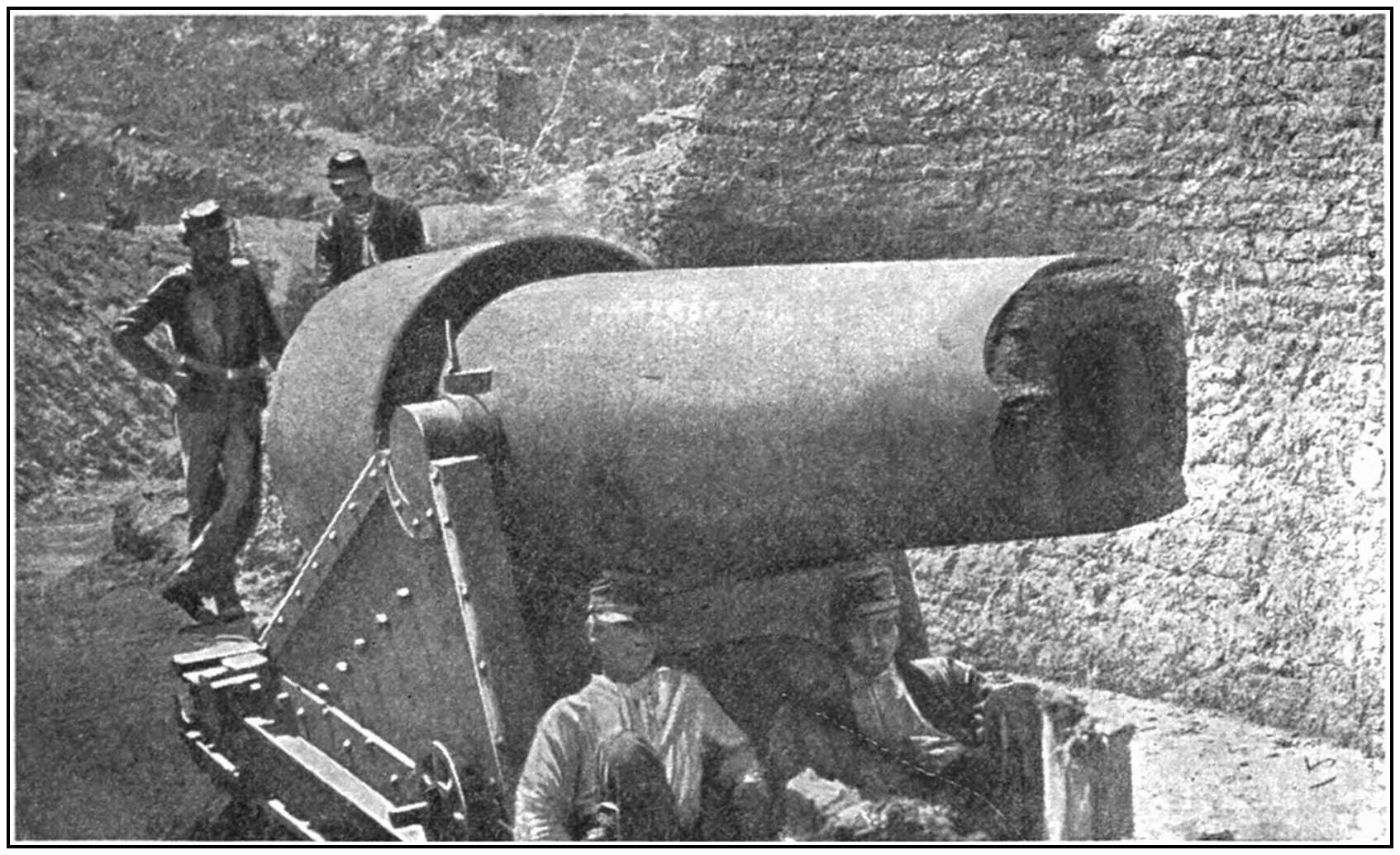
In the Charleston Batteries: 300-pounder Parrott Rifle after Bursting of Nozzle.
From a photograph by Haas & Peale.
In addition to the forts, there were a lot of torpedoes, beginning in the channel off Fort Wagner and continuing around to a line of logs and chains stretched from Fort Sumter across the channel to Sullivan’s Island. It470 makes the gray-haired men of Charleston smile, in these days, when these channel obstructions are mentioned; for, as Bishop John Johnson—he who wrote “The Defence of Charleston Harbor,” a work that is entirely fair and most interesting—said to the writer: “The moral effect of these obstructions was excellent—excellent.” And so it was.
The first thing of importance done in Charleston harbor after establishing the blockade was in the line of strengthening the blockade, and not an attempt to reduce the city. This was the sinking of the “Stone Fleet.” On December 20, 1861, twenty old hulks of ships, well loaded with stone, were sunk in the channels. The importance of this work is found only in the fact that it brought out conspicuously the exact attitude of the British government toward that of the United States.
Let the reader observe, first of all, that the hulks were “so disposed as to obstruct navigation without impeding the flow of water.” They were “intended to establish at Charleston a combination of artificial interruptions resembling on a small scale those of Hell Gate or Holmes Hole, and producing, like them, eddies, whirlpools and counter currents, such as to render the navigation of an otherwise difficult channel hazardous and uncertain.” The last quotation is from a letter from Lord471 Lyons at Washington to the British Prime Minister.
Whether a nation has a right to close permanently a channel of commerce wholly within its own borders is a question that has never been decided by any international court, or any writer on international law, for that matter. At any rate, it is quite certain that if England chose to dam permanently a harbor as a war measure, she would not receive in kindly spirit any interference from a foreign power. But the fact is that the “Stone Fleet” was not sunk in Charleston’s channels with any idea that the hulks would “permanently injure” the harbor. It was well known to engineers in England, as well as in the United States, that when tidal currents over such sands as those at Charleston were interrupted in one place, they would cut new channels. It was further well known that these obstructions could be removed readily whenever there was need of doing so. With these facts in mind, the following extract from a letter of instructions written by Lord Russell to Lord Lyons about the “permanent” closing of Charleston harbor is of interest:
“Such a cruel plan would seem to imply despair of the restoration of the Union, the professed object of the war; for it never could be the wish of the United States government472 to destroy cities from which their own country was to derive a portion of its riches and prosperity. Such a plan could only be adopted as a measure of revenge and of irremediable injury against an enemy. Lord Lyons was further told that even as a scheme of embittered and sanguinary war such a measure would not be justifiable. It would be a plot against the commerce of all maritime nations, and against the free intercourse of the Southern States of America with the civilized world.”
The protest of France was of the same tenor, and when the French Chambers and the British Parliament met in January and February, 1862, the subject was vehemently discussed.
This was one of the first of a series of attempts made by the British government to aid in the destruction of the Union—a series that did not end until the United States laid the keels of a fleet of ships of which the Wampanoag was the type—ships that could carry a few one-hundred-pounder rifles and steam at the then unequalled rate of seventeen knots per hour. That the British government became friendly after the trial trip of the Wampanoag had been described in print is one of the most instructive incidents in the history of the American navy. If it be coupled with the facts that before the building of the modern473 Yankee White Squadron the British government refused even to consider a proposition for a general arbitration treaty between the two English-speaking nations, and that since the efficiency of the Yankee ships has been demonstrated the British were particularly in favor of such a treaty, the incident proves—but let the candid reader consider this matter in all its bearings for himself. The hull of the Wampanoag was designed by Constructor Delano, and the machinery by Engineer Isherwood. And it is written, “Blessed are the peacemakers.”
For a year after the sinking of the Stone Fleet the Union squadron off Charleston did nothing but the tedious work of interrupting commerce. During this time the Confederates, although Charleston had had nothing in the semblance of a shipyard, had been building two ironclads there, called the Palmetto State and the Chicora. Commodore D. N. Ingraham supervised the work. They were from plans by John L. Porter, the enterprising constructor of the Merrimac, and they were somewhat like her, though but 150 feet long by thirty-five broad, with a draft of twelve feet. They had the same kind of iron armor, backed by twenty-two inches of wood, and their guns included sixty-pounder and eighty-pounder rifles and some larger shell guns.474 The plating covered the ram-shaped bows, and was continued five feet below the water-line.
On the morning of January 31, 1863, the warships Housatonic, Ottawa, and Unadilla, with the armed merchantmen Mercedita, Keystone State, Quaker City, Memphis, Augusta, Stettin, and Flag were lying at wide intervals off Charleston harbor. There was a heavy fog lying low on the water. At 4.30 o’clock a ship suddenly appeared in the mists abeam of the Mercedita, Capt. Henry S. Stellwagen. The officer of the deck on the Union ship, manifestly believing the stranger was one of the blockading force, shouted:
“What steamer is that? Drop your anchor or you will be into us!” The reply that came was startling. It was made by Commodore Ingraham, and he said:
“The Confederate States steamer Palmetto State,” and he emphasized the answer with a shell that killed one man, cut through the condenser and the steam-drum above one of the Mercedita’s boilers, and then exploded just short of the further side of the steamer, tearing a great hole in her side near the water-line. The shot and escaping steam killed four, and as many more were scalded. They were at the mercy of the ironclad, and they believed the ship was sinking. When the Confederates demanded that the Mercedita surrender, Lieut.475 T. Abbott was sent in a small boat to the Palmetto State, where he gave a parole for all the members of his crew.
This done, Commodore Ingraham left the Mercedita alone, and went hunting other blockaders. Meantime the Chicora found the Keystone State, Capt. William E. LeRoy. A shell was fired at the Chicora, Capt. J. R. Tucker, and the Confederates returned it with a shot that set the Keystone State on fire, and she steered away in the fog to escape until she had extinguished the fire, when she turned toward a black smoke, intending to ram the vessel making it. It proved to be a Confederate ship cruising in the fog for blockaders, but the Keystone State failed to ram her. Worse yet, the Confederate projectiles cut the Keystone State’s steam-pipes and pierced her below the water-line. It was an ironclad against a frail merchant ship, and there could be but one result. The merchant ship surrendered. She had lost twenty killed and as many wounded before she did so.
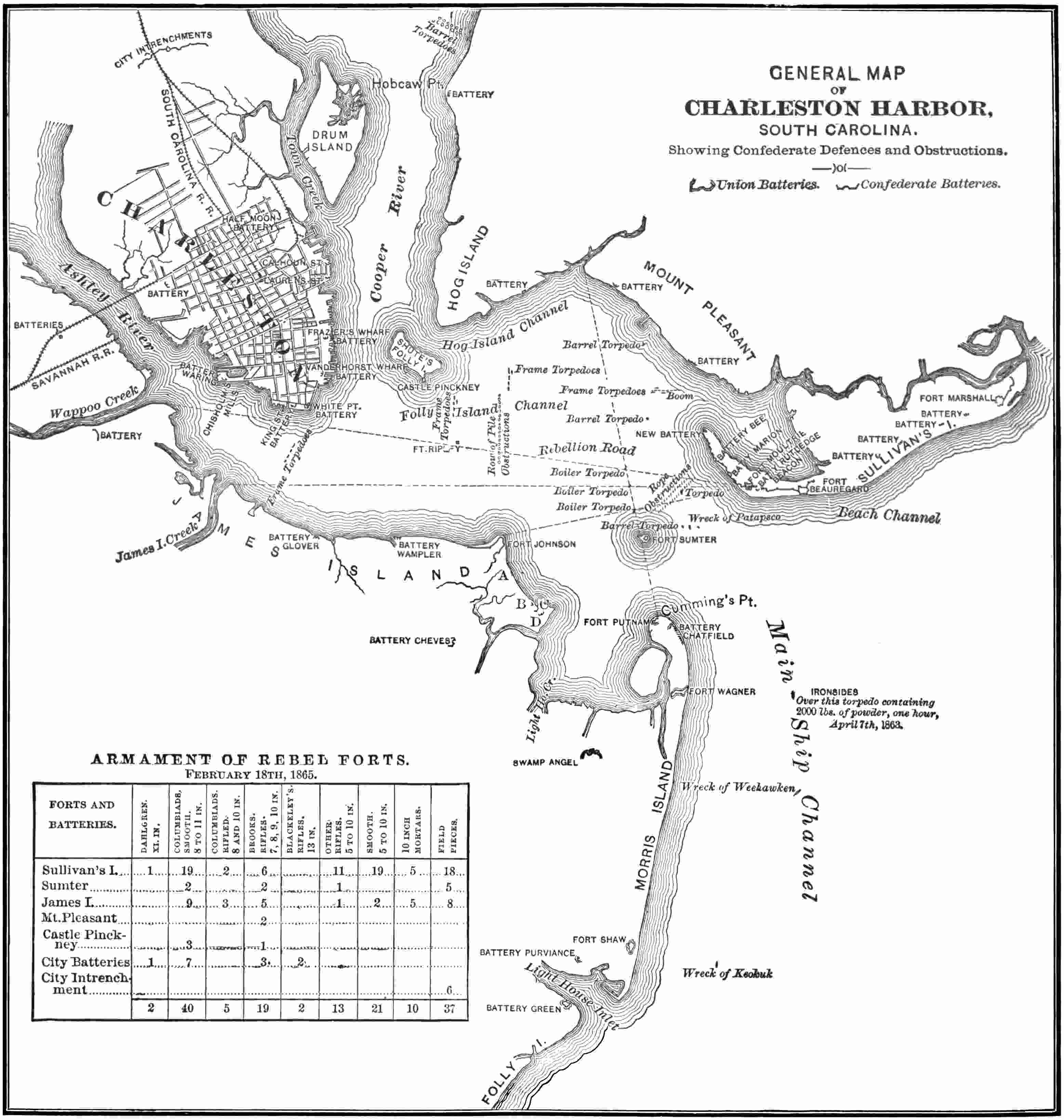
GENERAL MAP
OF
CHARLESTON HARBOR,
SOUTH CAROLINA.
Showing Confederate Defences and Obstructions.
ARMAMENT OF REBEL FORTS.
February 18, 1865.
Meantime the Palmetto, Commodore Ingraham, had been cruising about and exchanging shots with some other ships of the blockading squadron, but they being of superior speed, easily avoided her, according to the Confederate accounts. The Union reports say that the Unadilla and Housatonic came to478 attack her instead of running. In any event, the two Confederates had accomplished everything possible in compelling the surrender of the two Union ships. They could not even take the surrendered ships into port. “I knew that our only opportunity was to take the enemy unawares, as the moment he was under way, from his superior speed, we could not close with him,” says Ingraham in his report. He therefore “led the way to the beach channel.” He did not make any attempt to carry either of the surrendered vessels with him. The two Confederate ships started for home at 7.30, according to Tucker’s official report, “leaving the partially crippled and fleeing enemy about seven miles clear of the bar, standing to the southward and eastward.”
However, when the Cossack, with the 176th Pennsylvania militia on board, reached the bar at 8.30 o’clock, it found all but two or three of the blockading squadron in the usual places, as her officers and the officers of the regiment testified. Neither the Unadilla nor the Housatonic had passed beyond the usual line of blockade. No blockade-runner passed in or out during the fight, and, according to Tucker’s report, the retreating rams anchored under the shore batteries at 8 o’clock. And that was the only service rendered by these rams.
All this is important only because Robert479 Bunce, the British consular agent; Baron de St. Andre, consul for France, and Señor Francisco Moncada, consul for Spain, “at a joint conference concurred in the opinion that the blockade had been legally raised.” Wilson, the British author of “Ironclads in Action,” says of the surrender of the Mercedita:
“The ram, without stopping to take possession, ran north, and the Mercedita’s captain promptly rehoisted his flag. This very questionable proceeding he could scarcely justify on any grounds.”
There is nothing in any report on either side to show that the flag was “promptly” rehoisted. There is nothing to show that Ingraham had any idea of taking possession of the Mercedita. In fact, he had no such idea. Scharf’s “Confederate States Navy” says (and, fortunately for this occasion, Scharf is a violent partisan rather than a historian) that “other vessels of the fleet assisted her to Port Royal for repairs.”
The Confederates followed this success by capturing the gunboat Isaac Smith in the Stono River, where, when scouting, she got among the Confederate batteries. Then the Union forces had a turn of good luck. The Confederate cruiser Nashville had been lying blockaded for a long time in the Great Ogeechee River. Fort McAllister guarded the480 river, and a line of piles prevented a dash past the fort, but Capt. John L. Worden, who commanded the Monitor, took a new monitor, the Montauk, to the line of piles, on February 28th, and while four other Union vessels fired on the fort, Worden shelled the Nashville at a range of 1,200 yards. The fort gunners kept up a furious but wild fire on Worden’s boat, but he got the range and burned the cruiser. Worden was always at least as proud of this event as he was of his fight with the Merrimac, and he had a right to be, for the marksmanship of his gunners was very much better on this occasion.
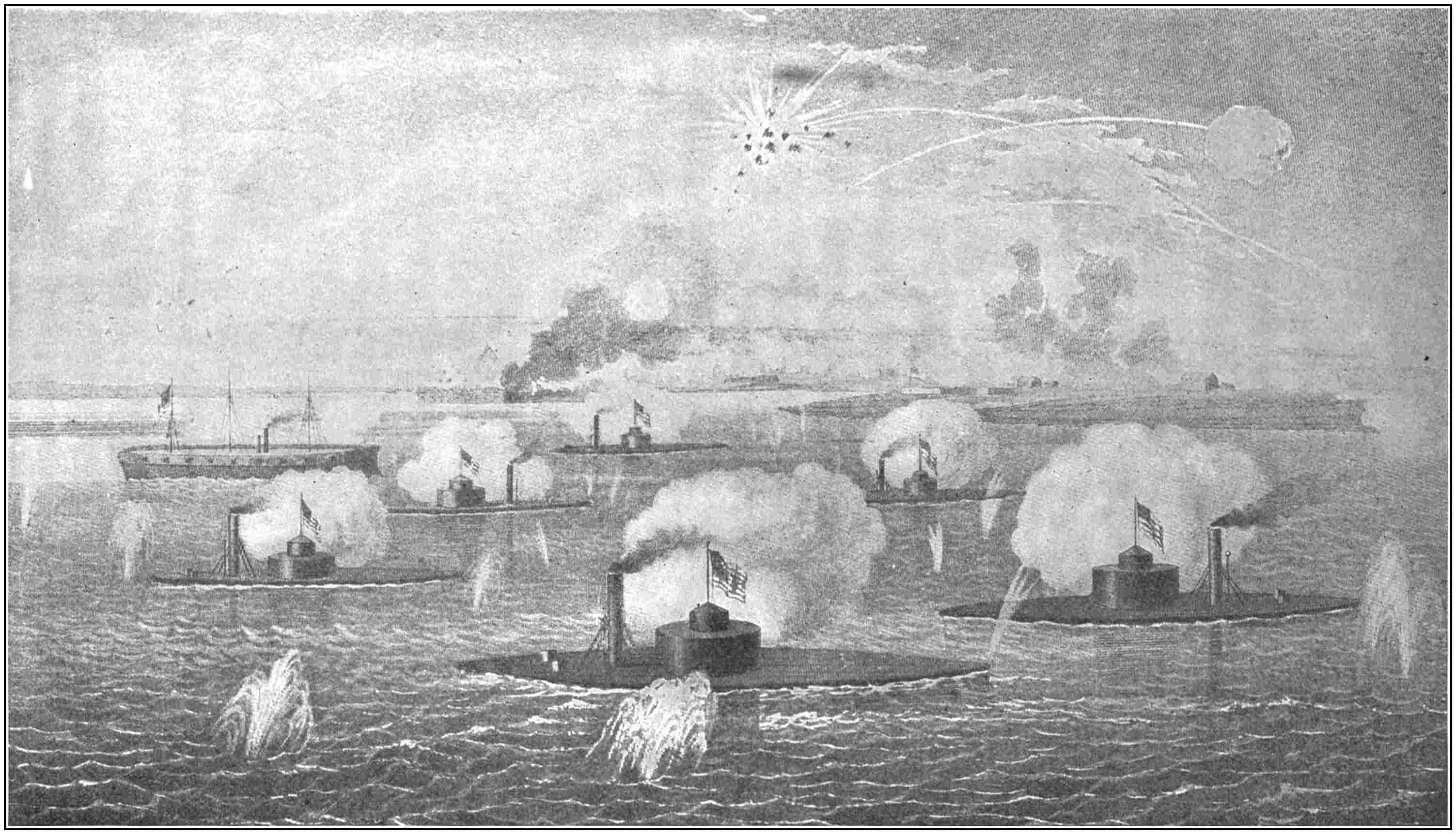
Ironclads and Monitors Bombarding the Defences at Charleston.
From an engraving.
After all this preliminary work came the first serious attack on the Charleston defences.
“The order of battle was as follows: The Weehawken, Capt. John Rodgers, with a raft on the bows to explode torpedoes, led the line; the Passaic, Capt. Percival Drayton; the Montauk, Capt. John L. Worden; the Patapsco, Commander Daniel Ammen; the New Ironsides, Commodore Thomas Turner (as flagship), followed by the Catskill, Commander George W. Rodgers; the Nantucket, Commander D. M. Fairfax; the Nahant, Commander John Downes, and the Keokuk, Commander A. C. Rhind.
“The vessels were ordered to pass without returning the fire from batteries on Morris483 Island; when within easy range of Fort Sumter they were to open upon it, and take position to the north and west, at a distance of 800 yards, firing low, and at the centre embrasure. The necessity for precision of fire was enjoined.”
Of these nine ships the New Ironsides was a big broadside steamer with heavy iron plating, and she carried two 150-pounder rifles and fourteen eleven-inch Dahlgrens. The Keokuk was a sort of monitor with two fixed turrets, and the others were new monitors carrying one fifteen-inch Dahlgren, the solid shot of which weighed 440 pounds, and one eleven-inch Dahlgren, save only that the Patapsco carried a 150-pounder rifle in place of the smaller Dahlgren.
On April 7th this formidable squadron steamed up the channel. They did not get started until 1.15 P.M. because of the fouling of the big raft that was expected to serve as a torpedo-catcher in front of the leading monitor (Weehawken), but at 2.50 o’clock the squadron was within range of Fort Moultrie, and the Confederates opened fire. It was a battle in enclosed water—the Confederate gunners had the range marked to a yard with colored buoys, and the fire was hot from the first gun. But the squadron steamed slowly on until within about 1,000 yards of Fort Sumter. There is484 a clash of authorities as to the exact distance, but the point is of no consequence because it is certain that the distance of the ships was in no case less than 800 yards from Sumter. At 3.05 the ship at the head of the line opened fire. “A fifteen-inch shell fired at Sumter was watched until it struck on the northeast face; the fort was covered with a mass of dust from the bursting shell.” So says Ammen, and that tells the whole story of the effect of the attack. It kicked up a mighty dust. Some of the ships, including the flagship, became unmanageable. “Disregard motions of flagship” was signalled by Admiral Dupont, commanding. The ships were in a turmoil because of the tidal currents and the difficulty of seeing through the peep-holes and through the smoke. But they did not try to pass into the harbor and attack the forts in the rear. Capt. John Rodgers, of the Weehawken, in his report, tells why for himself and all the squadron:
“We approached very close to the obstructions extending from Fort Sumter to Fort Moultrie—as near, indeed, as I could get without running upon them. They were marked by rows of casks very near together. To the eye they appeared almost to touch one another, and there was more than one line of them.
“The appearance was so formidable that,485 upon deliberate judgment, I thought it right not to entangle the vessel in obstructions which I did not think we could have passed through.”
The obstructions were really of no account, and there was, moreover, an opening through them.
“After braving the fire of sixty-nine guns for about an hour, the ironclads retired, some of them seriously injured. The Keokuk had drifted much nearer than she intended to do. She was struck ninety times in thirty minutes, and nineteen shots pierced her armor.” “In short, the vessel was completely riddled.” She went down next day. The Nahant was disabled for one day, and was not in good order for a month. The New Ironsides was for a long time over an electrical torpedo containing 3,000 pounds of powder, but the firing apparatus had been improperly adjusted, and she escaped. The Confederates thought she escaped through treachery, and it is said they executed the man in charge. The Confederate ironclads had no part in this battle. And the Confederates had fewer guns than at Mobile.
Dupont wrote regarding this attack: “During the few minutes that we were under the heaviest fire of the batteries, half of our turret-ships were in part, or wholly, disabled. We486 have only encountered the outer line of defence, and if we force our way into the harbor, we have not men to occupy any fort we may take, and we can have no communication with our force outside except by running the gauntlet.... We have met with a sad repulse; I shall not turn it into a great disaster.”
Chief Engineer A. C. Stimers, who had been in the original Monitor, was so disgusted with the result of the battle that he could not help expressing his opinion forcibly in Dupont’s presence. He was court-martialled and acquitted. There was no Caldwell to break the chain running from Sumter to Moultrie, and there was no Farragut to plan to go in, as at Mobile, where he believed that six of his squadron must be sacrificed to make the passage, or to say “Damn the torpedoes!” when once the start was made.
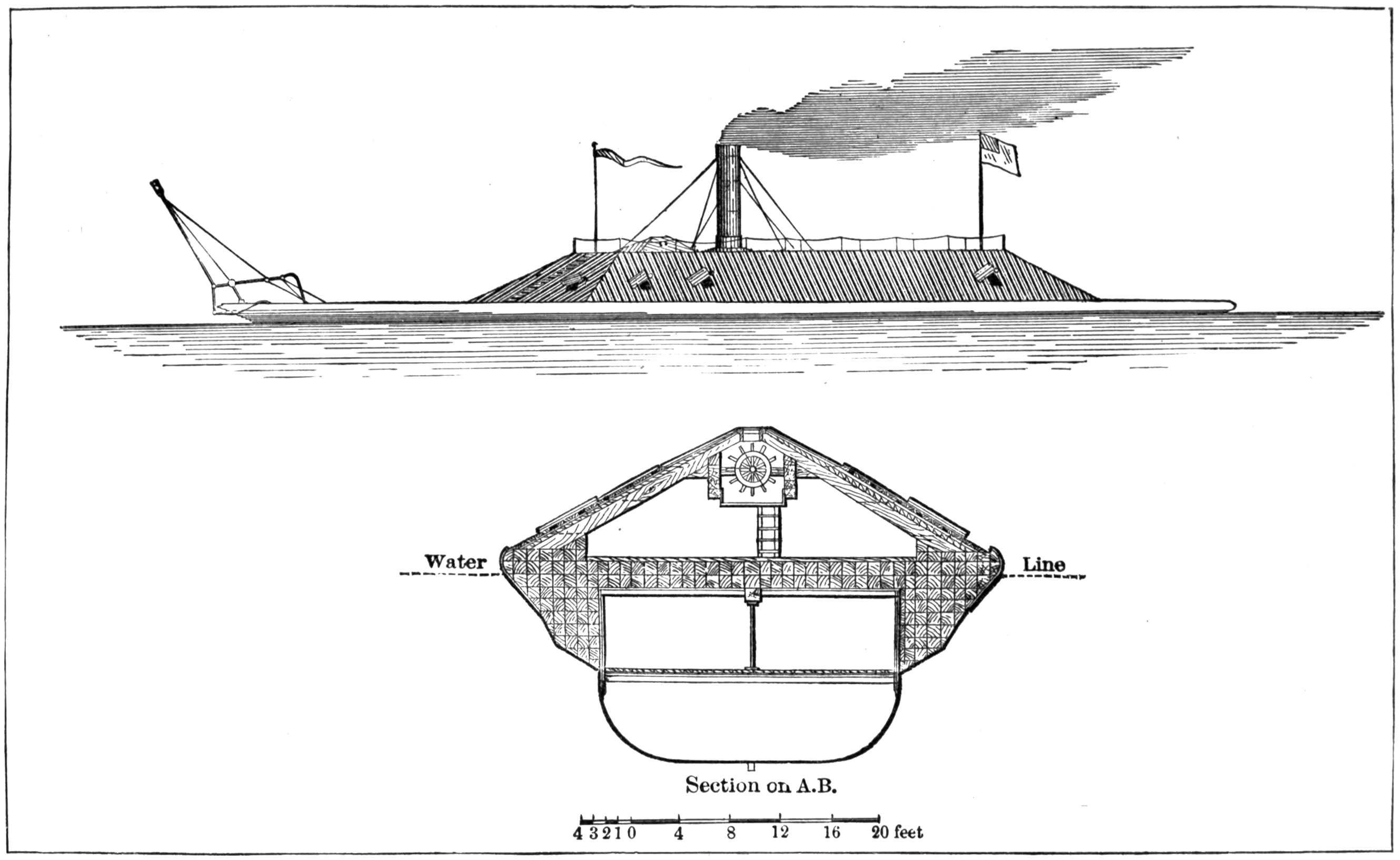
Confederate Ironclad Atlanta, Captured at Wassaw Sound, June 17, 1863.
From “The Navy in the Civil War.”
In June a couple of Dupont’s monitors had a successful fight with another Confederate ironclad. She was originally a thirteen-knot iron steamer called the Fingal, a Scotch boat. Having run the blockade at Savannah, she was cut down and decked over, and a casemate was erected in the favorite fashion of John L. Porter. But she was broadened out with solid timbers bolted outside the hull until she had sides seven feet thick at the water-line. Her armor-plates were the same488 as the Merrimac carried except that they were not of such good metal, and the wood backing of the armor was but eighteen inches thick, although the power of the fifteen-inch guns she would have to face was well known. She carried four of the excellent Brooke guns so mounted that they could fire ahead or in broadside. The speed of the ship was reduced by the weight to eight knots. She was named the Atlanta, and was commanded by Lieut. William A. Webb.
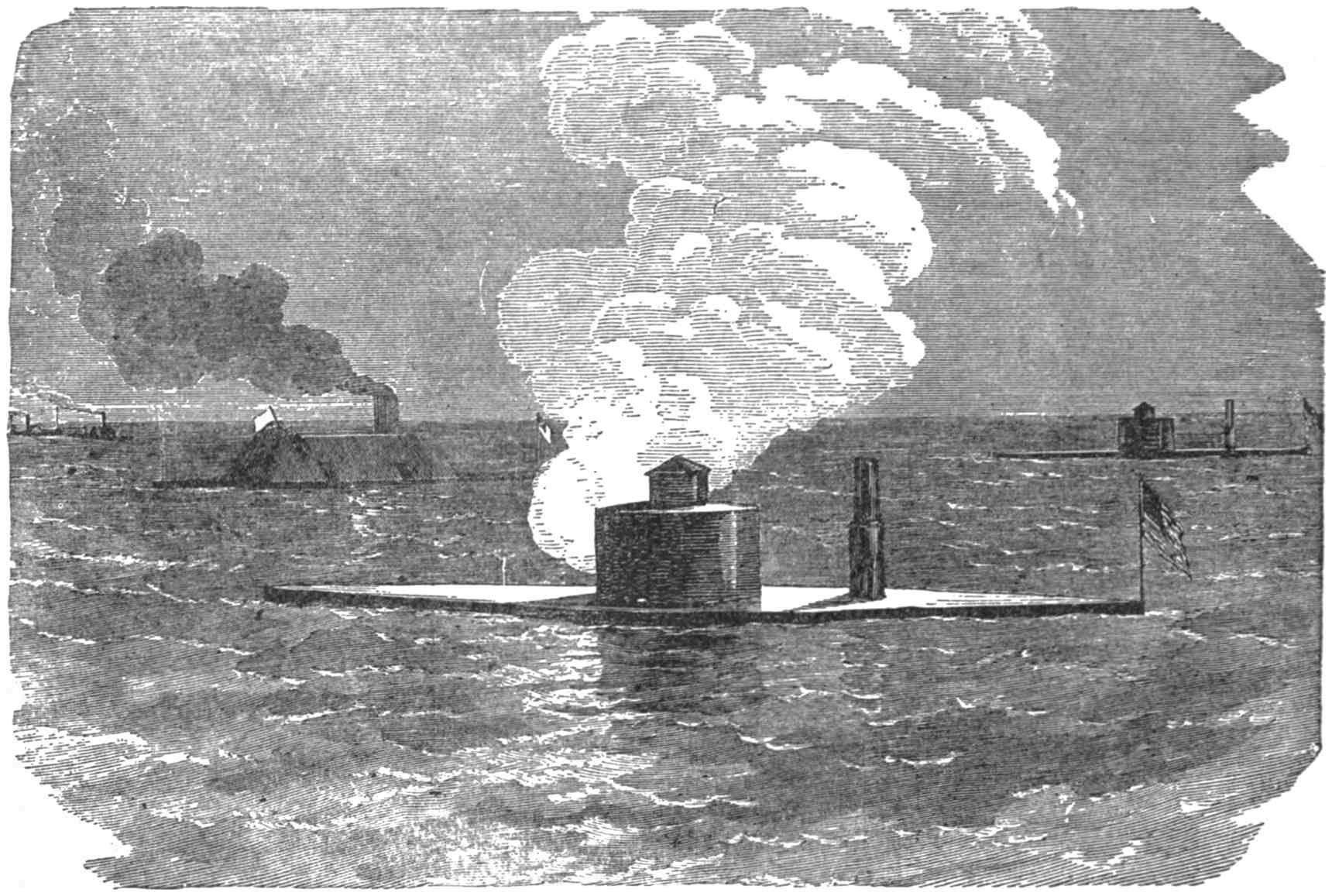
The Weehawken and the Atlanta.
From a wood-cut.
On June 17, 1863, she came down the Wilmington River, where the Weehawken and the Nahant were waiting for her. Several excursion489 steamers brought big loads of people to see her whip the monitors.
She opened fire on the Weehawken at a range of a mile and a half, and fired, in all, eight shots, of which not one hit the monitor. The Weehawken replied when at a range of 300 yards. The shot pierced the Atlanta’s casemate, and wounded sixteen men with splinters. The next shot from the monitor struck the Atlanta’s pilot-house, wounding both pilots and both wheelsmen. Three more shots were fired with less effect, but it was seen that the two monitors could shoot her to pieces, and Webb hauled down his flag. The action had lasted fifteen minutes.
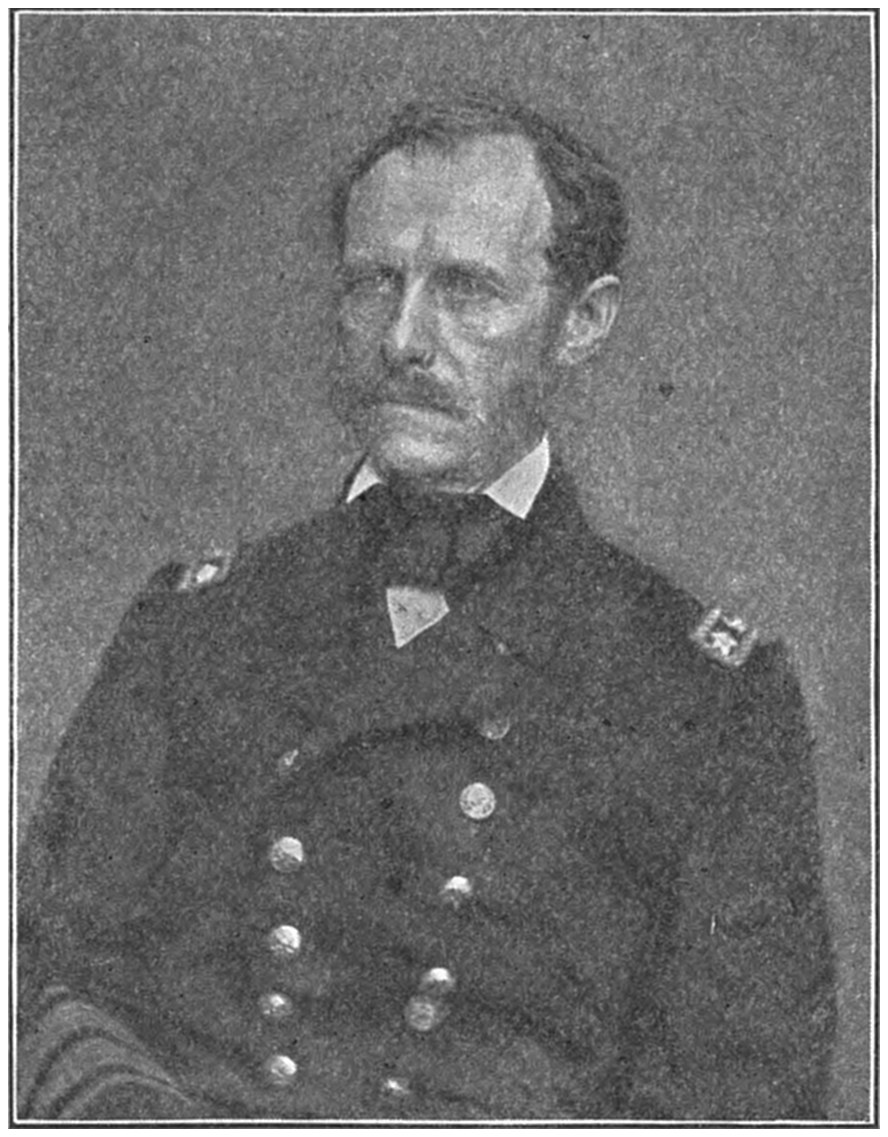
John A. B. Dahlgren.
From a photograph.
Admiral John A. B. Dahlgren, whose name is familiar as a designer of great guns, relieved Dupont on July 6, 1863. The Union forces under General Gillmore were landed on the lower end of Morris Island, and Gillmore and Dahlgren planned a combined attack on Fort490 Wagner. It was made on the 10th. “At 9.30 the monitors opened on the work. The Admiral desired to get within grape-shot range, but was not able to get closer than about 1,200 yards, by reason of shoal water. The fire was promptly and vigorously returned till noon, when the monitors dropped down to allow the men to have dinner, after which they re-occupied their position and continued firing until 6 P.M., and then withdrew, the men having been fourteen hours employed. The weather was excessively hot. Five hundred and thirty-four shell and shrapnel were fired during the day.”
There were then ten or twelve guns on the seaward side of Wagner; but as Ammen says of Dupont’s attack on Sumter, “the effect of the fire of the vessels on the fort was not so observable as that of the enemy on the vessels.” The troops were also repulsed. On August 17, 1863, Gillmore was able to open on Sumter from land batteries, and Dahlgren, with four monitors and the New Ironsides, attacked Wagner, while seven gunboats used their pivots on the fort at long range. Late in the day Dahlgren, with the Passaic and Patapsco (monitors), went within 2,000 yards of Sumter. Wagner was silenced, but Fort Gregg kept up a steady fire. Commander George W. Rodgers, a favorite in the navy,491 was killed on the Catskill in this fight. The walls of Sumter were damaged somewhat by the monitor fire.
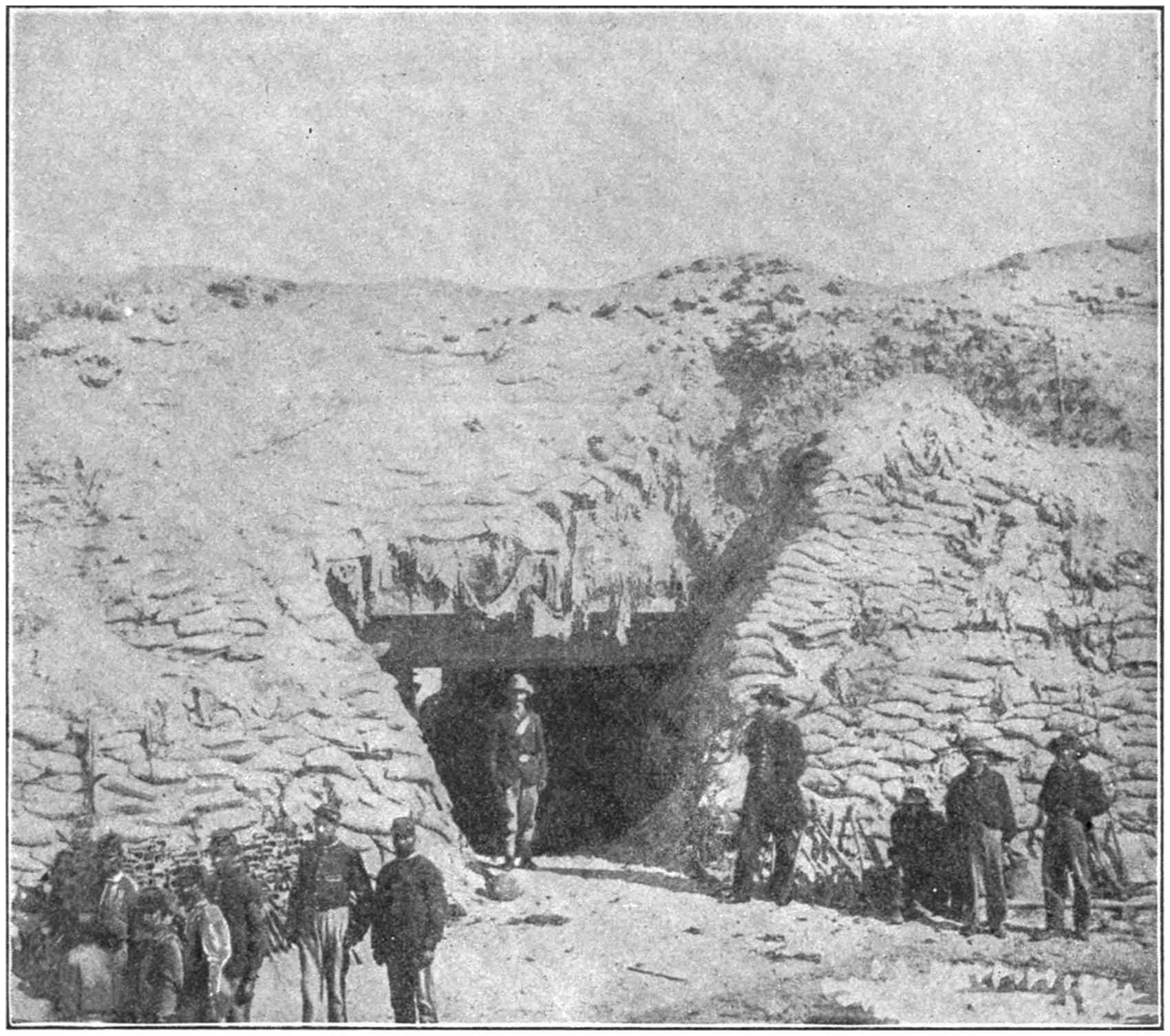
Bomb-proof of Fort Wagner.
From a photograph by Haas & Peale.
On August 23d five monitors opened on Sumter at a range of 800 yards. Dahlgren wrote to the department that morning: “I propose passing Sumter into the harbor, if the obstructions are not of such a nature as to prevent it,” and adds that “the gorge of Sumter has been completely ruined” by Union batteries on shore, of which one of four guns was492 worked by naval men. But he did not make the attempt to pass the fort, and never did.
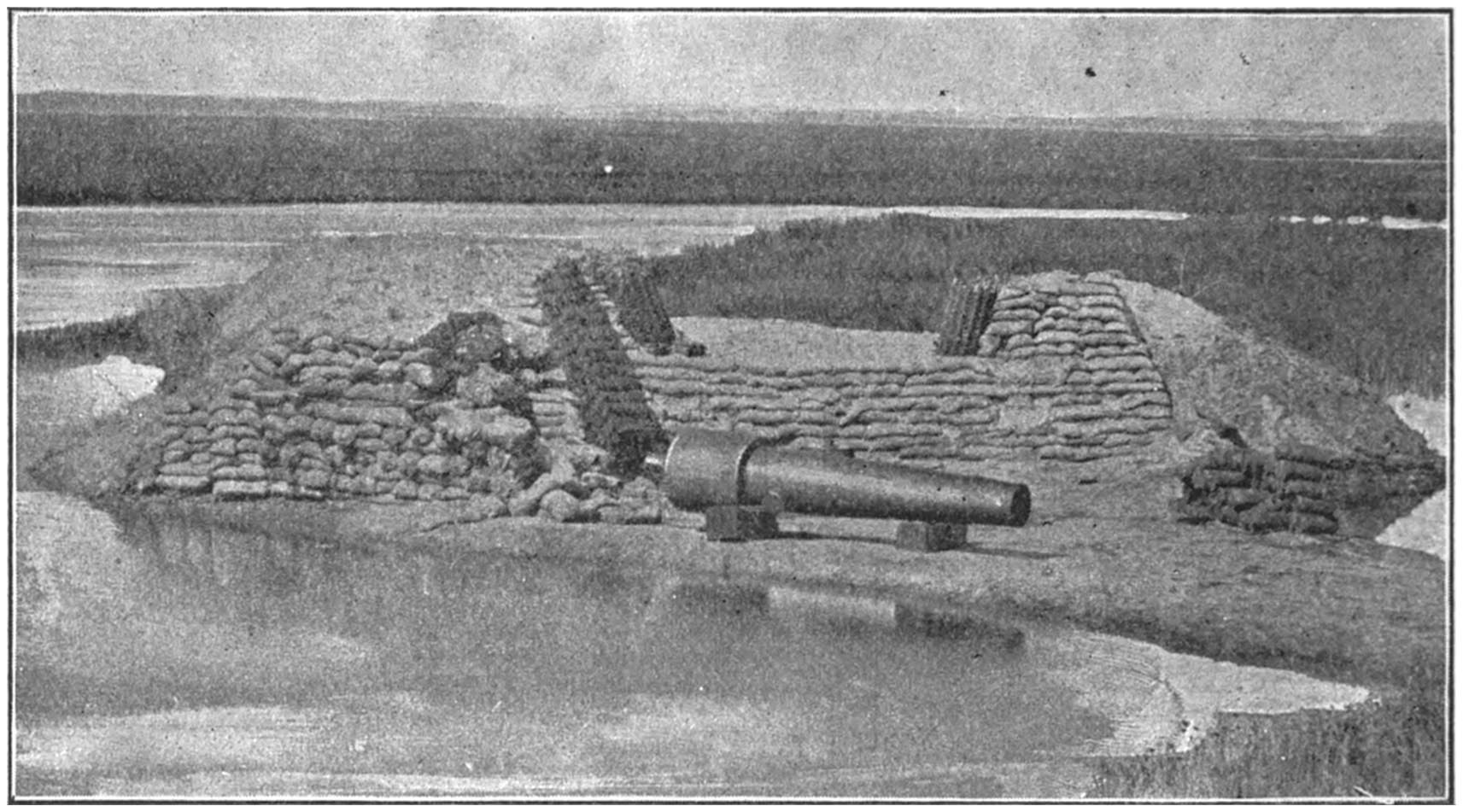
Battery Hayes: Eighteen-inch Parrott Rifle—Dismounted Breaching Battery against Sumter.
From a photograph by Haas & Peale.
Meantime Gillmore had been pushing forward the parallels—rolling waves of sand toward Fort Wagner, and the Confederates were hard pressed, but a truce for an exchange of prisoners (the Union forces did not know how badly the Confederates were pressed) gave the garrison a chance to rebuild their defences. On September 2d Dahlgren reports that the monitors were within 500 yards of Sumter during the night before. “The firing was steadily maintained.” Sumter returned two shots only. “Our fire was also directed at the floating obstructions that had been reported from day to day.” “The vessels were engaged five493 hours.” Of night attacks Beauregard, the Confederate general, said:
“This plan of attack could have been repeated every night until the walls of the fort should have crumbled under the enormous missiles which made holes two and a half feet deep in the walls, and shattered the latter in an alarming manner. I could not then have repaired during the day the damages of the night, and I am confident now, as I was then, that Fort Sumter, if thus attacked, must have been disabled.”
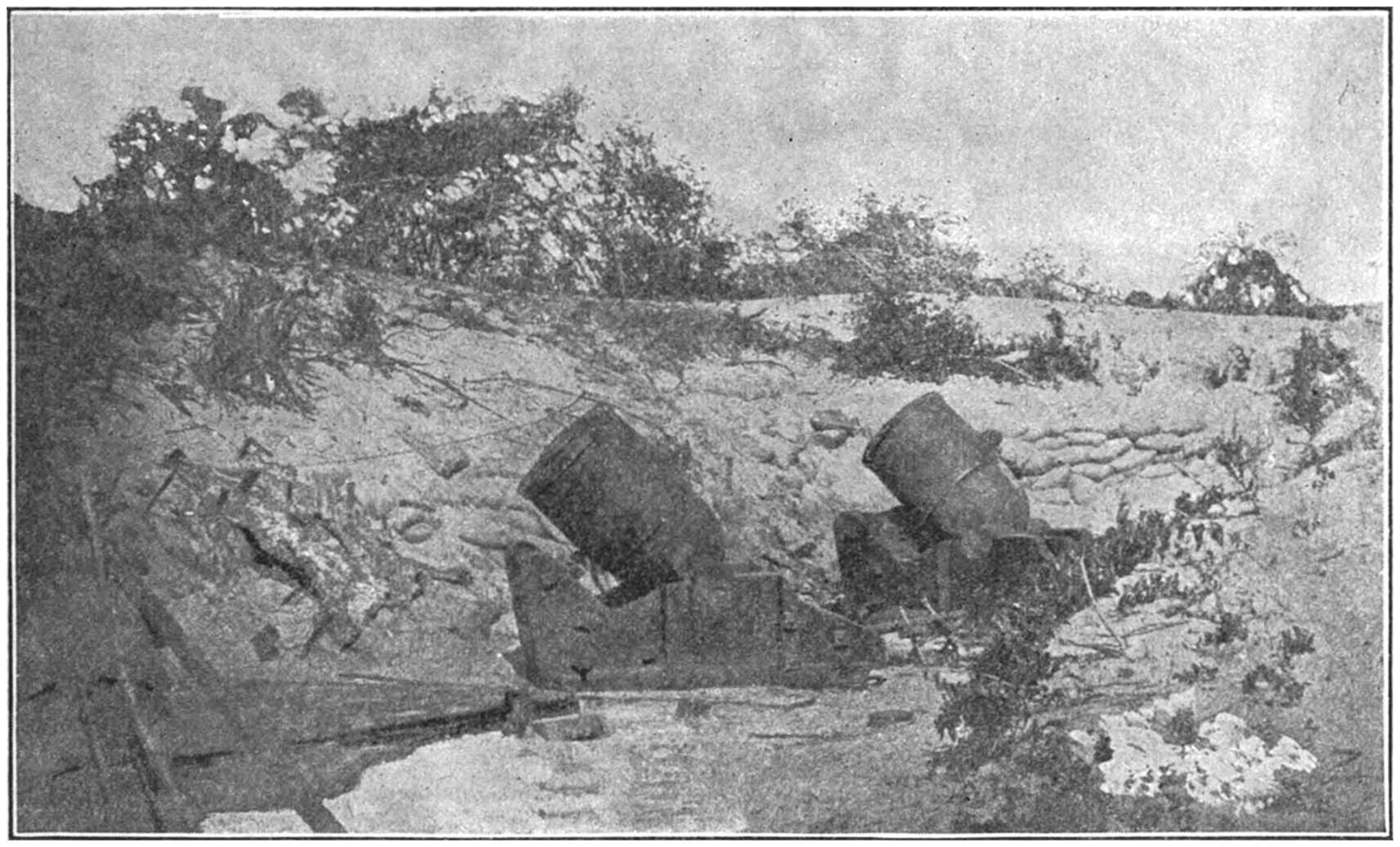
Battery Kirby: Twenty-eight-inch Seacoast Mortars against Sumter.
From a photograph by Haas & Peale.
No attempt to pass the silenced Sumter was made. In fact, Sumter was, at the last, reduced to a wreck. It became a mere infantry post. On the night of September 6th Fort494 Wagner was evacuated by the Confederates. The Union soldiers were gaining ground. The navy planned an expedition to carry Sumter by storm. Commander Thomas Holdup Stevens was placed in charge. In all, 400 men, sailors and marines, were put into small boats. But a lookout on the Confederate side was able to read the “wigwag” signals by which the orders were transmitted between the ships. So says Johnson. Of course the Confederates were ready when the force came. All who landed on the fort, including ten officers and 104 men, were taken prisoners, and three men were killed. These were the men who led. The men in the rear were able to get off. It was the most courageous deed on the Union side before Charleston. It was worthy of Farragut, who planned to take the castle at Vera Cruz, during the Mexican War, by laying the ships alongside, tricing up ladders and calling away boarders. So the Confederates were allowed to hold the wreck of the famous fort in comparative peace until Sherman, in his famous march through the Confederate States, got into the rear of Charleston, when the city and all the forts were abandoned.
Wilson’s “Ironclads in Action” has this to say of the Union naval operations against Charleston:
“Never before had ships so invulnerable495 been in action, and probably never again will so many hits be inflicted with such trivial damage and such slight loss of life. If the impenetrable monitor could do nothing against forts garrisoned by resolute men and efficiently armed, what hope of success could our Royal Sovereigns or Majesties have? Artillery has progressed so much that cannon can be mounted on land which can pierce armour thicker than any ship can hope to carry. Considerations of weight and displacement limit the protection which can be given to the ship, whilst they have no such determining influence on the fort. The ironclad’s armour and ordnance then are limited; the fort’s unlimited. How can the two fight on an equal footing? There are these further considerations, too, to be taken into account. The guns must be crowded into a limited space on board ship, where several may be silenced by a single lucky shot. In the fort a wide space can intervene between each weapon, and if properly mounted, each gun must be actually struck before it is put out of action. Then, too, the fort’s fire can be directed upon the ship’s water-line; hits here will be every whit as efficacious as upon her battery, and she can be driven off without a single one of her guns being struck. Thus a close attack by ships upon forts has become almost impossible, though it is beyond496 doubt perfectly feasible for war vessels to run through an unobstructed channel, commanded by forts however numerous.”
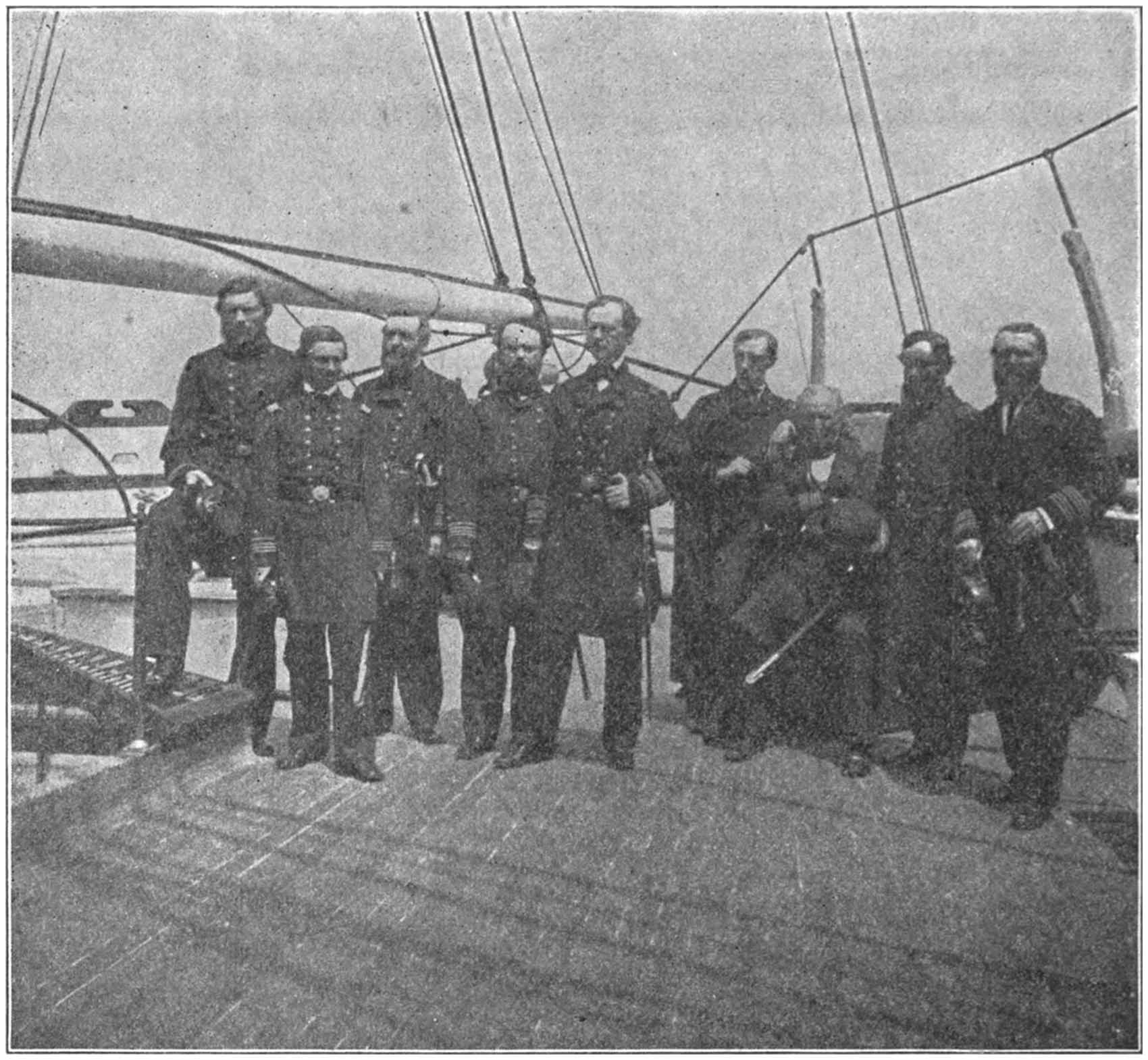
Admiral Dahlgren and Staff on the Pawnee at Charleston.
From a photograph.
However, the story of naval affairs before Charleston by no means ended with the failure of the attacks on the forts; for what the Union forces suffered at the hands of the daring Confederate torpedo-men is quite as interesting and as instructive as anything done afloat during the war.
497
The Confederates had organized a submarine torpedo corps, and the leading man of the corps at Charleston was Capt. F. D. Lee of the engineers. A part of the work done under his supervision was the building of a number of small torpedo boats now known to the world as “Davids.” Johnson, previously quoted, says of one of them:
“This boat, the first of the class known as ‘Davids,’ was built at his own expense by a citizen of Charleston, Mr. Theodore D. Stoney. He was aided in fitting it out by the counsel of Capt. F. D. Lee and Dr. St. Julien Ravenel. Having a length of about thirty feet, a diameter of five and a half feet at its middle, and ballasted so as to float deeply in the water, it was painted above the line a bluish-gray color. The torpedo, carried at its bow by a hollow iron shaft about fourteen feet ahead of the boat, was a copper cylinder charged with about 100 pounds of rifle powder, and provided with four sensitive tubes of lead containing an explosive mixture.”
Lieut. W. T. Glassell, with three men, went out on the night of October 5, 1863, and ran the torpedo against the side of the New Ironsides. It was exploded three feet under water, where the ship’s armor was three inches thick and the wood backing sufficient. No material harm was done, but the water thrown up partly498 submerged the tiny boat, and she was abandoned by all but one man, who could not swim. He held on to her, and, as she did not sink, another of her crew came to her as she drifted with the tide, and the two took her back to Charleston. Glassell and the other man were taken prisoners.
The boat was called David because, although small, she was supposed to be a match for any nautical Goliath afloat.
The partial success of this boat encouraged the Confederates to construct others. The most famous of these was built at Mobile, in 1863, by Hundley & McClintock, according to Scharf, and while there she sank, and drowned her crew. She was raised and taken to Charleston, where Beauregard put her in service. As described by the Confederate General Maury:
“She was built of boiler iron, about thirty-five feet long, and was manned by a crew of nine men, eight of whom worked the propeller by hand; the ninth steered the boat and regulated her movements below the surface of the water; she could be submerged at pleasure to any desired depth, or could be propelled on the surface. In smooth still water she could be exactly controlled, and her speed was about four knots. It was intended that she should approach any vessel lying at anchor, pass under her keel, and drag a floating torpedo, which499 would explode on striking the side or bottom of the ship attacked. She could remain submerged for half an hour without inconvenience to her crew.”
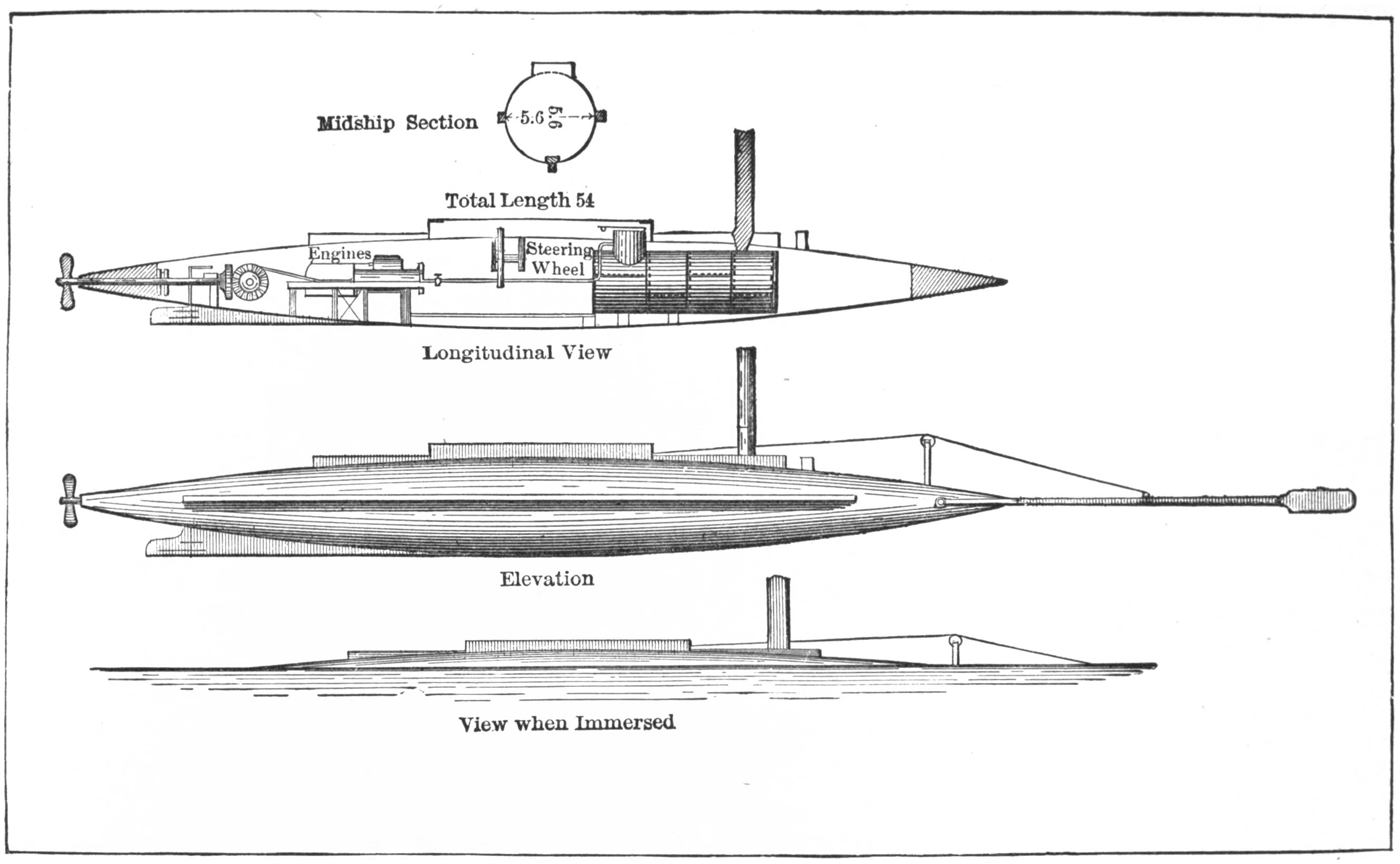
Sketch Showing Torpedo Boats as Constructed at Charleston, S. C.
From “The Navy in the Civil War.”
The story of her career in Charleston, as told by Scharf, is one of the most striking in naval warfare, for it shows the quality of the American when fully in earnest:
“Lieut. Payne, C. S. N., and a crew of eight men were preparing to take her out for action one night when she was swamped by the wash of a passing steamer and all hands except Payne were drowned. Again she was raised, and once more sunk—this time at Fort Sumter wharf, when six men were drowned, Payne and two others escaping. When she was brought to the surface, Hundley took her into the Stono River, where, after making several successful dives, she stuck her nose into the mud, and every soul on board perished by suffocation. For the fourth time she was raised, and experiments were made with her in Charleston harbor. She worked beautifully until she attempted to dive under the receiving ship Indian Chief, when she fouled a cable, and once more she proved a coffin for every man within her. Divers brought her up a week later, and Lieut. George E. Dixon, of Capt. Cothran’s Co. of the 21st Ala. Inf’y, asked permission of Gen. Beauregard to try500 her against the Housatonic, a splendid new ship-of-war, which lay in the North Channel off Beach Inlet.
“Beauregard consented, but only on the condition that she should not be used as a submarine machine, but operating on the surface of the water, and with a spar torpedo in the same manner as the David. All the thirty or more men who had met death in the ‘fish’ were volunteers, but Dixon had no difficulty in finding another volunteer crew ready to take the same risks. They were Arnold Becker, C. Simpkins, James A. Wicks, F. Collins, and —— Ridgway, all of the Confederate navy, and Capt. J. F. Carlson, of Captain Wagoner’s company of artillery.
“It was a little before nine o’clock, on the evening of February 17, 1864, when Master J. K. Crosby, officer of the deck of the Housatonic, detected the torpedo-boat, a scant hundred yards away from the ship. It looked to him, he said, ‘like a plank moving along the water,’ and before he decided to give the alarm, he had lost the seconds in which he might have saved his vessel. When he did pass the word, her cable was slipped, her engine backed and all hands called to quarters; but Dixon had closed on her and fired his torpedo on the starboard side, just forward of her mainmast. A hole was knocked in her side extending501 below her water line and she went down in four minutes. Five of the Housatonic’s people were killed by the shock or drowned; the remainder took refuge in the rigging, from which they were rescued by other vessels of the fleet. But the victory of the ‘fish’ was fatal to herself and her crew. Whether she was swamped by the column of water thrown up by the explosion, or was carried down by the suction of the sinking Housatonic, will never be known; but she went under never to rise again, and the lives of all on board were sacrificed.”
All the current histories of the war say that this David was found after the war on the bottom, within a hundred yards of the wreck of the Housatonic, but Johnson says the story is not confirmed. But that the men gave their lives to accomplish the work is certain.
This chapter may very well close with the story of a brave colored man, a Charleston harbor pilot, named Robert Small, at that time a slave. He was employed on the Confederate transport steamer Planter. On the morning of May 13, 1862, Small made one of the most remarkable dashes for liberty known to history. The Planter was lying at the pier, near army headquarters. The captain having gone on shore, Small, from the pilot-house, directed the lines holding her to the pier cast off, and it was done. He then headed out to sea, with502 the Confederate flag flying above her taffrail. As he passed Sumter and the other forts, he saluted them with three long blasts of the whistle in the usual fashion, and they dipped their flags in return. His boldness saved him from suspicion, and when beyond the line of fire he hauled down the Confederate flag, sent up a white one, and gave the ship to the Union forces.
503
IT WAS ONE OF THE BEST WORKS IN THE SOUTH, THOUGH NOT WELL LOCATED—BUTLER’S POWDER-BOAT SCHEME, AND WHAT HE EXPECTED TO ACCOMPLISH BY IT—THROWING 15,000 SHELLS AT THE FORT DISABLED EIGHT GREAT GUNS OUT OF A TOTAL OF THIRTY-EIGHT—BUTLER THOUGHT THE FORT STILL TOO STRONG AND WOULD NOT TRY—HE DID NOT EVEN MAKE INTRENCHMENTS ACCORDING TO ORDERS—GEN. A. H. TERRY, WITH 6,000 SOLDIERS AND 2,000 FROM THE SHIPS, EASILY TOOK THE FORT THREE WEEKS LATER—THE NAVY’S LAST FIGHT IN THE CIVIL WAR.
The last of the expeditions of the navy in the Civil War, and the greatest in the number and force of the ships and men, was that sent to capture Fort Fisher, guarding the entrance to Cape Fear River, on which Wilmington, North Carolina, stands. The preparations for this expedition began in the fall of 1864, and one cannot help wondering that no determined effort was made to capture the port early in the war, for, because of its situation and the peculiar nature of the entrances to the mouth of the river, it was the favorite resort of the blockade-runners, and therefore the chief source from which the Confederates drew their504 foreign supplies. “From it Lee’s army in front of Richmond was kept supplied, and the great Confederate commander had plainly informed Colonel Lamb, the officer in charge of Fort Fisher, that the Confederates must505 fall back from before Richmond, through inability to procure food, if the port was lost.”
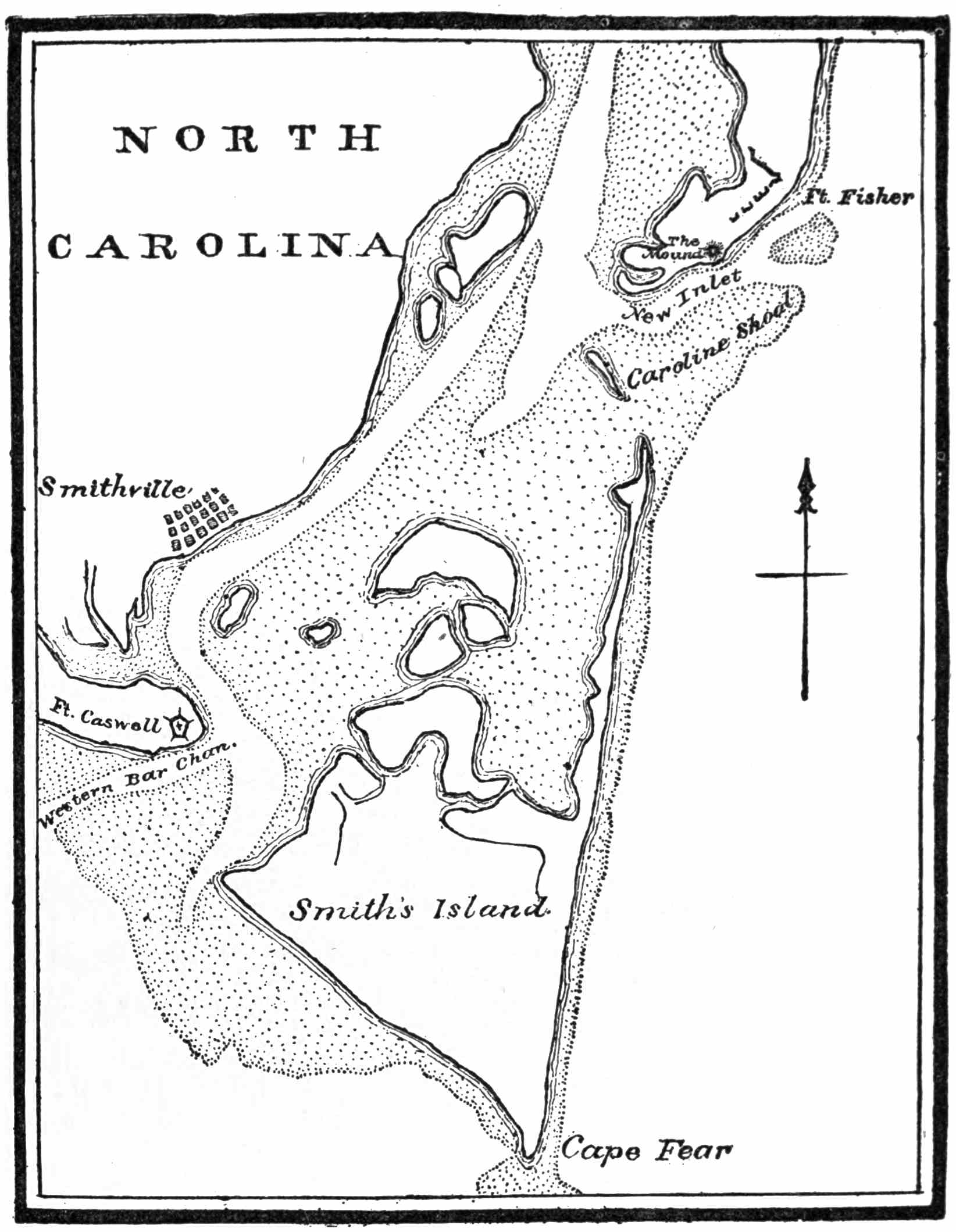
The Entrance to Cape Fear River, Showing Fort Fisher.
From “The Navy in the Civil War.”
Fort Fisher was planned early in the war, and no fort built by the Confederates received greater care. A look at the chart will show that a long arm of land comes down from the north between the river and the sea—an arm that at last is split like the claw of a lobster into two fingers. One, very fat, and extending in toward the channel of the river, is called Federal Point, and the other, very slender, continues the coast line to what is called New Inlet. A shoal body of water called the basin lies between the two fingers. Fort Fisher was erected right where the two fingers split apart—right on the wrist.
Beginning a few yards back from the beach and north of the split of the fingers, the Confederates erected a mound of sand eighty feet high. On this they mounted an eight-inch (150-pounder) rifle and a ten-inch medium-length (columbiad) shell gun. From this mound a series of connected batteries or earthworks, of the most approved form, extended away to the north for about 1,400 yards. In this stretch were mounted seventeen great guns, including rifles from four and a half inches up to seven inches, with a number of ten-inch smooth-bore shell guns. In height and thickness these batteries were all that507 could be wished in that day, and there were immense traverses (big mounds of sand) between the guns to protect the gun crews from an enfilading fire and from shells bursting on either side of them. At the north end of the north-and-south line so far described, the wall of the fort turned at a right angle toward the west. This part of the wall extending to the west was about 500 yards long, and it crossed the arm of dry land to the swamps of the river. Looking from the north, the whole fort was a very good L. The east-and-west arm mounted twenty-one great guns, and these were, for the most part, placed to defend the garrison from a land attack.
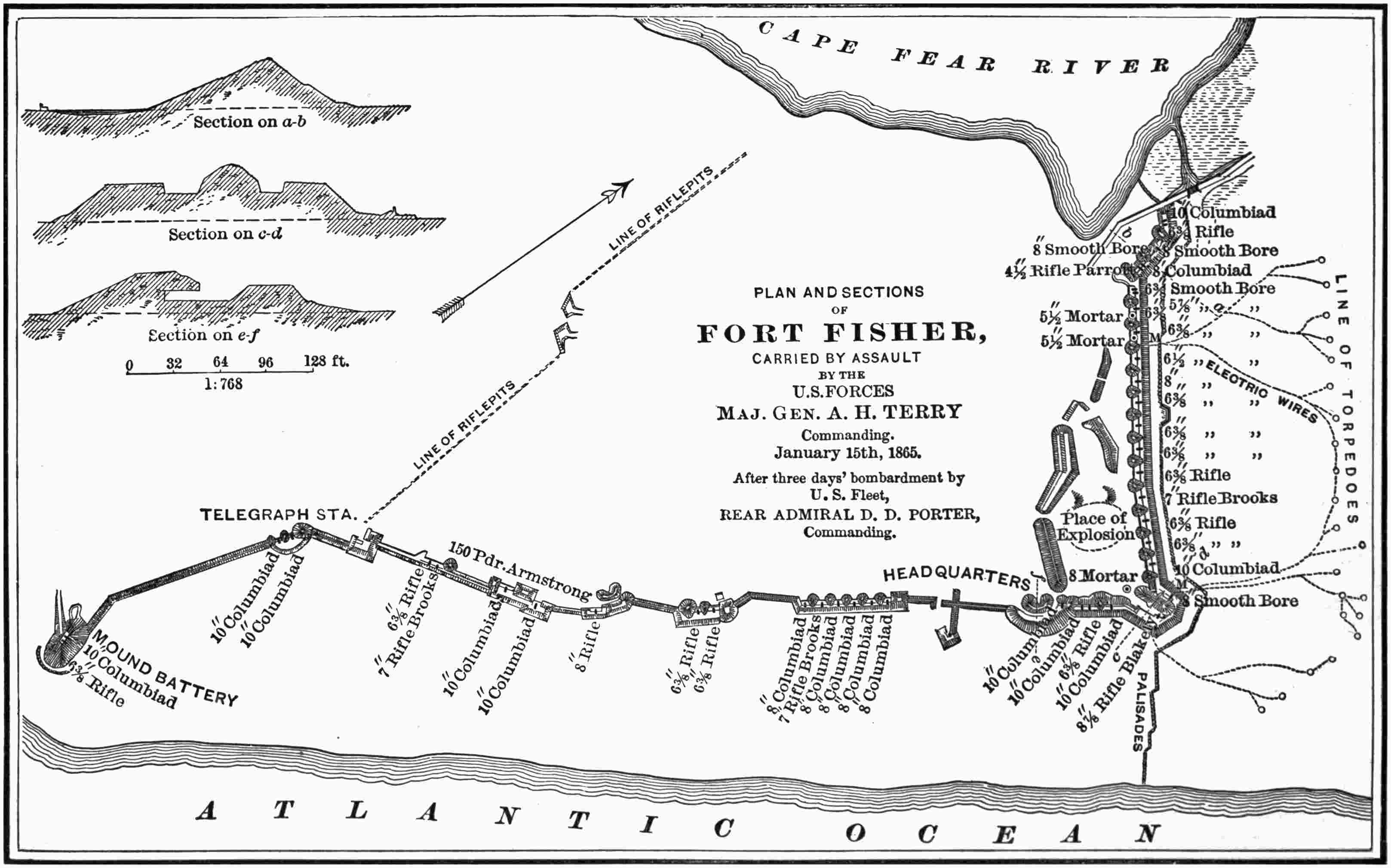
PLAN AND SECTIONS
OF
FORT FISHER
CARRIED BY ASSAULT
BY THE
U.S. FORCES
Maj. Gen. A. H. TERRY
Commanding.
January 15th, 1865.
After three days’ bombardment by
U. S. Fleet
REAR ADMIRAL D. D. PORTER,
Commanding.
From “The Navy in the Civil War.”
It was plain that the Confederates erected this huge structure to keep the Federal forces from entering Cape Fear River by the way of New Inlet. As a matter of fact, it was, in the judgment of engineers, built too near to the sea. The inlet was shoal at best. Only the lightest of vessels could enter it. Had Fort Fisher been erected back from the sea, where it would have been out of range of the deep-draft Union ships, a different story would have been told of it in history. As it was, Col. William Lamb, commanding it, gave a right good account of himself.
When an attack was at last planned by the Union forces, a very grave error was made in508 placing Benjamin F. Butler at the head of the army forces after Admiral David D. Porter had been assigned to command the naval part of the expedition. This is not to disparage the talents of either man. It is said because the two leaders heartily disliked each other. It was therefore utterly impossible for them to coöperate.
Ships and transports were assembled at Hampton Roads in September, but the publicity given to the destination of the expedition caused a postponement until December. In the meantime Butler had conceived an idea, and in order not to be unfair his exact words, from page 775 of “Butler’s Book,” are given. He says:
“In that time, after hearing of the great destruction for many miles around made by an explosion of gunpowder at Erith, England, I made an examination into the various instances of the explosive effect of large quantities of powder; and I believed that possibly, by bringing within four or five hundred yards of Fort Fisher a large mass of explosives, and firing the whole in every part at the same moment—for it was the essence of the experiment to have the powder all exploded at the same instant—the garrison would at least be so far paralyzed as to enable, by a prompt landing of men, a seizure of the fort.”
509
The reader is requested to note that he says “within four or five hundred yards of Fort Fisher.” His idea was submitted to the Administration and approved, although Mr. Lincoln accepted it “with more caution” than the others. Admiral Porter accepted it because “it was considered advisable to try almost any expedient.” When it came to details, Butler says on page 800 of his book: “My proposition to the Navy Department contemplated using but one hundred tons of powder ... that this one hundred tons of powder should be put into a light-draught steamer, and arranged and packed in such a way that either by electrical or other apparatus fire could be communicated all through the vessel into every part of the mass of powder at one and nearly the same instant; that that vessel should be run ashore; that time fuses or other means of calculating the time necessary for the explosion should be put in operation, and that with the vessel hard and fast on shore so that none of the powder substantially could go down into the water until it had time to take fire, the whole mass should explode. The effect that I expected from that was that the gases from the burning powder would so disturb the air as to render it impossible for men to breathe within two hundred yards; that the magazines of the fort would be burst in and possibly the510 magazines themselves be exploded; that by the enormous missiles that would be set in motion and by the concussion many men would be killed, and if the explosion were to be followed immediately by an attack of even a small number of effective men, the fort could be captured.”
Accordingly, an old and worthless steamer, the Louisiana, was fitted for the purpose. Instead of 100 tons, 215 tons of powder were put on board. Part of it was not of full power, but nearly 200 tons of the best was stowed in the ship. The work of preparing her delayed the expedition some days, and it was valuable time. However, the expedition finally arrived on the coast, Butler, with his transports, at Masonboro’ Inlet, twenty-five miles up the beach from Fort Fisher, and Porter out at sea, twenty-five miles from the fort. The transports had water and coal for but ten days, but there were delays due partly to weather and partly to the ill feeling between the commanders, and eventually Butler, with most of his transports, went away to Beaufort to take on water for the troops.
Favorable (smooth-water) weather was had on the night of December 23, 1864, and the powder-boat Louisiana was sent in. She was in charge of Commander A. C. Rhind, who had with him Lieut. S. W. Preston, Engineer511 A. T. E. Mullen, Master’s Mate Boyden, and seven men. The tug Wilderness towed the Louisiana in toward the fort near the north end of the sea-front until the water was fifteen feet deep, when the Louisiana cast off the line and proceeded under her own steam until she was in nine feet of water, when she was anchored. She was then 300 yards or less from the fort. Butler says she should have been beached, although he also says (see ante) 400 or 500 yards was near enough. Captain Rhind says he did not beach her because she would have been strained on the sand, and was likely to open a seam and let in the water and spoil the experiment. Clocks had been arranged to drop weights on explosive mixtures, and these were now set. Then a fire was built in the shaft tunnel in the stern to make sure that she exploded if the clocks failed, after which Rhind and his men returned to the tug. It was then exactly midnight. The tug ran twelve miles out to sea and stopped to watch the explosion. It took place at 1.40 o’clock, and amounted to absolutely nothing.
An army engineer found the wreck of a blockade-runner, called the Condor, 800 or 900 yards from the fort, assumed that it was the wreck of the Louisiana, and so reported. This report was used to discredit Commander Rhind. It seems, on the face of it, to have been a fraud,512 for the army officer should have known that nothing would remain of the Louisiana after such an explosion. But if so much had remained, what became of Butler’s theory?
The idea that exploding any possible mass of gunpowder in the open air outside of such a fort could hurt any one or anything inside was simply childish. But Butler never ceased to argue that it ought to have been a tremendous success. And it is a most sorrowful fact that, because of Butler’s political influence, the magnificent bravery of the powder-boat’s crew was never in any public manner recognized.
The next day, December 24, 1864, the warships steamed in and anchored at fair range, with the ironclads in one line and the wooden ships some distance outside. They bombarded the fort from 11.30 A.M. until sunset. At night Butler, with a part of his transports, came from Beaufort, and next morning the others arrived. It was arranged to land the troops, undercover of the gunboats, at a point two miles up the beach from the fort. Butler’s orders were to make an assault, if that were deemed feasible, but if not, he was to throw up intrenchments and lay siege to the fort in the usual fashion. Soundings were made in the morning, a more effective line of fire was planned, and, late in the forenoon, the fleet steamed in and once513 more opened fire. This was on December 25, 1864.
Nearly 3,000 troops were landed, with General Weitzel in command. They captured a couple of little outworks three miles north of the landing place, and then advanced with skirmishers. One of the skirmishers captured a flag from one point on the parapet, and another passed through the sally-port, bayoneted a man on a horse inside, and captured the horse. Weitzel says (see “Butler’s Book”) that he was within 600 yards of the fort, and from a sand-dune examined the work carefully. Butler ran down the beach in a shoal-draft transport, and at a range of 500 yards, as he says, looked at the fort for himself. He continues: “I there met General Weitzel returning from a reconnoissance. He stated to me that he had been out to the front line, and had seen Fort Fisher. As a defensive work the fort was uninjured.” He continues: “I said to Colonel Comstock, who was on board with me [Butler did not land], ‘jump into a boat with General Weitzel, pull ashore and examine with him and report to me if an assault is feasible; to me it does not look so, but I am unwilling to give it up.’” This is from “Butler’s Book,” page 794. Being so primed by Butler, Comstock reported an assault not feasible, and Butler wrote to Admiral Porter that night as follows:
514
“Upon landing the troops and making a thorough reconnoissance of Fort Fisher, both General Weitzel and myself are fully of the opinion that the place could not be carried by assault, as it was left substantially uninjured as a defensive work by the navy fire. We found seventeen guns protected by traverses, two only of which were dismounted, bearing up the beach, and covering a strip of land, the only practicable route, not more than wide enough for a thousand men in line of battle.... I shall therefore sail for Hampton Roads as soon as the transport fleet can be got in order.”
By Confederate reports it appears that the fort was garrisoned by “900 veterans, sixty C. S. N. sailors and marines and 450 junior reserves between sixteen and eighteen years of age.” On December 24th three guns had been disabled in the fort, and on the 25th five others were disabled. Two more had exploded. Including howitzers, the fort had left thirty-four guns, of which twenty pointed up the beach toward an assaulting column. There were also some torpedoes planted in the sand, and a very good line of palisades “made of heavy timber pointed on top.” But for the delay due to the wild powder-boat scheme, the Confederates would have been caught with only 667 men in the fort, according to General Whiting, who commanded the515 Confederate forces of the Wilmington district. Whiting wrote that he believed an assault on Christmas day would have failed. In his official report he said of the fort: “The delay due to the heavy weather of Wednesday and Thursday after the arrival of the fleet was its salvation.”
With these facts in mind, a student of history may find the following words in Admiral Porter’s report of December 27, 1864 (see Report Sec. Navy, 1865, p. 51): “My despatch of yesterday will scarcely give you an idea of my disappointment at the conduct of the army authorities in not attempting to take possession of the forts which had been so completely silenced by our guns; they were so blown up, burst up and torn up that the people inside had no intention of fighting any longer.”
Certainly this is not true. Porter guessed at the facts. The Confederate officers (see Scharf) had to use the flat of their swords to get some of the reserves out to man the parapet, but they had a force of nearly 1,000 that would have made a fight. But if Butler had been as anxious to carry the fort by assault as he was to report a failure on the part of Admiral Porter, he would have carried the fort inside of an hour with even the partial force he had landed. Moreover, when he said the beach was “the only practicable route” for516 an assaulting party, he was mistaken, for General Terry, three weeks later, found a much safer route “under the river bank.” It is an interesting fact that Butler in his book does not attempt any explanation of his lack of knowledge, when before the fort, of the river-bank route.
Thomas E. Taylor, a noted blockade-runner, who has printed a book on his experiences, was in Richmond in consultation with the Confederate chiefs at the time of this assault, and wrote the following in a letter to his employers regarding the matter: “They nearly had Fort Fisher; they were within sixty yards of it—and had they pushed on as they ought to have done, could have taken it. It was a terrific bombardment.”
Anyway, Butler did not even throw up intrenchments. He abandoned the enterprise altogether.
However, the operations against the fort were only suspended. Admiral Porter filled up his ships with ammunition. On January 13, 1865, Gen. Alfred H. Terry landed with 6,000 men. The ships anchored with the monitors at a range of half a mile, and the others outside at three-quarters of a mile (in some cases further), and a storm of bursting shells poured over the fort. It lasted all that day, was continued at intervals during the night519 and all the next day. The fort replied slowly, partly because ammunition was scarce and partly because of the effect of the Union fire.
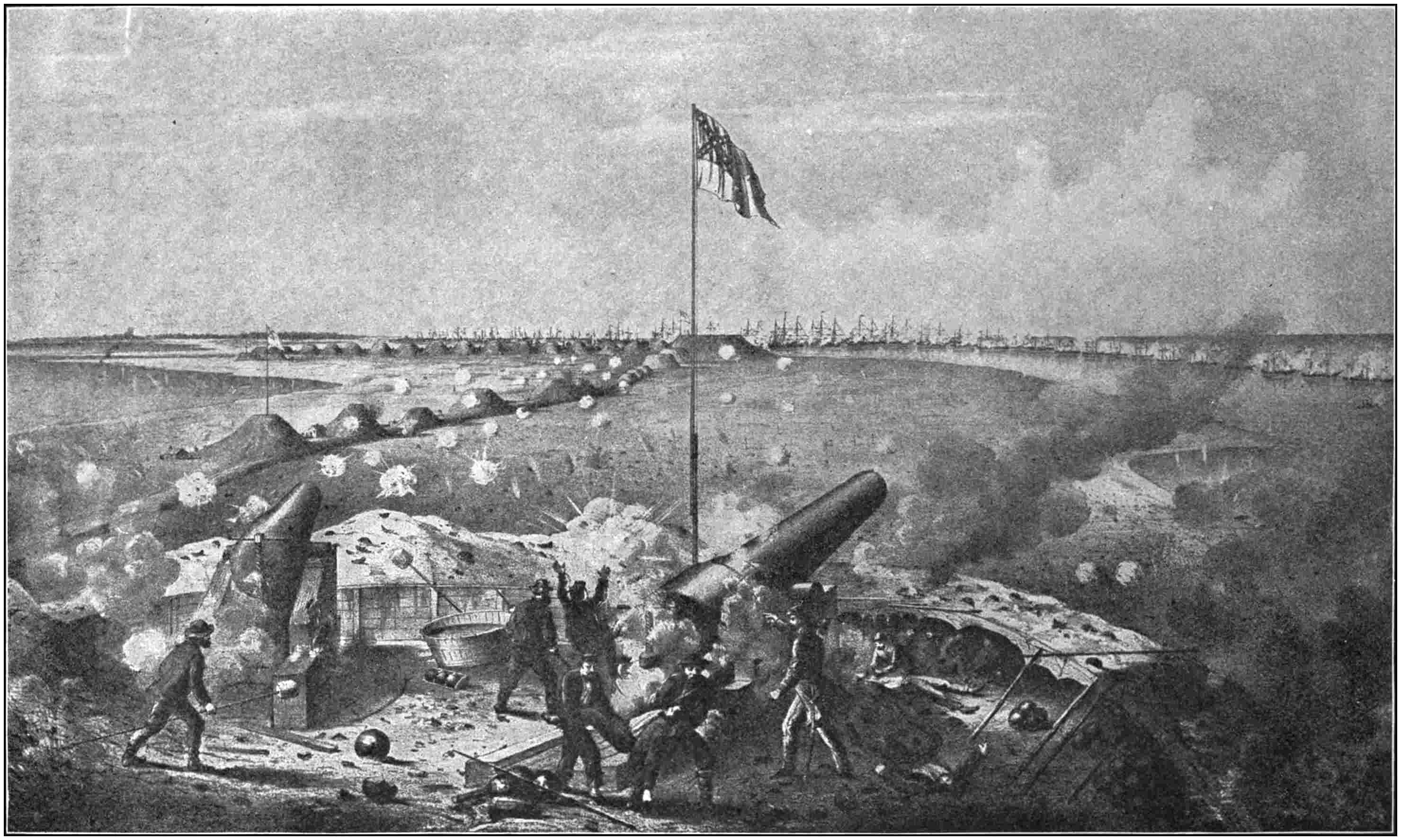
The Bombardment of Fort Fisher.
From a lithograph.
That night an assault was planned, and 1,600 sailors and 400 marines were landed to help the soldiers. At 9 o’clock on the morning of January 15, 1865, the fleet once more opened fire. The soldiers, who had been lying at the river side of the arm of land, charged up to attack the extreme west end of the fort. The sea force, in three divisions, led by Cushing (he who destroyed the Albemarle), Lieut.-commander James Parker, and Lieut.-commander T. O. Selfredge, Jr., charged up the barren beach, where Butler did not dare to go, to attack the sea front. They had the post of greatest danger, for they were wholly uncovered.
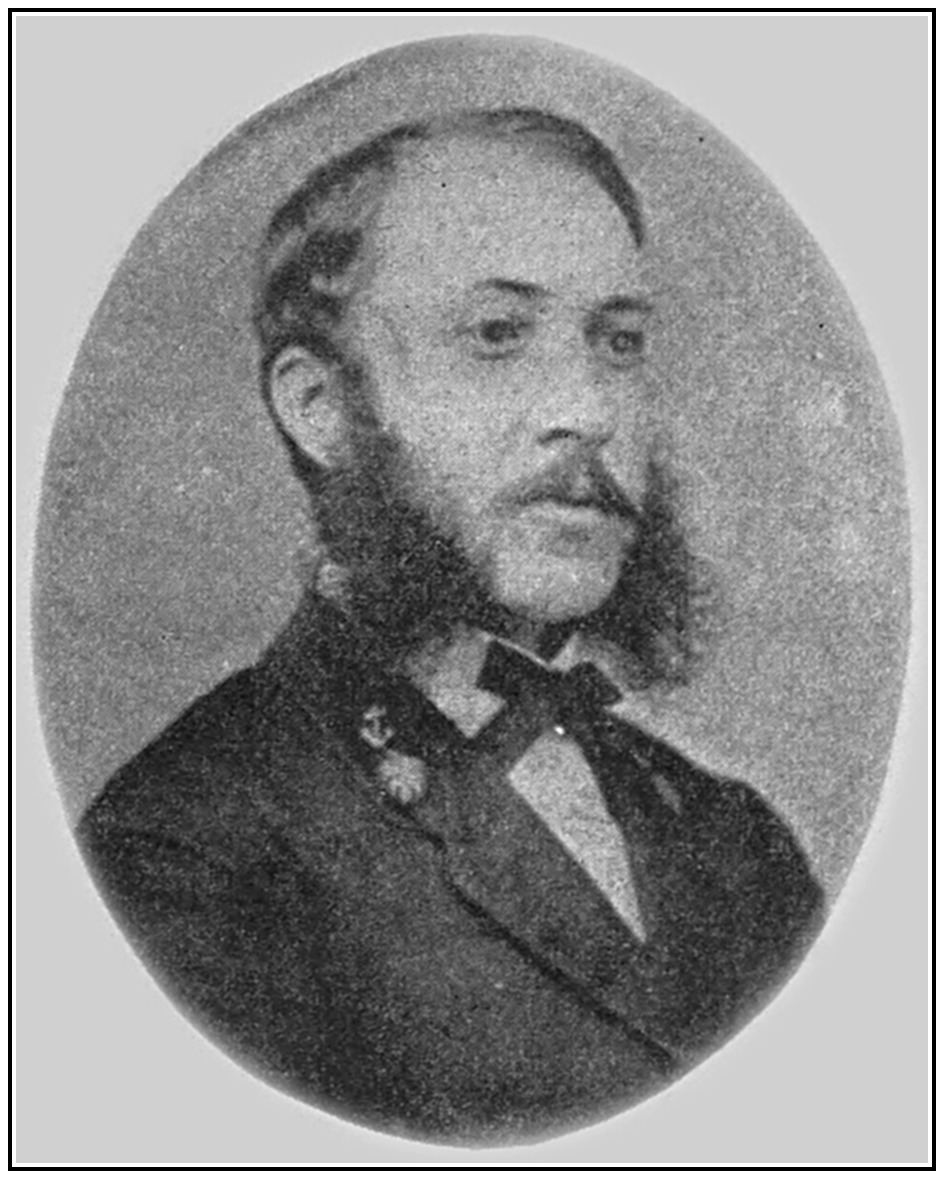
T. O. Selfredge.
From a photograph owned by Mr. C. B. Hall.
“The attacking column of the army was hid and protected by the river bank as it approached520 the left flank of the work, but the naval column came up the open beach upon our center. As its success would have been disastrous, I concentrated all available guns upon this column, and met its assault with the larger portion of my men, posting them upon the ramparts so as to fire down upon the sailors and marines.” The quotation is from a letter by Colonel Lamb, commanding the fort.
Some of the sea force reached the row of palisades, and there found shelter, but when eighty-two had been killed and 269 wounded, the others broke and fled out of range. They were armed (except the marines) with cutlasses and revolvers only. It was not a good place for boarders. Nevertheless, this assault was not in vain, as W. R. Mayo, one of the Confederate officers in the fort, testifies in Scharf’s work. He says:
“Though proving a great failure in itself, this assault occupied the nearly worn-out and depleted garrison, and had the direct result of admitting the army to the ramparts of the disabled land face of the fort before attention could be given to the assaulting column in that direction.”
There were forty-two ships in the line bombarding Fort Fisher on January 15, 1865, of which six were ironclads—five monitors and the New Ironsides. The total number killed522 afloat during the three days of fighting was seventy-four, and 289 were wounded. Ammen estimates from the reports in the department that 21,716 shells were thrown at the fort. In the first attack 15,000 were thrown.
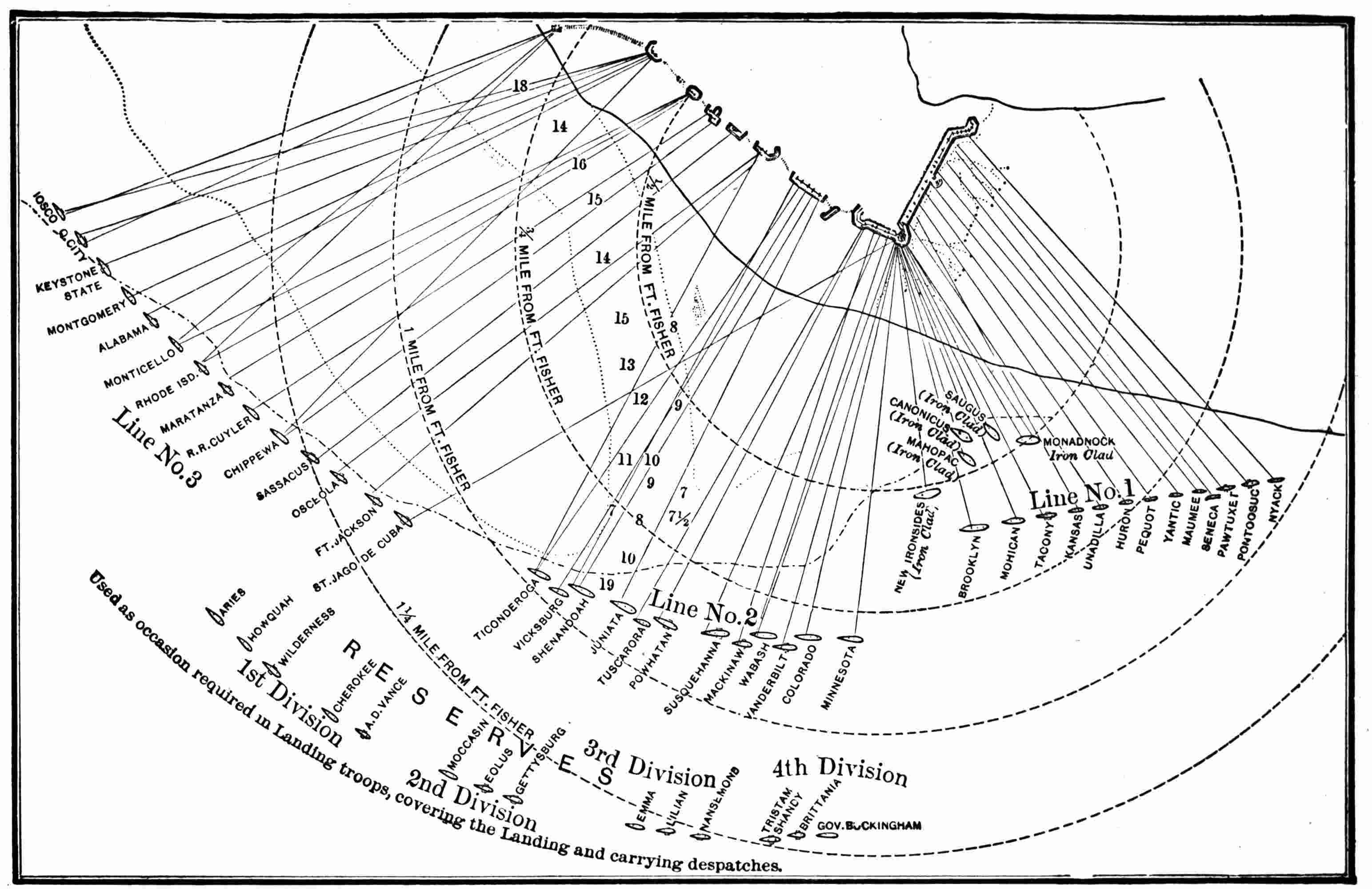
Second Attack upon Fort Fisher by the U. S. Navy, under Rear-admiral D. D. Porter, January 13, 14, 15, 1865.
Scharf has this to say of the capture of Fort Fisher:
“The fall of Wilmington was the severest blow to the Confederate cause which it could receive from the loss of any port. It was far more injurious than the capture of Charleston, and, but for the moral effect, even more hurtful than the evacuation of Richmond. With Wilmington and the Cape Fear River open, the supplies that reached the Confederate armies would have enabled them to have maintained an unequal contest for years, but with the fall of Fort Fisher the constant stream of supplies was effectually cut off and the blockade made truly effective—not by the navy fleet, but by its captures on land.”
The other forts about the river soon fell into government hands. The Civil War was already drawing to a close before the assault was made. It was a question only of how many days the able and determined men of the South would struggle against overwhelming numbers. The fall of Fort Fisher was therefore fortunate for both sides. It the sooner brought a hopeless fight to an end.
523
THE FOLLY OF ALLOWING OTHER NATIONS TO EXPERIMENT FOR US—IN SPITE OF WHAT WE LEARNED FROM THEIR MISTAKES, WE WERE UNABLE, WHEN WE FIRST BEGAN FOR OURSELVES, TO BUILD EVEN A FIRST-CLASS CRUISER—THE RESULT OF TEN YEARS OF EARNEST WORK—BATTLE-SHIPS WHOSE POWER IS CONCEDED BY FOREIGN WRITERS—CRUISERS THAT AWAKENED THE PRIDE OF THE NATION—THREE “NEWFANGLED NOTIONS”—A YANKEE ADMIRAL AT RIO JANEIRO AND A YANKEE LIEUTENANT ON THE COAST OF MEXICO—THE ONE IMPORTANT FACT ABOUT THE NEW NAVY.
The naval history of the United States during the period since the Civil War has been not a little like that of the period following the War of the Revolution. When the Civil War was ended and the acute complication with our over-sea neighbors during 1865 was past, we sold off our ships as a merchant disposes of his shelf-worn goods. It is true we did not sell every ship as we did in 1785, but in 1885 we were relatively in as helpless a condition as, and actually in a more shameful condition than, we were when we had not a ship that belonged to the nation; for the wooden hulks on the naval list in 1885526 and their smooth-bore Dahlgren shell guns were, for the purpose of carrying the flag in the face of an enemy having ironclads and rifles, absolutely useless. And as to the shame of it, we know that in 1785 the nation was poor, and even the few dollars needed to keep a frigate or two in commission seemed a large sum, while the nation in the later years, when the navy was neglected, was spending enough money in dredging out commerceless channels to have built squadrons of several times the needed force. It is the usual thing for writers who refer to that period to say, because we slipped through it without a more serious foreign complication than the murder of a few American citizens by the Spanish government at Santiago de Cuba, in 1873, it was really to our advantage that we built no ships. The European governments were experimenting at great cost, and we were saved all of that. We got the benefit of their experience and saved the dollars. But the fact is we could not and did not benefit by their experience to any degree worth serious consideration. Neither the individual man nor the aggregation of men called a nation can take advantage of the apprenticeship which another man or nation has served. I do not hope to have this statement believed by people to whom the only fruition of labor and life is a dollar. But there are527 some who understand that national character, like individual character, is of more importance than dollars; that the very chuckling over the dollars we saved “while other nations were experimenting for us” is contemptible; that, to take another and more material point of view, what we lost in the development of the brains of our mechanics and inventors by letting the other nations do the “experimenting for us” was of infinitely greater value than the whole revenue of the nation. It is not the loss of a product of ships that is to be deplored, but the loss of a product of men.
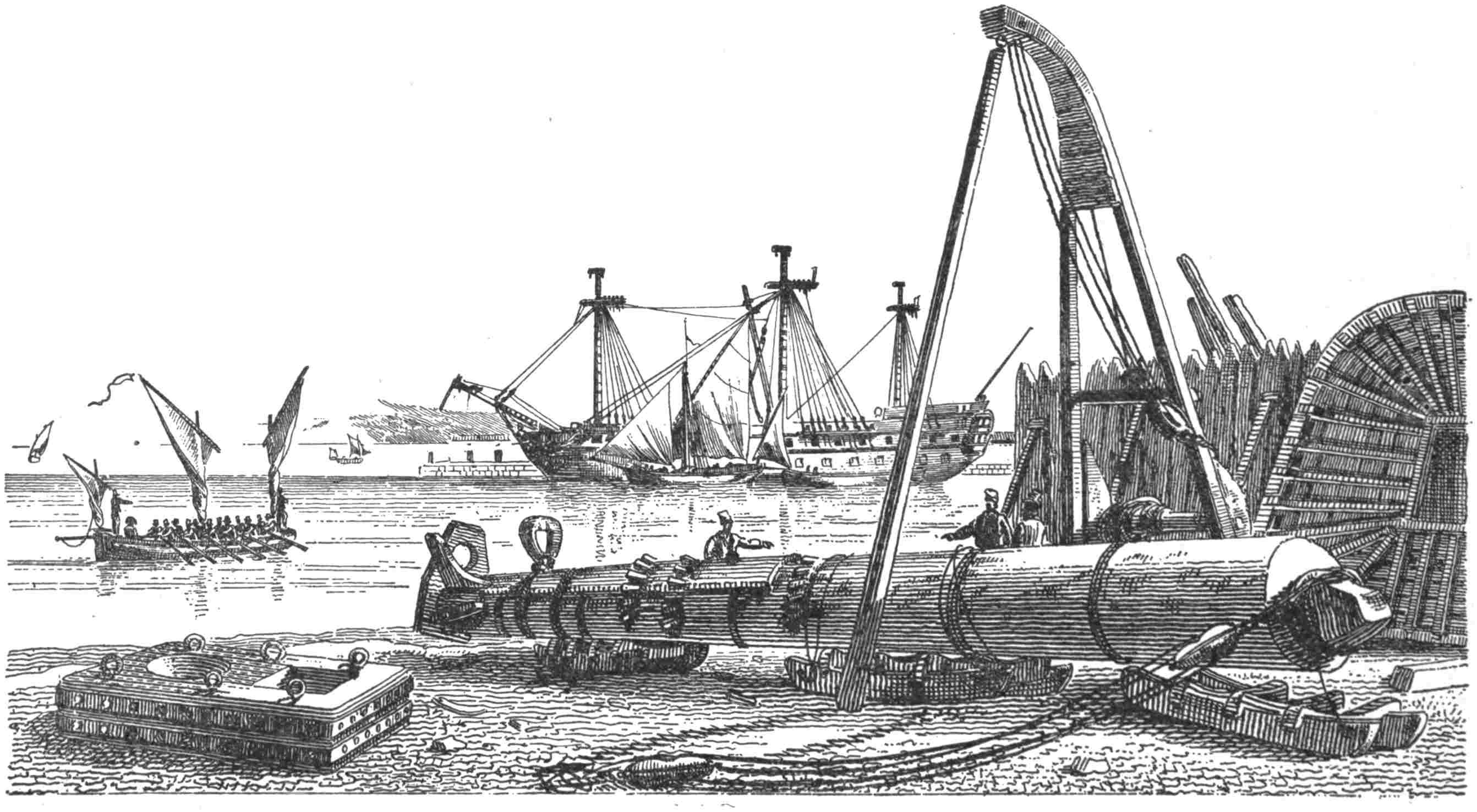
The Old Method of Handling a Ship’s Bowsprit.
From an old engraving.
The building of the new navy actually began, one may say, when Secretary of the Navy William H. Hunt appointed a board of naval officers, with Rear-admiral John Rodgers at its head, “to determine the requirements of a new navy.” These officers considered the matter jointly for a proper time, and then reported that the United States should have twenty-one battle-ships—ships fit to meet the best floating forts of the world; seventy unarmored cruisers of various sizes, twenty torpedo boats, five torpedo gunboats, and five rams.

Hauling a Vessel into Port a Hundred Years Ago.
From an old engraving.
It was not an extravagant estimate, and it was approved, in a way, by the nation. Did we build them, or any considerable part of them, straightway? Not at all. We could not build even one of the armored ships. We528 had saved the expense of experimenting; we had allowed other nations to do our experimenting for us. “Right smart” economists we were. When European experiments had fairly shown what European practice was likely to be, we started in to adopt the European ideas, and suddenly learned, what had never occurred to us as a nation, that the foundation of all sea power is a shipyard. We had been able in the old days to set afloat efficient wooden fighting machines in four months, but when we started in to build an ironclad navy of the modern style, we found that we could not roll even the thinnest of modern armor-plates, and that we could not make a gun that would pierce even the cheap armor carried by the old-fashioned monitors we had lying up in ordinary. The opportunity for showing how easy it was to take advantage of the experiments of other nations was at hand. We had a book knowledge of everything that had been done abroad, but instead of starting in with a ship that should excel, or even equal, say, the Téméraire of the British navy, not to mention the contemporary (in design) Edinburgh, we found we must do a little experimenting and gain a little experience for ourselves.
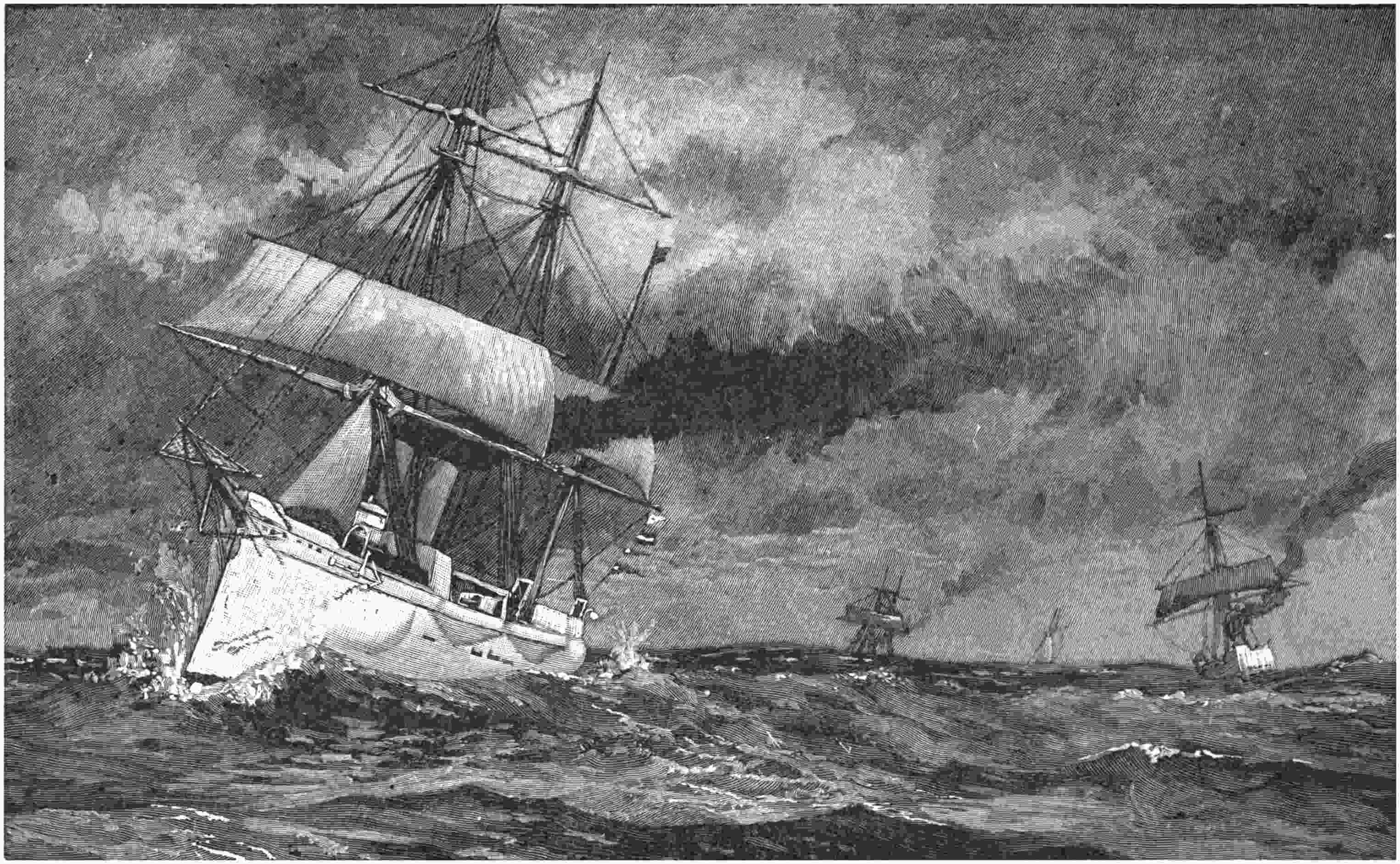
The White Squadron in Mid-ocean.
From a drawing by R. F. Zogbaum.
We had some shipyards that were supported by the coastwise trade, and to them we went. The Chicago, the Atlanta, the Boston, and the531 Dolphin were the result. Instead of building battle-ships, we built, for lack of experience, third-rate cruisers. We also concluded to complete an old monitor or two that for long years had been lying on the stocks. To do this Rome went to Carthage to buy shields for its legions—we bought our armor-plate in a foreign market. We had to do it or go without. The writer remembers the day when we even imported the bunting of which we made the “gridiron flag”!
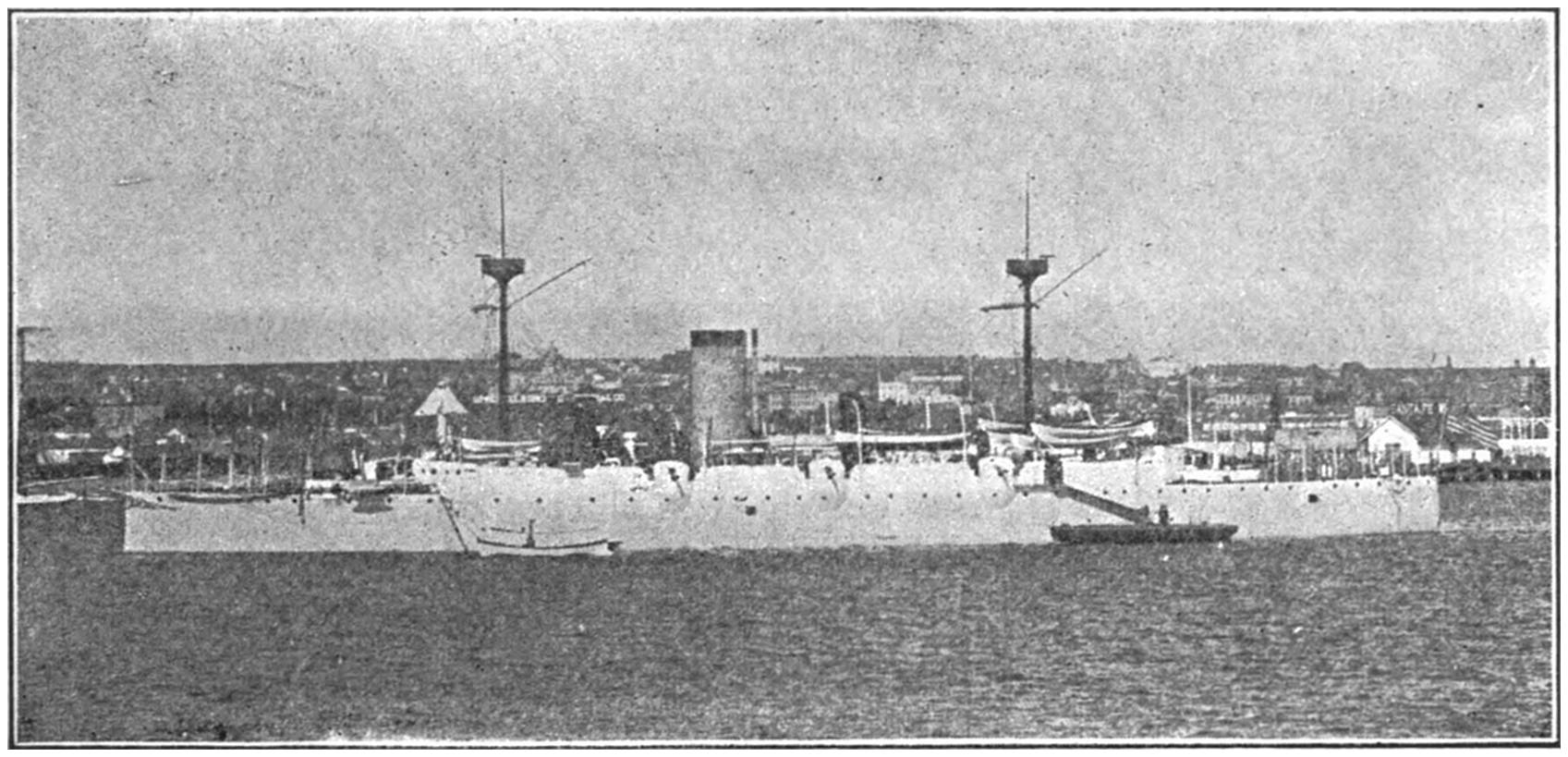
U. S. S. Charleston, San Diego Harbor.
From a photograph.
It was humiliating to go abroad for what we could not make ourselves. But another statement of the kind must be made, and then the record of shame ends; for which let us all be sincerely and devoutly thankful. We went abroad for the plans of one of our largest cruisers—the Charleston.
532
Let the reader have no misunderstanding about this matter. If war had been impending it would have been right, and even an imperative duty, to buy warships fully equipped wherever they could be found. But we were building a navy in time of peace, and a ship that “could not get out of her own way,” from our own designers, was better than the best afloat bought from a foreign land. In the building of the new navy—in the building of the White Squadron, of which we make boast in our periodicals—the product was nothing; the building of men was everything.
It was not without labor and pain that we got the first modern ships afloat. It was not so much that short-sighted economists interfered, for a surplus of money was found in the treasury, but the politicians were numerous and the patriots few. The politician in power must needs use the new ships to perpetuate his power; he who was out of power must use them as ferries to get into power. They were extravagantly praised and extravagantly decried. Time has shown the extravagance in both directions; but it is the tendency of man to admire his own, and when the truth is told, these ships are not “the best of their class afloat,” unless we add the modifying and saving clause “considering the circumstances under which they were built.” As the product of533 apprentices in the art of building modern warships, they are marvels of excellence. But since they were designed we have learned something.
The Atlanta and Boston were good fourteen-knot cruisers, but there were faster boats, armed with guns as good as theirs, in Europe. American policy could not permit such a state of affairs to exist, and we designed larger and better ones than anything afloat. We laid down the New York. She cost “a whole lot of money,” it is true, but as we recall the thrill that stirred the nation when the story of her trial trip was told—when it was told that we had the swiftest and most powerful cruiser in the world, we are bound to say that twice the sum invested in any other way by the government could not have given the nation so great a benefit. It was not that any one was incited to a point where he wished the nation to go to war. On the contrary, the New York was an assurance that in our dealings with other peoples we would “not be influenced, or even be suspected of being influenced, by a consciousness of weakness on the sea.” Nations are like dogs in this, that the weaker must needs put his tail between his legs and sneak away when trouble brews. But, if any one doubts that nations are bullies, let him consider the names that are given to534 ships in Europe. With the New York afloat, the American patriot was so far assured that his country would not be bullied, and so we should have peace.

The Columbia on her Government Speed Trial.
From a photograph by Rau.
The swifter cruisers like the twenty-two-knot Columbia and the twenty-three-knot Minneapolis, and the little cruisers and gunboats for shoal water, followed the New York. In the meantime we were at work on battle-ships, beginning with the Maine and ending with the Iowa, the Indiana, the new Kearsarge, and the Illinois. The English author of “Ironclads in Action” compares the Iowa with the British Majestic. It is a most instructive comparison—the most instructive pages, for an American reader, in the whole of this valuable work are those devoted535 to this comparison. For, although the Majestic is set down with a tonnage of 15,000 and the Iowa with but 11,500, the Yankee ship throws at a broadside 4,532 pounds of metal (in guns above a twenty-pounder) to the other’s 4,000; she has an armor belt of fourteen inches to the other’s nine; the armor “upon the heavy gun positions” is “15-inch in the Iowa” to “14-inch in the Majestic”; and she could keep the sea five weeks to the Britisher’s four. On the other hand, the Majestic has more freeboard, and could fight in a rougher sea, and she has the hull beneath her quick-firing guns protected in better fashion. But when it is all summed up, it is conceded by this English writer that the Iowa is at least a good match for the bigger Majestic.
As was said before, let no mistake be made about this. It is a matter of the greatest moment when our ship of 11,500 tons is conceded to be a match for one of 15,000 tons in the best navy of the world—not because we have the ship, but because we have developed the men who can do that kind of work and the tools for their use.
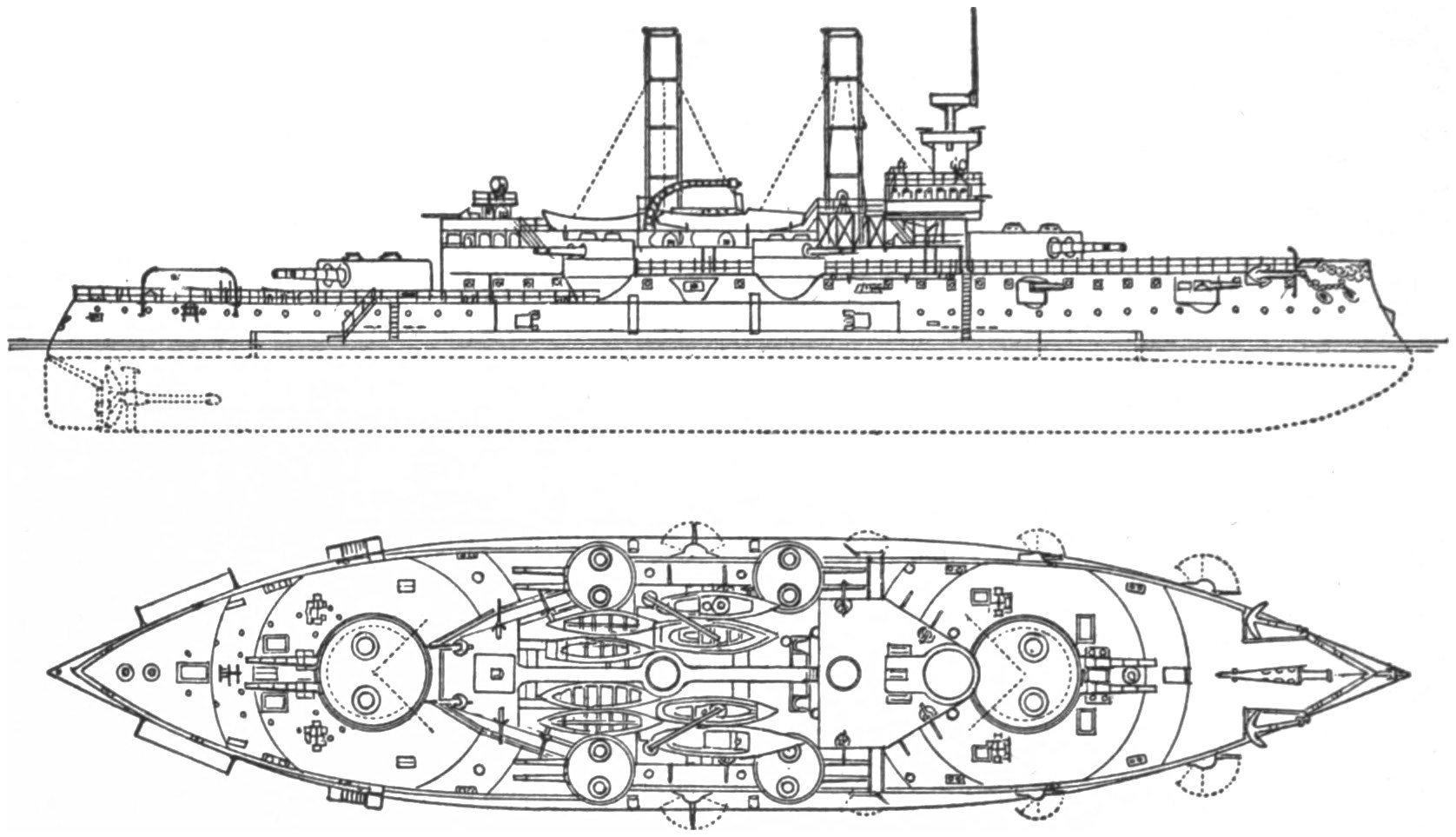
As many of the readers are aware, the Iowa is by no means the best battle-ship in the American navy. For instance, in her main battery she carries four twelve-inch and eight eight-inch breech-loading rifles, and six four-inch536 rifles, known as rapid-fire guns, because they use cartridges on the plan of a revolver or rifle cartridge, and can therefore be fired in service five or six times a minute. The new Kearsarge will carry four thirteen-inch and four eight-inch breech-loading rifles and fourteen five-inch rapid-fire guns. The new Illinois class will carry four thirteen-inch rifles and fourteen six-inch rapid-fire guns. The difference in the striking power of the batteries of the Iowa and the newer ships must be manifest to every reader. Nevertheless, it is important to remember that the weight of metal landed, and not the weight of metal thrown, wins the battle.
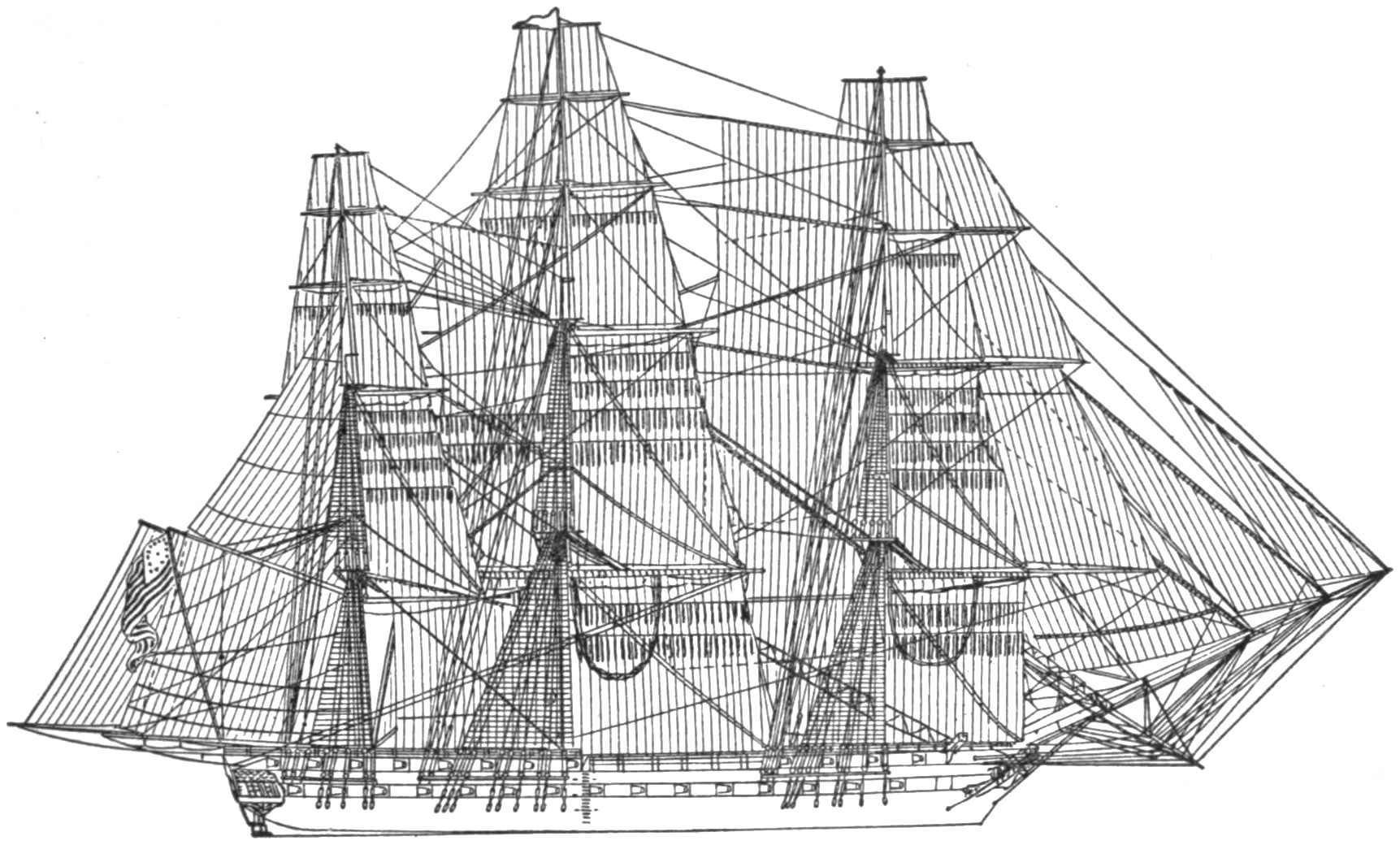
While we were developing shipbuilders we were also developing gunmakers. For a long537 time after the war we were contented with making steel tubes which could be shoved into Dahlgren smooth-bores, and so convert them into rifles of eight-inch calibre. Such makeshift work, needless it is to say, served only to drag down the standard of the American gunmakers. But in 1886 the sum of $2,128,000 was appropriated for guns—that is, modern rifles. To go into the details of other modern shipbuilding or modern rifle-making in a history of this kind is obviously impossible; but we may recall the fact that the Monitor’s turret was composed of eight layers of one-inch iron plates, placed so as to break joints, and that the best rifle of that day, a seven-inch Brooke, firing a solid projectile538 weighing 150 pounds, was unable to do any material damage to the turret. The first contracts for gun-forgings and armor-plates of modern construction were signed in May, 1887—ten years ago. Since that time we have made the plant for the work, and have turned out armor-plates of steel eighteen inches thick that are hardened and toughened to a point where a drill cannot penetrate, and the best projectile, an armor-piercing projectile, weighing 1,100 pounds and “striking with a force sufficient to lift 1,000 tons twenty-five feet, crushed in the backing of oak, but only dented the plate.” The mere statement that our modern rifles throw projectiles weighing 1,100 pounds, which strike with sufficient force to lift 1,000 tons twenty-five feet high, tells the story of the development of the gun. Another exhibit of the progress made is found in the fact that an eight-inch smooth-bore in the old days threw a cast-iron projectile, weighing sixty-eight pounds, with a velocity of 1,579 feet per second at the muzzle of the gun. The energy of the projectile was estimated at 452 foot-tons. The modern eight-inch rifle throws a steel bolt weighing 250 pounds, at a muzzle velocity of 2,500 feet per second, with a striking power of 10,830 foot-tons. The old eight-inch iron shot could not penetrate four inches of iron plates, while the modern steel bolt penetrates539 twenty-six inches of wrought iron. The best thirteen-inch modern rifles have a striking power of about 35,000 foot-tons and penetrate thirty-four inches of wrought iron.
After an apprenticeship of ten years, the gunmakers and shipbuilders of the United States have done well enough to entirely satisfy the people whom they have served. And yet the American navy, in the matter of ships and guns, is at best the fifth in the world. It is not considered necessary to the interest of this history to enter into any argument to show that the American navy should have a higher standing in point of numbers. But, if the story of the American navy has been written here as the writer understood it, then it is apparent that the American’s hope of peace has always rested on the efficiency of a modest number of ships. We have had peace with the aggressive nations of the earth while we have had an efficient force afloat, and we have suffered humiliation when we have neglected our navy. To make the appeal that is likely to be effective, history shows that it does not pay to try to get on without a navy. It need not be either the first or even the third in point of numbers, but it must be first in point of efficiency. To keep our hands in practice and our tools from rusting and our inventors from stagnation, we must lay down at least one new ship of the first540 class every year. We must not forget that Europe has steadily built new ships to improve on those with which we have led the way.
While building ships that in general construction were like those of Europe, the United States has followed its ancient policy of encouraging inventors by trying what the conservatives call “newfangled notions.” The success that followed the adoption of “newfangled notions” like steam power, the screw propeller, and the Ericsson Monitor, has been fully appreciated by the world at large. The “newfangled Yankee notions,” in fact, kept up the quality of the old American navy. Since the navy began its rejuvenating career, ten years ago, three “newfangled” ideas have been tried. One was a steam ram, pure and simple. It was a ship designed to steam at seventeen knots per hour, with a ram for its sole weapon of offence, and it was built solely for harbor defence. Because, in its way, it is a revival of the porcupine policy, nothing more need be said about it.
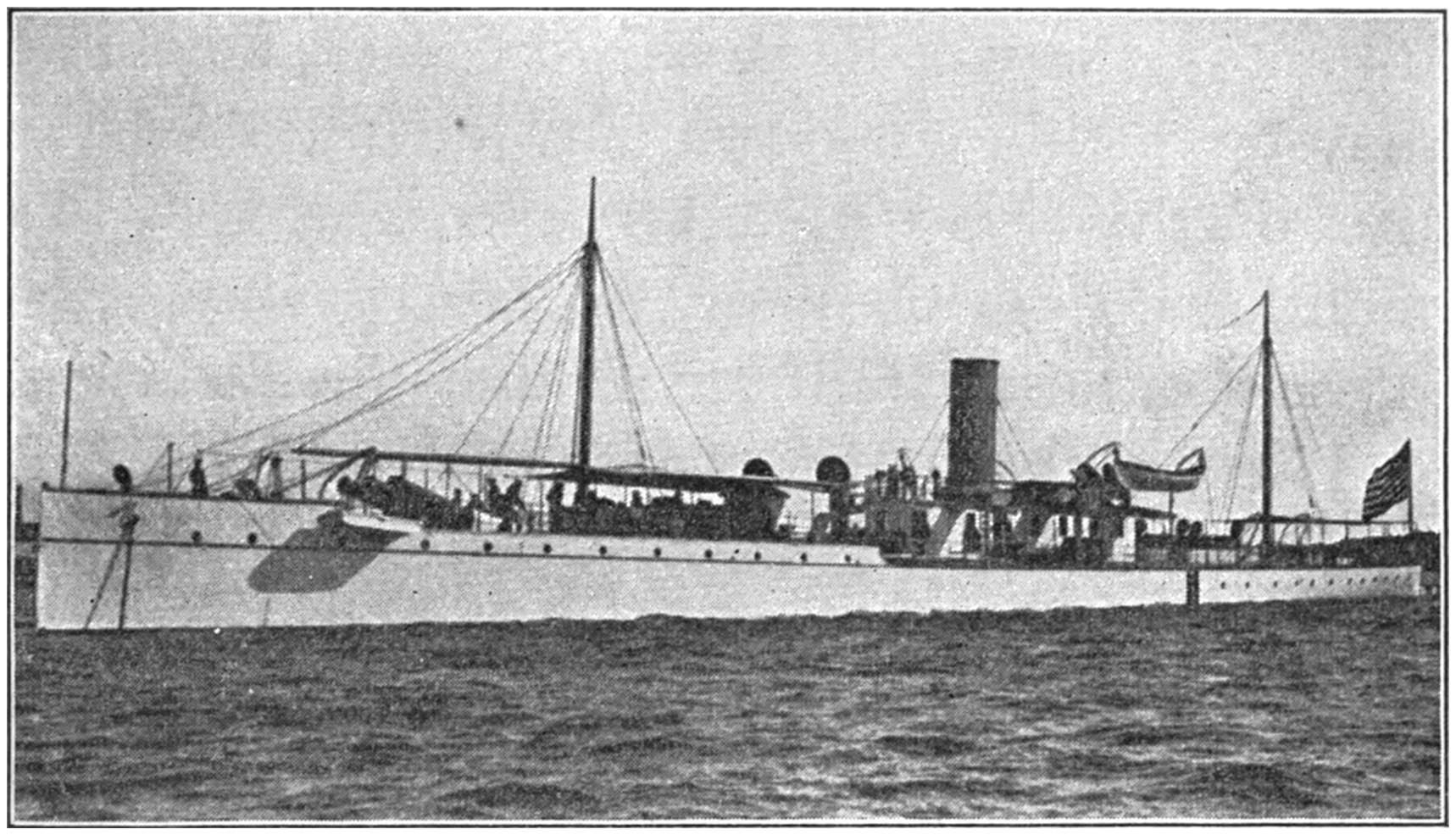
The Vesuvius.
From a photograph by Rau.
Another novelty was what is called the dynamite cruiser Vesuvius. Here is a sea-going torpedo boat armed with three fifteen-inch air-guns that can throw 400 or 500 pounds of high explosive to a range of a mile or more with reasonable accuracy. It is not a popular style of warship with naval officers, and so far541 as its purpose is for harbor defence, these officers are entirely right. It is the business of the army, with its forts and submarine torpedoes, to defend the harbors. For forts and submarine torpedoes are entirely sufficient for the purpose, and much more economical than ships adapted only for harbor defence. Nevertheless, the idea of a dynamite cruiser has not had a fair trial. The Vesuvius is a very small ship. Her popguns are of a fixed elevation, the range being determined by varying the pressure of the air. It is reasonably sure that the defects that have been developed in trials of her guns and aerial torpedoes might be corrected were she in the hands of some one thoroughly in earnest in the matter, and542 that a cruiser, to fire high explosives accurately and efficiently and safely by means of compressed air, might be designed. It is also reasonably certain that, because of the dislike of naval officers generally for the present craft, no more of the kind will be designed until Uncle Sam is compelled to “hustle,” if one may be allowed the expression, by the pressure of actual war. Because coastwise steamers may be readily cut down, and adapted for the use of this kind of a torpedo in a very few months, no one is likely to worry about the present failure to build more dynamite cruisers.
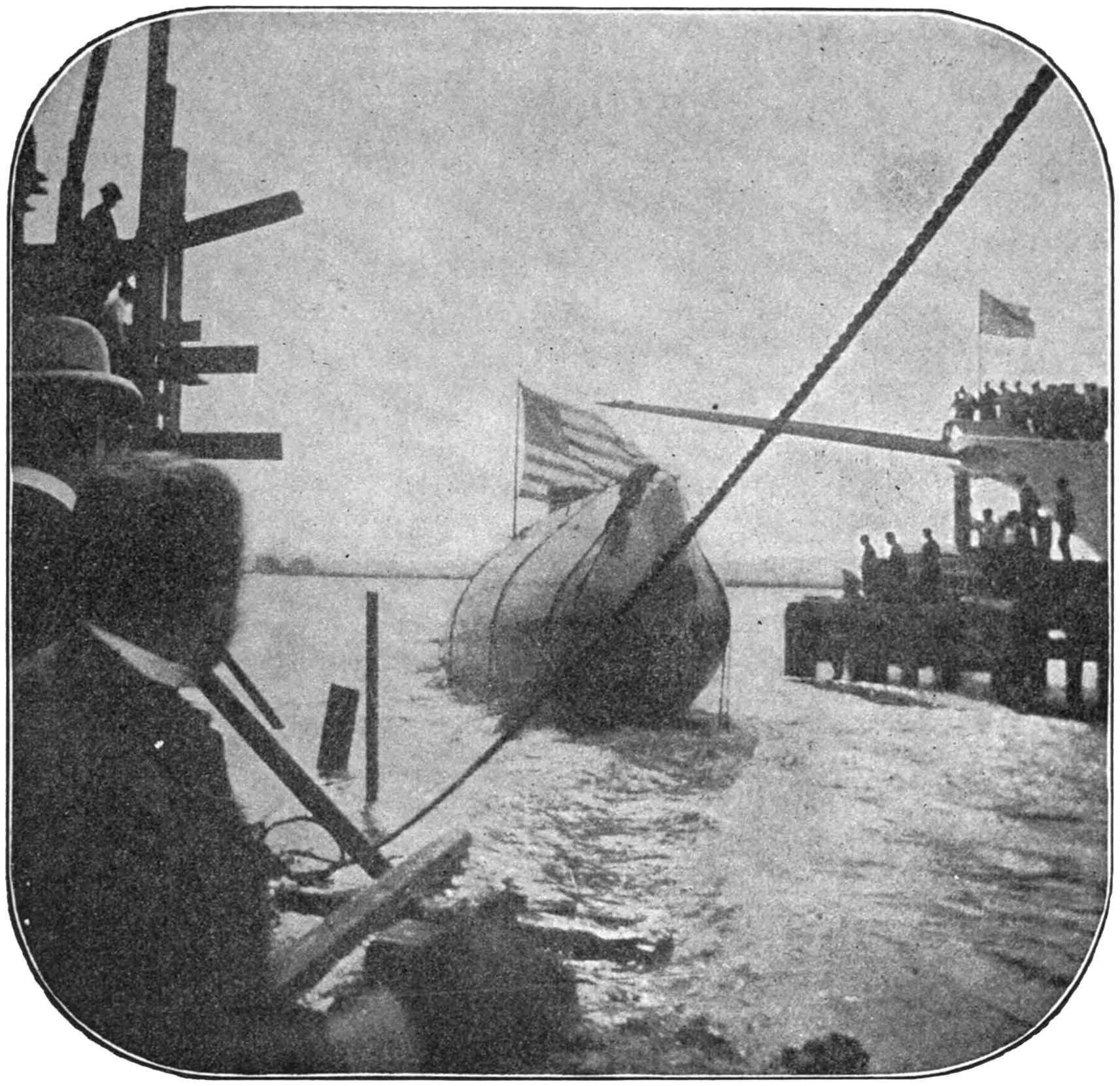
Launching of One of the Holland Boats, the Holland, at Elizabethport, N. J., 1897.
From a photograph belonging to the John P. Holland Co.
The third of the “newfangled ideas” is really a very old idea, as the reader will observe. It is a submarine boat designed to travel in ordinary circumstances with its back out of water, and yet be able, when occasion requires, to go underneath altogether. It is the invention of Mr. John P. Holland, who for many years has been at work on the cigar-shaped diving-ship idea. The one now building (1897) is only eighty-five feet long by eleven in diameter—a mere model of what a ship ought to be, if the idea were to be thoroughly tested. It might, indeed, be of some use for raising a blockade of the port of New York, just as smaller vessels were used to damage Union ships off Charleston in the Civil War. But, as already said over and again, the navy543 that the American nation needs is one that will prevent any nation on earth contemplating a blockade of any American port. However, this is not to condemn the building of this submarine boat. It was well worth building, just as the tiny ship in which Ericsson proved his screw propeller was worth building. Considerable space was given in Volume I to the doings of the submarine boats in the Revolutionary544 War because the building of ships which might be entirely submerged has never been attempted on a scale that would warrant a fair trial of the idea. There are many difficulties to be overcome, the chief of which is due to the fact that the ordinary compass goes wrong altogether when placed in a diver. It is nevertheless reasonable to suppose that every defect may be overcome. It is certain that the defects will not be overcome until a fair trial of the ship is had. Because of certain manifest advantages in having a ship that can live entirely submerged as well as when awash, or floating high out of water, there are men who believe that such ships will eventually become veritable peace-makers. We who are conservatives call them visionaries, and they reply that men of our class called Capt. M. C. Perry a visionary in 1839 because he said he believed that steamships would eventually supersede the gloriously beautiful frigate of the olden day.
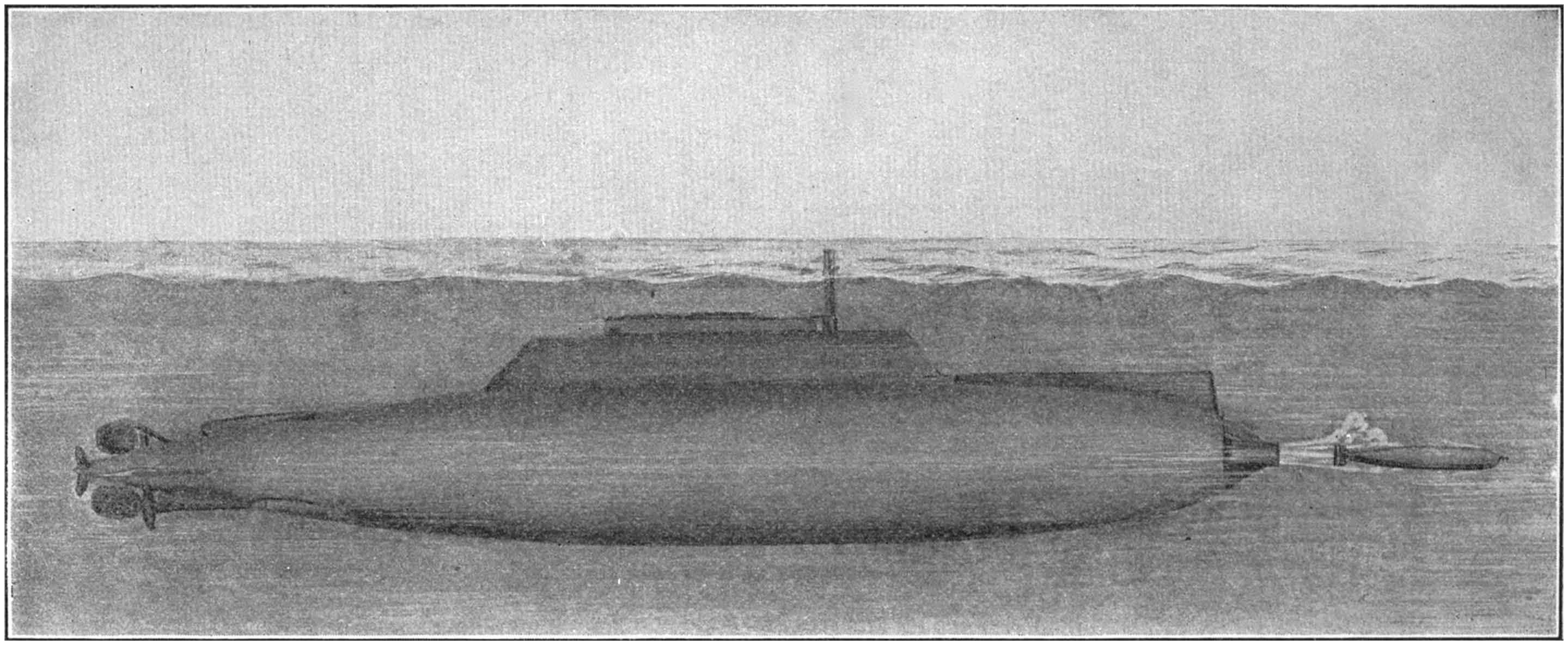
Another One of the Holland Submarine Boats: the Plunger.
(Submerged, with camera lucida tube in position.)
From a photograph of a drawing belonging to the John P. Holland Co.
Of the doings of the navy since the Civil War little need be said. We have had no war with any people, although on two or three occasions American commanders have been obliged to strip their ships for action to enforce a decent respect for the American flag. The most notable instance of this kind was in547 1894. The Brazilian navy was then in revolt against the Brazilian government, and the bay of Rio Janeiro was held by the rebel squadron. The purpose of the revolt, so far as it had a purpose outside of the personal feelings of the leaders, was to restore the monarchy. The insurgents would have been driven into making peace very quickly but for the fact that the British, in the interests of trade and politics, were very anxious to have the monarchy restored. British residents of Rio Janeiro contributed considerable sums of money to the support of the rebels and served actively as spies on the government. The senior officer of the British navy present, under the plea of neutrality, was able to see that the rebel leaders received all the rights of belligerents, although no nation had accorded these rights to them. For a time all the foreign warships in port, except the Germans, sided with the British in this matter. It is a curious fact that the senior American officer present refused to give protection to American merchantmen in port when they wished to go to the piers to discharge their cargoes. The rebel leader, Saldanha de Gama, said he should fire on any ship going to the piers, and American ships had to lie out in the bay and wait for the end of the war. Meantime yellow fever was raging there and many good men lost their lives.
548
Finally Admiral A. E. K. Benham came to the port. He at once told the American captains to go to the piers, and he would see that they were not fired upon—at least that trouble for the rebel fleet should follow any such move on their part.
Accordingly, on Sunday, January 29, 1894, Captain Blackford, of the American bark Amy, and two other captains, gave notice that they should haul into the piers with their ships on Monday morning. Admiral Saldanha de Gama, hearing of this, said officially that he should fire on the merchantmen if they did so. The rebel squadron was, as a whole, a worthless collection of old wooden hulks and new coasters armed with fairly good guns; but there was one good monitor, the Aquidaban, so there was no predicting what the desperate rebel would do. It was necessary to take de Gama at his word, and so, soon after daylight on the morning of the 30th, the Yankee squadron cleared for action, while the little cruiser Detroit, Capt. Willard H. Brownson, was sent in to take a station where she could command the two rebel warships, Guanabara and Trajano, that lay where they could, if so disposed, riddle the merchant ship Amy.
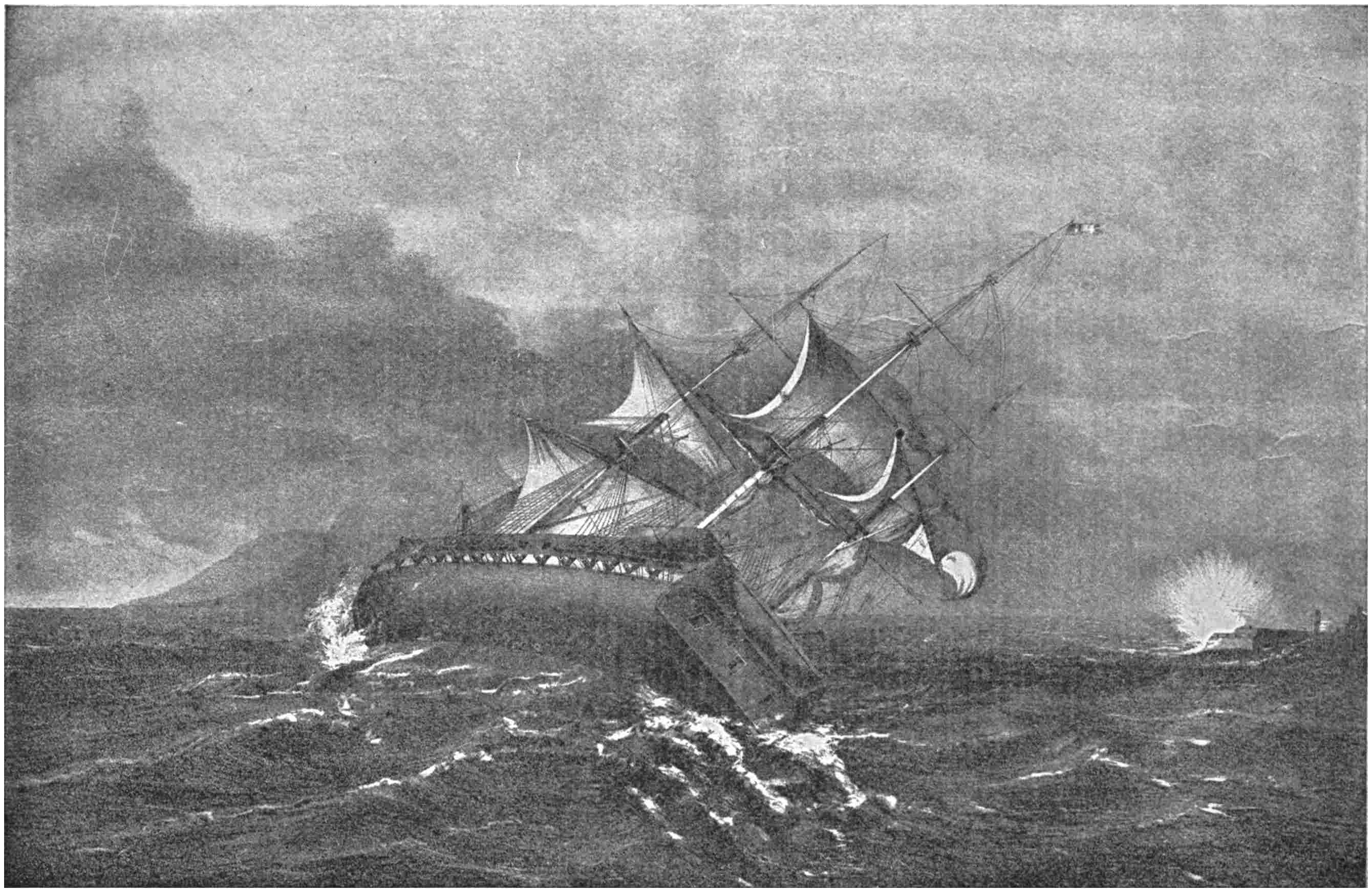
The Harbor of Rio Janeiro, Showing the Frigate Savannah Struck by a Squall, July 5, 1856.
From a lithograph.
When Brownson arrived the Amy began to warp in toward the pier. A musket was fired from the Guanabara, presumably toward one551 of the American ships. The Detroit replied with a shot first across the bow of the offending Guanabara, and then with another that struck her. It was a mere matter of form so far; it was notifying the Brazilians that the Americans were thoroughly in earnest. But, seeing a couple of tugs controlled by the rebels getting into position where they might ram the Detroit, Brownson took her in between the big warships where he could have raked and sunk them, and sunk the tugs at the same time. That ended the matter.
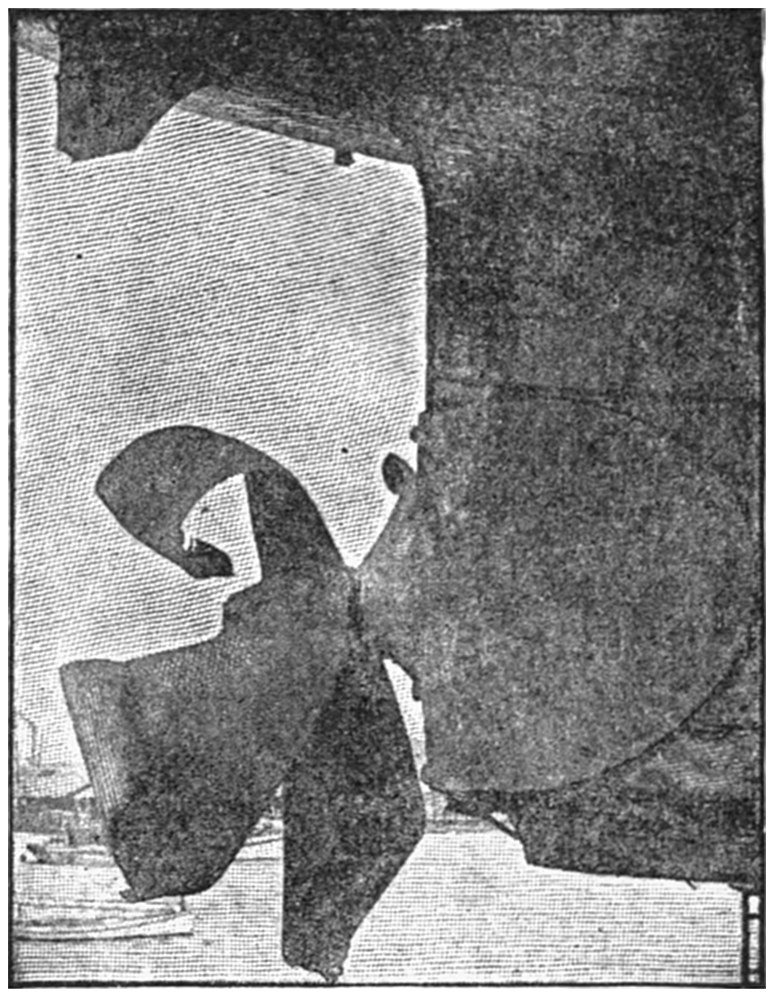
The Stern and Propeller of the Nipsic after the Samoan Hurricane.
From a photograph.
Saldanha de Gama concluded not to fire on the American flag. Before night the British, as well as all other foreign merchantmen, were tumbling over each other, so to speak, in their haste to follow the Yankee ships to the piers.
Captain Brownson, when a lieutenant on the Mohican in 1870, was placed in command of a boat’s crew and sent to cut out the steamer Forward, a filibusters’ craft operating on the coast of Mexico. She was found in a lagoon near552 San Blas, and her crew made a fight. She was carried by boarding after a loss of two men killed (including Master J. M. Wainwright) and six wounded.
Of great contemporary interest were the polar expeditions since the Civil War, but with the exception of the discoveries on the north coast of Greenland made by Lieutenant Peary, nothing of historical interest was accomplished. And mention must also be made of the great gale at Samoa, when the Vandalia sank and the Trenton and the Nipsic were thrown ashore, for nothing has stirred the hearts of the American people in recent years as the story of the fortitude of the men who, with death staring them in the face, sang and played “The Star Spangled Banner.”
But when all has been told and written about the history of the American navy since the Civil War, the one significant fact of all is this: we have from our own resources, mental and material, sent afloat a White Squadron that, though small in number, is fit to keep the sea in spite of foul weather or any other foul force.
553
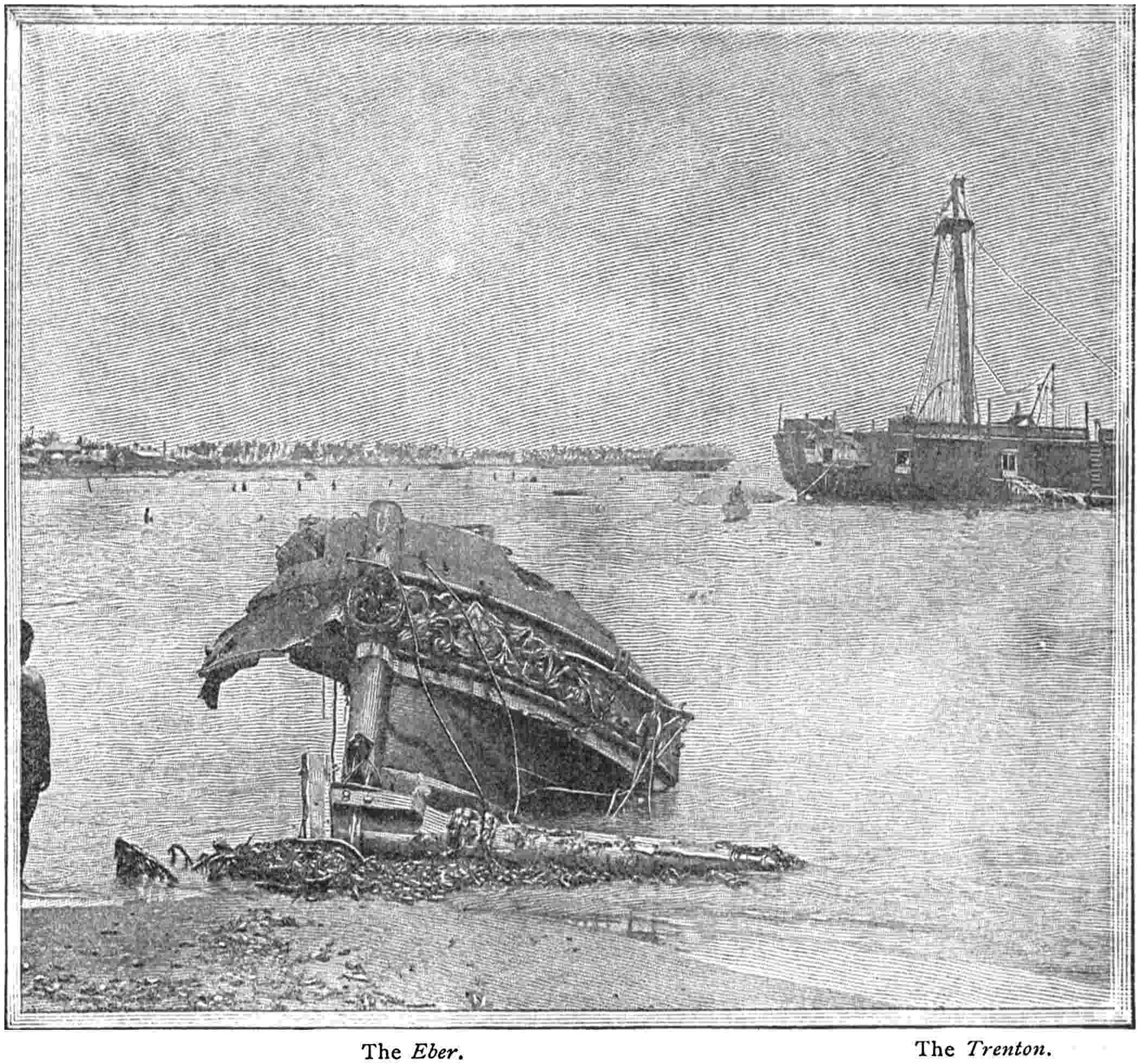
The Harbor after the Samoan Hurricane.
From a photograph.
555
Punctuation, hyphenation, and spelling were made consistent when a predominant preference was found in the original book; otherwise they were not changed.
Simple typographical errors were corrected; unbalanced quotation marks were remedied when the change was obvious, and otherwise left unbalanced.
Illustrations in this eBook have been positioned between paragraphs and outside quotations. In versions of this eBook that support hyperlinks, the page references in the List of Illustrations lead to the corresponding illustrations.
The illustration near page 199 includes a numbered key, but some of the numbers in the illustration are hard to find or read. The Transcriber has included two versions of this illustration: the original and an annotated one, in which those numbers appear in red (or gray, depending on the reading device). Two of those numbers, 1 and 18, may be in the wrong places.
The key numbers in the illustration near page 319 are the original ones. They are in ascending sequence clockwise, with the exception of 12 and 11.
The map following page 520 did not have a caption. As it was the only illustration in the book without a caption, Transcriber copied its description from the List of Illustrations and used it as the caption.
The index was not checked for proper alphabetization or correct page references. Most of the references are to pages in the other three volumes of this series; all four volumes are available at no charge at Project Gutenberg:
Volume I: https://www.gutenberg.org/ebooks/71794
Volume II: https://www.gutenberg.org/ebooks/71795
Volume III: https://www.gutenberg.org/ebooks/71796
Volume IV: https://www.gutenberg.org/ebooks/71797
In the original book, the index entries for "Biddle, Captain Nicholas" referring to Volume II. actually refer to his nephew, "Biddle, James", and some of those are in Volume III. In this ebook, those entries have been corrected, but the index may contain other errors.